Motorola Solutions 89FT7067 Portable 2-Way Radio User Manual MOTOTRBO Professional Digital Two Way Radio System
Motorola Solutions, Inc. Portable 2-Way Radio MOTOTRBO Professional Digital Two Way Radio System
Contents
- 1. Manual
- 2. RF Safety Manual
Manual
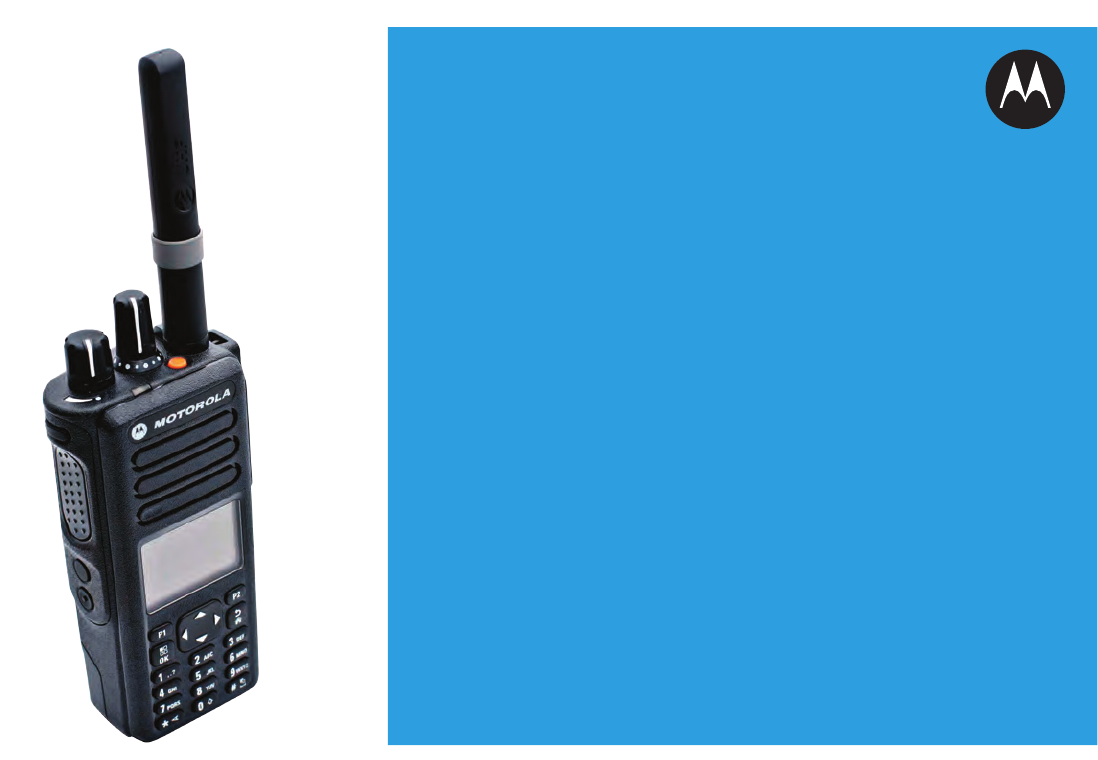
PROFESSIONAL DIGITAL TWO-WAY RADIO
MOTOTRBO™
XPR 755 0/XPR 7580/
XPR 7550e/XPR 7580e
COLOR DISPLAY PORTABLE
USER GUIDE

Contents
Declaration of Conformity....................... 15
Important Safety Information........17
Software Version............................18
Computer Software Copyrights....19
Handling Precautions.................... 20
Getting Started............................... 21
How to Use This Guide..................................21
What Your Dealer/System Administrator
Can Tell You.............................................21
Preparing Your Radio for Use.......23
Charging the Battery......................................23
Attaching the Battery..................................... 23
Attaching the Antenna................................... 24
Attaching the Belt Clip................................... 25
Attaching the Universal Connector Cover
(Dust Cover)............................................. 25
Powering Up the Radio..................................27
Adjusting the Volume.....................................27
Identifying Radio Controls............ 29
Radio Controls...............................................29
Using the 4–Way Navigation Button..............30
Using the Keypad.......................................... 31
Non-Connect Plus Operations......33
Additional Radio Controls
in Non-Connect Plus
Mode.................................... 34
Contents
1
English

Push-To-Talk (PTT) Button.................34
Programmable Buttons....................... 34
Assignable Radio Functions.....35
Assignable Settings or Utility
Functions............................ 38
Accessing the Programmed
Functions....................................... 38
Identifying Status Indicators................39
Display Icons............................39
Call Icons................................. 42
Advanced Menu Icons..............42
Mini Notice Icons......................43
Sent Item Icons ....................43
Bluetooth Device Icons............ 44
Job Tickets Icons..................... 44
LED Indicator........................... 44
Alert Tones...............................46
Indicator Tones........................ 46
Switching Between Conventional
Analog and Digital Mode................46
IP Site Connect ...............................47
Capacity Plus ..................................48
Linked Capacity Plus ...................... 48
Making and Receiving Calls
in Non-Connect Plus
Mode.................................... 50
Selecting a Zone.................................50
Selecting a Channel............................51
Receiving and Responding to a
Radio Call...................................... 51
Receiving and Responding
to a Group Call....................52
Receiving and Responding
to a Private Call .............. 53
Receiving an All Call ............... 53
Receiving and Responding
to a Selective Call ........... 54
Receiving and Responding
to a Phone Call ............... 54
Making a Radio Call............................56
Making a Group Call................ 57
Making a Private Call ...........58
Making an All Call ................... 59
Making a Selective Call ....... 59
Contents
2
English

Making a Phone Call with
the One Touch Access
Button..................................60
Making a Private Call with a
One Touch Call Button........62
Making a Group, Private or
All Call with the
Programmable Number
Key ..................................63
Making a Phone Call with
the Programmable
Phone Button .................. 64
Making a Call with the
Programmable Manual
Dial Button ...................... 66
Stopping a Radio Call .....................68
Talkaround..........................................69
Monitoring Features............................69
Monitoring a Channel...............70
Permanent Monitor...................70
Advanced Features in Non-
Connect Plus Mode............ 71
Radio Check....................................... 71
Sending a Radio Check........... 71
Remote Monitor.................................. 72
Initiating Remote Monitor......... 73
Stopping Remote Monitor........ 74
Scan Lists........................................... 75
Viewing an Entry in the
Scan List............................. 75
Viewing an Entry in the
Scan List by Alias Search... 75
Editing the Scan List................ 76
Scan....................................................80
Starting and Stopping Scan..... 80
Responding to a
Transmission During a
Scan....................................81
Deleting a Nuisance Channel...81
Restoring a Nuisance
Channel...............................82
Vote Scan ....................................... 82
Contact Settings..................................82
Making a Group Call from
Contacts..............................83
Making a Private Call from
Contacts ..........................84
Making a Phone Call from
Contacts..............................85
Contents
3
English

Making a Call Alias Search
.........................................88
Making a Group, Private,
Phone or All Call by Alias
Search ................................89
Assigning an Entry to a
Programmable Number
Key ..................................90
Removing the Association
between Entry and
Programmable Number
Key ..................................91
Adding a New Contact............. 92
Setting a Default Contact .....93
Call Indicator Settings.........................93
Activating and Deactivating
Call Ringers for Call Alert
.........................................93
Activating and Deactivating
Call Ringers for Private
Calls ................................94
Activating and Deactivating
Call Ringers for Selective
Call ..................................94
Activating and Deactivating
Call Ringers for Text
Message............................. 95
Activating and Deactivating
Call Ringers for
Telemetry Status with
Text..................................... 96
Assigning Ring Styles.............. 97
Selecting a Ring Alert Type......97
Configuring Vibrate Style......... 98
Escalating Alarm Tone
Volume................................99
Call Log Features................................99
Viewing Recent Calls............... 99
Storing an Alias from a Call
List.................................... 100
Deleting a Call from a Call
List.................................... 100
Viewing Details from a Call
List.................................... 101
Call Alert Operation...........................101
Receiving and Responding
to a Call Alert.................... 101
Making a Call Alert from the
Contact List....................... 102
Contents
4
English

Making a Call Alert with the
One Touch Access
Button................................102
Emergency Operation.......................103
Receiving an Emergency
Alarm.................................104
Responding to an
Emergency Alarm............. 104
Exiting Emergency Mode
After Receiving the
Emergency Alarm............. 105
Sending an Emergency
Alarm.................................105
Sending an Emergency
Alarm with Call.................. 106
Sending an Emergency
Alarm with Voice to
Follow ........................... 107
Reinitiating an Emergency
Mode................................. 108
Exiting Emergency Mode
After Sending the
Emergency Alarm............. 108
Man Down.........................................109
Turning the Man Down
Feature On or Off..............109
Analog Message Encode ..............110
Sending MDC Message
Encode to Dispatcher........110
Text Message Features ................... 111
Writing and Sending a Text
Message........................... 111
Sending a Quick Text
Message with the One
Touch Access Button........ 112
Accessing the Drafts Folder...113
Managing Fail-to-Send Text
Messages..........................115
Managing Sent Text
Messages..........................117
Receiving a Text Message.....120
Managing Received Text
Messages..........................121
Job Tickets........................................125
Accessing the Job Ticket
Folder................................126
Logging In and Out of the
Remote Server..................126
Creating and Sending a Job
Ticket................................ 127
Responding to the Job Ticket.128
Deleting a Job Ticket..............128
Contents
5
English

Privacy ..........................................129
Dual Tone Multi Frequency (DTMF). 131
Multi-Site Controls ........................ 131
Starting an Automatic Site
Search...............................131
Stopping an Automatic Site
Search...............................132
Starting a Manual Site
Search...............................133
Security.............................................134
Radio Disable.........................134
Radio Enable..........................135
Lone Worker..................................... 137
Password Lock Features.................. 138
Accessing the Radio from
Password.......................... 138
Unlocking the Radio from
Locked State..................... 139
Turning the Password Lock
On or Off........................... 139
Changing the Password.........140
Bluetooth Operation..........................141
Turning Bluetooth On and
Off..................................... 141
Finding and Connecting to a
Bluetooth Device...............142
Finding and Connecting
from a Bluetooth Device
(Discoverable Mode).........143
Disconnecting from a
Bluetooth Device...............143
Switching Audio Route
between Internal Radio
Speaker and Bluetooth
Device............................... 144
Viewing Device Details...........144
Editing Device Name..............144
Deleting Device Name........... 145
Bluetooth Mic Gain.................145
Permanent Bluetooth
Discoverable Mode........... 146
Notification List..................................146
Accessing the Notification
List.................................... 146
Auto-Range Transponder System
(ARTS) .....................................147
Over-the-Air-Programming (OTAP).. 147
Wi-Fi Operation.................................148
Turning Wi-Fi On or Off..........148
Connecting to a Network
Access Point..................... 148
Refreshing the Network List...149
Contents
6
English

Adding a Network...................150
Viewing Details of Network
Access Points................... 150
Removing Network Access
Points................................ 151
Utilities.............................................. 152
Locking and Unlocking the
Keypad..............................152
Turning Keypad Tones On
or Off................................. 152
Setting the Squelch Level...... 153
Setting the Power Level......... 154
Turning the Option Board
Feature(s) On or Off..........154
Identifying Cable Type........... 154
Turning the Voice Operating
Transmission (VOX)
Feature On or Off..............155
Setting the Display Backlight
Timer.................................156
Turning the Backlight Auto
On or Off........................... 157
Turning the Radio Tones/
Alerts On or Off................. 157
Setting the Tone Alert
Volume Offset Level..........158
Turning the Talk Permit
Tone On or Off.................. 158
Turning the Power Up Alert
Tone On or Off.................. 159
Setting the Text Message
Alert Tone......................... 160
Changing the Display Mode...160
Adjusting the Display
Brightness......................... 161
Language............................... 162
Turning the LED Indicator
On or Off........................... 162
Turning the Introduction
Screen On or Off...............163
Turning the Voice
Announcement On or Off.. 163
Setting the Text-to-Speech
Feature..............................164
Call Forwarding ..................166
Menu Timer............................166
Analog Mic AGC (Mic AGC-
A)...................................... 167
Digital Mic AGC (Mic AGC-
D)...................................... 167
Switching Audio Route
between Internal Radio
Contents
7
English

Speaker and Wired
Accessory......................... 168
Intelligent Audio......................168
Turning the Acoustic
Feedback Suppressor
Feature On or Off ..........169
Turning the Microphone
Dynamic Distortion
Control Feature On or Off. 170
Setting the Audio Ambience...171
Setting the Audio Profiles.......172
Turning GPS/GNSS On or
Off..................................... 172
Text Entry Configuration........ 173
Flexible Receive List.............. 179
Accessing General Radio
Information........................ 182
Front Panel Configuration
(FPC)................................ 185
Checking the RSSI Values.....186
Connect Plus Operations............ 187
Additional Radio Controls
in Connect Plus Mode...... 188
Push-To-Talk (PTT) Button...............188
Programmable Buttons..................... 188
Assignable Radio Functions...189
Assignable Settings or Utility
Functions.......................... 190
Identifying Status Indicators in
Connect Plus Mode..................... 191
Display Icons..........................191
Call Icons............................... 193
Advanced Menu Icons............193
Sent Item Icons ..................... 194
Bluetooth Device Icons.......... 194
LED Indicator......................... 195
Indicator Tones...................... 196
Alert Tones.............................196
Switching Between Connect Plus
and Non-Connect Plus Modes.....196
Making and Receiving Calls
in Connect Plus Mode...... 197
Selecting a Site.................................197
Contents
8
English

Roam Request....................... 197
Site Lock On/Off.....................197
Site Restriction.......................197
Selecting a Zone...............................198
Using Multiple Networks................... 199
Selecting a Call Type........................199
Receiving and Responding to a
Radio Call.................................... 199
Receiving and Responding
to a Group Call..................200
Receiving and Responding
to a Private Call.................200
Receiving a Site All Call.........201
Receiving an Inbound
Private Phone Call............ 201
Receiving an Inbound
Phone Talkgroup Call....... 202
Inbound Phone Multi-Group
Call....................................203
Making a Radio Call..........................203
Making a Call with the
Channel Selector Knob..... 203
Making a Private Call with a
One Touch Call Button......206
Making a Call with the
Programmable Manual
Dial Button........................ 206
Making an Outbound Private
Phone Call with the
Programmable Manual
Dial Button........................ 207
Making an Outbound Private
Phone Call via the Phone
Menu................................. 208
Making an Outbound Private
Phone Call from Contacts. 208
Waiting for the Channel
Grant in an Outbound
Private Phone Call............ 209
Making a Buffered Over-Dial
in a Connected
Outbound Private Phone
Call....................................210
Making a Live Over-Dial in a
Connected Outbound
Private Phone Call............ 210
Advanced Features in
Connect Plus Mode.......... 212
Auto Fallback.................................... 212
Indications of Auto Fallback
Mode................................. 212
Contents
9
English

Making/Receiving Calls in
Fallback Mode...................212
Returning to Normal
Operation.......................... 213
Radio Check..................................... 213
Sending a Radio Check......... 214
Remote Monitor................................ 214
Initiating Remote Monitor....... 215
Scan..................................................216
Starting and Stopping Scan... 216
Responding to a
Transmission During a
Scan..................................216
User Configurable Scan....................217
Turning Scan On or Off.....................217
Editing the Scan List......................... 218
Add or Delete a Group via the Add
Members Menu............................219
Understanding Scan Operation.........221
Scan Talkback.................................. 222
Contacts Settings..............................222
Making a Private Call from
Contacts............................223
Making a Call Alias Search.... 224
Adding a New Contact........... 224
Call Indicator Settings.......................225
Activating and Deactivating
Call Ringers for Call Alert .225
Activating and Deactivating
Call Ringers for Private
Calls.................................. 226
Activating and Deactivating
Call Ringers for Text
Message........................... 226
Selecting a Ring Alert Type....227
Configuring Vibrate Style....... 228
Escalating Alarm Tone
Volume..............................229
Call Log Features..............................229
Viewing Recent Calls............. 229
Deleting a Call from a Call
List.................................... 229
Viewing Details from a Call
List.................................... 230
Call Alert Operation...........................230
Receiving and Responding
to a Call Alert.................... 230
Making a Call Alert from the
Contact List....................... 231
Making a Call Alert with the
One Touch Access
Button................................232
Emergency Operation.......................232
Contents
10
English

Receiving an Incoming
Emergency........................234
Saving the Emergency
Details to the Alarm List.... 234
Deleting the Emergency
Details............................... 235
Responding to an
Emergency Call.................235
Responding to an
Emergency Alert............... 235
Initiating an Emergency Call.. 236
Initiating an Emergency Call
with Voice to Follow.......... 236
Initiating an Emergency Alert. 237
Exiting Emergency Mode....... 237
Man Down Alarms.............................238
Turning Man Down Alarms
On and Off........................ 239
Resetting the Man Down
Alarms...............................241
Beacon Feature................................ 242
Turning Beacon On and Off... 242
Resetting the Beacon.............243
Text Message Features.................... 244
Writing and Sending a Text
Message........................... 244
Sending a Quick Text
Message........................... 245
Sending a Quick Text
Message with the One
Touch Access Button........ 246
Accessing the Drafts Folder...246
Managing Fail-to-Send Text
Messages..........................248
Managing Sent Text
Messages..........................250
Receiving a Text Message.....254
Reading a Text Message....... 254
Managing Received Text
Messages..........................254
Privacy.............................................. 257
Making a Privacy-Enabled
(Scrambled) Call............... 259
Security.............................................259
Radio Disable.........................259
Radio Enable..........................260
Password Lock Features.................. 262
Accessing the Radio from
Password.......................... 262
Turning the Password Lock
On or Off........................... 263
Unlocking the Radio from
Locked State..................... 263
Contents
11
English

Changing the Password.........264
Bluetooth Operation..........................265
Turning Bluetooth On and
Off..................................... 265
Finding and Connecting to a
Bluetooth Device...............266
Finding and Connecting
from a Bluetooth Device
(Discoverable Mode).........267
Disconnecting from a
Bluetooth Device...............267
Switching Audio Route
between Internal Radio
Speaker and Bluetooth
Device............................... 268
Viewing Device Details...........268
Editing Device Name..............268
Deleting Device Name........... 269
Bluetooth Mic Gain.................269
Permanent Bluetooth
Discoverable Mode........... 270
Notification List..................................270
Accessing the Notification
List.................................... 270
Wi-Fi Operation.................................271
Turning Wi-Fi On or Off..........271
Connecting to a Network
Access Point..................... 271
Refreshing the Network List...272
Adding a Network...................273
Viewing Details of Network
Access Points................... 273
Removing Network Access
Points................................ 274
Utilities.............................................. 275
Turning the Radio Tones/
Alerts On or Off................. 275
Turning Keypad Tones On
or Off................................. 275
Setting the Tone Alert
Volume Offset Level..........276
Turning the Talk Permit
Tone On or Off.................. 277
Turning the Power Up Alert
Tone On or Off.................. 277
Setting the Power Level......... 278
Changing the Display Mode...278
Adjusting the Display
Brightness......................... 279
Setting the Display Backlight
Timer.................................280
Turning the Introduction
Screen On or Off...............280
Contents
12
English

Locking and Unlocking the
Keypad..............................281
Language............................... 282
Turning the LED Indicator
On or Off........................... 282
Identifying Cable Type........... 283
Voice Announcement.............283
Menu Timer............................284
Digital Mic AGC (Mic AGC-
D)...................................... 284
Intelligent Audio......................285
Turning the Acoustic
Feedback Suppressor
Feature On or Off..............286
Turning the Microphone
Dynamic Distortion
Control Feature On or Off. 287
Turning GPS/GNSS On or
Off..................................... 287
Text Entry Configuration........ 288
Accessing General Radio
Information........................ 294
Accessories..................................306
Authorized Accessories
List..................................... 307
Antennas...........................................307
Batteries............................................307
Carry Devices................................... 308
Chargers........................................... 308
Earbuds and Earpieces.....................309
Headsets and Headset Accessories.309
Remote Speaker Microphones......... 310
Surveillance Accessories..................310
Miscellaneous Accessories...............311
Maritime Radio Use in the VHF
Frequency Range...............................312
Special Channel Assignments.....................312
Emergency Channel......................... 312
Non-Commercial Call Channel......... 312
Operating Frequency Requirements............312
Declaration of Compliance for the Use of
Distress and Safety Frequencies............315
Technical Parameters for Interfacing
External Data Sources............................315
Batteries and Chargers Warranty......... 316
The Workmanship Warranty........................316
Contents
13
English

The Capacity Warranty................................316
Limited Warranty....................................317
MOTOROLA COMMUNICATION
PRODUCTS........................................... 317
I. WHAT THIS WARRANTY COVERS
AND FOR HOW LONG:......................... 317
II. GENERAL PROVISIONS:....................... 318
III. STATE LAW RIGHTS:............................318
IV. HOW TO GET WARRANTY SERVICE:.318
V. WHAT THIS WARRANTY DOES NOT
COVER:..................................................319
VI. PATENT AND SOFTWARE
PROVISIONS:........................................ 319
VII. GOVERNING LAW:...............................321
Contents
14
English

Declaration of Conformity
This declaration is applicable to your radio only if your radio is labeled with the FCC logo shown below.
Declaration of Conformity
Per FCC CFR 47 Part 2 Section 2.1077(a)
Responsible Party
Name: Motorola Solutions, Inc.
Address: 1303 East Algonquin Road, Schaumburg, IL 60196-1078, U.S.A.
Phone Number: 1-800-927-2744
Hereby declares that the product:
Model Name: XPR 7550/XPR 7580/XPR 7550e/XPR 7580e
conforms to the following regulations:
FCC Part 15, subpart B, section 15.107(a), 15.107(d) and section 15.109(a)
Declaration of Conformity
15
English

Class B Digital Device
As a personal computer peripheral, this device complies with Part 15 of the FCC Rules. This device complies with
Industry Canada licence-exempt RSS standard(s). Operation is subject to the following two conditions:
1This device may not cause harmful interference, and
2This device must accept any interference received, including interference that may cause undesired operation.
Note:
This equipment has been tested and found to comply with the limits for a Class B digital device, pursuant
to part 15 of the FCC Rules. These limits are designed to provide reasonable protection against harmful
interference in a residential installation. This equipment generates, uses and can radiate radio frequency
energy and, if not installed and used in accordance with the instructions, may cause harmful interference
to radio communications. However, there is no guarantee that interference will not occur in a particular in-
stallation.
If this equipment does cause harmful interference to radio or television reception, which can be determined
by turning the equipment off and on, the user is encouraged to try to correct the interference by one or
more of the following measures:
• Reorient or relocate the receiving antenna.
• Increase the separation between the equipment and receiver.
•Connect the equipment into an outlet on a circuit different from that to which the receiver is connected.
• Consult the dealer or an experienced radio or TV technician for help.
Declaration of Conformity
16
English
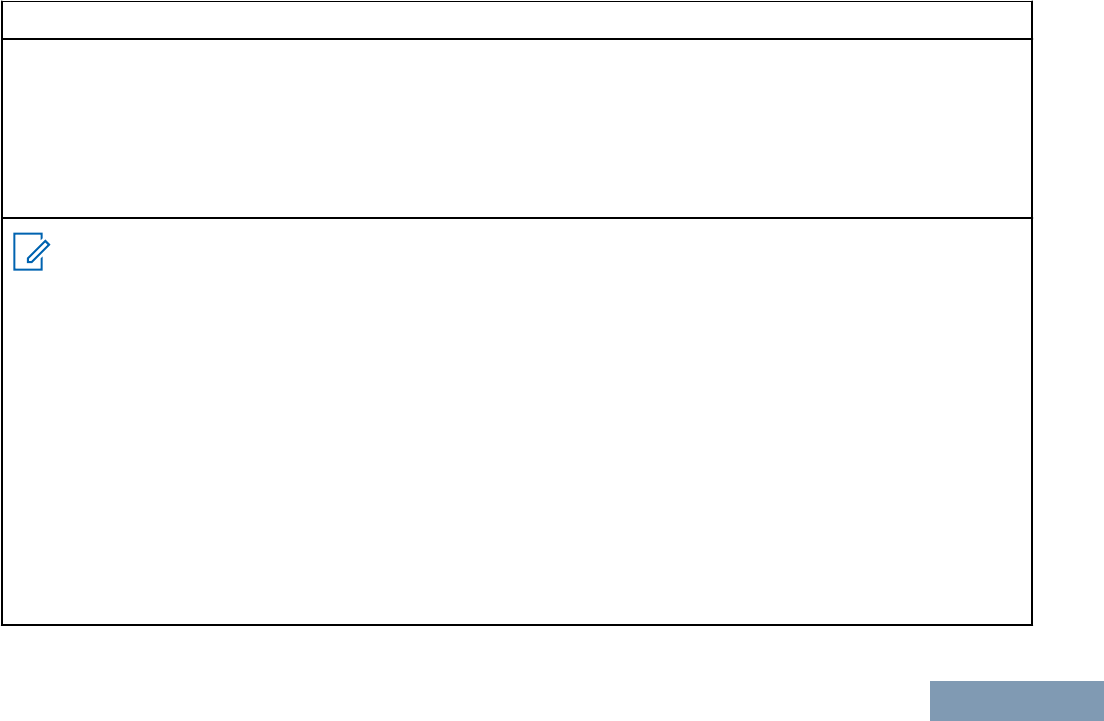
Appareil numérique de Classe B
En tant que périphérique d'ordinateur personnel, cet appareil est conforme aux stipulations de la partie 15 des rè-
glements de la FCC. Cet appareil est conforme aux CNR d'Industrie Canada applicables aux appareils radio
exempts de licence. Son utilisation est assujettie aux deux conditions suivantes :
1Cet appareil ne doit pas causer d'interférence nuisible.
2Cet appareil doit accepter toute interférence reçue, y compris les interférences pouvant entraîner un fonction-
nement indésirable.
Remarque
Ce matériel a fait l'objet de tests et a été déclaré conforme aux limites établies pour un appareil numérique
de classe B, comme il est stipulé à la section 15 des règlements de la FCC. Ces limites sont fixées afin
d'offrir une protection suffisante contre des interférences nuisibles dans une installation résidentielle. Ce
matériel génère, utilise et peut émettre de l'énergie radiofréquence et, s'il n'est pas installé ni utilisé confor-
mément aux instructions, il peut provoquer un brouillage nuisible aux communications radio. Cependant,
on ne peut garantir qu'il n'y aura aucune interférence dans une installation particulière.
Si cet appareil cause une interférence nuisible de la réception de la radio ou de la télévision, ce qui peut
être déterminé en éteignant et en allumant l'appareil, vous êtes encouragé à remédier à la situation en
prenant une ou plusieurs des mesures suivantes :
• Réorienter ou déplacer l'antenne réceptrice.
•Augmenter la distance entre l'équipement et le récepteur.
• Brancher l'appareil dans une autre prise sur un circuit différent de celui du récepteur.
• Consulter un revendeur ou un technicien radio/télévision chevronné pour obtenir de l'aide.
Déclaration de conformité
Français
(Canada)

Important Safety Information
RF Energy Exposure and Product Safety Guide
for Portable Two-Way Radios
ATTENTION!
This radio is restricted to Occupational use only.
Before using the radio, read the RF Energy Exposure
and Product Safety Guide for Portable Two-Way
Radios which contains important operating
instructions for safe usage and RF energy awareness
and control for Compliance with applicable standards
and Regulations.
For a list of Motorola-approved antennas, batteries,
and other accessories, visit the following website:
http://www.motorolasolutions.com
Any modification to this device, not expressly
authorized by Motorola, may void the user’s authority
to operate this device.
Under Industry Canada regulations, this radio
transmitter may only operate using an antenna of a
type and maximum (or lesser) gain approved for the
transmitter by Industry Canada. To reduce potential
radio interference to other users, the antenna type
and its gain should be so chosen that the equivalent
isotropically radiated power (e.i.r.p.) is not more than
that necessary for successful communication.
This radio transmitter has been approved by Industry
Canada to operate with Motorola-approved antenna
with the maximum permissible gain and required
antenna impedance for each antenna type indicated.
Antenna types not included in this list, having a gain
greater than the maximum gain indicated for that
type, are strictly prohibited for use with this device.
Important Safety Information
17
English

Consignes de sécurité importantes
Radios bidirectionnelles portatives : exposition
aux radiofréquences et sécurité du produit
ATTENTION!
Cette radio ne doit être utilisée qu'à des fins
professionnelles. Avant d'utiliser la radio, lisez le
guide Radios bidirectionnelles portatives : exposition
aux radiofréquences et sécurité du produit, qui
contient d'importantes instructions de fonctionnement
pour une utilisation sécuritaire et des informations sur
l'exposition aux fréquences radioélectriques, dans le
but d’assurer votre conformité aux normes et
règlements en vigueur.
Visitez le site Web suivant pour obtenir la liste des
antennes, des batteries et des autres accessoires
approuvés par Motorola :
http://www.motorolasolutions.com
Toute modification effectuée à cet appareil sans
l'autorisation explicite de Motorola peut annuler
l'autorisation d'utiliser cet appareil.
Selon la réglementation d'Industrie Canada, cet
émetteur radio ne peut être utilisé qu'avec une
antenne dont le type et le gain maximal (ou minimal)
sont approuvés par Industrie Canada pour cet
émetteur. Afin de limiter les interférences radio pour
les autres utilisateurs, le type et le gain de l'antenne
doivent être choisis de façon à ce que la puissance
isotrope rayonnée équivalente (P.I.R.E.) ne soit pas
plus forte qu'il ne le faut pour établir la
communication.
Cet émetteur radio a été approuvé par Industrie
Canada pour utilisation avec une antenne approuvée
par Motorola offrant le gain maximal autorisé et
l'impédance requise pour le type d'antenne indiqué. Il
est strictement interdit d'utiliser avec cet appareil tout
type d'antenne ne figurant pas dans cette liste et
présentant un gain supérieur au maximum indiqué
pour le type.
Consignes de sécurité importantes
English

Software Version
All the features described in the following sections are
supported by the software version R02.50.00 or later.
See Checking the Firmware Version and Codeplug
Version on page 183 to determine the software
version of your radio.
Check with your dealer or system administrator for
more details of all the features supported.
Software Version
18
English

Version logicielle
Toutes les fonctions décrites dans les sections
suivantes sont prises en charge par la version
R02.50.00 ou les versions ultérieures du logiciel de la
radio.
Consultez la section Checking the Firmware Version
and Codeplug Version pour connaître la version
logicielle de votre radio.
Pour obtenir davantage de renseignements à propos
des fonctions prises en charge, adressez-vous à
votre détaillant ou à votre administrateur de système.
Version logicielle
English

Computer Software Copyrights
The Motorola products described in this manual may
include copyrighted Motorola computer programs
stored in semiconductor memories or other media.
Laws in the United States and other countries
preserve for Motorola certain exclusive rights for
copyrighted computer programs including, but not
limited to, the exclusive right to copy or reproduce in
any form the copyrighted computer program.
Accordingly, any copyrighted Motorola computer
programs contained in the Motorola products
described in this manual may not be copied,
reproduced, modified, reverse-engineered, or
distributed in any manner without the express written
permission of Motorola. Furthermore, the purchase of
Motorola products shall not be deemed to grant either
directly or by implication, estoppel, or otherwise, any
license under the copyrights, patents or patent
applications of Motorola, except for the normal non-
exclusive license to use that arises by operation of
law in the sale of a product.
The AMBE+2™ voice coding Technology embodied in
this product is protected by intellectual property rights
including patent rights, copyrights and trade secrets
of Digital Voice Systems, Inc.
This voice coding Technology is licensed solely for
use within this Communications Equipment. The user
of this Technology is explicitly prohibited from
attempting to decompile, reverse engineer, or
disassemble the Object Code, or in any other way
convert the Object Code into a human-readable form.
U.S. Pat. Nos. #5,870,405, #5,826,222, #5,754,974,
#5,701,390, #5,715,365, #5,649,050, #5,630,011,
#5,581,656, #5,517,511, #5,491,772, #5,247,579,
#5,226,084 and #5,195,166.
Computer Software Copyrights
19
English

Handling Precautions
The MOTOTRBO Series Digital Portable radio meets
IP57 specifications, allowing the radio to withstand
adverse field conditions such as being submersed in
water.
• If the radio has been submersed in water, shake
the radio well to remove any water that may be
trapped inside the speaker grille and microphone
port. Trapped water could cause decreased audio
performance.
• If the radio’s battery contact area has been
exposed to water, clean and dry battery contacts
on both the radio and the battery before attaching
the battery to the radio. The residual water could
short-circuit the radio.
• If the radio has been submersed in a corrosive
substance (e.g. saltwater), rinse the radio and
battery in fresh water then dry the radio and
battery.
• To clean the exterior surfaces of the radio, use a
diluted solution of mild dishwashing detergent and
fresh water (i.e. one teaspoon of detergent to one
gallon of water).
• Never poke the vent (hole) located on the radio
chassis below the battery contact. This vent allows
for pressure equalization in the radio. Doing so
may create a leak path into the radio and the
radio’s submersibility may be lost.
• Never obstruct or cover the vent, even with a
label.
• Ensure that no oily substances come in contact
with the vent.
• The radio with antenna attached properly is
designed to be submersible to a maximum depth
of 1 meter (3.28 feet) and a maximum submersion
time of 30 minutes. Exceeding either maximum
limit or use without antenna may result in damage
to the radio.
• When cleaning the radio, do not use a high
pressure jet spray on the radio as this will exceed
the 1 meter depth pressure and may cause water
to leak into the radio.
Caution:
Do not disassemble the radio. This could
damage radio seals and result in leak paths
into the radio. Radio maintenance should only
be done in service depot that is equipped to
test and replace the seal on the radio.
Handling Precautions
20
English
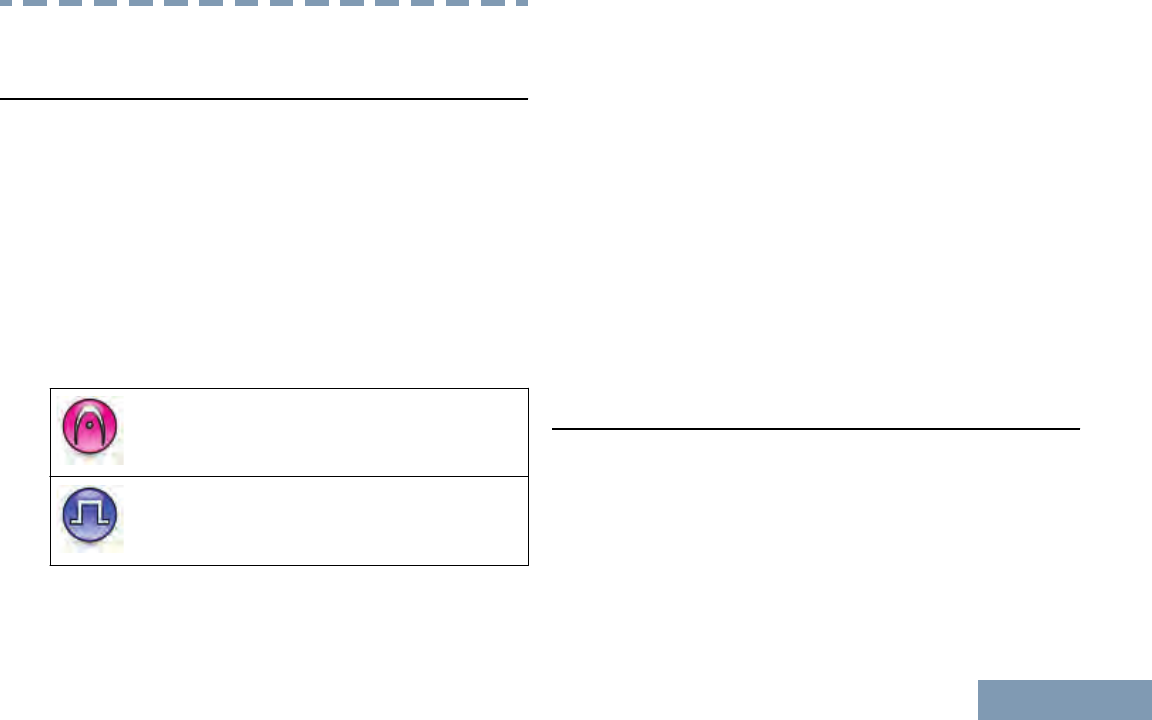
Getting Started
How to Use This Guide
This User Guide covers the basic operation of the
MOTOTRBO Portables.
However, your dealer or system administrator may
have customized your radio for your specific needs.
Check with your dealer or system administrator for
more information.
Throughout this publication, the icons described next
are used to indicate features supported in either the
conventional Analog mode or conventional Digital
mode:
Indicates a conventional Analog Mode-
Only feature.
Indicates a conventional Digital Mode-
Only feature.
For features that are available in both conventional
Analog and Digital modes, no icon is shown.
Conventional Analog Mode-Only features are not
available in Connect Plus mode of operation. See
Connect Plus Operations on page 187 for more
information.
For features that are available in a conventional multi-
site mode, see IP Site Connect on page 47 for more
information.
Selected features are also available on the single-site
trunking mode, Capacity Plus. See Capacity Plus on
page 48 for more information.
Selected features are also available in the multi-site
trunking mode, Linked Capacity Plus. See Linked
Capacity Plus on page 48 for more information.
What Your Dealer/System Administrator Can
Tell You
You can consult your dealer or system administrator
about the following:
• Is your radio programmed with any preset
conventional channels?
• Which buttons have been programmed to access
other features?
•What optional accessories may suit your needs?
Getting Started
21
English

• What are the best radio usage practices for
effective communication?
• What maintenance procedures will help promote
longer radio life?
Getting Started
22
English

Preparing Your Radio for Use
Charging the Battery
For best performance, your radio is powered by a
Motorola-approved Nickel Metal-Hydride (NiMH) or
Lithium-Ion (Li-lon) battery. To avoid damage and to
ensure compliance with warranty terms, charge the
battery using a Motorola charger exactly as described
in the charger user guide. It is recommended your
radio remains powered off while charging.
Charge a new battery 14 to 16 hours before initial use
for best performance.
Attaching the Battery
Note:
If user inadvertently attaches a UL battery to
an FM approved radio or vice versa, the
certification on the radio will be voided. Your
radio can be preprogrammed via CPS to alert
you if this battery mismatch occurs. Check
with your dealer or system administrator to
determine how your radio has been
programmed. This battery mismatch alert
feature is only applicable for IMPRES battery
and Non-IMPRES battery with kit number
programmed in Erasable Programmable Read
Only Memory (EPROM).
When the radio is attached with the wrong
battery, a low pitched warning tone sounds,
the LED lights up blinking red, display shows
Wrong Battery and the Voice
Announcement/Text-to-Speech sounds Wrong
Battery if the Voice Announcement/Text-to-
Speech is loaded via CPS.
1Align the battery with the rails on the back of the
radio. Press the battery firmly, and slide upwards
until the latch snaps into place. Slide battery latch
into lock position.
Preparing Your Radio for Use
23
English
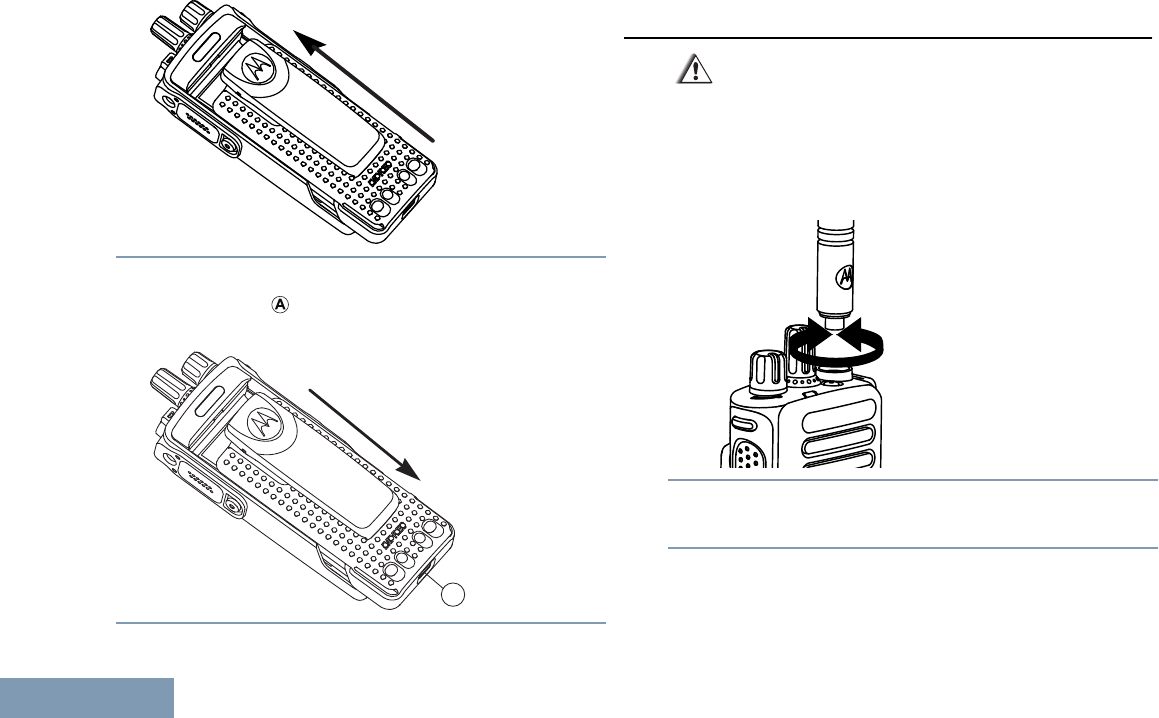
2To remove the battery, turn the radio off. Move the
battery latch ( ) into unlock position and hold, and
slide the battery down and off the rails.
A
Attaching the Antenna
Caution:
If antenna needs to be replaced, ensure that
only MOTOTRBO antennas are used.
Neglecting this will damage your radio.
1With the radio turned off, set the antenna in its
receptacle and turn clockwise.
2To remove the antenna, turn the antenna
counterclockwise.
Preparing Your Radio for Use
24
English
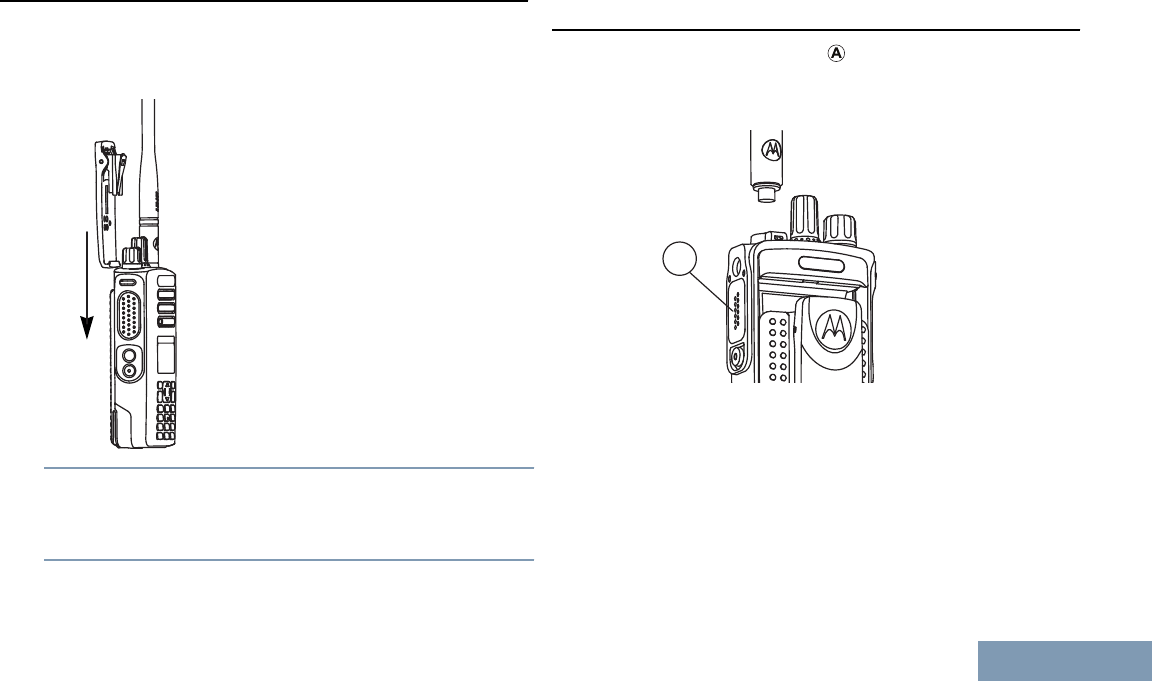
Attaching the Belt Clip
1To attach the belt clip, align the grooves on the
clip with those on the battery and press downward
until you hear a click.
2To remove the belt clip, press the belt clip tab
away from the battery using a key. Then slide the
clip upward and away from the radio.
Attaching the Universal Connector Cover
(Dust Cover)
The universal connector ( ) is located on the
antenna side of the radio. It is used to connect
MOTOTRBO accessories to the radio.
A
Insert the hooked end of the cover into the slots
above the universal connector. Press downward on
the cover to seat the lower tab properly into the RF
connector.
Turn the thumbscrew clockwise to secure the
connector cover to the radio.
Preparing Your Radio for Use
25
English

To remove the universal connector cover, press down
on the cover and turn the thumbscrew
counterclockwise.
Replace the dust cover when the universal connector
is not in use.
If the radio is exposed to water, dry the universal
connector before attaching an accessory or replacing
the dust cover.
If the radio is exposed to salt water or contaminants,
perform the following cleaning procedure.
1Mix one tablespoon of mild dishwashing detergent
with one gallon of water to produce a 0.5 percent
solution.
2Clean only the external surfaces of the radio with
the solution. Apply the solution sparingly with a
stiff, nonmetallic, short-bristled brush.
3Dry the radio thoroughly with a soft and lint-free
cloth. Ensure the contact surface of the universal
connector is clean and dry.
4Apply Deoxit Gold Cleaner or Lubricant Pen
(Manufacturer CAIG Labs, Part number G100P)
on the contact surface of the universal connector.
5Attach an accessory to the universal connector to
test the connectivity.
Note:
Do not submerge the radio in water. Ensure
excess detergent does not get trapped in
between the universal connector, controls, or
crevices.
Clean the radio once a month for maintenance. For a
harsher environment such as in petrochemical plants
or in a high salt density marine environment, clean
the radio more often.
Preparing Your Radio for Use
26
English
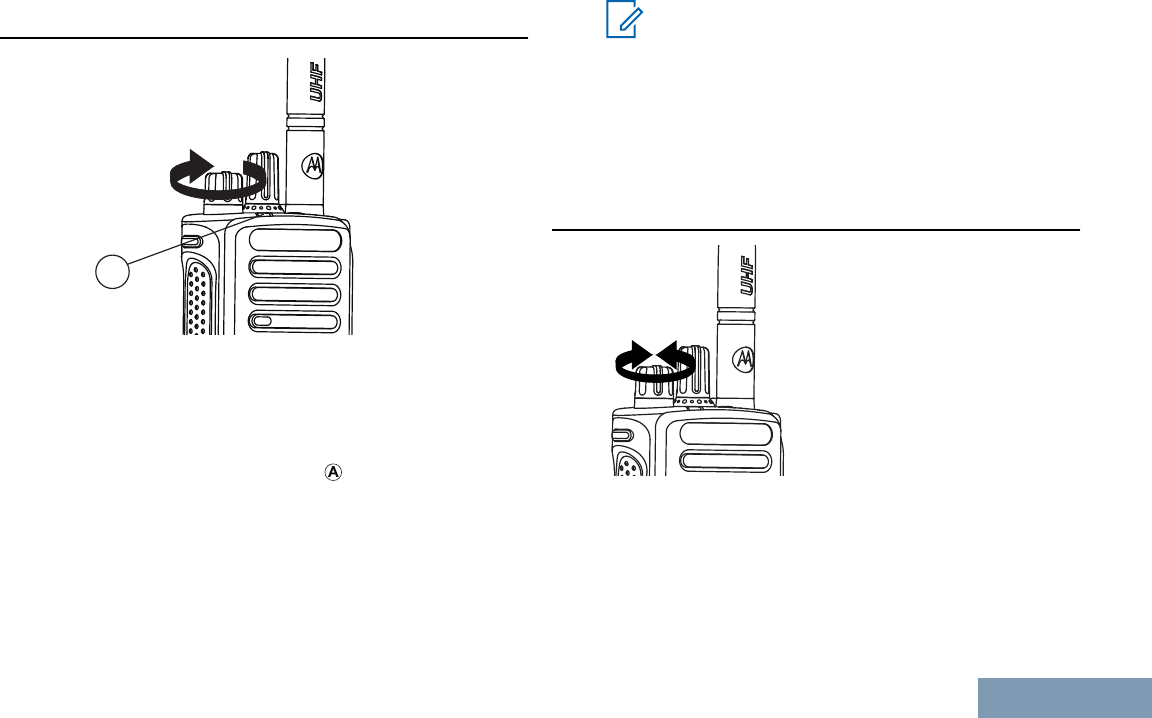
Powering Up the Radio
A
Rotate the On/Off/Volume Control Knob clockwise
until you hear a click. You see MOTOTRBO (TM) on the
display of the radio momentarily, followed by a
welcome message or welcome image.
The LED lights up solid green ( ) and the Home
screen lights up if the backlight setting is set to turn
on automatically.
A brief tone sounds, indicating that the power up test
is successful.
Note:
There is no power up tone if the radio tones/
alerts function is disabled (see Turning the
Radio Tones/Alerts On or Off on page 157).
Turn off the radio by rotating this knob
counterclockwise until you hear a click. You see a
brief Powering Down on the display of the radio.
Adjusting the Volume
Increase the volume by turning the On/Off/Volume
Control Knob clockwise.
Decrease the volume by turning this knob
counterclockwise.
Preparing Your Radio for Use
27
English

Note:
Your radio can be programmed to have a
minimum volume offset where the volume
level cannot be lowered past the programmed
minimum volume. Check with your dealer or
system administrator for more information.
Preparing Your Radio for Use
28
English
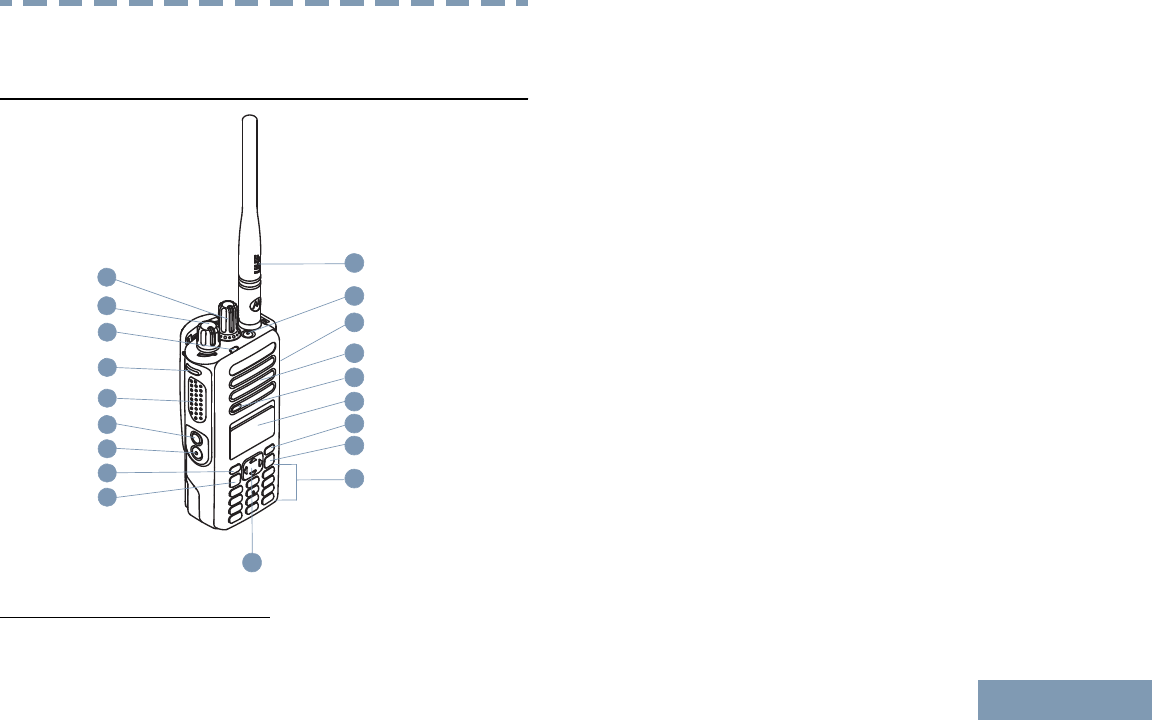
Identifying Radio Controls
Radio Controls
1
2
3
4
5
6
7
8
9
19
10
18
17
16
15
14
13
12
11
1Channel Selector Knob
2On/Off/Volume Control Knob
3LED Indicator
4Side Button 1[1]
5Push-to-Talk (PTT) Button
6Side Button 2[1]
7Side Button 3[1]
8Front Button P1[1]
9Menu/OK Button
10 4-Way Navigation Button
11 Keypad
12 Back/Home Button
13 Front Button P2[1]
14 Display
15 Microphone
16 Speaker
17 Universal Connector for Accessories
18 Emergency Button[1]
19 Antenna
1These buttons are programmable.
Identifying Radio Controls
29
English
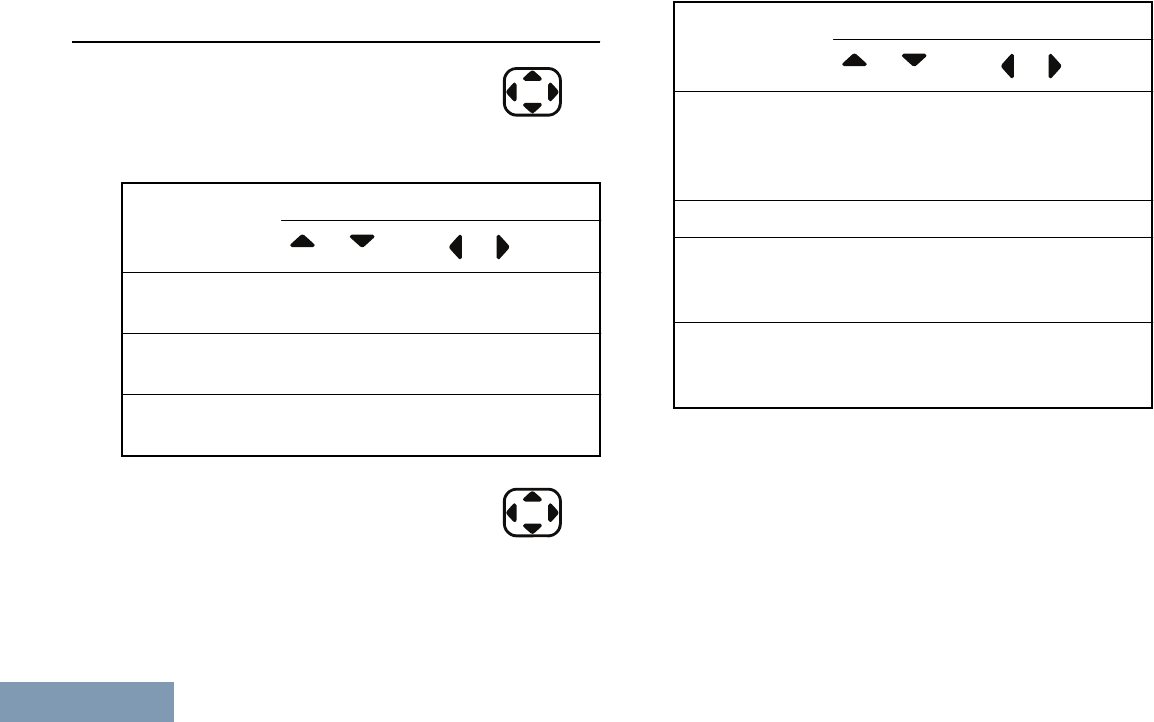
Using the 4–Way Navigation Button
You can use the 4–way navigation button, , to
scroll through options, increase/decrease values, and
navigate vertically.
Category Direction
or or
Menu Vertical Naviga-
tion
-
Lists Vertical Naviga-
tion
-
View Details Vertical Naviga-
tion
Previous/Next
Item
You can use the 4–way navigation button, , as
a number, alias, or free form text editor.
Editor Catego-
ry
Direction
or or
Number - Left : Delete last
digit
Right : -
Alias - -
Free Form Text Move cursor up/
down
Move cursor
one character
right/left
Numeric Values Increase/
Decrease
Move cursor
one character
right/left
Identifying Radio Controls
30
English
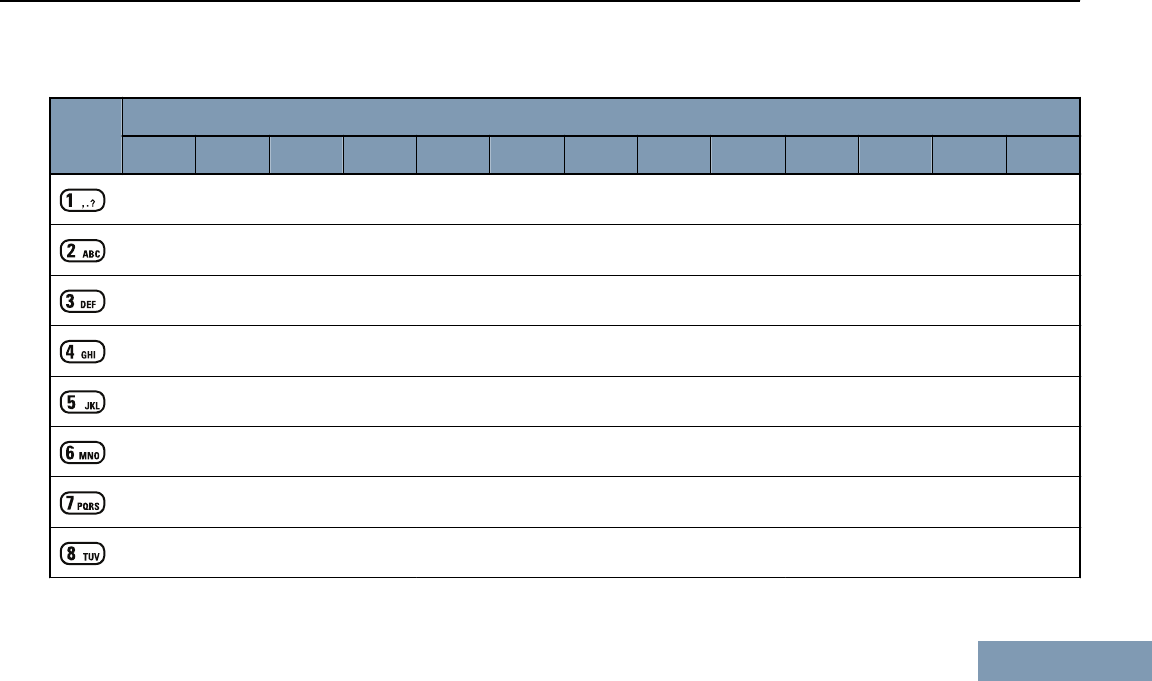
Using the Keypad
You can use the 3 x 4 alphanumeric keypad to access your radio’s features. You can use the keypad to enter
subscriber aliases or IDs, and text messages. Many characters require that you press a key multiple times. The next
table shows the number of times a key needs to be pressed to generate the required character.
Key Number of Times Key is Pressed
1 2 3 4 5 6 7 8 9 10 11 12 13
1 . , ? ! @ & ' % — : * #
A B C 2
D E F 3
G H I 4
J K L 5
M N O 6
P Q R S 7
T U V 8
Identifying Radio Controls
31
English
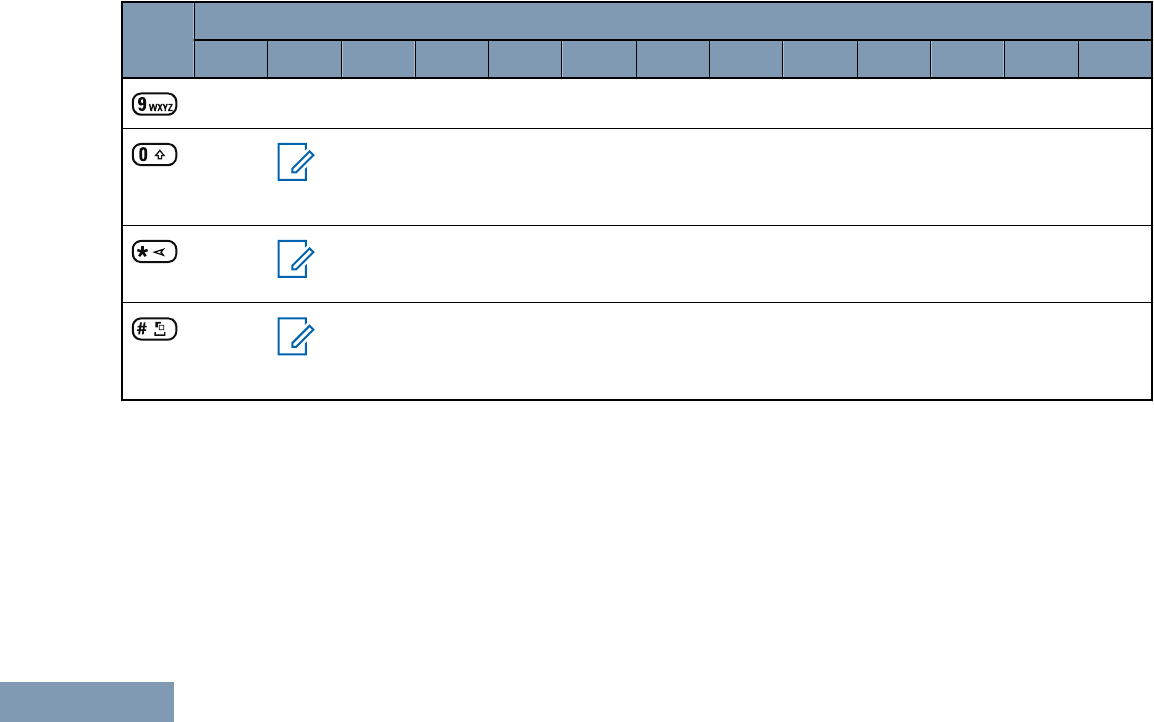
Key Number of Times Key is Pressed
1 2 3 4 5 6 7 8 9 10 11 12 13
W X Y Z 9
0Note:
Press to enter “0” and long press to activate the CAPS lock. Another long press to turn off
the CAPS lock.
* or
del Note:
Press during text entry to delete the character. Press during numeric entry to enter a “*”.
# or
space Note:
Press during text entry to insert a space. Press during numeric entry to enter a “#”. Long
press to change text entry method.
Identifying Radio Controls
32
English

Non-Connect Plus Operations
Non-Connect Plus Operations
33
English
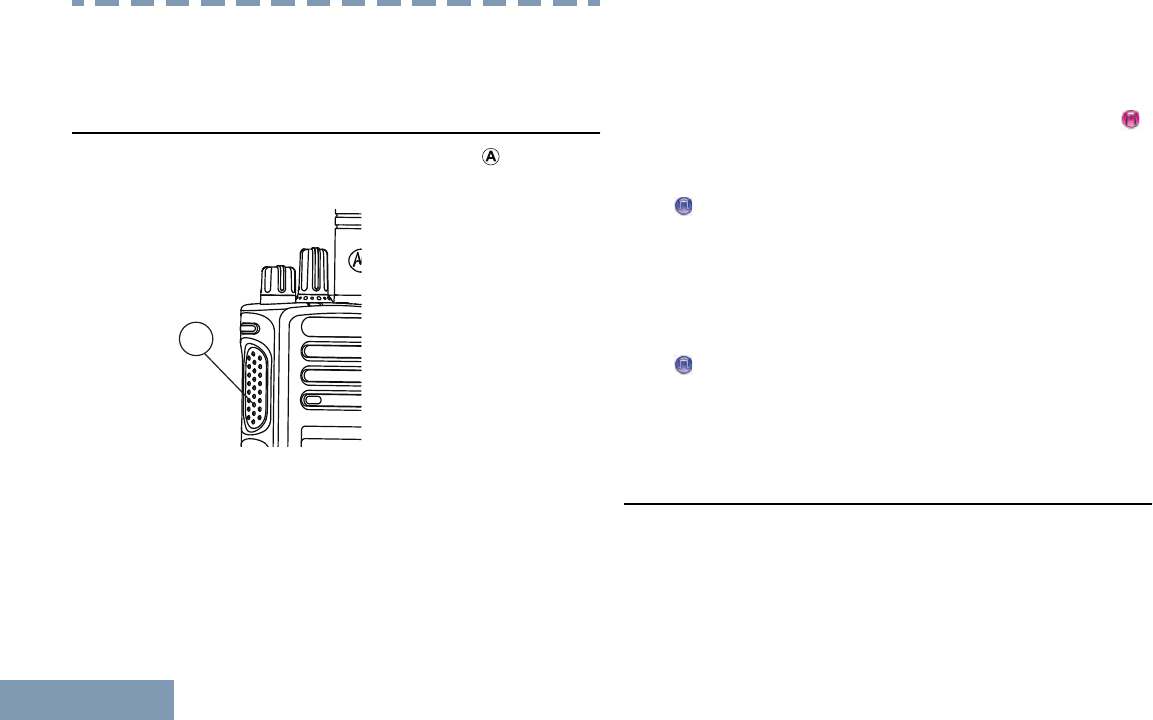
Additional Radio Controls in Non-
Connect Plus Mode
Push-To-Talk (PTT) Button
The PTT button on the side of the radio ( ) serves
two basic purposes:
A
• While a call is in progress, the PTT button allows
the radio to transmit to other radios in the call.
Press and hold the PTT button to talk. Release the
PTT button to listen.
The microphone is activated when the PTT button
is pressed.
• While a call is not in progress, the PTT button is
used to make a new call (see Making a Radio Call
on page 56).
If the Talk Permit Tone (see Turning the Talk Permit
Tone On or Off on page 158) or the PTT Sidetone
is enabled, wait until the short alert tone ends before
talking.
During a call, if the Channel Free Indication feature
is enabled on your radio (programmed by your
dealer), you will hear a short alert tone the moment
the target radio (the radio that is receiving your call)
releases the PTT button, indicating the channel is
free for you to respond.
You will also hear a continuous talk prohibit tone, if
your call is interrupted, indicating that you should
release the PTT button, for example when the radio
receives an Emergency Call.
Programmable Buttons
Your dealer can program the programmable buttons
as shortcuts to radio functions depending on the
duration of a button press:
Short press Pressing and releasing rapidly.
Additional Radio Controls in Non-Connect Plus Mode
34
English

Long press Pressing and holding for the
programmed duration.
Press and hold Keeping the button pressed.
Note:
The programmed duration of a button press is
applicable for all assignable radio/utility
functions or settings. See Emergency
Operation on page 103 for more information
on the programmed duration of the
Emergency button.
Assignable Radio Functions
Audio Profiles Allows the user to select the
preferred audio profile.
Audio Routing Toggles audio routing
between internal and external
speakers.
Audio Toggle Toggles audio routing
between the internal radio
speaker and the speaker of
wired accessory.
Bluetooth® Audio
Switch
Toggles audio routing
between internal radio
speaker and external
Bluetooth-enabled accessory.
Call Alert Provides direct access to the
contacts list for you to select a
contact to whom a Call Alert
can be sent.
Call Forwarding Toggles Call Forwarding on or
off.
Call Log Selects the call log list.
Contacts Provides direct access to the
Contacts list.
Emergency Depending on the
programming, initiates or
cancels an emergency.
Intelligent Audio Toggles intelligent audio on or
off.
Manual Dial Depending on the
programming, initiates a
Private or Phone Call by
keying in any subscriber ID or
phone number.
Additional Radio Controls in Non-Connect Plus Mode
35
English

Manual Site
Roam[2]
Starts the manual site search.
Mic AGC On/Off Toggles the internal
microphone automatic gain
control (AGC) on or off.
Monitor Monitors a selected channel
for activity.
Notifications Provides direct access to the
Notifications list.
Nuisance Channel
Delete[2]
Temporarily removes an
unwanted channel, except for
the Selected Channel, from
the scan list. The Selected
Channel refers to the selected
zone or channel combination
of the user from which scan is
initiated.
One Touch Access Directly initiates a predefined
Private, Phone or Group Call,
a Call Alert or a Quick Text
message.
Option Board
Feature
Toggles option board
feature(s) on or off for option
board-enabled channels.
Permanent Monitor Monitors a selected channel
for all radio traffic until function
is disabled.
Phone Provides direct access to the
Phone Contacts list.
Privacy Toggles privacy on or off.
Radio Alias and ID Provides radio alias and ID.
Radio Check Determines if a radio is active
in a system.
Radio Enable Allows a target radio to be
remotely enabled.
Radio Disable Allows a target radio to be
remotely disabled.
Remote Monitor Turns on the microphone of a
target radio without it giving
any indicators.
Additional Radio Controls in Non-Connect Plus Mode
36
English

Repeater/
Talkaround[2]
Toggles between using a
repeater and communicating
directly with another radio.
Scan[2] Toggles scan on or off.
Site Info Displays current Linked
Capacity Plus site name and
ID. Plays site announcement
voice messages for the
current site (this function is
unavailable when Voice
Announcement is disabled).
Site Lock On/Off[2] When toggled on, the radio
searches the current site only.
When toggled off, the radio
searches other sites in
addition to the current site.
Status Selects the status list menu.
Telemetry Control Controls the Output Pin on a
local or remote radio.
Text Message Selects the text message
menu.
Transmit Interrupt
Remote Dekey
Stops the transmission of a
remote monitored radio
without giving any indicators,
or an ongoing interruptible call
to free the channel.
Trill Enhancement
On/Off
Toggles trill enhancement on
or off.
Voice
Announcement for
Channel
Plays zone and channel
announcement voice
messages for the current
channel. This function is
unavailable when Voice
Announcement is disabled.
Voice
Announcement
On/Off
Toggles voice announcement
on or off.
Voice Operating
Transmission
(VOX)
Toggles VOX on or off.
Zone Allows selection from a list of
zones.
Additional Radio Controls in Non-Connect Plus Mode
37
English
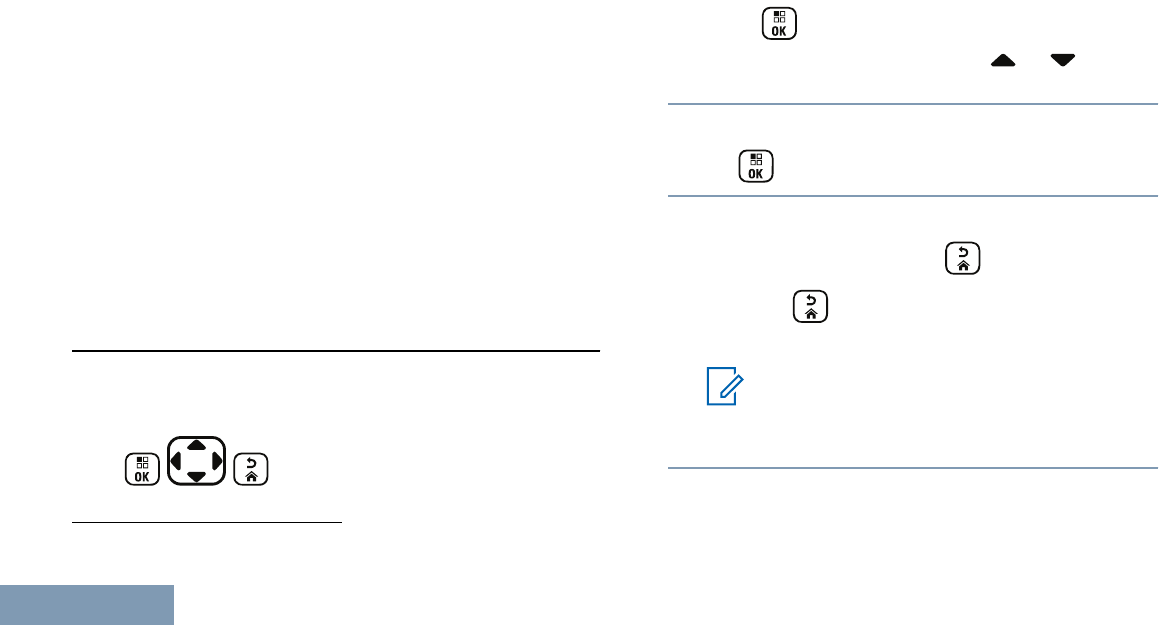
Assignable Settings or Utility Functions
All Tones/Alerts Toggles all tones and alerts on
or off.
Backlight Toggles display backlight on or
off.
Backlight
Brightness
Adjusts the brightness level.
Display Mode Toggles the day/night display
mode on or off.
Keypad Lock Toggles keypad between
locked and unlocked.
Power Level Toggles transmit power level
between high and low.
Accessing the Programmed Functions
You can access various radio functions through one
of the following ways:
• A short or long press of the relevant
programmable buttons.
• Use the Menu Navigation Buttons as follows:
1
Press to access the menu. Press the
appropriate Menu Scroll button ( or ) to
access the menu functions.
2To select a function or enter a sub-menu, press
the button.
3To go back one menu level, or to return to the
previous screen, press the button. Long
press the button to return to the Home
screen.
Note:
Your radio automatically exits the menu
after a period of inactivity and returns to
your Home screen.
2Not applicable in Capacity Plus and Linked Capacity Plus
Additional Radio Controls in Non-Connect Plus Mode
38
English
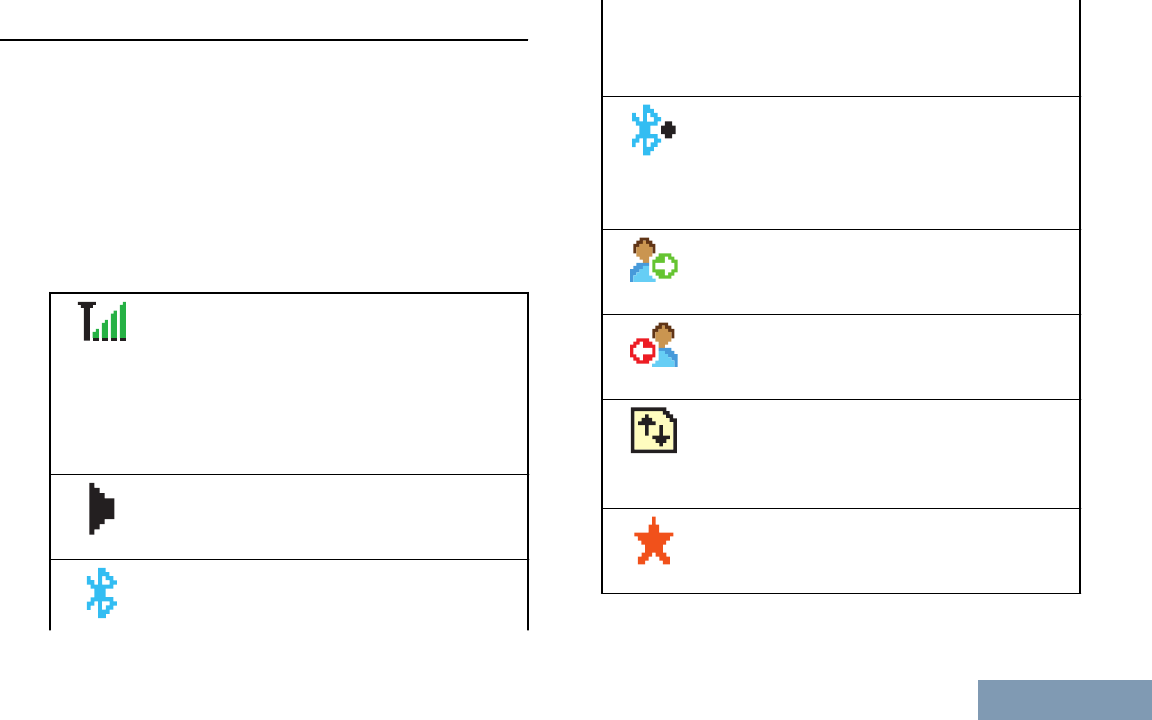
Identifying Status Indicators
Display Icons
The 132 x 90 pixels, 256 colors, liquid crystal display
(LCD) of your radio shows radio status, text entries,
and menu entries.
The following are icons that appear on the display of
the radio. Icons are displayed on the status bar,
arranged left-most in order of appearance/usage and
are channel specific.
Received Signal Strength Indicator
(RSSI)
The number of bars displayed repre-
sents the radio signal strength. Four
bars indicate the strongest signal. This
icon is only displayed while receiving.
Monitor
Selected channel is being monitored.
Bluetooth
The Bluetooth feature is enabled but
there is no remote Bluetooth device con-
nected.
Bluetooth Connected
The Bluetooth feature is enabled. The
icon stays lit when a remote Bluetooth
device is connected.
Sign In
Radio is signed in to the remote server.
Sign Out
Radio is signed out of the remote server.
High Volume Data
Radio is receiving high volume data and
channel is busy.
Job Ticket Notification
Notification List has items to review.
Additional Radio Controls in Non-Connect Plus Mode
39
English
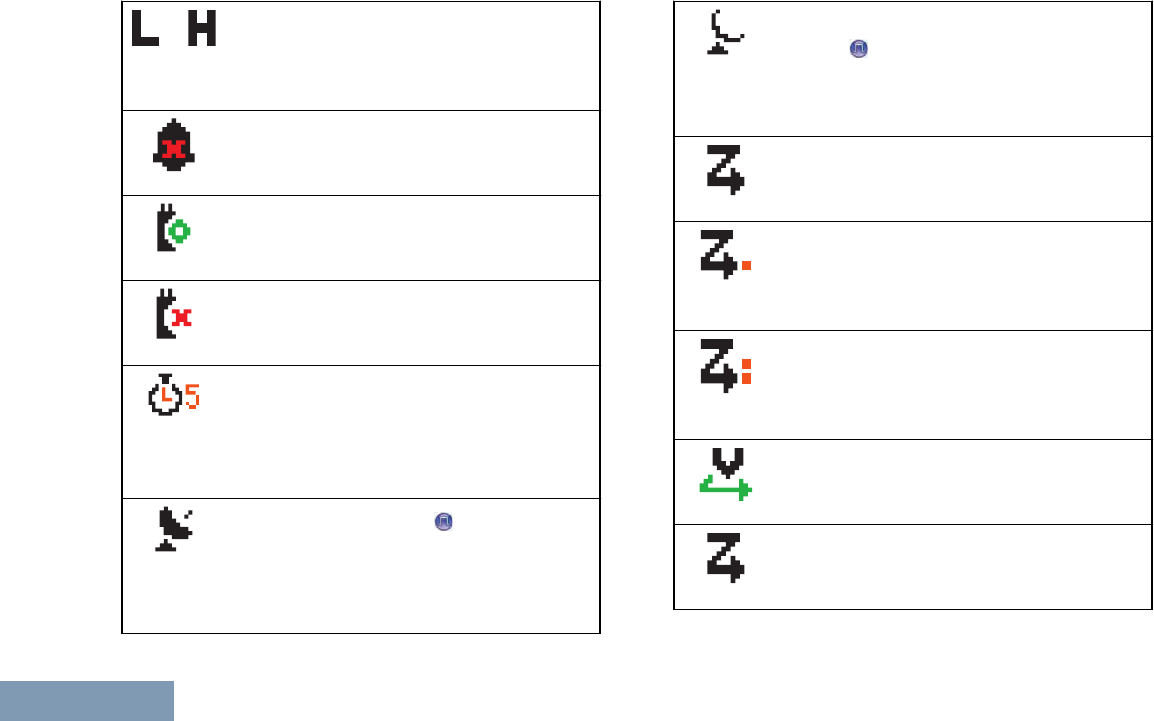
or Power Level
Radio is set at Low power or Radio is
set at High power.
Tones Disable
Tones are turned off.
Option Board
The Option Board is enabled.
Option Board Non-Function
The Option Board is disabled.
Over-the-Air Programming Delay Tim-
er
Indicates time left before automatic re-
start of radio.
GPS/GNSS Available
The GPS/GNSS feature is enabled. The
icon stays lit when a position fix is avail-
able.
GPS/GNSS Not Available/Out of
Range
The GPS/GNSS feature is enabled but
is not receiving data from the satellite.
Scan[3][4]
Scan feature is enabled.
Scan- Priority 1[3][4]
Radio detects activity on channel/group
designated as Priority 1.
Scan- Priority 2[3][4]
Radio detects activity on channel/group
designated as Priority 2.
Vote Scan
Vote scan feature is enabled.
Flexible Receive List
Flexible receive list is enabled.
Additional Radio Controls in Non-Connect Plus Mode
40
English
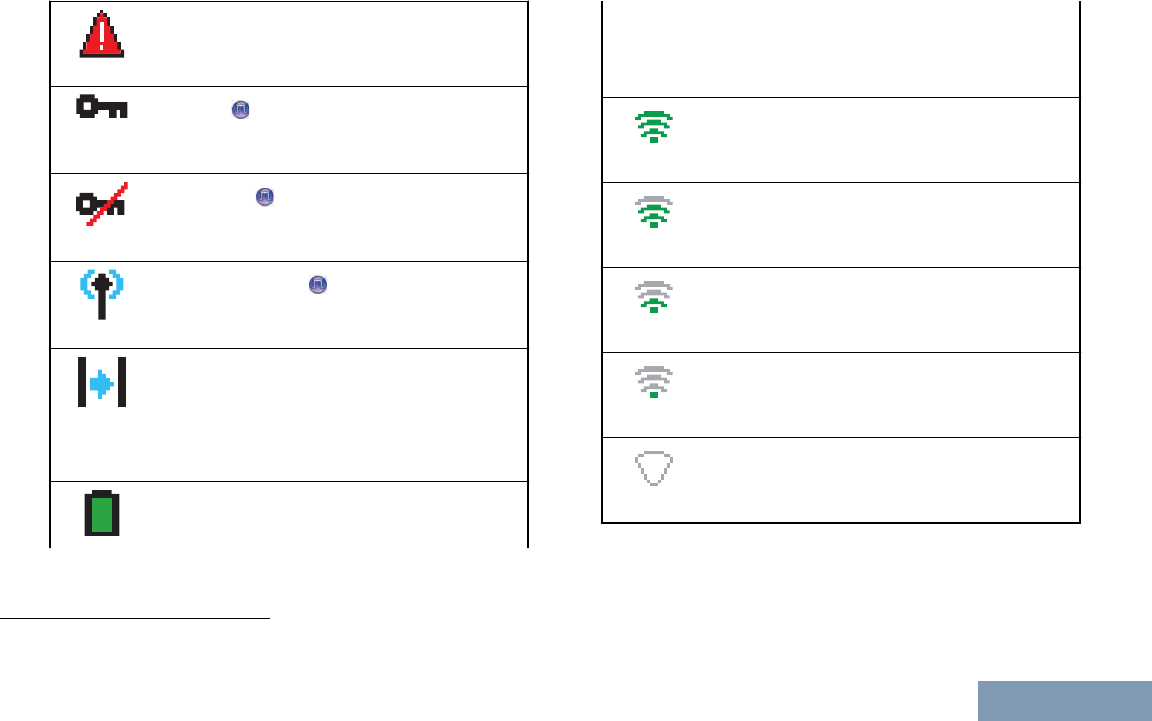
Emergency
Radio is in Emergency mode.
Secure
The Privacy feature is enabled.
Unsecure
The Privacy feature is disabled.
Site Roaming[3]
The site roaming feature is enabled.
Talkaround[3][4]
In the absence of a repeater, radio is
currently configured for direct radio to ra-
dio communication.
Battery
The number of bars (0 – 4) shown indi-
cates the charge remaining in the bat-
tery. Blinks when the battery is low.
Wi-Fi Excellent[5]
Wi-Fi signal is excellent.
Wi-Fi Good[5]
Wi-Fi signal is good.
Wi-Fi Average[5]
Wi-Fi signal is average.
Wi-Fi Poor[5]
Wi-Fi signal is poor.
Wi-Fi Unavailable[5]
Wi-Fi signal is unavailable.
3Not applicable in Capacity Plus
Additional Radio Controls in Non-Connect Plus Mode
41
English
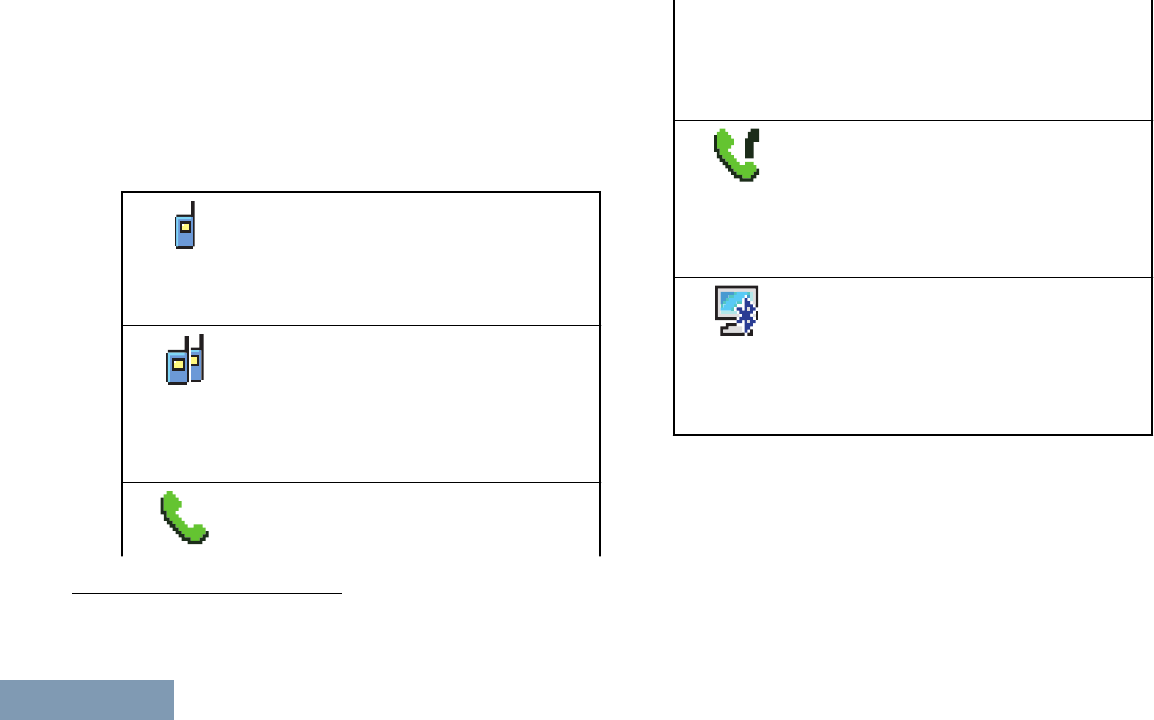
Call Icons
The following icons appear on the radio’s display
during a call. These icons also appear in the Contacts
list to indicate ID type.
Private Call
Indicates a Private Call in progress. In
the Contacts list, it indicates a sub-
scriber alias (name) or ID (number).
Group Call/All Call
Indicates a Group Call or All Call in
progress. In the Contacts list, it indi-
cates a group alias (name) or ID
(number).
Phone Call as Private Call
Indicates a Phone Call as Private Call
in progress. In the Contacts list, it indi-
cates a phone alias (name) or ID
(number).
Phone Call as Group/All Call
Indicates a Phone Call as Group/All
Call in progress. In the Contacts list, it
indicates a group alias (name) or ID
(number).
Bluetooth PC Call
Indicates a Bluetooth PC Call in prog-
ress. In the Contacts list, it indicates a
Bluetooth PC Call alias (name) or ID
(number).
Advanced Menu Icons
The following icons appear beside menu items that
offer a choice between two options or as an indication
that there is a sub-menu offering two options.
4Not applicable in Linked Capacity Plus
5Only applicable for XPR 7550e/XPR 7580e
Additional Radio Controls in Non-Connect Plus Mode
42
English
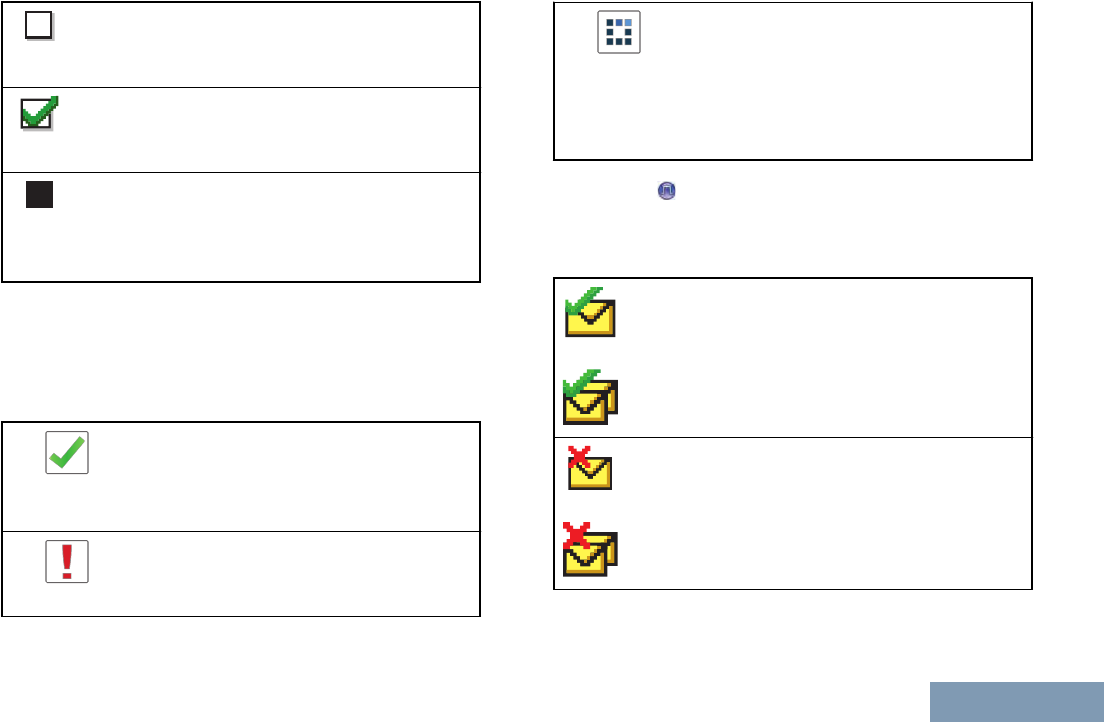
Checkbox (Empty)
Indicates the option is not selected.
Checkbox (Checked)
Indicates the option is selected.
Solid Black Box
Indicates the option selected for the menu
item with a sub-menu.
Mini Notice Icons
The following icons appear momentarily on the
radio’s display after an action to perform task is
taken.
Successful Transmission (Posi-
tive)
Successful action taken.
Failed Transmission (Negative)
Failed action taken.
Transmission in Progress (Transi-
tional)
Transmitting. This is seen before indi-
cation for Successful Transmission or
Failed Transmission.
Sent Item Icons
The following icons appear at the top right corner of
the radio’s display in the Sent Items folder.
OR
Sent Successfully
The text message is sent successfully.
OR
Send Failed
The text message has not been sent.
Additional Radio Controls in Non-Connect Plus Mode
43
English
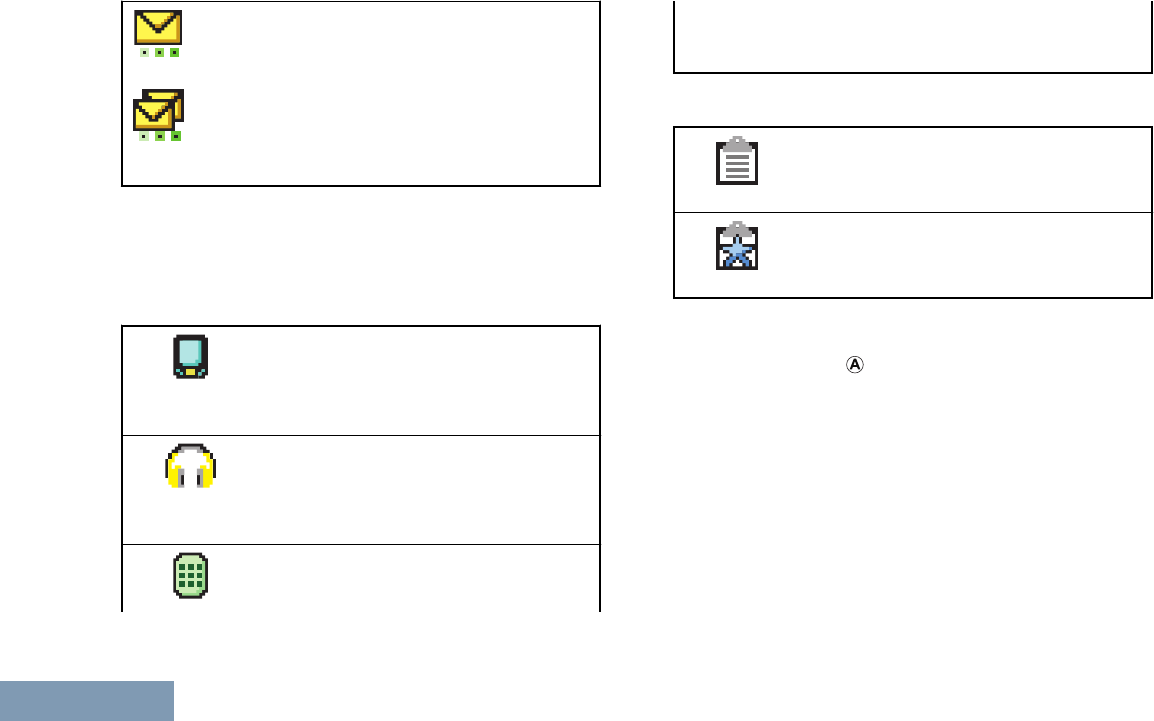
OR
In-Progress
• The text message to a group alias or ID
is pending transmission.
• The text message to a subscriber alias
or ID is pending transmission, followed
by waiting for acknowledgement.
Bluetooth Device Icons
The following icons also appear next to items in the
list of Bluetooth-enabled devices available to indicate
the device type.
Bluetooth Data Device
Bluetooth-enabled data device, such
as a scanner.
Bluetooth Audio Device
Bluetooth-enabled audio device,
such as a headset.
Bluetooth PTT Device
Bluetooth-enabled PTT device, such
as a PTT-Only Device (POD).
Job Tickets Icons
All Jobs
Indicates all jobs listed.
New Jobs
Indicates new jobs.
LED Indicator
The LED indicator ( ) shows the operational status of
your radio.
Additional Radio Controls in Non-Connect Plus Mode
44
English

A
Blinking
red
Battery mismatch occurs or radio is
transmitting at low battery condition,
receiving an emergency transmission
or has failed the self-test upon
powering up, or has moved out of
range if radio is configured with Auto-
Range Transponder System.
Solid
yellow
Radio is monitoring a conventional
channel or in Bluetooth Discoverable
Mode.
Blinking
yellow
Radio is scanning for activity or
receiving a Call Alert, flexible receive
list is enabled or all local Linked
Capacity Plus channels are busy.
Double
blinking
yellow
Radio is no longer connected to the
repeater while in Capacity Plus or
Linked Capacity Plus; all Capacity Plus
or Linked Capacity Plus channels are
currently busy. Auto Roaming is
enabled, radio is actively searching for
a new site. Also indicates that radio
has yet to respond to a group call alert,
or radio is locked.
Solid
green
Radio is powering up or transmitting.
Blinking
green
Radio is powering up, receiving a non-
privacy-enabled call or data, or
detecting activity, or retrieving Over-
the-Air Programming transmissions
over the air.
Double
blinking
green
Radio is receiving a privacy-enabled
call or data.
Additional Radio Controls in Non-Connect Plus Mode
45
English
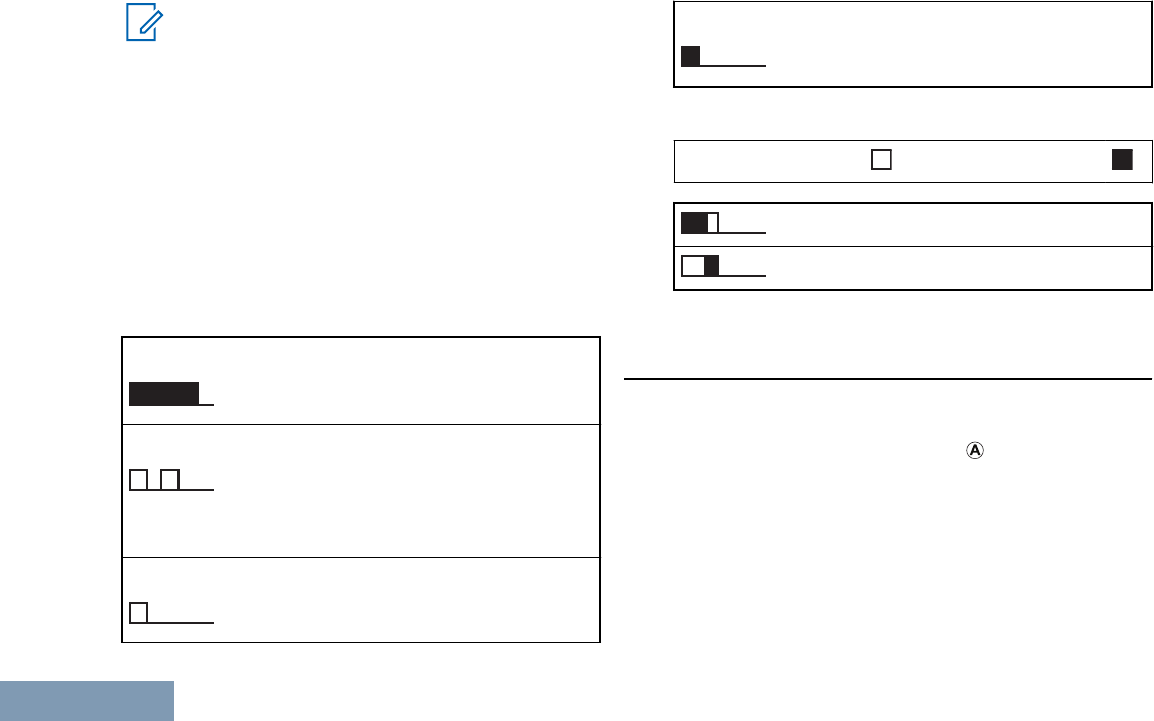
Note:
While in conventional mode, when the LED
blinks green, it indicates the radio detects
activity over the air. Due to the nature of the
digital protocol, this activity may or may not
affect the radio's programmed channel.
For Capacity Plus and Linked Capacity Plus,
there is no LED indication when the radio is
detecting activity over the air.
Alert Tones
Alert tones provide you with audible indications of the
status, or response to data received on the radio.
Continuous Tone A monotone sound.
Sounds continuously un-
til termination.
Periodic Tone Sounds periodically de-
pending on the duration
set by the radio. Tone
starts, stops, and repeats
itself.
Repetitive Tone A single tone that re-
peats itself until it is ter-
minated by the user.
Momentary Tone Sounds only once for a
short period of time de-
fined by the radio.
Indicator Tones
High pitched tone Low pitched tone
Positive Indicator Tone
Negative Indicator Tone
Switching Between Conventional Analog and
Digital Mode
Each channel in your radio can be configured as a
conventional analog or conventional digital channel.
Use the Channel Selector Knob ( ) to switch
between an analog or a digital channel.
Additional Radio Controls in Non-Connect Plus Mode
46
English
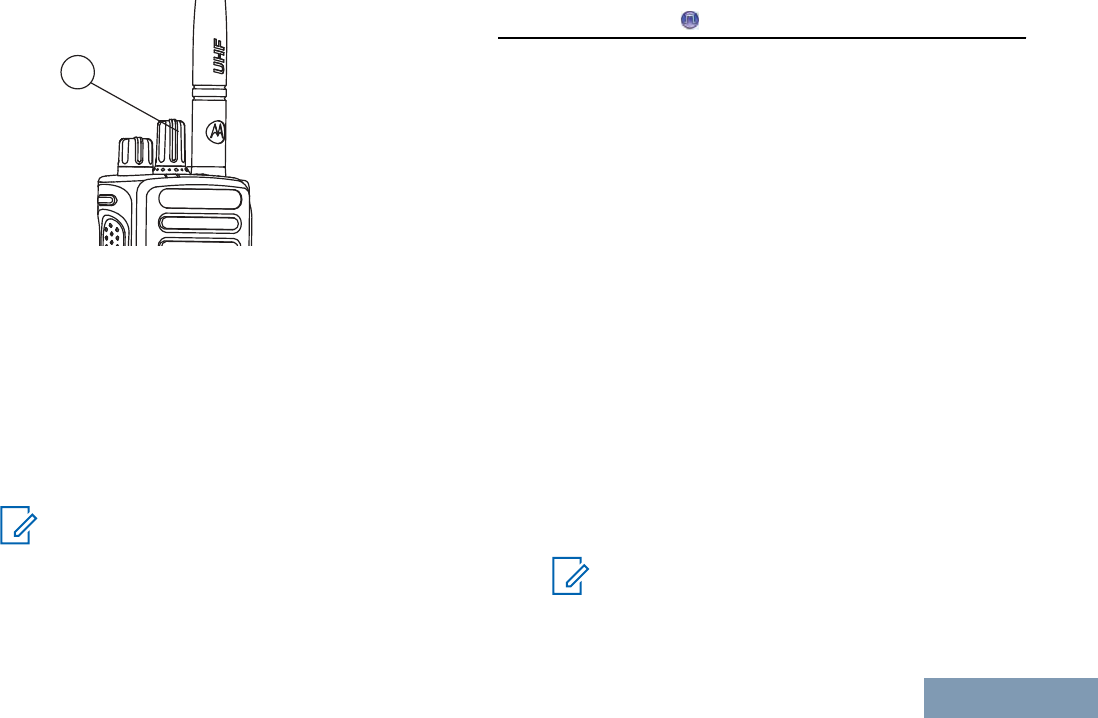
A
When switching from digital to analog mode, certain
features are unavailable. Icons for the digital features
(such as Messages) reflect this change by appearing
‘grayed out’. Disabled features are hidden in the
menu.
Your radio also has features available in both analog
and digital mode. However, the minor differences in
the way each feature works does not affect the
performance of your radio.
Note:
Your radio also switches between digital and
analog modes during a dual mode scan (see
Scan on page 80).
IP Site Connect
This feature allows your radio to extend conventional
communication beyond the reach of a single site, by
connecting to different available sites which are
connected via an Internet Protocol (IP) network.
When the radio moves out of range from one site and
into the range of another, it connects to the new site's
repeater to send or receive calls/data transmissions.
Depending on your settings, this is done
automatically or manually.
If the radio is set to do this automatically, it scans
through all available sites when the signal from the
current site is weak or when the radio is unable to
detect any signal from the current site. It then locks
on to the repeater with the strongest Received Signal
Strength Indicator (RSSI) value.
In a manual site search, the radio searches for the
next site in the roam list that is currently in range (but
which may not have the strongest signal) and locks
on to it.
Note:
Each channel can only have either Scan or
Roam enabled, not both at the same time.
Additional Radio Controls in Non-Connect Plus Mode
47
English
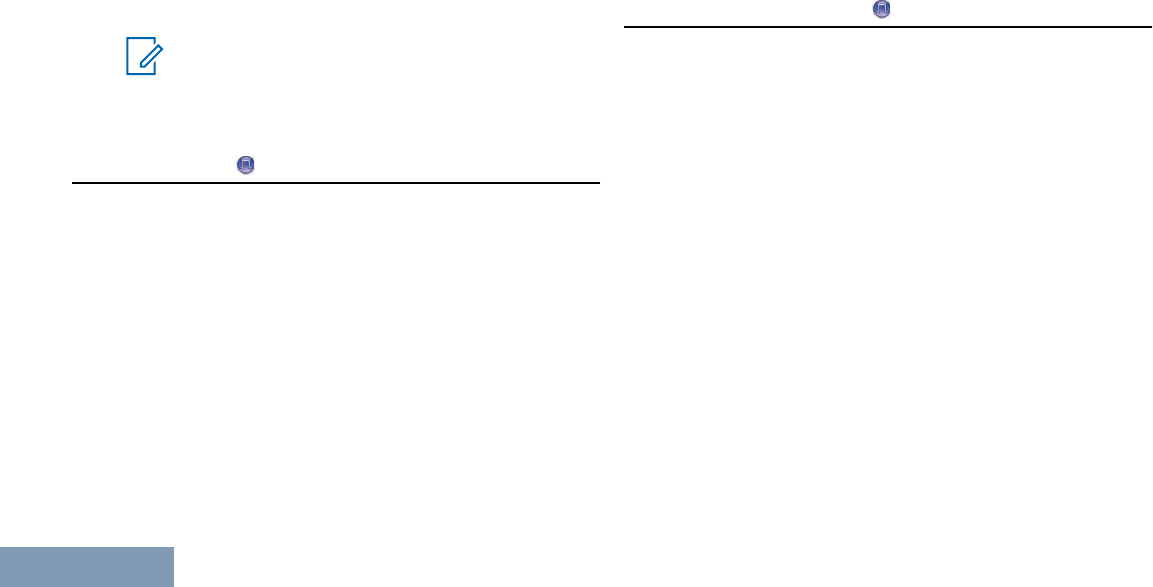
Channels with this feature enabled can be added to a
particular roam list. The radio searches the channel(s)
in the roam list during the automatic roam operation
to locate the best site.
A roam list supports a maximum of 16 channels
(including the Selected Channel).
Note:
You cannot manually add or delete an entry to
the roam list. Check with your dealer or
system administrator for more information.
Capacity Plus
Capacity Plus is a single-site trunking configuration of
the MOTOTRBO radio system, which uses a pool of
channels to support hundreds of users and up to 254
Groups. This feature allows your radio to efficiently
utilize the available number of programmed channels
while in Repeater Mode.
You hear a negative indicator tone if you try to access
a feature not applicable to Capacity Plus via a
programmable button press.
Your radio also has features that are available in
conventional digital mode, IP Site Connect, Capacity
Plus and Linked Capacity Plus. However, the minor
differences in the way each feature works does not
affect the performance of your radio.
Check with your dealer or system administrator for
more information on this configuration.
Linked Capacity Plus
Linked Capacity Plus is a multi-site multi-channel
trunking configuration of the MOTOTRBO radio
system, combining the best of both Capacity Plus and
IP Site Connect configurations.
Linked Capacity Plus allows your radio to extend
trunking communication beyond the reach of a single
site, by connecting to different available sites which
are connected via an Internet Protocol (IP) network. It
also provides an increase in capacity by efficiently
utilizing the combined available number of
programmed channels supported by each of the
available sites.
When the radio moves out of range from one site and
into the range of another, it connects to the new site's
repeater to send or receive calls/data transmissions.
Depending on your settings, this is done
automatically or manually.
Additional Radio Controls in Non-Connect Plus Mode
48
English

If the radio is set to do this automatically, it scans
through all available sites when the signal from the
current site is weak or when the radio is unable to
detect any signal from the current site. It then locks
on to the repeater with the strongest Received Signal
Strength Indicator (RSSI) value.
In a manual site search, the radio searches for the
next site in the roam list that is currently in range (but
which may not have the strongest signal) and locks
on to it.
Any channel with Linked Capacity Plus enabled can
be added to a particular roam list. The radio searches
these channels during the automatic roam operation
to locate the best site.
Note:
You cannot manually add or delete an entry to
the roam list. Check with your dealer or
system administrator for more information.
Similar to Capacity Plus, icons of features not
applicable to Linked Capacity Plus are not available
in the menu. You hear a negative indicator tone if you
try to access a feature not applicable to Linked
Capacity Plus via a programmable button press.
Check with your dealer or system administrator for
more information on this configuration.
Additional Radio Controls in Non-Connect Plus Mode
49
English
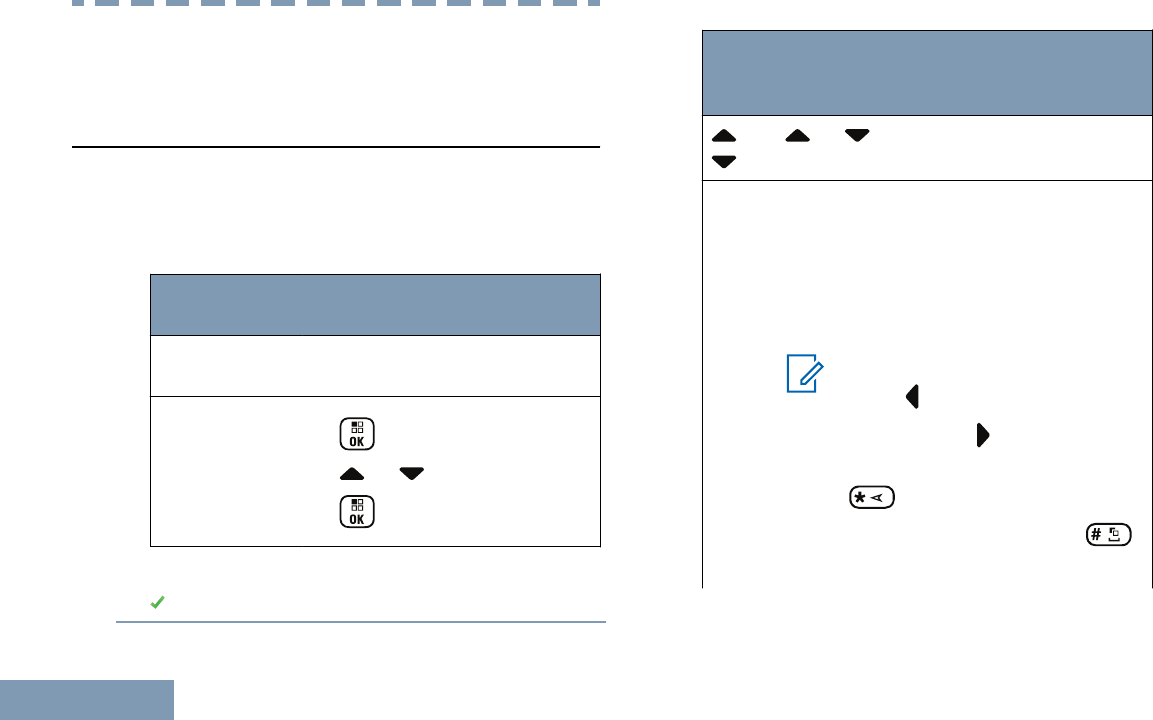
Making and Receiving Calls in Non-
Connect Plus Mode
Selecting a Zone
A zone is a group of channels. Your radio supports up
to 1000 channels and 250 zones, with a maximum of
160 channels per zone.
1Access the Zone feature.
Radio Con-
trols
Steps
Programmed
Zone button
Press the programmed Zone
button.
Radio menu 1
to access the menu.
2 or to Zone and press
to select.
The current zone is displayed and indicated by a
.
2Select the required zone.
Radio
Con-
trol
Steps
or or and scroll to the required
zone.
Key-
pad 1Enter the first character of the re-
quired zone.
2A blinking cursor appears allowing
you to continue entering the subse-
quent characters of the required
zone.
Note:
Press to move one space to
the left. Press to move one
space to the right. Press the
key to delete any unwant-
ed characters. Long press
to change the text entry method.
Making and Receiving Calls in Non-Connect Plus Mode
50
English
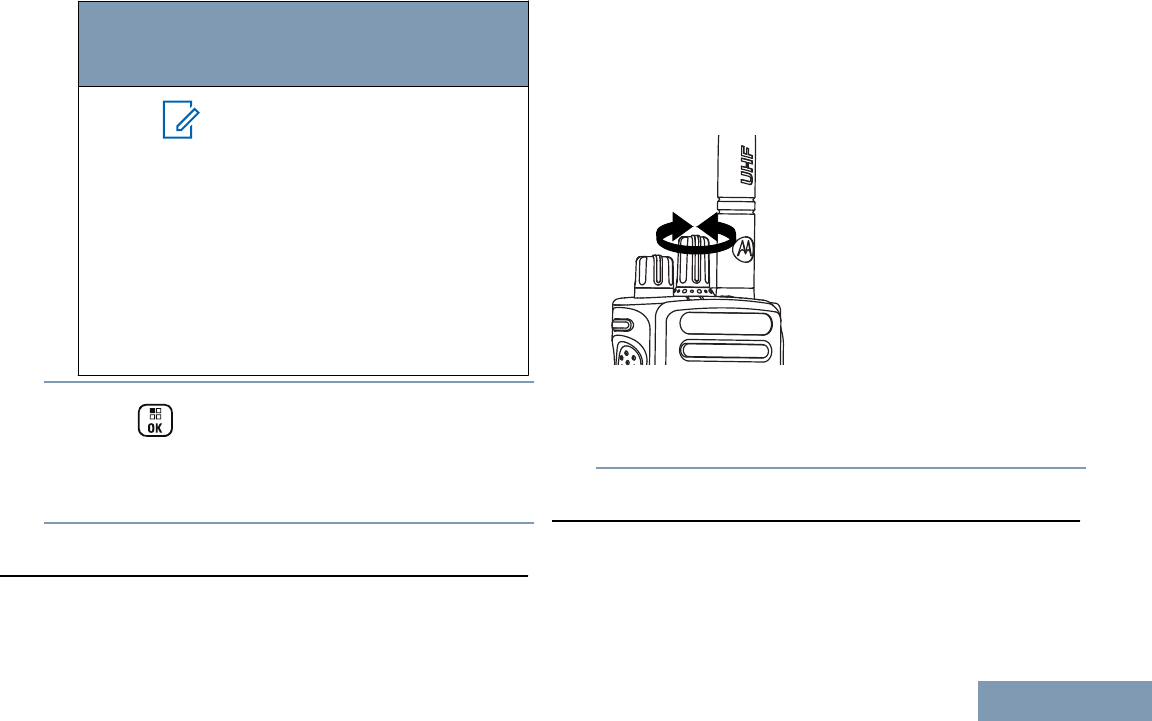
Radio
Con-
trol
Steps
Note:
The first line of the display
shows the characters you keyed
in. The second line shows a
zone that matches what you
have already keyed in. The alias
search is case-insensitive. If
there are two or more with the
same name, the radio displays
the zone that is listed first in the
zone list.
3
Press to select.
The display shows <Zone> Selected
momentarily and returns to the selected zone
screen.
Selecting a Channel
Transmissions are sent and received on a channel.
Depending on your radio’s configuration, each
channel may have been programmed differently to
support different groups of users or supplied with
different features. After selecting the relevant Zone,
select the relevant channel you require to transmit or
receive on.
Turn the programmed Channel Selector Knob to
select the channel, subscriber alias or ID, or group
alias or ID.
Receiving and Responding to a Radio Call
Once the channel, subscriber ID, or group ID is
displayed, you can proceed to receive and respond to
calls.
Making and Receiving Calls in Non-Connect Plus Mode
51
English

The LED lights up solid green while the radio is
transmitting and blinks green when the radio is
receiving.
Note:
The LED lights up solid green while the radio
is transmitting and double blinks green when
the radio is receiving a privacy-enabled call.
To unscramble a privacy-enabled call, your
radio must have the same Privacy Key, OR
the same Key Value and Key ID (programmed
by your dealer), as the transmitting radio (the
radio you are receiving the call from).
See Privacy on page 129 for more
information.
Receiving and Responding to a Group Call
To receive a call from a group of users, your radio
must be configured as part of that group.
When you receive a Group Call (while on the Home
screen), the LED blinks green. The Group Call icon
appears in the top right corner. The first text line
shows the caller alias. The second text line displays
the group call alias. Your radio unmutes and the
incoming call sounds through the radio's speaker.
1Hold the radio vertically 1 to 2 inches (2.5 to 5.0
cm) from your mouth.
• If the Channel Free Indication feature is
enabled, you hear a short alert tone the
moment the transmitting radio releases the
PTT button, indicating the channel is free for
you to respond. Press the PTT button to
respond.
• If the Voice Interrupt feature is enabled,
press the PTT button to stop the current call
from the transmitting radio and free the channel
for you to talk/respond.
The LED lights up solid green.
2Wait for one of the following tones to finish (if
enabled), and speak clearly into the microphone.
• The Talk Permit Tone
•The PTT Sidetone
3Release the PTT button to listen.
If there is no voice activity for a predetermined period
of time, the call ends.
Making and Receiving Calls in Non-Connect Plus Mode
52
English

Note:
See Making a Group Call on page 57 for
details on making a Group Call.
Receiving and Responding to a Private Call
A Private Call is a call from an individual radio to
another individual radio.
When you receive a Private Call, the LED blinks
green. The Private Call icon appears in the top right
corner. The first text line shows the caller alias. Your
radio unmutes and the incoming call sounds through
the speaker of the radio.
1Hold the radio vertically 1 to 2 inches (2.5 to 5.0
cm) from your mouth.
• If the Channel Free Indication feature is
enabled, you hear a short alert tone the
moment the transmitting radio releases the
PTT button, indicating the channel is free for
you to respond. Press the PTT button to
respond.
• If the Voice Interrupt feature is enabled,
press the PTT button to stop the current call
from the transmitting radio and free the channel
for you to talk/respond.
The LED lights up solid green.
2Wait for the Talk Permit Tone to finish (if enabled),
and speak clearly into the microphone.
3Release the PTT button to listen.
If there is no voice activity for a predetermined period
of time, the call ends.
You hear a short tone. The display shows Call
Ended.
See Making a Private Call on page 58 for details on
making a Private Call.
Receiving an All Call
An All Call is a call from an individual radio to every
radio on the channel. It is used to make important
announcements requiring the user’s full attention.
When you receive an All Call, a tone sounds and the
LED blinks green.
The Group Call icon appears in the top right corner.
The first text line shows the caller alias. The second
text line displays All Call. Your radio unmutes and
the incoming call sounds through the radio speaker.
Making and Receiving Calls in Non-Connect Plus Mode
53
English
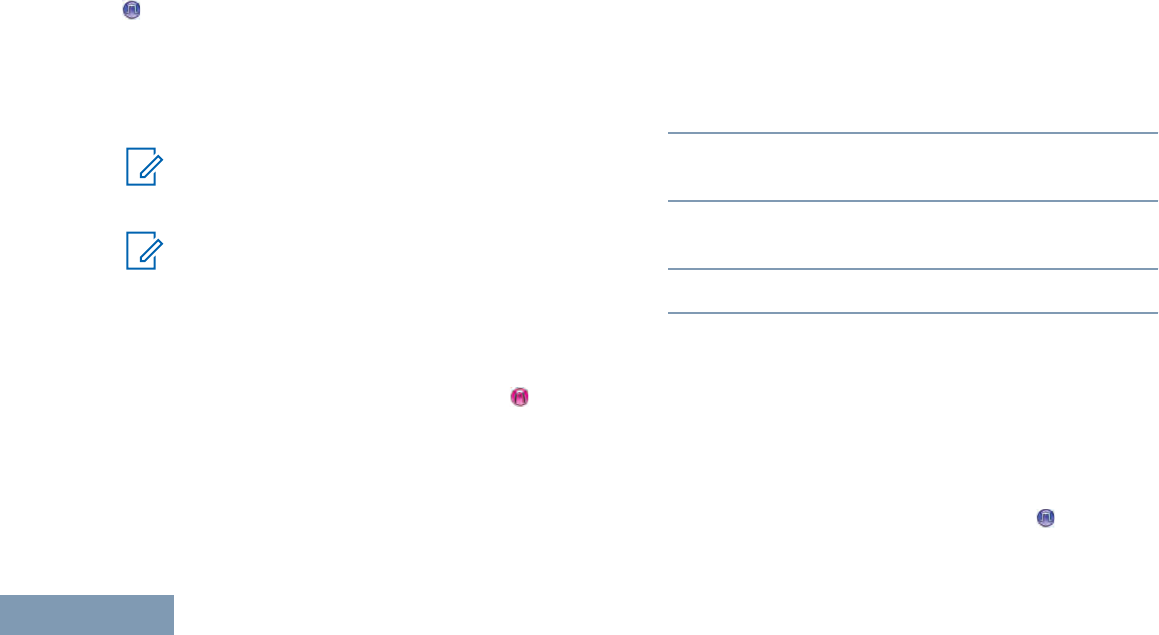
Once the All Call ends, the radio returns to the
previous screen before receiving the call. An All Call
does not wait for a predetermined time before ending.
If the Channel Free Indication feature is enabled,
you hear a short alert tone the moment the
transmitting radio releases the PTT button, indicating
the channel is now available for use.
You cannot respond to an All Call.
Note:
See Making an All Call on page 59 for
details on making an All Call.
Note:
The radio stops receiving the All Call if you
switch to a different channel while receiving
the call. During an All Call, you will not be able
to use any programmed button functions until
the call ends.
Receiving and Responding to a Selective Call
A Selective Call is a call from an individual radio to
another individual radio. It is a Private Call on an
analog system.
When you receive a Selective Call, the LED blinks
green. The Private Call icon appears in the top right
corner. The first text line shows the caller alias or
Selective Call or Alert with Call. The first text
line shows the Private Call icon. The radio displays
Selective Call or Alert with Call. Your radio
unmutes and the incoming call sounds through the
radio's speaker.
1Hold the radio vertically 1 to 2 inches (2.5 to 5.0
cm) from your mouth.
2Press the PTT button to respond to the call.
The LED lights up solid green.
3Wait for the Talk Permit Tone to finish (if enabled),
and speak clearly into the microphone.
4Release the PTT button to listen.
If there is no voice activity for a predetermined period
of time, the call ends.
You hear a short tone. The display shows Call
Ended.
See Making a Private Call on page 58 for details on
making a Private Call.
Receiving and Responding to a Phone Call
Making and Receiving Calls in Non-Connect Plus Mode
54
English

Phone Call as Private Call
When you receive a Phone Call as a Private Call, the
Phone Call icon appears in the top right corner; the
display shows the caller alias or Phone Call.
If Phone Call capability is not enabled on your radio,
the first line of the display shows Unavailable and
your radio mutes the call. Your radio returns to the
previous screen when the call ends.
1Press the PTT button to talk and release it to
listen.
2
Press to end the call.
The display shows Ending Phone Call.
If successful, a tone sounds and the display shows
Call Ended.
If successful, a tone sounds and the display shows
Call Ended.
If unsuccessful, your radio returns to the Phone
Call screen. Repeat this step or wait for the
telephone user to end the call.
Phone Call as Group Call
When you receive a Phone Call as a Group Call, the
Phone Group Call icon appears in the top right
corner; the display shows the group alias and Phone
Call.
If Phone Call capability is not enabled on your radio,
the display shows Unavailable and your radio
mutes the call.
1Press the PTT button to talk and release it to
listen.
2
Press to end the call.
The display shows Ending Phone Call.
If successful, a tone sounds and the display shows
Call Ended.
If unsuccessful, your radio returns to the Phone
Call screen. Repeat this step or wait for the
telephone user to end the call.
Making and Receiving Calls in Non-Connect Plus Mode
55
English

Phone Call as All Call
When you receive a Phone Call as an All Call, the
Phone Call icon appears in the top right corner; the
display shows All Call and Phone Call.
If Phone Call capability is not enabled on your radio,
the first line of the display shows Unavailable and
your radio mutes the call. Your radio returns to the
previous screen when the call ends.
Note:
When you receive a Phone Call as an All Call,
you can respond to the call or end the call,
only if an All Call type is assigned to the
channel.
1Press the PTT button to talk and release it to
listen.
2
Press to end the call.
The display shows Ending Phone Call.
If successful, a tone sounds and the display shows
All Call and Call Ended.
If unsuccessful, your radio returns to the Phone
Call screen. Repeat this step to end the call.
Making a Radio Call
After selecting your channel, you can select a
subscriber alias or ID, or group alias or ID by using:
• The Channel Selector Knob.
• A programmed One Touch Access button – The
One Touch Access feature allows you to make a
Group or Private Call to a predefined ID easily.
This feature can be assigned to a short or long
programmable button press. You can ONLY have
one ID assigned to a One Touch Access button.
Your radio can have multiple One Touch Access
buttons programmed.
• The programmed number keys – This method is
for Group, Private and All Calls only and is used
with the keypad (see Making a Group, Private or
All Call with the Programmable Number Key on
page 63).
• A programmable button – This method is for
Phone Calls only (see Making a Phone Call with
the Programmable Phone Button on page 64).
• The Contacts list (see Contact Settings on page
82).
• Manual Dial – This method is for Private and
Phone Calls only and is dialed using the keypad
Making and Receiving Calls in Non-Connect Plus Mode
56
English

(see Making a Phone Call from Contacts on page
85, Making a Private Call from Contacts on page
84, and Making a Call with the Programmable
Manual Dial Button on page 66).
Note:
Your radio must have the Privacy feature
enabled on the channel to send a privacy-
enabled transmission. Only target radios with
the same Privacy Key OR the same Key Value
and Key ID as your radio will be able to
unscramble the transmission.
Note:
See Privacy on page 129 for more
information.
Making a Group Call
To make a call to a group of users, your radio must
be configured as part of that group.
1Do one of the following.
• Select the channel with the active group alias
or ID. See Selecting a Channel on page 51.
•Press the programmed One Touch Access
button.
2Hold the radio vertically 1 to 2 inches (2.5 to 5.0
cm) from your mouth.
3Press the PTT button to make the call.
The LED lights up solid green. The Group Call
icon appears in the top right corner. The first text
line shows the group call alias.
4Release the PTT button to listen.
When the target radio responds, the LED blinks
green. You see the Group Call icon, the group
alias or ID, and transmitting radio alias or ID on
your display.
5 If the Channel Free Indication feature is
enabled, you hear a short alert tone the moment
the transmitting radio releases the PTT button,
indicating the channel is free for you to respond.
Press the PTT button to respond.
If there is no voice activity for a predetermined
period of time, the call ends. Radio returns to the
screen you were on prior to initiating the call.
Making and Receiving Calls in Non-Connect Plus Mode
57
English

Note:
You can also make a Group Call via Contacts
(see Making a Group Call from Contacts on
page 83).
Making a Private Call
While you can receive and/or respond to a Private
Call initiated by an authorized individual radio, your
radio must be programmed for you to initiate a Private
Call.
There are two types of Private Calls. The first type,
where a radio presence check is performed prior to
setting up the call, while the other sets up the call
immediately.
Only one of these call types can be programmed to
your radio by your dealer.
You will hear a negative indicator tone, when you
make a Private Call via the One Touch Access
button, the programmed number keys, or the Channel
Selector Knob, if this feature is not enabled.
Use the Text Message or Call Alert features to
contact an individual radio. See Text Message
Features on page 111 or Call Alert Operation on
page 101 for more information.
1Do one of the following.
• Select the channel with the active subscriber
alias or ID. See Selecting a Channel on page
51.
• Press the programmed One Touch Access
button.
2Hold the radio vertically 1 to 2 inches (2.5 to 5.0
cm) from your mouth.
3Press the PTT button to make the call.
The LED lights up solid green. The Private Call
icon appears on the top right corner. The first text
line shows the subscriber alias. The second text
line displays the call status.
4Wait for the Talk Permit Tone to finish (if enabled),
and speak clearly into the microphone.
5Release the PTT button to listen.
When the target radio responds, the LED blinks
green.
6 If the Channel Free Indication feature is
enabled, you hear a short alert tone the moment
the transmitting radio releases the PTT button,
Making and Receiving Calls in Non-Connect Plus Mode
58
English

indicating the channel is free for you to respond.
Press the PTT button to respond.
If there is no voice activity for a predetermined
period of time, the call ends. You hear a short
tone. The display shows Call Ended.
Your radio may be programmed to perform a radio
presence check prior to setting up the Private Call. If
the target radio is not available, you hear a short tone
and see negative mini notice on the display. You can
also make a Private Call via Contacts (see Making a
Private Call from Contacts on page 84) or perform a
quick alphanumeric search for the required alias via a
keypad entry (see Making a Group, Private, Phone or
All Call by Alias Search on page 89).
Making an All Call
This feature allows you to transmit to all users on the
channel. Your radio must be programmed to allow
you to use this feature.
Users on the channel cannot respond to an All Call.
1Select the channel with the active All Call group
alias or ID. See Selecting a Channel on page 51.
2Hold the radio vertically 1 to 2 inches (2.5 to 5.0
cm) from your mouth.
3Press the PTT button to make the call.
The LED lights up solid green.The Group Call icon
appears in the top right corner. The first text line
shows All Call.
4Wait for one of the following tones to finish (if
enabled), and speak clearly into the microphone.
• The Talk Permit Tone
•The PTT Sidetone
Making a Selective Call
Just like a Private Call, while you can receive and/or
respond to a Selective Call initiated by an authorized
individual radio, your radio must be programmed for
you to initiate a Selective Call.
1Select the channel with the active subscriber alias
or ID. See Selecting a Channel on page 51.
2Hold the radio vertically 1 to 2 inches (2.5 to 5.0
cm) from your mouth.
3Press the PTT button to make the call.
Making and Receiving Calls in Non-Connect Plus Mode
59
English

The LED lights up solid green. The Private Call
icon appears in the top right corner. The first text
line shows the subscriber alias. The second text
line displays the call status.
4Wait for one of the following tones to finish (if
enabled), and speak clearly into the microphone.
• The Talk Permit Tone
•The PTT Sidetone
5Release the PTT button to listen.
When the target radio responds, the LED blinks
green.
If the Channel Free Indication feature is
enabled, you hear a short alert tone the moment
the transmitting radio releases the PTT button,
indicating the channel is free for you to respond.
Press the PTT button to respond.
If there is no voice activity for a predetermined
period of time, the call ends.
The display shows Call Ended.
Making a Phone Call with the One Touch Access
Button
1Press the programmed One Touch Access
button to make a Phone Call to the predefined
alias or ID.
If the entry for the One Touch Access button is
empty, a negative indicator tone sounds. If the
access code was not preconfigured in the
Contacts list, the display shows Access Code:.
Enter the access code and press to proceed.
The LED lights up solid green. The Phone Call
icon appears in the top right corner. The first text
line shows the subscriber alias. The second text
line displays the call status.
If the call-setup is successful, the DTMF tone
sounds. You hear the dialing tone of the telephone
user. The first text line shows the subscriber alias.
The Phone Call icon remains in the top right
corner.
If the call-setup is unsuccessful, a tone sounds
and the display shows Phone Call Failed. Your
radio returns to the Access Code input screen. If
the access code was preconfigured in the
Making and Receiving Calls in Non-Connect Plus Mode
60
English
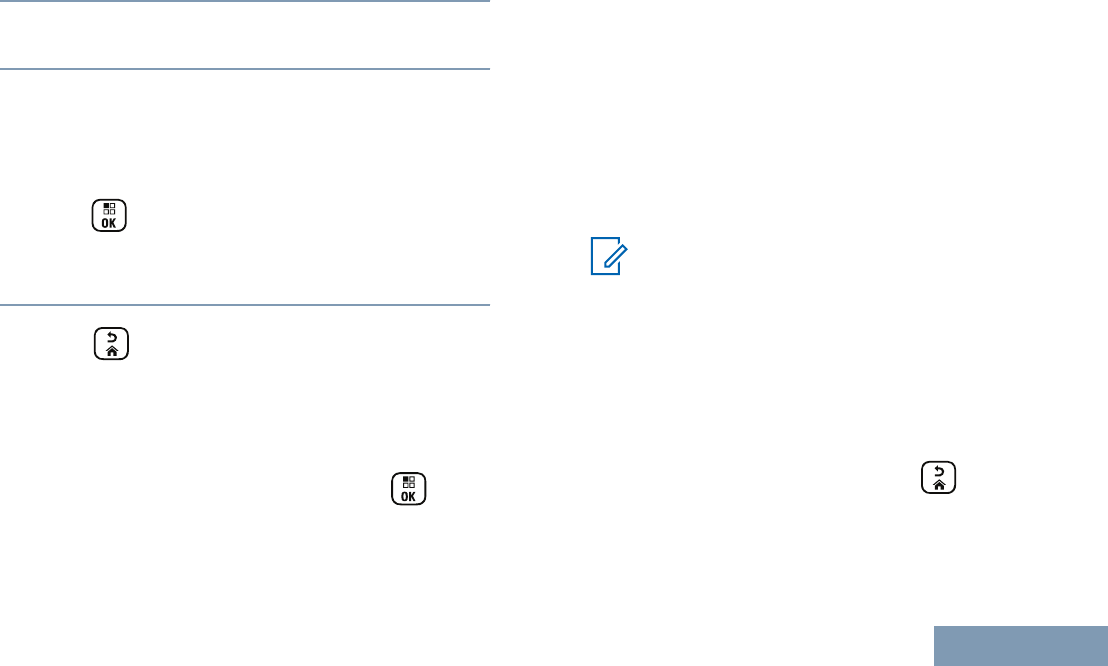
Contacts list, the radio returns to the screen you
were on prior to initiating the call.
2Hold the radio vertically 1 to 2 inches (2.5 to 5.0
cm) from your mouth.
3Press the PTT button to talk and release it to
listen.
To enter extra digits, if requested by the Phone
Call, enter the extra digits using the keypad and
press to proceed.
The DTMF tone sounds with each keypad press,
and the radio returns to the previous screen.
4
Press to end the call.
If de-access code was not preconfigured in the
Contacts list, the display shows De-Access
Code:. Do one of the following.
•
Enter the de-access code and press to
proceed. The radio returns to the previous
screen.
• Press the One Touch Access button. If the
entry for the One Touch Access button is
empty, a negative indicator tone sounds.
The DTMF tone sounds with each keypad press,
and the display shows Ending Phone Call.
If the end-call-setup is successful, a tone sounds
and the display shows Call Ended.
If the end-call-setup is unsuccessful, your radio
returns to the Phone Call screen. Repeat Step 4 or
wait for the telephone user to end the call.
Note:
When the telephone user ends the call, a
tone sounds and the display shows Call
Ended.
If the call ends while you are entering the
extra digits requested by the Phone Call,
your radio returns to the screen you were
on prior to initiating the call.
During channel access, press to
dismiss the call attempt. A tone sounds to
indicate success.
Making and Receiving Calls in Non-Connect Plus Mode
61
English

During the call, if you press the One Touch
Access button with the deaccess code
preconfigured or enter the deaccess code
as the input for extra digits, your radio
attempts to end the call.
The access or deaccess code cannot be
more than 10 characters.
Making a Private Call with a One Touch Call Button
Note:
Programmable buttons press must be initiated
from the Home screen.
The One Touch Call feature allows you to easily
make a Private Call to a pre-defined Private Call alias
or ID. This feature can be assigned to a short or long
programmable button press.
You can ONLY have one alias or ID assigned to a
One Touch Call button. Your radio can have multiple
One Touch Call buttons programmed.
1Press the programmed One Touch Call button to
make a Private Call to the pre-defined Private Call
alias or ID.
2Hold the radio vertically 1 to 2 inches (2.5 to 5.0
cm) from your mouth.
3Press the PTT button to make the call.
The LED lights up solid green.
The display shows the Private Call alias or ID.
4Wait for the Talk Permit Tone to finish (if enabled)
and speak clearly into the microphone.
5Release the PTT button to listen.
When the target radio responds, the LED blinks
green.
6If the Channel Free Indication feature is enabled,
you will hear a short alert tone the moment the
target radio releases the PTT button, indicating the
channel is free for you to respond. Press the PTT
button to respond.
If there is no voice activity for a predetermined
period of time, the call ends.
Making and Receiving Calls in Non-Connect Plus Mode
62
English

Making a Group, Private or All Call with the
Programmable Number Key
The Programmable Number Key feature allows you to
make a Group, Private or All Call to a predefined alias
or ID easily. This feature can be assigned to all the
available number keys on a keypad.
You can ONLY have one alias or ID assigned to a
number key, but you can have more than one number
key associated to an alias or ID.
1Long press the programmed number key, when
you are on the Home screen, to make a Group,
Private or All Call to the predefined alias or ID.
If the number key is not associated to an entry, a
negative indicator tone sounds.
2Hold the radio vertically 1 to 2 inches (2.5 to 5.0
cm) from your mouth.
3Press the PTT button to make the call.
The LED lights up solid green. The Group/Private
Call icon appears in the top right corner. The first
text line shows the caller alias. The second text
line displays either the call status for a Private Call
or All Call for All Call.
4Wait for one of the following tones to finish (if
enabled), and speak clearly into the microphone.
• The Talk Permit Tone
• the PTT Sidetone (Group Call only)
5Release the PTT button to listen.
When the target radio responds, the LED blinks
green.
6 If the Channel Free Indication feature is
enabled, you hear a short alert tone the moment
the transmitting radio releases the PTT button,
indicating the channel is free for you to respond.
Press the PTT button to respond.
If there is no voice activity for a predetermined
period of time, the call ends. Radio returns to the
screen you were on prior to initiating the call.
For a Private Call, you hear a short tone when the
call ends.
See Assigning an Entry to a Programmable
Number Key on page 90 for details on assigning
an entry to a number key on the keypad.
Making and Receiving Calls in Non-Connect Plus Mode
63
English
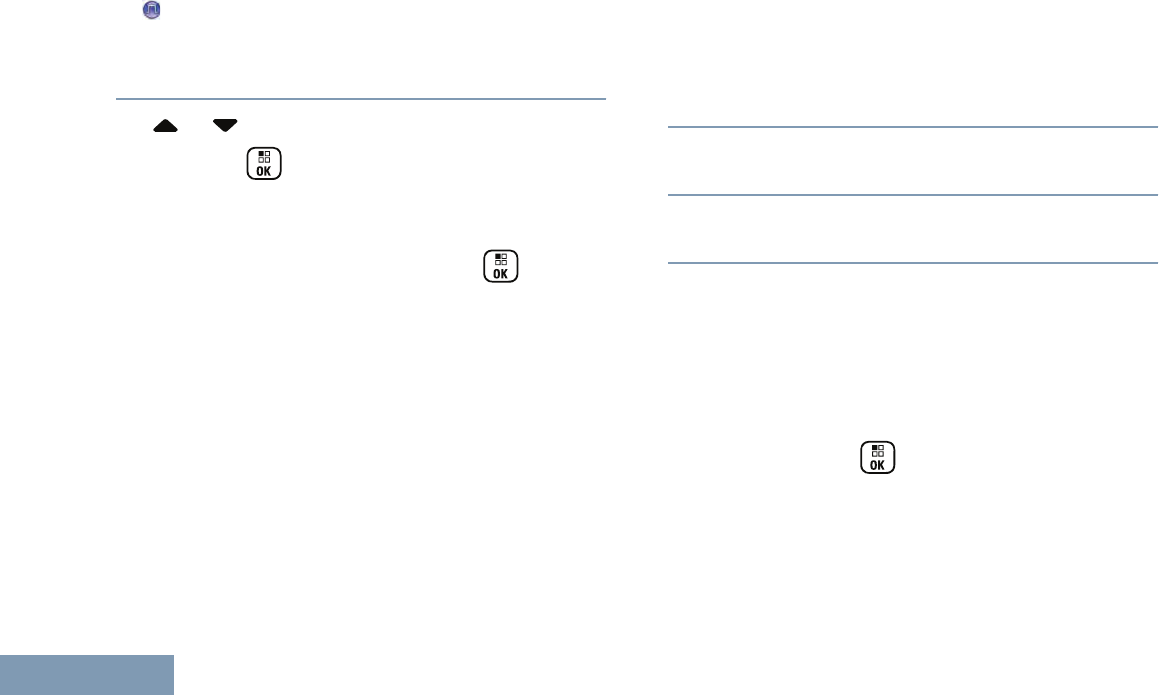
Making a Phone Call with the Programmable Phone
Button
1Press the programmed Phone button to enter into
the Phone Entry list.
2 or to the required subscriber alias or ID,
and press to select.
If the access code was not preconfigured in the
Contacts list, the display shows Access Code:.
Enter the access code and press the button
to proceed.
The LED lights up solid green. The Phone Call
icon appears in the top right corner. The first text
line shows the subscriber alias. The second text
line displays the call status.
If the call-setup is successful, the DTMF tone
sounds. You hear the dialing tone of the telephone
user. The first text line shows the subscriber alias.
The Phone Call icon remains in the top right
corner. The second text line displays the call
status.
If call-setup is unsuccessful, a tone sounds and
the display shows Phone Call Failed. Your
radio returns to the Access Code input screen. If
the access code was preconfigured in the
Contacts list, the radio returns to the screen you
were on prior to initiating the call.
3Hold the radio vertically 1 to 2 inches (2.5 to 5.0
cm) from your mouth.
4Press the PTT button to talk and release it to
listen.
5To enter extra digits, if requested by the Phone
Call, do one of the following.
• Press any keypad key to begin the input of the
extra digits. The first line of the display shows
Extra Digits:. The second line of the display
shows a blinking cursor. Enter the extra digits
and press the button to proceed. The
DTMF tone sounds and the radio returns to the
previous screen.
• Press One Touch Access button. The DTMF
tone sounds. If the entry for the One Touch
Making and Receiving Calls in Non-Connect Plus Mode
64
English

Access button is empty, a negative indicator
tone sounds.
6
Press to end the call.
If deaccess code was not preconfigured in the
Contacts list, the first line of the display shows De-
Access Code:. The second line of the display
shows a blinking cursor. Enter the deaccess code
and press the button to proceed. The radio
returns to the previous screen.
The DTMF tone sounds and the display shows
Ending Phone Call.
If the end-call-setup is successful, a tone sounds
and the display shows Call Ended.
If the end-call-setup is unsuccessful, your radio
returns to the Phone Call screen. Repeat Steps 4
and 6 or wait for the telephone user to end the
call.
When you press PTT button while in the Phone
Contacts screen, a tone sounds and the display
shows Press OK to Place Phone Call.
When the telephone user ends the call, a tone
sounds and the display shows Phone Call
Ended.
If the call ends while you are entering the extra
digits requested by the Phone Call, your radio
returns to the screen you were on prior to initiating
the call.
Note:
During channel access, press to
dismiss the call attempt and a tone sounds.
During the call, when you press One
Touch Access button with the deaccess
code preconfigured or enter the deaccess
code as the input for extra digits, your radio
attempts to end the call.
Note:
The access or deaccess code cannot be
more than 10 characters.
Making and Receiving Calls in Non-Connect Plus Mode
65
English
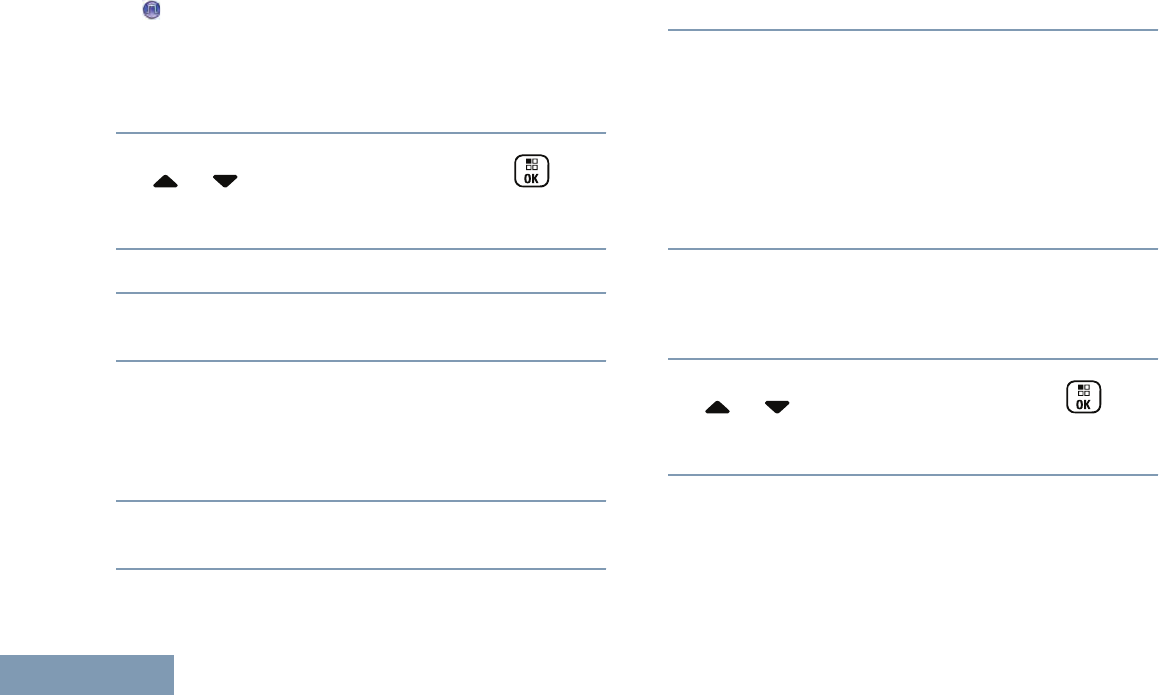
Making a Call with the Programmable Manual Dial
Button
Making a Private Call
1Press the programmed Manual Dial button to
enter into the Manual Dial screen.
2
or to Radio Contact and press to
select.
The display shows Number:.
3Use the keypad to enter a subscriber alias.
4Hold the radio vertically 1 to 2 inches (2.5 to 5.0
cm) from your mouth.
5Press the PTT button to make the call.
The LED lights up solid green. The Private Call
icon appears in the top right corner. The first text
line shows the subscriber alias. The second text
line displays the call status.
6Wait for the Talk Permit Tone to finish (if enabled)
and speak clearly into the microphone.
7Release the PTT button to listen.
When the target radio responds, the LED blinks
green.
8If the Channel Free Indication feature is enabled,
you will hear a short alert tone the moment the
target radio releases the PTT button, indicating the
channel is free for you to respond. Press the PTT
button to respond.
If there is no voice activity for a predetermined
period of time, the call ends. You hear a short
tone. The display shows Call Ended.
Making a Phone Call
1Press the programmed Manual Dial button to
enter into the Manual Dial screen.
2
or to Phone Contact and press to
select.
The display shows Number:.
3Use the keypad to enter a subscriber alias.
If the access code was not preconfigured in the
Contacts list, the display shows Access Code:.
Making and Receiving Calls in Non-Connect Plus Mode
66
English
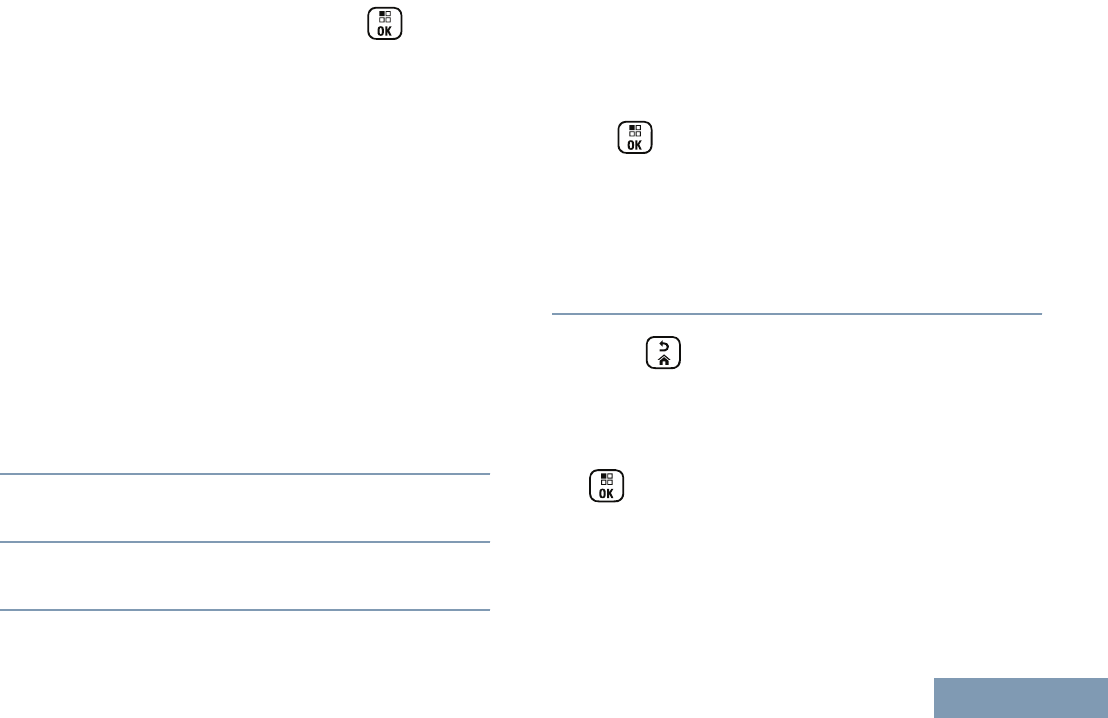
Enter the access code and press the button
to proceed.
The LED lights up solid green. The Phone Call
icon appears in the top right corner. The first text
line shows the subscriber alias. The second text
line displays the call status.
If the call-setup is successful, the DTMF tone
sounds. You hear the dialing tone of the telephone
user. The first text line shows the subscriber alias.
The Phone Call icon remains in the top right
corner.
If the call-setup is unsuccessful, a tone sounds
and the display shows Phone Call Failed. Your
radio returns to the Access Code input screen. If
the access code was preconfigured in the
Contacts list, the radio returns to the screen you
were on prior to initiating the call.
4Hold the radio vertically 1 to 2 inches (2.5 to 5.0
cm) from your mouth.
5Press the PTT button to talk and release it to
listen.
6To enter extra digits, if requested by the Phone
Call, do one of the following.
• Press any keypad key to begin the input of the
extra digits. Enter the extra digits and press the
button to proceed. The DTMF tone
sounds and the radio returns to the previous
screen.
• Press One Touch Access button. The DTMF
tone sounds. If the entry for the One Touch
Access button is empty, a negative indicator
tone sounds.
7
Press to end the call.
If deaccess code was not preconfigured in the
Contacts list, the display shows De-Access
Code:. Enter the deaccess code and press the
button to proceed. The radio returns to the
previous screen.
The DTMF tone sounds and the display shows
Ending Phone Call.
Making and Receiving Calls in Non-Connect Plus Mode
67
English
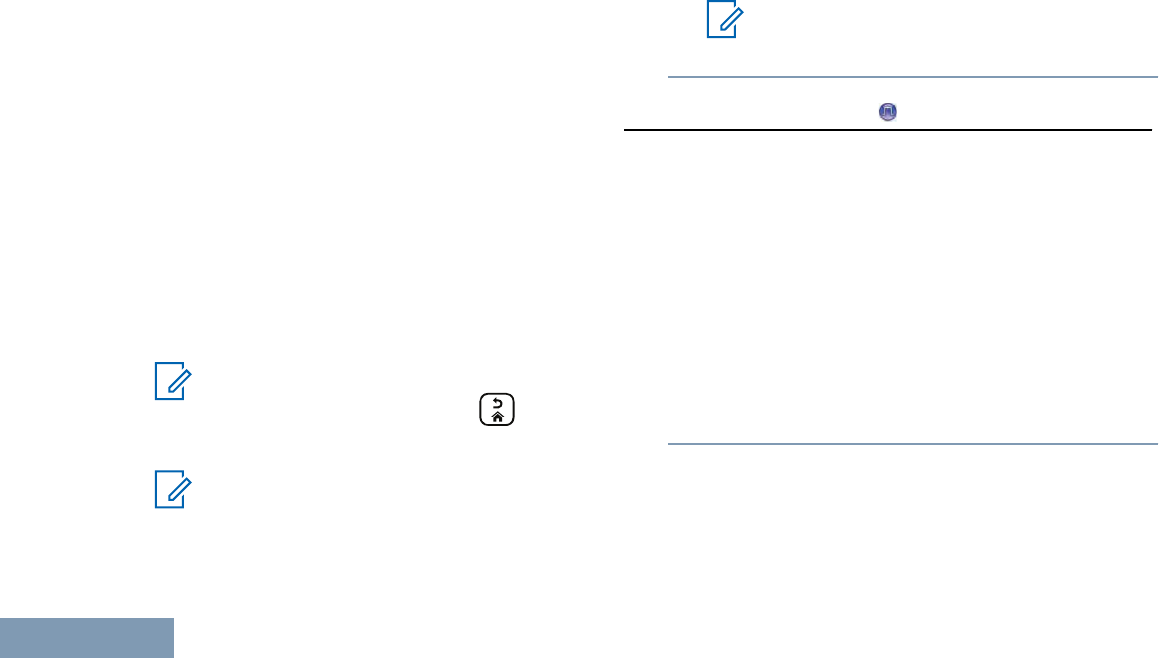
If the end-call-setup is successful, a tone sounds
and the display shows Call Ended.
If the end-call-setup is unsuccessful, your radio
returns to the Phone Call screen. Repeat Step 7 or
wait for the telephone user to end the call.
When you press PTT button while in the Phone
Contacts screen, a tone sounds and the display
shows Press OK to Place Phone Call.
When the telephone user ends the call, a tone
sounds and the display shows Phone Call
Ended.
If the call ends while you are entering the extra
digits requested by the Phone Call, your radio
returns to the screen you were on prior to initiating
the call.
Note:
During channel access, press to
dismiss the call attempt and a tone sounds.
Note:
During the call, when you press One
Touch Access button with the deaccess
code preconfigured or enter the deaccess
code as the input for extra digits, your radio
attempts to end the call.
Note:
The access or deaccess code cannot be
more than 10 characters.
Stopping a Radio Call
This feature allows you to stop an ongoing Group or
Private Call to free the channel for transmission. For
example, when a radio experiences a “stuck
microphone” condition where the PTT button is
inadvertently pressed by the user.
Your radio must be programmed to allow you to use
this feature.
1Press the programmed Transmit Interrupt
Remote Dekey button, while on the relevant
channel.
The display shows Remote Dekey.
2Wait for acknowledgement.
If successful, the radio sounds a positive indicator
tone and the display shows Remote Dekey
Success, indicating that the channel is now free.
Making and Receiving Calls in Non-Connect Plus Mode
68
English
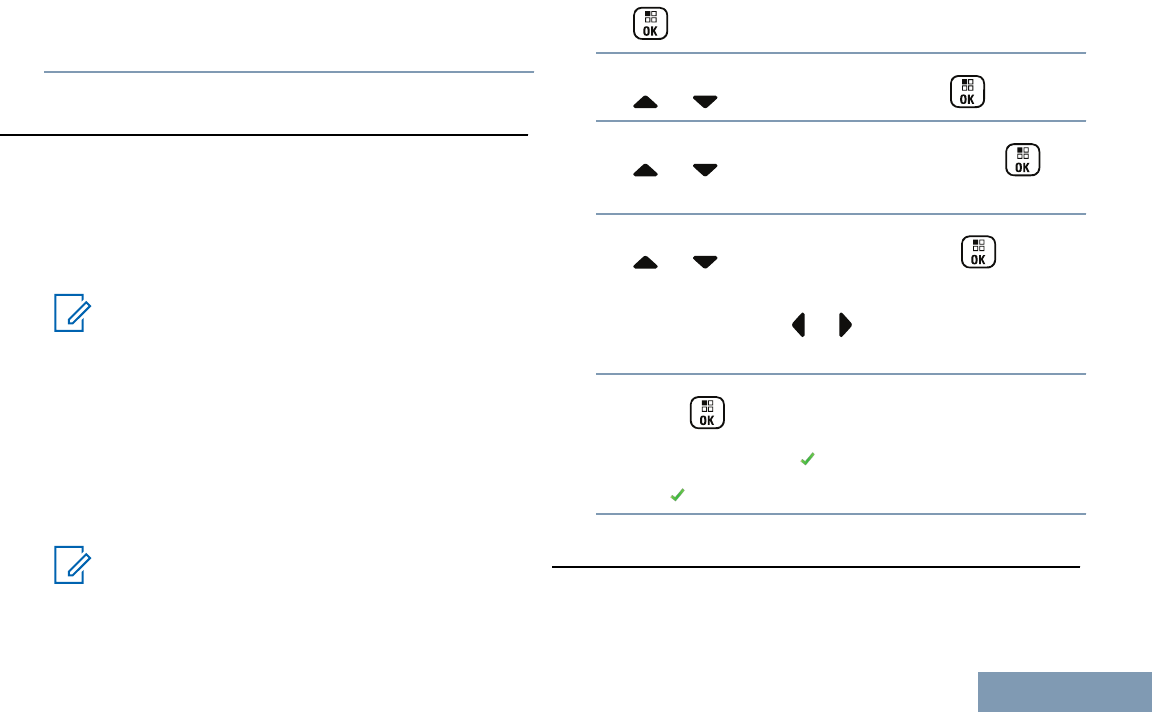
If unsuccessful, the radio sounds a negative
indicator tone and the display shows Remote
Dekey Failed.
Talkaround
You can continue to communicate when your
repeater is not operating, or when your radio is out of
the repeater’s range but within talking range of other
radios.
This is called “talkaround”.
Note:
This feature is not applicable in Capacity Plus
and Linked Capacity Plus.
The Talkaround setting is retained even after
powering down.
You can toggle between talkaround and repeater
modes by pressing the programmed Repeater/
Talkaround button or using the radio menu as
described next.
Note:
This feature is not applicable in Citizens Band
channels that are in the same frequency.
1
to access the menu.
2
or to Utilities and press to select.
3
or to Radio Settings and press to
select.
4
or to Talkaround and press to
select.
You can also use or to change the selected
option.
5
Press to enable/disable the Talkaround.
The display shows beside Enabled.
The disappears from beside Enabled.
Monitoring Features
Making and Receiving Calls in Non-Connect Plus Mode
69
English
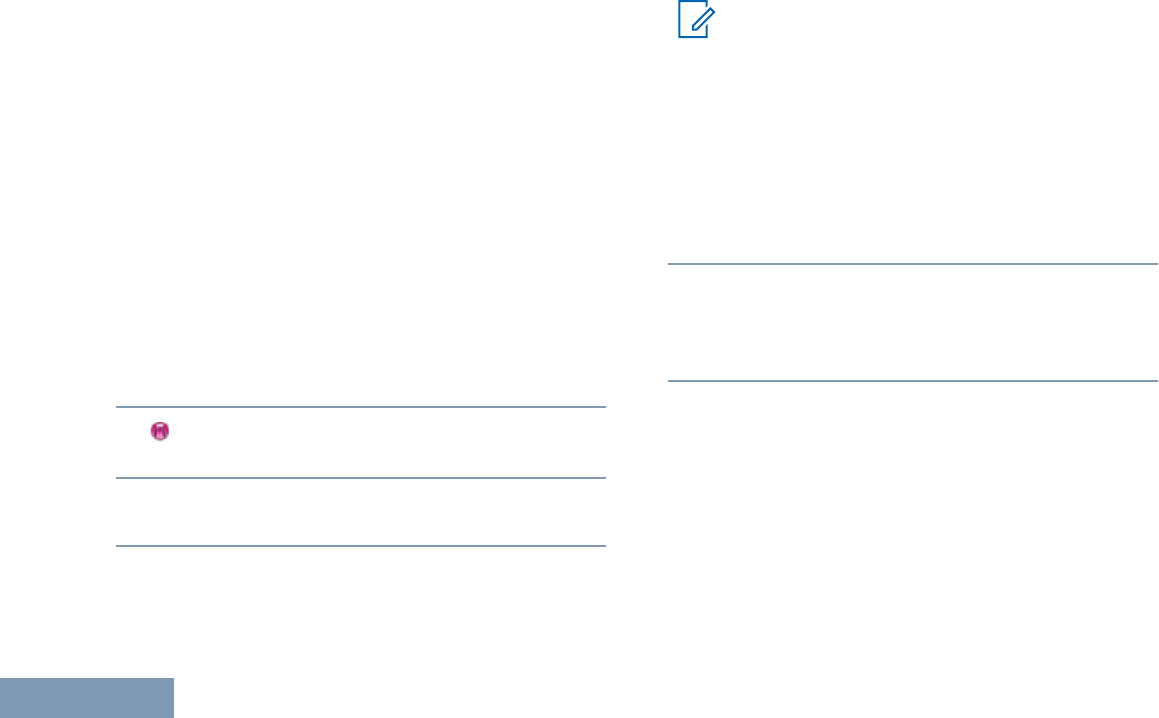
Monitoring a Channel
Use the Monitor feature to make sure a channel is
clear before transmitting.
This feature is not applicable in Capacity Plus and
Linked Capacity Plus.
1Press and hold the programmed Monitor button
and listen for activity.
The Monitor icon appears on the display and the
LED lights up solid yellow. You hear radio activity
or total silence, depending on how your radio is
programmed. This indicates that the channel is in
use.
The LED double blinks yellow when channel is
busy.
2 Wait until you hear “white noise”. This indicates
that the channel is free.
3Press the PTT button to talk and release it to
listen.
Permanent Monitor
Use the Permanent Monitor feature to continuously
monitor a selected channel for activity.
Note:
This feature is not applicable in Capacity Plus
and Linked Capacity Plus.
1Press the programmed Permanent Monitor
button to activate permanent monitoring of the
channel.
Radio sounds an alert tone, the LED lights up solid
yellow, and the display shows Permanent
Monitor On. The Monitor icon appears on the
display.
2Press the programmed Permanent Monitor
button to exit Permanent Monitor mode.
Radio sounds an alert tone, the LED turns off, and
the display shows Permanent Monitor Off.
Making and Receiving Calls in Non-Connect Plus Mode
70
English
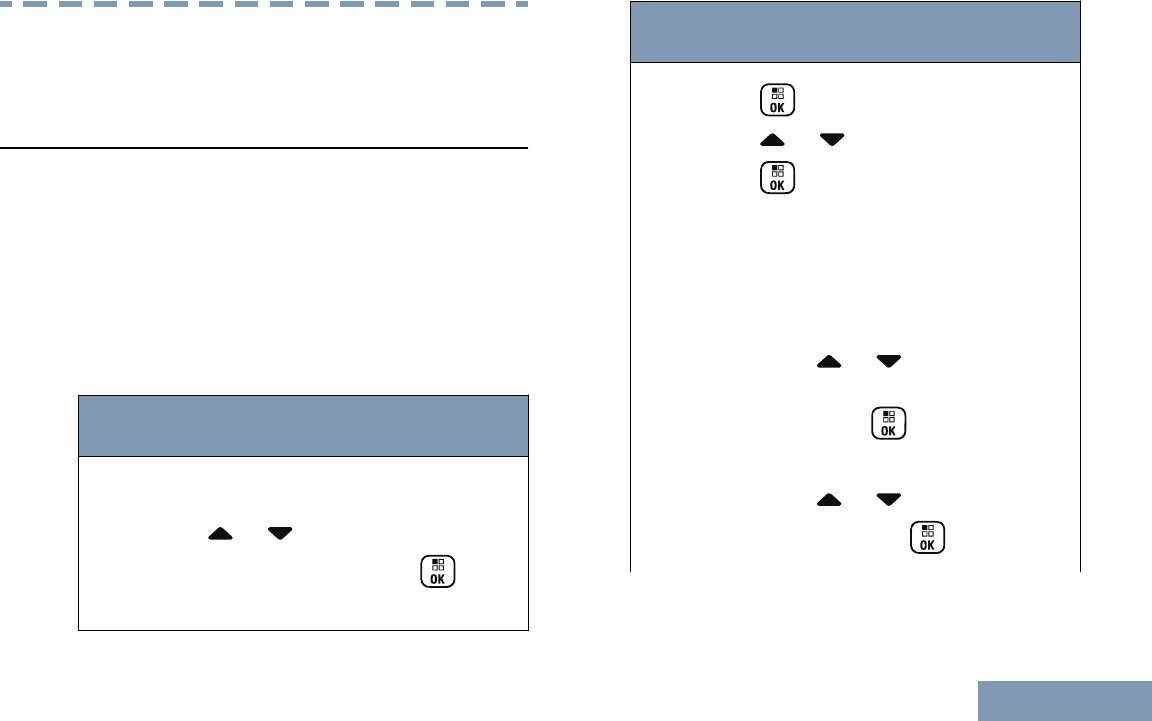
Advanced Features in Non-Connect
Plus Mode
Radio Check
If enabled, this feature allows you to determine if
another radio is active in a system without disturbing
the user of that radio. No audible or visual notification
is shown on the target radio.
This feature is only applicable for subscriber aliases
or IDs.
Sending a Radio Check
1Access the Radio Check feature.
Radio
Control
Steps
Pro-
gram-
med Ra-
dio
Check
button
1Press the programmed Radio
Check button.
2 or to the required subscrib-
er alias or ID and press to se-
lect.
Radio
Control
Steps
Menu 1
to access the menu.
2 or to Contacts and press
to select.
3Use one of the steps described
next to select the required sub-
scriber alias or ID:
• Select the subscriber alias or ID
directly.
• or to the required
subscriber alias or ID and
press to select.
•Use the Manual Dial menu.
• or to Manual Dial
and press to select.
Advanced Features in Non-Connect Plus Mode
71
English
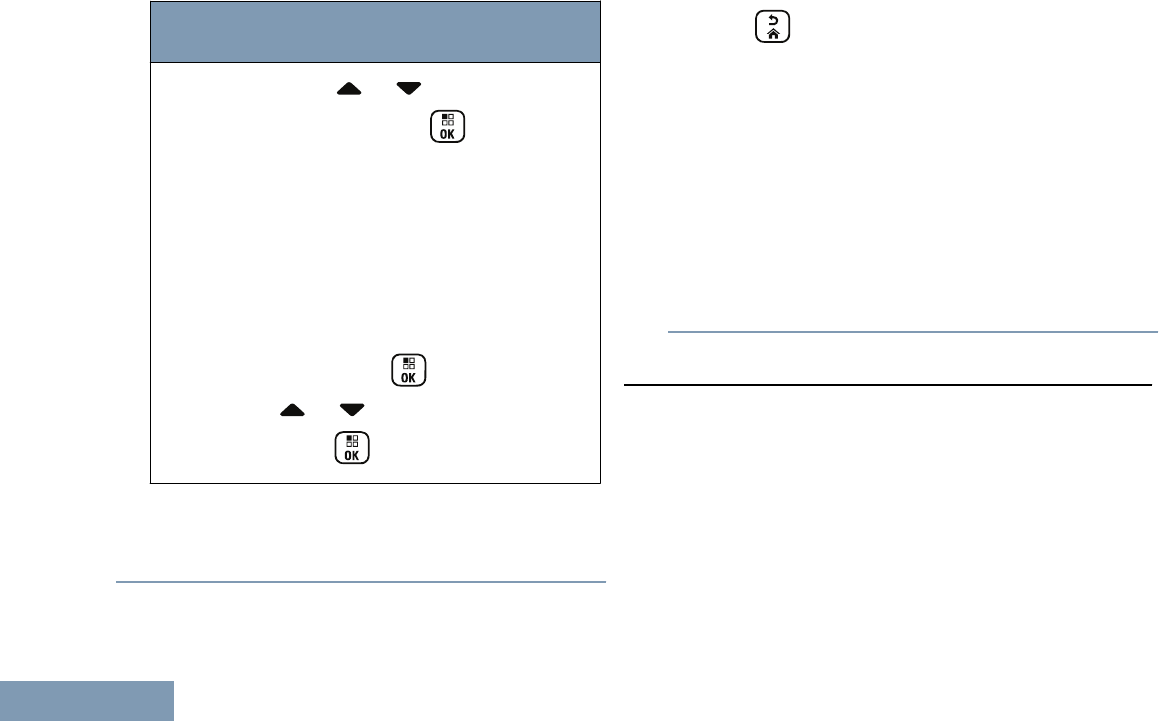
Radio
Control
Steps
• or to Radio Number
and press to select.
• If there was previously dialed
ID, the ID appears along with
a blinking cursor. Else, the
first line of the display shows
Radio Number:; the second
line of the display shows a
blinking cursor. Use the key-
pad to edit/enter the ID, and
press to select.
4 or to Radio Check and
press to select.
The display shows transitional mini notice,
indicating the request is in progress. The LED
lights up solid green.
2Wait for acknowledgement.
If the button is pressed when the radio is
waiting for acknowledgement, a tone sounds, and
the radio terminates all retries and exits Radio
Check mode.
If Radio Check is successful, a positive indicator
tone sounds and the display shows positive mini
notice.
If Radio Check is unsuccessful, a negative
indicator tone sounds and the display shows
negative mini notice.
Radio returns to the subscriber alias or ID screen.
Remote Monitor
Use the Remote Monitor feature to turn on the
microphone of a target radio (subscriber alias or IDs
only). The green LED will blink once on the target
subscriber. You can use this feature to monitor,
remotely, any audible activity surrounding the target
radio.
Your radio must be programmed to allow you to use
this feature.
Advanced Features in Non-Connect Plus Mode
72
English
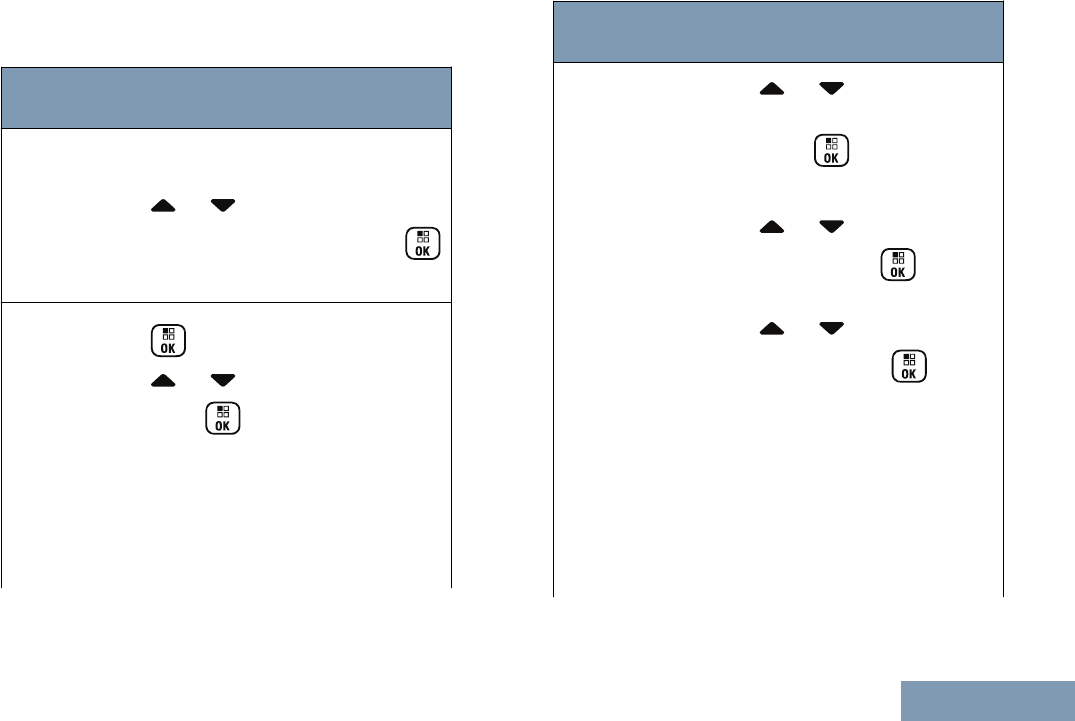
Initiating Remote Monitor
1Access the Remote Monitor feature.
Radio
Control
Steps
Program-
med Re-
mote Mon-
itor Button
1Press the programmed Remote
Monitor button.
2 or to the required sub-
scriber alias or ID and press
to select.
Menu 1
to access the menu
2 or to Contacts and
press to select
3Use one of the steps described
next to select the required sub-
scriber alias or ID
• select the subscriber alias or
ID directly
Radio
Control
Steps
• or to the required
subscriber alias or ID and
press to select.
•use the Manual Dial menu
• or to Manual Di‐
al and press to se-
lect.
• or to Radio Num‐
ber and press to se-
lect.
• If there was previously di-
aled ID, the ID appears
along with a blinking cur-
sor. Else, the first line of
the display shows Radio
Number:; the second line
of the display shows a
Advanced Features in Non-Connect Plus Mode
73
English
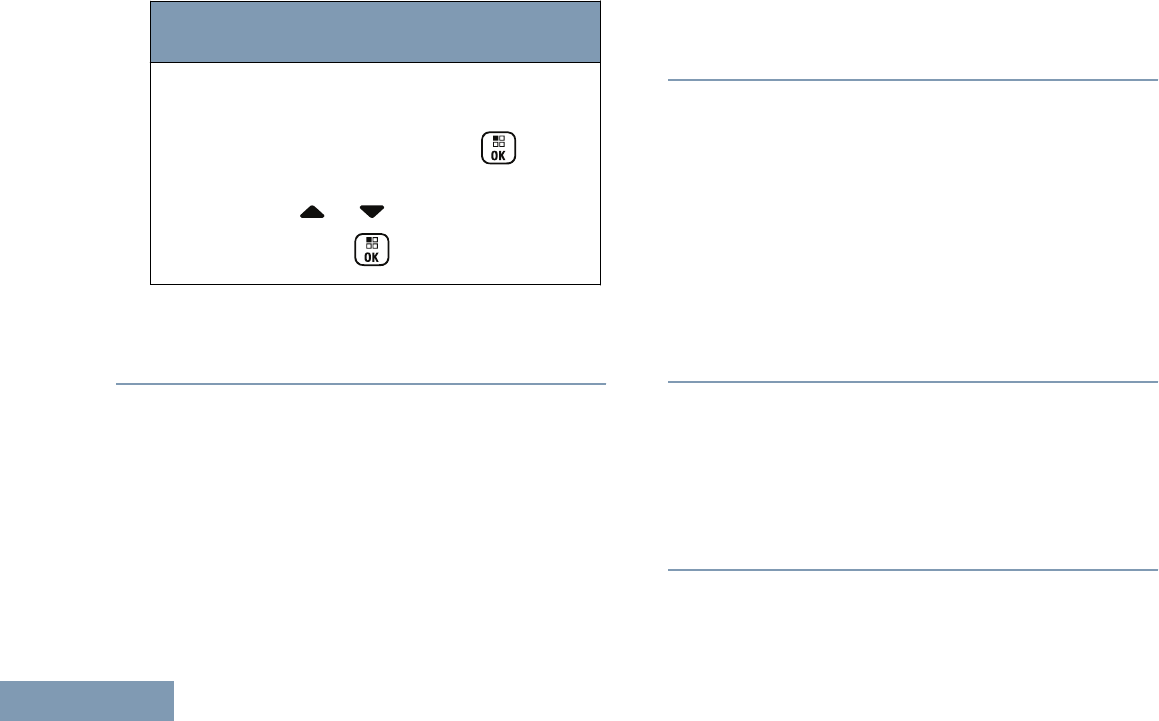
Radio
Control
Steps
blinking cursor. Use the
keypad to edit/enter the
ID, and press to se-
lect.
4 or to Remote Mon. and
press to select.
The display shows transitional mini notice,
indicating the request is in progress. The LED
lights up solid green.
2Wait for acknowledgement.
If successful, a positive indicator tone sounds and
the display shows positive mini notice. Your radio
starts playing audio from the monitored radio for a
programmed duration and display shows Rem.
Monitor. Once the timer expires, the radio sounds
an alert tone and the LED turns off.
If unsuccessful, the radio sounds a negative
indicator tone the display shows negative mini
notice.
Stopping Remote Monitor
Remote Monitor automatically stops after a
programmed duration or when there is any user
operation on the target radio. Follow the steps below
to manually stop Remote Monitor.
1Press the programmed Transmit Interrupt
Remote Dekey button.
The display shows transitional mini notice,
indicating the request is in progress. The LED
lights up solid green.
2Wait for acknowledgement.
If successful, the radio sounds a positive indicator
tone and the display shows positive mini notice.
If unsuccessful, the radio sounds a negative
indicator tone and the display shows negative mini
notice.
Advanced Features in Non-Connect Plus Mode
74
English
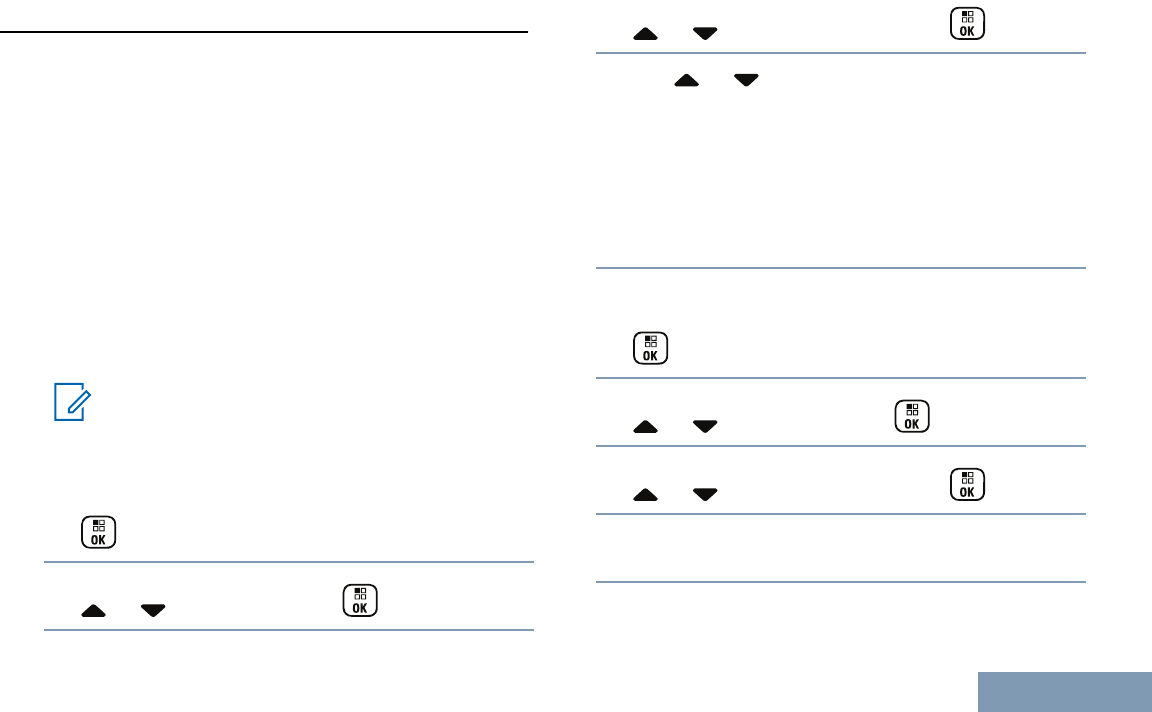
Scan Lists
Scan lists are created and assigned to individual
channels/groups. Your radio scans for voice activity
by cycling through the channel/group sequence
specified in the scan list for the current channel/
group.
Your radio can support up to 250 scan lists, with a
maximum of 16 members in a list. Each scan list
supports a mixture of both analog and digital entries.
You can add, delete, or prioritize channels by editing
a scan list.
You can attach a new scan list to your radio via Front
Panel Programming.
Note:
This feature is not applicable in Capacity Plus
and Linked Capacity Plus.
Viewing an Entry in the Scan List
1
to access the menu.
2
or to Scan and press to select.
3
or to Scan List and press to select.
4Use or to view each member on the list.
The Priority icon appears left of the member’s
alias, if set, to indicate whether the member is on
a Priority 1 or Priority 2 channel list. You cannot
have multiple Priority 1 or Priority 2 channels in a
scan list.
There is no Priority icon if priority is set to None.
Viewing an Entry in the Scan List by Alias Search
1
to access the menu.
2
or to Scan and press to select.
3
or to Scan List and press to select.
4Key in the first character of the required alias.
A blinking cursor appears.
5Use the keypad to type the required alias.
Advanced Features in Non-Connect Plus Mode
75
English
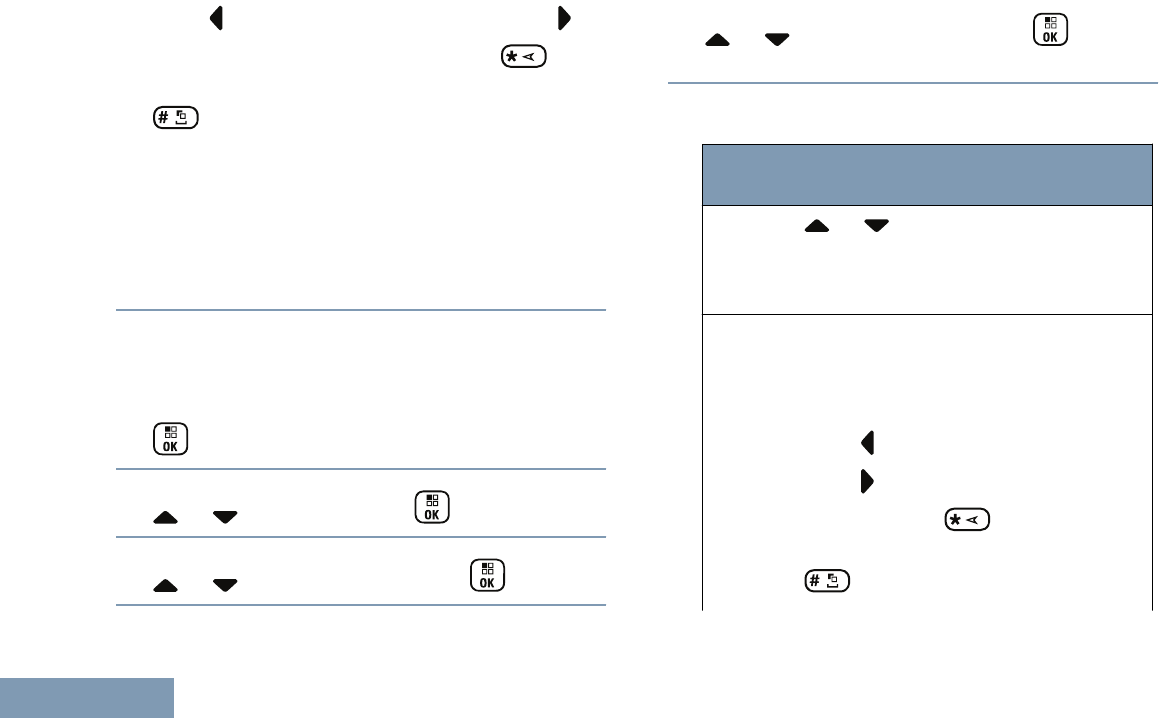
Press to move one space to the left. Press to
move one space to the right. Press the key
to delete any unwanted characters. Long press
to change text entry method.
The first line of the display shows the characters
you keyed in. The next lines of the display show
the shortlisted search results.
The alias search is case-insensitive. If there are
two or more entries with the same name, the radio
displays the entry that is listed first in the scan list.
Editing the Scan List
Adding a New Entry to the Scan List
1
to access the menu.
2
or to Scan and press to select.
3
or to Scan List and press to select.
4
or to Add Member and press to
select.
5Select the required alias or ID by performing one
of the following actions:
Radio
Control
Steps
Radio
Naviga-
tion But-
tons
or to the required alias or ID.
Keypad Key in the first character of the re-
quired alias.
A blinking cursor appears.
Press to move one space to the left.
Press to move one space to the
right. Press the key to delete
any unwanted characters. Long press
to change the text entry method.
Advanced Features in Non-Connect Plus Mode
76
English
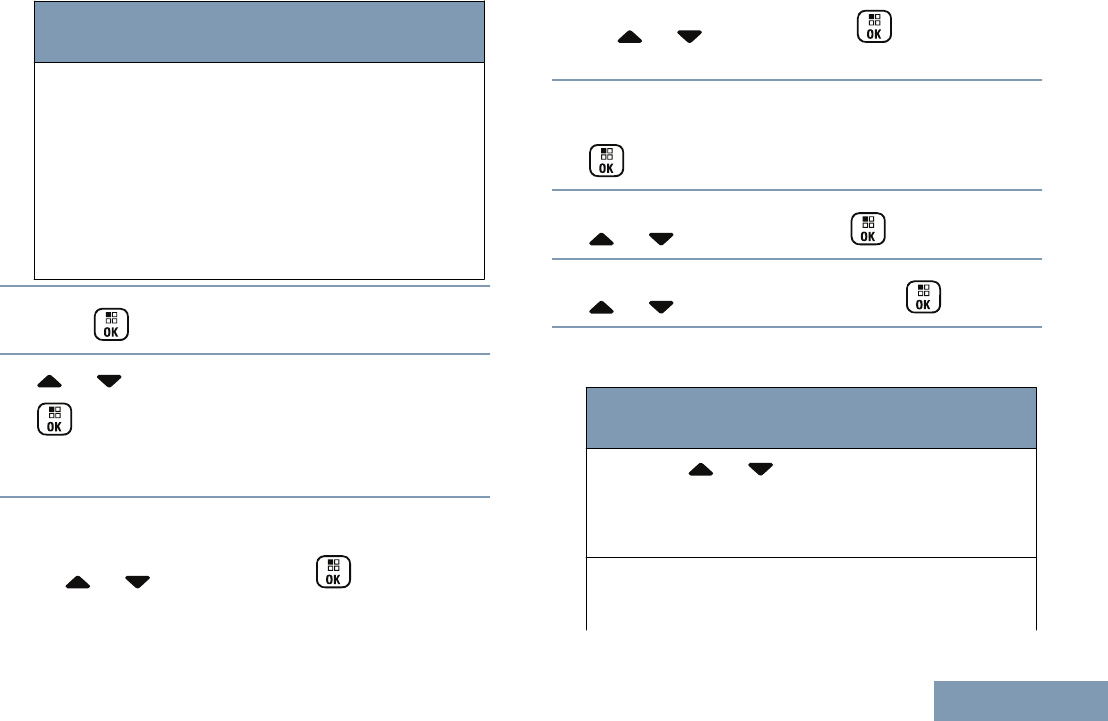
Radio
Control
Steps
The first line of the display shows the
characters you keyed in. The next
lines of the display show the short list-
ed search results. The alias search is
case-insensitive. If there are two or
more aliases with the same name, the
radio displays the alias that is listed
first in the list.
6
Press to select.
7 or to the required priority level and press
to select.
The display shows positive mini notice, followed
immediately by Add Another?.
8Do one of the following:
•
or to Yes and press to select, and
repeat Steps 5 to 7.
•
or to No and press to save the
current list.
Deleting an Entry from the Scan List
1
to access the menu.
2
or to Scan and press to select.
3
or to Scan List and press to select.
4Select the required alias or ID by performing one
of the following actions:
Radio
Control
Steps
Radio
Naviga-
tion But-
tons
or to the required alias or ID.
Keypad Key in the first character of the re-
quired alias.
Advanced Features in Non-Connect Plus Mode
77
English
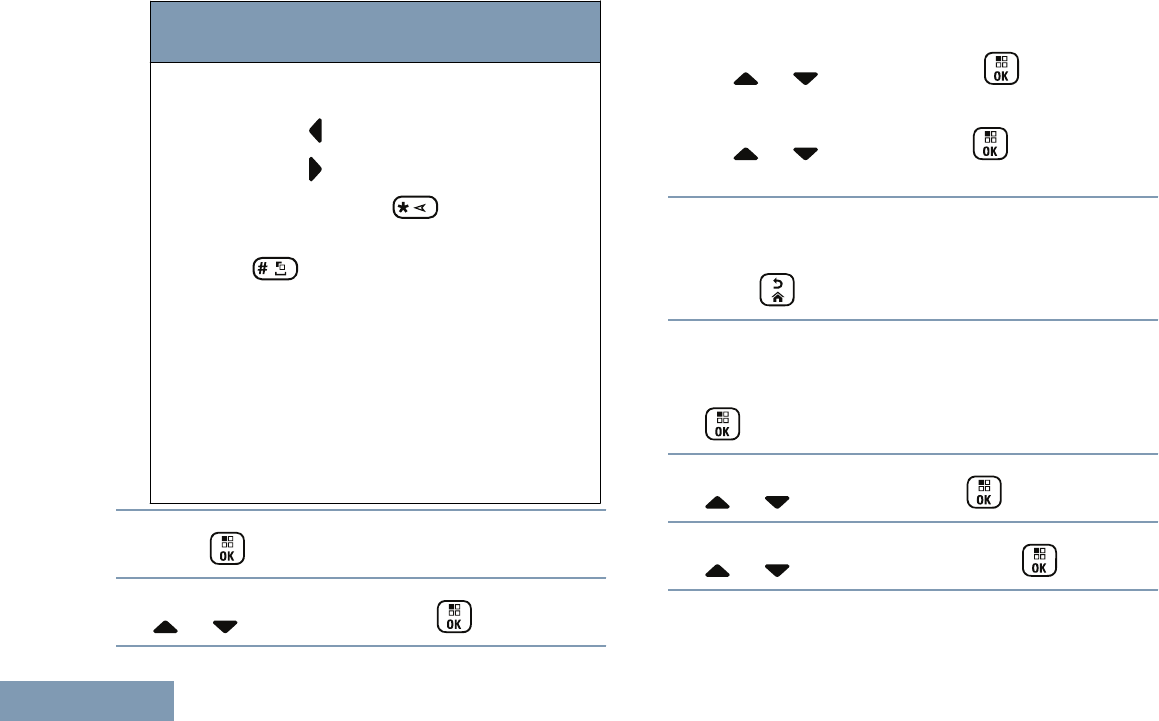
Radio
Control
Steps
A blinking cursor appears.
Press to move one space to the left.
Press to move one space to the
right. Press the key to delete
any unwanted characters. Long press
to change the text entry method.
The first line of the display shows the
characters you keyed in. The next
lines of the display show the short list-
ed search results. The alias search is
case-insensitive. If there are two or
more aliases with the same name, the
radio displays the alias that is listed
first in the list.
5
Press to select.
6
or to Delete and press to select.
7Do one of the following:
•
or to Yes and press to delete
entry. The display shows positive mini notice.
•
or to No and press to return to the
previous screen.
8Repeat Steps 4 to 7 to delete other entries.
After deleting all required aliases or IDs, long
press to return to the Home screen.
Setting and Editing Priority for an Entry in the
Scan List
1
to access the menu.
2
or to Scan and press to select.
3
or to Scan List and press to select.
Advanced Features in Non-Connect Plus Mode
78
English
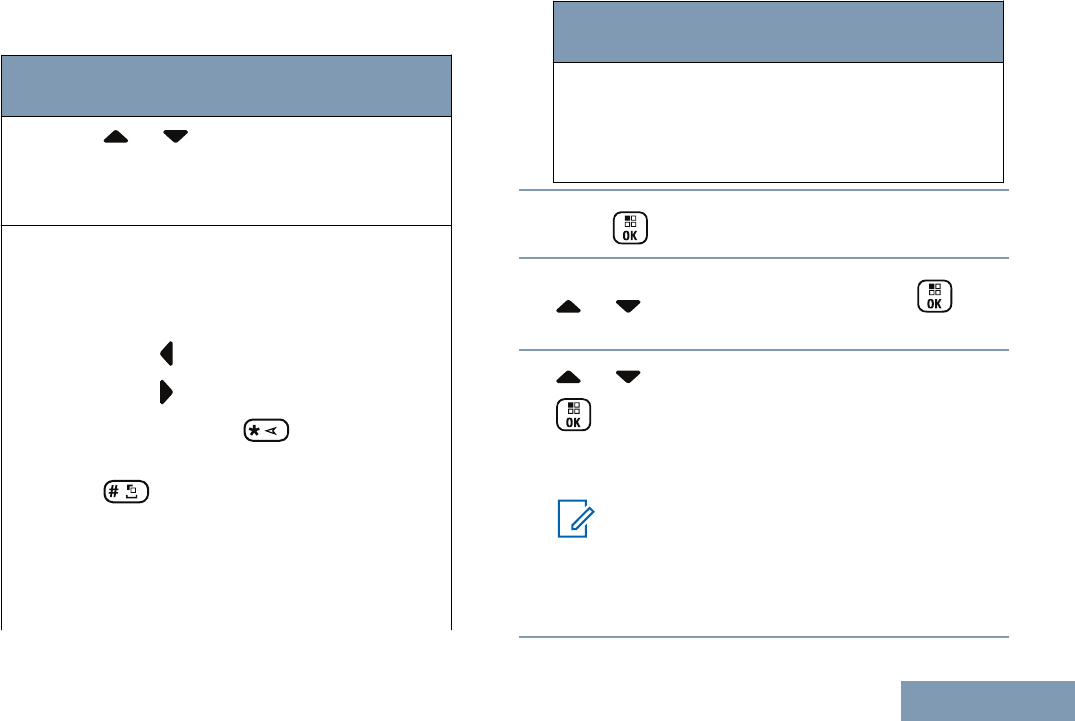
4Select the required alias or ID by performing one
of the following actions:
Radio
Control
Steps
Radio
Naviga-
tion But-
tons
or to the required alias or ID.
Keypad Key in the first character of the re-
quired alias.
A blinking cursor appears.
Press to move one space to the left.
Press to move one space to the
right. Press the key to delete
any unwanted characters. Long press
to change the text entry method.
The first line of the display shows the
characters you keyed in. The next
lines of the display show the short list-
ed search results. The alias search is
Radio
Control
Steps
case-insensitive. If there are two or
more aliases with the same name, the
radio displays the alias that is listed
first in the list.
5
Press to select.
6
or to Edit Priority and press to
select.
7 or to the required priority level and press
to select.
The display shows positive mini notice before
returning to the previous screen.
Note:
The Priority icon appears left of the name
of the member.
There is no Priority icon if priority is set to
None.
Advanced Features in Non-Connect Plus Mode
79
English
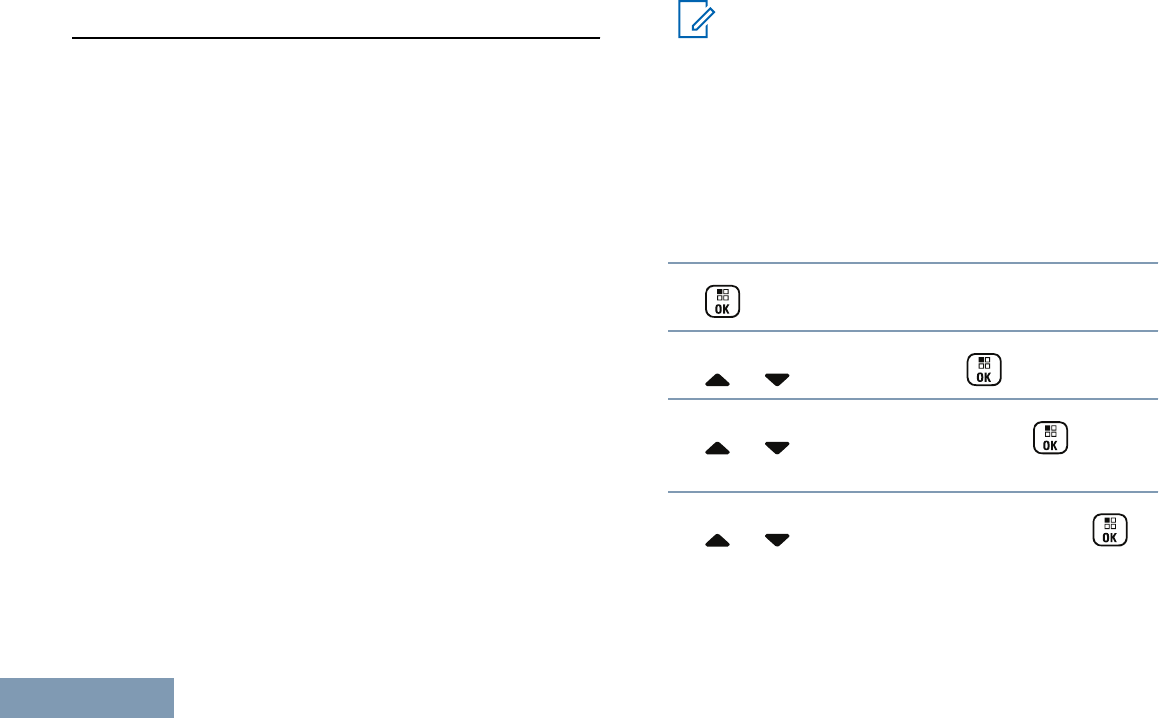
Scan
When you start a scan, your radio cycles through the
programmed scan list for the current channel looking
for voice activity.
The LED blinks yellow and the scan icon appears on
the status bar.
During a dual mode scan, if you are on a digital
channel, and your radio locks onto an analog
channel, it automatically switches from digital mode to
analog mode for the duration of the call. This is also
true for the reverse.
There are two ways of initiating scan:
•Main Channel Scan (Manual): Your radio scans
all the channels/groups in your scan list. On
entering scan, your radio may (depending on the
settings) automatically start on the last scanned
“active” channel/group or on the channel where
scan was initiated.
•Auto Scan (Automatic): Your radio automatically
starts scanning when you select a channel/group
that has Auto Scan enabled.
Note:
This feature is not applicable in Capacity Plus
and Linked Capacity Plus.
Starting and Stopping Scan
While scanning, the radio will only accept data (e.g.
text message, location, or PC data) if received on its
Selected Channel.
1Use the Channel Selector Knob to select a
channel programmed with a scan list.
2
to access the menu.
3
or to Scan and press to select.
4
or to Scan State and press to
select.
5
or to required scan state and press
to select.
Advanced Features in Non-Connect Plus Mode
80
English

•The display shows Scan On when Scan is
enabled. The LED blinks yellow and the scan
icon appears.
•The display shows Scan Off if Scan is
disabled. The LED turns off and the scan icon
disappears.
Responding to a Transmission During a Scan
During scanning, your radio stops on a channel/group
where activity is detected. The radio stays on that
channel for a programmed time period known as
“hang time”.
1Hold the radio vertically 1 to 2 inches (2.5 to 5.0
cm) from your mouth.
If the Channel Free Indication feature is
enabled, you hear a short alert tone the moment
the transmitting radio releases the PTT button,
indicating the channel is free for you to respond.
2Press the PTT button during hang time.
The LED lights up solid green.
3Wait for one of the following tones to finish (if
enabled), and speak clearly into the microphone.
• The Talk Permit Tone
•The PTT Sidetone
4Release the PTT button to listen.
If you do not respond within the hang time, the
radio returns to scanning other channels/groups.
Deleting a Nuisance Channel
If a channel continually generates unwanted calls or
noise (termed a “nuisance” channel), you can
temporarily remove the unwanted channel from the
scan list.
This capability does not apply to the channel
designated as the Selected Channel.
Deleting a “nuisance” channel is only possible
through the programmed Nuisance Channel Delete
button. This feature is not accessible through the
menu.
1When your radio “locks on to” an unwanted or
nuisance channel, press the programmed
Nuisance Channel Delete button until you hear a
tone.
2Release the Nuisance Channel Delete button.
The nuisance channel is deleted.
Advanced Features in Non-Connect Plus Mode
81
English

Restoring a Nuisance Channel
To restore the deleted nuisance channel, do one of
the following:
• Turn the radio off and then power it on again.
• Stop and restart a scan via the programmed Scan
button or menu.
•Change the channel via the Channel Selector
Knob.
Vote Scan
Vote Scan provides you with wide area coverage in
areas where there are multiple base stations
transmitting identical information on different analog
channels.
Your radio scans analog channels of multiple base
stations and performs a voting process to select the
strongest received signal. Once that is established,
your radio unmutes to transmissions from that base
station.
The LED blinks yellow and the vote scan icon
appears on the status bar.
To respond to a transmission during a Vote Scan,
follow the same procedures as Responding to a
Transmission During a Scan on page 81.
Contact Settings
Contacts provides “address-book” capabilities on your
radio. Each entry corresponds to an alias or ID that
you use to initiate a call.
Each entry, depending on context, associates with
one of five types of calls: Group Call, Private Call, All
Call, PC Call or Dispatch Call.
PC Call and Dispatch Call are data-related. They are
only available with the applications. Refer to the data
applications documentation for more information.
Note:
If the Privacy feature is enabled on a channel,
you can make privacy-enabled Group Call,
Private Call, and All Call on that channel. Only
target radios with the same Privacy Key, or the
same Key Value and Key ID as your radio will
be able to unscramble the transmission.
See Privacy on page 129 for more
information.
Advanced Features in Non-Connect Plus Mode
82
English
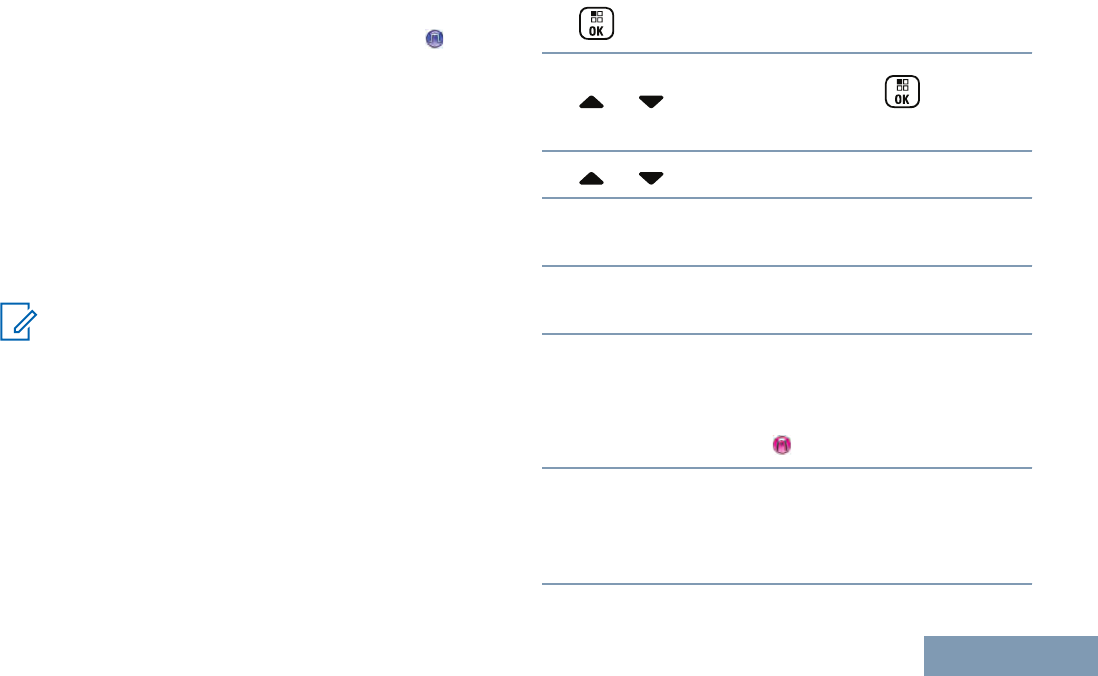
Additionally, Contacts menu allows you to assign
each entry to a programmable number key or more
on a keypad. If an entry is assigned to a number key,
your radio can perform a quick dial on the entry.
Your radio supports two Contacts lists, one for Analog
contacts and one for Digital contacts, with a maximum
of 500 members for each Contacts list.
Each entry within Contacts displays the following
information:
• Call Type
• Call Alias
• Call ID
Note:
You can add or edit subscriber IDs for the
Digital Contacts list. Deleting subscriber IDs
can only be performed by your dealer.
For the Analog Contacts list, you can only
view the subscriber IDs, edit the subscriber
IDs, and initiate a Call Alert. Adding and
deleting capabilities can only be performed by
your dealer.
Making a Group Call from Contacts
1
to access the menu.
2
or to Contacts and press to select.
The entries are alphabetically sorted.
3 or to the required group alias or ID.
4Hold the radio vertically 1 to 2 inches (2.5 to 5.0
cm) from your mouth.
5Press the PTT button to make the call.
The LED lights up solid green.
6Wait for one of the following tones to finish (if
enabled), and speak clearly into the microphone.
• The Talk Permit Tone
•The PTT Sidetone
7Release the PTT button to listen.
When any user in the group responds, the LED
blinks green. You see the Group Call icon, the
group ID, and the user’s ID on your display.
Advanced Features in Non-Connect Plus Mode
83
English
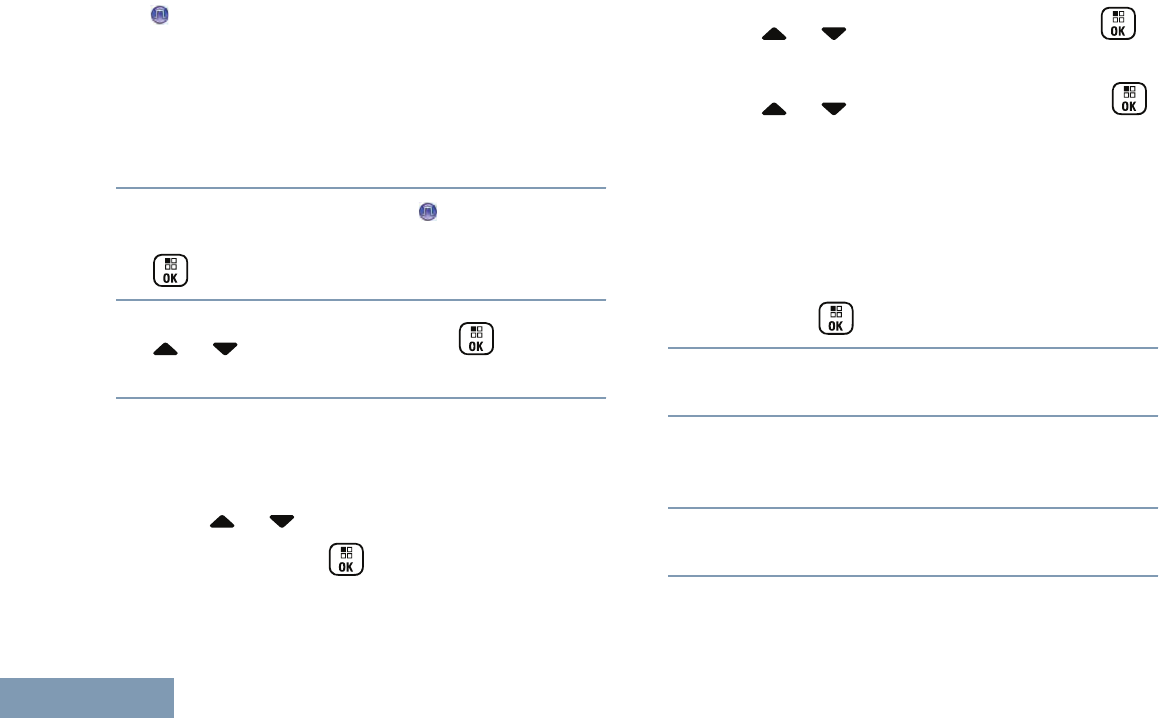
8 If the Channel Free Indication feature is
enabled, you hear a short alert tone the moment
the transmitting radio releases the PTT button,
indicating the channel is free for you to respond.
Press the PTT button to respond.
If there is no voice activity for a predetermined
period of time, the call ends.
Making a Private Call from Contacts
1
to access the menu.
2
or to Contacts and press to select.
The entries are alphabetically sorted.
3Use one of the steps described next to select the
required subscriber alias or ID:
• select the subscriber alias or ID directly
• or to the required subscriber alias or
ID and press to select.
•use the Manual Dial menu
•
or to Manual Dial and press
to select.
•
or to Radio Number and press
to select.
• If there was previously dialed subscriber
alias or ID, the alias or ID appears along
with a blinking cursor. Else, the first line of
the display shows Radio Number:; the
second line of the display shows a blinking
cursor. Use the keypad to edit/enter the ID.
Press to select.
4Hold the radio vertically 1 to 2 inches (2.5 to 5.0
cm) from your mouth.
5Press the PTT button to make the call.
The LED lights up solid green. The display shows
the destination alias.
6Wait for the Talk Permit Tone to finish (if enabled),
and speak clearly into the microphone.
7Release the PTT button to listen.
Advanced Features in Non-Connect Plus Mode
84
English
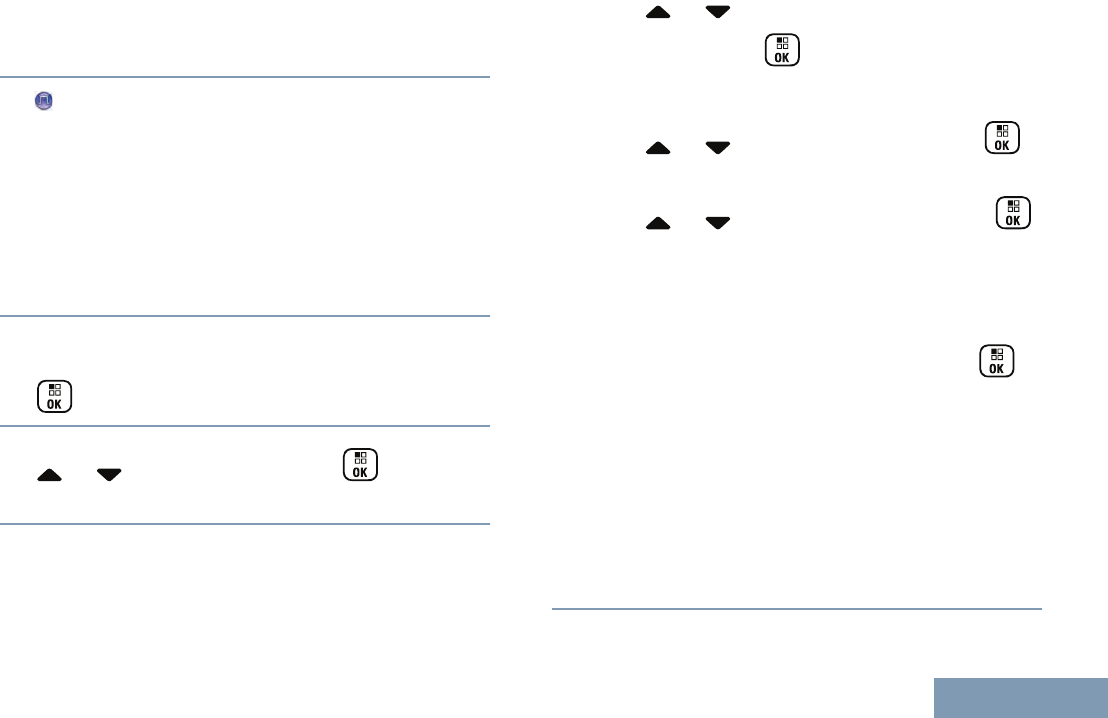
When the target radio responds, the LED blinks
green and the display shows the transmitting
user's ID.
8 If the Channel Free Indication feature is
enabled, you hear a short alert tone the moment
the transmitting radio releases the PTT button,
indicating the channel is free for you to respond.
Press the PTT button to respond.
If there is no voice activity for a predetermined
period of time, the call ends.
The display shows Call Ended.
Making a Phone Call from Contacts
1
to access the menu.
2
or to Contacts and press to select.
The entries are alphabetically sorted.
3Use one of the steps described next to select the
required subscriber alias or ID:
• select the subscriber alias or ID directly
• or to the required subscriber alias or
ID and press to select.
•use the Manual Dial menu
•
or to Manual Dial and press
to select.
•
or to Phone Number and press
to select.
•The first line of the display shows Phone
Number: , the second line of the display
shows a blinking cursor. Use the keypad to
enter a telephone number, and press
to select the entered number.
If the entry selected is empty, a negative indicator
tone sounds and the display shows Phone Call
Invalid # .
When you press PTT button while in the Phone
Contacts screen, a negative indicator tone sounds
and the display shows Press OK to Place
Phone Call.
Advanced Features in Non-Connect Plus Mode
85
English
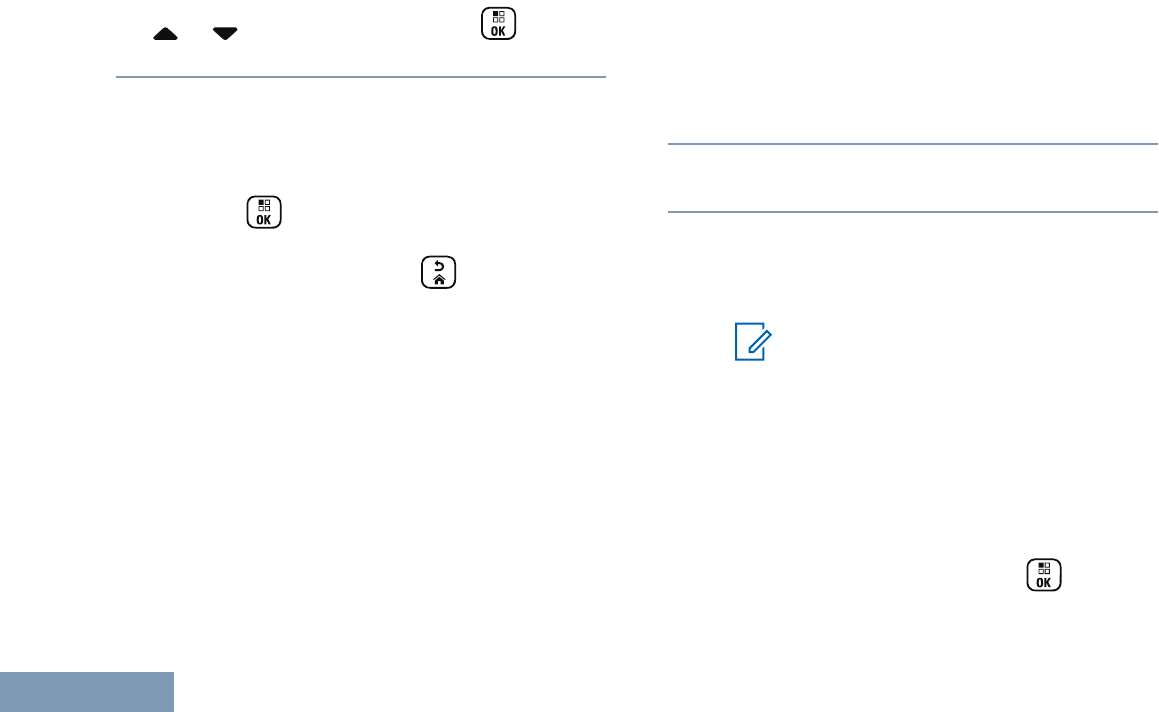
4
or to Call Phone and press to
select.
5If the access code was not preconfigured in the
Contacts list, the first line of the display shows
Access Code: . The second line of the display
shows a blinking cursor. Enter the access code
and press to proceed.
During channel access, press to dismiss the
call attempt and a negative indicator tone sounds.
Your radio returns to the Call Phone screen.
The access code cannot be more than 10
characters.
The first line of the display shows Calling. The
second line of the display shows the subscriber
alias or ID, and the Phone Call icon.
If successful, the DTMF tone sounds. You hear
the dialing tone of the telephone user. The first line
of the display shows the subscriber alias or ID,
and the RSSI icon. The second line of the display
shows Phone Call and the Phone Call icon.
If unsuccessful, a tone sounds and the display
shows Phone Call Failed. Your radio returns to
the Access Code input screen. If the access code
was preconfigured in the Contacts list, the radio
returns to the screen you were on prior to initiating
the call.
6Hold the radio vertically 1 to 2 inches (2.5 to 5.0
cm) from your mouth.
7Do one of the following:
• Press the PTT button to talk and release it to
listen.
Note:
The RSSI icon disappears during
transmission.
To enter extra digits, if requested by the
Phone Call, press any keypad key to
begin the input of extra digits. The first
line of the display shows Extra
Digits: . The second line of the
display shows a blinking cursor. Enter
the extra digits and press to
Advanced Features in Non-Connect Plus Mode
86
English

proceed. The DTMF tone sounds and
the radio returns to the previous screen.
If the call ends while you are entering
the extra digits requested by the Phone
Call, your radio returns to the screen
you were on prior to initiating the call.
• Press One Touch Access button.
Note:
The DTMF tone sounds.
If the entry for the One Touch Access
button is empty, a negative indicator
tone sounds.
During the call, when you press One Touch
Access button with the deaccess code
preconfigured or enter the deaccess code as the
input for extra digits, your radio attempts to end
the call.
During channel access and access/deaccess code
or extra digits transmission, your radio responds to
On/Off/Volume Control Knob and Channel
Selector Knob only. A tone sounds for every
invalid input.
8
Press to end the call.
9If deaccess code was not preconfigured in the
Contacts list, the first line of the display shows De-
Access Code:. The second line of the display
shows a blinking cursor. Enter the deaccess code
and press to proceed.
The deaccess code cannot be more than 10
characters.
The DTMF tone sounds and the display shows
Ending Phone Call.
If successful, a tone sounds and the display shows
Phone Call Ended. Your radio returns to the Call
Phone screen.
If unsuccessful, your radio returns to the Phone
Call screen. Repeat Steps 8 and 9 or wait for the
telephone user to end the call.
When the telephone user ends the call, a tone
sounds and the display shows Phone Call
Ended.
Advanced Features in Non-Connect Plus Mode
87
English
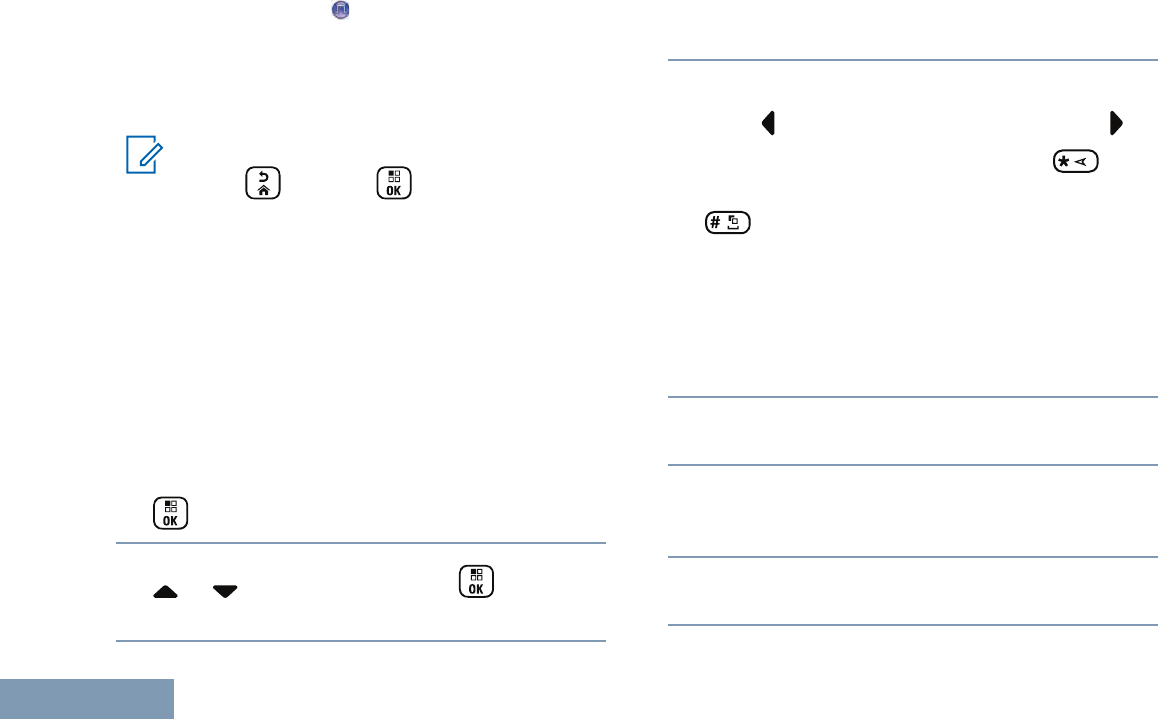
Making a Call Alias Search
You can also use alias or alphanumeric search to
retrieve the required subscriber alias.
This feature is only applicable while in Contacts.
Note:
Press button or to exit alias search.
If you release the PTT button while the radio is
setting up the call, it exits without any
indication and returns to the previous screen.
Your radio may be programmed to perform a
radio presence check prior to setting up the
Private Call. If the target radio is not available,
you hear a short tone and see negative mini
notice on the display. The radio returns to the
menu prior to initiating the radio presence
check.
1
to access the menu.
2
or to Contacts and press to select.
The entries are alphabetically sorted.
3Key in the first character of the required alias.
A blinking cursor appears.
4Use the keypad to type the required alias.
Press to move one space to the left. Press to
move one space to the right. Press the key
to delete any unwanted characters. Long press
to change text entry method.
The first line of the display shows the characters
you keyed in. The next lines of the display show
the short listed search results. The alias search is
case-insensitive. If there are two or more entries
with the same name, the radio displays the entry
that is listed first in the Contacts list.
5Hold the radio vertically 1 to 2 inches (2.5 to 5.0
cm) from your mouth.
6Press the PTT button to make the call.
The LED lights up solid green. The display shows
the destination alias.
7Wait for the Talk Permit Tone to finish (if enabled),
and speak clearly into the microphone.
Advanced Features in Non-Connect Plus Mode
88
English
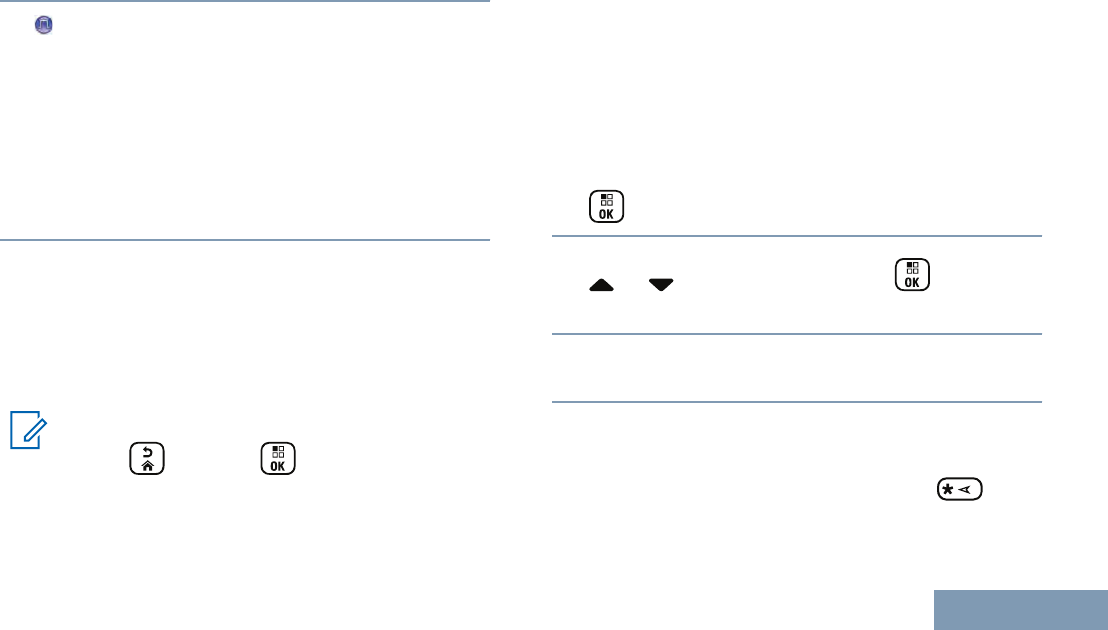
8Release the PTT button to listen.
When the target radio responds, the LED blinks
green.
9 If the Channel Free Indication feature is
enabled, you hear a short alert tone the moment
the transmitting radio releases the PTT button,
indicating the channel is free for you to respond.
Press the PTT button to respond.
If there is no voice activity for a predetermined
period of time, the call ends.
The display shows Call Ended.
Making a Group, Private, Phone or All Call by Alias
Search
You can also use alias or alphanumeric search to
retrieve the required subscriber alias.
This feature is only applicable while in Contacts.
Note:
Press button or to exit alias search.
If you release the PTT button while the radio is
setting up the call, it exits without any
indication and returns to the previous screen.
Your radio may be programmed to perform a
radio presence check prior to setting up the
Private Call. If the target radio is not available,
you hear a short tone and see Party Not
Available on the display; the radio returns to
the menu prior to initiating the radio presence
check.
1
to access the menu.
2
or to Contacts and press to select.
The entries are alphabetically sorted.
3Key in the first character of the required alias.
A blinking cursor appears.
4Use the keypad to type the required alias.
Press to move one space to the left. Press to
move one space to the right. Press the key
to delete any unwanted characters.
Advanced Features in Non-Connect Plus Mode
89
English
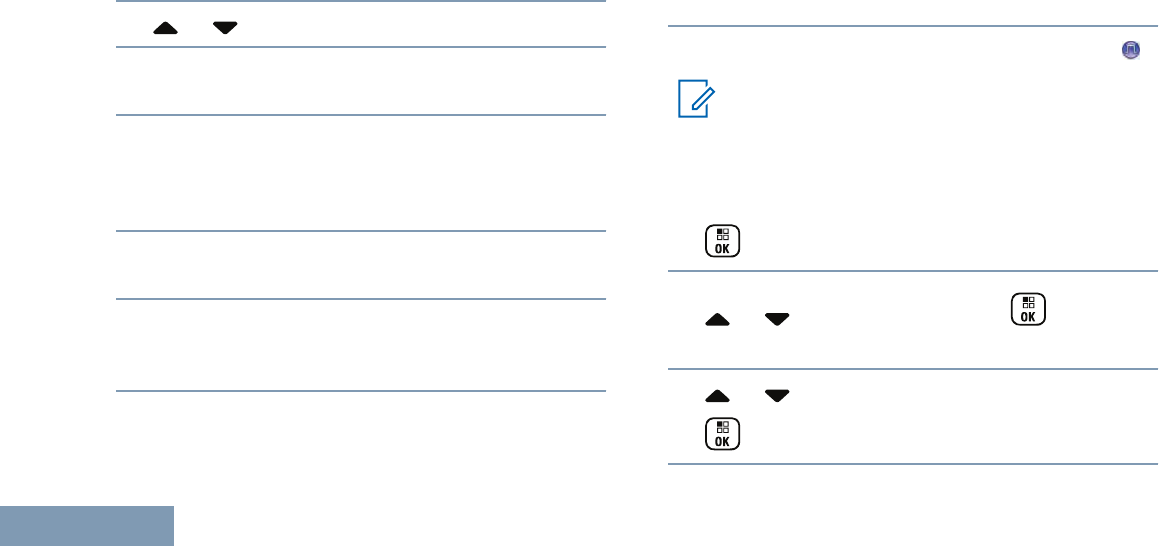
The first line of the display shows the characters
you keyed in. The second line of the display
shows an alias that matches what you have keyed
in. The alias search is case-insensitive. If there are
two or more entries with the same name, the radio
displays the entry that is listed first in the Contacts
list.
5 or to scroll to desired entry, if necessary.
6Hold the radio vertically 1 to 2 inches (2.5 to 5.0
cm) from your mouth.
7Press the PTT button to make the call.
The LED lights up solid green. The first line
displays the target radio’s ID. The second line
displays the call type and the Call icon.
8Wait for the Talk Permit Tone to finish (if enabled)
and speak clearly into the microphone.
9Release the PTT button to listen.
When the target radio responds, the LED blinks
green.
10 If the Channel Free Indication feature is enabled,
you will hear a short alert tone the moment the
target radio releases the PTT button, indicating the
channel is free for you to respond. Press the PTT
button to respond.
If there is no voice activity for a programmed
period of time, the call ends.
You hear a short tone. The display shows Call
Ended.
Assigning an Entry to a Programmable Number Key
Note:
See Making a Group, Private or All Call with
the Programmable Number Key on page 63
for details on making a Group, Private or All
Call with the programmed number key(s).
1
to access the menu.
2
or to Contacts and press to select.
The entries are alphabetically sorted.
3 or to the required alias or ID and press
to select.
Advanced Features in Non-Connect Plus Mode
90
English
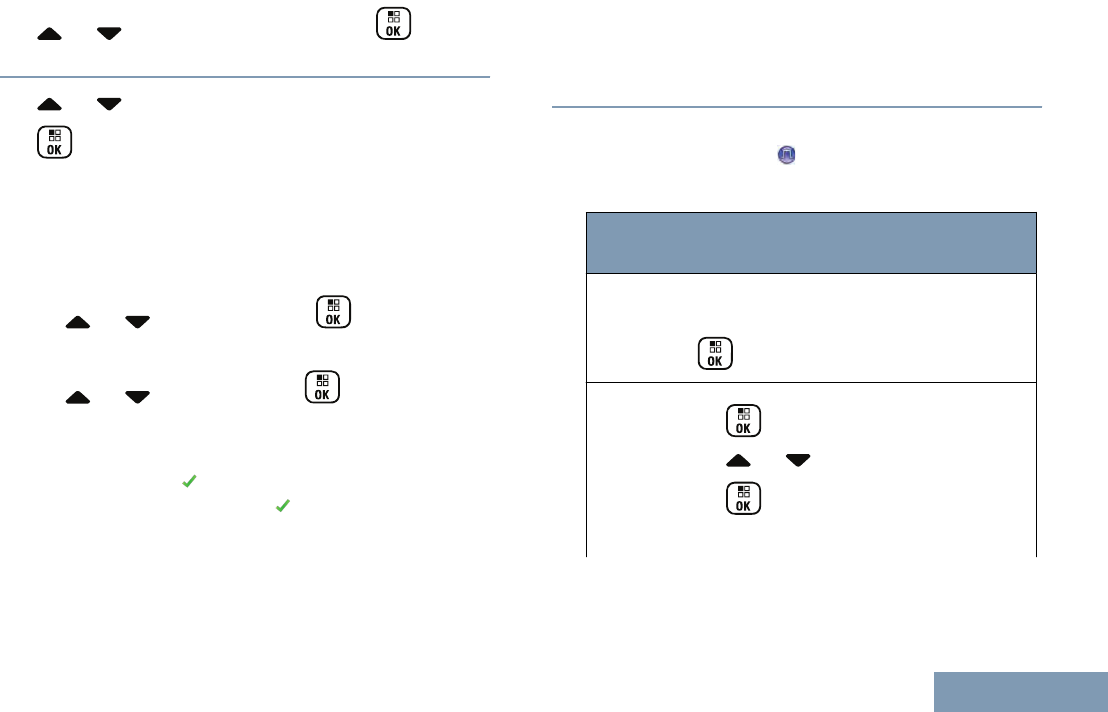
4
or to Program Key and press to
select.
5 or to the desired number key and press
to select.
If the number key is currently assigned to another
entry, the display shows The Key is Already
Assigned and then, the first line of the display
shows Overwrite?. Do one of the following.
•
or to Yes and press to overwrite
the number key assignment.
•
or to No and press to return to the
previous step.
Each entry can be associated to different number
keys. You see a before each number key that is
assigned to an entry. If the is before Empty, that
number key is not assigned.
If a number key is assigned to an entry in a
particular mode, this feature is not supported when
you long press the number key in another mode.
The radio sounds a positive indicator tone and the
display shows positive mini notice.
The screen automatically returns to the previous
menu.
Removing the Association between Entry and
Programmable Number Key
1Access the required alias or ID via:
Radio
Control
Steps
Program-
med num-
ber key
Long press the programmed number
key to the required alias or ID; press
to select.
Menu 1
to access the menu.
2 or to Contacts and press
to select. The entries are al-
phabetically sorted.
Advanced Features in Non-Connect Plus Mode
91
English
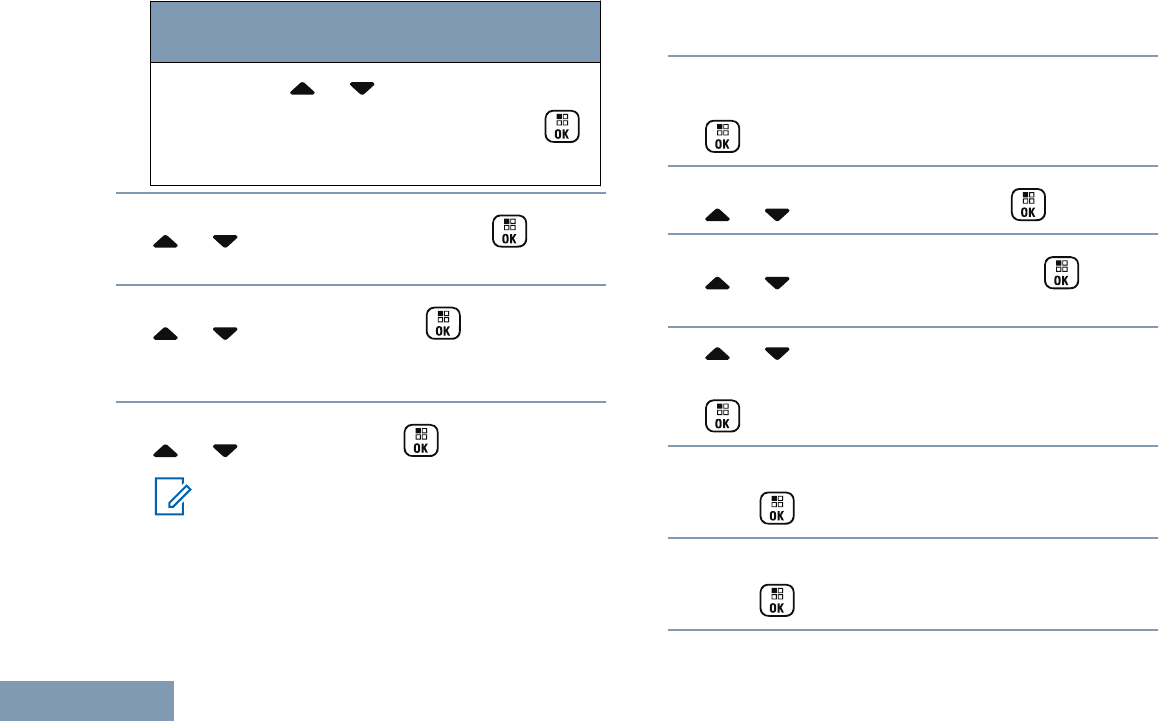
Radio
Control
Steps
3 or to the required sub-
scriber alias or ID and press
to select.
2
or to Program Key and press to
select.
3
or to Empty and press to select.
The first line of the display shows Clear from
all keys? .
4
or to Yes and press to select.
Note:
When an entry is deleted, the association
between the entry and its programmed
number key(s) is removed.
The radio sounds a positive indicator tone and the
display shows positive mini notice.
The screen automatically returns to the previous
menu.
Adding a New Contact
1
to access the menu.
2
or to Contacts and press to select.
3
or to New Contact and press to
select.
4 or to the required contact type, either
Radio Contact or Phone Contact, and press
to select.
5Use the keypad to enter the contact number and
press to confirm.
6Use the keypad to enter the contact name and
press to confirm.
Advanced Features in Non-Connect Plus Mode
92
English
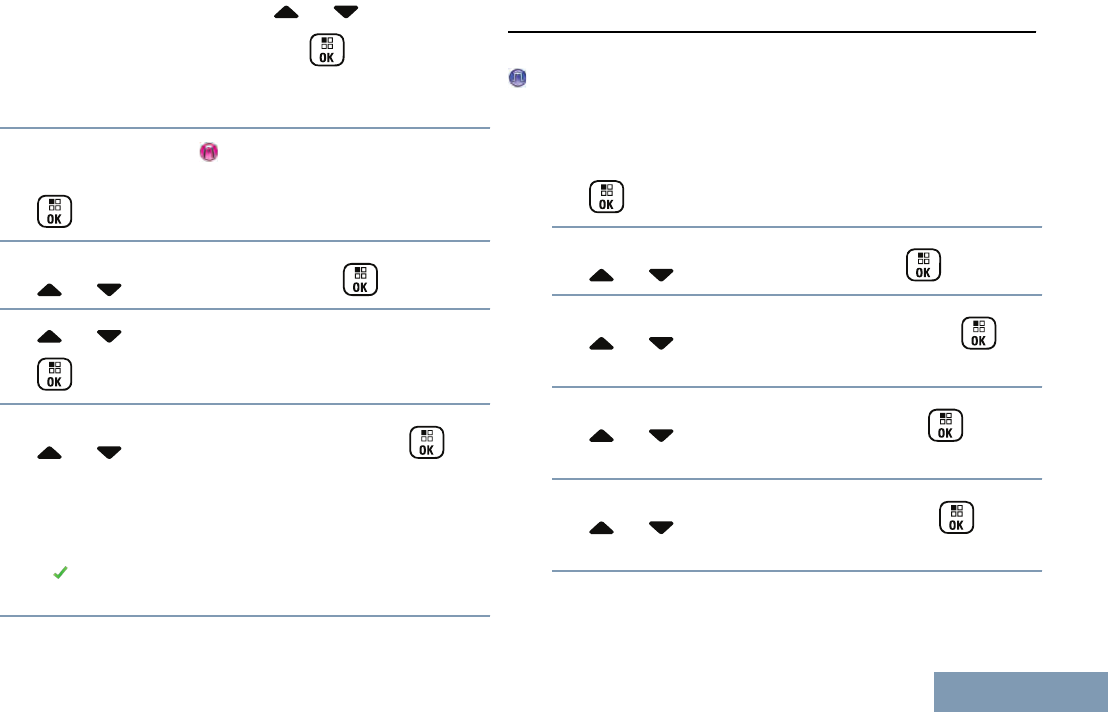
7If adding a Radio Contact, or to the
required ringer type and press to select.
The radio sounds a positive indicator tone and the
display shows positive mini notice.
Setting a Default Contact
1
to access the menu.
2
or to Contacts and press to select.
3 or to the required alias or ID and press
to select.
4
or to Set as Default and press to
select.
The radio sounds a positive indicator tone and the
display shows positive mini notice.
A appears beside the selected default alias or
ID.
Call Indicator Settings
Activating and Deactivating Call Ringers for Call Alert
You can select, or turn on or off ringing tones for a
received Call Alert.
1
to access the menu.
2
or to Utilities and press to select.
3
or to Radio Settings and press to
select.
4
or to Tones/Alert and press to
select.
5
or to Call Ringers and press to
select.
Advanced Features in Non-Connect Plus Mode
93
English
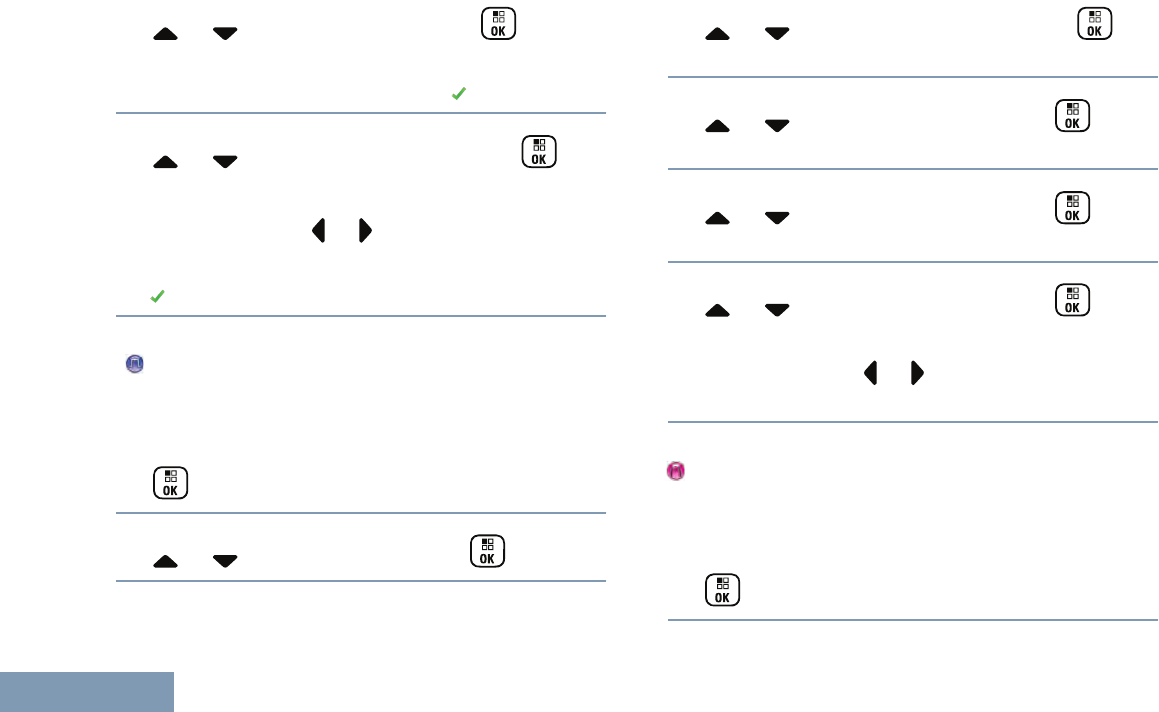
6
or to Call Alert and press to
select.
The current tone is indicated by a .
7
or to the required tone and press to
select.
You can also use or to change the selected
option.
appears beside selected tone.
Activating and Deactivating Call Ringers for Private
Calls
You can turn on or off the ringing tones for a received
Private Call.
1
to access the menu.
2
or to Utilities and press to select.
3
or to Radio Settings and press to
select.
4
or to Tones/Alerts and press to
select.
5
or to Call Ringers and press to
select.
6
or to Private Call and press to
select.
You can also use or to change the selected
option.
Activating and Deactivating Call Ringers for Selective
Call
You can select, or turn on or off ringing tones for a
received Selective Call.
1
to access the menu.
Advanced Features in Non-Connect Plus Mode
94
English
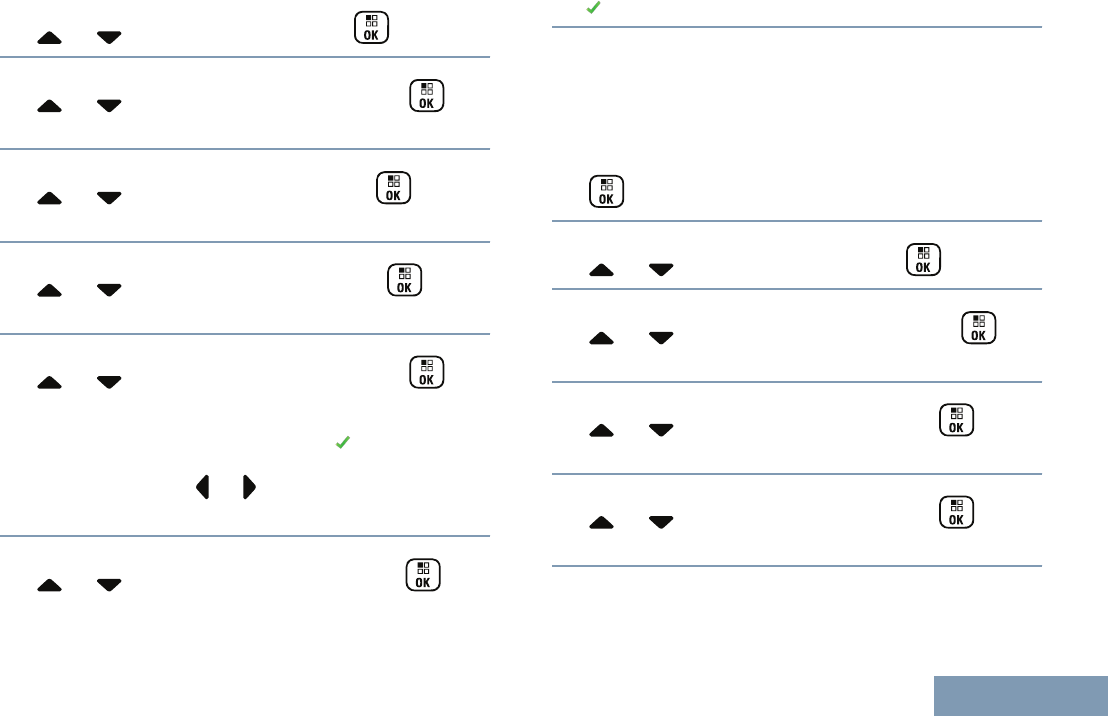
2
or to Utilities and press to select.
3
or to Radio Settings and press to
select.
4
or to Tones/Alert and press to
select.
5
or to Call Ringers and press to
select.
6
or to Selective Call and press to
select.
The current tone is indicated by a .
You can also use or to change the selected
option.
7
or to the required tone and press to
select.
appears beside selected tone.
Activating and Deactivating Call Ringers for Text
Message
You can turn on or off the ringing tones for a received
Text Message.
1
to access the menu.
2
or to Utilities and press to select.
3
or to Radio Settings and press to
select.
4
or to Tones/Alerts and press to
select.
5
or to Call Ringers and press to
select.
Advanced Features in Non-Connect Plus Mode
95
English
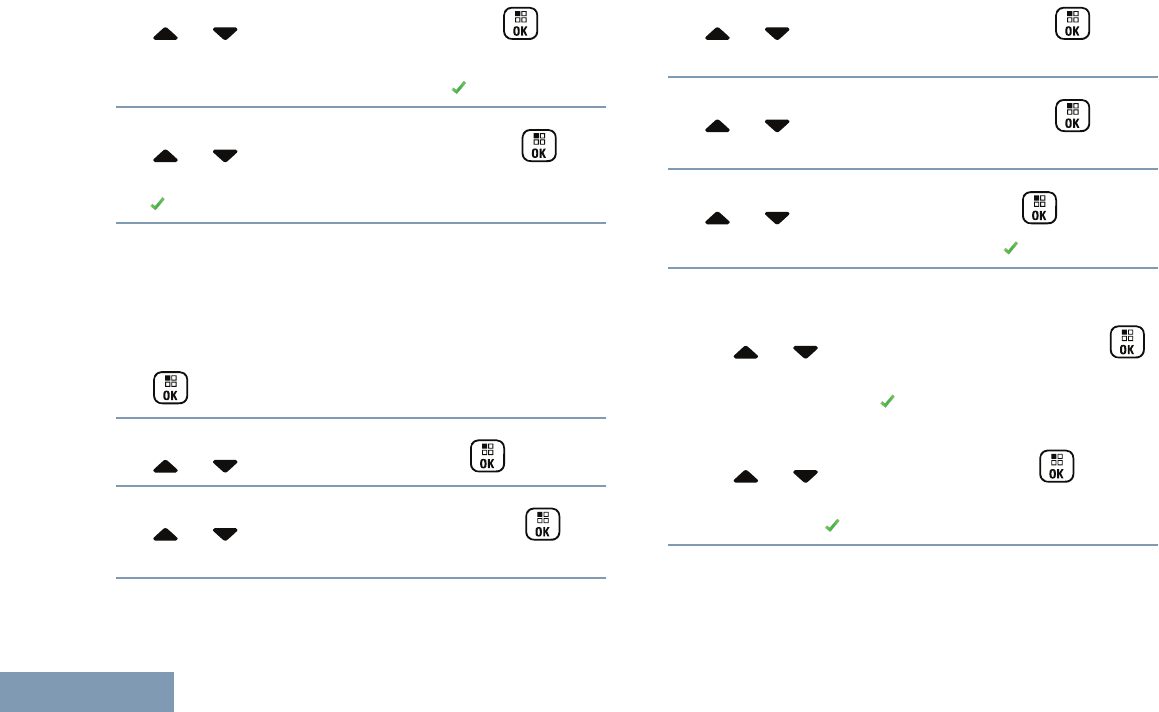
6
or to Text Message and press to
select.
The current tone is indicated by a .
7
or to the required tone and press to
select.
appears beside selected tone.
Activating and Deactivating Call Ringers for Telemetry
Status with Text
You can turn on or off the ringing tones for a received
Telemetry Status with Text.
1
to access the menu.
2
or to Utilities and press to select.
3
or to Radio Settings and press to
select.
4
or to Tones/Alerts and press to
select.
5
or to Call Ringers and press to
select.
6
or to Telemetry and press to select.
The current tone is indicated by a .
7Do one of the following:
•
or to the preferred tone and press
to select. The display shows Tone <Number>
Selected and a appears left of the selected
tone.
•
or to Turn Off and press to
select. The display shows Telemetry Ringer
Off and a appears left of Turn Off.
Advanced Features in Non-Connect Plus Mode
96
English
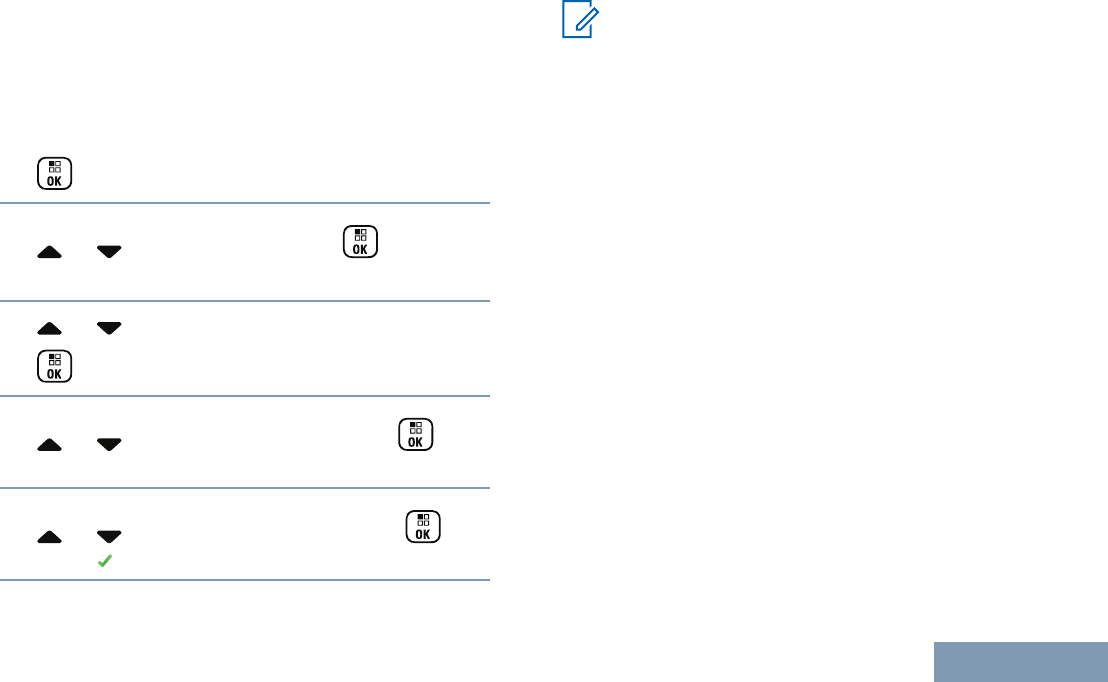
Assigning Ring Styles
You can program your radio to sound one of ten
predefined ringing tones when receiving a Call Alert
or a Text Message from a particular contact.
The radio sounds out each ring style as you navigate
through the list.
1
to access the menu.
2
or to Contacts and press to select.
The entries are alphabetically sorted.
3 or to the required alias or ID and press
to select.
4
or to Edit Ringtone and press to
select.
5
or to the required tone and press to
select. appears beside selected tone.
Selecting a Ring Alert Type
Note:
The programmed Ring Alert Type button is
assigned via CPS. Check with your dealer or
system administrator to determine how your
radio has been programmed.
You can program the radio calls to one
predetermined vibrate call. If All Tones status is
disabled, the radio displays the All Tone Mute icon.
If All Tones status is enabled, the related ring alert
type is displayed.
The radio sounds one vibration if it is a momentary
ring style. The radio vibrates repetitively if it is a
repetitive ring style. When set to Ring and Vibrate,
the radio sounds a specific ring tone if there is any
incoming radio transaction (for example, Call Alert or
Message). It sounds like a good key tone or missed
call.
For radios with batteries that support the vibrate
feature and are attached to a vibrating belt clip, the
available Ring Alert Type options are Silent, Ring,
Vibrate, and Ring and Vibrate.
For radios with batteries that do not support the
vibrate feature and are not attached to a vibrating belt
Advanced Features in Non-Connect Plus Mode
97
English
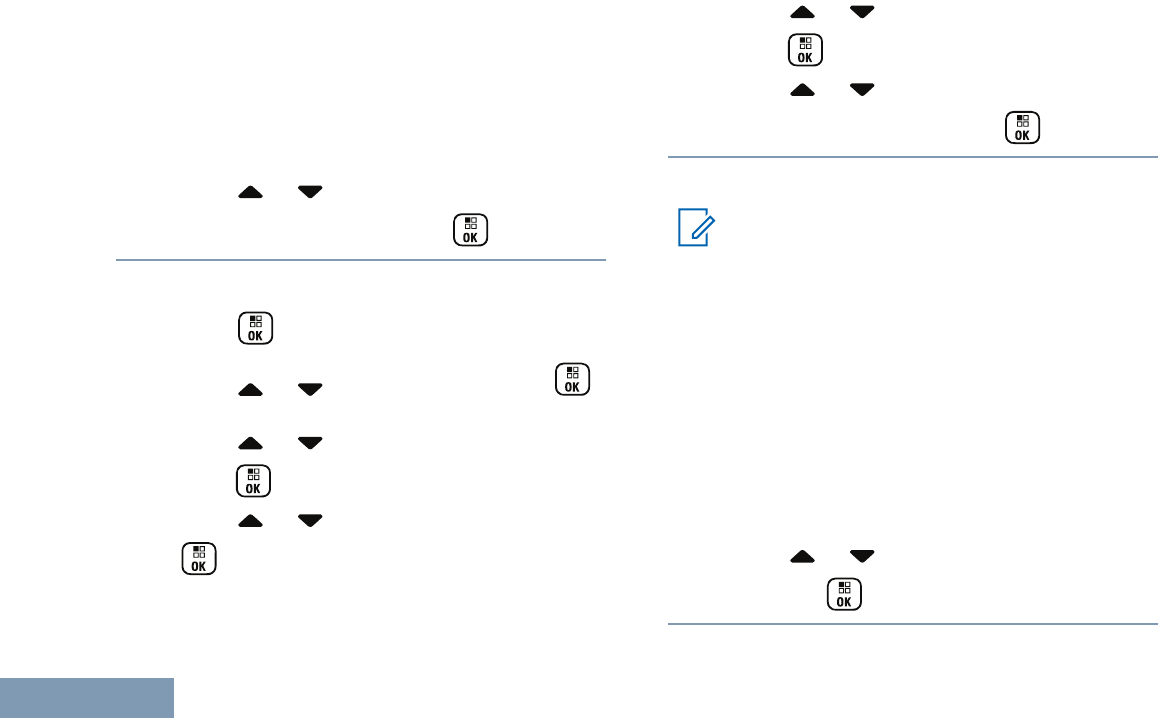
clip, Ring Alert Type is automatically set to Ring. The
available Ring Alert Type options are Silent and Ring.
You can select a Ring Alert Type by performing one
of the following actions.
•Press the programmed Ring Alert Type button to
access the Ring Alert Type menu.
a) Press or to Ring, Vibrate, Ring &
Vibrate or Silent and press to select.
•Access this feature via the menu.
a)
Press to access the menu.
b)
Press or to Utilities and press
to select.
c) Press or to Radio Settings and
press to select.
d) Press or to Tones/Alerts and press
to select.
e) Press or to Ring Alert Type and
press to select.
f) Press or to Ring, Vibrate, Ring &
Vibrate or Silent and press to select.
Configuring Vibrate Style
Note:
The programmed Vibrate Style button is
assigned via CPS. Check with your dealer or
system administrator to determine how your
radio has been programmed.
Vibrate Style is enabled when the Vibrating Belt Clip
is attached to the radio with a battery that supports
the vibrate feature.
You can configure the vibrate style by performing one
of the following actions.
•Press the programmed Vibrate Style button to
access the Vibrate Style menu.
a) Press or to Short, Medium, or Long
and press to select.
Advanced Features in Non-Connect Plus Mode
98
English
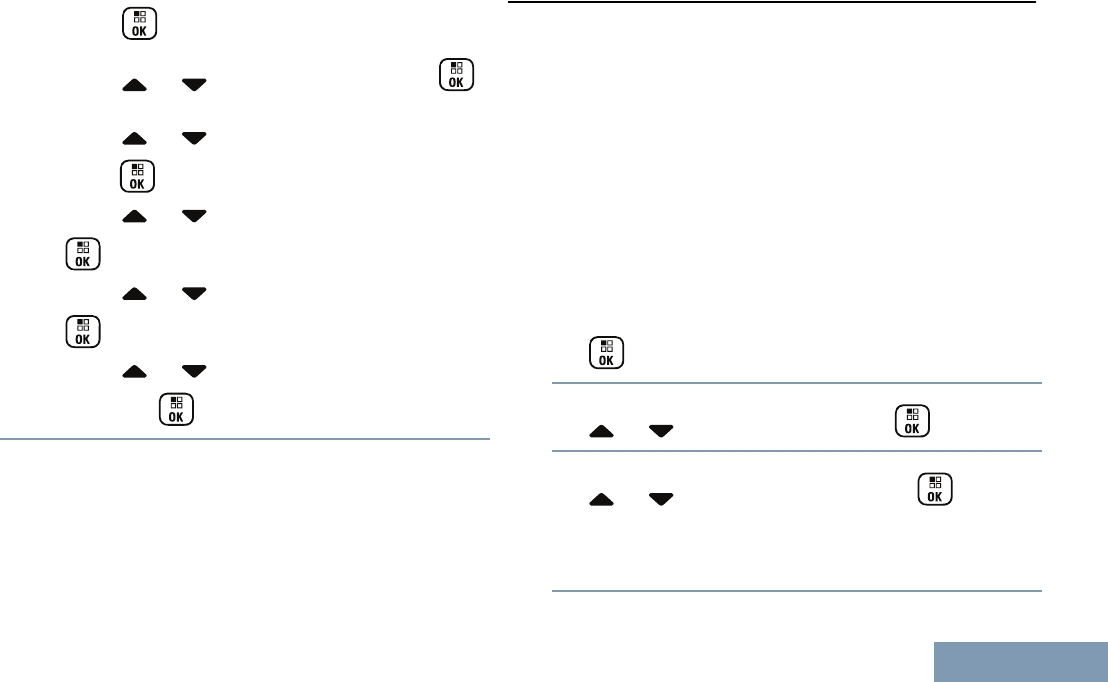
•Access this feature via the menu.
a)
Press to access the menu.
b)
Press or to Utilities and press
to select.
c) Press or to Radio Settings and
press to select.
d) Press or to Tones/Alerts and press
to select.
e) Press or to Vibrate Style and press
to select.
f) Press or to Short, Medium, or Long
and press to select.
Escalating Alarm Tone Volume
You can program your radio to continually alert you
when a radio call remains unanswered. This is done
by automatically increasing the alarm tone volume
over time. This feature is known as Escalert.
Call Log Features
Your radio keeps track of all recent outgoing,
answered, and missed Private Calls. Use the call log
feature to view and manage recent calls.
You can perform the following tasks in each of your
call lists:
• Store ID to Contacts
• Delete
•View Details
Viewing Recent Calls
The lists are Missed, Answered, and Outgoing.
1
to access the menu.
2
or to Call Log and press to select.
3
or to preferred list and press to
select.
The display shows the most recent entry at the top
of the list.
Advanced Features in Non-Connect Plus Mode
99
English
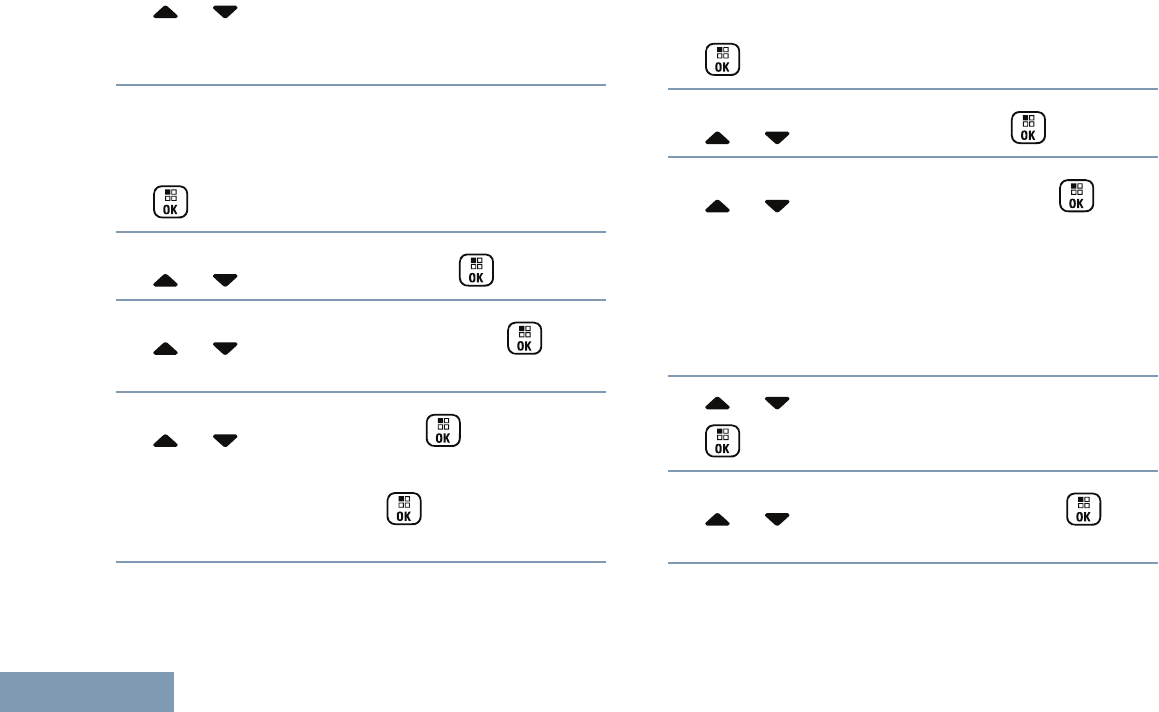
4 or to view the list.
Press the PTT button to start a Private Call with
the current selected alias or ID.
Storing an Alias from a Call List
You can also store an ID without an alias.
1
to access the menu.
2
or to Call Log and press to select.
3
or to the required list and press to
select.
4
or to Store and press to select.
A blinking cursor appears. If needed, key in the
alias for that ID and press . The display
shows positive mini notice.
Deleting a Call from a Call List
1
to access the menu.
2
or to Call Log and press to select.
3
or to the required list and press to
select.
When you select a call list and it contains no
entries, the display shows List Empty, and
sounds a low tone if Keypad Tones are turned on
(see Turning Keypad Tones On or Off on page
152).
4 or to the required alias or ID and press
to select.
5
or to Delete Entry? and press to
select.
6Do one of the following:
Advanced Features in Non-Connect Plus Mode
100
English
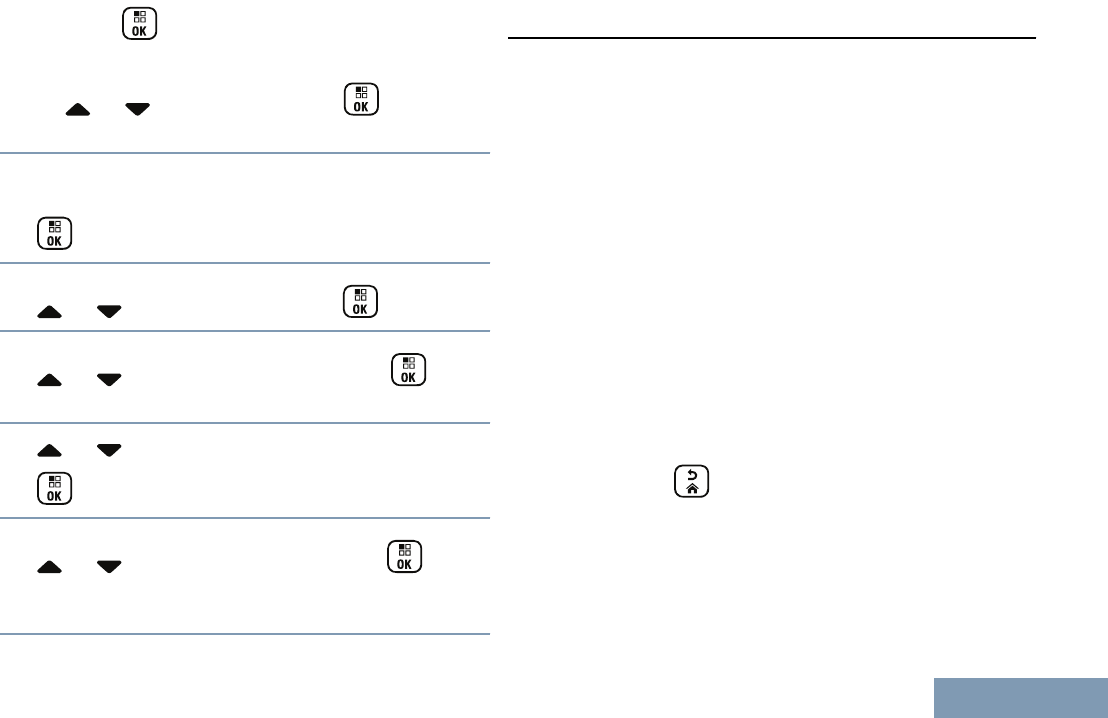
•
Press to select Yes to delete the entry.
The display shows Entry Deleted.
•
or to No, and press the button to
return to the previous screen.
Viewing Details from a Call List
1
to access the menu.
2
or to Call Log and press to select.
3
or to the required list and press to
select.
4 or to the required alias or ID and press
to select.
5
or to View Details and press to
select.
Display shows details.
Call Alert Operation
Call Alert paging enables you to alert a specific radio
user to call you back when they are able to do so.
This feature is applicable for subscriber aliases or IDs
only and is accessible through the menu via Contacts
or manual dial.
Receiving and Responding to a Call Alert
When you receive a Call Alert page, you see the
notification list listing a Call Alert with the alias or ID of
the calling radio on the display.
When you hear a repetitive tone and the LED
blinks yellow, do one of the following:
• Press the PTT button while the display still
shows the Call Alert in the Notification List to
respond with a Private Call.
•
Press to exit the Notification List. The alert
is moved to the Missed Call Log.
See Notification List on page 146 for details about
the Notification List.
Advanced Features in Non-Connect Plus Mode
101
English
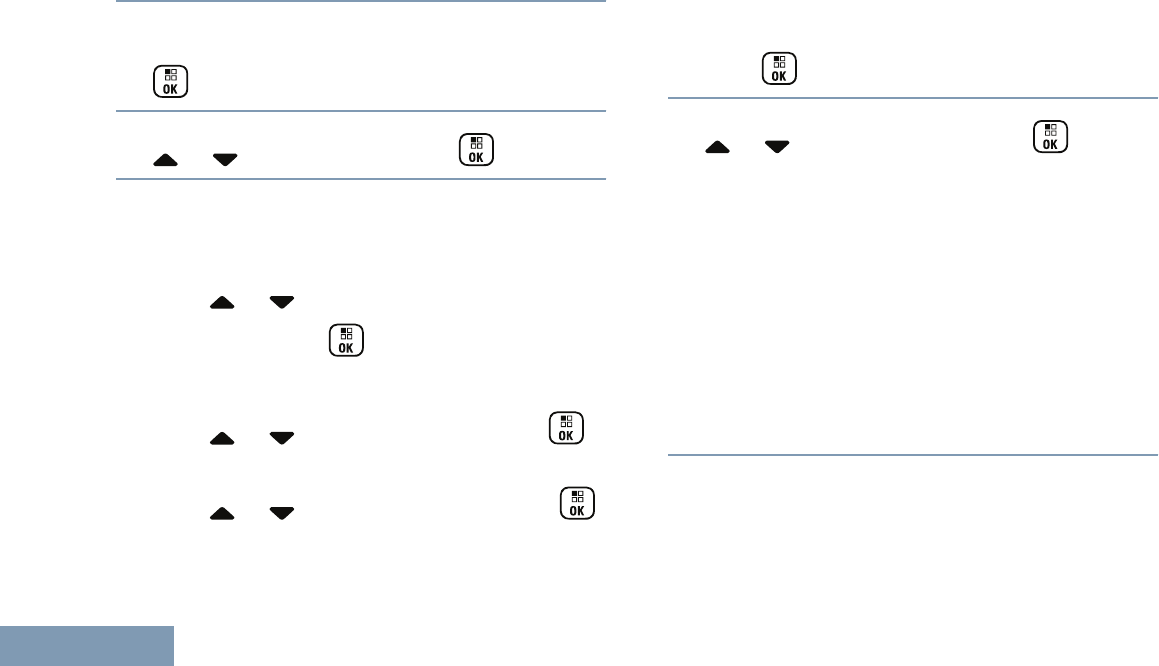
See Call Log Features on page 99 for details
about the Missed Call List.
Making a Call Alert from the Contact List
1
to access the menu.
2
or to Contacts and press to select.
3Use one of the steps described next to select the
required subscriber alias or ID:
• select the subscriber alias or ID directly
• or to the required subscriber alias or
ID and press to select.
•use the Manual Dial menu
•
or to Manual Dial and press
to select.
•
or to Radio Number and press
to select.
•The first line of the display shows Radio
Number: , the second line of the display
shows a blinking cursor. Enter the
subscriber ID you want to page and press
.
4
or to Call Alert and press to
select.
The display shows Call Alert and the
subscriber alias or ID, indicating that the Call Alert
has been sent.
The LED lights up solid green when your radio is
sending the Call Alert.
If the Call Alert acknowledgement is received, the
display shows positive mini notice.
If the Call Alert acknowledgement is not received,
the display shows negative mini notice.
Making a Call Alert with the One Touch Access Button
Press the programmed One Touch Access
button to make a Call Alert to the predefined alias
or ID.
Advanced Features in Non-Connect Plus Mode
102
English
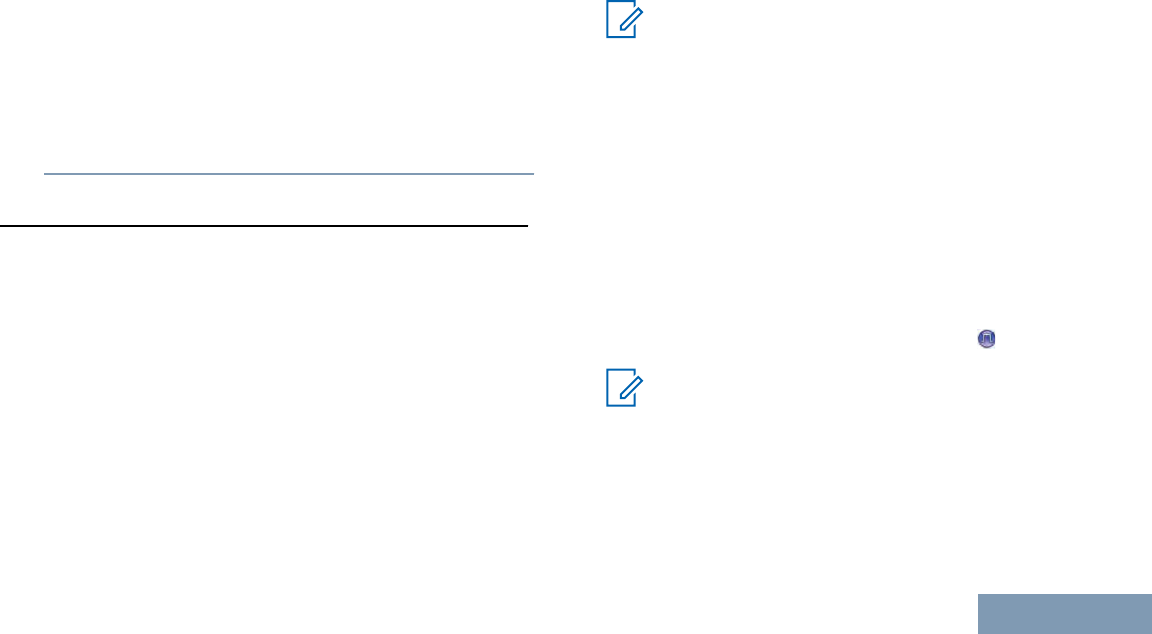
The display shows Call Alert and the
subscriber alias or ID, indicating that the Call Alert
has been sent.
The LED lights up solid green when your radio is
sending the Call Alert.
If the Call Alert acknowledgement is received, the
display shows positive mini notice.
If the Call Alert acknowledgement is not received,
the display shows negative mini notice.
Emergency Operation
An Emergency Alarm is used to indicate a critical
situation. You are able to initiate an Emergency at
any time on any screen display even when there is
activity on the current channel.
Your dealer can set the duration of a button press for
the programmed Emergency button, except for long
press, which is similar with all other buttons:
Short press Between 0.05 seconds and 0.75
seconds.
Long press Between 1.00 second and 3.75
seconds.
The Emergency button is assigned with the
Emergency On/Off feature. Check with your dealer for
the assigned operation of the Emergency button.
Note:
If the short press for the Emergency button is
assigned to turn on the Emergency mode,
then the long press for the Emergency button
is assigned to exit the Emergency mode.
If the long press for the Emergency button is
assigned to turn on the Emergency mode,
then the short press for the Emergency button
is assigned to exit the Emergency mode.
Your radio supports three Emergency Alarms:
•Emergency Alarm
• Emergency Alarm with Call
•Emergency Alarm with Voice to Follow
Note:
Only one of the Emergency Alarms above can
be assigned to the programmed Emergency
button.
In addition, each alarm has the following types:
•Regular – Radio transmits an alarm signal and
shows audio and/or visual indicators.
Advanced Features in Non-Connect Plus Mode
103
English
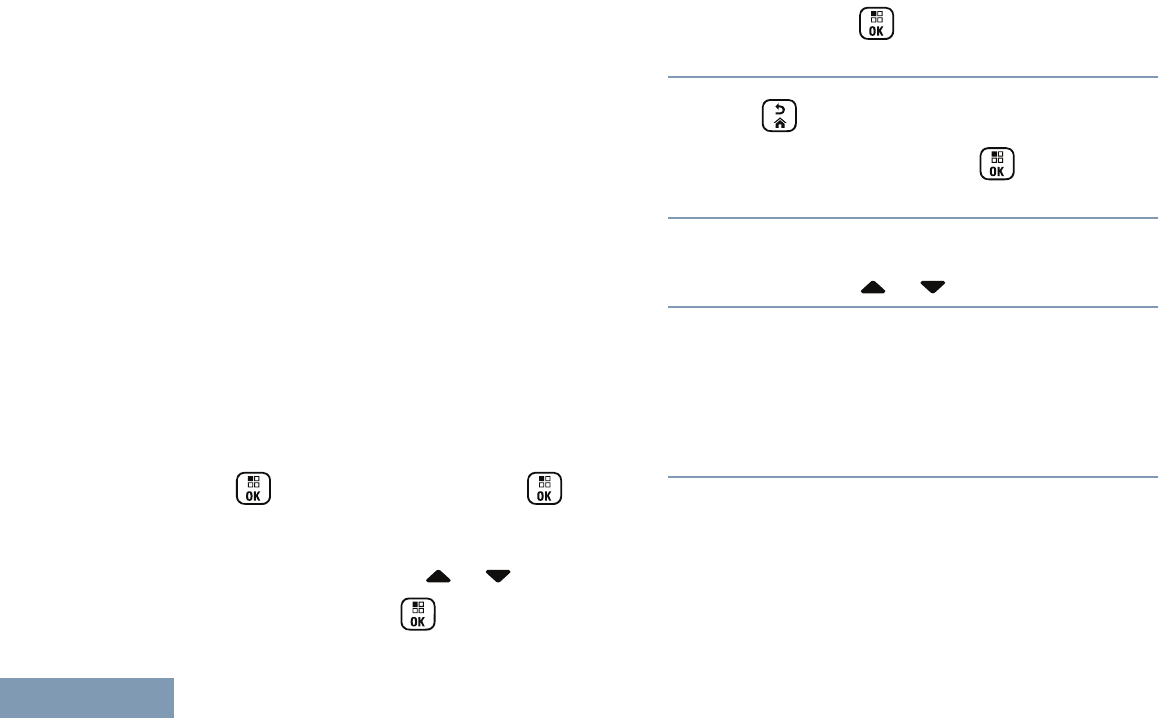
•Silent – Radio transmits an alarm signal without
any audio or visual indicators. Radio receives calls
without any sound through the radio’s speaker,
until you press the PTT button to initiate the call.
•Silent with Voice – Radio transmits an alarm
signal without any audio or visual indicators, but
allow incoming calls to sound through the radio’s
speaker.
Receiving an Emergency Alarm
On receiving an emergency alarm the emergency
icon appears, a tone sounds, the LED blinks red and
the radio displays the emergency caller alias. If more
than one alarm has occurred all emergency caller
aliases are displayed in an Alarm List.
1When receiving an emergency alarm, do one of
the following:
• If a single emergency call alias is displayed,
press to view more details. Press
again to view your action details.
• If the multiple emergency caller aliases are
displayed in the Alarm List, or to the
required alias and press to view more
details. Press again to view your action
items.
2
Press and select Yes to exit the Alarm List.
To revisit the Alarm List, press to access the
menu and select Alarm List.
Responding to an Emergency Alarm
1In the Alarm List, or to the required alias.
2Hold the radio vertically 1 to 2 inches (2.5 to 5.0
cm) from your mouth.
If the Channel Free Indication feature is enabled,
you will hear a short alert tone the moment the
transmitting radio releases the PTT button,
indicating the channel is now available for use.
3Press PTT button to transmit non-emergency
voice to the same group that the Emergency
Alarm was targeted to.
Emergency voice can only be transmitted by the
emergency initiating radio. All other radios
Advanced Features in Non-Connect Plus Mode
104
English

(including the emergency receiving radio) transmit
non-emergency voice.
The LED lights up solid green. Your radio remains
in the Emergency mode.
4Do one of the following:
• Wait for the Talk Permit Tone to finish (if
enabled) and speak clearly into the
microphone.
• Wait for the PTT Sidetone to finish (if enabled)
and speak clearly into the microphone.
5Release the PTT button to listen.
When the emergency initiating radio responds, the
LED blinks green. You see the Group Call icon,
the group ID, and transmitting radio ID on your
display.
6Your radio displays the Alarm List.
Exiting Emergency Mode After Receiving the
Emergency Alarm
Exit the Emergency mode by performing one of
the following actions:
• Delete the alarm items, see Deleting an Alarm
Item from the Alarm List for more information.
• Power down the radio.
Sending an Emergency Alarm
This feature allows you to send an Emergency Alarm,
a non-voice signal, which triggers an alert indication
on a group of radios.
If your radio is set to Silent, it does not display any
audio or visual indicators during Emergency mode.
Press the programmed Emergency On button.
The display shows one of the following:
•Tx Alarm and the destination alias.
•Tx Telegram and the destination alias.
The LED lights up solid green and the Emergency
icon appears on the Home screen display.
When an Emergency Alarm acknowledgement is
received, the Emergency tone sounds and the
LED blinks green. The display shows Alarm Sent.
If your radio does not receive an Emergency
Alarm acknowledgement, and after all retries have
Advanced Features in Non-Connect Plus Mode
105
English

been exhausted, a tone sounds and the display
shows Alarm Failed.
Radio exits the Emergency Alarm mode and
returns to the Home screen.
Sending an Emergency Alarm with Call
This feature allows you to send an Emergency Alarm
to a group of radios. Upon acknowledgement by a
radio within the group, the group of radios can
communicate over a programmed Emergency
channel.
If your radio is set to Silent, it does not display any
audio or visual indicators during Emergency mode, or
allow any received calls to sound through the speaker
of the radio, until you press the PTT button to initiate
the call.
If your radio is set to Silent with Voice, it does not
display any audio or visual indicators during
Emergency mode, but allow incoming calls to sound
through the speaker of the radio. The indicators only
appear once you press the PTT button to initiate, or
respond to, the call.
1Press the programmed Emergency On button.
The display shows one of the following:
•Tx Alarm and the destination alias.
•Tx Telegram and the destination alias.
The LED lights up solid green and the Emergency
icon appears on the Home screen display.
When an Emergency Alarm acknowledgement is
received, the Emergency tone sounds and the
LED blinks green. The display shows Alarm Sent.
Your radio enters the emergency call mode when
the display shows Emergency and the destination
group alias.
2Hold the radio vertically 1 to 2 inches (2.5 to 5.0
cm) from your mouth.
3Press PTT button to make the call.
The LED lights up solid green and the Group icon
appears on the display.
4Wait for one of the following tones to finish (if
enabled), and speak clearly into the microphone.
• The Talk Permit Tone
•The PTT Sidetone
5Release the PTT button to listen.
Advanced Features in Non-Connect Plus Mode
106
English
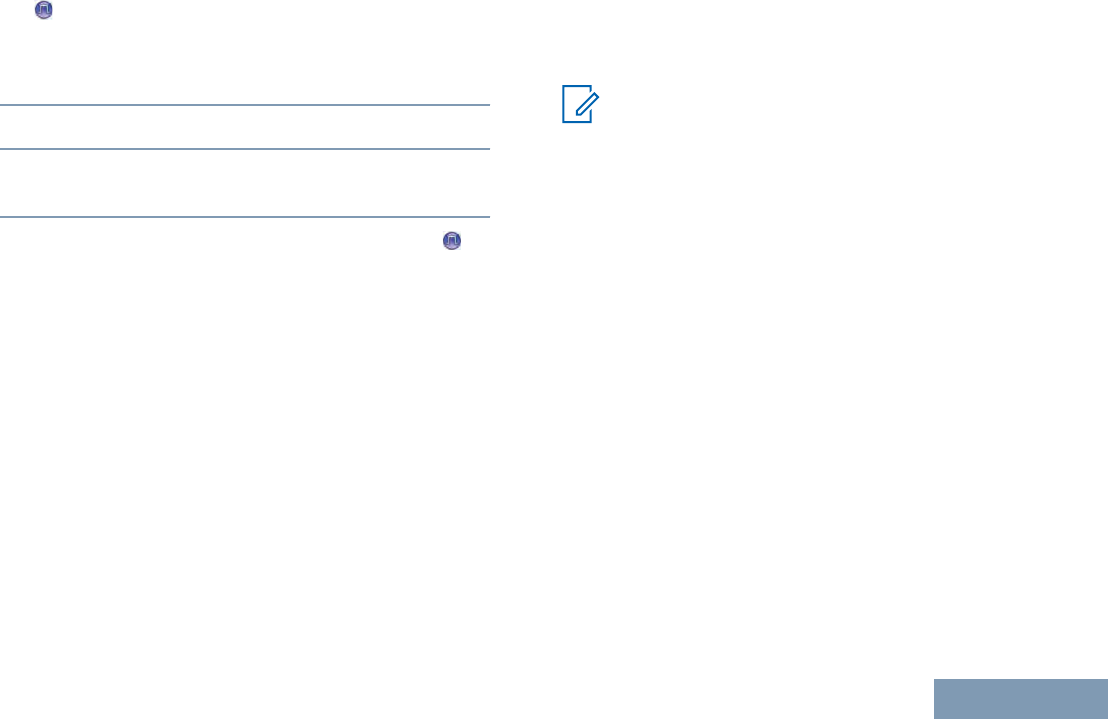
If the Channel Free Indication feature is
enabled, you hear a short alert tone the moment
the transmitting radio releases the PTT button,
indicating the channel is free for you to respond.
6Press the PTT button to respond.
7Once your call ends, press Emergency Off button
to exit the Emergency mode.
Sending an Emergency Alarm with Voice to Follow
This feature allows you to send an Emergency Alarm
to a group of radios. The microphone of your radio is
automatically activated, allowing you to communicate
with the group of radios without pressing the PTT
button.
This activated microphone state is also known as “hot
mic”.
If your radio has Emergency Cycle Mode enabled,
repetitions of hot mic and receiving period are made
for a programmed duration. During Emergency Cycle
Mode, received calls sound through the speaker of
the radio.
If you press the PTT button during the programmed
receiving period, you hear a prohibit tone, indicating
that you should release the PTT button. The radio
ignores the PTT press and remains in Emergency
mode.
Note:
If you press the PTT button during hot mic,
and continue to press it after the hot mic
duration expires, the radio continues to
transmit until you release the PTT button.
If your radio is set to Silent, it does not display any
audio or visual indicators during Emergency mode, or
allow any received calls to sound through the speaker
of the radio, until the programmed hot mic
transmission period is over, and you press the PTT
button.
If your radio is set to Silent with Voice, it does not
display any audio or visual indicators during
Emergency mode when you are making the call with
hot mic, but allow sound through the speaker of the
radio when the target radio responds after the
programmed hot mic transmission period is over. The
indicators only appear when you press the PTT
button.
Advanced Features in Non-Connect Plus Mode
107
English

Note:
If the Emergency Alarm request fails, the radio
does not retry to send the request, and enters
the hot mic state directly.
1Press the programmed Emergency On button.
The display shows one of the following:
•Tx Alarm and the destination alias.
•Tx Telegram and the destination alias.
The LED lights up solid green and the Emergency
icon is displayed.
2Once the display shows Alarm Sent, speak
clearly into the microphone.
When hot mic has been enabled, the radio
automatically transmits without a PTT button press
until the hot mic duration expires. While
transmitting, the LED lights up solid green and the
Emergency icon appears on the display.
3The radio automatically stops transmitting when
the cycling duration between hot mic and receiving
calls expires, if Emergency Cycle Mode is
enabled.
4Once the hot mic duration expires, the radio
automatically stops transmitting. To transmit
again, press the PTT button.
Reinitiating an Emergency Mode
Note:
This feature is only applicable to the radio
sending the Emergency Alarm.
There are two instances where this can happen:
• You change the channel while the radio is in
Emergency mode. This exits the Emergency
mode. If Emergency Alarm is enabled on this new
channel, the radio reinitiates Emergency.
• You press the programmed Emergency On
button during an Emergency initiation/transmission
state. This causes the radio to exit this state, and
to reinitiate Emergency.
Exiting Emergency Mode After Sending the Emergency
Alarm
Your radio exits Emergency mode when one of the
following occurs:
•Emergency Alarm acknowledgement is received
(for Emergency Alarm only).
Advanced Features in Non-Connect Plus Mode
108
English

• All retries to send the alarm have been exhausted.
• The Emergency Off button is pressed.
Note:
If your radio is powered off, it exits the
Emergency mode. The radio will not reinitiate
the Emergency mode automatically when it is
turned on again.
If you change channels when your radio is in
Emergency mode to a channel that has no
emergency system configured, No Emergency
is shown on your display.
Man Down
Note:
This feature is applicable to XPR 7550e/XPR
7580e only.
This feature prompts an emergency to be raised if
there is a change in the motion of the radio, such as
the tilt of the radio, motion and/or the lack of motion
for a predefined time.
Following a change in the motion of the radio for a
programmed duration, the radio pre-warns the user
via an audio indicator indicating that a change in
motion is detected.
If there is still no acknowledgment by the user before
the predefined reminder timer expires, the radio
initiates an Emergency Alarm or an Emergency Call.
You can program the reminder timer via CPS.
Turning the Man Down Feature On or Off
Note:
This feature is applicable to XPR 7550e/XPR
7580e only. The programmed Man Down
button and Man Down settings are assigned
via CPS. Check with your dealer or system
administrator to determine how your radio has
been programmed.
If you disable the Man Down feature, the
programmed alert tone sounds repeatedly until
the Man Down feature is enabled. A device
failure tone sounds when the Man Down
feature fails while powering up. The device
failure tone continues until the radio resumes
normal operation.
If you enable Man Down to maximum
sensitivity and set Vibrate Style to high, the
radio automatically restricts Vibrate Style to
medium. This function prevents high Vibrate
Advanced Features in Non-Connect Plus Mode
109
English
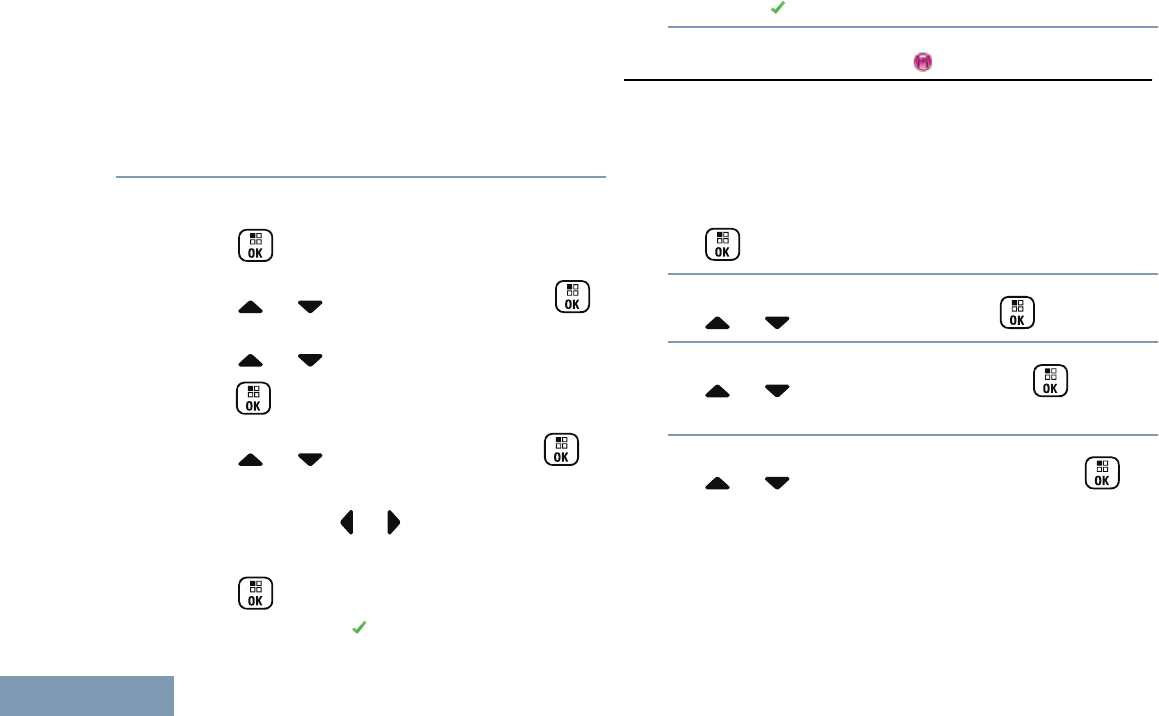
Style from initiating the Man Down emergency
feature.
You can enable or disable this feature by performing
one of the following actions.
•Press the programmed Man Down button to
toggle the feature on or off.
•Access this feature via the menu.
a)
Press to access the menu.
b)
Press or to Utilities and press
to select.
c) Press or to Radio Settings and
press to select.
d)
Press or to Man Down and press
to select.
You can also use or to change the
selected option.
e)
Press to enable or disable Man Down.
This display shows beside Enabled.
The disappears beside Enabled.
Analog Message Encode
Your radio is able to send pre-programmed
messages from the Message list to a radio alias or to
the dispatcher.
Sending MDC Message Encode to Dispatcher
1
to access the menu.
2
or to Message and press to select.
3
or to Quick Text and press to
select.
4
or to the required message. Press to
send.
The display shows transitional mini notice,
confirming your message is being sent.
If the message is sent, a tone sounds and the
display shows positive mini notice.
Advanced Features in Non-Connect Plus Mode
110
English
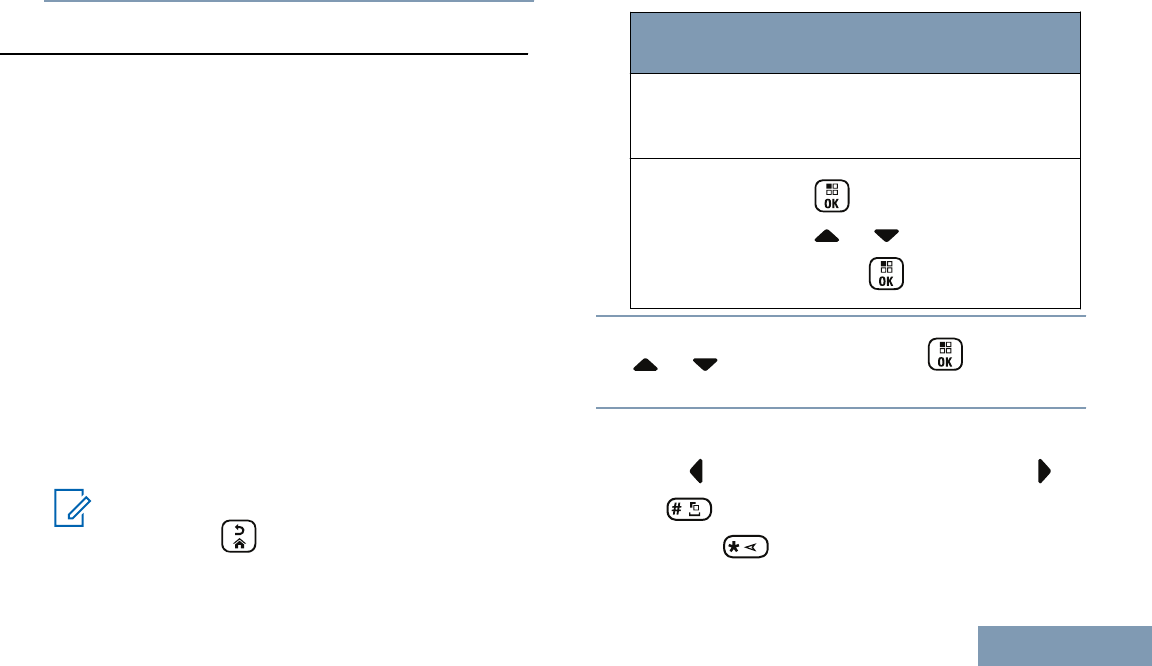
If the message is not sent, a low tone sounds and
the display shows negative mini notice.
Text Message Features
Your radio is able to receive data, for example a text
message, from another radio or an e-mail application.
The maximum length of characters for sending a text
message, including the subject line (seen when
receiving message from an e-mail application),
depends on CPS configuration which can be
configured up to maximum 280 characters. Your radio
can receive a text message with maximum length of
280 characters.
If user forwards a text message with characters more
than the maximum length, the text message will be
truncated to the maximum length.
The radio exits the current screen once the inactivity
timer expires. Any text message in the writing/editing
screen will automatically be saved to the Drafts folder.
Note:
Long press at any time to return to the
Home screen.
Writing and Sending a Text Message
1Access the Text Message feature.
Radio Con-
trols
Steps
Programmed
Text Message
button
Press the programmed Text
Message button.
Menu 1
to access the menu.
2 or to Messages and
press to select.
2
or to Compose and press to select.
A blinking cursor appears.
3Use the keypad to type your message.
Press to move one space to the left. Press or
the key to move one space to the right.
Press the key to delete any unwanted
Advanced Features in Non-Connect Plus Mode
111
English
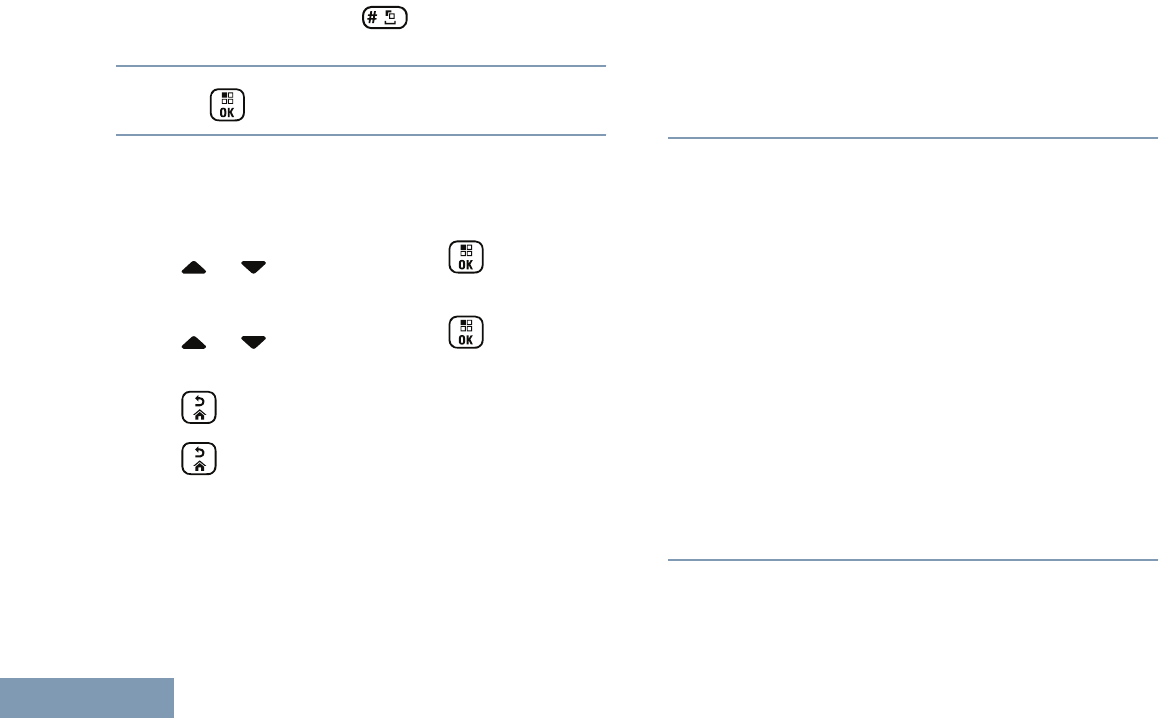
characters. Long press to change text entry
method.
4
Press once message is composed.
5Depending on whether you want to send, save, re-
edit, or delete the newly composed message, do
one of the following.
•
or to Send, and press to send the
message.
•
or to Save, and press to save the
message to the Drafts folder.
•
to edit the message.
•
to choose between deleting the message
or saving it to the Drafts folder.
The display shows transitional mini notice,
confirming your message is being sent.
If the message is sent successfully, a tone sounds
and the display shows positive mini notice.
If the message cannot be sent, a low tone sounds
and the display shows negative mini notice.
If the text message fails to send, the radio returns
you to the Resend option screen (see Managing
Fail-to-Send Text Messages on page 115.
Sending a Quick Text Message with the One Touch
Access Button
Press the programmed One Touch Access
button to send a predefined Quick Text message
to a predefined alias or ID.
The display shows the transitional mini notice,
confirming your message is being sent.
If the message is sent, a tone sounds and the
display shows the positive mini notice.
If the message cannot be sent, a low tone sounds
and the display shows the negative mini notice.
If the text message fails to send, the radio returns
you to the Resend option screen (see Managing
Fail-to-Send Text Messages on page 115).
Advanced Features in Non-Connect Plus Mode
112
English
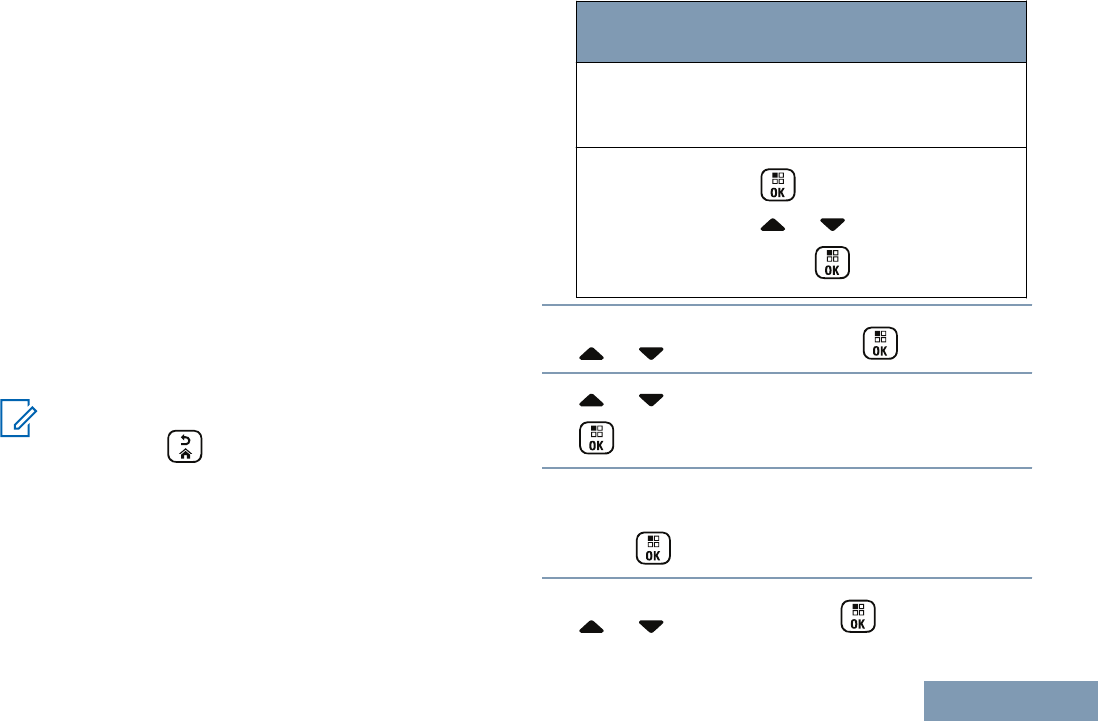
Accessing the Drafts Folder
You can save a text message to send it at a later
time.
If a PTT button press or a mode change causes the
radio to exit the text message writing/editing screen
while you are in the process of writing or editing a text
message, your current text message is automatically
saved to the Drafts folder.
The most recent saved text message is always added
to the top of the Drafts list.
The Drafts folder stores a maximum of ten (10) last
saved messages. When the folder is full, the next
saved text message automatically replaces the oldest
text message in the folder.
Note:
Long press at any time to return to the
Home screen.
Viewing a Saved Text Message
1Access the Text Message feature.
Radio Con-
trols
Steps
Programmed
Text Message
button
Press the programmed Text
Message button.
Menu 1
to access the menu.
2 or to Messages and
press to select.
2
or to Drafts and press to select.
3 or to the required message and press
to select.
Editing and Sending a Saved Text Message
1
Press again while viewing the message.
2
or to Edit and press to select.
Advanced Features in Non-Connect Plus Mode
113
English
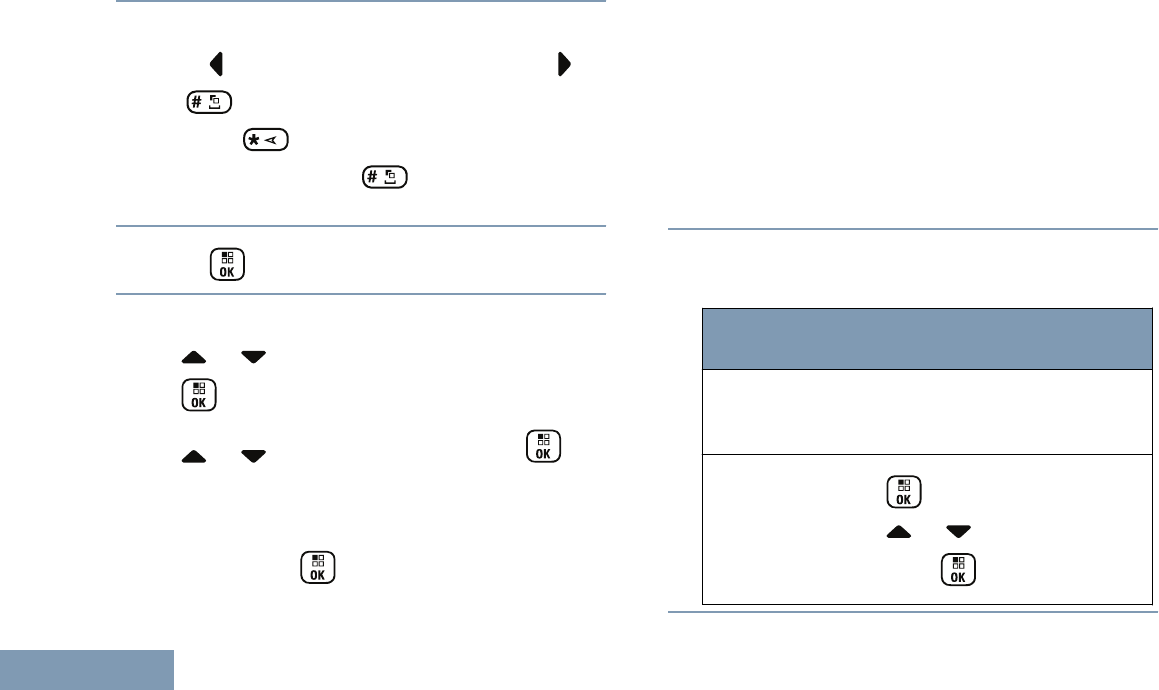
A blinking cursor appears.
3Use the keypad to type your message.
Press to move one space to the left. Press or
the key to move one space to the right.
Press the key to delete any unwanted
characters. Long press to change text entry
method.
4
Press once message is composed.
5Select the message recipient by
• or to the required alias or ID and press
to select.
•
or to Manual Dial, and press to
select. The first line of the display shows Radio
Number:. The second line of the display shows
a blinking cursor. Key in the subscriber alias or
ID and press .
The display shows transitional mini notice,
confirming your message is being sent.
If the message is sent successfully, a tone sounds
and the display shows positive mini notice.
If the message cannot be sent, a low tone sounds
and the display shows negative mini notice.
If the text message cannot be sent, it is moved to
the Sent Items folder and marked with a Send
Failed icon.
Deleting a Saved Text Message from Drafts
1Access the Text Message feature.
Radio Con-
trols
Steps
Programmed
Text Message
button
Press the programmed Text
Message button.
Menu 1
to access the menu.
2 or to Messages and
press to select.
Advanced Features in Non-Connect Plus Mode
114
English
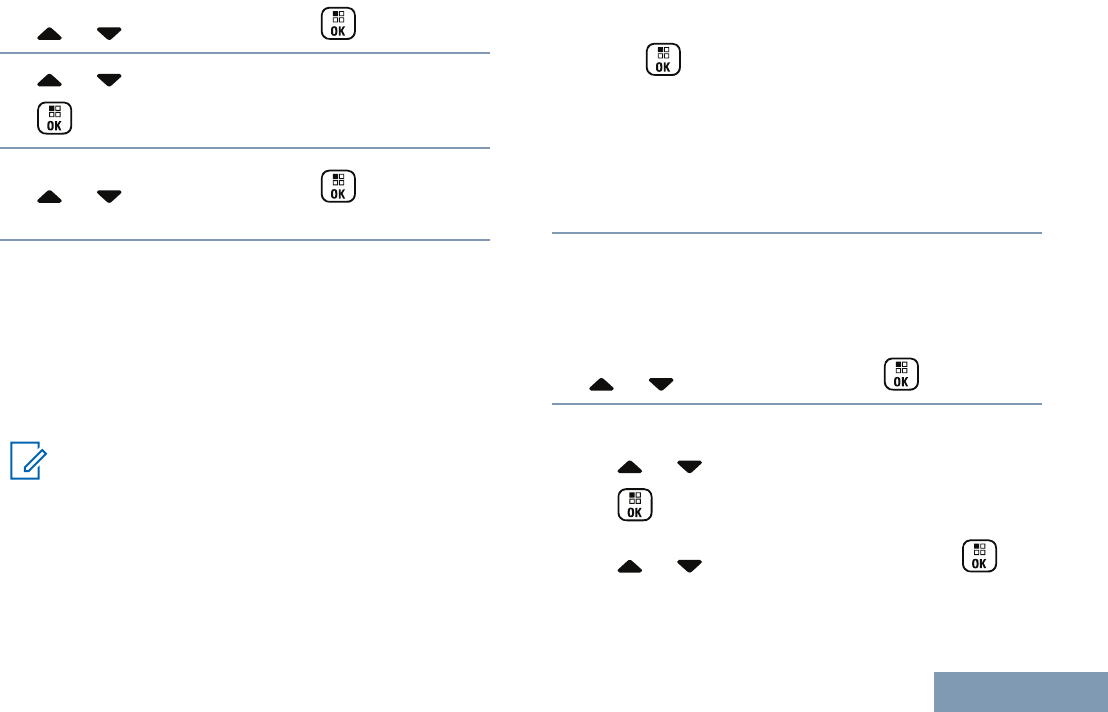
2
or to Drafts and press to select.
3 or to the required message and press
to select.
4
or to Delete and press to delete the
text message.
Managing Fail-to-Send Text Messages
You can select one of the following options while at
the Resend option screen:
• Resend
• Forward
•Edit
Note:
If the channel type (i.e. conventional digital or
Capacity Plus or Linked Capacity Plus) is not
a match, you can only edit and forward a Fail-
to-Send message.
Resending a Text Message
Press to resend the same message to the
same subscriber/group alias or ID.
If the message is sent successfully, a tone sounds
and the display shows the positive mini notice.
If the message cannot be sent, the display shows
the negative mini notice.
Forwarding a Text Message
Select Forward to send the message to another
subscriber/group alias or ID.
1
or to Forward and press to select.
2Select the message recipient by
• or to the required alias or ID and press
to select.
•
or to Manual Dial, and press to
select. The first line of the display shows Radio
Number:. The second line of the display shows
Advanced Features in Non-Connect Plus Mode
115
English
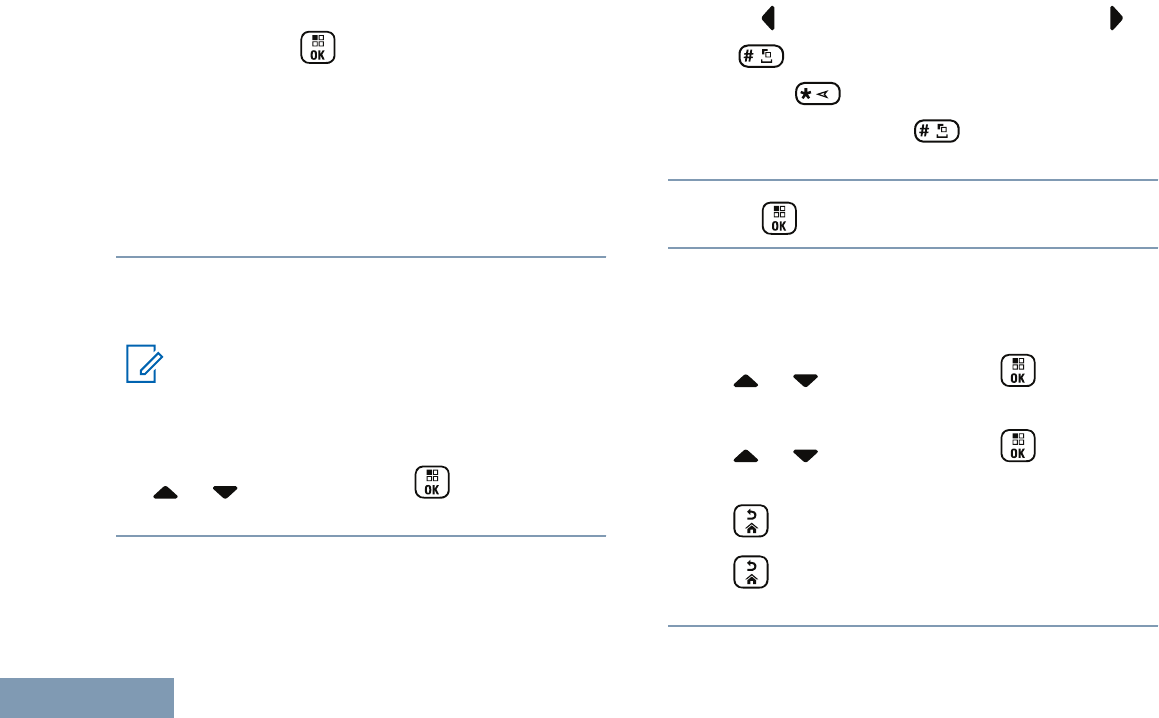
a blinking cursor. Key in the subscriber alias or
ID and press .
The display shows transitional mini notice,
confirming your message is being sent.
If the message is sent successfully, a tone sounds
and the display shows positive mini notice.
If the message cannot be sent, a low tone sounds
and the display shows negative mini notice.
Editing a Text Message
Select Edit to edit the message before sending it.
Note:
If a subject line is present (for messages
received from an e-mail application), you
cannot edit it.
1
or to Edit and press to select.
A blinking cursor appears.
2Use the keypad to edit your message.
Press to move one space to the left. Press or
the key to move one space to the right.
Press the key to delete any unwanted
characters. Long press to change text entry
method.
3
Press once message is composed.
4Depending on whether you want to send, save, re-
edit, or delete the newly composed message, do
one of the following.
•
or to Send, and press to send the
message.
•
or to Save, and press to save the
message to the Drafts folder.
•
to edit the message.
•
to choose between deleting the message
or saving it to the Drafts folder.
Advanced Features in Non-Connect Plus Mode
116
English
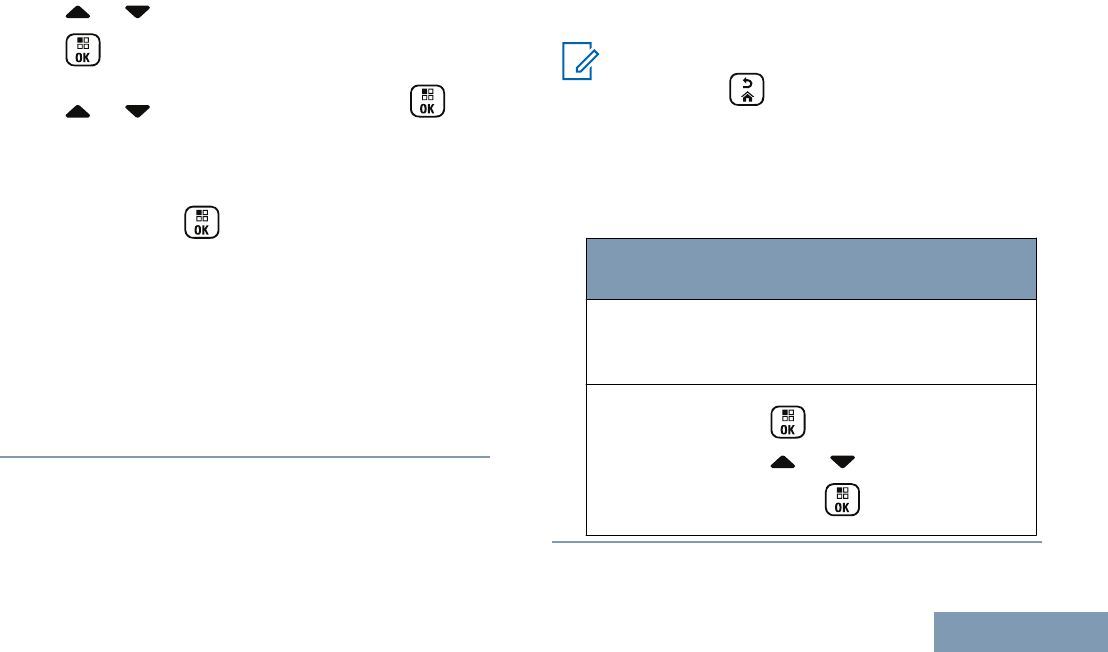
5If you are sending the message, select the
recipient by
• or to the required alias or ID and press
to select.
•
or to Manual Dial, and press to
select. The first line of the display shows Radio
Number:. The second line of the display shows
a blinking cursor. Key in the subscriber alias or
ID and press .
The display shows Text Message:
<Subscriber/Group Alias or ID>, confirming
your message is being sent.
If the message is sent successfully, a tone sounds
and the display shows positive mini notice.
If the message cannot be sent, a low tone sounds
and the display shows negative mini notice.
Managing Sent Text Messages
Once a message is sent to another radio, it is saved
in Sent Items. The most recent sent text message is
always added to the top of the Sent Items list.
The Sent Items folder is capable of storing a
maximum of thirty (30) last sent messages. When the
folder is full, the next sent text message automatically
replaces the oldest text message in the folder.
Note:
Long press at any time to return to the
Home screen.
Viewing a Sent Text Message
1Access the Text Message feature by performing
one of the following actions:
Radio Con-
trols
Steps
Programmed
Text Message
button
Press the programmed Text
Message button.
Menu 1
to access the menu.
2 or to Messages and
press to select.
Advanced Features in Non-Connect Plus Mode
117
English
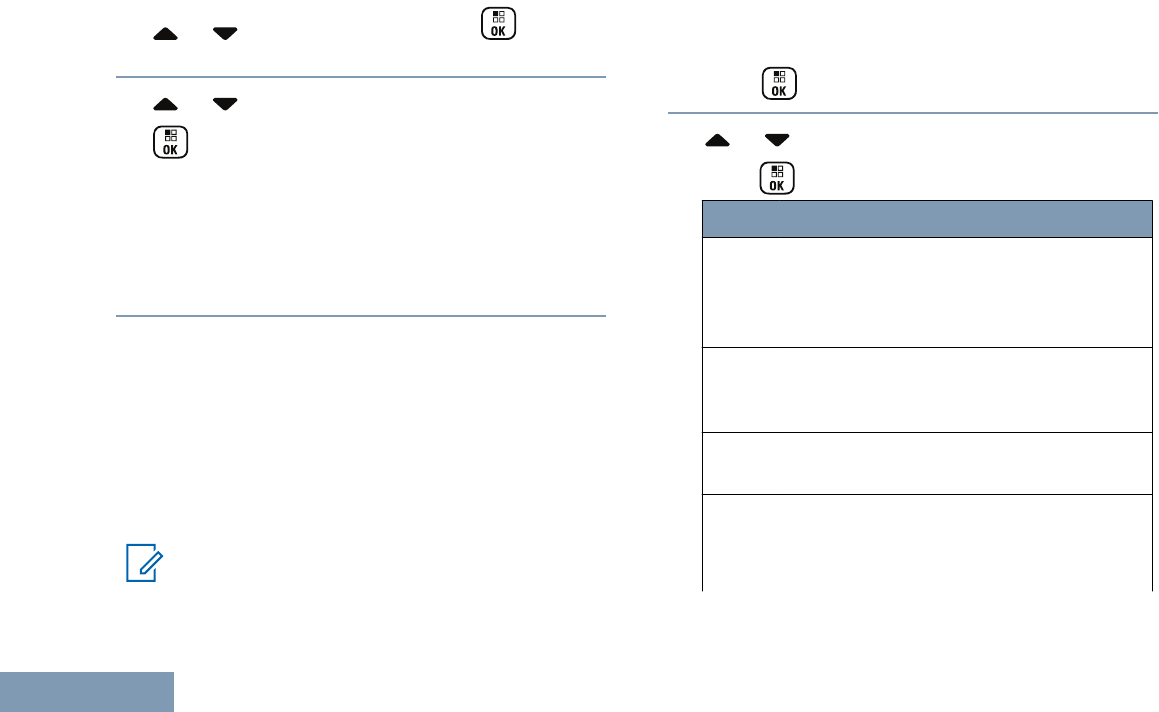
2
or to Sent Items and press to
select.
3 or to the required message and press
to select.
A subject line may be shown if the message is
from an e-mail application.
The icon at the top right corner of the screen
indicates the status of the message (see Sent Item
Icons on page 43).
Sending a Sent Text Message
You can select one of the following options while
viewing a sent text message:
• Resend
• Forward
•Edit
• Delete
Note:
If the channel type (i.e. conventional digital or
Capacity Plus or Linked Capacity Plus) is not
a match, you can only edit, forward, or delete
a Sent message.
1
Press again while viewing the message.
2 or to one of the following options and
press to select.
Option Steps
For‐
ward
Select Forward to send the selected
text message to another subscriber/
group alias or ID (see Forwarding a Text
Message on page 115).
Edit Select Edit to edit the selected text
message before sending it (see Editing
a Text Message on page 116).
De‐
lete
Select Delete to delete the text mes-
sage.
Re‐
send Select Resend to resend the selected
text message to the same subscriber/
group alias or ID.
Advanced Features in Non-Connect Plus Mode
118
English
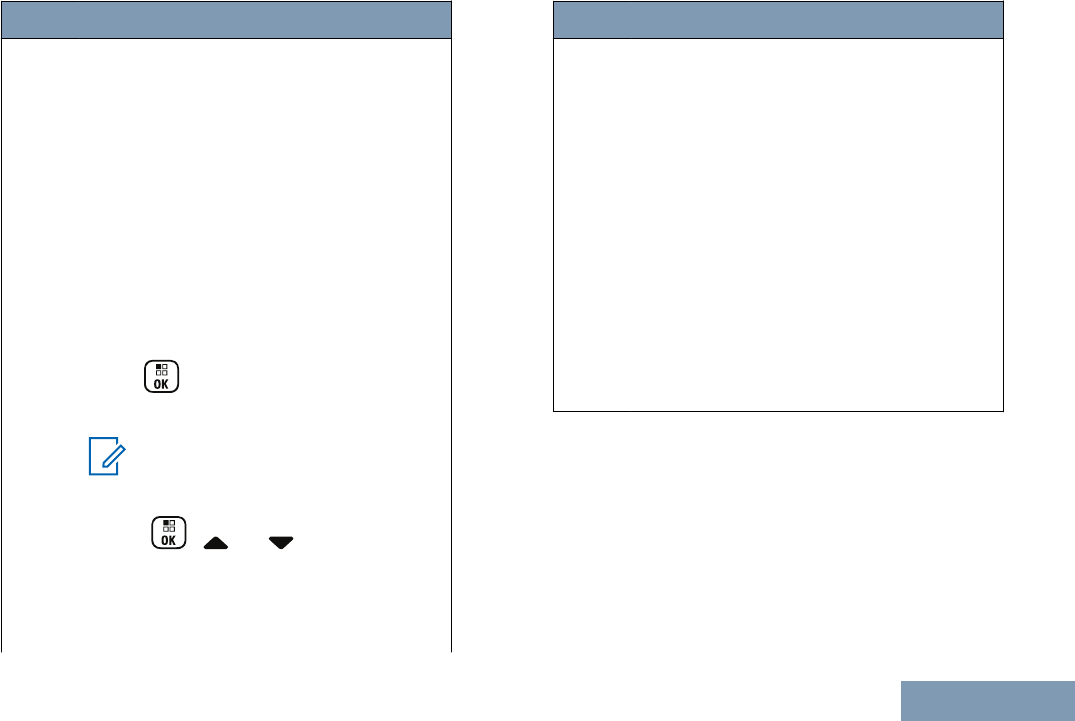
Option Steps
The display shows transitional mini no-
tice, confirming that the same message
is being sent to the same target radio.
If the message is sent successfully, a
tone sounds and the display shows pos-
itive mini notice.
If the message cannot be sent, a low
tone sounds and the display shows neg-
ative mini notice.
If the message fails to send, the radio
returns you to the Resend option screen.
Press to resend the message to
the same subscriber/group alias or ID.
Note:
Changing the volume, and
pressing any button, except for
, , or , returns you to
the message.
The radio exits the Resend op-
tion screen if you press the PTT
Option Steps
button to initiate a Private or
Group Call, or to respond to a
Group Call. The radio also exits
the screen when it receives a
text or telemetry message, an
emergency call or alarm, or a
call alert.
The display returns to the Re‐
send option screen if you press
the PTT button to respond to a
Private Call (except when the
radio is displaying the Missed
Call screen), and at the end of
an All Call.
If you exit the message sending screen while the
message is being sent, the radio updates the
status of the message in the Sent Items folder
without providing any indication in the display or
via sound.
If the radio changes mode or powers down before
the status of the message in Sent Items is
updated, the radio cannot complete any In-
Advanced Features in Non-Connect Plus Mode
119
English
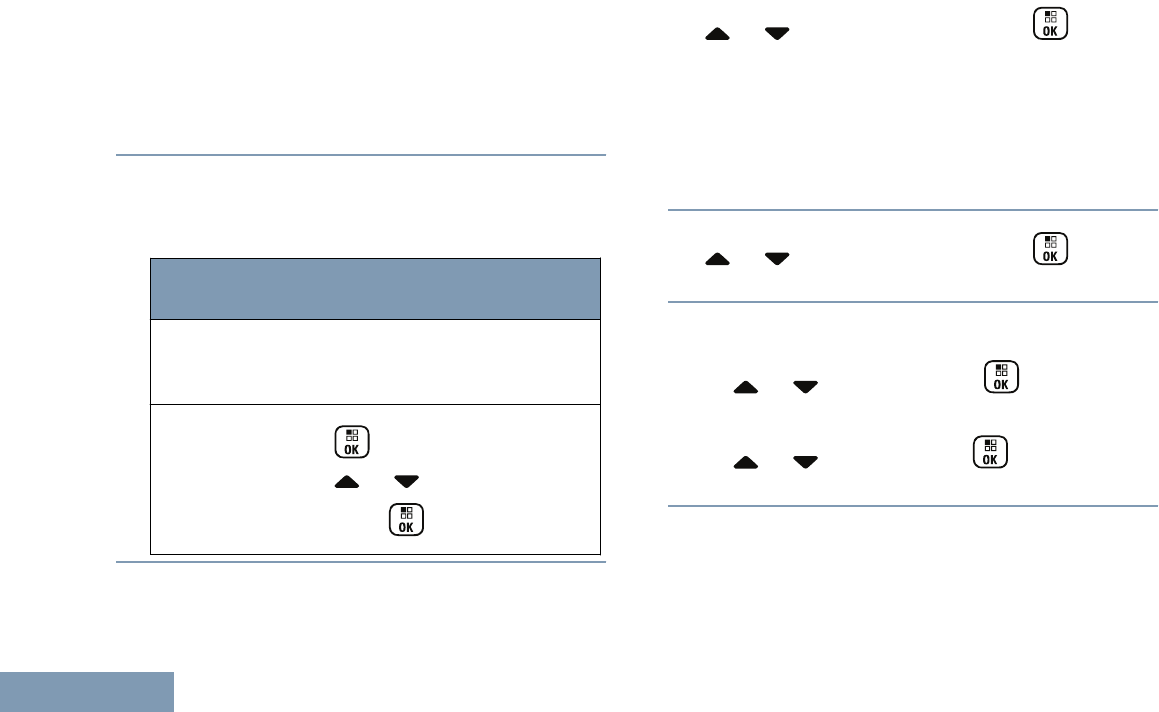
Progress messages and automatically marks it
with a Send Failed icon.
The radio supports a maximum of five (5) In-
Progress messages at one time. During this
period, the radio cannot send any new message
and automatically marks it with a Send Failed icon.
Deleting All Sent Text Messages from Sent Items
1Access the Text Message feature by performing
one of the following actions:
Radio Con-
trols
Steps
Programmed
Text Message
button
Press the programmed Text
Message button.
Menu 1
to access the menu.
2 or to Messages and
press to select.
2
or to Sent Items and press to
select.
When you select Sent Items and it contains no
text messages, the display shows List Empty,
and sounds a low tone if Keypad Tones are turned
on (see Turning Keypad Tones On or Off on page
152).
3
or to Delete All and press to
select.
4Choose one of the following.
•
or to Yes and press to select. The
display shows positive mini notice.
•
or to No and press to return to the
previous screen.
Receiving a Text Message
When your radio receives a message, the display
shows the alias or ID of the sender and the Message
icon.
Advanced Features in Non-Connect Plus Mode
120
English

You can select one of the following options when
receiving a text message:
• Read
• Read Later
•Delete
Note:
The radio exits the Text Message alert screen
and sets up a Private or Group Call to the
sender of the messageif the PTT button is
pressed when the radio is displaying the alert
screen.
Reading a Text Message
1
or to Read? and press to select.
Selected message in the Inbox opens.
A subject line may be shown if the message is
from an e-mail application.
2Do one of the following:
•
Press to return to the Inbox.
•
Press a second time to reply, forward, or
delete the text message.
Managing Received Text Messages
Use the Inbox to manage your text messages. The
Inbox is capable of storing a maximum of 30
messages.
Text messages in the Inbox are sorted according to
the most recently received.
Your radio supports the following options for text
messages:
• Reply
• Forward
• Delete
• Delete All
Note:
If the channel type (i.e. conventional digital or
Capacity Plus or Linked Capacity Plus) is not
a match, you can only forward, delete, or
delete all Received messages.
Advanced Features in Non-Connect Plus Mode
121
English
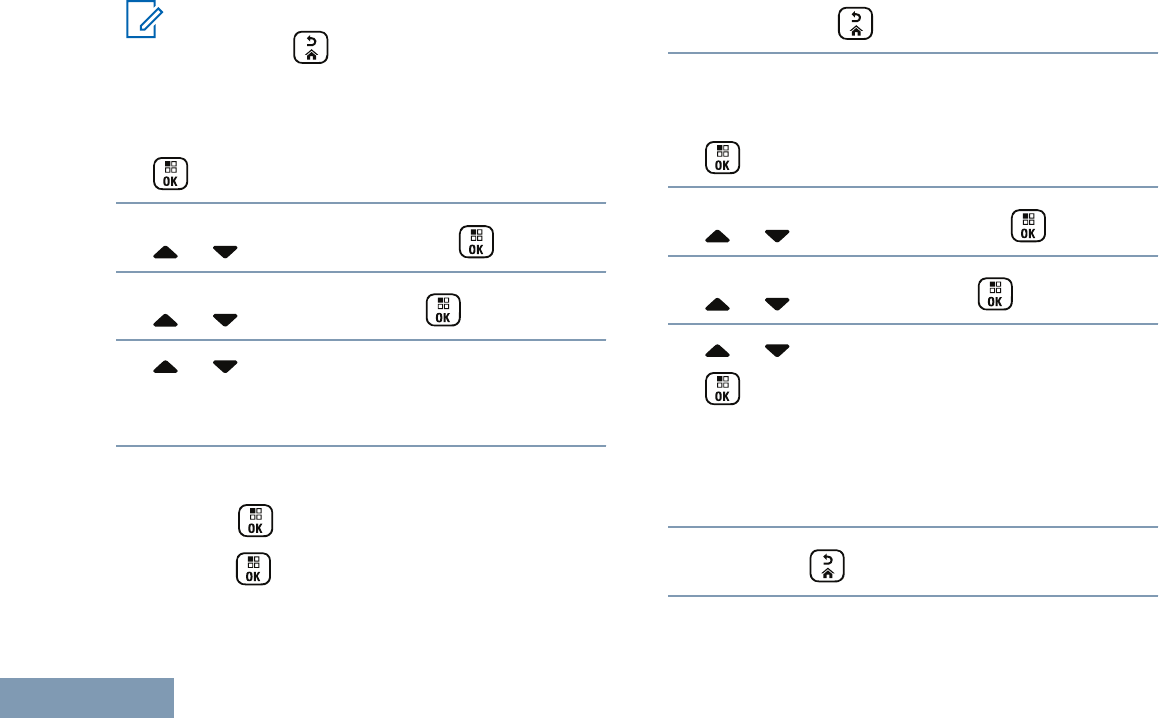
Note:
Long press at any time to return to the
Home screen.
Viewing a Text Message from the Inbox
1
to access the menu.
2
or to Messages and press to select.
3
or to Inbox and press to select.
4 or to view the messages.
A subject line may be shown if the message is
from an e-mail application.
5Do one of the following:
•
Press to select the current message, and
press again to reply, forward, or delete
that message.
•
Long press to return to the Home screen.
Viewing a Telemetry Status Text Message from
the Inbox
1
to access the menu.
2
or to Messages and press to select.
3
or to Inbox and press to select.
4 or to the required message and press
to select.
You cannot reply to a Telemetry Status text
message.
The display shows Telemetry: <Status Text
Message>.
5
Long press to return to the Home screen.
Advanced Features in Non-Connect Plus Mode
122
English
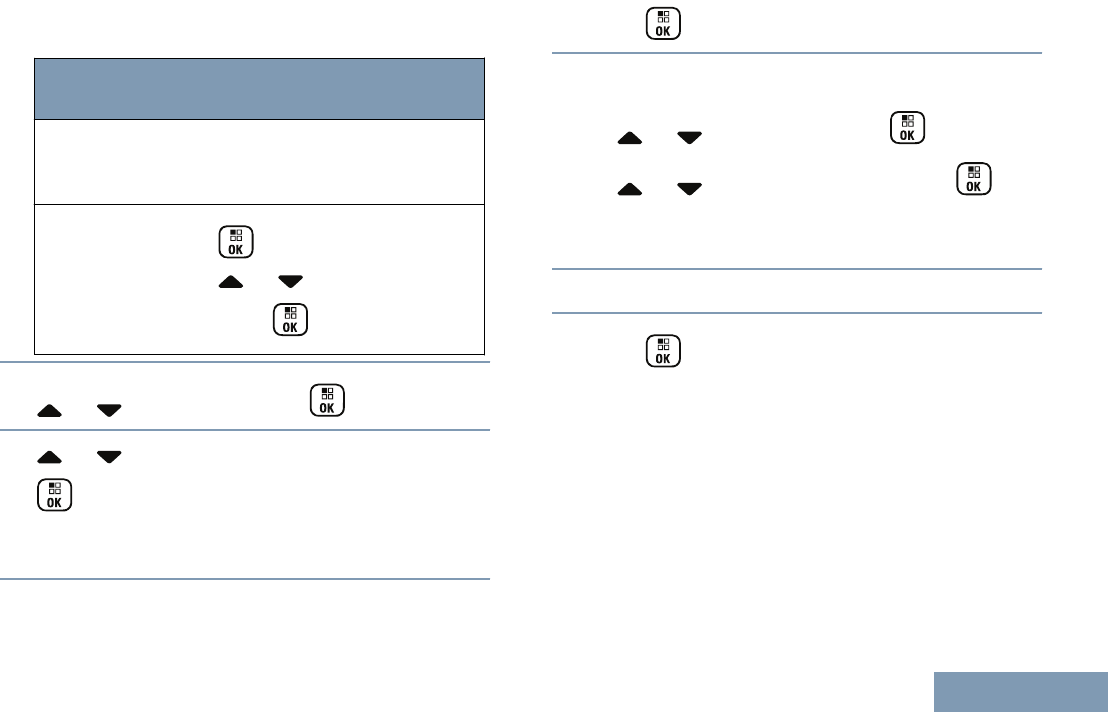
Replying to a Text Message from the Inbox
1Access the Text Message feature.
Radio Con-
trols
Steps
Programmed
Text Message
button
Press the programmed Text
Message button.
Menu 1
to access the menu.
2 or to Messages and
press to select.
2
or to Inbox and press to select.
3 or to the required message and press
to select.
A subject line may be shown if the message is
from an e-mail application.
4
Press once more to access the sub-menu.
5Do one of the following:
•
or to Reply and press to select.
•
or to Quick Reply and press to
select.
A blinking cursor appears.
6Use your keypad to write/edit your message.
7
Press once message is composed.
The display shows transitional mini notice,
confirming your message is being sent.
If the message is sent successfully, a tone sounds
and the display shows positive mini notice.
If the message cannot be sent, a low tone sounds
and the display shows negative mini notice.
Advanced Features in Non-Connect Plus Mode
123
English
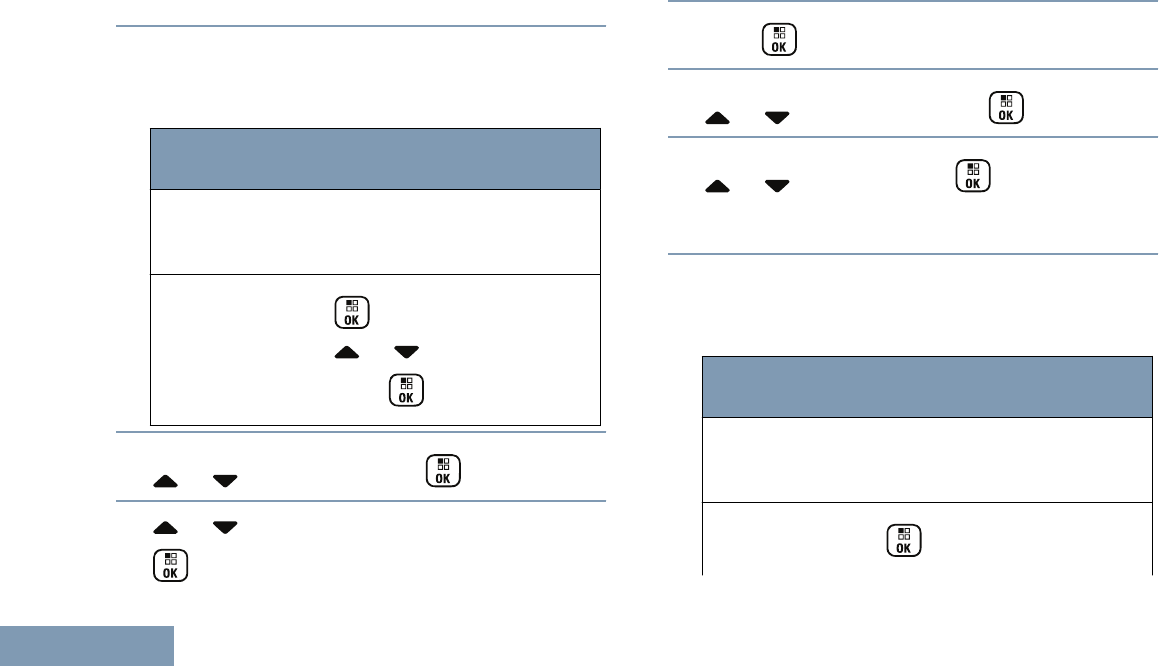
If the message cannot be sent, the radio returns
you to the Resend option screen (see Managing
Fail-to-Send Text Messages on page 115).
Deleting a Text Message from the Inbox
1Access the Text Message feature by performing
one of the following actions:
Radio Con-
trols
Steps
Programmed
Text Message
button
Press the programmed Text
Message button.
Menu 1
to access the menu.
2 or to Messages and
press to select.
2
or to Inbox and press to select.
3 or to the required message and press
to select.
A subject line may be shown if the message is
from an e-mail application.
4
Press once more to access the sub-menu.
5
or to Delete and press to select.
6
or to Yes and press to select.
The display shows positive mini notice and the
screen returns to the Inbox.
Deleting All Text Messages from the Inbox
1Access the Text Message feature by performing
one of the following actions:
Radio Con-
trols
Steps
Programmed
Text Message
button
Press the programmed Text
Message button.
Menu 1
to access the menu.
Advanced Features in Non-Connect Plus Mode
124
English
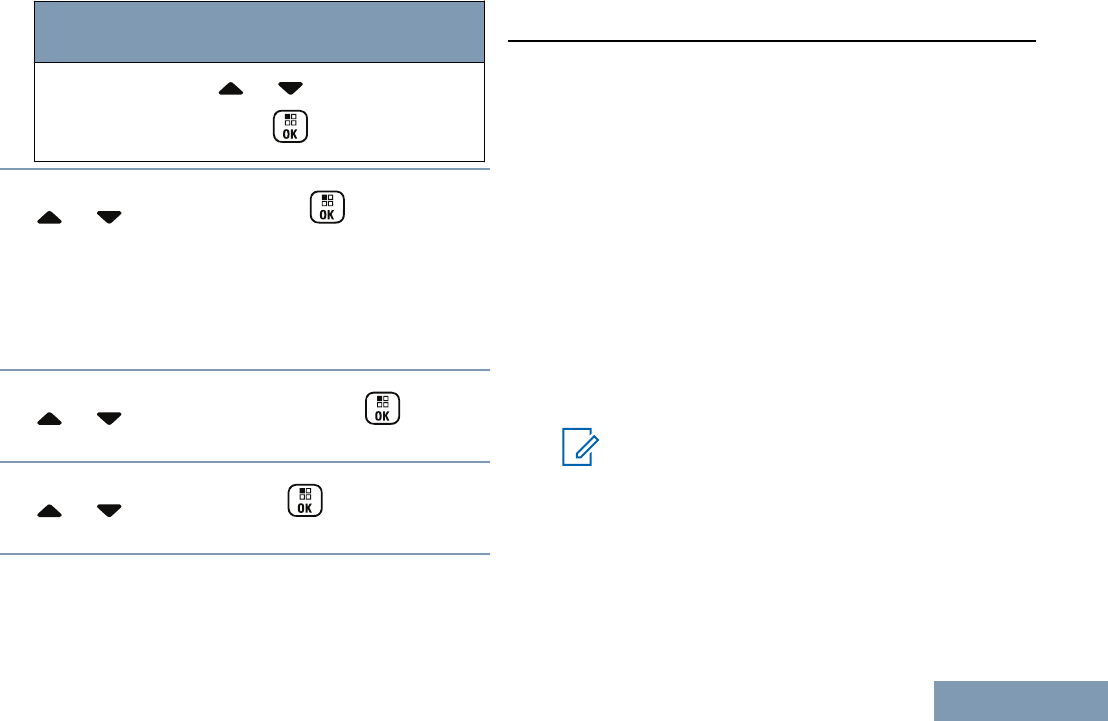
Radio Con-
trols
Steps
2 or to Messages and
press to select.
2
or to Inbox and press to select.
When you select Inbox and it contains no text
messages, the display shows List Empty, and
sounds a low tone if Keypad Tones are turned on
(see Turning Keypad Tones On or Off on page
152).
3
or to Delete All and press to
select.
4
or to Yes and press to select.
The display shows positive mini notice.
Job Tickets
Your radio is able to receive Job Tickets, which are
messages from the dispatcher listing out tasks that
need to be performed.
You can respond to Job Tickets in order to sort them
into Job Ticket Folders. By default, the folders are
“All", "New", "Started", and "Completed". Check with
your dealer or system administrator for an additional
10 folders.
Your radio supports a maximum of 100 Job Tickets,
all of which can be seen in the "All" folder. New Job
Tickets and Job Tickets with recent change in state
are listed first. Upon reaching the maximum number
of Job Tickets, the next Job Ticket automatically
replaces the last Job Ticket in your radio.
Note:
Job Tickets are retained even after radio is
powered down and powered up again.
Your radio will automatically detect and
discard the duplicated Job Tickets with the
same subject line.
Advanced Features in Non-Connect Plus Mode
125
English
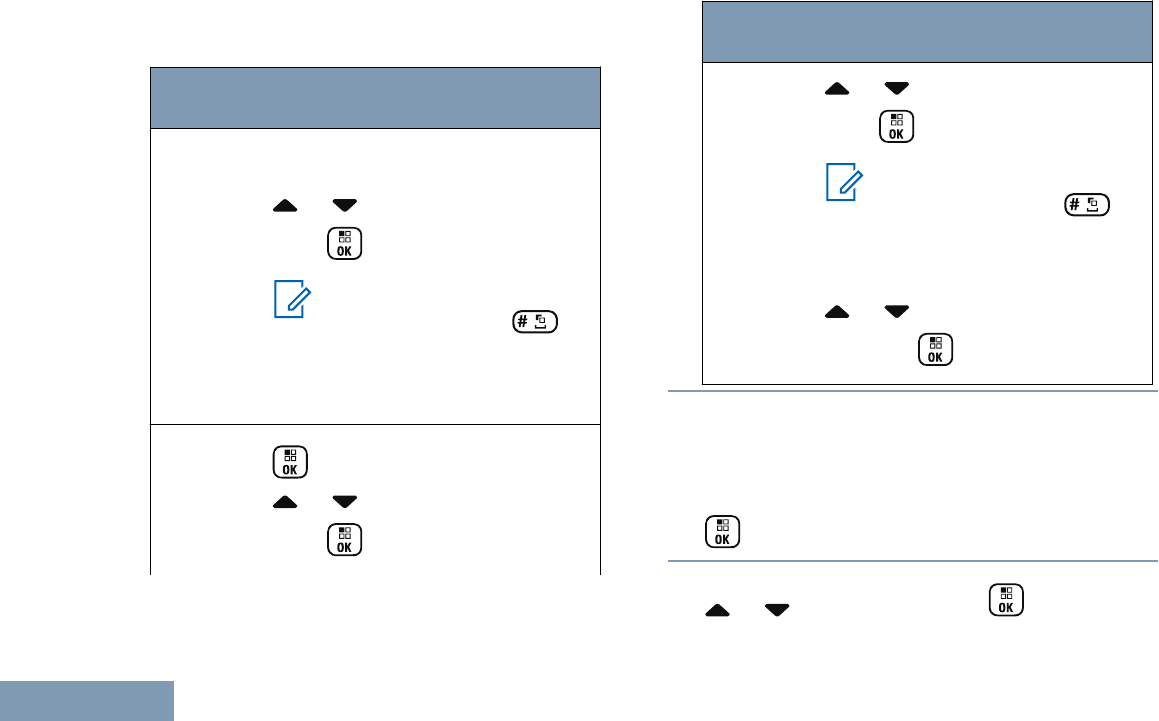
Accessing the Job Ticket Folder
Access the Job Ticket folder.
Radio
Control
Steps
Pro-
gram-
med
Job
Ticket
button
1Press the programmed Job Ticket
button.
2 or to the required folder and
press to select.
Note:
You can also press
and the corresponding num-
ber key (1–9) to access the
required folder.
Menu 1
to access the menu.
2 or to Job Tickets and
press to select.
Radio
Control
Steps
3 or to the required folder and
press to select.
Note:
You can also press
and the corresponding num-
ber key (1–9) to access the
required folder.
4 or to the required Job Ticket
and press to select.
Logging In and Out of the Remote Server
This feature allows you to log in and log out of the
remote server by using your user ID via the menu.
1
to access the menu.
2
or to Log In and press to select.
Advanced Features in Non-Connect Plus Mode
126
English
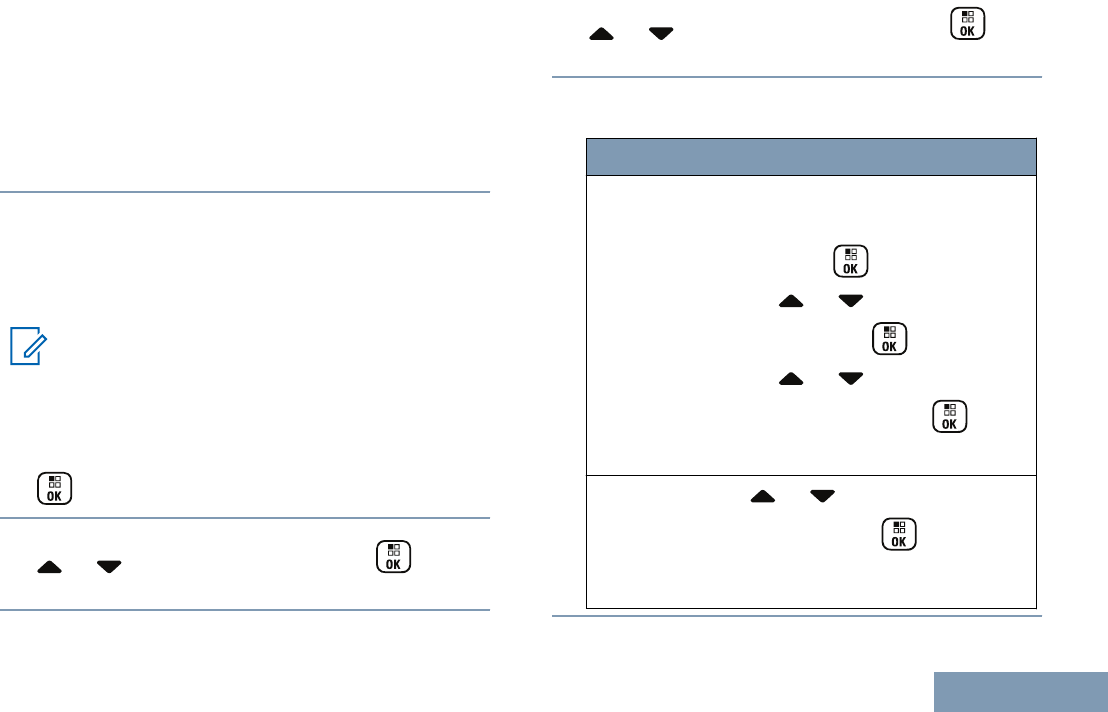
If you are already logged in, menu displays Log
Out.
The display shows a transitional mini notice,
confirming that you have been logged in
successfully.
If you have failed to log in, the display shows a
negative mini notice.
Creating and Sending a Job Ticket
Your radio is able to create Job Tickets, which is
based on a Job Ticket template and send out tasks
that need to be performed.
Note:
CPS is required to configure the Job Ticket
template. Check with your dealer or system
administrator to determine how your radio has
been programmed.
1
to access the menu.
2
or to Job Tickets and press to
select.
3
or to Create Ticket and press to
select.
4Depending on how your radio is configured, do
one of the following:
If Then
If your radio is
configured with
one Job Ticket
template,
1Use the keypad to type the
required room number and
press to select.
2 or to Room Status
and press to select.
3 or to the required
option and press to se-
lect.
If your radio is
configured with
more than one
Job Ticket tem-
plate,
or to the required op-
tion and press to select.
Advanced Features in Non-Connect Plus Mode
127
English
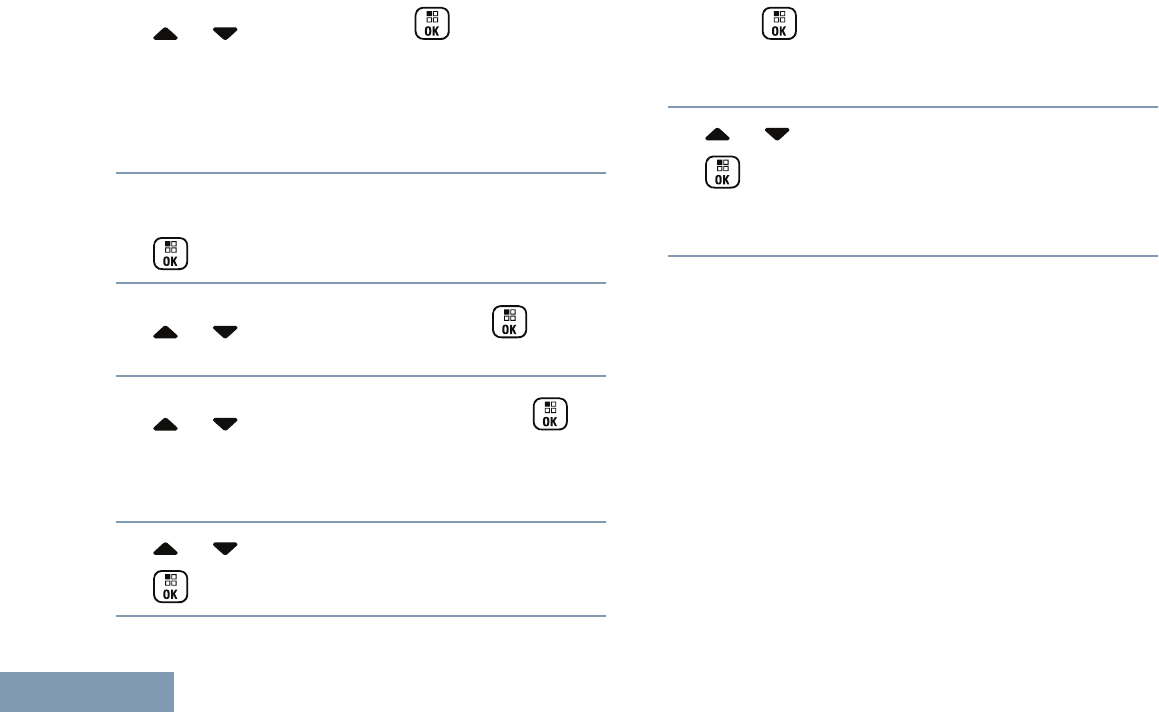
5
or to Send and press to select.
The display shows transitional mini notice,
confirming your message is sent.
If the message is not sent, the display shows
negative mini notice.
Responding to the Job Ticket
1
to access the menu.
2
or to Job Tickets and press to
select.
3
or to the required folder and press to
select.
You can also press the corresponding number key
(1–9) to access the required folder.
4 or to the required Job Ticket and press
to select.
5
Press once more to access the sub-menu.
You can also press the corresponding number key
(1–9) to Quick Reply.
6 or to the required Job Ticket and press
to select.
You can also press the corresponding number key
(1–9) to respond to the job ticket.
The display shows transitional mini notice, confirming
your message being sent.
If the message is sent, a tone sounds and the display
shows positive mini notice.
If the message is not sent, a low tone sounds and the
display shows negative mini notice.
Deleting a Job Ticket
Delete a Job Ticket.
Advanced Features in Non-Connect Plus Mode
128
English
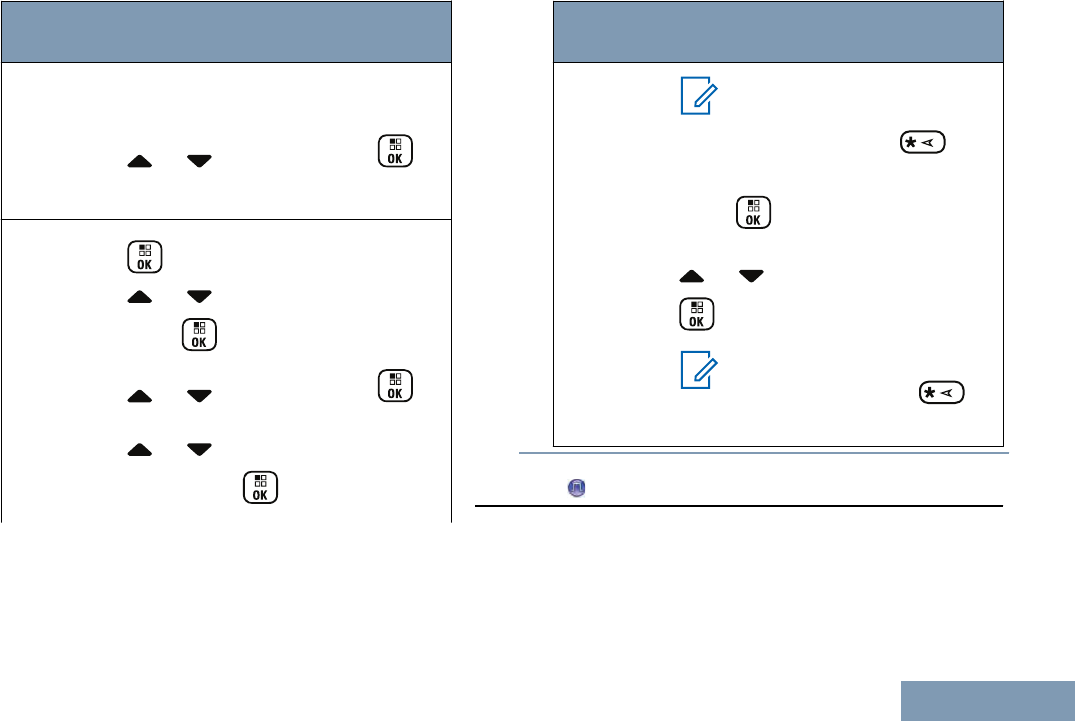
Radio
Control
Steps
Pro-
gram-
med
Job
Ticket
button
1Press the programmed Job Ticket
button.
2
or to All and press to
select.
Menu 1
to access the menu.
2 or to Job Tickets and
press to select.
3
or to All and press to
select.
4 or to the required Job Tick-
et and press to select.
Radio
Control
Steps
Note:
At Step 4, while viewing the
Job Ticket, press to
delete.
5
Press again while viewing the
Job Ticket.
6 or to Delete and press
to select.
Note:
You can also press to
delete.
Privacy
If enabled, this feature helps to prevent
eavesdropping by unauthorized users on a channel
by the use of a software-based scrambling solution.
The signaling and user identification portions of a
transmission are not scrambled.
Advanced Features in Non-Connect Plus Mode
129
English
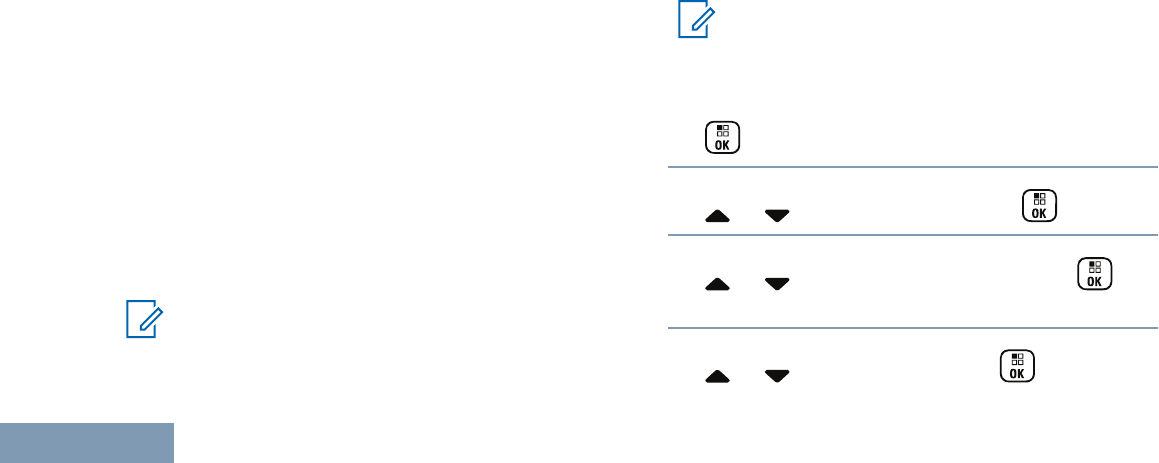
Your radio must have privacy enabled on the channel
to send a privacy-enabled transmission, although this
is not a necessary requirement for receiving a
transmission. While on a privacy-enabled channel,
the radio is still able to receive clear (unscrambled)
transmissions.
Your radio supports two types of privacy:
• Basic Privacy.
• Enhanced Privacy.
Only one of the privacy types above can be assigned
to the radio.
To unscramble a privacy-enabled call or data
transmission, your radio must be programmed to
have the same Privacy Key (for Basic Privacy), or the
same Key Value and Key ID (for Enhanced Privacy)
as the transmitting radio.
If your radio receives a scrambled call that is of a
different Privacy Key, or a different Key Value and
Key ID, you will either hear a garbled transmission
(Basic Privacy) or nothing at all (Enhanced Privacy).
Note:
This feature is not applicable in Citizens Band
channels that are in the same frequency.
The LED lights up solid green while the radio is
transmitting and blinks green rapidly when the radio is
receiving an ongoing privacy-enabled transmission.
You can access this feature by performing one of the
following actions:
• Pressing the programmed Privacy button to
toggle privacy on or off.
• Using the Radio Menu as described by the steps
described next.
Note:
Some radio models may not offer this Privacy
feature. Check with your dealer or system
administrator for more information.
1
to access the menu.
2
or to Utilities and press to select.
3
or to Radio Settings and press to
select.
4
or to Privacy and press to select.
Advanced Features in Non-Connect Plus Mode
130
English
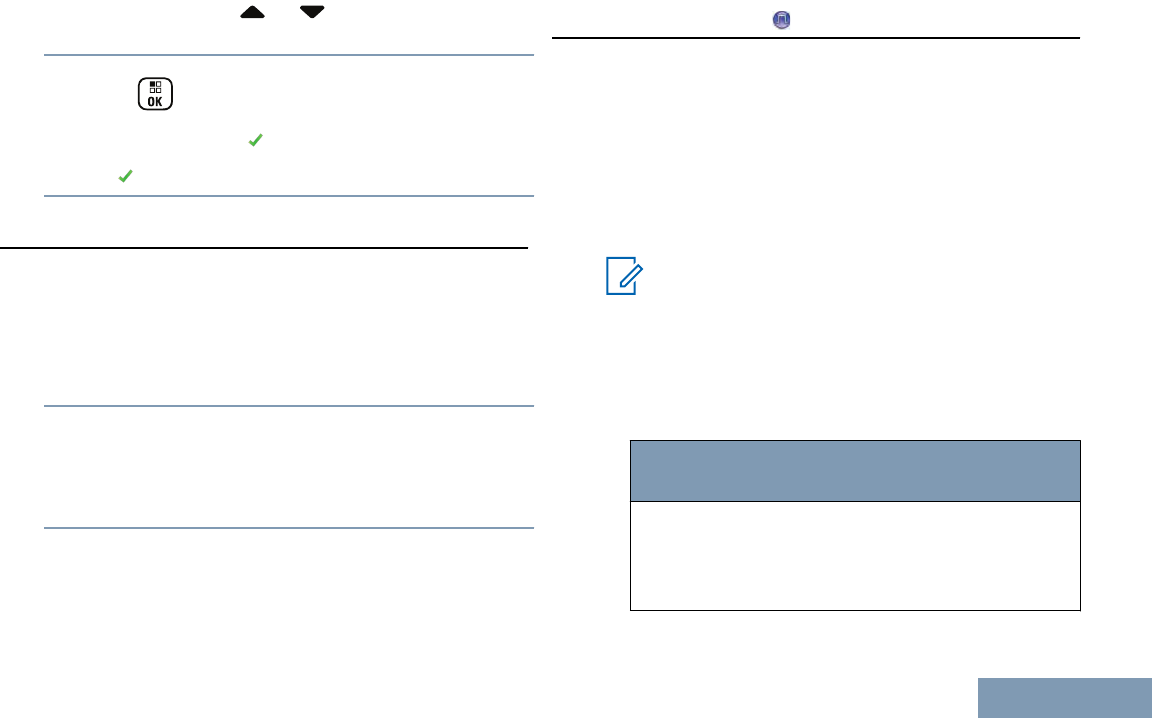
You can also use or to change selected
option.
5
Press to enable/disable Privacy.
The display shows beside Enabled.
The disappears from beside Enabled.
Dual Tone Multi Frequency (DTMF)
The Dual Tone Multi Frequency (DTMF) feature
allows the radio to operate in a radio system with an
interface to telephone systems.
1Press and hold the PTT button to initiate a DTMF
call.
2Enter the desired number, * or #.
You can turn off the DTMF tone by disabling all
radio tones and alerts (see Turning the Radio
Tones/Alerts On or Off on page 157).
Multi-Site Controls
These features are applicable when your current
radio channel is part of an IP Site Connect or Linked
Capacity Plus configuration.
See IP Site Connect on page 47 and Linked Capacity
Plus on page 48 for more details about these
configurations.
Starting an Automatic Site Search
Note:
The radio only scans for a new site if the
current signal is weak or when the radio is
unable to detect any signal from the current
site. If the RSSI value is strong, the radio
remains on the current site.
Start Automatic Site search by
Radio
Controls
Steps
Site
Lock
On/Off
button
Press the programmed Site Lock
On/Off button to toggle the start/stop
automatic site search.
Advanced Features in Non-Connect Plus Mode
131
English
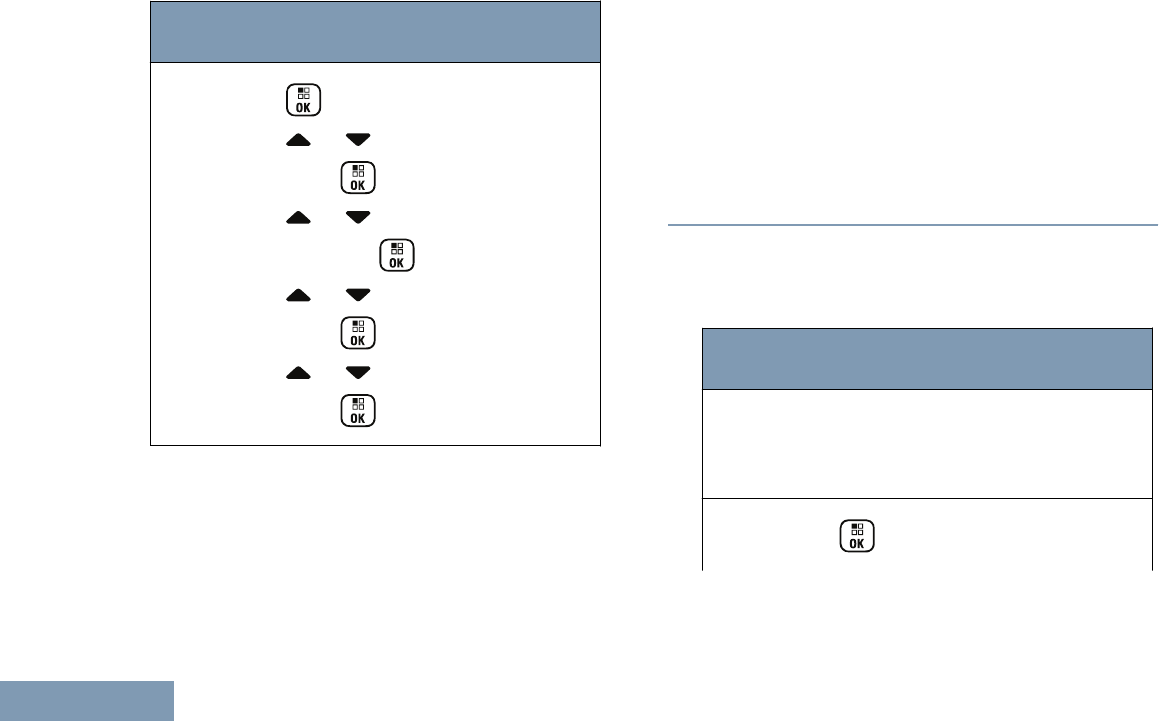
Radio
Controls
Steps
Radio
menu 1
to access the menu.
2 or to Utilities and
press to select.
3 or to Radio Settings
and press to select.
4 or to Site Roaming and
press to select.
5 or to Site Lock and
press to select.
If the current channel is a multi-site channel with
an attached roam list and is out of range, the radio
also performs an automatic site search (site is
unlocked) during:
• a PTT button press.
•data transmission.
A tone sounds and the display shows Site
Unlocked.
The radio then returns to the Home screen. The
display shows the Site Roaming icon and channel
alias.
The LED blinks yellow rapidly when the radio is
actively searching for a new site, and turns off
once the radio locks on to a site.
Stopping an Automatic Site Search
When your radio is actively searching for a new
site, you can stop the search by
Radio
Controls
Steps
Site
Lock
On/Off
button
Press the programmed Site Lock
On/Off button to stop automatic site
search.
Radio
menu 1
to access the menu.
Advanced Features in Non-Connect Plus Mode
132
English
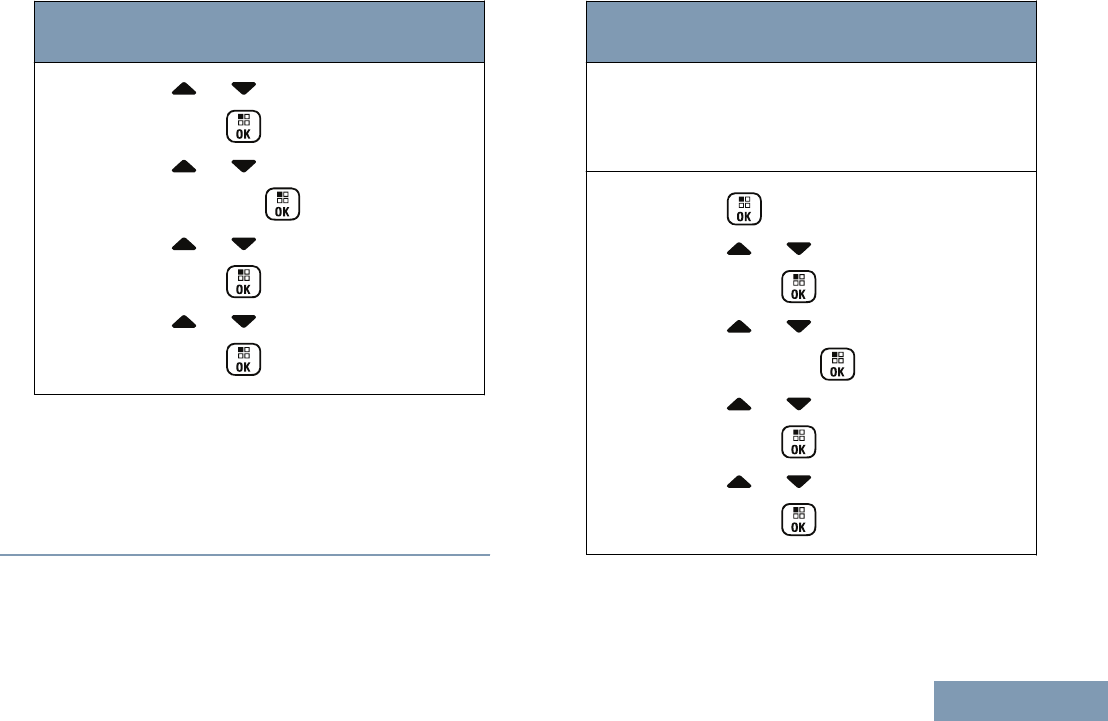
Radio
Controls
Steps
2 or to Utilities and
press to select.
3 or to Radio Settings
and press to select.
4 or to Site Roaming and
press to select.
5 or to Site Lock and
press to select.
A tone sounds and the display shows Site
Locked.
The radio then returns to the Home screen. The
LED turns off and the display shows the channel
alias.
Starting a Manual Site Search
Start a Manual Site Search by
Radio
Controls
Steps
Manual
Site
Roam
button
Press the programmed Manual Site
Roam button to start the manual site
search.
Radio
menu 1
to access the menu.
2 or to Utilities and
press to select.
3 or to Radio Settings
and press to select.
4 or to Site Roaming and
press to select.
5 or to Active Search and
press to select.
A tone sounds, the display shows Finding Site,
and the LED blinks green.
Advanced Features in Non-Connect Plus Mode
133
English
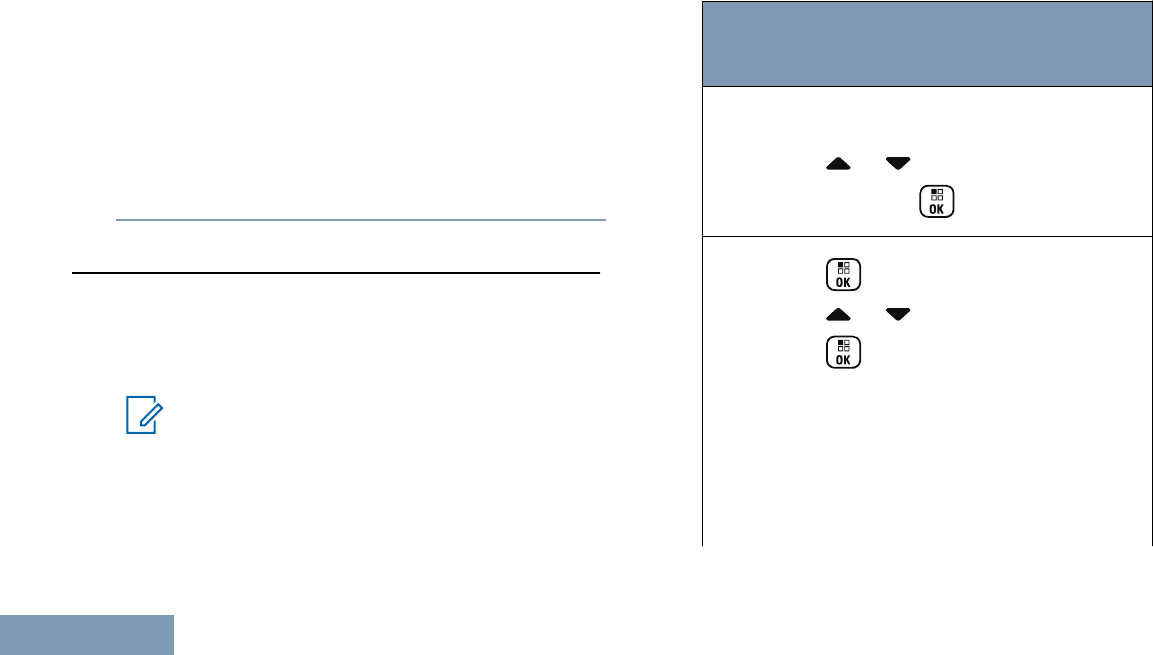
If a new site is found, a tone sounds and the LED
turns off. The display shows Site <Alias>
Found.
If there is no available site within range, a tone
sounds and the LED turns off. The display shows
Out of Range.
If a new site is within range, but the radio is unable
to connect to it, a tone sounds and the LED turns
off. The display shows Channel Busy.
The radio returns to the Home screen.
Security
You can enable or disable any radio in the system.
For example, you might want to disable a stolen
radio, to prevent the thief from using it, and enable
that radio, when it is recovered.
Note:
Performing Radio Disable and Enable is
limited to radios with these functions enabled.
Check with your dealer or system
administrator for more information.
Radio Disable
1Access this feature by
Radio
Con-
trols
Steps
Radio
Disable
button
1Press the programmed Radio Disa-
ble button.
2 or to the required alias or ID
and press to select.
Radio
menu 1
to access the menu.
2 or to Contacts and press
to select. The entries are al-
phabetically sorted.
3Use one of the steps described next
to select the required subscriber
alias or ID:
• Select the required alias or ID di-
rectly.
Advanced Features in Non-Connect Plus Mode
134
English
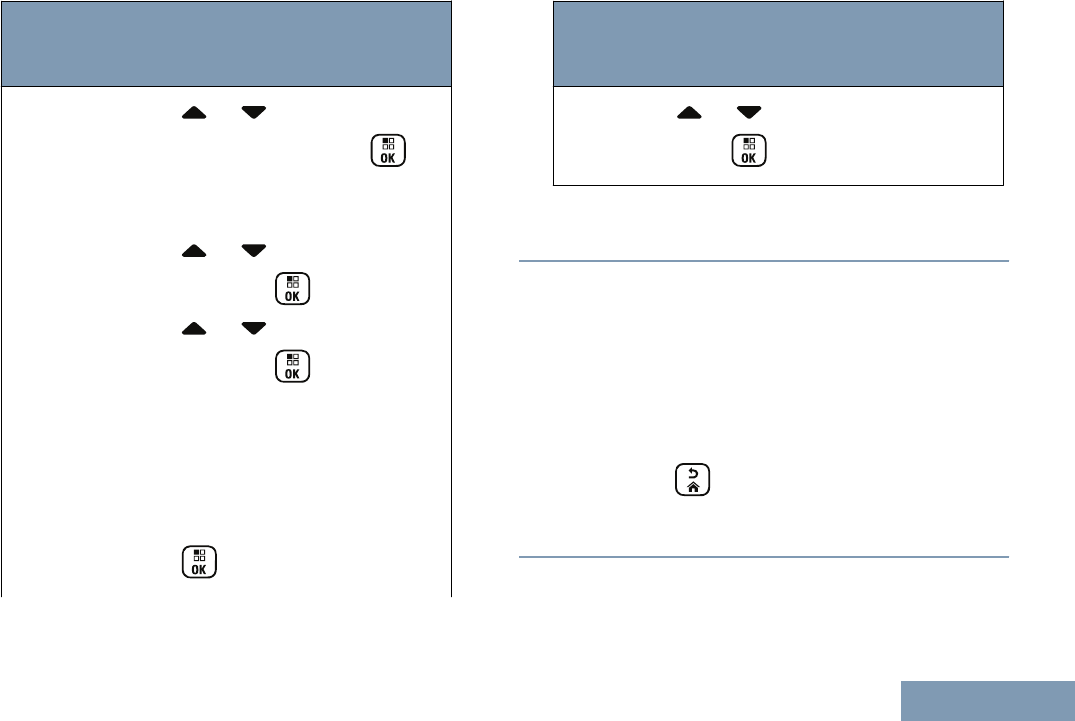
Radio
Con-
trols
Steps
• or to the required
alias or ID and press to
select.
•Use the Manual Dial menu.
• or to Manual Dial
and press to select.
• or to Radio Number
and press to select.
• The first line of the display
shows Radio Number:. The
second line of the display
shows a blinking cursor. Use
the keypad to enter the sub-
scriber alias or ID and press
.
Radio
Con-
trols
Steps
4 or to Radio Disable and
press to select.
The display shows Radio Enable: <Subscriber
Alias or ID> and the LED lights up solid green.
2Wait for acknowledgement.
If successful, the radio sounds a positive indicator
tone and the display shows positive mini notice.
If not successful, the radio sounds a negative
indicator tone and the display shows negative mini
notice.
Do not press during the Radio Disable
operation as you will not get an acknowledgement
message.
Radio Enable
1Access this feature by
Advanced Features in Non-Connect Plus Mode
135
English
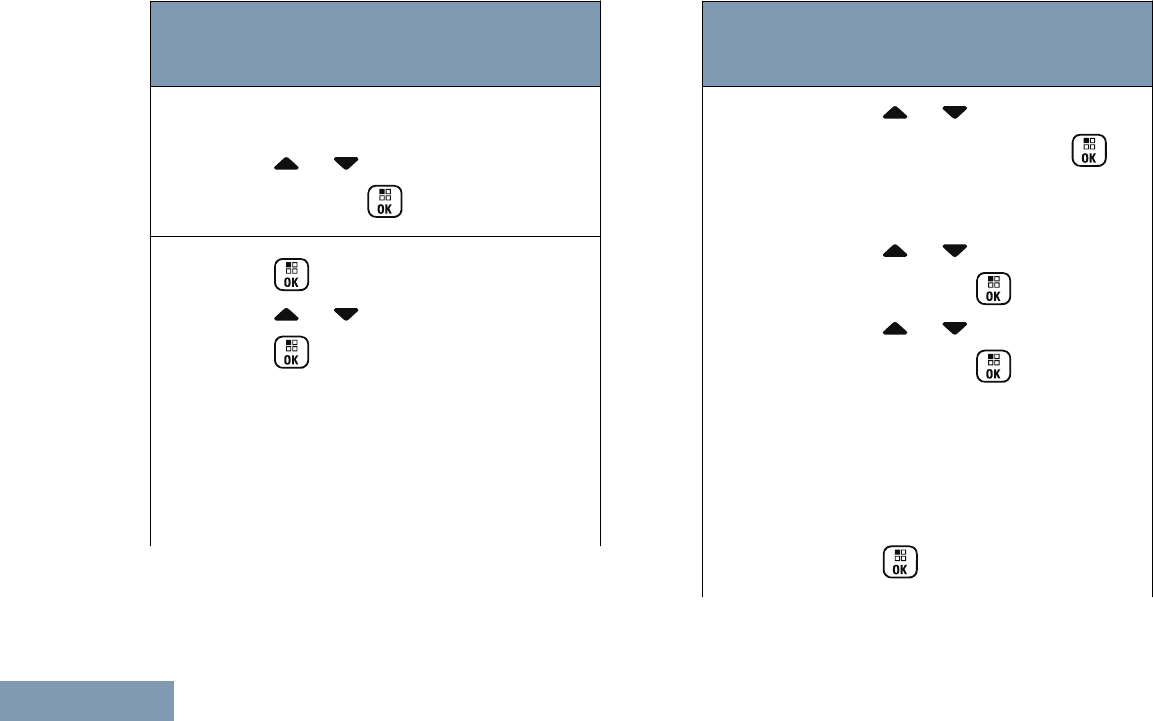
Radio
Con-
trols
Steps
Radio
Enable
button
1Press the programmed Radio Ena-
ble button.
2 or to the required alias or ID
and press to select.
Radio
menu 1
to access the menu.
2 or to Contacts and press
to select. The entries are al-
phabetically sorted.
3Use one of the steps described next
to select the required subscriber
alias or ID
• Select the required alias or ID di-
rectly.
Radio
Con-
trols
Steps
• or to the required
alias or ID and press to
select.
•Use the Manual Dial menu.
• or to Manual Dial
and press to select.
• or to Radio Number
and press to select.
• The first line of the display
shows Radio Number:. The
second line of the display
shows a blinking cursor. Use
the keypad to enter the sub-
scriber alias or ID and press
.
Advanced Features in Non-Connect Plus Mode
136
English
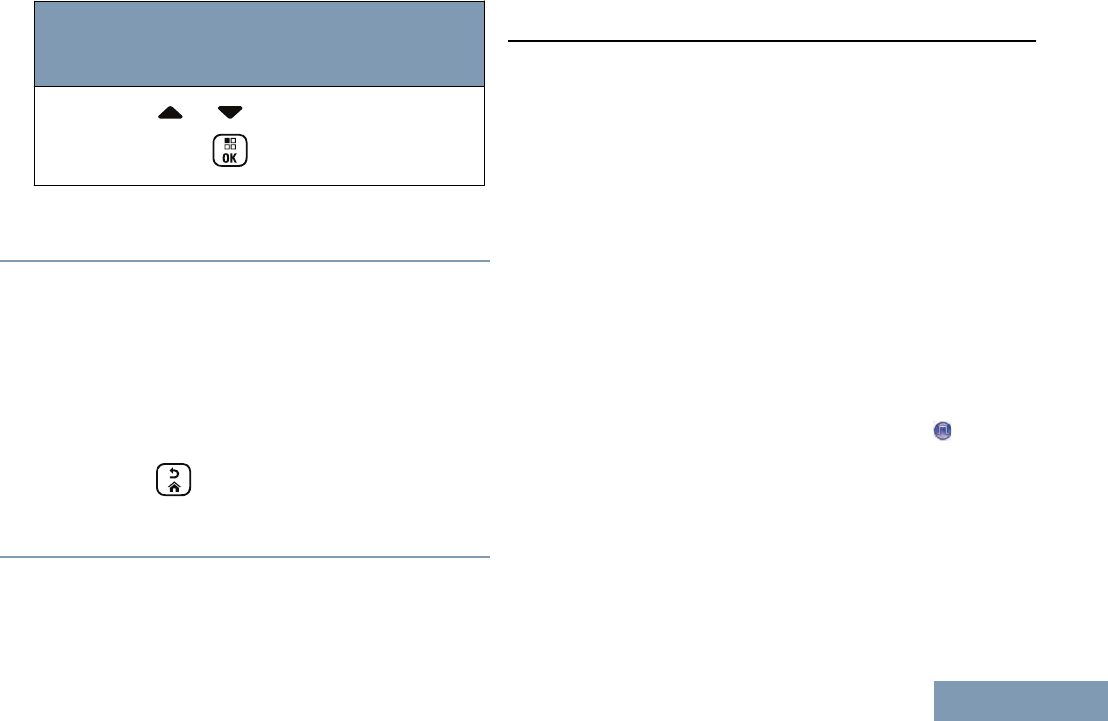
Radio
Con-
trols
Steps
4 or to Radio Enable and
press to select.
The display shows Radio Enable: <Subscriber
Alias or ID> and the LED lights up solid green.
2Wait for acknowledgement.
If successful, the radio sounds a positive indicator
tone and the display shows positive mini notice.
If not successful, the radio sounds a negative
indicator tone and the display shows negative mini
notice.
Do not press during the Radio Enable
operation as you will not get an acknowledgement
message.
Lone Worker
This feature raises an emergency if there is no user
activity, such as any radio button press or activation
of the channel selector, for a predefined time.
Before raising the emergency, when the inactivity
timer expires, the radio warns the user via an audio
indicator.
If there is still no acknowledgement by the user
before the predefined reminder timer expires, the
radio initiates an Emergency Alarm.
Only one of the following Emergency Alarms can be
assigned to this feature:
• Emergency Alarm
• Emergency Alarm with Call
•Emergency Alarm with Voice to Follow
The radio remains in the emergency state allowing
voice messages to proceed until action is taken. See
Emergency Operation on page 103 on ways to exit
Emergency.
Advanced Features in Non-Connect Plus Mode
137
English
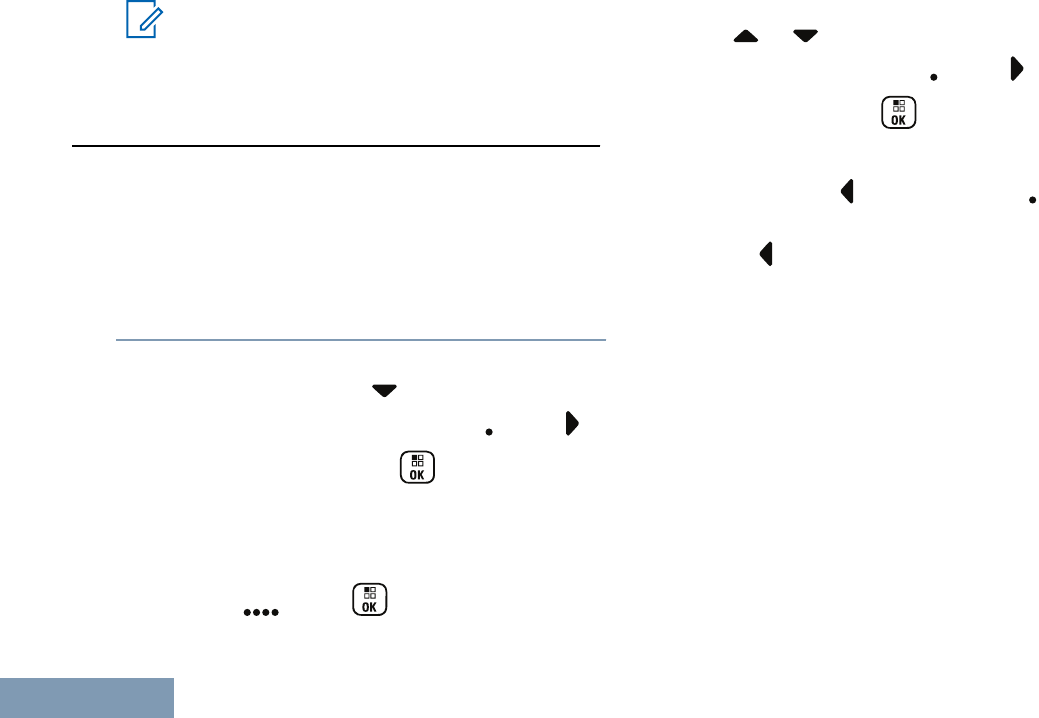
Note:
This feature is limited to radios with this
function enabled. Check with your dealer or
system administrator for more information.
Password Lock Features
If enabled, this feature only allows you access your
radio if the correct password is entered upon
powering up.
Accessing the Radio from Password
1Power up your radio.
You hear a continuous tone.
2Do one of the following: Enter your current four-
digit password. Press or to edit each digit’s
numeric value. Each digit changes to . Press
to move to next digit. Press to confirm your
selection.
• Enter your current four-digit password with the
radio’s keypad. The second line of the display
shows . Press to proceed.
• Enter your current four-digit password. Press
or to edit each digit’s numeric value.
Each digit changes to . Press to move to
next digit. Press to confirm your selection.
You hear a positive indicator tone for every digit
entered. Press to remove the last on the
display. You hear a negative indicator tone, if you
press when the second line of the display is
empty, or if you press more than four digits.
If the password is correct, your radio proceeds to
power up. See Powering Up the Radio on page
27.
If the password is incorrect, the display shows
Wrong Password. Repeat Steps 1 and 2.
After the third incorrect password, the display
shows Wrong Password and then, shows Radio
Locked. A tone sounds and the LED double blinks
yellow.
Your radio enters into locked state for 15 minutes,
and responds to inputs from On/Off/Volume
Advanced Features in Non-Connect Plus Mode
138
English
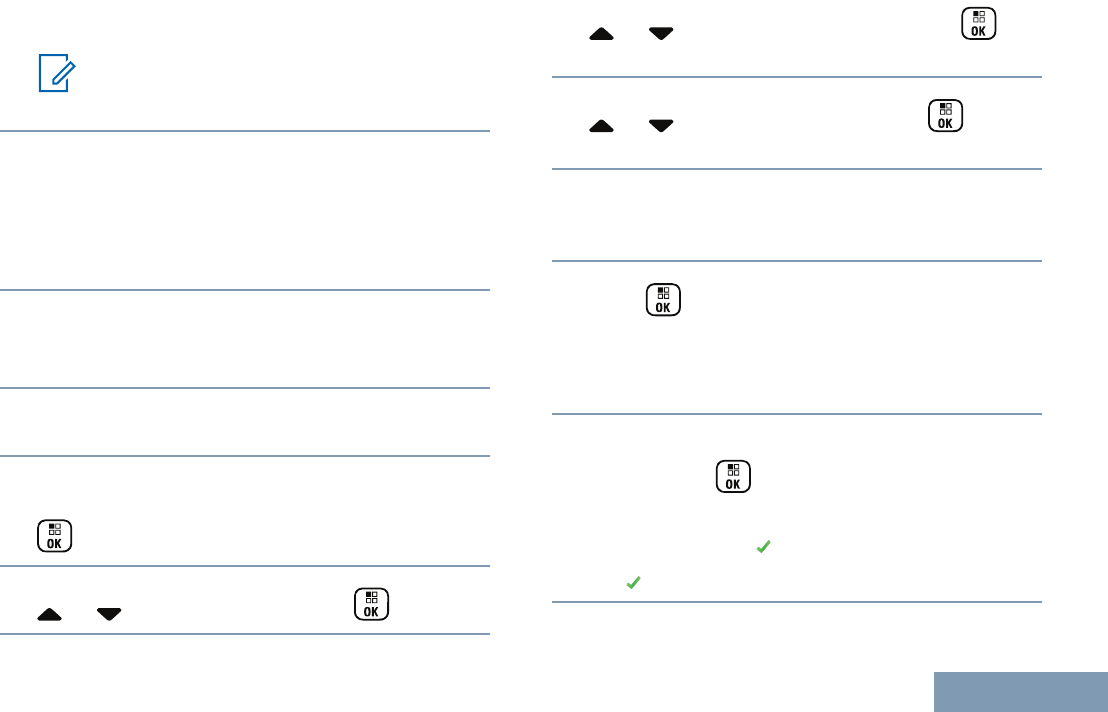
Control Knob and programmed Backlight button
only.
Note:
The radio is unable to receive any call,
including emergency calls, in locked state.
Unlocking the Radio from Locked State
1If your radio was powered down after being in the
locked state, power up the radio.
A tone sounds and the LED double blinks yellow.
The display shows Radio Locked.
2Wait for 15 minutes.
Your radio restarts the 15 minutes timer for locked
state when you power up.
3Repeat Steps 1 and 2 in Accessing the Radio from
Password on page 138.
Turning the Password Lock On or Off
1
to access the menu.
2
or to Utilities and press to select.
3
or to Radio Settings and press to
select.
4
or to Passwd Lock and press to
select.
5Enter the four-digit password.
See Step 2 in Accessing the Radio from Password
on page 138.
6
Press to proceed.
If the password is incorrect, the display shows
Wrong Password, and automatically returns to the
previous menu.
7If the password entered in the previous step is
correct, press to enable/disable password
lock.
The display shows beside Enabled.
The disappears from beside Enabled.
Advanced Features in Non-Connect Plus Mode
139
English
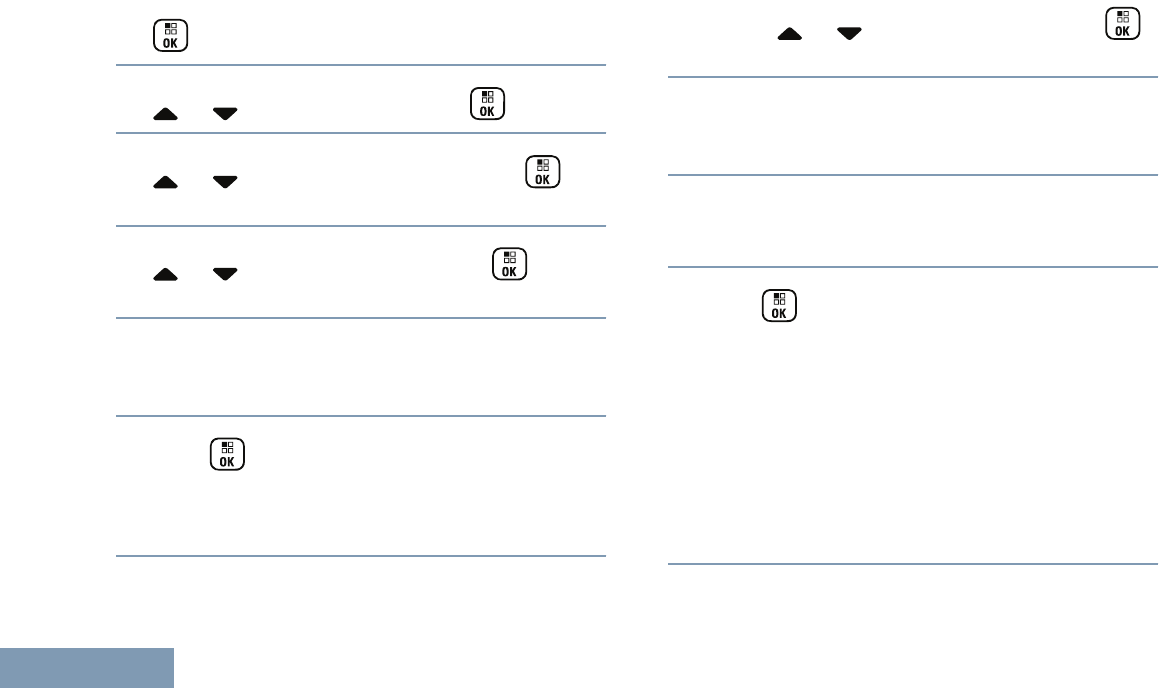
Changing the Password
1
to access the menu.
2
or to Utilities and press to select.
3
or to Radio Settings and press to
select.
4
or to Passwd Lock and press to
select.
5Enter the four-digit password.
See Step 2 in Accessing the Radio from Password
on page 138.
6
Press to proceed.
If the password is incorrect, the display shows
Wrong Password, and automatically returns to the
previous menu.
7If the password entered in the previous step is
correct, or to Change Pwd and press
to select.
8Enter a new four-digit password.
See Step 2 in Accessing the Radio from Password
on page 138.
9Reenter the previously entered four-digit
password. See Step 2 in Accessing the Radio
from Password on page 138.
10
Press to proceed.
If the reentered password matches the new
password entered earlier, the display shows
Password Changed.
If the reentered password does NOT match the
new password entered earlier, the display shows
Passwords Do Not Match.
The screen automatically returns to the previous
menu.
Advanced Features in Non-Connect Plus Mode
140
English
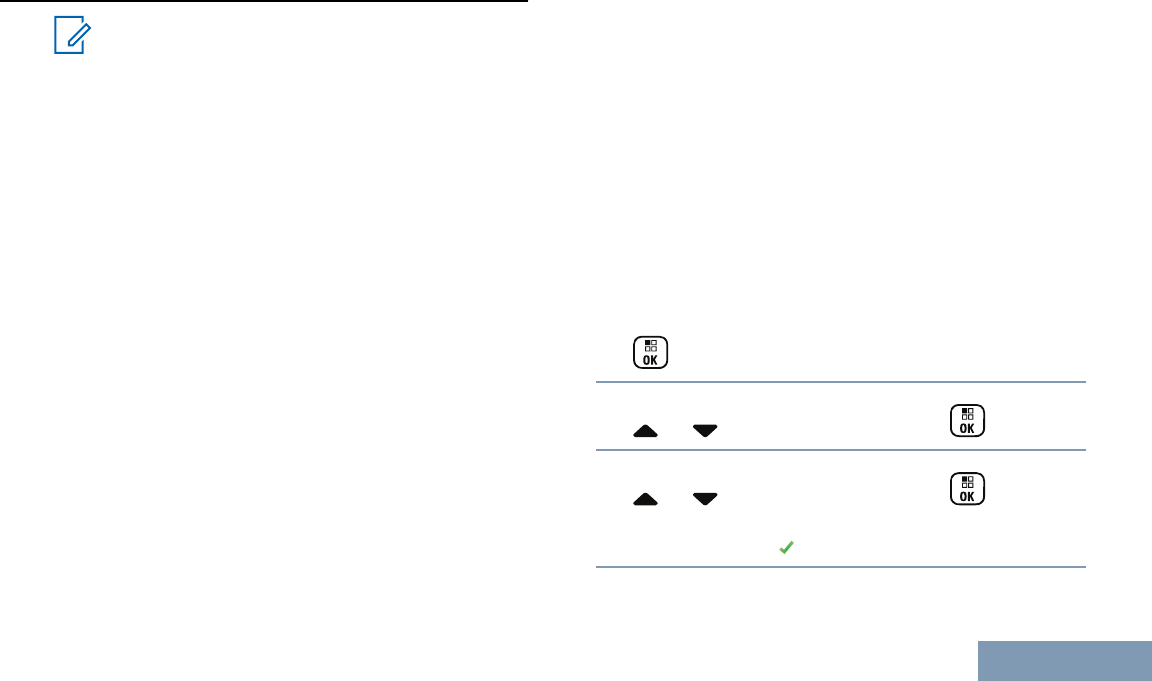
Bluetooth Operation
Note:
If disabled via the CPS, all Bluetooth-related
features are disabled and the Bluetooth device
database is erased.
This feature allows you to use your radio with a
Bluetooth-enabled device (accessory) via a wireless
Bluetooth connection. Your radio supports both
Motorola and COTS (Commercially available Off-The-
Shelf) Bluetooth-enabled devices.
Bluetooth operates within a range of 10 meters (32
feet) line of sight. This is an unobstructed path
between your radio and your Bluetooth-enabled
device.
It is not recommended that you leave your radio
behind and expect your Bluetooth-enabled device to
work with a high degree of reliability when they are
separated.
At the fringe areas of reception, both voice and tone
quality will start to sound “garbled” or “broken”. To
correct this problem, simply position your radio and
Bluetooth-enabled device closer to each other (within
the 10-meter/32 feet defined range) to re-establish
clear audio reception. Your radio’s Bluetooth function
has a maximum power of 2.5 mW (4 dBm) at the 10-
meter/32 feet range.
Your radio can support up to 3 simultaneous
Bluetooth connections with Bluetooth-enabled
devices of unique types. For example, a headset, a
scanner, and a PTT-Only Device (POD). Multiple
connections with Bluetooth-enabled devices of the
same type are not supported.
Refer to your respective Bluetooth-enabled device’s
user manual for more details on your Bluetooth-
enabled device’s full capabilities.
Turning Bluetooth On and Off
1
to access the menu.
2
or to Bluetooth and press to select.
3
or to My Status and press to select.
The display shows On and Off. The current status
is indicated by a .
4Do one of the following:
Advanced Features in Non-Connect Plus Mode
141
English
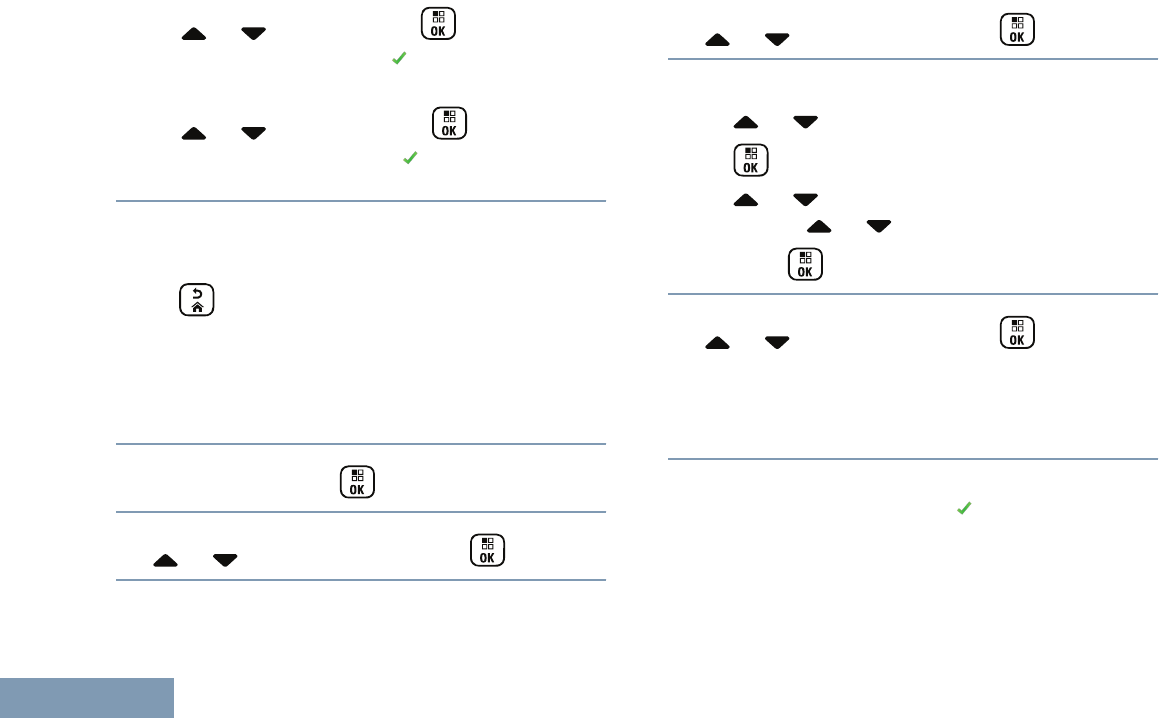
•
or to On and press to select. The
display shows On and a appears left of the
selected status.
•
or to Off and press to select. The
display shows Off and a appears left of the
selected status.
Finding and Connecting to a Bluetooth Device
Do not turn off your Bluetooth-enabled device or
press during the finding and connecting
operation as this cancels the operation.
1Turn on your Bluetooth-enabled device and place
it in pairing mode. Refer to respective Bluetooth-
enabled device’s user manual.
2
On your radio, press to access the menu.
3
or to Bluetooth and press to select.
4
or to Devices and press to select.
5Do one of the following:
• or to the required device and press
to select.
• or to Find Devices to locate available
devices. or to the required device and
press to select.
6
or to Connect and press to select.
Display shows Connecting to <Device>. Your
Bluetooth-enabled device may require additional
steps to complete the pairing. Refer to respective
Bluetooth-enabled device’s user manual.
If successful, the radio display shows <Device>
Connected. A tone sounds and appears besides
the connected device. The Bluetooth Connected icon
appears on the status bar.
If unsuccessful, the radio display shows Connecting
Failed.
Advanced Features in Non-Connect Plus Mode
142
English
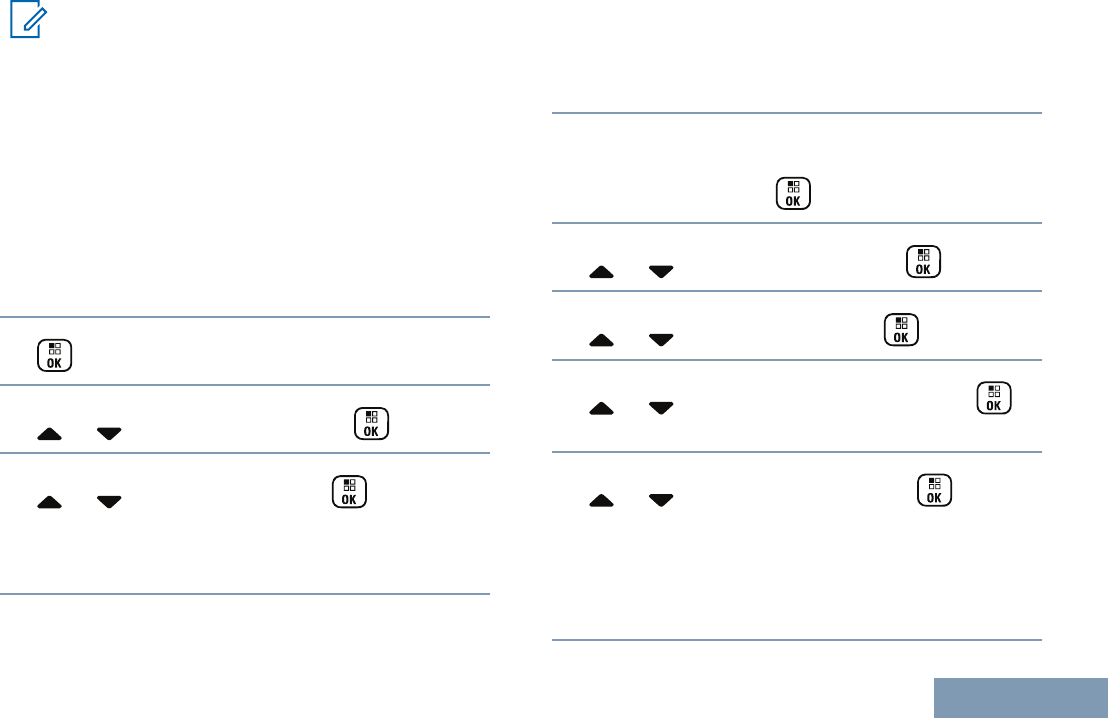
Note:
If pin code is required, use the same entry
method as Step 2 in Accessing the Radio from
Password on page 138.
Finding and Connecting from a Bluetooth Device
(Discoverable Mode)
Do not turn off your Bluetooth or your radio during the
finding and connecting operation as this may cancel
the operation.
1Turn Bluetooth On.
See Turning Bluetooth On and Off on page 141.
2
to access the menu.
3
or to Bluetooth and press to select.
4
or to Find Me and press to select.
Your radio can now be found by other Bluetooth-
enabled devices for a programmed duration. This
is called Discoverable Mode.
5Turn on your Bluetooth-enabled device and pair it
with your radio.
Refer to respective Bluetooth-enabled device’s
user manual.
Disconnecting from a Bluetooth Device
1
On your radio, press to access the menu.
2
or to Bluetooth and press to select.
3
or to Devices and press to select.
4
or to the required device and press
to select.
5
or to Disconnect and press to
select.
Display shows Disconnecting from <Device>.
Your Bluetooth-enabled device may require
additional steps to disconnect. Refer to respective
Bluetooth-enabled device’s user manual.
Advanced Features in Non-Connect Plus Mode
143
English
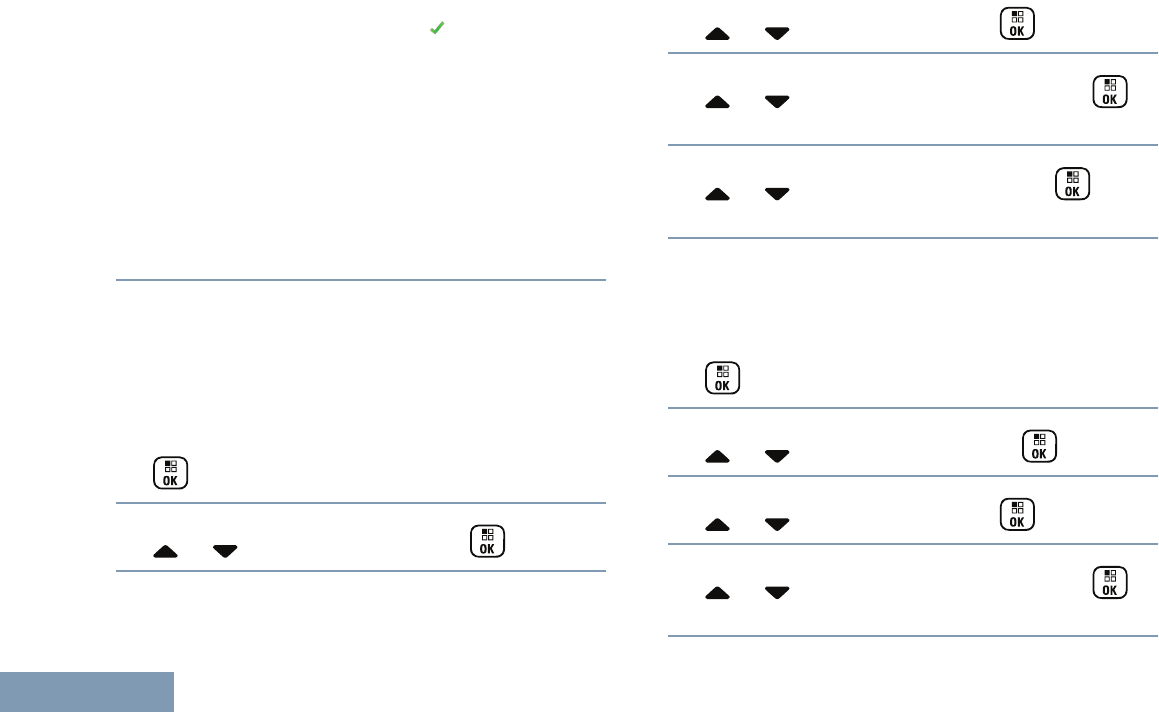
The radio display shows <Device> Disconnected. A
positive indicator tone sounds and disappears
beside the connected device. The Bluetooth
Connected icon disappears on the status bar.
Switching Audio Route between Internal Radio Speaker
and Bluetooth Device
You can toggle audio routing between internal radio
speaker and external Bluetooth-enabled accessory.
Press the programmed Bluetooth Audio Switch
button.
•A tone sounds and display shows Route Audio
to Radio.
•A tone sounds and display shows Route Audio
to Bluetooth.
Viewing Device Details
1
to access the menu.
2
or to Bluetooth and press to select.
3
or to Devices and press to select.
4
or to the required device and press
to select.
5
or to View Details and press to
select.
Editing Device Name
You can edit the name of available Bluetooth-enabled
devices.
1
to access the menu.
2
or to Bluetooth and press to select.
3
or to Devices and press to select.
4
or to the required device and press
to select.
Advanced Features in Non-Connect Plus Mode
144
English
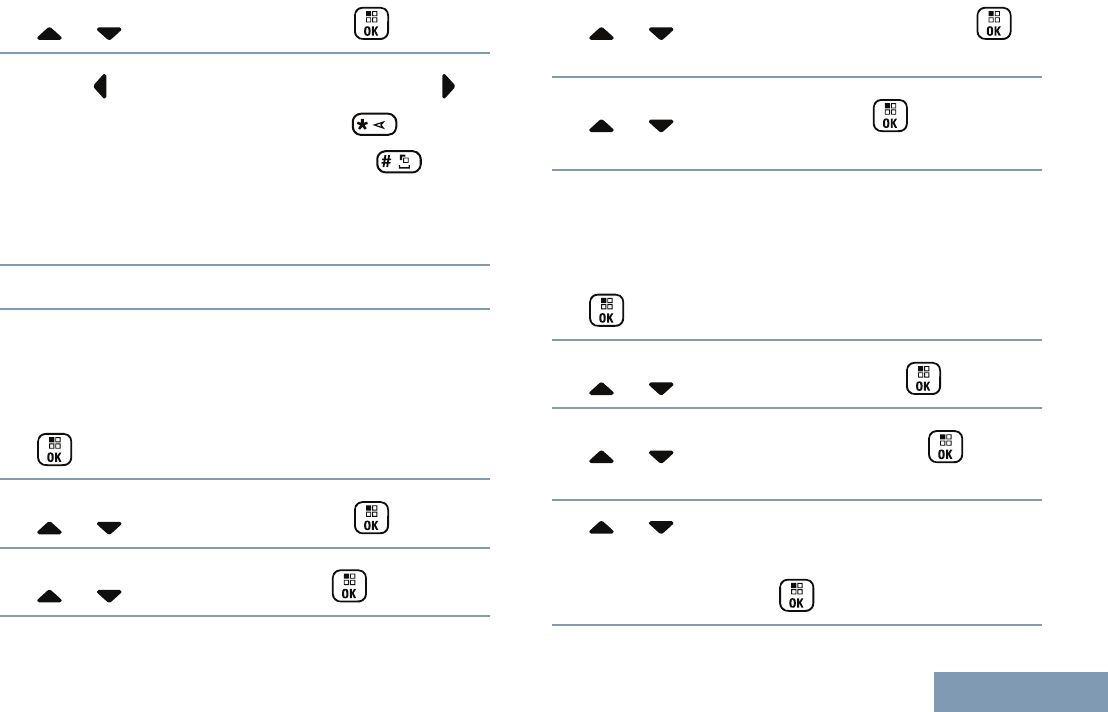
5
or to Edit Name and press to select.
6Press to move one space to the left. Press to
move one space to the right. Press to delete
any unwanted characters. Long press to
change text entry method.
A blinking cursor appears. Use the keypad to type
the required zone.
7The display shows Device Name Saved.
Deleting Device Name
You can remove a disconnected device from the list
of Bluetooth-enabled devices.
1
to access the menu.
2
or to Bluetooth and press to select.
3
or to Devices and press to select.
4
or to the required device and press
to select.
5
or to Delete and press to select.
The display shows Device Deleted.
Bluetooth Mic Gain
Allows control of the connected Bluetooth-enabled
device’s microphone gain value.
1
to access the menu.
2
or to Bluetooth and press to select.
3
or to BT Mic Gain and press to
select.
4 or to the BT Mic Gain type and the current
values.
To edit values, press to select.
Advanced Features in Non-Connect Plus Mode
145
English
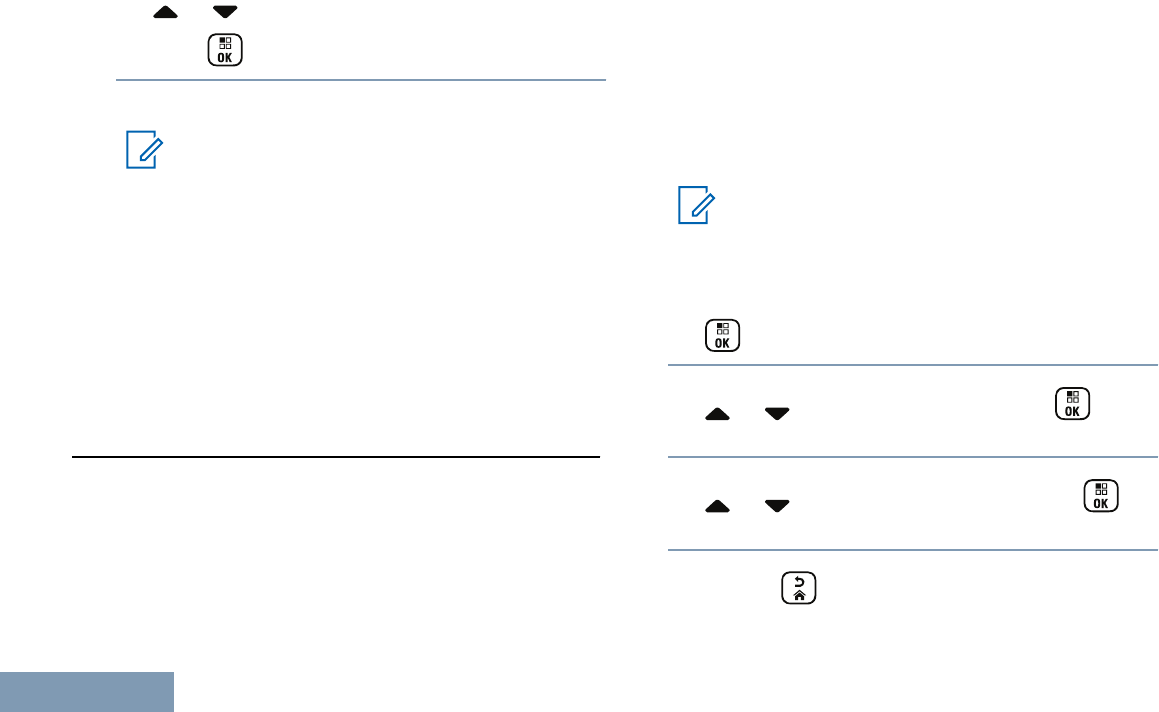
5 or to increase or to decrease values and
press to select.
Permanent Bluetooth Discoverable Mode
Note:
The Permanent Bluetooth Discoverable Mode
can only be enabled via the MOTOTRBO
CPS. If enabled, the Bluetooth item will not
be displayed in the Menu and you will not be
able to use any Bluetooth programmable
button features.
Other Bluetooth-enabled devices can locate your
radio, but the devices cannot connect to the radio. It
enables dedicated devices to use your radio position
in the process of Bluetooth-based location.
Notification List
Your radio has a Notification List that collects all your
“unread” events on the channel, such as unread text
messages, telemetry messages and missed calls.
Unread Job Tickets are also stored in the notification
list.
The Notification icon appears on the status bar when
the Notification List has one or more events.
For TMS and missed call/call alert notification events,
the maximum number are 30 TMS and 10 missed
calls/call alerts. This maximum number depends on
individual feature (job tickets or TMS or missed calls/
call alerts) list capability.
Note:
After the events are read, they are removed
from the Notification List.
Accessing the Notification List
1
to access the menu.
2
or to Notification and press to
select.
3
or to the required event and press to
select.
Long press to return to the Home Screen.
Advanced Features in Non-Connect Plus Mode
146
English

Auto-Range Transponder System (ARTS)
ARTS is an analog-only feature designed to inform
you when your radio is out-of-range of other ARTS-
equipped radios.
ARTS-equipped radios transmit or receive signals
periodically to confirm that they are within range of
each other. Your dealer can program your radio to
transmit or receive the ARTS signal.
Your radio provides indications of states as follows:
•First-Time Alert – A tone sounds and the display
shows In Range after the channel alias.
•ARTS-in-Range Alert – A tone sounds, if
programmed, and the display shows In Range
after the channel alias.
•ARTS-Out-of-Range Alert – A tone sounds, the
LED rapidly blinks red, and the display alternates
between Out of Range and the home screen.
Over-the-Air-Programming (OTAP)
Your radio can be updated by your dealer remotely,
via OTAP, without needing to be physically
connected. Additionally, some settings can also be
configured via OTAP.
While undergoing OTAP, the LED blinks green.
Note:
When the radio is receiving high volume data,
the High Volume Data icon appears and
channel is busy. A PTT button press at this
time may cause a negative tone to sound.
Once the programming is complete, depending on
your radio’s configuration:
•A tone sounds, the display shows Updating
Restarting, and your radio restarts (powers off
and on again).
•Select between Restart Now or Postpone.
Selecting Postpone allows your radio to return to
the previous display, with an OTAP Timer icon
visible, for a period of time before the automatic
restart occurs.
Upon power up after the automatic restart occurs, the
display shows Sw Update Completed if the OTAP
update is successful or Sw Update Failed if the
OTAP update is unsuccessful.
See Software Update on page 184 for your updated
software version.
Advanced Features in Non-Connect Plus Mode
147
English
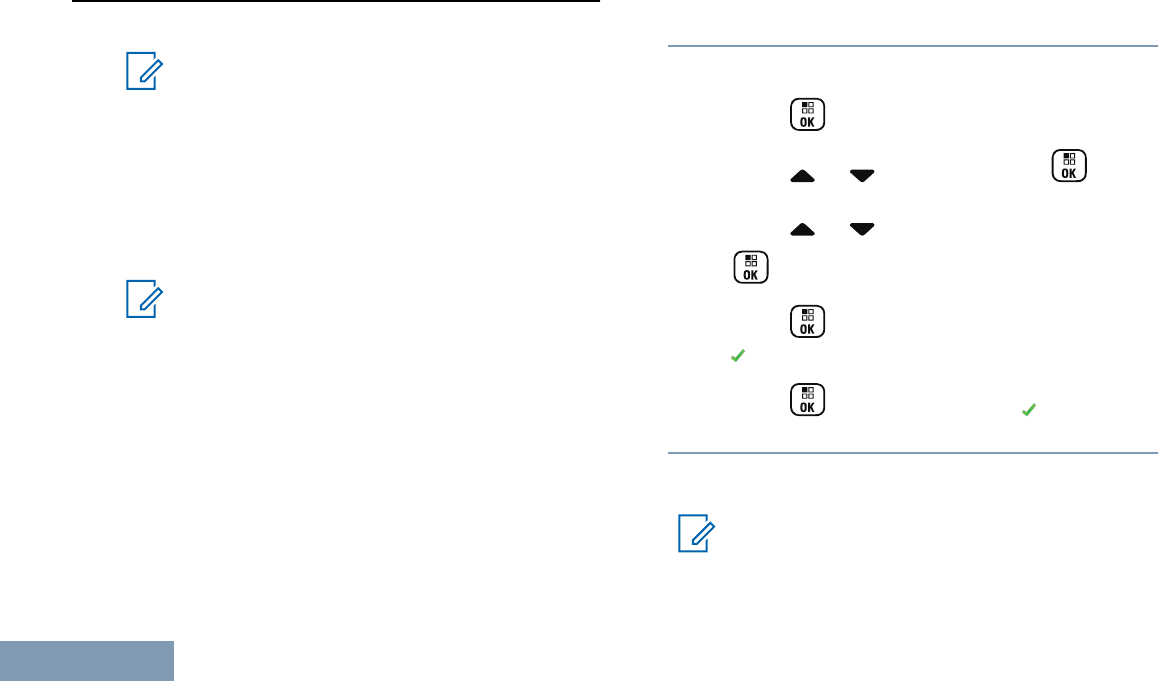
Wi-Fi Operation
Wi-Fi® is a registered trademark of Wi-Fi Alliance®.
Note:
This feature is applicable to XPR 7550e/XPR
7580e only.
This feature allows you to setup and connect to a Wi-
Fi® network. Wi-Fi supports updates for radio
firmware, codeplug, and resources such as language
packs and voice announcement.
Turning Wi-Fi On or Off
Note:
This feature is applicable to XPR 7550e/XPR
7580e only.
The programmed Wi-Fi On or Off button is
assigned via CPS. Check with your dealer or
system administrator to determine how your
radio has been programmed.
You can turn on or turn off Wi-Fi® by performing one
of the following actions.
•Press the programmed Wi-Fi On or Off button.
Voice Announcement sounds Turning On Wi-Fi or
Turning Off Wi-Fi.
•Access this feature via the menu.
a)
Press to access the menu.
b)
Press or to WiFi and press to
select.
c) Press or to WiFi Status and press
to select.
Press to turn on Wi-Fi. The display shows
beside Enabled.
Press to turn off Wi-Fi. The disappears
from beside Enabled.
Connecting to a Network Access Point
Note:
This feature is applicable to XPR 7550e/XPR
7580e only.
Advanced Features in Non-Connect Plus Mode
148
English
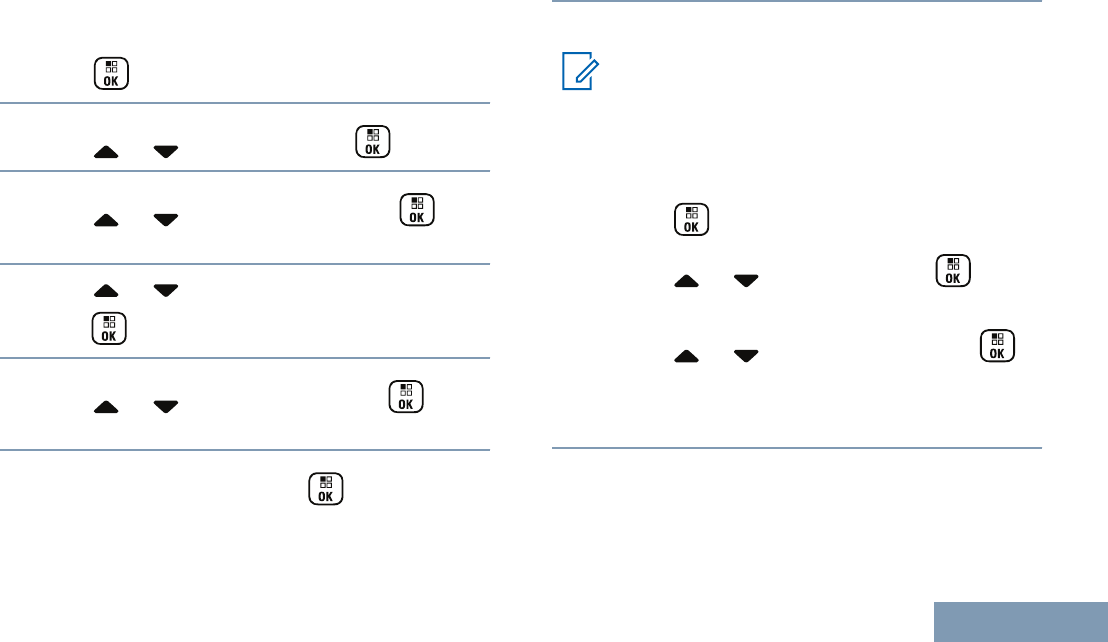
When you turn on Wi-Fi®, the radio scans and
connects to a network access point.
You can also connect to a network access point via
the menu.
1
Press to access the menu.
2
Press or to WiFi and press to select.
3
Press or to Networks and press to
select.
4Press or to a network access point and
press to select.
5
Press or to Connect and press to
select.
6
Enter the password and press .
When the connection is successful, the radio
displays a notice and the network access point is
saved into the profile list.
Refreshing the Network List
Note:
This feature is applicable to XPR 7550e/XPR
7580e only.
•Perform the following actions to refresh the
network list.
a)
Press to access the menu.
b)
Press or to WiFi and press to
select.
c)
Press or to Networks and press
to select.
When you enter the Networks menu, the radio
automatically refreshes the network list.
•If you are already in the Networks menu, perform
the following action to refresh the network list.
Advanced Features in Non-Connect Plus Mode
149
English
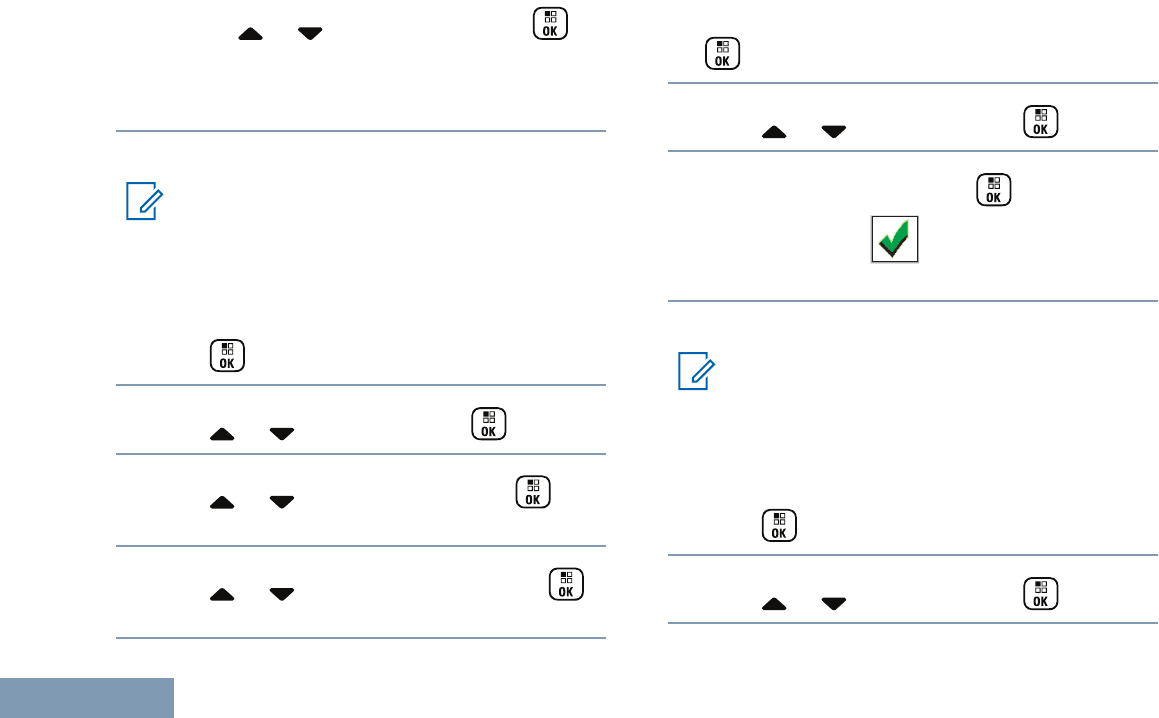
a)
Press or to Refresh and press to
select.
The radio refreshes and displays the latest
network list.
Adding a Network
Note:
This feature is applicable to XPR 7550e/XPR
7580e only.
If a preferred network is not in the available network
list, perform the following actions to add a network.
1
Press to access the menu.
2
Press or to WiFi and press to select.
3
Press or to Networks and press to
select.
4
Press or to Add Network and press
to select.
5Enter the Service Set Identifier (SSID) and press
.
6
Press or to Open and press to select.
7
Enter the password and press .
The radio displays to indicate that the
network is successfully saved.
Viewing Details of Network Access Points
Note:
This feature is applicable to XPR 7550e/XPR
7580e only.
Perform the following actions to view details of
network access points.
1
Press to access the menu.
2
Press or to WiFi and press to select.
Advanced Features in Non-Connect Plus Mode
150
English
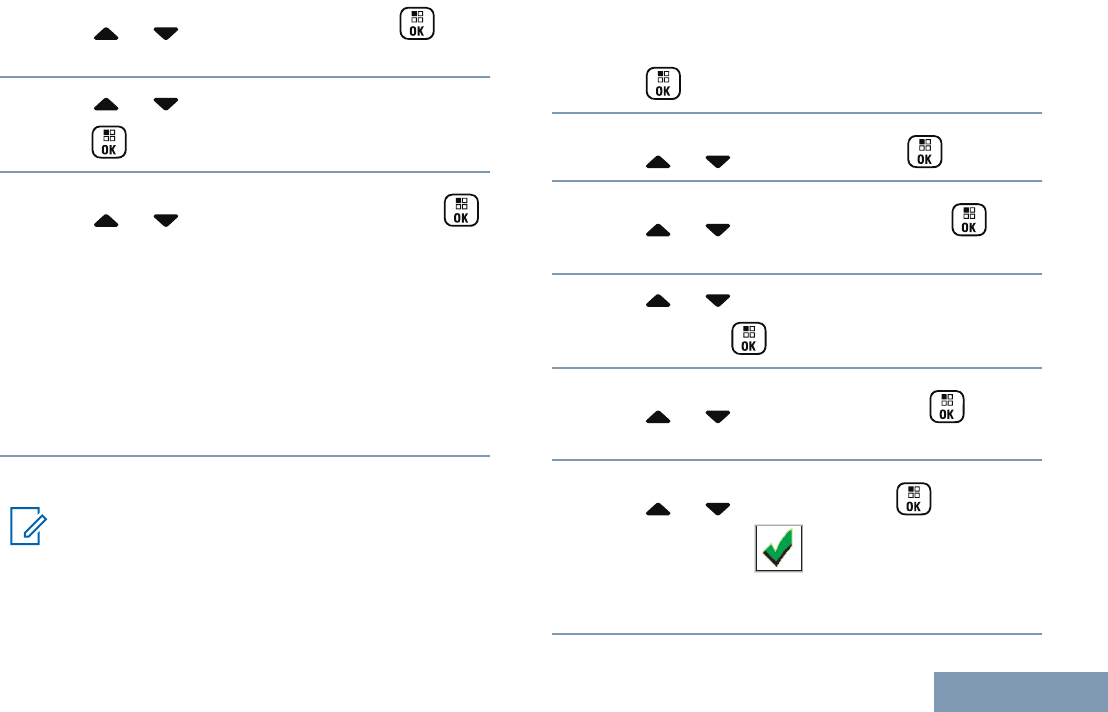
3
Press or to Networks and press to
select.
4Press or to a network access point and
press to select.
5
Press or to View Details and press
to select.
For a connected network access point, the Service
Set Identifier (SSID), Security Mode, Media
Access Control (MAC) address, and Internet
Protocol (IP) address are displayed.
For a non-connected network access point, the
Service Set Identifier (SSID) and Security Mode
are displayed.
Removing Network Access Points
Note:
This feature is applicable to XPR 7550e/XPR
7580e only. Enterprise network access points
that are added via CPS can only be removed
via CPS.
Perform the following actions to remove network
access points from the profile list.
1
Press to access the menu.
2
Press or to WiFi and press to select.
3
Press or to Networks and press to
select.
4Press or to the selected network access
point and press to select.
5
Press or to Remove and press to
select.
6
Press or to Yes and press to select.
The radio displays to indicate that the
selected network access point is successfully
removed.
Advanced Features in Non-Connect Plus Mode
151
English
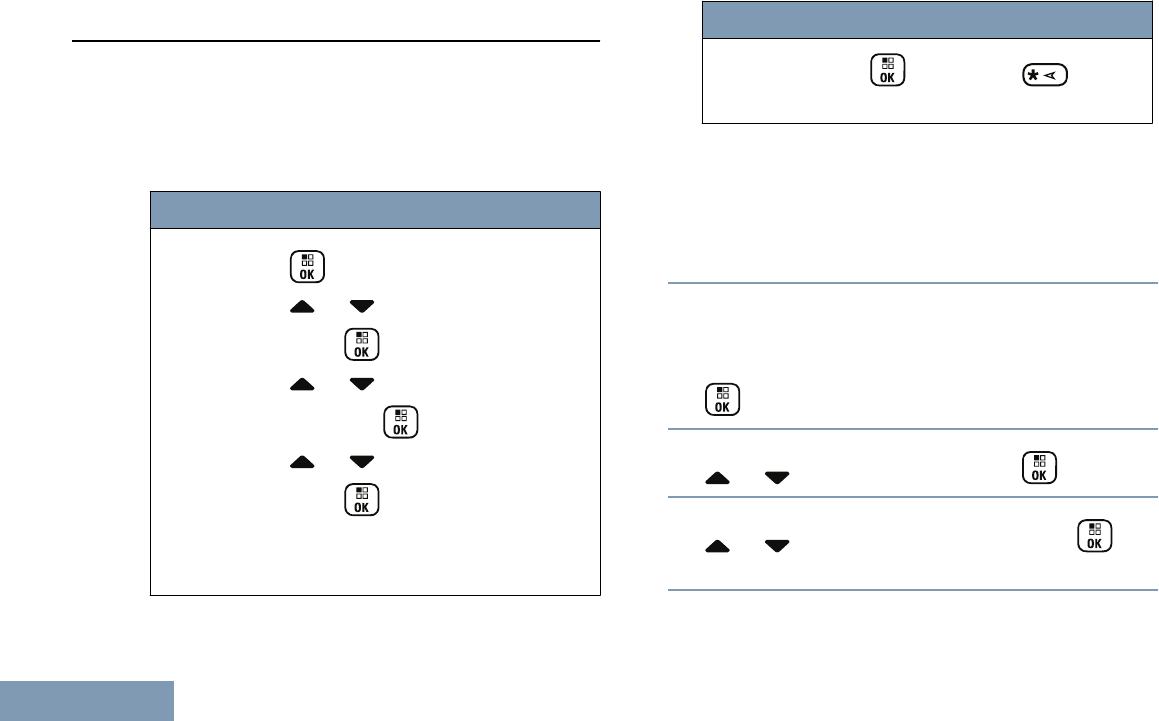
Utilities
Locking and Unlocking the Keypad
You can lock your radio’s keypad to avoid inadvertent
key entry.
To lock/unlock your radio’s keypad.
Option Steps
Locking
the Key-
pad
1
to access the menu.
2 or to Utilities and
press to select.
3 or to Radio Settings
and press to select.
4 or to Keypad Lock and
press to select.
You can also use or to change the
selected option.
Option Steps
Unlocking
the Key-
pad
Press followed by .
After the keypad is locked, the display shows
Keypad Locked and returns to the Home screen.
After the keypad is unlocked, the display shows
Keypad Unlocked and returns to the Home
screen.
Turning Keypad Tones On or Off
You can enable and disable keypad tones if needed.
1
to access the menu.
2
or to Utilities and press to select.
3
or to Radio Settings and press to
select.
Advanced Features in Non-Connect Plus Mode
152
English
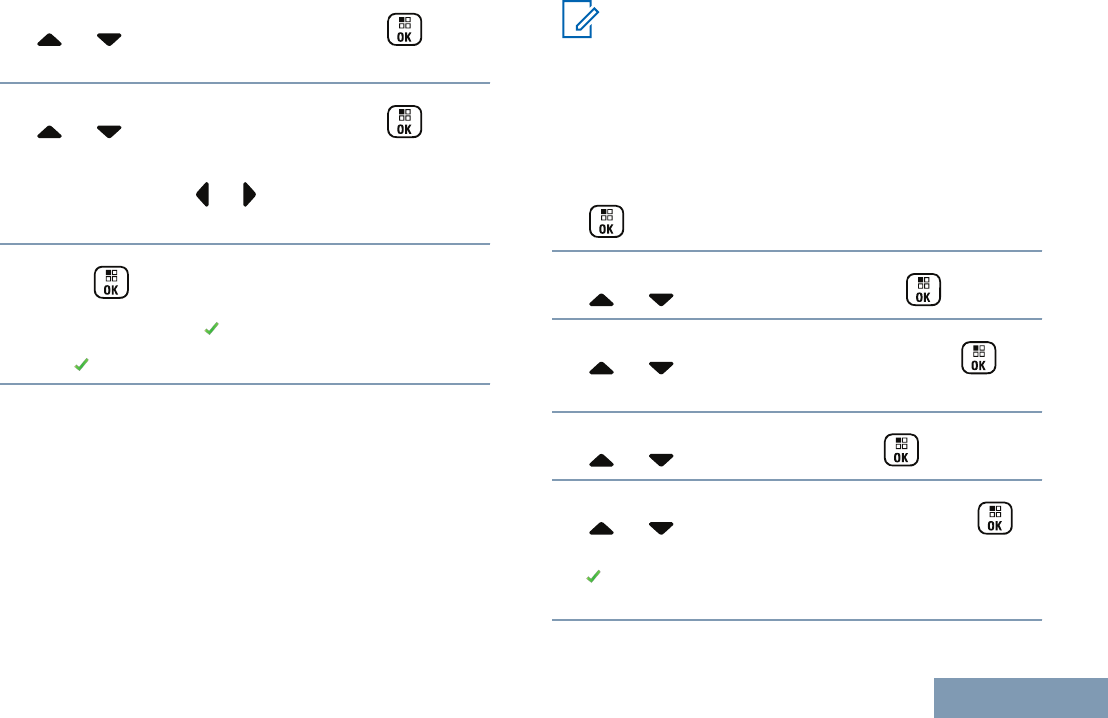
4
or to Tones/Alerts and press to
select.
5
or to Keypad Tones and press to
select.
You can also use or to change the selected
option.
6
Press to enable/disable keypad tones.
The display shows beside Enabled.
The disappears from beside Enabled.
Setting the Squelch Level
You can adjust your radio's squelch level to filter out
unwanted calls with low signal strength or channels
that have a higher than normal background noise.
Normal is the default. Tight filters out (unwanted)
calls and/or background noise; however, calls from
remote locations may also be filtered out.
Note:
This feature is not applicable in Citizens Band
channels that are in the same frequency.
Press the programmed Squelch button to toggle
squelch level between normal and tight. Follow the
procedure described next to access this feature via
the radio’s menus.
1
to access the menu.
2
or to Utilities and press to select.
3
or to Radio Settings and press to
select.
4
or to Squelch and press to select.
5
or to the required setting and press
to select.
appears besides selected setting. Screen
returns to the previous menu.
Advanced Features in Non-Connect Plus Mode
153
English
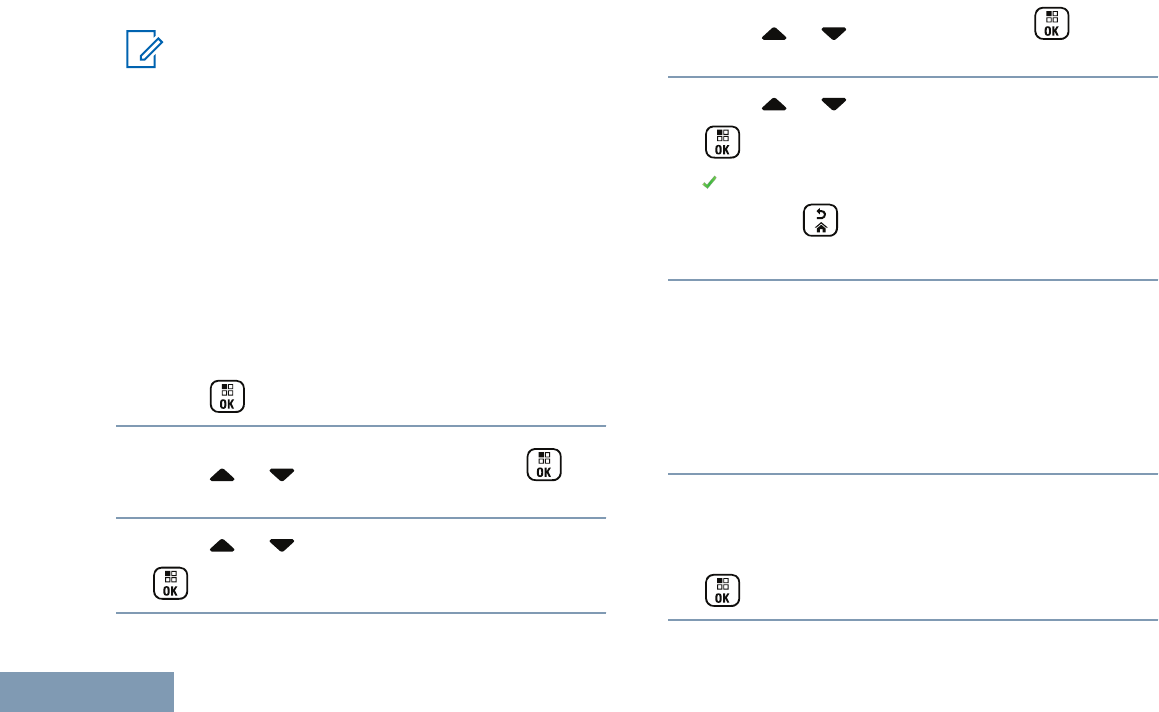
Setting the Power Level
Note:
This feature is not applicable in Citizens Band
channels that are in the same frequency.
You can customize the power setting of the radio to
high or low for each channel.
High enables communication with radios located at a
considerable distance from you. Low enables
communication with radios in closer proximity.
Press the programmed Power Level button to toggle
transmit power level between high and low. Follow
the procedure described next to access this feature
via the radio menu.
1
Press to access the menu.
2
Press or to Utilities and press to
select.
3Press or to Radio Settings and press
to select.
4
Press or to Power and press to
select.
5Press or to the required setting and press
to select.
appears beside selected setting. At any time,
long press to return to the Home screen.
Screen returns to the previous menu.
Turning the Option Board Feature(s) On or Off
A channel can support up to 6 option board features.
Refer to your dealer or system administrator for more
information.
Press the programmed Option Board Feature
button to toggle the feature on or off.
Identifying Cable Type
You can select the type of cable your radio uses.
1
to access the menu.
Advanced Features in Non-Connect Plus Mode
154
English
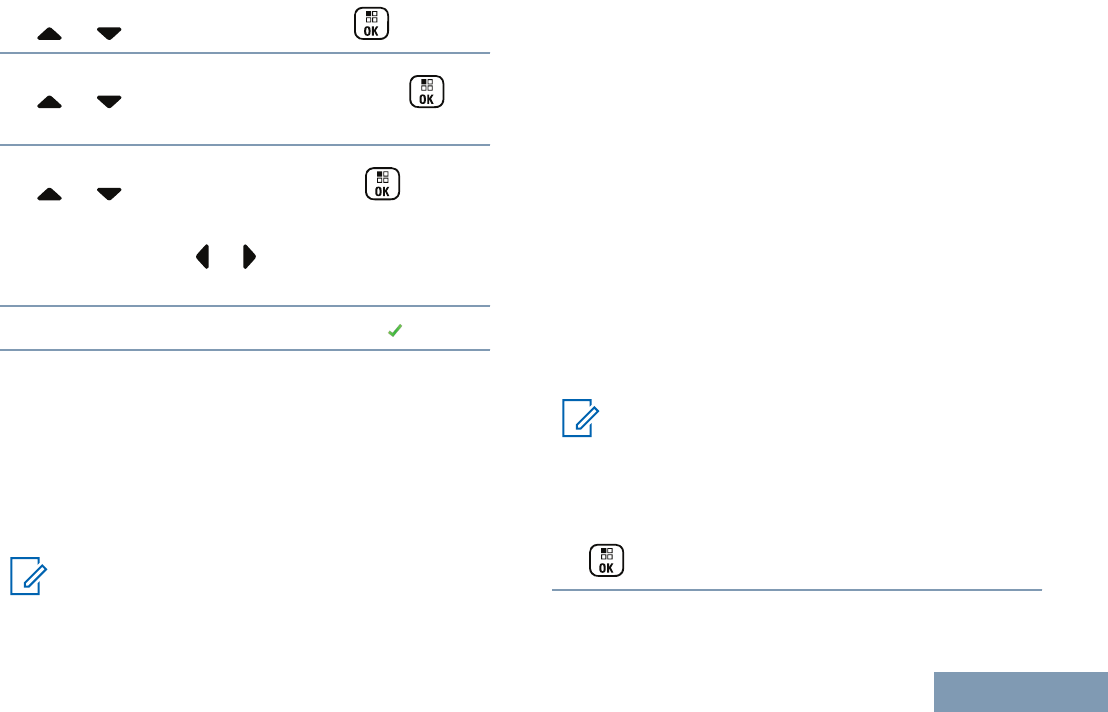
2
or to Utilities and press to select.
3
or to Radio Settings and press to
select.
4
or to Cable Type and press to
select.
You can also use or to change the selected
option.
5The current cable type is indicated by a .
Turning the Voice Operating Transmission (VOX)
Feature On or Off
This feature allows you to initiate a hands-free voice
activated call on a programmed channel. The radio
automatically transmits, for a programmed period,
whenever the microphone on the VOX-capable
accessory detects voice.
Note:
This feature is not applicable in Citizens Band
channels that are in the same frequency.
Pressing the PTT button during radio operation will
disable VOX. To re-enable VOX, do one of the
following:
•Turn the radio off and power it on again.
• Change the channel via the Channel Selector
Knob.
•Press the programmed VOX button to toggle the
feature on or off.
• Follow the steps described next to access this
feature via the radio menu.
If the Talk Permit Tone feature is enabled (see
Turning the Talk Permit Tone On or Off on page
158), use a trigger word to initiate the call. Wait for
the Talk Permit Tone to finish before speaking clearly
into the microphone.
Note:
Turning this feature on or off is limited to
radios with this function enabled. Check with
your dealer or system administrator for more
information.
1
to access the menu.
Advanced Features in Non-Connect Plus Mode
155
English
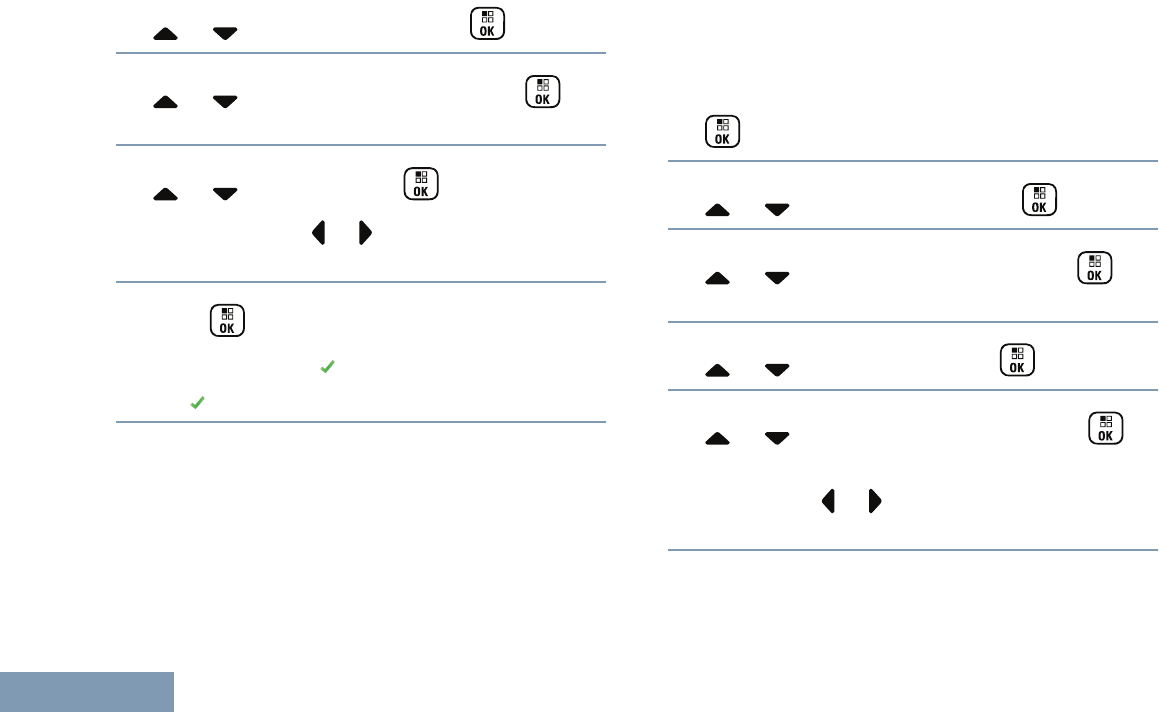
2
or to Utilities and press to select.
3
or to Radio Settings and press to
select.
4
or to VOX and press to select.
You can also use or to change the selected
option.
5
Press to disable/enable VOX.
The display shows beside Enabled.
The disappears from beside Enabled.
Setting the Display Backlight Timer
You can set the the radio’s display backlight timer as
needed. The setting also affects the Menu Navigation
Buttons and keypad backlighting accordingly.
Press the programmed Backlight button to toggle the
backlight settings, or follow the procedure described
next to access this feature via the radio menu.
The display backlight and keypad backlighting are
automatically turned off if the LED indicator is
disabled (see Turning the LED Indicator On or Off on
page 162).
1
to access the menu.
2
or to Utilities and press to select.
3
or to Radio Settings and press to
select.
4
or to Display and press to select.
5
or to Backlight Timer and press to
select.
You can use or to change the selected
option.
Advanced Features in Non-Connect Plus Mode
156
English
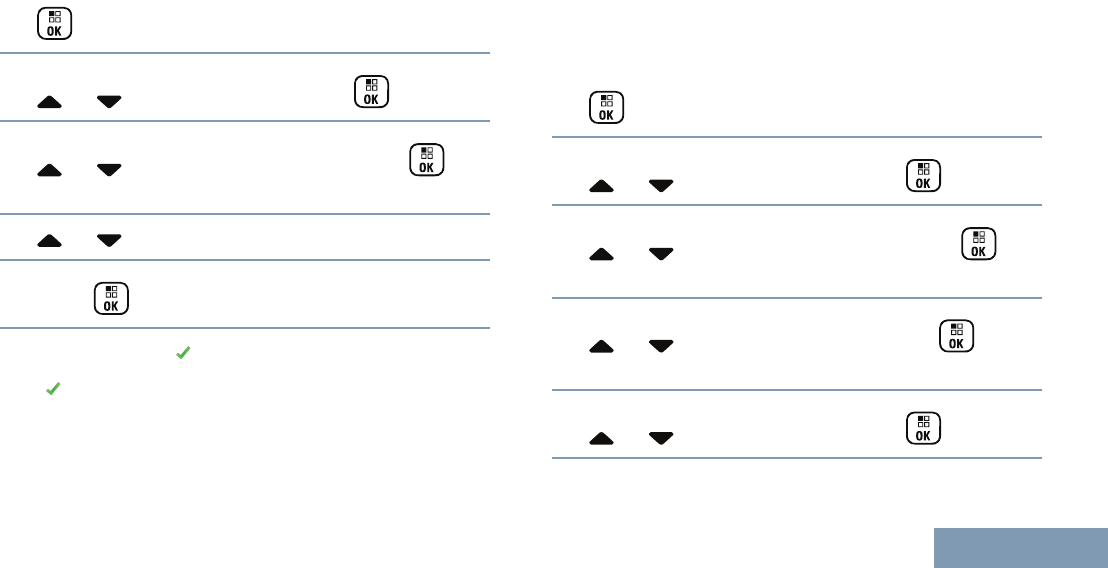
Turning the Backlight Auto On or Off
You can enable and disable the radio’s backlight to
turn on automatically if needed. If enabled, the
backlight is turned on when the radio receives a call,
Notification List event, or Emergency Alarm.
1
to access the menu.
2
or to Utilities and press to select.
3
or to Radio Settings and press to
select.
4 or to Backlight Auto.
5
Press to enable/disable the Backlight Auto.
The display shows beside Enabled.
The disappears from beside Enabled.
Turning the Radio Tones/Alerts On or Off
You can enable and disable all radio tones and alerts
(except for the incoming Emergency alert tone) if
needed.
Press the programmed All Tones/Alerts button to
toggle all tones on or off, or follow the procedure
described next to access this feature via the radio
menu.
1
to access the menu.
2
or to Utilities and press to select.
3
or to Radio Settings and press to
select.
4
or to Tones/Alerts and press to
select.
5
or to All Tones and press to select.
Advanced Features in Non-Connect Plus Mode
157
English
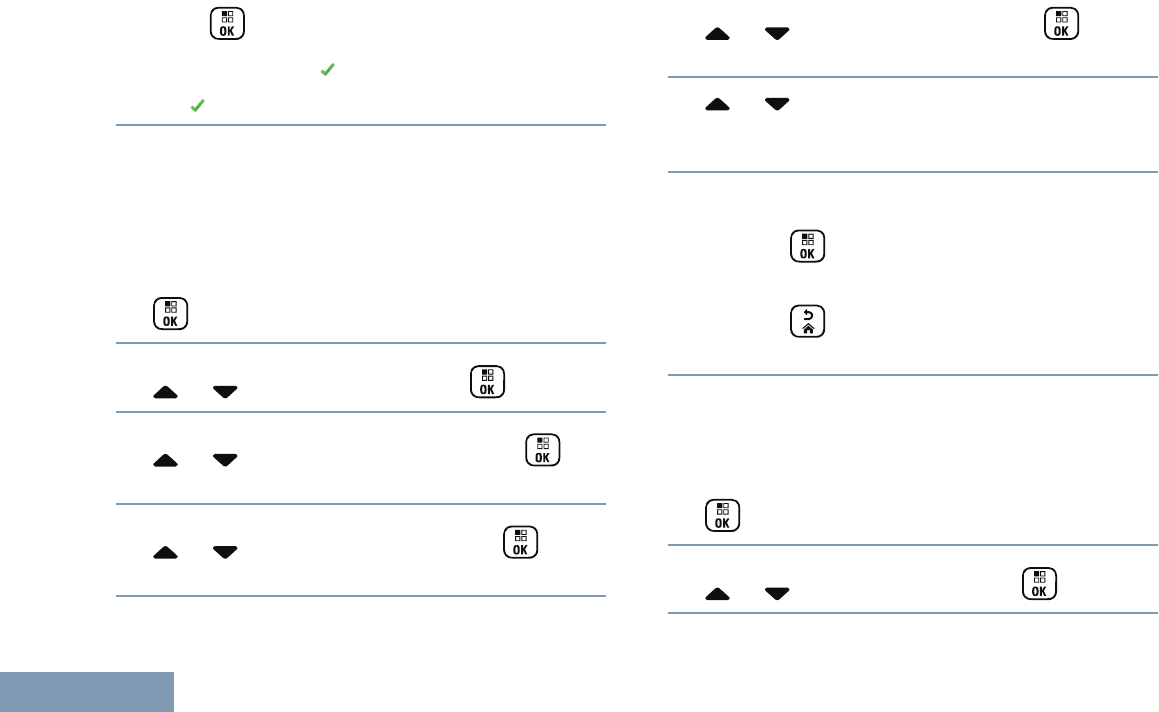
6
Press to enable/disable all tones and alerts.
The display shows beside Enabled.
The disappears from beside Enabled.
Setting the Tone Alert Volume Offset Level
You can adjust the Tone Alert Volume Offset level if
needed. This feature adjusts the volume of the tones/
alerts, allowing it to be higher or lower than the voice
volume.
1
to access the menu.
2
or to Utilities and press to select.
3
or to Radio Settings and press to
select.
4
or to Tones/Alerts and press to
select.
5
or to Vol. Offset and press to
select.
6 or to the required volume value.
The radio sounds a feedback tone with each
corresponding volume value.
7Do one of the following:
•
Press to keep the required displayed
volume value.
•
Press to exit without changing the current
volume offset settings.
Turning the Talk Permit Tone On or Off
You can enable and disable the Talk Permit Tone if
needed.
1
to access the menu.
2
or to Utilities and press to select.
Advanced Features in Non-Connect Plus Mode
158
English
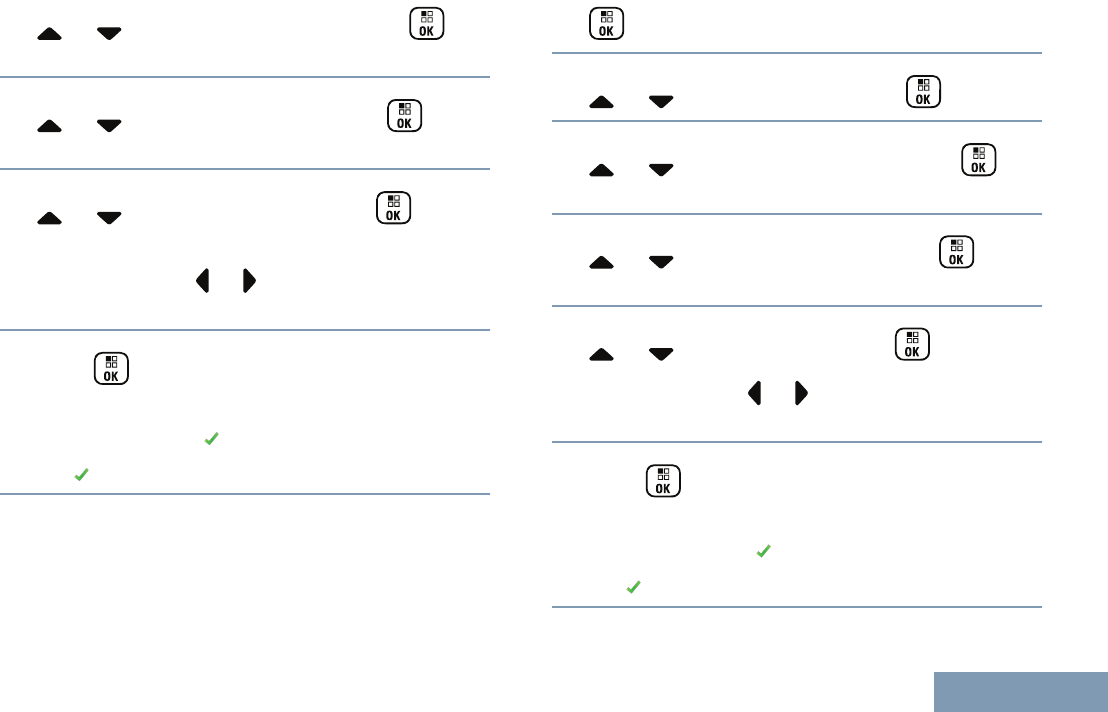
3
or to Radio Settings and press to
select.
4
or to Tones/Alerts and press to
select.
5
or to Talk Permit and press to
select.
You can also use or to change the selected
option.
6
Press to enable/disable the Talk Permit
Tone.
The display shows beside Enabled.
The disappears from beside Enabled.
Turning the Power Up Alert Tone On or Off
You can enable and disable the Power Up Alert Tone
if needed.
1
to access the menu.
2
or to Utilities and press to select.
3
or to Radio Settings and press to
select.
4
or to Tones/Alerts and press to
select.
5
or to Power Up and press to select.
You can also use or to change the selected
option.
6
Press to enable/disable the Power Up Alert
Tone.
The display shows beside Enabled.
The disappears from beside Enabled.
Advanced Features in Non-Connect Plus Mode
159
English
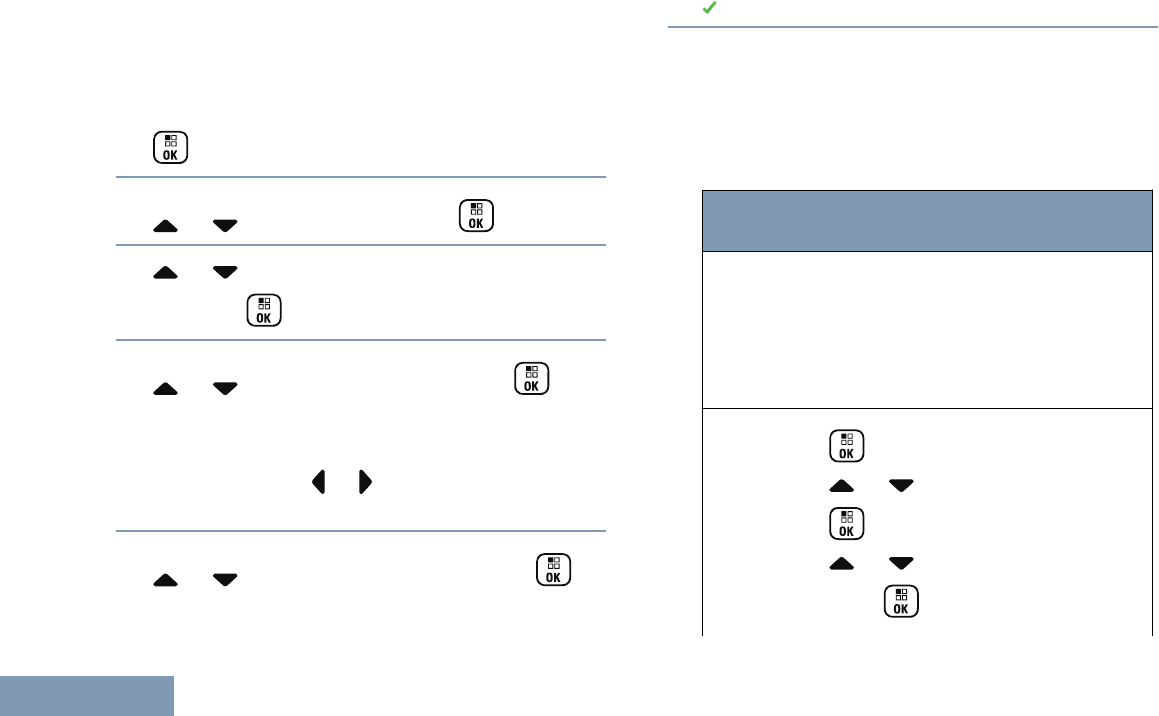
Setting the Text Message Alert Tone
You can customize your radio’s text message alert
tone to Momentary or Repetitive for each entry in the
Contacts list.
1
to access the menu.
2
or to Contacts and press to select.
3 or to the required subscriber alias or ID
and press to select.
4
or to Message Alert and press to
select.
The display shows Momentary and Repetitive.
You can also use or to change the selected
option.
5
or to the required setting and press to
enable.
appears besides selected setting.
Changing the Display Mode
You can change radio’s display mode between Day
or Night, as needed. This affects the color palette of
the display.
Change the Display Mode:
Radio
Control
Steps
Pro-
gram-
med
Display
Mode
Button
Press the programmed Display Mode
button.
Menu 1
to access the menu.
2 or to Utilities and press
to select.
3 or to Radio Settings and
press to select.
Advanced Features in Non-Connect Plus Mode
160
English
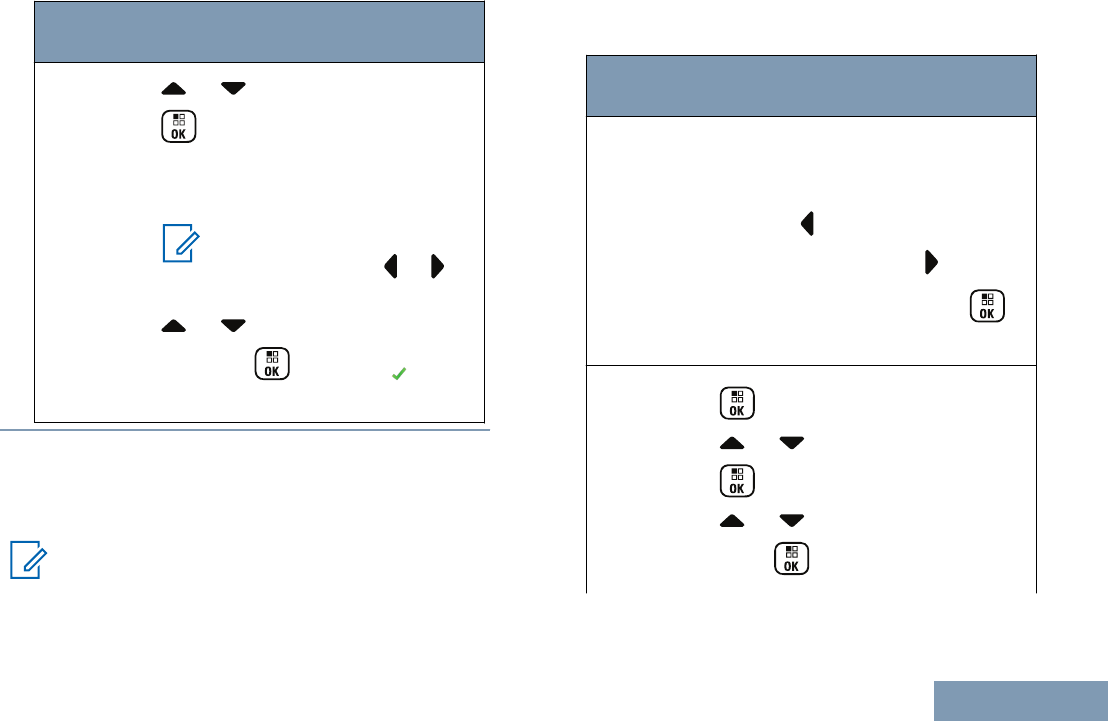
Radio
Control
Steps
4 or to Display and press
to select.
The display shows Day Mode and
Night Mode.
Note:
You can also use or to
change the selected option.
5 or to the required setting
and press to enable. ap-
pears besides selected setting.
Adjusting the Display Brightness
You can adjust the display brightness of the radio as
needed.
Note:
Display brightness cannot be adjusted when
Auto Brightness is enabled.
Adjust the Display Brightness by performing one of
the following actions:
Radio
Control
Steps
Program-
med Dis-
play
Bright-
ness
Button
1Press the programmed Bright-
ness button.
2Decrease display brightness by
pressing or increase the display
brightness by pressing . Select
from setting of 1 to 8. Press
to confirm your entry.
Menu 1
to access the menu.
2 or to Utilities and press
to select.
3 or to Radio Settings and
press to select.
Advanced Features in Non-Connect Plus Mode
161
English
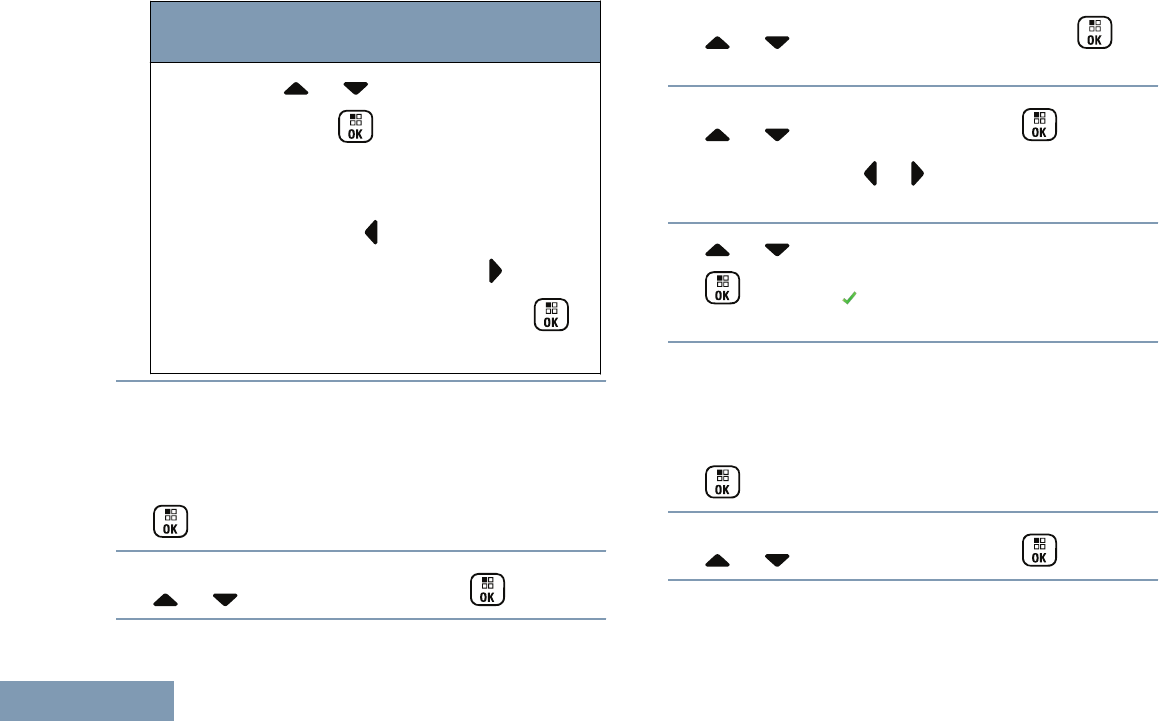
Radio
Control
Steps
4 or to Brightness and
press to select.
The display shows a progress bar.
5Decrease display brightness by
pressing or increase the display
brightness by pressing . Select
from setting of 1 to 8. Press
to confirm your entry.
Language
You can set your radio display to be in your required
language.
1
to access the menu.
2
or to Utilities and press to select.
3
or to Radio Settings and press to
select.
4
or to Languages and press to select.
You can also use or to change selected
option.
5 or to the required language and press
to enable. appears beside selected
language.
Turning the LED Indicator On or Off
You can enable and disable the LED Indicator if
needed.
1
to access the menu.
2
or to Utilities and press to select.
Advanced Features in Non-Connect Plus Mode
162
English
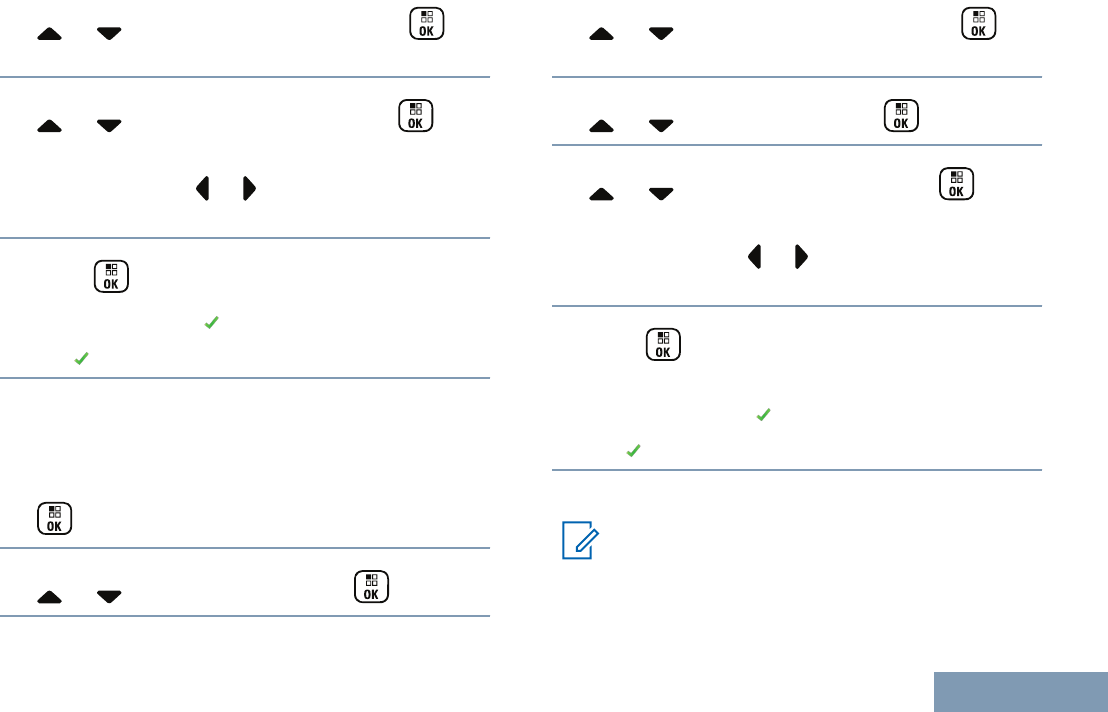
3
or to Radio Settings and press to
select.
4
or to LED Indicator and press to
select.
You can also use or to change the selected
option.
5
Press to enable/disable the LED Indicator.
The display shows beside Enabled.
The disappears from beside Enabled.
Turning the Introduction Screen On or Off
You can enable and disable the Introduction Screen if
needed.
1
to access the menu.
2
or to Utilities and press to select.
3
or to Radio Settings and press to
select.
4
or to Display and press to select.
5
or to Intro Screen and press to
select.
You can also use or to change the selected
option.
6
Press to enable/disable the Introduction
Screen.
The display shows beside Enabled.
The disappears from beside Enabled.
Turning the Voice Announcement On or Off
Note:
The Voice Announcement feature can only be
enabled via the MOTOTRBO CPS. If enabled,
the Text-to-Speech feature is automatically
disabled, and vice versa.
Advanced Features in Non-Connect Plus Mode
163
English
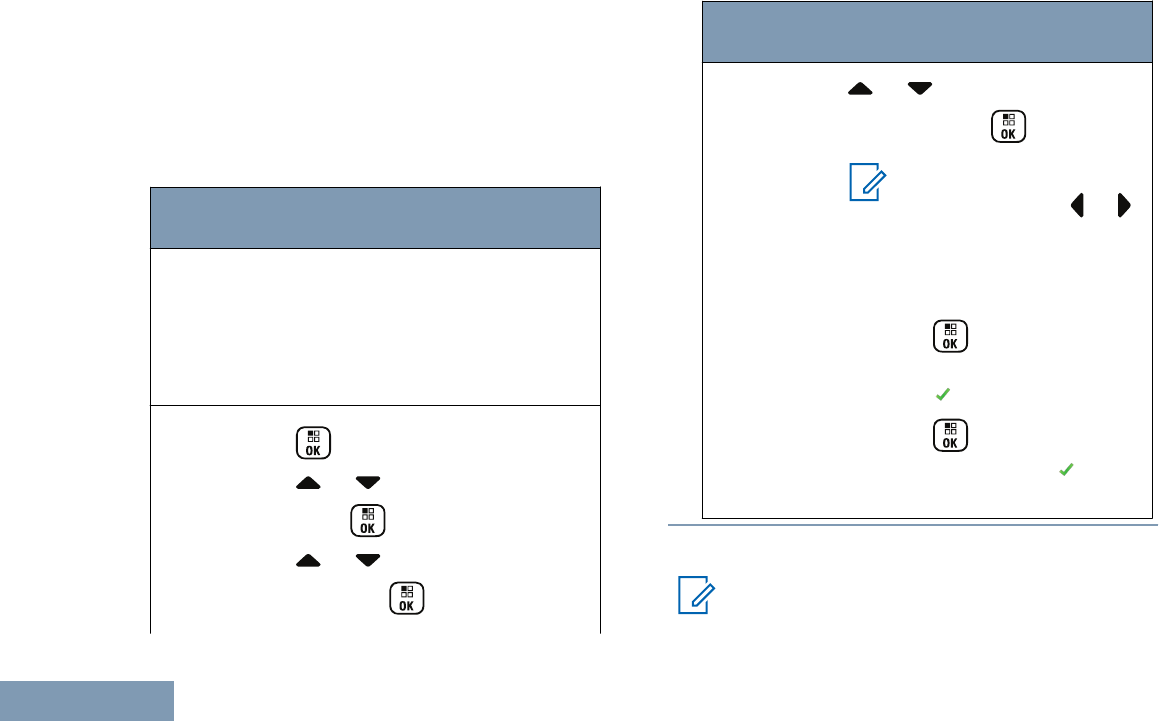
This feature enables the radio to audibly indicate the
current Zone or Channel the user has assigned, or
programmable button press. This audio indicator can
be customized per customer requirements. This is
typically useful when the user is in a difficult condition
to read the content shown on the display.
Toggle Voice Announcement On or Off.
Radio
Control
Steps
Program-
med Voice
An-
nounce-
ment But-
ton
Press the programmed Voice An-
nouncement button.
Menu 1
to access the menu.
2 or to Utilities and
press to select.
3 or to Radio Settings
and press to select.
Radio
Control
Steps
4 or to Voice Announce‐
ment and press to select.
Note:
You can also use or
to change the selected
option.
5Do one of the following:
•
Press to enable Voice
Announcement. The display
shows beside Enabled.
•
Press to disable Voice
Announcement. The disap-
pears from beside Enabled.
Setting the Text-to-Speech Feature
Note:
The Text-to-Speech feature can only be
enabled via the MOTOTRBO Customer
Advanced Features in Non-Connect Plus Mode
164
English
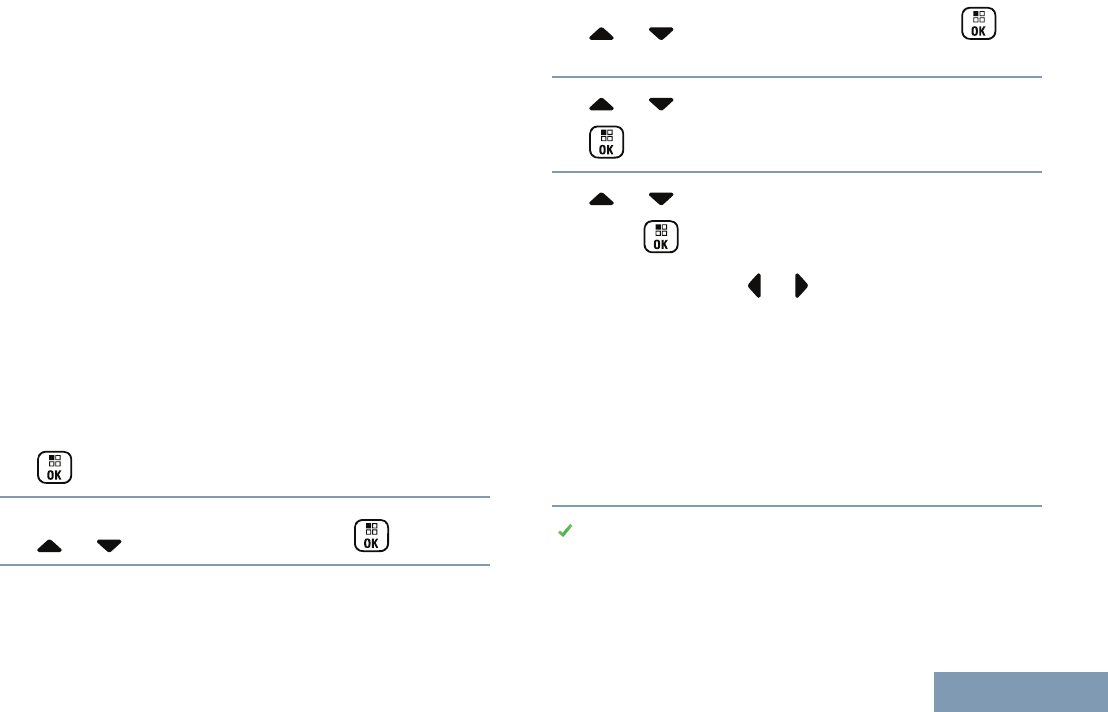
Programming Software. If enabled, the Voice
Announcement feature is automatically
disabled, and vice versa. Check with your
dealer or system administrator for more
information.
This feature enables the radio to audibly indicate the
following features:
• Current Channel
• Current Zone
•Programmed button feature on or off
• Content of received text messages
• Content of received Job Tickets
This audio indicator can be customized per customer
requirements. This is typically useful when the user is
in a difficult condition to read the content shown on
the display.
1
to access the menu.
2
or to Utilities and press to select.
3
or to Radio Settings and press to
select.
4 or to Voice Announcement and press
to select.
5 or to any of the following features and
press to select.
You can also use or to change the selected
option.
•All
•Messages
•Job Tickets
•Channel
•Zone
•Program Button
appears beside the selected setting.
Advanced Features in Non-Connect Plus Mode
165
English
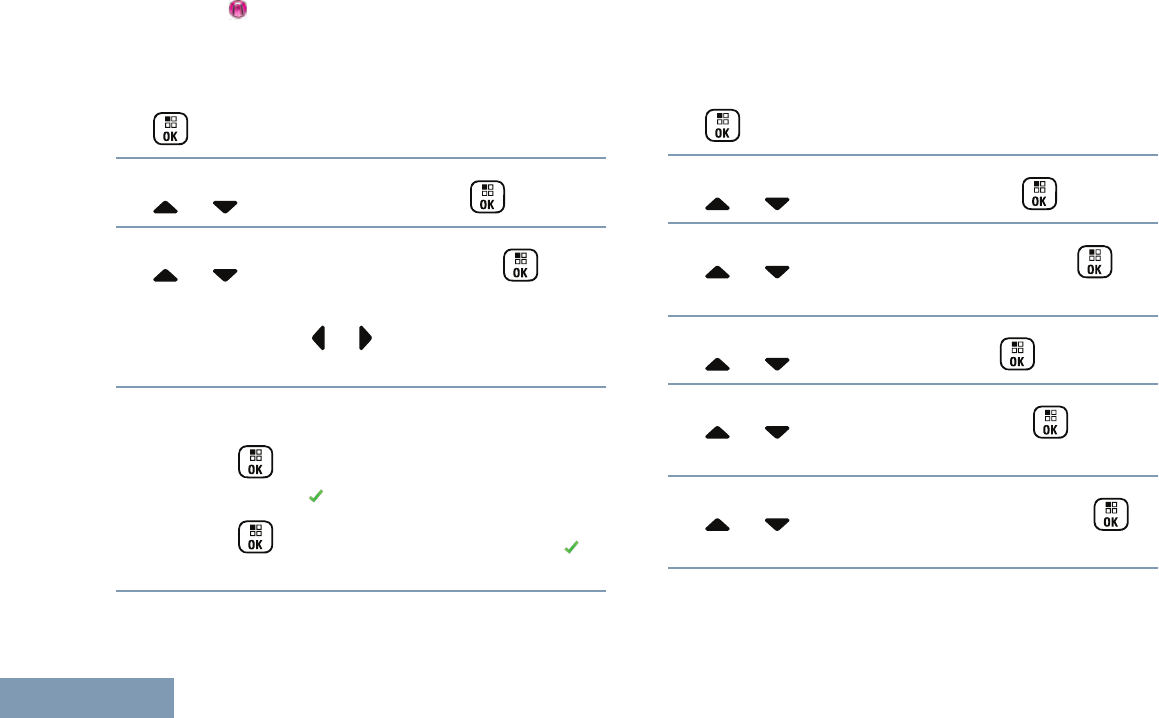
Call Forwarding
You can enable your radio to automatically forward
voice calls to another radio.
1
to access the menu.
2
or to Utilities and press to select.
3
or to Call Forward and press to
select.
You can also use or to change the selected
option.
4Do one of the following:
•
Press to enable Call Forwarding. The
display shows beside Enabled.
•
Press to disable Call Forwarding. The
disappears from beside Enabled.
Menu Timer
Set the period of time your radio stays in the menu
before it automatically switches to the Home screen.
1
to access the menu.
2
or to Utilities and press to select.
3
or to Radio Settings and press to
select.
4
or to Display and press to select.
5
or to Menu Timer and press to
select.
6
or to the required setting and press
to select.
Advanced Features in Non-Connect Plus Mode
166
English
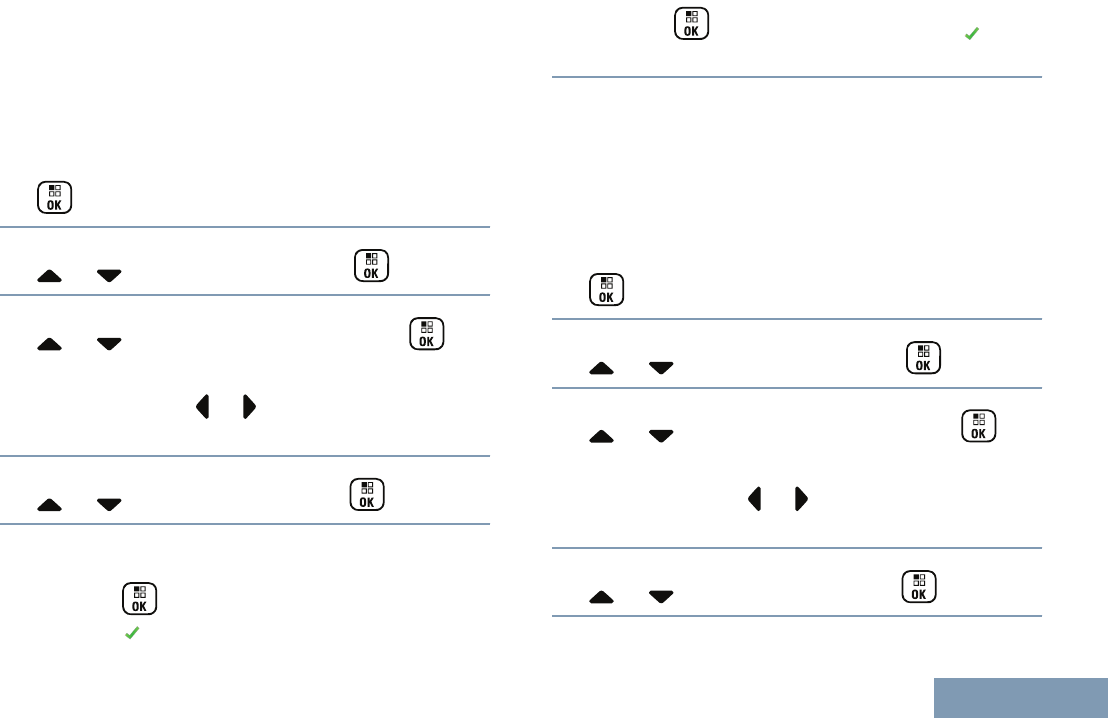
Analog Mic AGC (Mic AGC-A)
This feature controls the your radio's microphone gain
automatically while transmitting on an analog system.
It suppresses loud audio or boosts soft audio to a
preset value in order to provide a consistent level of
audio.
1
to access the menu.
2
or to Utilities and press to select.
3
or to Radio Settings and press to
select.
You can also use or to change the selected
option.
4
or to Mic AGC-A and press to select.
5Do one of the following:
•
Press to enable Mic AGC-A. The display
shows beside Enabled.
•
Press to disable Mic AGC-A. The
disappears from beside Enabled.
Digital Mic AGC (Mic AGC-D)
This feature controls the your radio's microphone gain
automatically while transmitting on a digital system. It
suppresses loud audio or boosts soft audio to a
preset value in order to provide a consistent level of
audio.
1
to access the menu.
2
or to Utilities and press to select.
3
or to Radio Settings and press to
select.
You can also use or to change the selected
option.
4
or to Mic AGC-D and press to select.
Advanced Features in Non-Connect Plus Mode
167
English
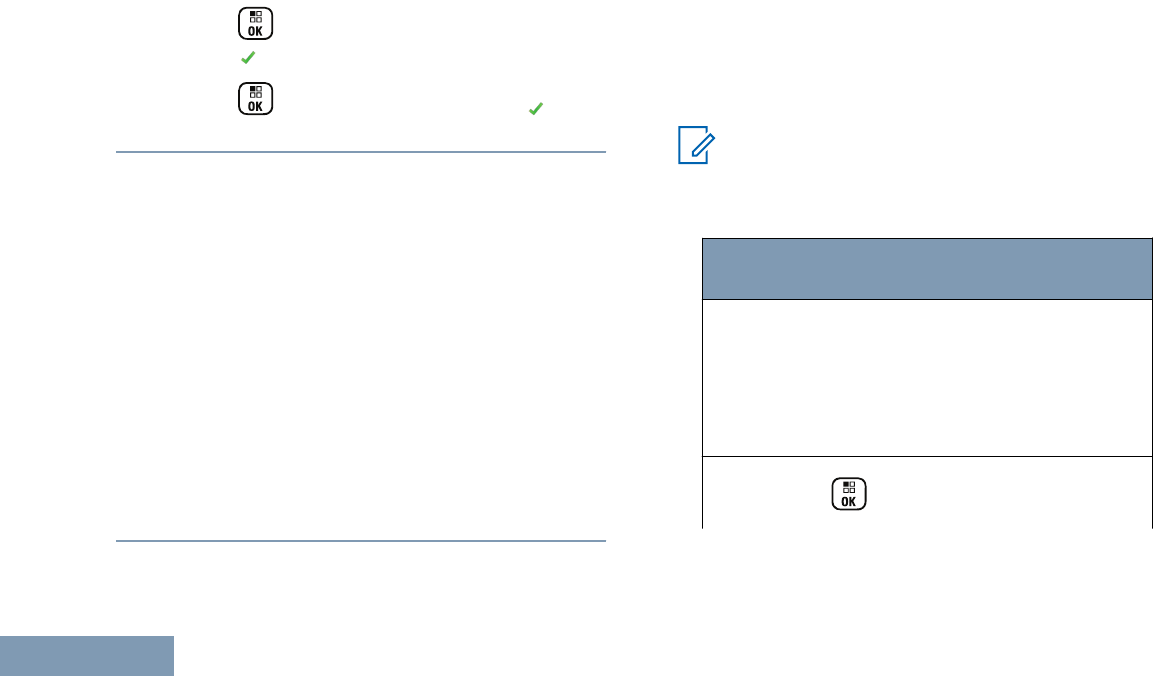
5Do one of the following:
•
Press to enable Mic AGC-D. The display
shows beside Enabled.
•
Press to disable Mic AGC-D. The
disappears from beside Enabled.
Switching Audio Route between Internal Radio Speaker
and Wired Accessory
You can toggle audio routing between the internal
radio speaker and the speaker of wired accessory
provided that:
• The wired accessory with speaker is attached.
• The audio is not routed to an external Bluetooth-
enabled accessory.
Powering down the radio or detaching the accessory
resets the audio routing to the internal radio speaker.
Press the programmed Audio Toggle button to
toggle audio routing between the internal radio
speaker and the speaker of wired accessory.
Intelligent Audio
Your radio can automatically adjust its audio volume
to overcome background noise in the environment,
inclusive of all stationary and non-stationary noise
sources. This feature is a Receive-only feature and
does not affect Transmit audio.
Note:
This feature is not applicable during a
Bluetooth session.
Toggle Intelligent Audio On or Off.
Radio
Control
Steps
Pro-
gram-
med In-
telligent
Audio
Button
Press the programmed Intelligent Au-
dio button.
Menu 1
to access the menu.
Advanced Features in Non-Connect Plus Mode
168
English
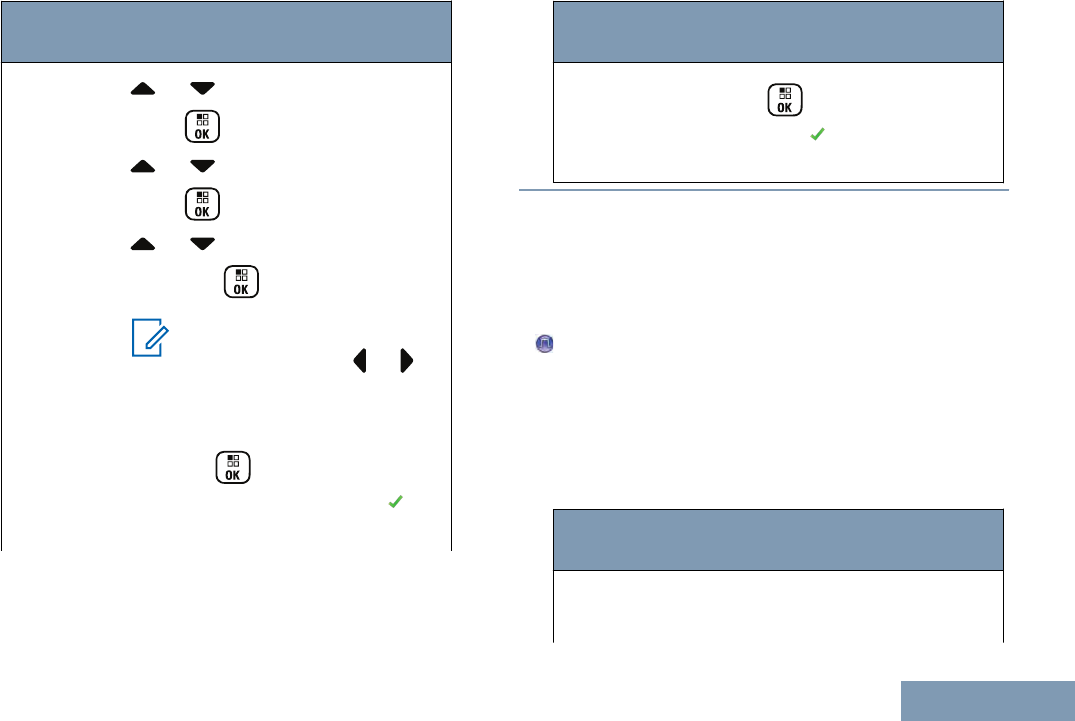
Radio
Control
Steps
2 or to Radio Settings and
press to select.
3 or to Radio Settings and
press to select.
4 or to Intelligent Audio
and press to select.
Note:
You can also use or to
change the selected option.
5Do one of the following:
•
Press to enable Intelligent
Audio. The display shows be-
side Enabled.
Radio
Control
Steps
•
Press to disable Intelligent
Audio. The disappears from
beside Enabled.
See Authorized Accessories List on page 307 for
recommended Bluetooth-enabled audio accessories
with in-built Automatic Volume Control for similar
performance.
Turning the Acoustic Feedback Suppressor Feature On
or Off
This feature allows you to minimize acoustic feedback
in received calls.
Toggle the Acoustic Feedback Suppressor
Feature On or Off by performing one of the
following actions:
Radio
Control
Steps
Program-
med Press the programmed Acoustic
Feedback Suppressor button.
Advanced Features in Non-Connect Plus Mode
169
English
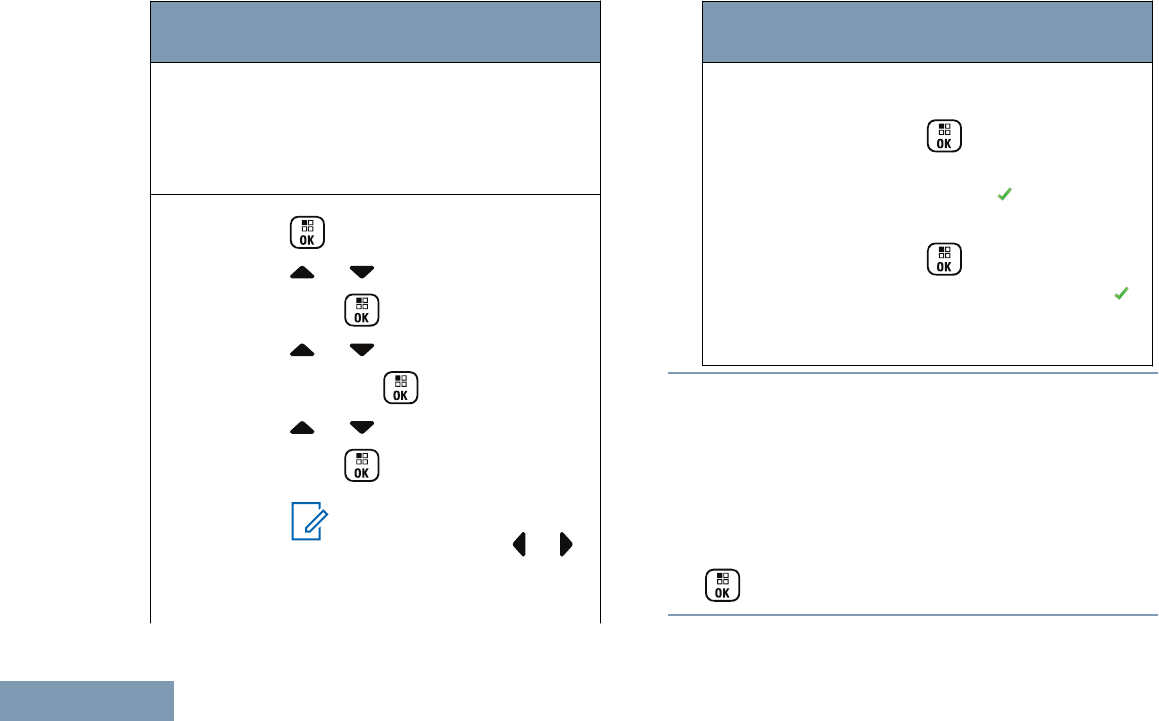
Radio
Control
Steps
Acoustic
Feedback
Suppres-
sor But-
ton
Menu 1
to access the menu.
2 or to Utilities and
press to select.
3 or to Radio Settings
and press to select.
4 or to AF Suppressor and
press to select.
Note:
You can also use or
to change the selected op-
tion.
Radio
Control
Steps
5Do one of the following:
•
Press to enable Acoustic
Feedback Suppressor. The
display shows beside Ena-
bled.
•
Press to disable Acoustic
Feedback Suppressor. The
disappears from beside Ena-
bled.
Turning the Microphone Dynamic Distortion Control
Feature On or Off
This feature allows you to enable the radio to
automatically monitor the microphone input and
adjust the microphone gain value to avoid audio
clipping.
1
to access the menu.
Advanced Features in Non-Connect Plus Mode
170
English
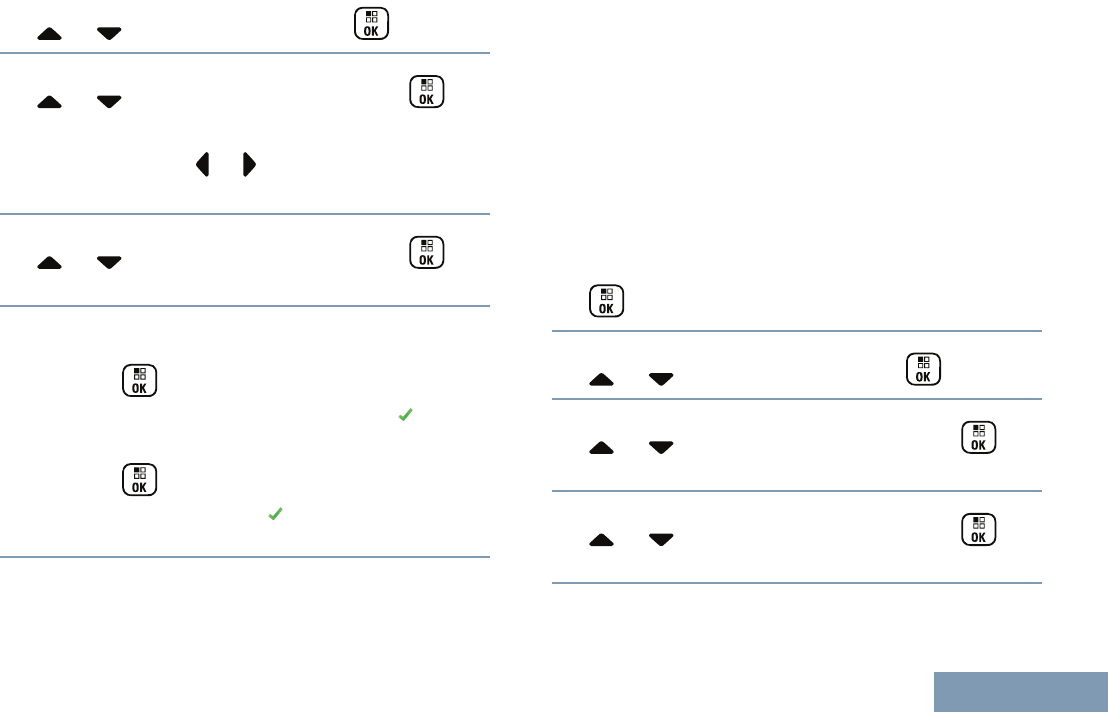
2
or to Utilities and press to select.
3
or to Radio Settings and press to
select.
You can also use or to change the selected
option.
4
or to Mic Distortion and press to
select.
5Do one of the following:
•
Press to enable Microphone Dynamic
Distortion Control. The display shows beside
Enabled.
•
Press to disable Microphone Dynamic
Distortion Control. The disappears from
beside Enabled.
Setting the Audio Ambience
You can customize the audio ambience of the radio
according to your environment.
Default enables the default factory settings.
Loud enables Noise Suppressor and increases
speaker loudness for use in noisy surroundings.
Work Group enables AF Suppressor and disables
AGC for use when a group of radios are near to each
other.
1
to access the menu.
2
or to Utilities and press to select.
3
or to Radio Settings and press to
select.
4
or to Audio Ambience and press to
select.
Advanced Features in Non-Connect Plus Mode
171
English
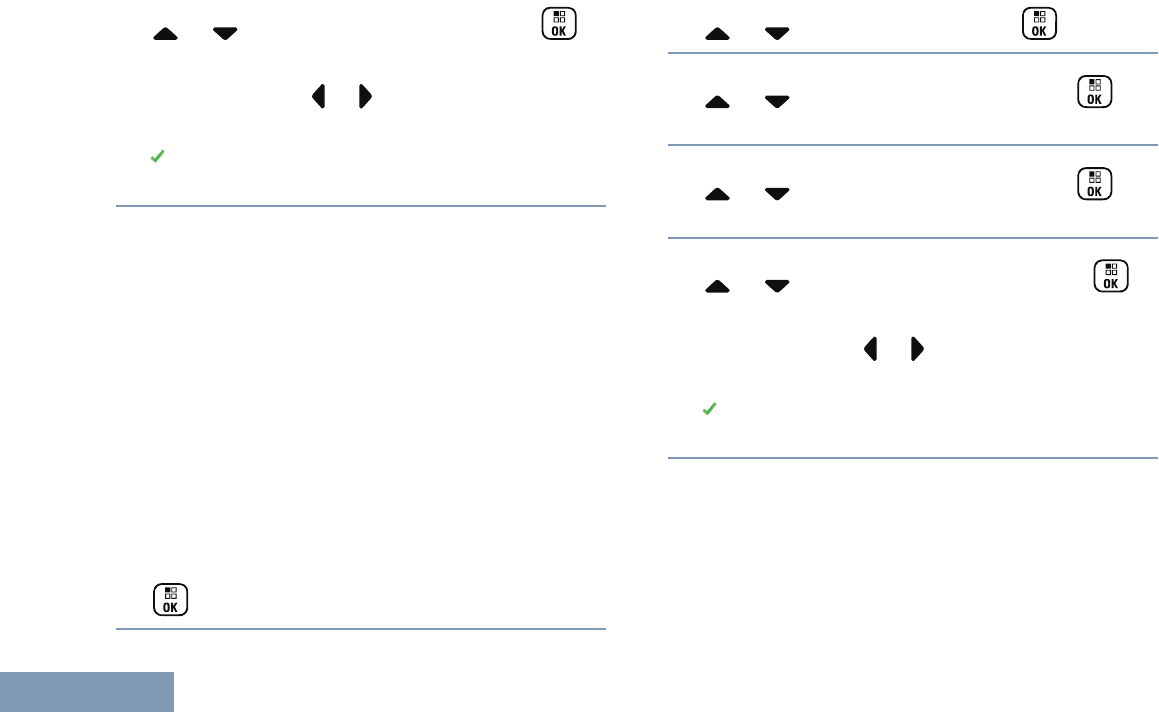
5
or to the required setting and press
to select.
You can also use or to change the selected
option.
appears beside the selected setting.
Screen returns to the previous menu.
Setting the Audio Profiles
You can customize the audio profiles of the radio
according to your preference.
Default disables the previously selected audio
profile and the radio’s audio profile returns to normal.
Level 1, Level 2, and Level 3 are audio profiles
intended to compensate for noise-induced hearing
loss that is typical for adults in their 40’s, 50’s, and
60’s or over.
Treble Boost, Mid Boost, and Bass Boost are for
a tinnier sound, a more nasal sound, and a deeper
sound.
1
to access the menu.
2
or to Utilities and press to select.
3
or to Radio Settings and press to
select.
4
or to Audio Profiles and press to
select.
5
or to the required setting and press
to select.
You can also use or to change the selected
option.
appears beside the selected setting.
Screen returns to the previous menu.
Turning GPS/GNSS On or Off
Global Navigation Satellite System (GNSS) is a
satellite navigation system that determines the radio’s
precise location. GNSS includes Global Positioning
System (GPS), Global Navigation Satellite System
Advanced Features in Non-Connect Plus Mode
172
English
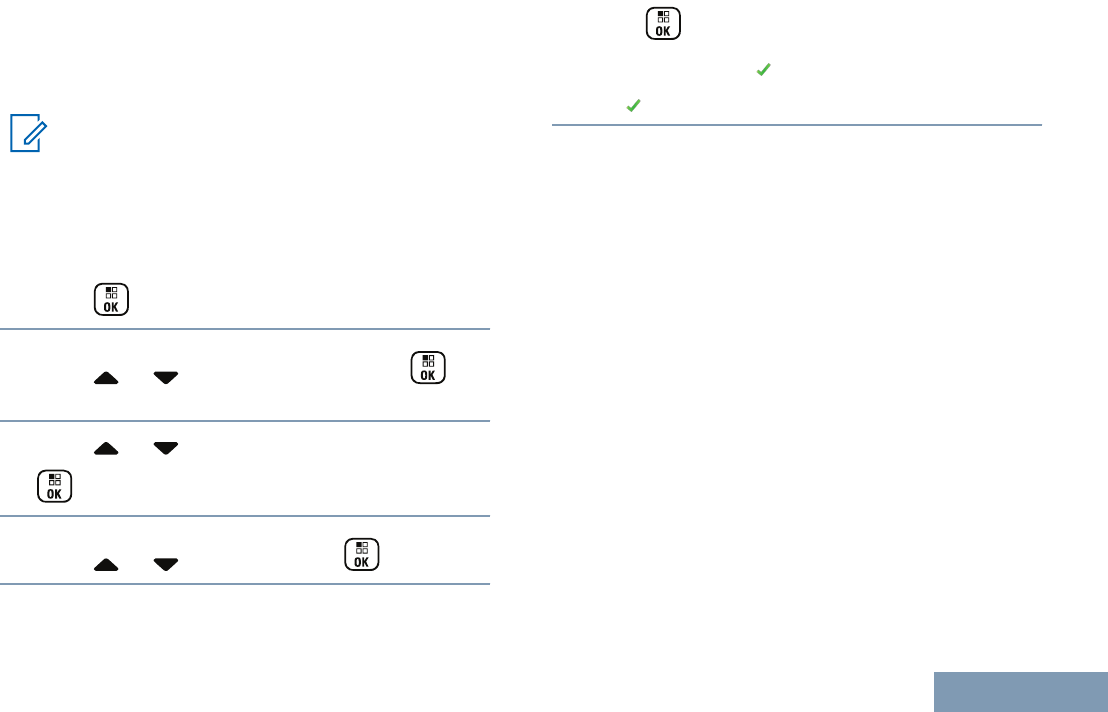
(GLONASS), and BeiDou Navigation Satellite System
(BDS).
Press the programmed GPS/GNSS button to toggle
the feature on or off.
Note:
Selected radio models may offer GPS,
GLONASS, and BDS. GNSS constellation is
configured via CPS. Check with your dealer or
system administrator to determine how your
radio has been programmed.
1
Press to access the menu.
2
Press or to Utilities and press to
select.
3Press or to Radio Settings and press
to select.
4
Press or to GPS and press to select.
5
Press to enable/disable GPS/GNSS.
The display shows beside Enabled.
The disappears from beside Enabled.
See Checking the GPS/GNSS Information on page
184 for details on retrieving GPS/GNSS information.
Text Entry Configuration
You can configure the following settings for entering
text on your radio:
• Word Predict
• Word Correct
• Sentence Cap
• My Words
Your radio supports the following text entry methods:
• Numbers
• Symbols
• Predictive or Multi-Tap
• Language (If programmed)
Advanced Features in Non-Connect Plus Mode
173
English
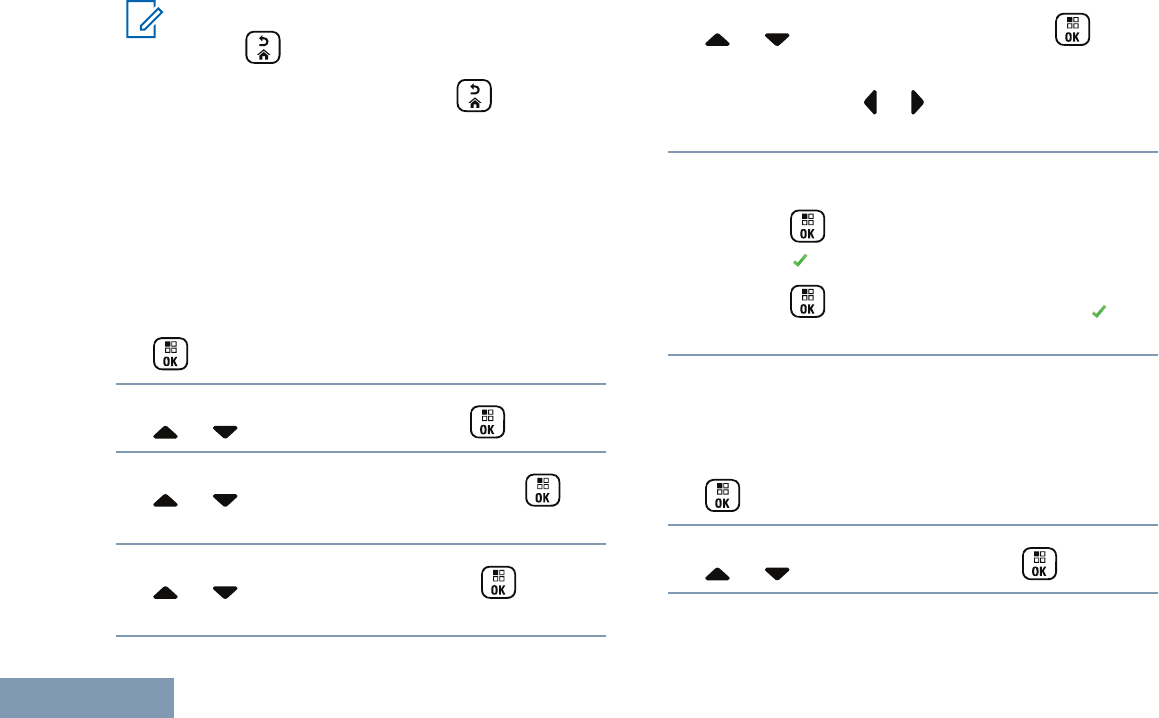
Note:
Press at any time to return to the
previous screen or long press to return to
the Home Screen. The radio exits the current
screen once the inactivity timer expires.
Word Predict
Your radio can learn common word sequences that
you often enter. It then predicts the next word you
may want to use after you enter the first word of a
common word sequence into the text editor.
1
to access the menu.
2
or to Utilities and press to select.
3
or to Radio Settings and press to
select.
4
or to Text Entry and press to
select.
5
or to Word Predict and press to
select.
You can also use or to change the selected
option.
6Do one of the following:
•
Press to enable Word Predict. The display
shows beside Enabled.
•
Press to disable Word Predict. The
disappears from beside Enabled.
Sentence Cap
Automatically enables capitalization for the first letter
in the first word for every new sentence.
1
to access the menu.
2
or to Utilities and press to select.
Advanced Features in Non-Connect Plus Mode
174
English
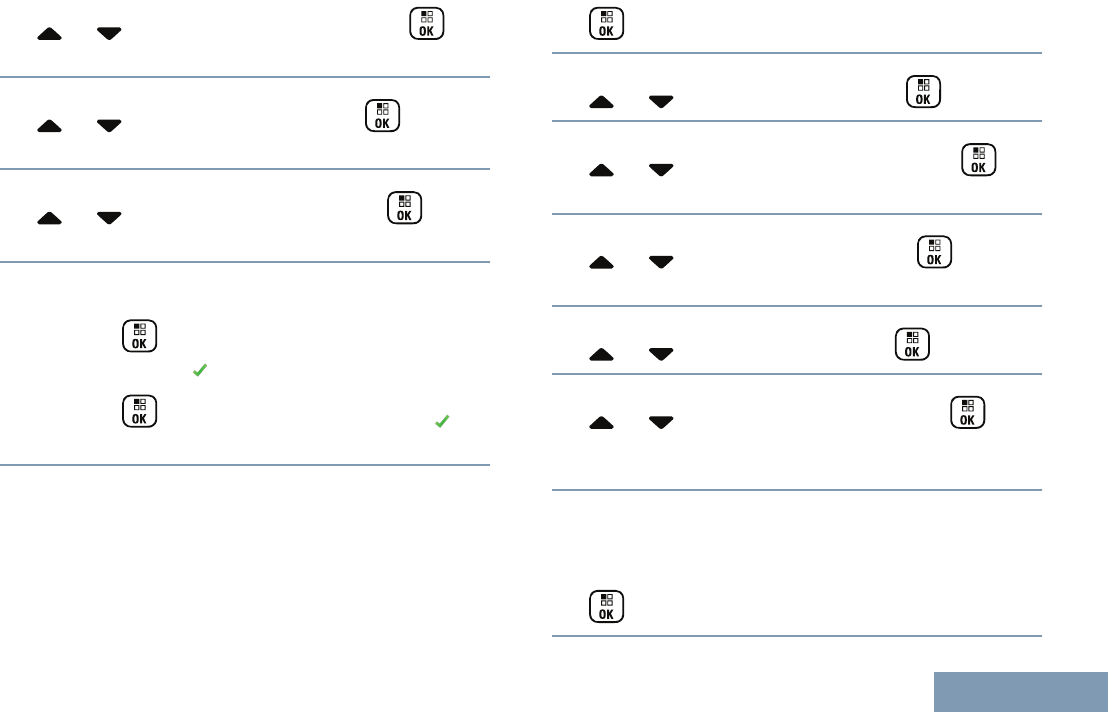
3
or to Radio Settings and press to
select.
4
or to Text Entry and press to
select.
5
or to Sentence Cap and press to
select.
6Do one of the following:
•
Press to enable Sentence Cap. The
display shows beside Enabled.
•
Press to disable Sentence Cap. The
disappears from beside Enabled.
Viewing Custom Words
You can add your own custom words into your radio’s
in-built dictionary. Your radio maintains a list to
contain these words.
1
to access the menu.
2
or to Utilities and press to select.
3
or to Radio Settings and press to
select.
4
or to Text Entry and press to
select.
5
or to My Words and press to select.
6
or to List of Words and press to
select.
Display shows the list of custom words.
Editing Custom Word
You can edit the custom words saved in your radio.
1
to access the menu.
Advanced Features in Non-Connect Plus Mode
175
English
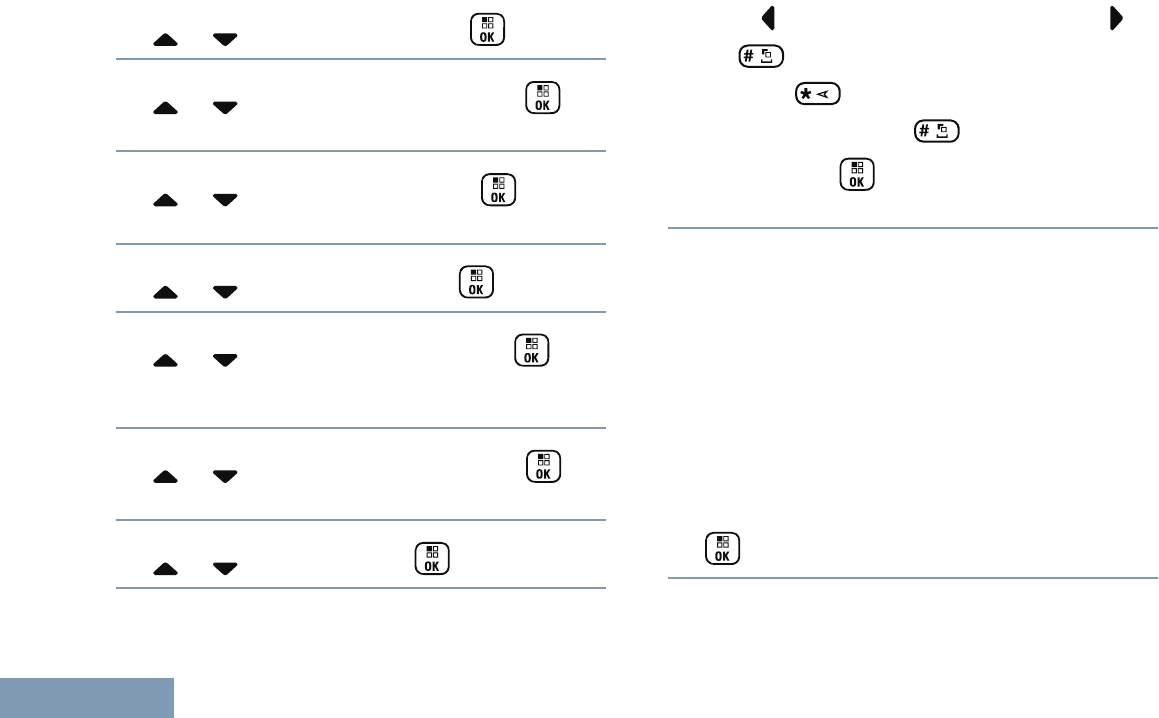
2
or to Utilities and press to select.
3
or to Radio Settings and press to
select.
4
or to Text Entry and press to
select.
5
or to My Words and press to select.
6
or to List of Words and press to
select.
Display shows the list of custom words.
7
or to the required word and press to
select.
8
or to Edit and press to select.
9Use the keypad to edit your custom word.
Press to move one space to the left. Press or
the key to move one space to the right.
Press the key to delete any unwanted
characters. Long press to change text entry
method. Press once your custom word is
completed.
The display shows transitional mini notice, confirming
your custom word is being saved.
If the custom word is saved, a tone sounds and the
display shows positive mini notice.
If the custom word is not saved, a low tone sounds
and the display shows negative mini notice.
Adding Custom Word
You can add your own custom words into your radio’s
in-built dictionary.
1
to access the menu.
Advanced Features in Non-Connect Plus Mode
176
English
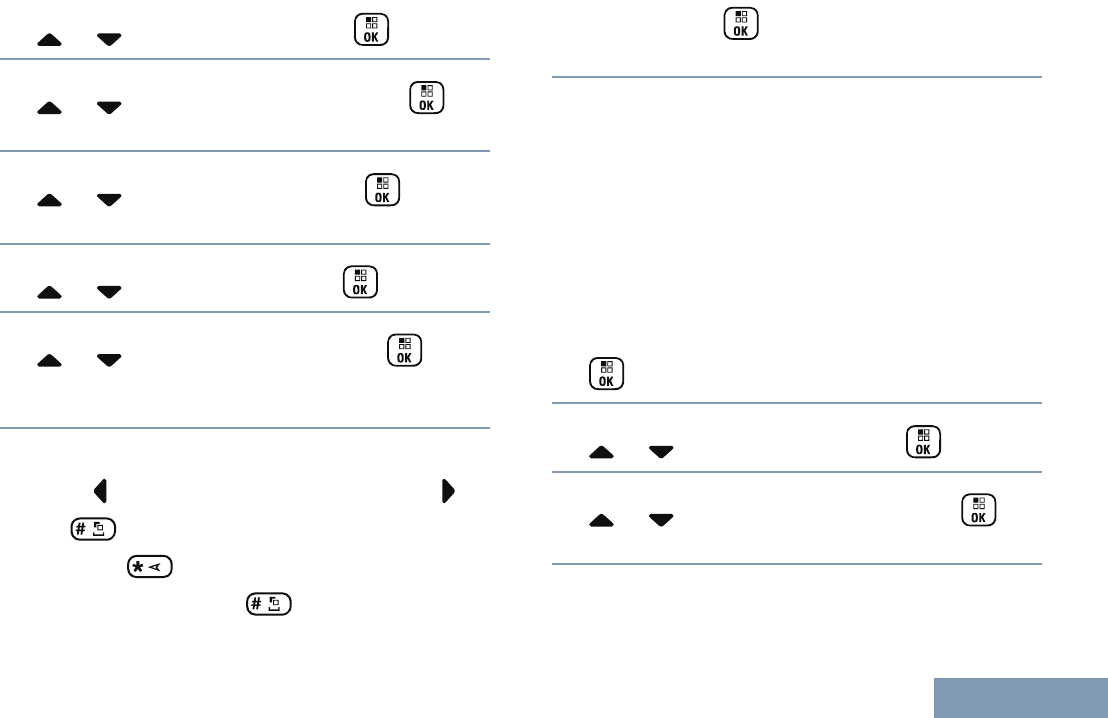
2
or to Utilities and press to select.
3
or to Radio Settings and press to
select.
4
or to Text Entry and press to
select.
5
or to My Words and press to select.
6
or to Add New Word and press to
select.
Display shows the list of custom words.
7Use the keypad to edit your custom word.
Press to move one space to the left. Press or
the key to move one space to the right.
Press the key to delete any unwanted
characters. Long press to change text entry
method. Press once your custom word is
completed.
The display shows transitional mini notice, confirming
your custom word is being saved.
If the custom word is saved, a tone sounds and the
display shows positive mini notice.
If the custom word is not saved, a low tone sounds
and the display shows negative mini notice.
Deleting a Custom Word
You can delete the custom words saved in your radio.
1
to access the menu.
2
or to Utilities and press to select.
3
or to Radio Settings and press to
select.
Advanced Features in Non-Connect Plus Mode
177
English
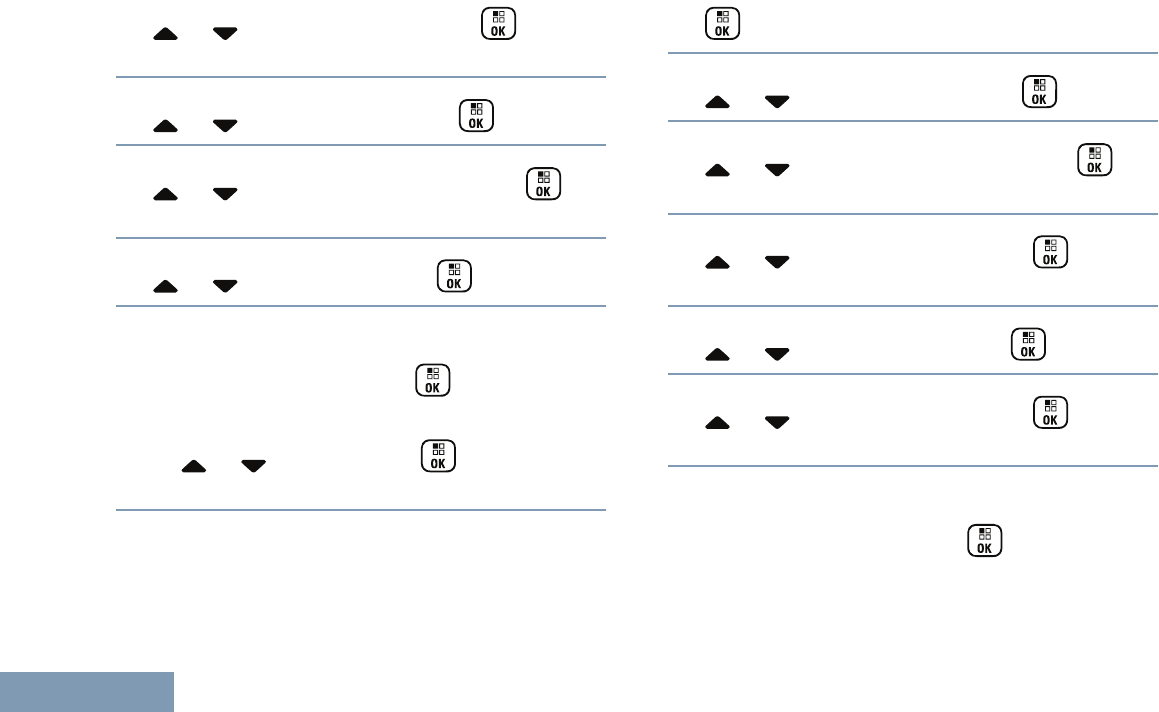
4
or to Text Entry and press to
select.
5
or to My Words and press to select.
6
or to the required word and press to
select.
7
or to Delete and press to select.
8Choose one of the following.
•
At Delete Entry?, press to select Yes.
The display shows Entry Deleted.
•
or to No and press to return to the
previous screen.
Deleting All Custom Words
You can delete all custom words from your radio’s in-
built.
1
to access the menu.
2
or to Utilities and press to select.
3
or to Radio Settings and press to
select.
4
or to Text Entry and press to
select.
5
or to My Words and press to select.
6
or to Delete All and press to
select.
7Choose one of the following.
•
At Delete Entry?, press to select Yes.
The display shows Entry Deleted.
Advanced Features in Non-Connect Plus Mode
178
English
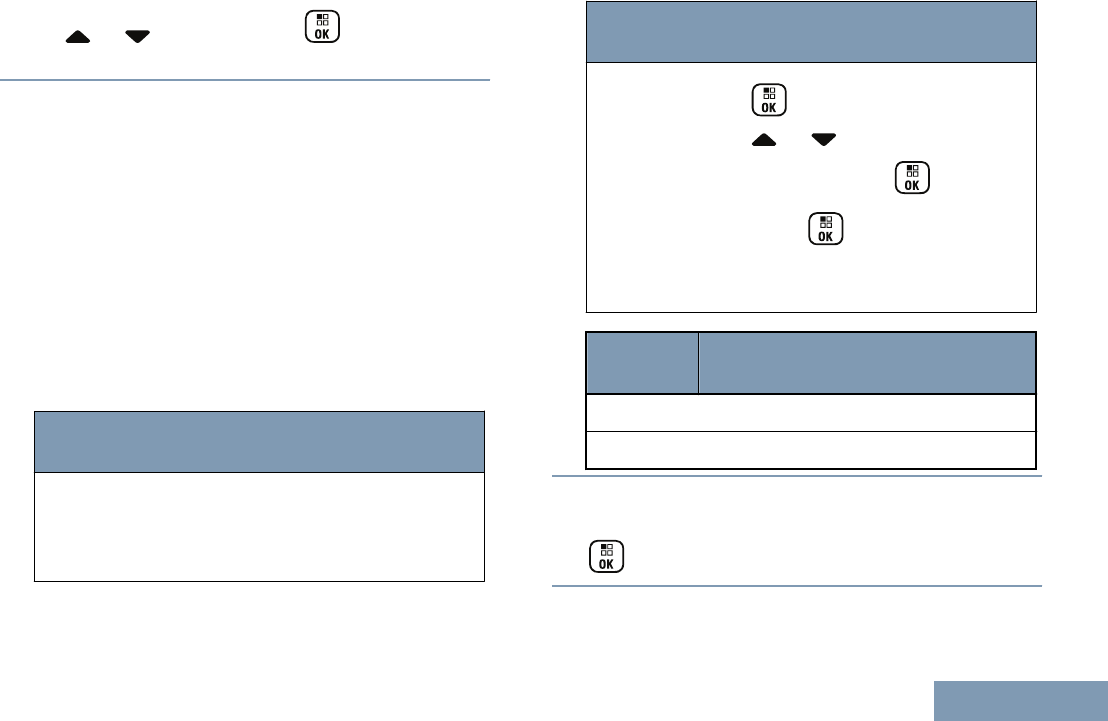
•
or to No and press to return to the
previous screen.
Flexible Receive List
Flexible Receive List is a digital-only (currently
supported in Capacity Plus and Linked Capacity Plus)
feature that allows you to add, delete or edit members
on the receive talkgroup list. Your radio can support a
maximum of 16 members in the list.
Turning the Flexible Receive List On or Off
You can enable and disable the Flexible Receive List
if needed.
Enable the Flexible Receive List by performing
one of the following actions:
Radio Con-
trol
Steps
Programmed
Flexible Re-
ceive List
Button
Press the programmed Flexible
Receive List button.
Radio Con-
trol
Steps
Menu 1
to access the menu.
2 or to Flexible Rx
List and press to select.
3
Press to enable or disable
the Flexible Receive List fea-
ture.
Previous
display
Current display
Turn On Flexible Rx List On
Turn Off Flexible Rx List Off
Adding a New Entry to the Flexible Receive List
1
to access the menu.
Advanced Features in Non-Connect Plus Mode
179
English
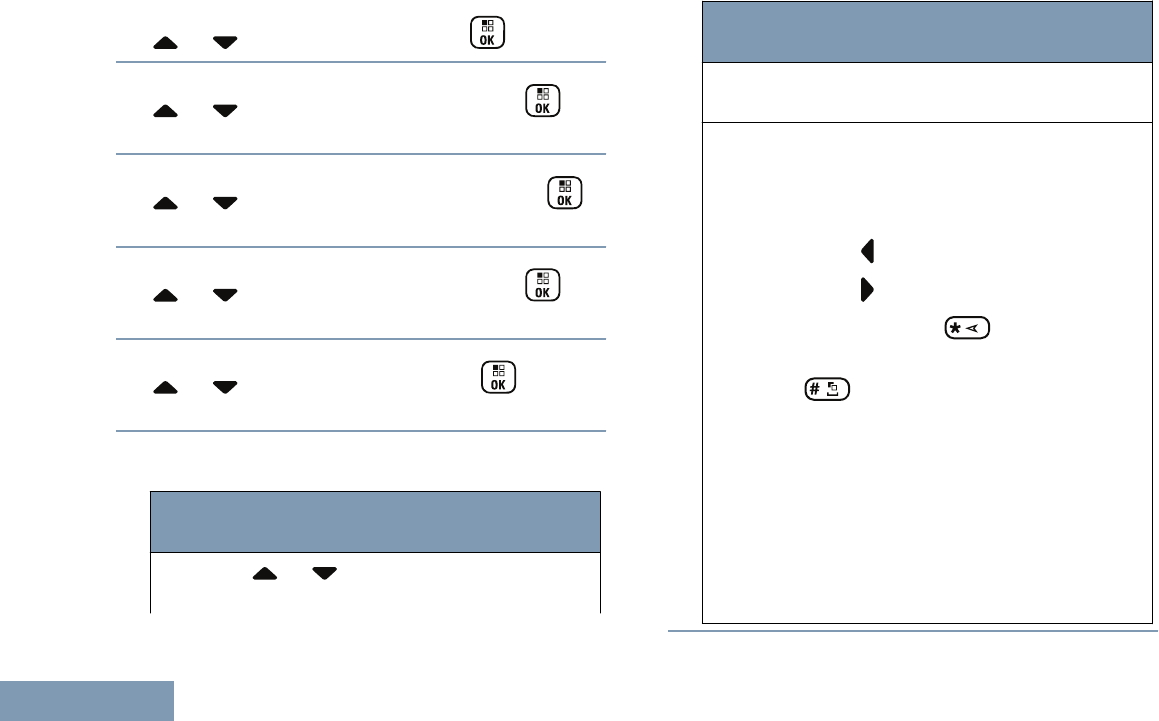
2
or to Utilities and press to select.
3
or to Radio Settings and press to
select.
4
or to Flexible Rx List and press
to select.
5
or to View/Edit List and press to
select.
6
or to Add Member and press to
select.
7Select the required alias or ID by performing one
of the following actions:
Radio
Control
Steps
Radio
Naviga-
or to the required alias or ID.
Radio
Control
Steps
tion But-
tons
Keypad Key in the first character of the re-
quired alias.
A blinking cursor appears.
Press to move one space to the left.
Press to move one space to the
right. Press the key to delete
any unwanted characters. Long press
to change the text entry method.
The first line of the display shows the
characters you keyed in. The next
lines of the display show the short list-
ed search results. The alias search is
case-insensitive. If there are two or
more aliases with the same name, the
radio displays the alias that is listed
first in the list.
Advanced Features in Non-Connect Plus Mode
180
English
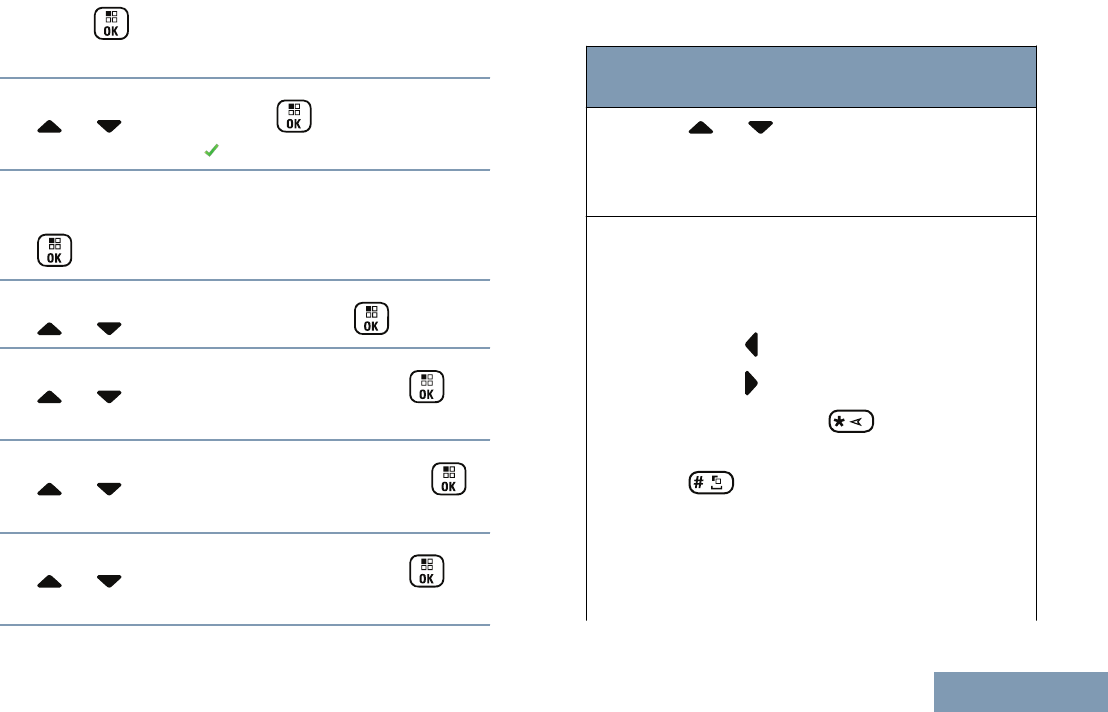
8
Press to select.
The display shows Add Another?.
9
or to No and press to select
The display shows .
Deleting an Entry from the Flexible Receive List
1
to access the menu.
2
or to Utilities and press to select.
3
or to Radio Settings and press to
select.
4
or to Flexible Rx List and press
to select.
5
or to View/Edit List and press to
select.
6Select the required alias or ID by performing one
of the following actions:
Radio
Control
Steps
Radio
Naviga-
tion But-
tons
or to the required alias or ID.
Keypad Key in the first character of the re-
quired alias.
A blinking cursor appears.
Press to move one space to the left.
Press to move one space to the
right. Press the key to delete
any unwanted characters. Long press
to change the text entry method.
The first line of the display shows the
characters you keyed in. The next
lines of the display show the short list-
ed search results. The alias search is
Advanced Features in Non-Connect Plus Mode
181
English
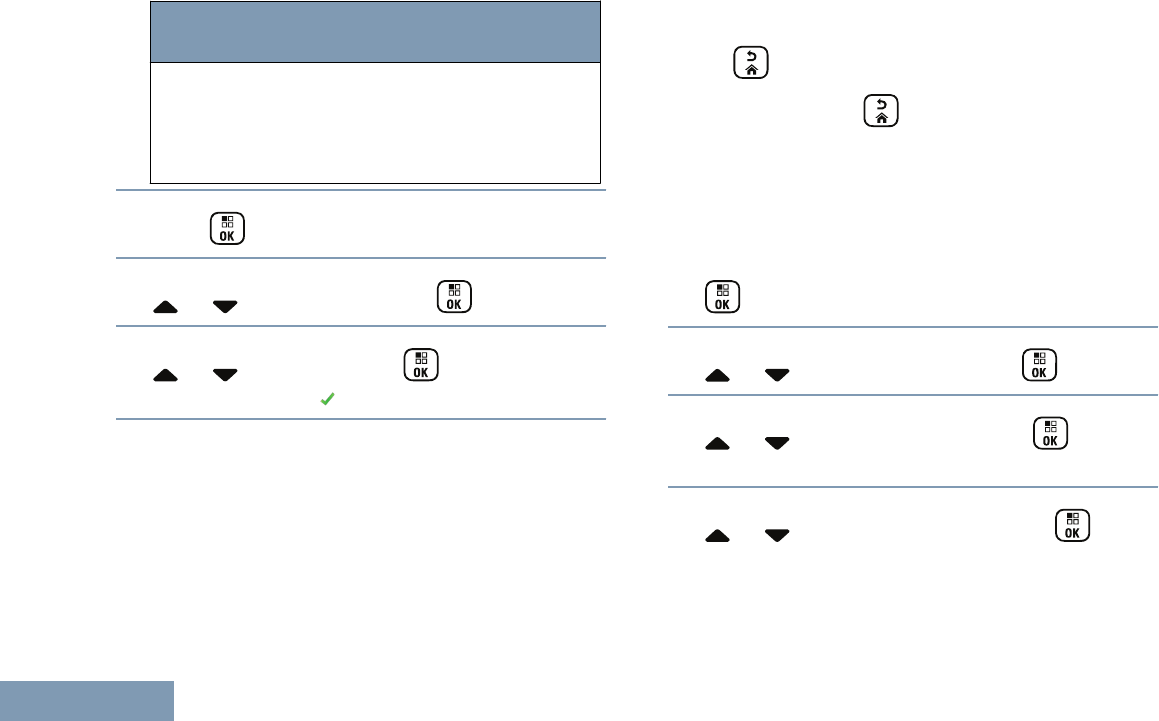
Radio
Control
Steps
case-insensitive. If there are two or
more aliases with the same name, the
radio displays the alias that is listed
first in the list.
7
Press to select.
8
or to Delete and press to select.
9
or to Yes and press to select.
The display shows .
Accessing General Radio Information
Your radio contains information on the following:
• Battery
• Radio Alias and ID
•Firmware and Codeplug Versions
• GPS Information
• Software Update
• Site Information
Press at any time to return to the previous
screen or long press to return to the Home
screen. The radio exits the current screen once the
inactivity timer expires.
Accessing the Battery Information
Displays information on your radio battery.
1
to access the menu.
2
or to Utilities and press to select.
3
or to Radio Info and press to
select.
4
or to Battery Info and press to
select.
The display shows the battery information.
Advanced Features in Non-Connect Plus Mode
182
English
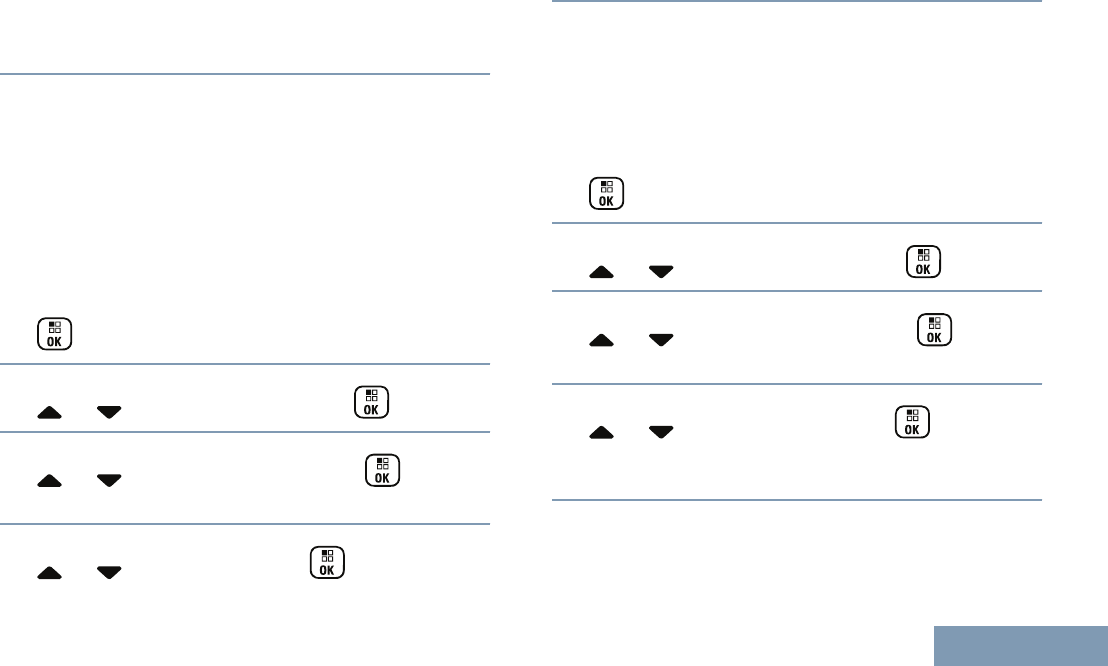
For IMPRES batteries ONLY: The display reads
Recondition Battery if the battery requires
reconditioning in an IMPRES charger. After the
reconditioning process, the display then shows the
battery information.
Checking the Radio Alias and ID
This feature displays the ID of your radio.
Press the programmed Radio Alias and ID button to
check your radio alias and ID. You hear a positive
indicator tone.
Follow the procedure described next to access this
feature via the radio screen.
1
to access the menu.
2
or to Utilities and press to select.
3
or to Radio Info and press to
select.
4
or to My ID and press to select.
The first line of the display shows the radio alias.
The second line of the display shows the radio ID.
You can also press the programmed Radio Alias and
ID button to return to the previous screen.
Checking the Firmware Version and Codeplug
Version
Displays the firmware version on your radio.
1
to access the menu.
2
or to Utilities and press to select.
3
or to Radio Info and press to
select.
4
or to Versions and press to select.
The display shows the current firmware and
codeplug versions.
Advanced Features in Non-Connect Plus Mode
183
English
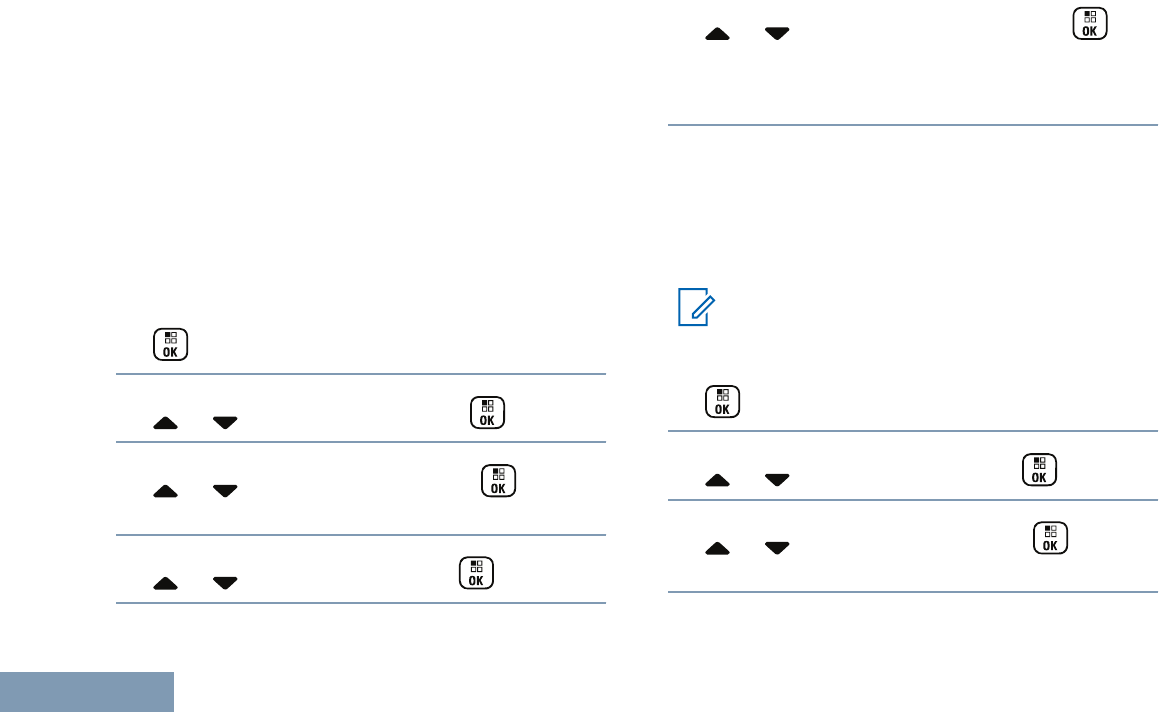
Checking the GPS/GNSS Information
Displays the GPS/GNSS information on your radio,
such as values of:
• Latitude
• Longitude
•Altitude
• Direction
• Velocity
• Horizontal Dilution of Precision (HDOP)
• Satellites
• Version
1
to access the menu.
2
or to Utilities and press to select.
3
or to Radio Info and press to
select.
4
or to GPS Info and press to select.
5
or to the required item and press to
select.
The display shows the requested GPS/GNSS
information.
See Turning GPS/GNSS On or Off on page 172 for
details on GPS/GNSS.
Software Update
Displays the date and time of the latest software
update carried out via Over-the-Air Programming.
Note:
Software Update menu is only available after
at least one successful OTAP session.
1
to access the menu.
2
or to Utilities and press to select.
3
or to Radio Info and press to
select.
Advanced Features in Non-Connect Plus Mode
184
English
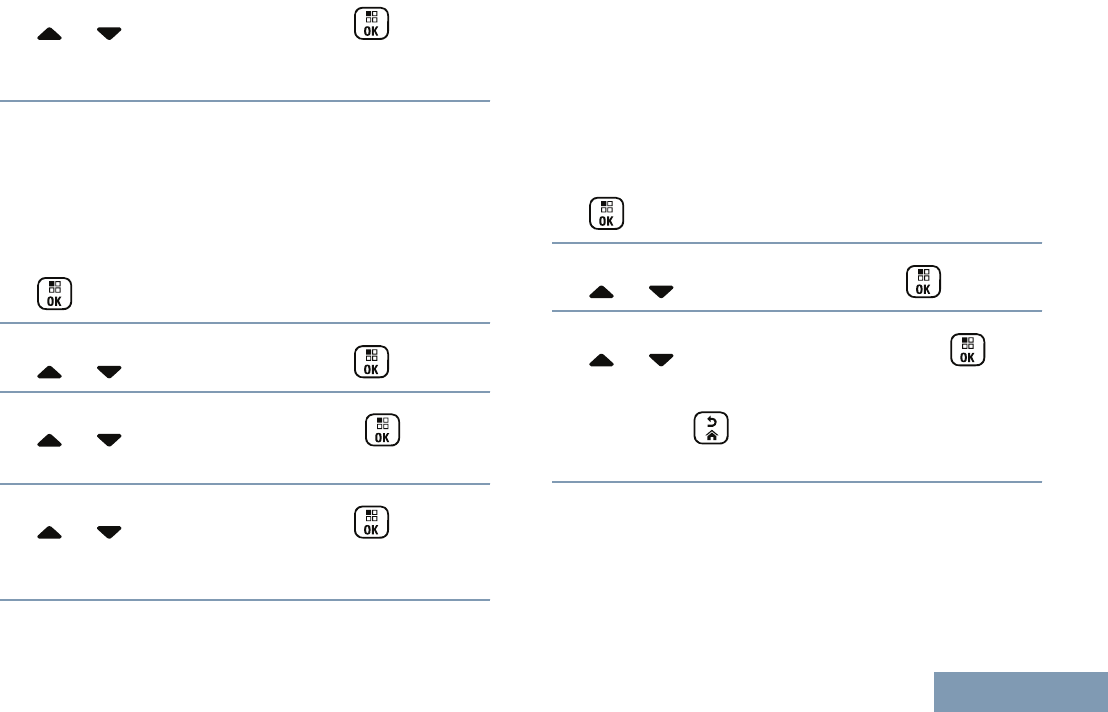
4
or to SW Update and press to select.
The display shows the date and time of the latest
software update.
See Over-the-Air-Programming (OTAP) on page 147
for details on OTAP session.
Site Information
Displays the current Linked Capacity Plus site name
your radio is on.
1
to access the menu.
2
or to Utilities and press to select.
3
or to Radio Info and press to
select.
4
or to Site Info and press to select.
The display shows the current Linked Capacity
Plus site name.
See Linked Capacity Plus on page 48 for details on
Linked Capacity Plus.
Front Panel Configuration (FPC)
Your radio is able to customize certain feature
parameters to enhance the use of your radio.
Entering FPC Mode
1
to access the menu.
2
or to Utilities and press to select.
3
or to Program Radio and press to
select.
Long press at any time to return to the Home
screen.
Editing FPC Mode Parameters
Use the following buttons as required while navigating
through the feature parameters:
Advanced Features in Non-Connect Plus Mode
185
English
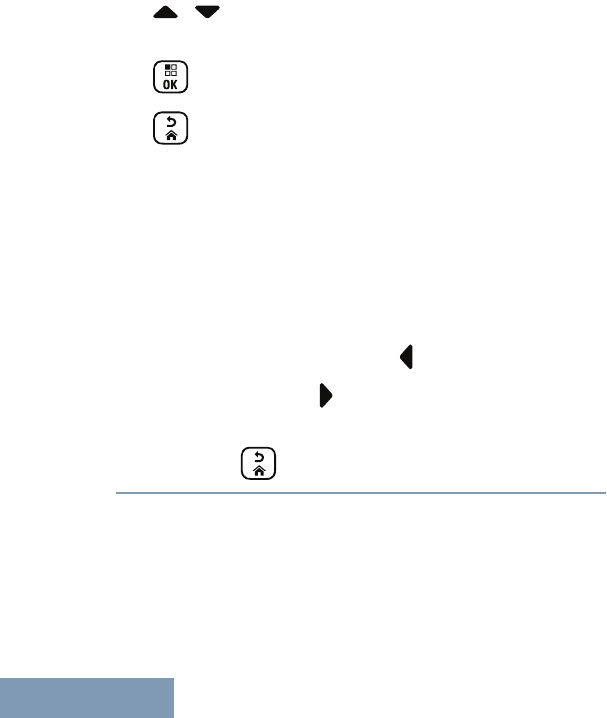
•, – Scroll through options, increase/
decrease values, or navigate vertically.
•
– Select the option or enter a sub-menu.
•
– Short-press to return to previous menu or
to exit the selection screen. Long-press to return
to Home screen.
Checking the RSSI Values
Your radio shows the Received Signal Strength
Indicator (RSSI) icon at the top of your display. This
feature allows you to view the RSSI values.
On the home screen, press three times and
immediately press , all within 5 seconds.
The display shows current RSSI values. Long
press the to return to the Home Screen.
See Display Icons on page 39 for details on RSSI
icon.
Advanced Features in Non-Connect Plus Mode
186
English

Connect Plus Operations
Connect Plus Operations
187
English
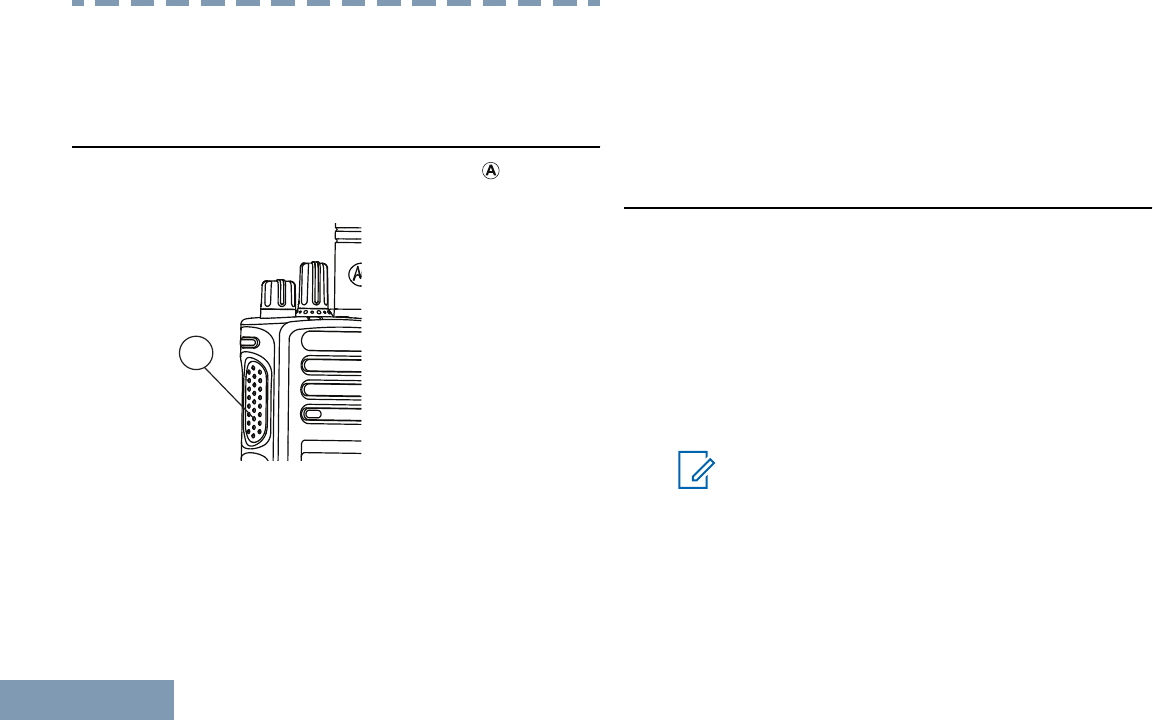
Additional Radio Controls in Connect
Plus Mode
Push-To-Talk (PTT) Button
The PTT button on the side of the radio ( ) serves
two basic purposes:
A
• While a call is in progress, the PTT button allows
the radio to transmit to other radios in the call.
Press and hold the PTT button to talk. Release the
PTT button to listen.
The microphone is activated when the PTT button
is pressed.
• While a call is not in progress, the PTT button is
used to make a new call (see Making a Radio Call
on page 203).
If the Talk Permit Tone (see Turning the Talk Permit
Tone On or Off on page 158) is enabled, wait until the
short alert tone ends before talking.
Programmable Buttons
Your dealer can program the programmable buttons
as shortcuts to radio functions depending on the
duration of a button press:
Short press Pressing and releasing rapidly.
Long press Pressing and holding for the
programmed duration.
Press and hold Keeping the button pressed.
Note:
The programmed duration of a button press is
applicable for all assignable radio/utility
functions or settings. See Emergency
Operation on page 232 for more information
on the programmed duration of the
Emergency button.
Additional Radio Controls in Connect Plus Mode
188
English

Assignable Radio Functions
Beacon On/Off Toggles the Beacon feature on
or off. Requires purchase of
Connect Plus Man Down
feature.
Beacon Reset Resets (cancels) the Beacon
tone, but it does not turn the
Beacon feature off. Requires
purchase of Connect Plus Man
Down feature.
Bluetooth® Audio
Switch
Toggles audio routing between
internal radio speaker and
external Bluetooth-enabled
accessory.
Busy Queue
Cancellation
Exits the busy mode when a
non-Emergency call in the
Busy Queue was initiated.
Emergency calls, once
accepted into the Busy Queue,
cannot be cancelled.
Call Log Selects the call log list.
Contacts Provides direct access to the
Contacts list.
Emergency On/Off Depending on the
programming, initiates or
cancels an emergency.
Intelligent Audio Toggles intelligent audio on or
off.
Man Down Alarms
On/Off
Toggles all configured Man
Down Alarms on or off.
Requires purchase of Connect
Plus Man Down feature.
Man Down Alarms
Reset
If pressed while a Man Down
feature Alert Tone is playing,
the tone is cancelled and
feature timers are reset, but it
does not turn the Man Down
Alarms off. Requires purchase
of Man Down feature.
Manual Dial Depending on the
programming, initiates a
Private or Phone Call by
keying in any subscriber ID or
phone number.
One Touch
Access
Directly initiates a predefined
Private Call, a Call Alert or a
Quick Text message.
Additional Radio Controls in Connect Plus Mode
189
English

Privacy Toggles privacy on or off.
Radio Check Determines if a radio is active
in a system.
Radio Enable Allows a target radio to be
remotely enabled.
Radio Disable Allows a target radio to be
remotely disabled.
Remote Monitor Turns on the microphone of a
target radio without it giving
any indicators.
Roam Request Requests to search for a
different site.
Scan Toggles scan on or off.
Site Lock On/Off When toggled on, the radio
searches the current site only.
When toggled off, the radio
searches other sites in addition
to the current site.
Text Message Selects the text message
menu.
Voice
Announcement for
Channel
Plays zone and channel
announcement voice
messages for the current
channel. This function is
unavailable when Voice
Announcement is disabled.
Voice
Announcement
On/Off
Toggles voice announcement
on or off.
Zone Allows selection from a list of
zones.
Assignable Settings or Utility Functions
AF Suppressor Toggles the Acoustic Feedback
Suppressor feature on or off.
All Tones/Alerts Toggles all tones and alerts on
or off.
Backlight Toggles display backlight on or
off.
Backlight
Brightness
Adjusts the brightness level.
Display Mode Toggles the day/night display
mode on or off.
Additional Radio Controls in Connect Plus Mode
190
English
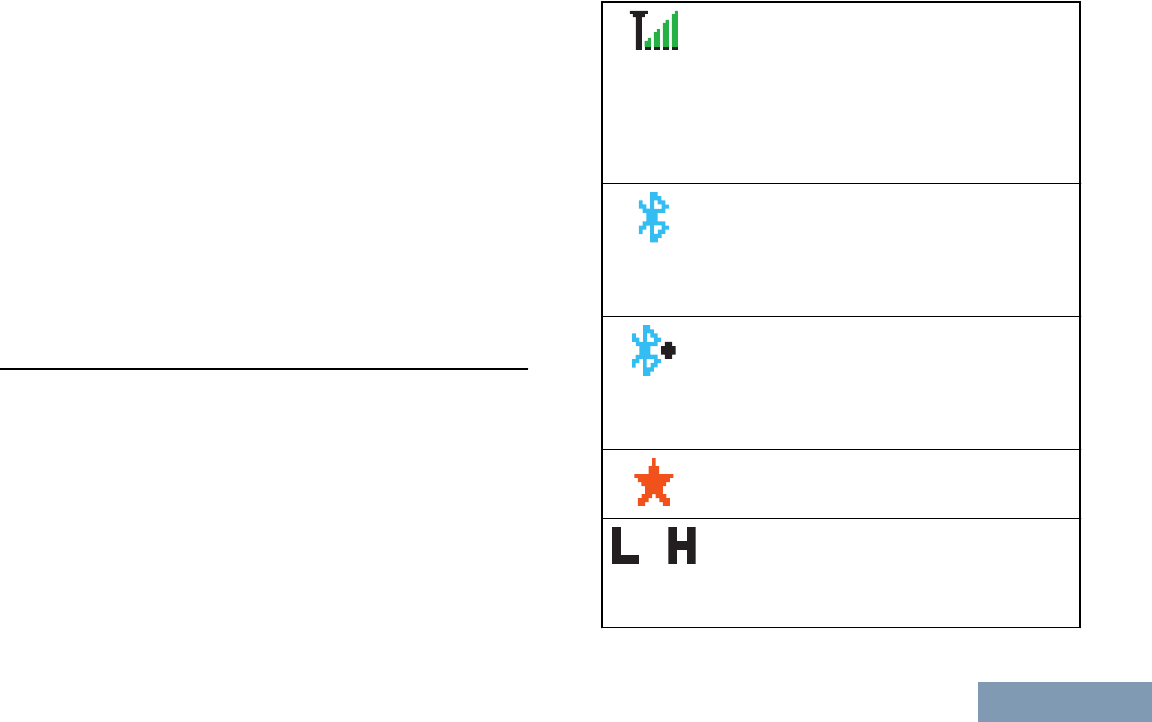
Global
Positioning
System (GPS)
Toggles the satellite navigation
system on or off.
Keypad Lock Toggles keypad between
locked and unlocked.
Power Level Toggles transmit power level
between high and low.
Unassigned Indicates that the button
function has not yet been
assigned.
Identifying Status Indicators in Connect Plus
Mode
Display Icons
The 132 x 90 pixels, 256 colors, liquid crystal display
(LCD) of your radio shows radio status, text entries,
and menu entries.
The following are icons that appear on the display of
the radio. Icons are displayed on the status bar,
arranged left-most in order of appearance/usage and
are channel specific.
Received Signal Strength Indicator
(RSSI)
The number of bars displayed repre-
sents the radio signal strength. Four
bars indicate the strongest signal. This
icon is only displayed while receiving.
Bluetooth
The Bluetooth feature is enabled but
there is no remote Bluetooth device con-
nected.
Bluetooth Connected
The Bluetooth feature is enabled. The
icon stays lit when a remote Bluetooth
device is connected.
Notification List has items to review.
or Power Level
Radio is set at Low power or Radio is
set at High power.
Additional Radio Controls in Connect Plus Mode
191
English
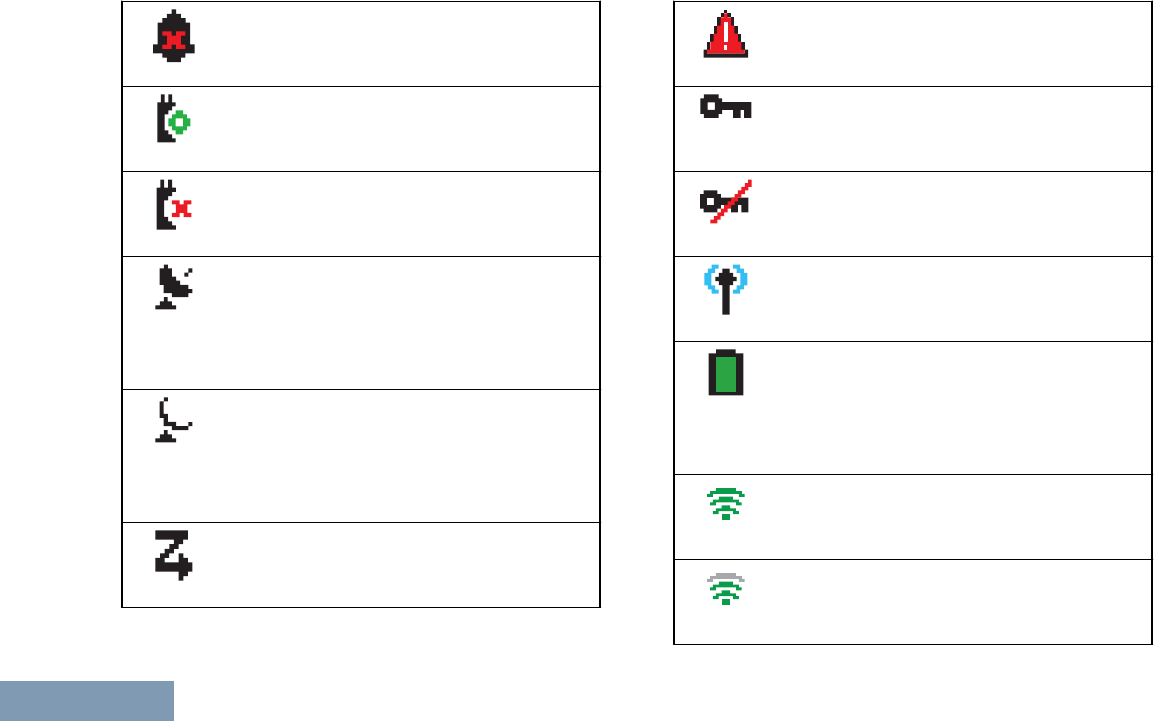
Tones Disable
Tones are turned off.
Option Board
The Option Board is enabled.
Option Board Non-Function
The Option Board is disabled.
GPS/GNSS Available
The GPS/GNSS feature is enabled. The
icon stays lit when a position fix is avail-
able.
GPS/GNSS Not Available/Out of
Range
The GPS/GNSS feature is enabled but
is not receiving data from the satellite.
Scan
Scan feature is enabled.
Emergency
Radio is in Emergency mode.
Secure
The Privacy feature is enabled.
Unsecure
The Privacy feature is disabled.
Site Roaming
The site roaming feature is enabled.
Battery
The number of bars (0 – 4) shown indi-
cates the charge remaining in the bat-
tery. Blinks when the battery is low.
Wi-Fi Excellent[6]
Wi-Fi signal is excellent.
Wi-Fi Good[6]
Wi-Fi signal is good.
Additional Radio Controls in Connect Plus Mode
192
English
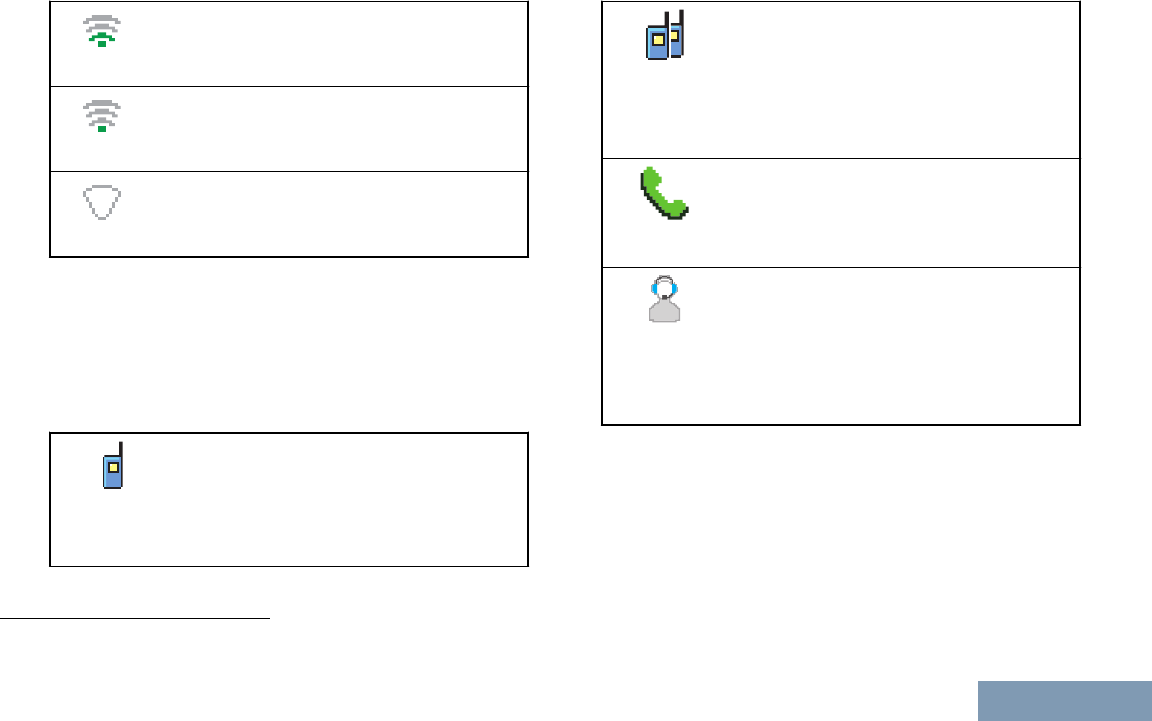
Wi-Fi Average[6]
Wi-Fi signal is average.
Wi-Fi Poor[6]
Wi-Fi signal is poor.
Wi-Fi Unavailable[6]
Wi-Fi signal is unavailable.
Call Icons
The following icons appear on the radio’s display
during a call. These icons also appear in the Contacts
list to indicate ID type.
Private Call
Indicates a Private Call in progress. In
the Contacts list, it indicates a sub-
scriber alias (name) or ID (number).
Group Call/Site All Call
Indicates a Group Call or Site All Call
in progress. In the Contacts list, it indi-
cates a group alias (name) or ID
(number).
Phone Call as Private Call
Indicates a Phone Call as Private Call
in progress.
Dispatch Call
The Dispatch Call contact type is used
to send a text message to a dispatch-
er PC through a third-party Text Mes-
sage Server.
Advanced Menu Icons
The following icons appear beside menu items that
offer a choice between two options or as an indication
that there is a sub-menu offering two options.
6Only applicable for XPR 7550e/XPR 7580e
Additional Radio Controls in Connect Plus Mode
193
English
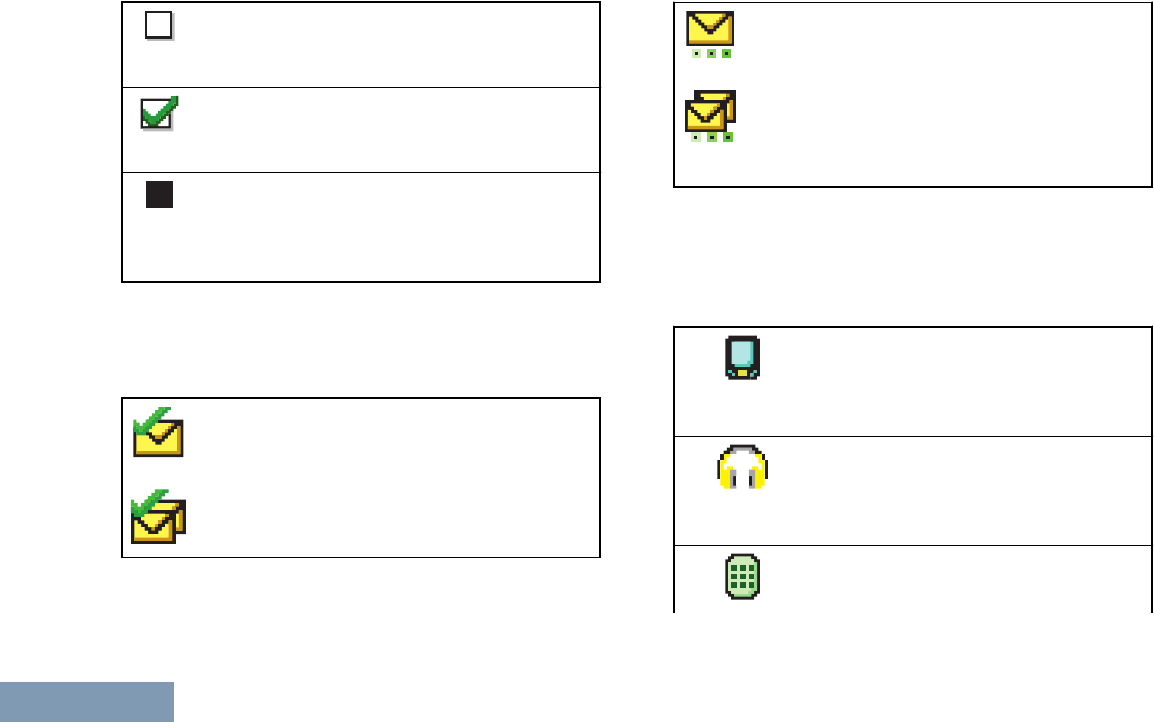
Checkbox (Empty)
Indicates the option is not selected.
Checkbox (Checked)
Indicates the option is selected.
Solid Black Box
Indicates the option selected for the menu
item with a sub-menu.
Sent Item Icons
The following icons appear at the top right corner of
the radio’s display in the Sent Items folder.
OR
Sent Successfully
The text message is sent successfully.
OR
In-Progress
• The text message to a group alias or ID
is pending transmission.
• The text message to a subscriber alias
or ID is pending transmission, followed
by waiting for acknowledgement.
Bluetooth Device Icons
The following icons also appear next to items in the
list of Bluetooth-enabled devices available to indicate
the device type.
Bluetooth Data Device
Bluetooth-enabled data device, such
as a scanner.
Bluetooth Audio Device
Bluetooth-enabled audio device,
such as a headset.
Bluetooth PTT Device
Additional Radio Controls in Connect Plus Mode
194
English
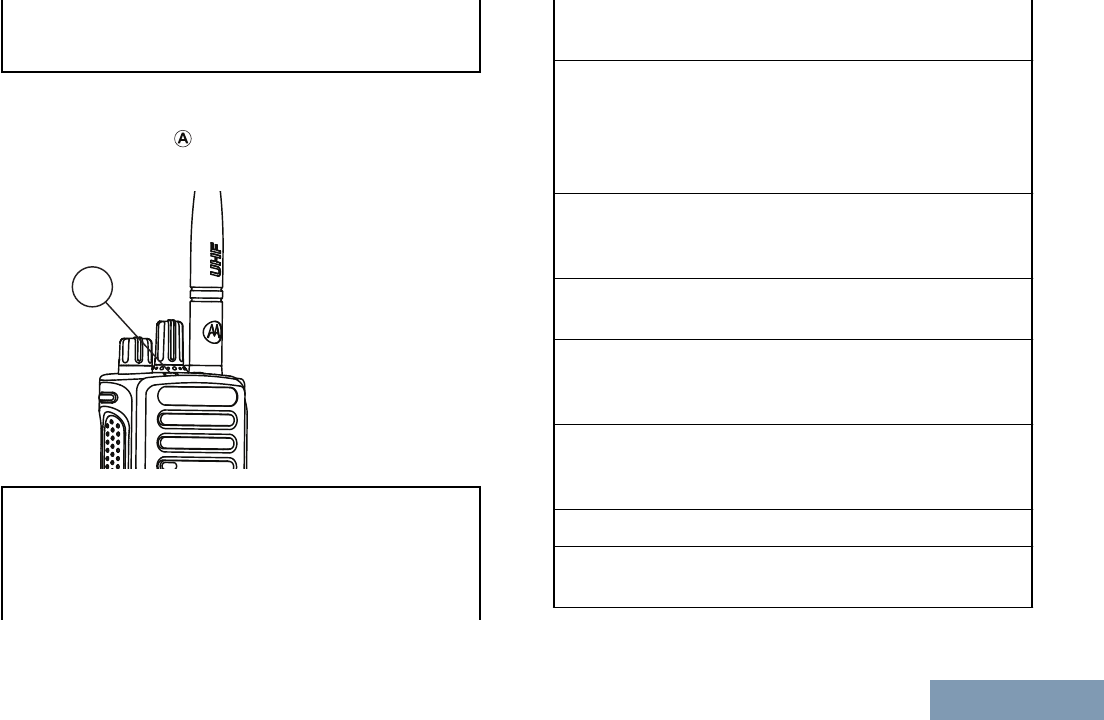
Bluetooth-enabled PTT device, such
as a PTT-Only Device (POD).
LED Indicator
The LED indicator ( ) shows the operational status of
your radio.
A
Blinking red Battery mismatch occurs or radio is
transmitting at low battery condition,
receiving an emergency transmis-
sion or has failed the self-test upon
powering up, or has moved out of
range if radio is configured with Au-
to-Range Transponder System.
Rapidly
blinking red
Radio is receiving over-the-air file
transfer (Option Board firmware file,
Network Frequency file or Option
Board Codeplug file) or upgrading to
a new Option Board firmware file.
Blinking
green and
yellow
Radio is receiving a Call Alert, re-
ceived a text message or Scan is en-
abled and is receiving activity.
Solid yellow Radio is in Bluetooth Discoverable
Mode.
Double
blinking yel-
low
Radio is actively searching for a new
site.
Blinking yel-
low
Radio is receiving a Call Alert or
Scan is enabled and is idle (radio will
remain muted to any activity).
Solid green Radio is powering up or transmitting.
Blinking
green
Radio is powering up, receiving a
non-privacy- enabled call or data.
Additional Radio Controls in Connect Plus Mode
195
English
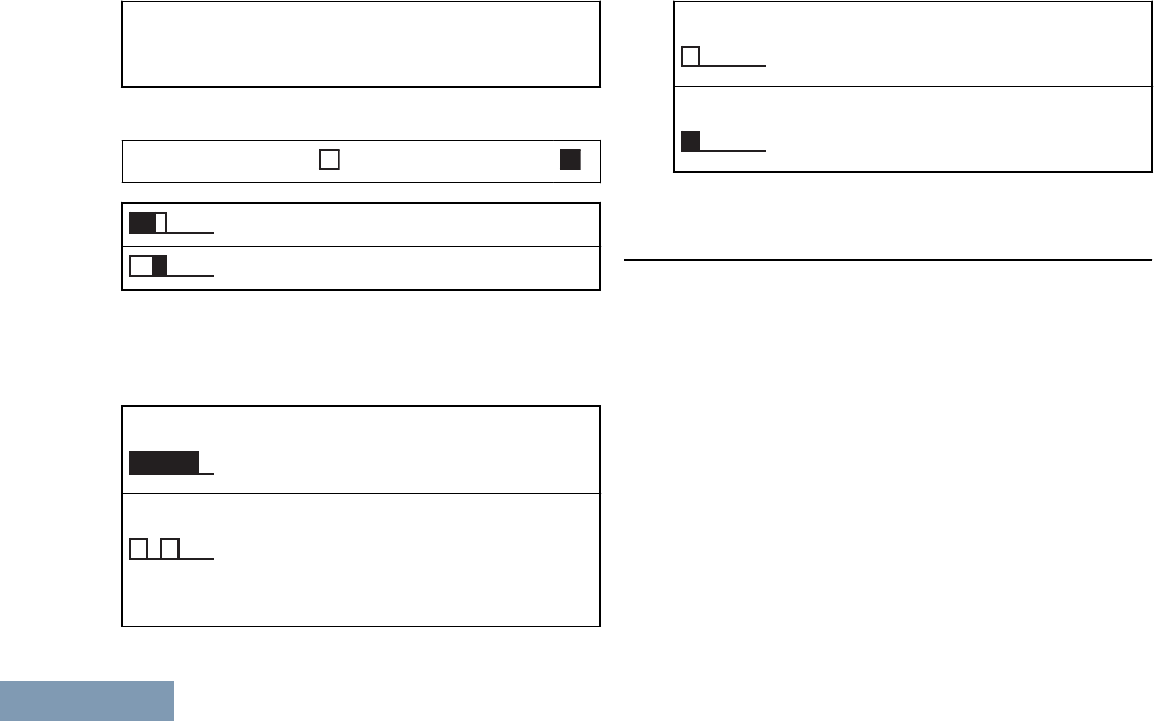
Double
blinking
green
Radio is receiving a privacy-enabled
call.
Indicator Tones
High pitched tone Low pitched tone
Positive Indicator Tone
Negative Indicator Tone
Alert Tones
Alert tones provide you with audible indications of the
status, or response to data received on the radio.
Continuous Tone A monotone sound.
Sounds continuously un-
til termination.
Periodic Tone Sounds periodically de-
pending on the duration
set by the radio. Tone
starts, stops, and repeats
itself.
Repetitive Tone A single tone that re-
peats itself until it is ter-
minated by the user.
Momentary Tone Sounds only once for a
short period of time de-
fined by the radio.
Switching Between Connect Plus and Non-
Connect Plus Modes
To switch to a non-Connect Plus mode, you must
change to another zone, if programmed by your
dealer or system administrator. Check with your
dealer or system administrator to see if your radio has
been programmed with non-Connect Plus zones, and
what features are available while operating in non-
Connect Plus zones.
Additional Radio Controls in Connect Plus Mode
196
English

Making and Receiving Calls in Connect
Plus Mode
Selecting a Site
A site provides coverage for a specific area. A
Connect Plus site has a site controller and a
maximum of 15 repeaters. In a multi-site network, the
Connect Plus radio will automatically search for a new
site when the signal level from the current site drops
to an unacceptable level.
Roam Request
A Roam Request tells the radio to search for a
different site, even if the signal from the current site is
acceptable.
If there are no sites available,
•The radio display shows Searching and
continues to search through the list of sites.
• The radio will return to the previous site, if the
previous site is still available.
Note:
This is programmed by your dealer.
Press the programmed Roam Request button.
You hear a tone, indicating the radio has switched
to a new site. The display shows Site ID <Site
Number>.
Site Lock On/Off
When toggled on, the radio searches the current site
only. When toggled off, the radio searches other sites
in addition to the current site.
Press the programmed Site Lock button.
• You hear a positive indicator tone, indicating
the radio has locked to the current site. The
display shows Site Locked.
•You hear a negative indicator tone, indicating
the radio is unlocked. The display shows Site
Unlocked.
Site Restriction
Your Connect Plus radio system administrator has the
ability to decide which network sites your radio is and
is not allowed to use. Your radio does not need to be
reprogrammed to change the list of allowed and
disallowed sites. If your radio attempts to register at a
disallowed site, you see a brief message stating:
Making and Receiving Calls in Connect Plus Mode
197
English
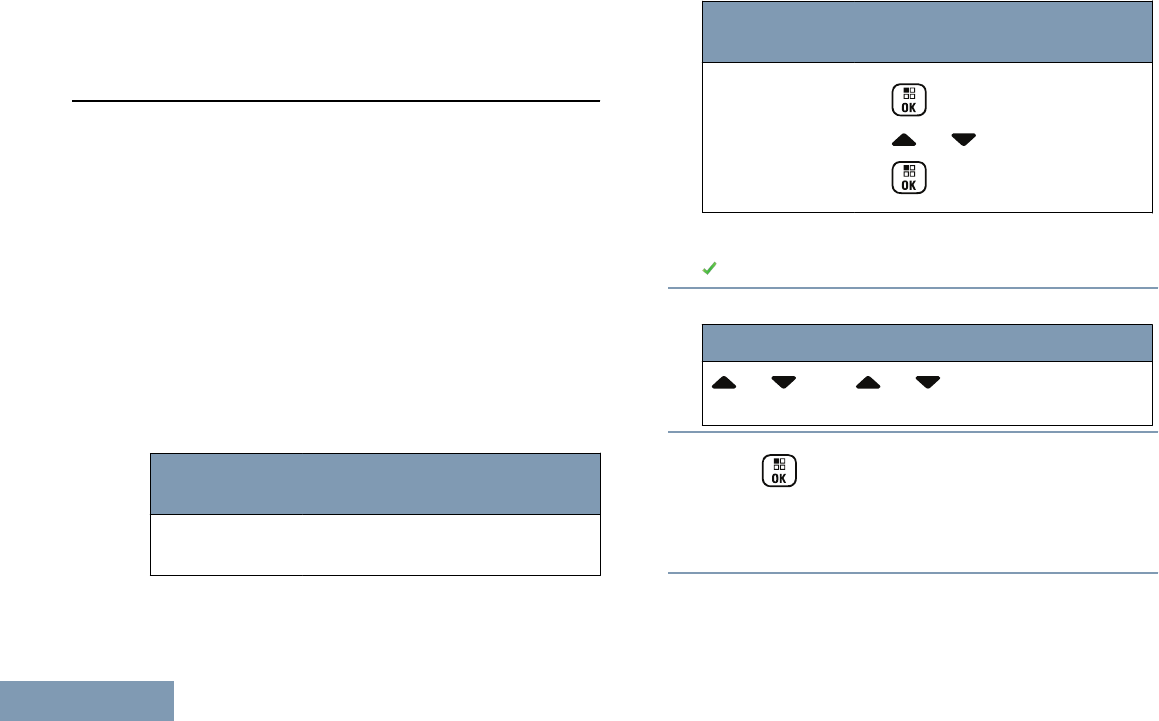
Site <number given> Not Allowed. The radio
then searches for a different network site.
Selecting a Zone
The radio can be programmed with a maximum of 16
Connect Plus Zones and each Connect Plus zone
contains a maximum of 16 assignable positions on
the Channel Selector Knob.
Each assignable knob position can be used to start
one of the following voice call types:
• Group Call
• Multigroup Call
• Site All Call
• Private Call
1Access the Zone feature by performing one of the
following actions:
Radio Con-
trols
Steps
Programmed
Zone button
Press the programmed Zone
button.
Radio Con-
trols
Steps
Radio menu 1
to access the menu.
2 or to Zone and press
to select.
The current zone is displayed and indicated by a
.
2Select the required zone.
Radio Control Steps
or or and scroll to the re-
quired zone.
3
Press to select.
The display shows <Zone> Selected
momentarily and returns to the selected zone
screen.
Making and Receiving Calls in Connect Plus Mode
198
English
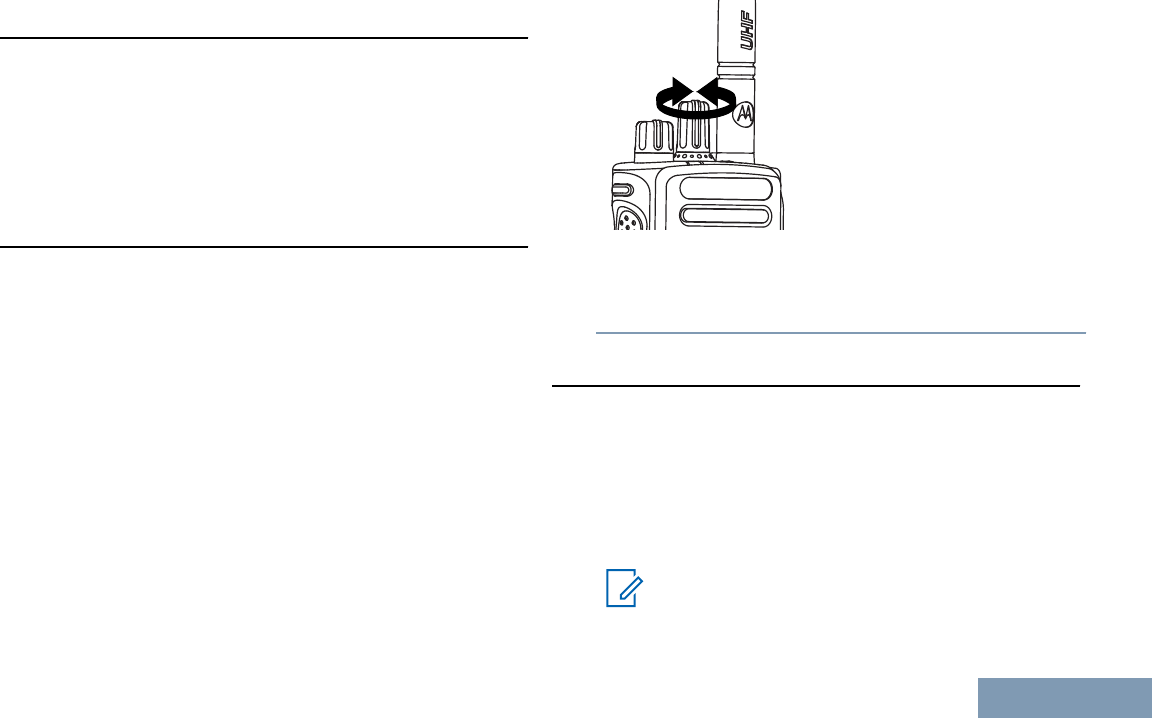
Using Multiple Networks
If your radio has been programmed to use multiple
Connect Plus networks, you can select a different
network by switching to the Connect Plus zone that is
assigned to the desired network. These network-to-
zone assignments are configured by your dealer
through radio programming.
Selecting a Call Type
Use the Channel Selector Knob to select a call type.
This can be a Group Call, Multi-group Call, Site All
Call or Private Call, depending on how your radio is
programmed. If you change the Channel Selector
Knob to a different position (that has a call type
assigned to it), this causes the radio to re-register
with the Connect Plus site. The radio registers with
the Registration Group ID that has been programmed
for the new Channel Selector Knob position call type.
If you select a position that has no call type assigned
to it, your radio sounds a continuous tone and the
display shows Unprogrammed. Your radio does not
operate when selected to an unprogrammed channel,
use the Channel Selector Knob to select a
programmed channel instead.
Once the required zone is displayed (if you have
multiple zones in your radio), turn the programmed
Channel Selector Knob to select the call type.
Receiving and Responding to a Radio Call
Once the channel, subscriber ID or call type is
displayed, you can proceed to receive and respond to
calls.
The LED lights up solid green while the radio is
transmitting and blinks green when the radio is
receiving.
Note:
The LED lights up solid green while the radio
is transmitting and double blinks green when
Making and Receiving Calls in Connect Plus Mode
199
English
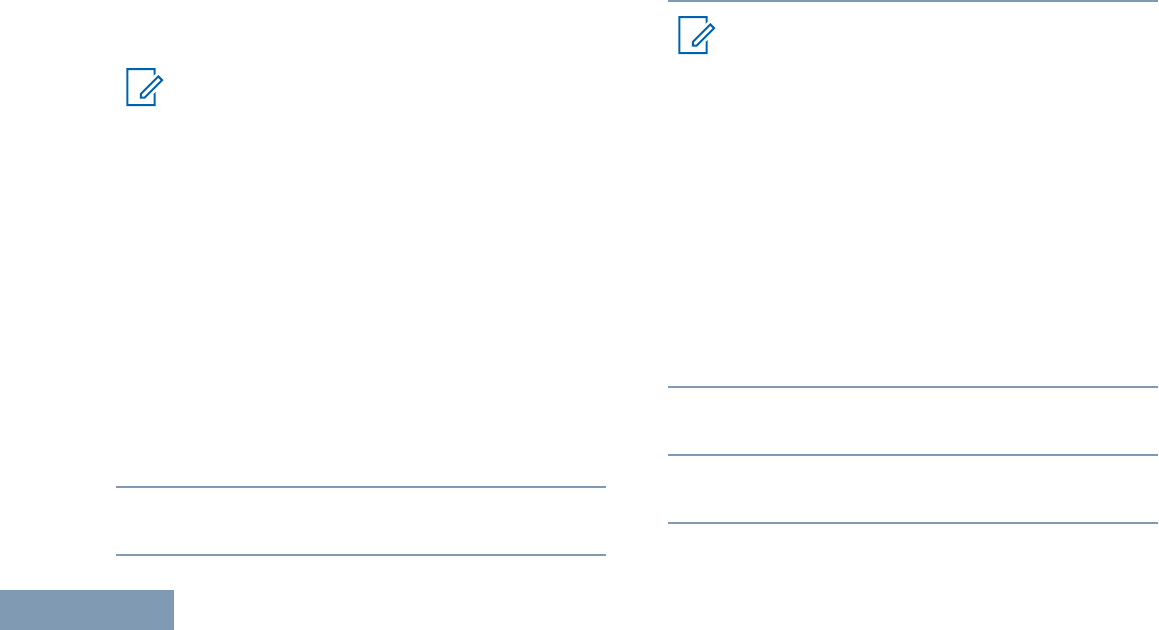
the radio is receiving a privacy-enabled call.
To unscramble a privacy-enabled call, your
radio must have the same Privacy Key, OR
the same Key Value and Key ID (programmed
by your dealer), as the transmitting radio (the
radio you are receiving the call from).
Note:
See Privacy on page 257 for more
information.
Receiving and Responding to a Group Call
To receive a call from a group of users, your radio
must be configured as part of that group.
When you receive a Group Call (while on the Home
screen), the LED blinks green.The Group Call icon
appears in the top right corner. The first text line
shows the caller alias. The second text line displays
the group call alias. Your radio unmutes and the
incoming call sounds through the radio's speaker.
1Hold the radio vertically 1 to 2 inches (2.5 to 5.0
cm) from your mouth.
The LED lights up solid green.
2Wait for one of the Talk Permit Tone to finish (if
enabled), and speak clearly into the microphone.
3Release the PTT button to listen.
If there is no voice activity for a predetermined
period of time, the call ends.
Note:
See Making a Group Call on page 203 for
details on making a Group Call.
Receiving and Responding to a Private Call
A Private Call is a call from an individual radio to
another individual radio.
When you receive a Private Call, the LED blinks
green. The Private Call icon appears in the top right
corner. The first text line shows the caller alias. Your
radio unmutes and the incoming call sounds through
the speaker of the radio.
1Hold the radio vertically 1 to 2 inches (2.5 to 5.0
cm) from your mouth.
2Press the PTT button to respond to the call.
The LED lights up solid green.
3Wait for the Talk Permit Tone to finish (if enabled),
and speak clearly into the microphone.
Making and Receiving Calls in Connect Plus Mode
200
English
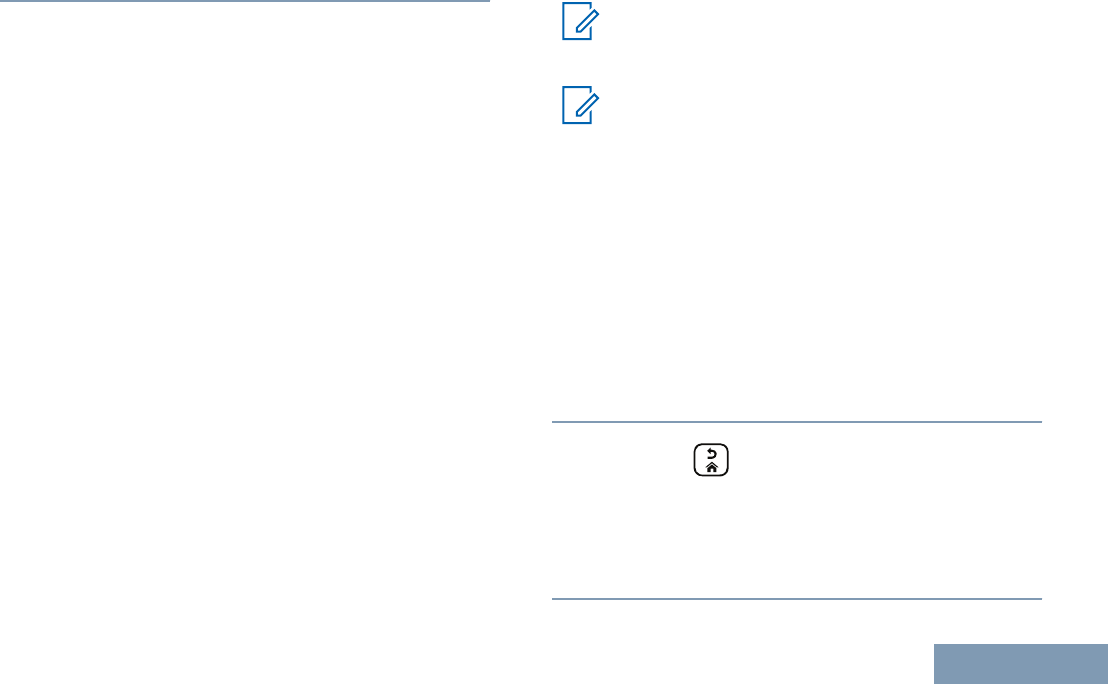
4Release the PTT button to listen.
If there is no voice activity for a predetermined period
of time, the call ends.
You hear a short tone. The display shows Call
Ended.
See Making a Private Call on page 204 for details on
making a Private Call.
Receiving a Site All Call
A Site All Call is a call from an individual radio to
every radio on the site. It is used to make important
announcements requiring the user’s full attention.
When you receive an Site All Call, a tone sounds and
the LED blinks green.
The Group Call icon appears in the top right corner.
The first text line shows the caller alias. The second
text line displays Site All Call. Your radio
unmutes and the incoming call sounds through the
radio speaker.
Once the Site All Call ends, the radio returns to the
previous screen before receiving the call. A Site All
Call does not wait for a predetermined period of time
before ending.
You cannot respond to an Site All Call.
Note:
See Making a Site All Call on page 205 for
details on making a Site All Call.
Note:
The radio stops receiving the Site All Call if
you switch to a different channel while
receiving the call. During a Site All Call, you
will not be able to use any programmed button
functions until the call ends.
Receiving an Inbound Private Phone Call
When you receive an Inbound Private Phone Call, the
Phone Call as Private Call icon appears in the top
right corner. The first text line shows Phone Call.
1Press and hold the PTT button to answer and talk.
Release the PTT button to listen.
2
Long press to end the call.
The first line of the display shows Ending. The
second line of the display shows Phone Call....
The display returns to the Phone Call screen.
The display shows Phone Call Ended.
Making and Receiving Calls in Connect Plus Mode
201
English
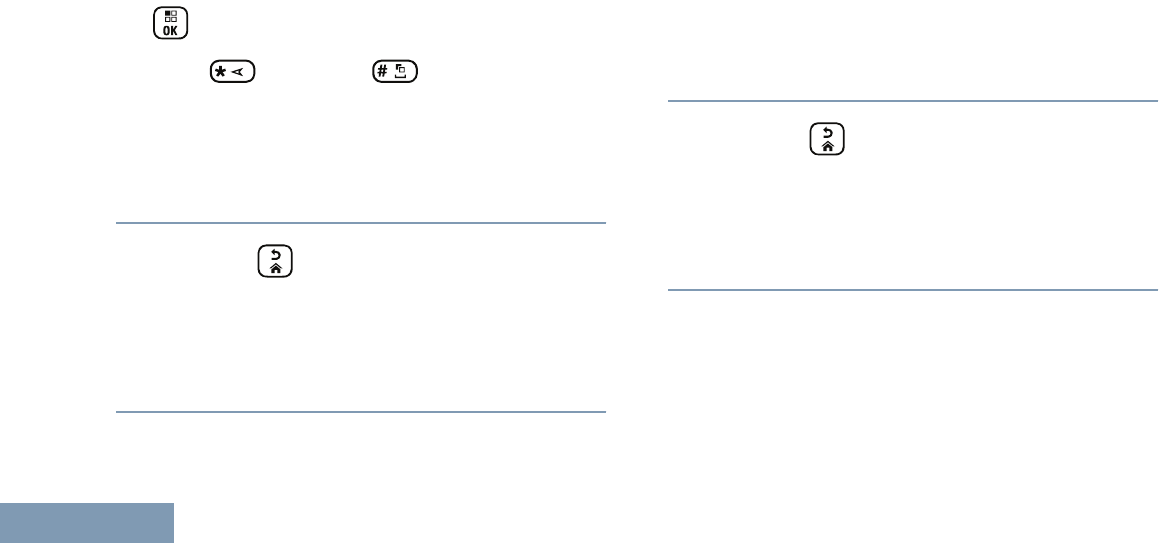
Making a Buffered Over-Dial in an Inbound Phone
Private Call
During the call, the Phone Call as Private Call icon
appears in the top right corner. The first text line of
the display shows Phone Call.
1Use the keypad to enter the digits and press the
button.
Press followed by within 2 seconds to
insert a pause. The P replaces * and # on the
display.
The Phone Call as Private Call icon appears in the
top right corner. The first text line of the display
shows the entered digits.
2
Long press to end the call.
The first line of the display shows Ending. The
second line of the display shows Phone Call....
The display returns to the Phone Call screen.
The display shows Phone Call Ended.
Making a Live Over-Dial in an Inbound Phone
Private Call
During the call, the Phone Call as Private Call icon
appears in the top right corner. The first text line of
the display shows Phone Call.
1Press the PTT button and use the keypad to enter
the digits.
The Phone Call as Private Call icon appears in the
top right corner. The first text line of the display
shows the Live Dial digits.
2
Long press to end the call.
The first line of the display shows Ending. The
second line of the display shows Phone Call....
The display returns to the Phone Call screen.
The display shows Phone Call Ended.
Receiving an Inbound Phone Talkgroup Call
When you receive an Inbound Phone Talkgroup Call,
the Group Call icon appears in the top right corner.
The first text line shows Call1.
Making and Receiving Calls in Connect Plus Mode
202
English
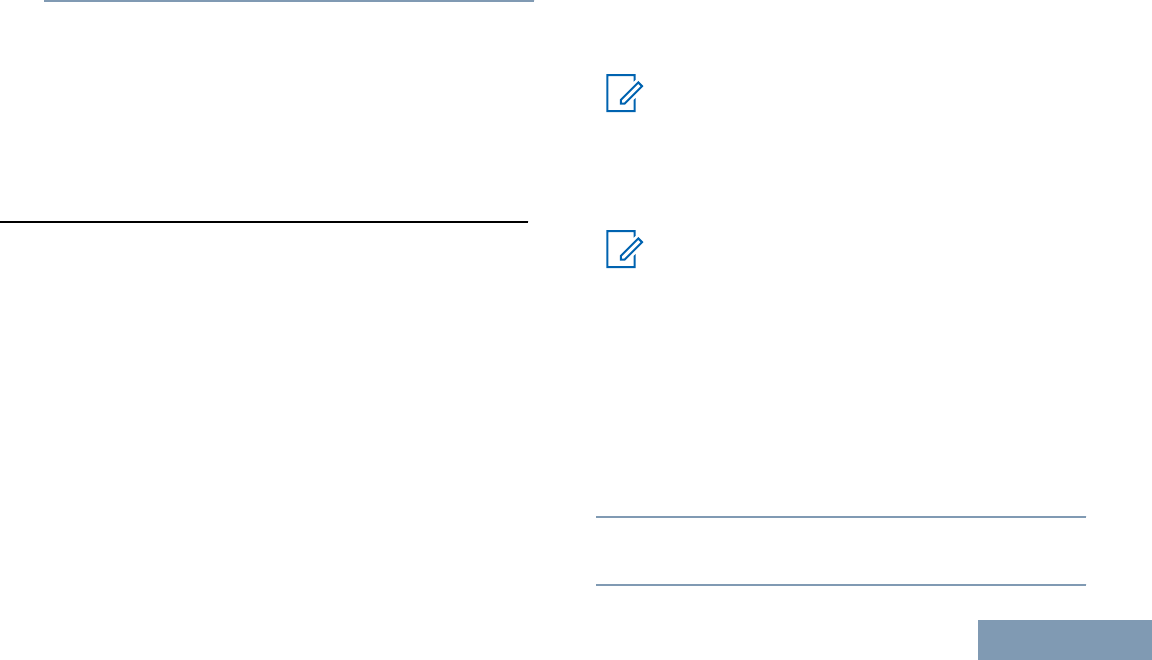
Press the PTT button to talk and release it to
listen.
Inbound Phone Multi-Group Call
When you receive an Inbound Phone Multi-Group
Call, the Group Call icon appears in the top right
corner. The first text line shows Multigroup Call.
The radio unmutes and the incoming multi-group call
sounds through the radio's speaker.
Making a Radio Call
After selecting your channel, you can select a
subscriber alias or ID, or group alias or ID by using:
• The Channel Selector Knob.
• A programmed One Touch Access button – The
One Touch Access feature allows you to make a
Private Call to a predefined ID easily. This feature
can be assigned to a short or long programmable
button press. You can ONLY have one ID
assigned to a One Touch Access button. Your
radio can have multiple One Touch Access
buttons programmed.
• The Contacts list (see Contacts Settings on page
222).
• Manual Dial – This method is for Private Calls only
and is dialed using the keypad (see Making a
Private Call from Contacts on page 223, and
Making a Call with the Programmable Manual Dial
Button on page 206).
Note:
Your radio must have the Privacy feature
enabled on the channel to send a privacy-
enabled transmission. Only target radios with
the same Key Value and Key ID as your radio
will be able to unscramble the transmission.
Note:
See Privacy on page 257 for more
information.
Making a Call with the Channel Selector Knob
Making a Group Call
To make a call to a group of users, your radio must
be configured as part of that group.
1Select the channel with the active group alias or
ID. See Selecting a Call Type on page 199.
2Hold the radio vertically 1 to 2 inches (2.5 to 5.0
cm) from your mouth.
Making and Receiving Calls in Connect Plus Mode
203
English

3Press the PTT button to make the call.
The LED lights up solid green. The Group Call
icon appears in the top right corner. The first text
line shows the group call alias.
4Wait for the Talk Permit Tone to finish (if enabled),
and speak clearly into the microphone.
5Release the PTT button to listen.
When the target radio responds, the LED blinks
green, the radio unmutes and the response
sounds through the radio’s speaker. You see the
Group Call icon, the group alias or ID, and
transmitting radio alias or ID on your display.
If there is no voice activity for a predetermined
period of time, the call ends. Radio returns to the
screen you were on prior to initiating the call.
Making a Private Call
While you can receive and/or respond to a Private
Call initiated by an authorized individual radio, your
radio must be programmed for you to initiate a Private
Call.
You will hear a negative indicator tone, when you
make a Private Call via the Contacts list, Call Log,
One Touch Access button, or the Channel Selector
Knob, if this feature is not enabled.
Use the Text Message or Call Alert features to
contact an individual radio. See Text Message
Features on page 244 or Call Alert Operation on
page 101 for more information.
1Do one of the following.
• Select the channel with the active subscriber
alias or ID. See Selecting a Call Type on page
199.
• Press the programmed One Touch Access
button.
2Hold the radio vertically 1 to 2 inches (2.5 to 5.0
cm) from your mouth.
3Press the PTT button to make the call.
The LED lights up solid green. The Private Call
icon appears on the top right corner. The first text
line shows the target subscriber alias. The second
text line displays the call status.
4Wait for the Talk Permit Tone to finish (if enabled),
and speak clearly into the microphone.
Making and Receiving Calls in Connect Plus Mode
204
English

5Release the PTT button to listen.
When the target radio responds, the LED blinks
green.
If there is no voice activity for a predetermined
period of time, the call ends. You hear a short
tone. The display shows Call Ended.
Your radio may be programmed to perform a radio
presence check prior to setting up the Private Call. If
the target radio is not available, you hear a short tone
and see negative mini notice on the display.
Making a Site All Call
This feature allows you to transmit to all users on the
site that are currently not engaged in another call.
Your radio must be programmed to allow you to use
this feature.
Users on the channel/site cannot respond to an Site
All Call.
1Select the channel with the active Site All Call
group alias. See Selecting a Call Type on page
199.
2Hold the radio vertically 1 to 2 inches (2.5 to 5.0
cm) from your mouth.
3Press the PTT button to make the call.
The LED lights up solid green. The Group Call
icon appears in the top right corner. The first text
line shows Site All Call.
4Wait for the Talk Permit Tone to finish (if enabled),
and speak clearly into the microphone.
Making a Multi-group Call
This feature allows you to transmit to all users on
multiple groups. Your radio must be programmed to
allow you to use this feature.
Note:
Users on the groups cannot respond to a
Multi-group Call.
1Turn the Channel Selector Knob to select the
Multi-group alias or ID.
2Press the PTT button to make the call.
The LED lights up solid green. The display shows
the Multi-group alias or ID.
Wait for the Talk Permit Tone to finish (if enabled)
and speak clearly into the microphone.
Making and Receiving Calls in Connect Plus Mode
205
English

Making a Private Call with a One Touch Call Button
Note:
Programmable buttons press must be initiated
from the Home screen.
The One Touch Call feature allows you to easily
make a Private Call to a pre-defined Private Call alias
or ID. This feature can be assigned to a short or long
programmable button press.
You can ONLY have one alias or ID assigned to a
One Touch Call button. Your radio can have multiple
One Touch Call buttons programmed.
1Press the programmed One Touch Call button to
make a Private Call to the pre-defined Private Call
alias or ID.
2Hold the radio vertically 1 to 2 inches (2.5 to 5.0
cm) from your mouth.
3Press the PTT button to make the call.
The LED lights up solid green.
The display shows the Private Call alias or ID.
4Wait for the Talk Permit Tone to finish (if enabled)
and speak clearly into the microphone.
5Release the PTT button to listen.
When the target radio responds, the LED blinks
green.
If there is no voice activity for a predetermined
period of time, the call ends.
Making a Call with the Programmable Manual Dial
Button
Making a Private Call
1Press the programmed Manual Dial button to
enter into the Manual Dial screen.
The display shows Number:.
2Use the keypad to enter a subscriber alias or
Private ID.
3Hold the radio vertically 1 to 2 inches (2.5 to 5.0
cm) from your mouth.
4Press the PTT button to make the call.
The LED lights up solid green. The Private Call
icon appears in the top right corner. The first text
Making and Receiving Calls in Connect Plus Mode
206
English
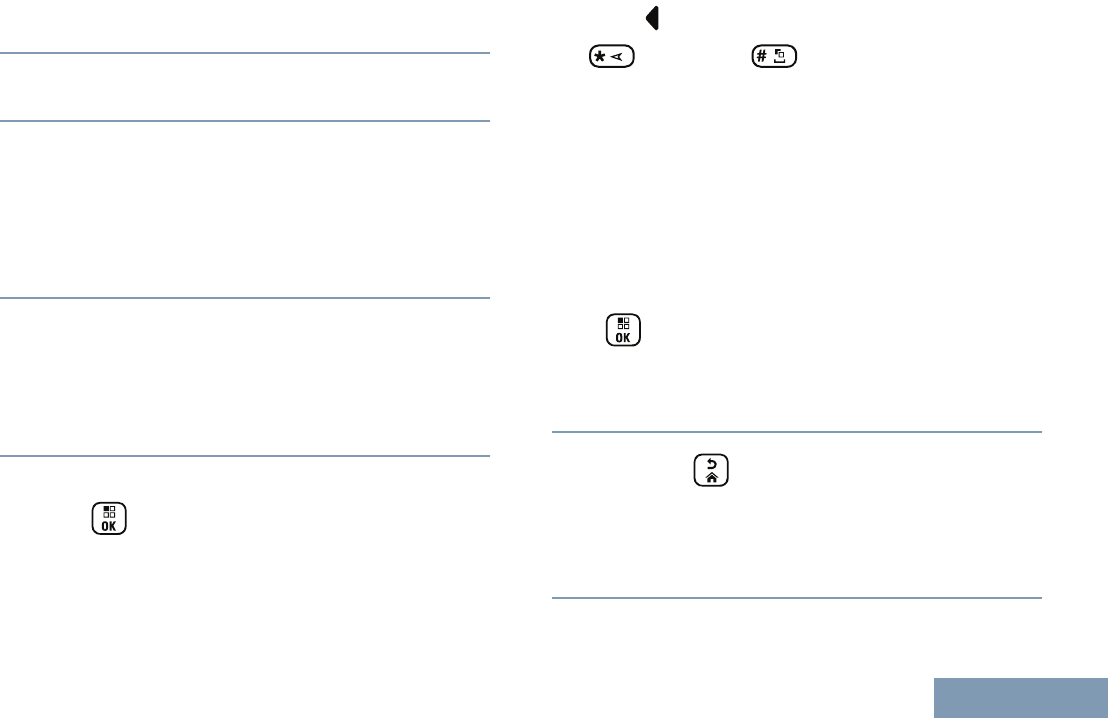
line shows the subscriber alias. The second text
line displays the call status.
5Wait for the Talk Permit Tone to finish (if enabled)
and speak clearly into the microphone.
6Release the PTT button to listen.
When the target radio responds, the LED blinks
green.
If there is no voice activity for a predetermined
period of time, the call ends. You hear a short
tone. The display shows Call Ended.
Making an Outbound Private Phone Call with the
Programmable Manual Dial Button
1Press the programmed Manual Dial button to
enter into the Manual Dial screen.
The display shows Number:.
2Use the keypad to enter a telephone number, and
press to place a call to the entered number.
Press to delete any unwanted characters. Press
followed by within 2 seconds to insert
a pause. The P replaces * and # on the display.
If successful, the first line of the display shows
Phone Call. The second line of the display shows
the dialed telephone number.
If an invalid telephone number is selected, the
display shows a negative mini notice, Phone Call
Failed, Resource Not Available, or Invalid
Permissions.
If is pressed with no telephone number
entered, the radio sounds a positive indicator tone
then a negative indicator tone. The display
remains the same.
3
Long press to end the call.
The first line of the display shows Ending. The
second line of the display shows Phone Call....
The display shows Phone Call Ended.
Making and Receiving Calls in Connect Plus Mode
207
English
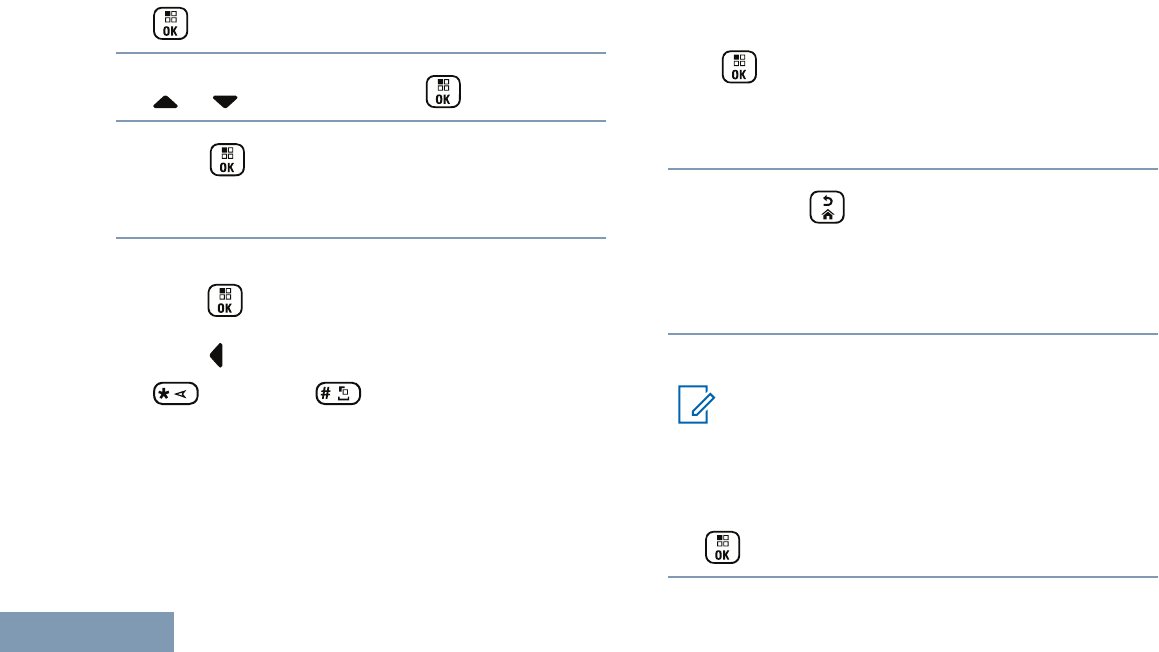
Making an Outbound Private Phone Call via the Phone
Menu
1
to access the menu.
2
or to Phone and press to select.
3
Press to select Manual Dial.
The first line of the display shows Number, the
second line of the display shows a blinking cursor.
4Use the keypad to enter a telephone number, and
press to place a call to the entered number.
Press to delete any unwanted characters. Press
followed by within 2 seconds to insert
a pause. The P replaces * and # on the display.
If successful, the first line of the display shows
Phone Call. The second line of the display shows
the dialed telephone number.
If an invalid telephone number is selected, the
display shows a negative mini notice, Phone Call
Failed, Resource Not Available, or Invalid
Permissions.
If is pressed with no telephone number
entered, the radio sounds a positive indicator tone
then a negative indicator tone. The display
remains the same.
5
Long press to end the call.
The first line of the display shows Ending. The
second line of the display shows Phone Call....
The display shows Phone Call Ended.
Making an Outbound Private Phone Call from Contacts
Note:
If the Phone Manual Dial is disabled in
MOTOTRBO Connect Plus Option Board
CPS, the Phone Number item will not be
displayed in the Menu.
1
to access the menu.
Making and Receiving Calls in Connect Plus Mode
208
English
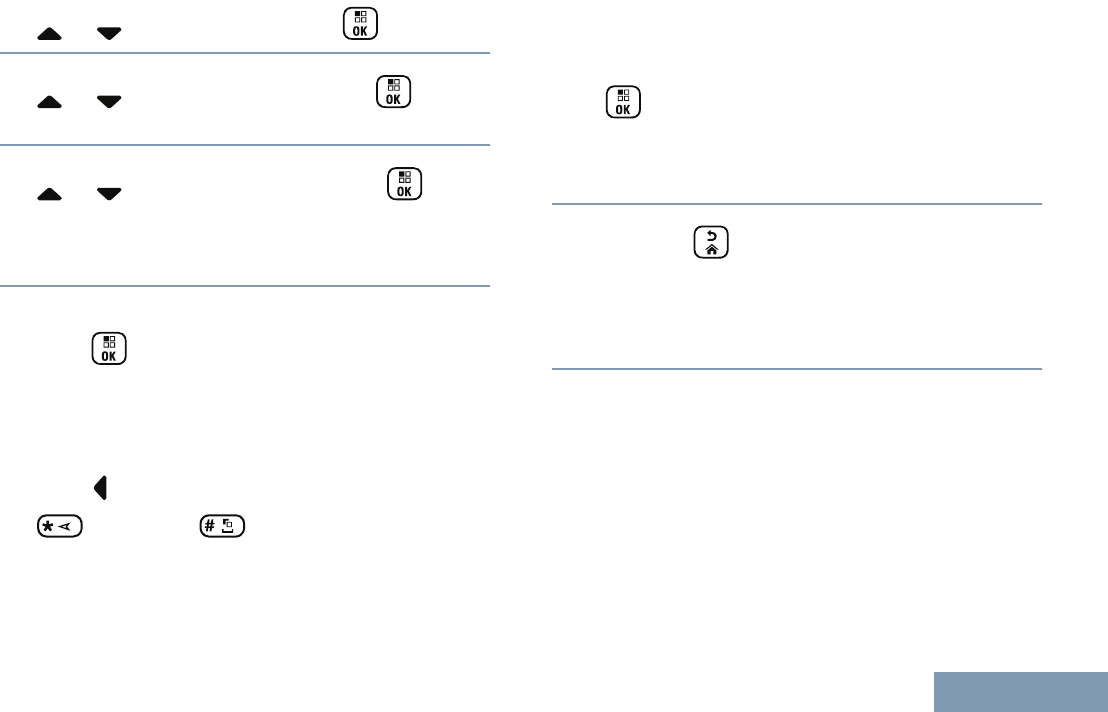
2
or to Contacts and press to select.
3
or to Manual Dial and press to
select.
4
or to Phone Number and press to
select.
The first line of the display shows Number, the
second line of the display shows a blinking cursor.
5Use the keypad to enter a telephone number, and
press to place a call to the entered number.
If the PTT button is pressed, the display shows a
negative mini notice, Press OK to Send and
returns to the previous screen.
Press to delete any unwanted characters. Press
followed by within 2 seconds to insert
a pause. The P replaces * and # on the display.
If successful, the first line of the display shows
Phone Call. The second line of the display shows
the dialed telephone number.
If is pressed with no telephone number
entered, the radio sounds a positive indicator tone
then a negative indicator tone. The display
remains the same.
6
Long press to end the call.
The first line of the display shows Ending. The
second line of the display shows Phone Call....
The display shows Phone Call Ended.
Waiting for the Channel Grant in an Outbound Private
Phone Call
When you make a Private Phone Call, the first line of
the display shows Phone Call. The second line of
the display shows the dialed telephone number.
When the call is connected, the Phone Call as Private
Call icon appears in the top right corner. The first line
of the display shows the telephone number.
Making and Receiving Calls in Connect Plus Mode
209
English
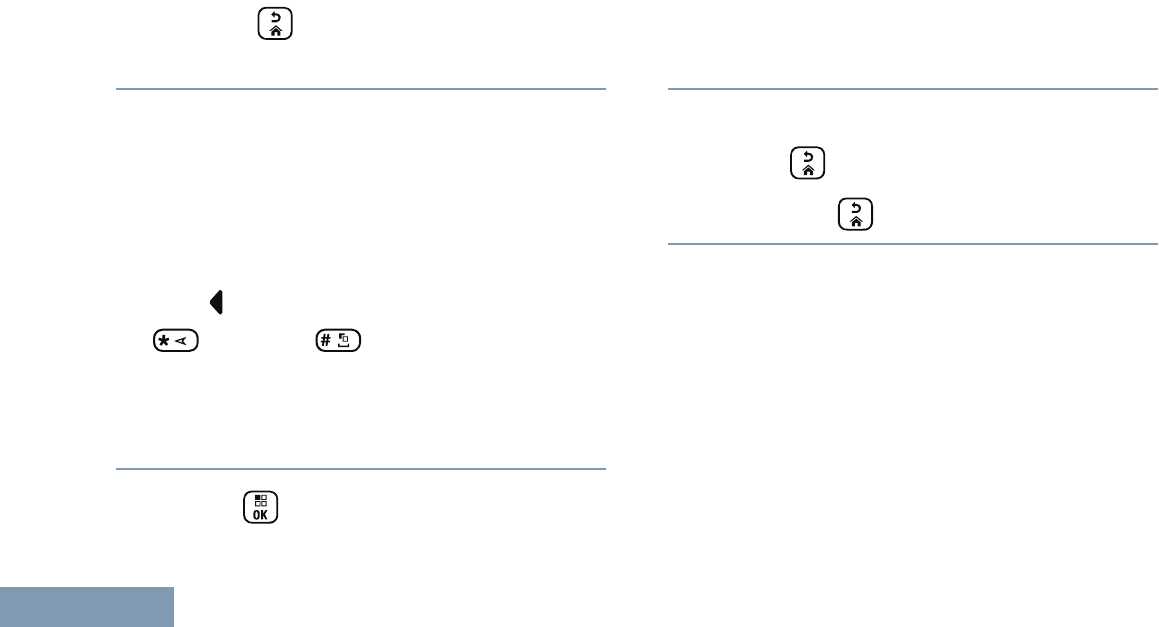
If unsuccessful, the display shows a negative mini
notice, Phone Call Failed, Resource Not
Available, or Invalid Permissions.
Long press to end the call.
The display returns to the previous screen.
Making a Buffered Over-Dial in a Connected Outbound
Private Phone Call
During the call, the Phone Call as Private Call icon
appears in the top right corner. The first text line of
the display shows the telephone number.
1Use the keypad to enter the digits.
Press to delete any unwanted characters. Press
followed by within 2 seconds to insert
a pause. The P replaces * and # on the display.
The first text line of the display shows Extra
Digits, the second text line of the display shows
the entered extra digits.
2
Press the button.
If the PTT button is pressed, the display shows a
negative mini notice, Press OK to Send and
returns to the previous screen.
The Phone Call as Private Call icon appears in the
top right corner. The first text line of the display
shows the telephone number with the over-dial
digits appended.
3Do one of the following.
•
Press to return to the Phone Call screen.
•
Long press to end the call.
Making a Live Over-Dial in a Connected Outbound
Private Phone Call
During the call, the Phone Call as Private Call icon
appears in the top right corner. The first text line of
the display shows the telephone number.
1Press the PTT button and use the keypad to enter
the digits.
The Phone Call as Private Call icon appears in the
top right corner. The first text line of the display
Making and Receiving Calls in Connect Plus Mode
210
English

shows the telephone number with the over-dial
digits appended.
2
Long press to end the call.
The first line of the display shows Ending. The
second line of the display shows Phone Call....
The display shows Phone Call Ended.
Making and Receiving Calls in Connect Plus Mode
211
English

Advanced Features in Connect Plus
Mode
Auto Fallback
Auto Fallback is a system feature that allows you to
continue to make and receive non-emergency calls
on the selected Group Contact in the event of certain
types of Connect Plus system failures.
If one of these failures occurs, your radio attempts to
roam to a different Connect Plus site. This search
process may result in your radio finding an operable
Connect Plus site, or it may result in your radio finding
a “Fallback Channel” (if your radio is enabled for Auto
Fallback). A Fallback Channel is a repeater that is
normally part of an operable Connect Plus site, but is
currently unable to communicate with either its site
controller or the Connect Plus network. In Fallback
mode, the repeater operates as a single digital
repeater. Auto Fallback Mode supports non-
emergency Group Calls only. No other call types are
supported in Fallback Mode.
Indications of Auto Fallback Mode
When your radio is using a Fallback channel, you
hear the intermittent “Fallback Tone” approximately
once every 15 seconds (except while transmitting).
The display periodically shows a brief message,
“Fallback Channel”. Your radio only permits PTT on
the selected Group Contact (Group Call, Multigroup
Call, or Site All Call). It does not allow you to make
other types of calls.
Making/Receiving Calls in Fallback Mode
Note:
Calls are heard only by radios that are
monitoring the same Fallback channel and
selected to the same Group. Calls are not
networked to other sites or other repeaters.
Emergency voice calls or Emergency Alerts
are not available in Fallback mode. If you
press the emergency button in Fallback mode,
the radio provides an invalid key press tone.
Display-equipped radios also show the
message, “Feature not available”.
Private (radio to radio) and Phone calls are not
available in Fallback mode. If you attempt a
Advanced Features in Connect Plus Mode
212
English

call to a private contact, you will receive a
denial tone. At this point you should select a
desired group contact. Other non-supported
calls include Remote Monitor, Call Alert, Radio
Check, Radio Enable, Radio Disable, Text
messaging, Location Updates, and packet
data calls.
Enhanced Traffic Channel Access (ETCA) is
not supported in Auto Fallback mode. If two or
more radio users press PTT at the same time
(or at almost the same time), it is possible that
both radios transmit until PTT is released. In
this event, it is possible that none of the
transmissions will be understood by receiving
radios.
Making calls in Fallback mode is similar to normal
functioning. Simply select the group contact you wish
to use (using the radio’s normal channel selection
method), and then press the PTT to start your call. It
is possible that the channel may be in use already by
another group. If the channel is in use, you receive a
busy tone and the display will say “Channel Busy”.
You may select Group, Multi-group or Site All Call
contacts using your radio’s normal channel selection
method. While the radio is operating on the Fallback
Channel, the Multigroup operates just like other
Groups. It is only heard by radios that are currently
selected to the same Multi-group.
Returning to Normal Operation
If the site returns to normal trunking operation while
you are in range of your Fallback repeater, your radio
automatically exits Auto Fallback mode. You hear a
registration “beep” when the radio successfully
registers. If you are in the range of an operable site
(that is not in Fallback mode), you may press the
Roam Request button (if programmed for your radio)
to force your radio to search for and register on an
available site. If no other site is available, your radio
returns to Auto Fallback mode after searching is
complete. If you drive out of coverage of your
Fallback repeater, your radio enters Search mode
(display indicates “Searching”).
Radio Check
If enabled, this feature allows you to determine if
another radio is active in a system without disturbing
the user of that radio. No audible or visual notification
is shown on the target radio.
This feature is only applicable for subscriber aliases
or IDs.
Advanced Features in Connect Plus Mode
213
English
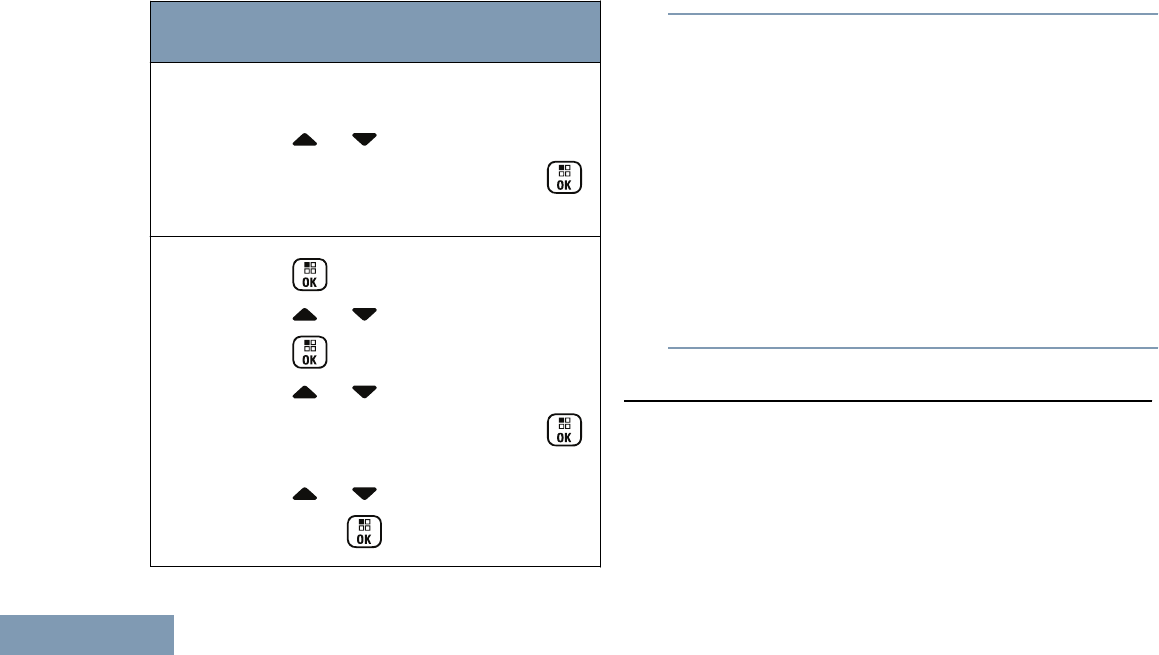
Sending a Radio Check
1Access the Radio Check feature.
Radio
Control
Steps
Program-
med Ra-
dio Check
button
1Press the programmed Radio
Check button.
2 or to the required sub-
scriber alias or ID and press
to select.
Menu 1
to access the menu.
2 or to Contacts and press
to select.
3 or to the required sub-
scriber alias or ID and press
to select.
4 or to Radio Check and
press to select.
The display shows the Target Alias, indicating the
request is in progress. The LED lights up solid
green.
2Wait for acknowledgement.
If the target radio is active in the system, a tone
sounds and the display briefly shows Target
Radio Available.
If the target radio is not active in the system, a
tone sounds and the display briefly shows Target
Radio Not Available.
Radio returns to the subscriber alias or ID screen
when initiated via Menu.
Radio returns to the Home Screen if initiated via
the programmable button.
Remote Monitor
Use the Remote Monitor feature to turn on the
microphone of a target radio (subscriber alias or IDs
only). The green LED will blink once on the target
subscriber. You can use this feature to monitor,
remotely, any audible activity surrounding the target
radio.
Advanced Features in Connect Plus Mode
214
English
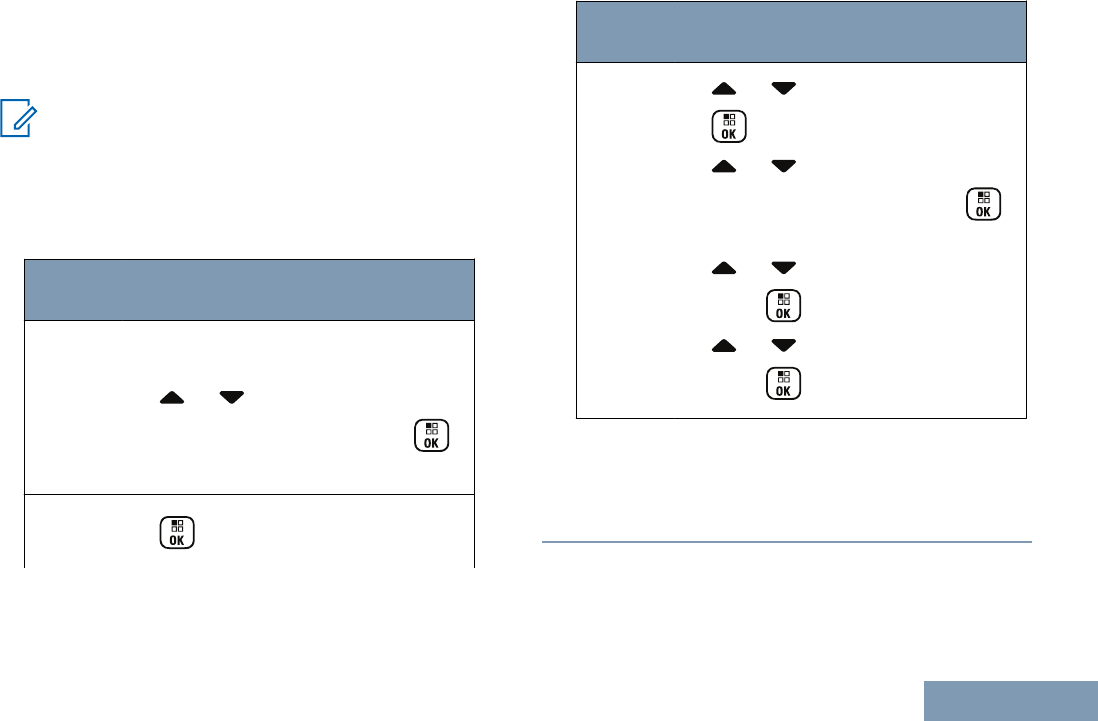
Your radio must be programmed to allow you to use
this feature.
Initiating Remote Monitor
Note:
Remote Monitor automatically stops after a
programmed duration or when there is any
attempt to initiate transmission, change
channels or power down the radio.
1Access the Remote Monitor feature.
Radio
Control
Steps
Program-
med Re-
mote
Monitor
Button
1Press the programmed Remote
Monitor button.
2 or to the required sub-
scriber alias or ID and press
to select.
Menu 1
to access the menu.
Radio
Control
Steps
2 or to Contacts and press
to select.
3 or to the required sub-
scriber alias or ID and press
to select.
4 or to Manual Dial and
press to select.
5 or to Remote Mon. and
press to select.
The first text line shows Rem. Monitor. The
second text line displays the Target Alias,
indicating the request is in progress. The LED
lights up blinking green.
2Wait for acknowledgement.
If successful, a positive indicator tone sounds and
the display momentarily shows Rem. Monitor
Advanced Features in Connect Plus Mode
215
English
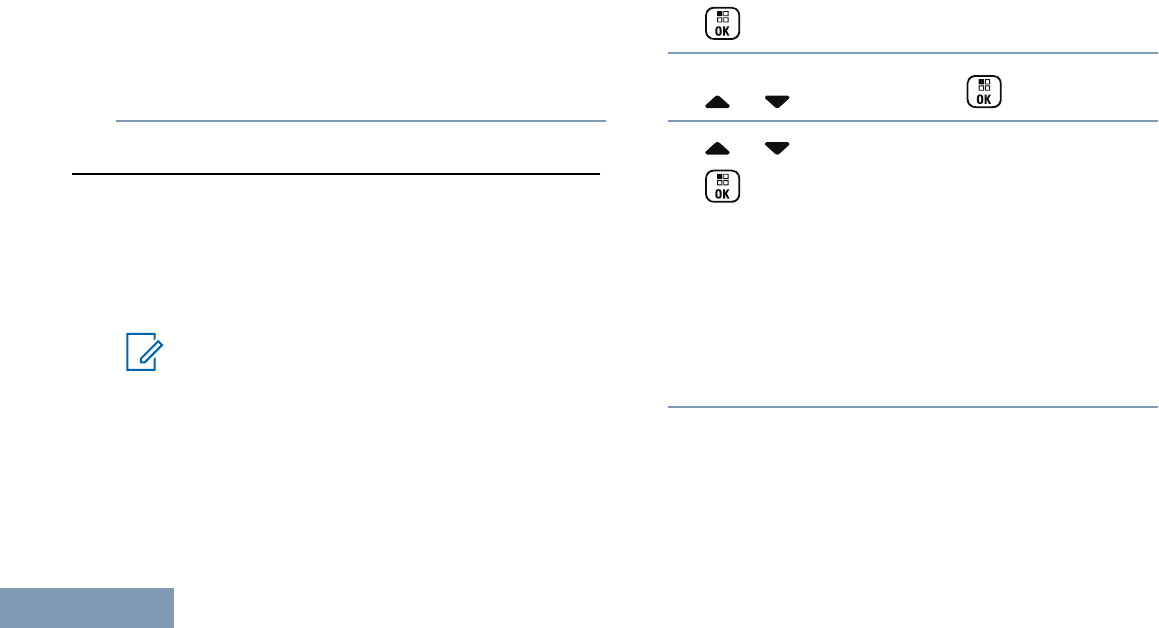
Successful. Your radio starts playing audio from
the monitored radio for a programmed duration
and display shows Rem. Monitor, followed by
target alias. Once the timer expires, the radio
sounds an alert tone and the LED turns off.
If unsuccessful, the radio sounds a negative
indicator tone the display shows Rem. Monitor
Failed.
Scan
This feature allows your radio to monitor and join calls
for groups defined in a pre-programmed scan list.
When scan is enabled, the scan icon appears on the
status bar and the LED blinks yellow when idle.
Starting and Stopping Scan
Note:
This procedure turns the Scan feature On or
Off for all Connect Plus zones with the same
Network ID as your currently selected zone. It
is important to note that even when the Scan
feature is turned on via this procedure, scan
may still be disabled for some (or all) groups
on your scan list. See Editing the Scan List on
page 218 for more information.
You can start and stop scanning by pressing the
programmed Scan button OR follow the procedure
described next.
1
to access the menu.
2
or to Scan and press to select.
3 or to Turn On or Turn Off and press
to select.
•The display shows Scan On if scan is enabled.
•The Scan menu shows Turn Off if scan is
enabled.
•The display shows Scan Off if scan is
disabled.
•The Scan menu shows Turn On if scan is
disabled.
Responding to a Transmission During a Scan
During scanning, your radio stops on a group where
activity is detected. The radio continuously listens for
any member in the scan list when idle on the control
channel.
Advanced Features in Connect Plus Mode
216
English
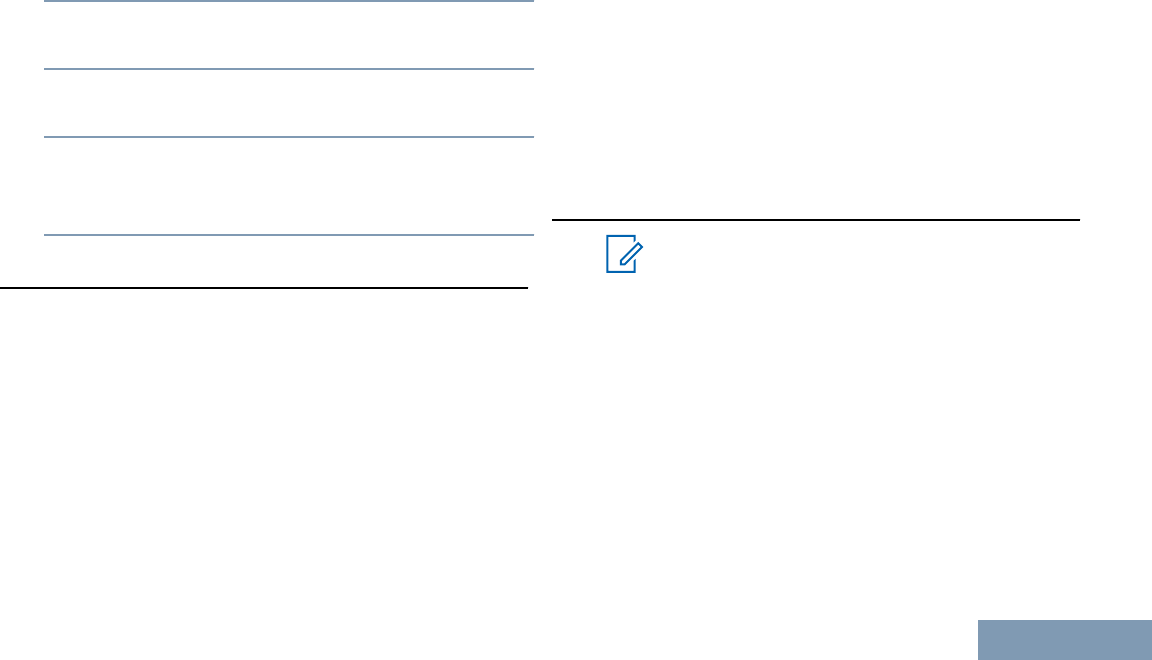
1Hold the radio vertically 1 to 2 inches (2.5 to 5.0
cm) from your mouth.
2Press the PTT button during hang time.
The LED lights up solid green.
3Wait for the Talk Permit Tone to finish (if enabled),
and speak clearly into the microphone.
4Release the PTT button to listen.
If you do not respond within the hang time, the
radio returns to scanning other groups.
User Configurable Scan
If the Edit List menu is enabled, a user is able to Add
and Remove the scan members from the Add
Member menu. A Scan List member must be a
regular Group Contact (i.e. not Multi-group or Site All
Call/Network Wide All Call) that is currently assigned
to a Channel Selector position in a Connect Plus
Zone with the same Network ID as the currently
selected Zone. The Talkgroup alias must not match
any Talkgroup that has been included in the current
Zone's Scan List.
Scan can be turned on or off from the menu or by
pressing a programmed Scan On/Off button.
This feature functions only when the radio is not
currently involved in a call. If you are presently
listening to a call, your radio cannot scan for other
group calls, and is therefore unaware they are in
progress. Once your call is finished, your radio
returns to the control channel time slot and is able to
scan for groups that are in the scan list.
Turning Scan On or Off
Note:
This procedure turns the Scan feature On or
Off for all zones with the same Network ID as
your currently selected zone. It is important to
note that even when the Scan feature is
turned on via this procedure, scan may still be
disabled for some (or all) groups on your scan
list. See the next section for more information.
If Scan is turned on, the Scan icon appears on your
display. When Scan is on and you are not
participating in a call, the LED blinks green and
yellow.
Advanced Features in Connect Plus Mode
217
English
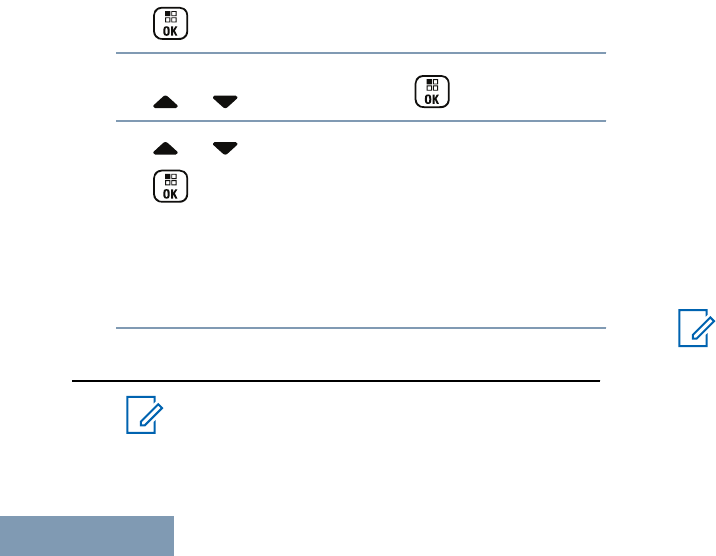
The procedure for turning Scan on or off depends on
how your radio is programmed. If programmed with a
Scan On/Off button, use the button to toggle the
feature on or off. If your radio has been programmed
so that Scan can be turned on or off via the menu,
follow the procedure described next.
1
to access the menu.
2
or to Scan and press to select.
3 or to Turn On or Turn Off and press
to select.
•The display shows Scan On momentarily if
scan is disabled.
•The display shows Scan Off momentarily if
scan is enabled.
Editing the Scan List
Note:
If the scan list entry happens to be the radio’s
currently selected group, the radio listens for
activity on this group regardless of whether the
list entry currently shows a check mark or not.
Whenever a radio is not in a call, the radio
listens for activity on its Selected Group,
Multigroup, the Site All Call, and its Default
Emergency Revert Group (if configured for
one). This operation cannot be disabled. If
Scan is enabled the radio will also listen for
activity on enabled Zone Scan List members.
Your scan list determines which groups can be
scanned. The list is created when your radio is
programmed. If your radio has been programmed to
allow you to edit the scan list, you can,
• Enable/disable scan for individual groups on the
list.
• Add and Remove the scan members from the Add
Member menu. Refer to Add or Delete a Group via
the Add Members Menu on page 219.
Note:
A Scan List member must be a regular Group
Contact (i.e. not Multigroup or Site All Call/
Network Wide All Call) that is currently
assigned to a Channel Selector position in a
Connect Plus Zone with the same Network ID
as the currently selected Zone.
Advanced Features in Connect Plus Mode
218
English

The Talkgroup alias must not match any
Talkgroup that has been included in the
current Zone's Scan List.
1
to access the menu.
2
or to View/Edit List and press to
select.
3 or to the desired Group name.
If a check mark precedes the Group name, then
scan is currently enabled for this Group.
If there is no check mark preceding the Group
name, then scan is currently disabled for this
Group.
4
to select the desired Group.
The display shows Enable if scan is currently
disabled for the Group.
The display shows Disable if scan is currently
enabled for the Group.
5Select the displayed option (Enable or Disable)
and press to select.
Depending on which option was selected, the
radio momentarily displays Scan Enabled or Scan
Disabled as confirmation.
The radio displays the Zone scan list again. If scan
was enabled for the Group, the check mark displays
before the Group name. If scan was disabled for the
Group, the check mark is removed before the Group
name.
Add or Delete a Group via the Add Members
Menu
The Connect Plus radio does not allow a duplicate
group number or a duplicate group alias to be placed
on a zone scan list (or to be shown as a “scan
candidate”). Thus, the list of “scan candidates”
described in steps 6 and 7 sometimes changes after
adding or deleting a group from the zone scan list.
If your radio has been programmed to allow you to
edit the scan list, you can use the Add Members
menu to add a group to the scan list of the currently
Advanced Features in Connect Plus Mode
219
English
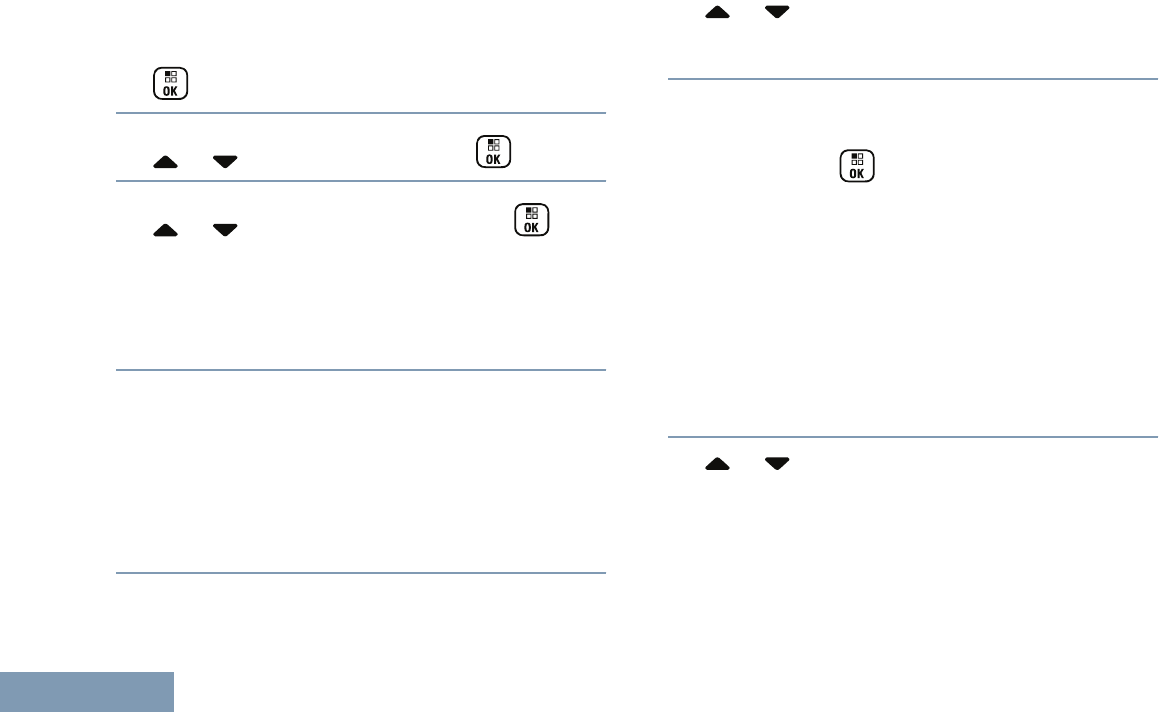
selected zone, or to delete a group from the san list of
the currently selected zone.
1
to access the menu.
2
or to Scan option and press to select.
3
or to <Add Members> and press to
select.
The display shows “Add Members from Zone n” (n
= the Connect Plus zone number of the first
Connect Plus zone in your radio with the same
Network ID as your currently selected zone).
4Do one of the following.
• If the group you want to add to the scan list is
assigned to a channel selector position in that
zone, go to step 6.
• If the group you want to add to the scan list is
assigned to a channel selector position in a
different Connect Plus zone, go to step 5.
5 or to scroll a list of Connect Plus zones
that have the same Network ID as the currently
selected zone.
6After locating the Connect Plus zone where the
desired group is assigned to a channel selector
position, press to select.
Your radio displays the first entry in a list of groups
assigned to a channel position in that zone. The
groups on the list are called “scan candidates”,
because they can be added to the scan list of your
currently selected zone (or they are already on the
zone scan list).
If the zone does not have any groups that can be
added to the scan list, the radio displays No
Candidates.
7 or to scroll through the list of candidate
groups.
If a plus sign (+) is displayed immediately before
the group alias, this indicates the group is
currently on the scan list for the selected zone.
Advanced Features in Connect Plus Mode
220
English
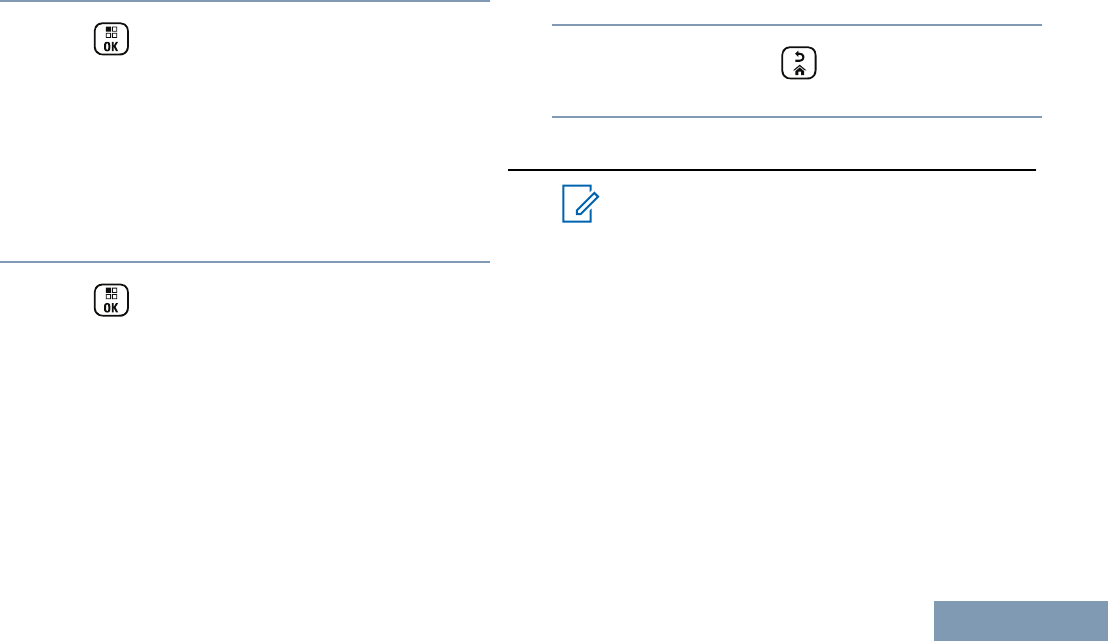
If the plus sign (+) is not displayed immediately
before the alias, the group is not currently on the
scan list, but can be added.
8
Press when the desired group alias is
displayed.
If this group is not currently on the scan list for the
currently selected zone, the Add (Group Alias)
message is displayed.
If this group is already on the scan list for the
currently selected zone, the Delete (Group Alias)
message is displayed.
9
Press to accept the displayed message (Add
or Delete).
If deleting a group from the list, you will know the
operation is successful because the plus sign (+)
will no longer display immediately before the alias.
If adding a group to the list, you will know the
operation is successful because the plus sign (+)
will display before the alias.
If you are attempting to add a group, and the list is
already full, the radio displays List Full. If this
should occur, it will be necessary to delete a group
from the scan list prior to adding a new one.
10
When finished, press as many times as
necessary to return to the desired menu.
Understanding Scan Operation
Note:
If the Radio joins a call for a Zone Scan List
member from a different Zone and Call Hang
Timer expires before you are able to respond,
in order to respond, you must navigate to the
Zone and Channel of the Scan List Member
and start a new call.
There are some circumstances in which you can miss
calls for groups that are in your scan list. When you
miss a call for one of the following reasons, this does
not indicate a problem with your radio. This is a
normal scan operation for Connect Plus.
• Scan feature is not turned on (check for the scan
icon on the display).
Advanced Features in Connect Plus Mode
221
English

• Scan list member has been disabled via the menu
(see Editing the Scan List on page 218).
• You are participating in a call already.
•No member of the scanned group is registered at
your site (Multisite systems only).
Scan Talkback
If your radio scans into a call from the selectable
group scan list, and if the PTT button is pressed
during the scanned call, the operation of the radio
depends on whether Scan Talkback was enabled or
disabled during radio programming. For more
information on how your radio is programmed,
contact your radio dealer (or your radio system
administrator).
Scan
Talkback
Disabled
The radio leaves the scanned call and
attempts to transmit on the contact for
the currently selected channel
position. After the Call Hang Time on
the currently selected contact expires,
the radio returns to the home channel
and starts the Scan Hang Time Timer.
The radio resumes group scan after its
Scan Hang Time Timer expires.
Scan
Talkback
Enabled
If the PTT button is pressed during the
Group Hang Time of the scanned call,
the radio attempts to transmit to the
scanned group.
Note:
If you scan into a call for a group that is not
assigned to a channel position in the currently
selected zone and you miss the Hang Time of
the call, switch to the proper zone and then
select the channel position of the group to talk
back to that group.
Contacts Settings
Note:
You can add, or edit subscriber IDs for
Connect Plus Contacts. Deleting subscriber
IDs can only be performed by your dealer.
If the Privacy feature is enabled on a channel,
you can make a privacy-enabled voice call on
that channel. Only target radios with the same
Privacy Key, or the same Key Value and Key
ID as your radio are able to unscramble the
transmission.
Advanced Features in Connect Plus Mode
222
English
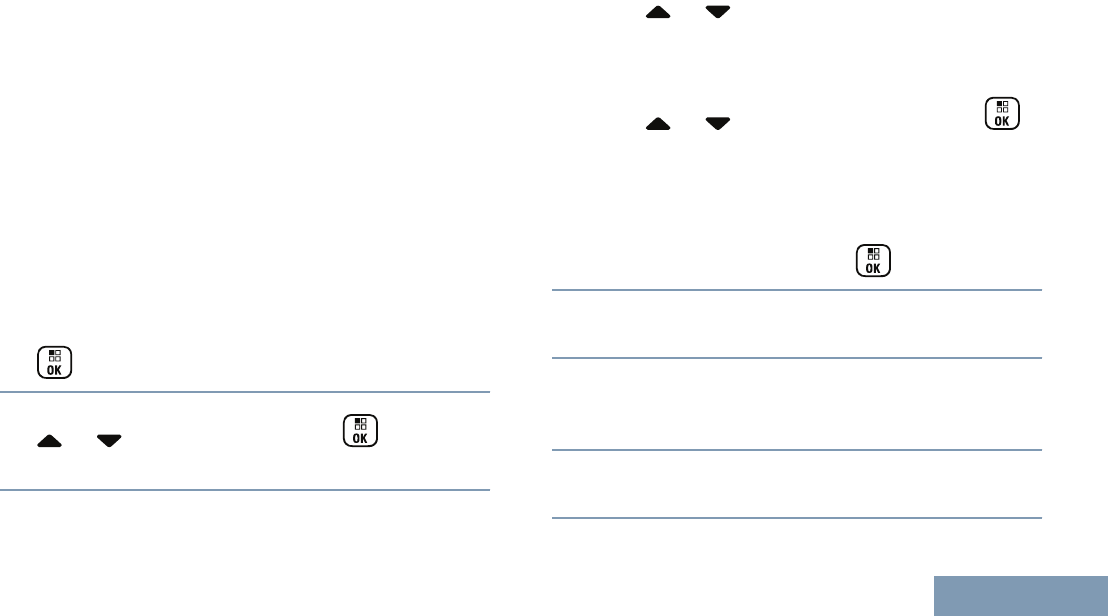
Contacts provide “address-book” capabilities on your
radio. Each entry corresponds to an alias or ID that
you use to initiate a call.
Each zone provides a Contact List with up to 100
contacts. The following contact types are available:
• Private Call
• Group Call
•Multigroup Call
• Site All Call Voice
• Site All Call Text
• Dispatch Call
The Dispatch Call contact type is used to send a text
message to a dispatcher PC through a third-party
Text Message Server.
Making a Private Call from Contacts
1
to access the menu.
2
or to Contacts and press to select.
The entries are alphabetically sorted.
3Use one of the steps described next to select the
required subscriber alias:
• Select the subscriber alias directly.
• or to the required subscriber alias or
ID.
•Use the Manual Dial menu.
•
or to Manual Dial and press
to select.
• If there was previously dialed subscriber
alias or ID, the alias or ID appears along
with a blinking cursor. Use the keypad to
edit/enter the ID. Press to select.
4Hold the radio vertically 1 to 2 inches (2.5 to 5.0
cm) from your mouth.
5Press the PTT button to make the call.
The LED lights up solid green. The display shows
the destination alias.
6Wait for the Talk Permit Tone to finish (if enabled),
and speak clearly into the microphone.
Advanced Features in Connect Plus Mode
223
English
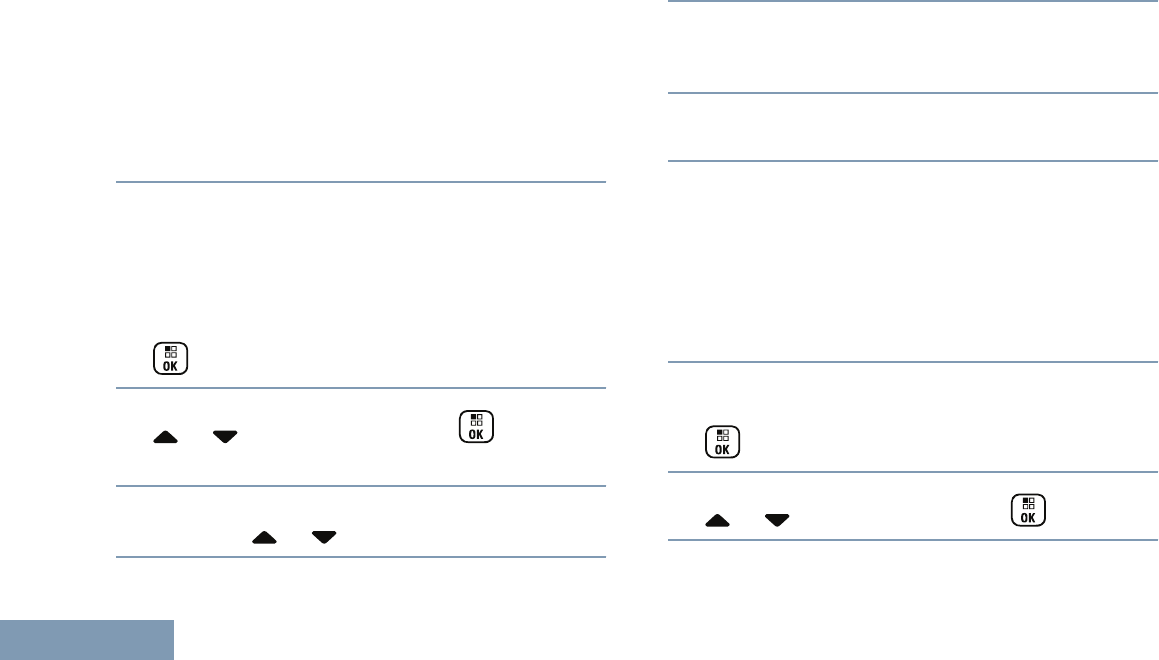
7Release the PTT button to listen.
When the target radio responds, the LED blinks
green and the display shows the transmitting
user's ID.
If there is no voice activity for a predetermined
period of time, the call ends.
You hear a short tone. The display shows Call
Ended.
Making a Call Alias Search
You can also use alias or alphanumeric search to
retrieve the required subscriber alias.
This feature is only applicable while in Contacts.
1
to access the menu.
2
or to Contacts and press to select.
The entries are alphabetically sorted.
3Key in the first character of the required alias, and
then press or to locate the required alias.
4Hold the radio vertically 1 to 2 inches (2.5 to 5.0
cm) from your mouth.
5Press the PTT button to make the call.
The LED lights up solid green. The display shows
the destination alias.
6Wait for the Talk Permit Tone to finish (if enabled),
and speak clearly into the microphone.
7Release the PTT button to listen.
When the target radio responds, the LED blinks
green.
If there is no voice activity for a predetermined
period of time, the call ends.
The display shows Call Ended.
Adding a New Contact
1
to access the menu.
2
or to Contacts and press to select.
Advanced Features in Connect Plus Mode
224
English
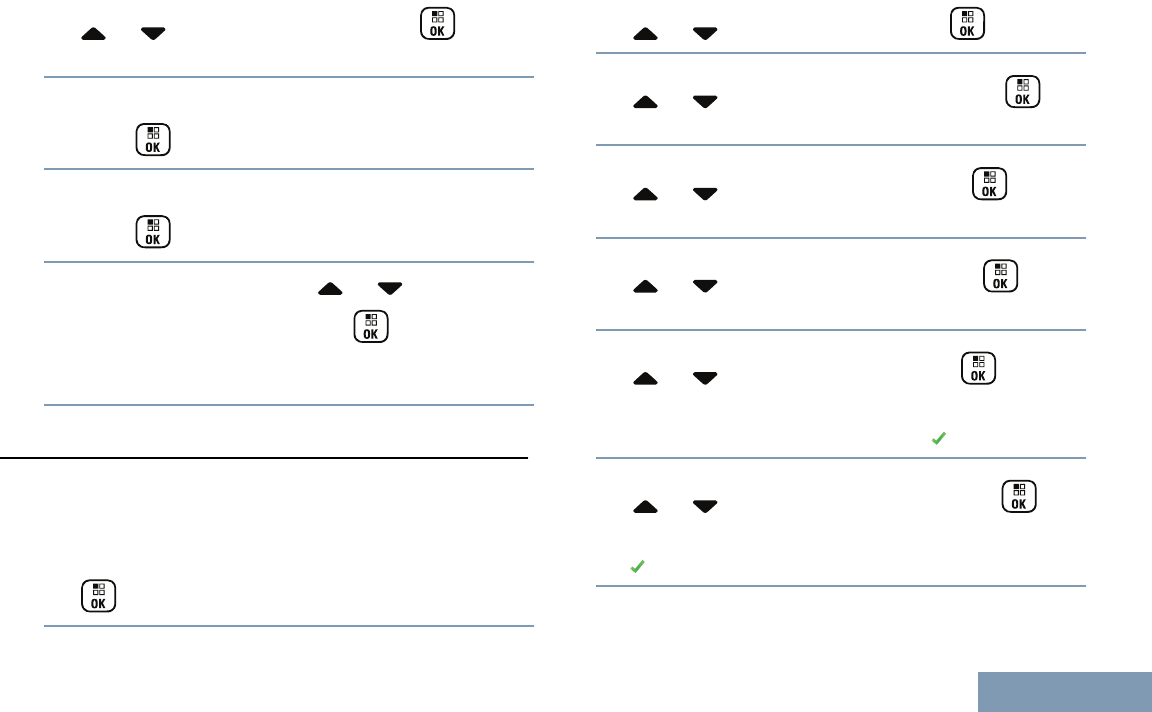
3
or to New Contact and press to
select.
4Use the keypad to enter the contact number and
press to confirm.
5Use the keypad to enter the contact name and
press to confirm.
6If adding a Radio Contact, or to the
required ringer type and press to select.
The radio sounds a positive indicator tone and the
display shows Contact Saved.
Call Indicator Settings
Activating and Deactivating Call Ringers for Call Alert
You can select, or turn on or off ringing tones for a
received Call Alert.
1
to access the menu.
2
or to Utilities and press to select.
3
or to Radio Settings and press to
select.
4
or to Tones/Alert and press to
select.
5
or to Call Ringers and press to
select.
6
or to Call Alert and press to
select.
The current tone is indicated by a .
7
or to the required tone and press to
select.
appears beside selected tone.
Advanced Features in Connect Plus Mode
225
English
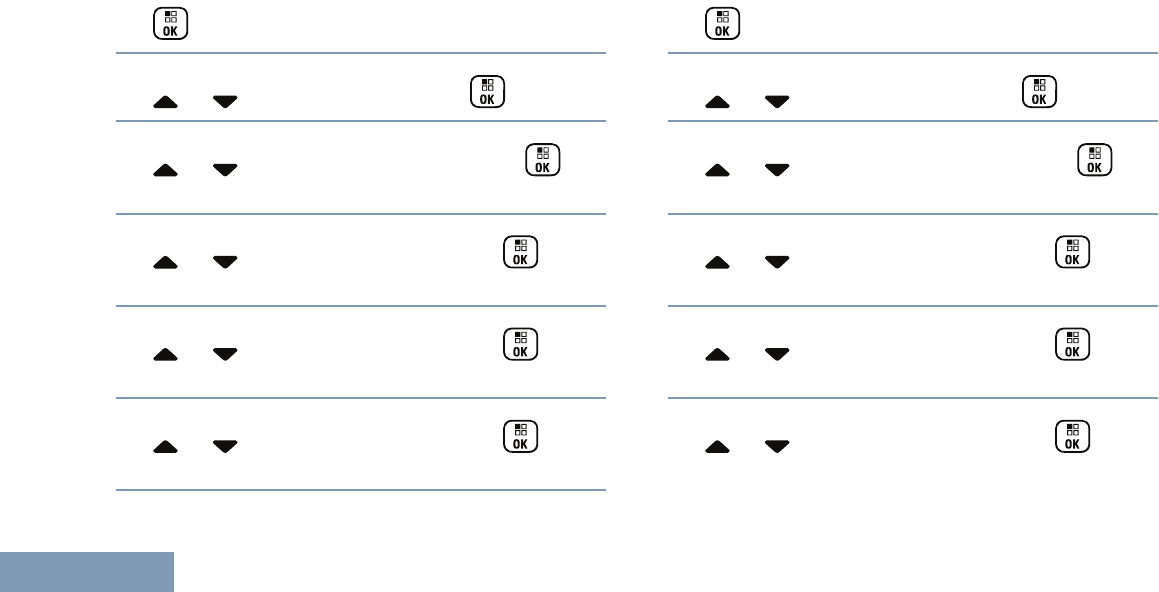
Activating and Deactivating Call Ringers for Private
Calls
You can turn on or off the ringing tones for a received
Private Call.
1
to access the menu.
2
or to Utilities and press to select.
3
or to Radio Settings and press to
select.
4
or to Tones/Alerts and press to
select.
5
or to Call Ringers and press to
select.
6
or to Private Call and press to
select.
Activating and Deactivating Call Ringers for Text
Message
You can turn on or off the ringing tones for a received
Text Message.
1
to access the menu.
2
or to Utilities and press to select.
3
or to Radio Settings and press to
select.
4
or to Tones/Alerts and press to
select.
5
or to Call Ringers and press to
select.
6
or to Text Message and press to
select.
Advanced Features in Connect Plus Mode
226
English

The current tone is indicated by a .
7
or to the required tone and press to
select.
appears beside selected tone.
Selecting a Ring Alert Type
Note:
The programmed Ring Alert Type button is
assigned via CPS. Check with your dealer or
system administrator to determine how your
radio has been programmed.
You can program the radio calls to one
predetermined vibrate call. If All Tones status is
disabled, the radio displays the All Tone Mute icon.
If All Tones status is enabled, the related ring alert
type is displayed.
The radio sounds one vibration if it is a momentary
ring style. The radio vibrates repetitively if it is a
repetitive ring style. When set to Ring and Vibrate,
the radio sounds a specific ring tone if there is any
incoming radio transaction (for example, Call Alert or
Message). It sounds like a good key tone or missed
call.
For radios with batteries that support the vibrate
feature and are attached to a vibrating belt clip, the
available Ring Alert Type options are Silent, Ring,
Vibrate, and Ring and Vibrate.
For radios with batteries that do not support the
vibrate feature and are not attached to a vibrating belt
clip, Ring Alert Type is automatically set to Ring. The
available Ring Alert Type options are Silent and Ring.
You can select a Ring Alert Type by performing one
of the following actions.
•Press the programmed Ring Alert Type button to
access the Ring Alert Type menu.
a) Press or to Ring, Vibrate, Ring &
Vibrate or Silent and press to select.
•Access this feature via the menu.
a)
Press to access the menu.
b)
Press or to Utilities and press
to select.
Advanced Features in Connect Plus Mode
227
English
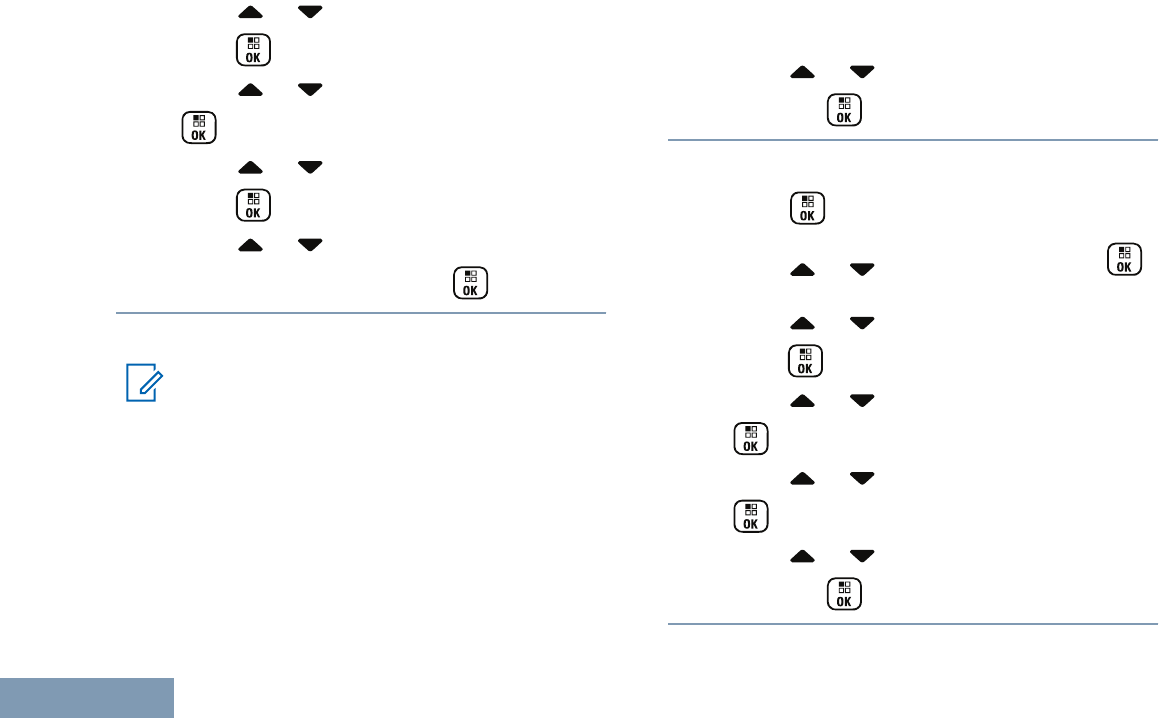
c) Press or to Radio Settings and
press to select.
d) Press or to Tones/Alerts and press
to select.
e) Press or to Ring Alert Type and
press to select.
f) Press or to Ring, Vibrate, Ring &
Vibrate or Silent and press to select.
Configuring Vibrate Style
Note:
The programmed Vibrate Style button is
assigned via CPS. Check with your dealer or
system administrator to determine how your
radio has been programmed.
Vibrate Style is enabled when the Vibrating Belt Clip
is attached to the radio with a battery that supports
the vibrate feature.
You can configure the vibrate style by performing one
of the following actions.
•Press the programmed Vibrate Style button to
access the Vibrate Style menu.
a) Press or to Short, Medium, or Long
and press to select.
•Access this feature via the menu.
a)
Press to access the menu.
b)
Press or to Utilities and press
to select.
c) Press or to Radio Settings and
press to select.
d) Press or to Tones/Alerts and press
to select.
e) Press or to Vibrate Style and press
to select.
f) Press or to Short, Medium, or Long
and press to select.
Advanced Features in Connect Plus Mode
228
English
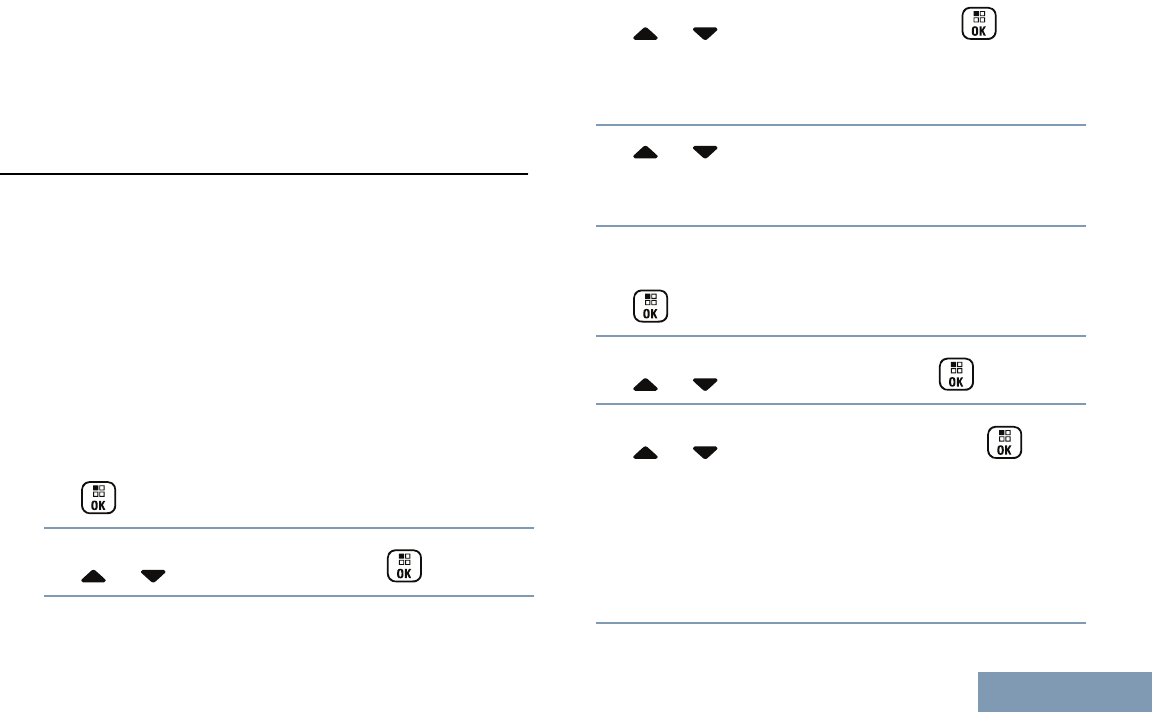
Escalating Alarm Tone Volume
You can program your radio to continually alert you
when a radio call remains unanswered. This is done
by automatically increasing the alarm tone volume
over time. This feature is known as Escalert.
Call Log Features
Your radio keeps track of all recent outgoing,
answered, and missed Private Calls. Use the call log
feature to view and manage recent calls.
You can perform the following tasks in each of your
call lists:
• Delete
• View Details
Viewing Recent Calls
The lists are Missed, Answered, and Outgoing.
1
to access the menu.
2
or to Call Log and press to select.
3
or to preferred list and press to
select.
The display shows the most recent entry at the top
of the list.
4 or to view the list.
Press the PTT button to start a Private Call with
the current selected alias or ID.
Deleting a Call from a Call List
1
to access the menu.
2
or to Call Log and press to select.
3
or to the required list and press to
select.
When you select a call list and it contains no
entries, the display shows List Empty, and
sounds a low tone if Keypad Tones are turned on
(see Turning Keypad Tones On or Off on page
152).
Advanced Features in Connect Plus Mode
229
English
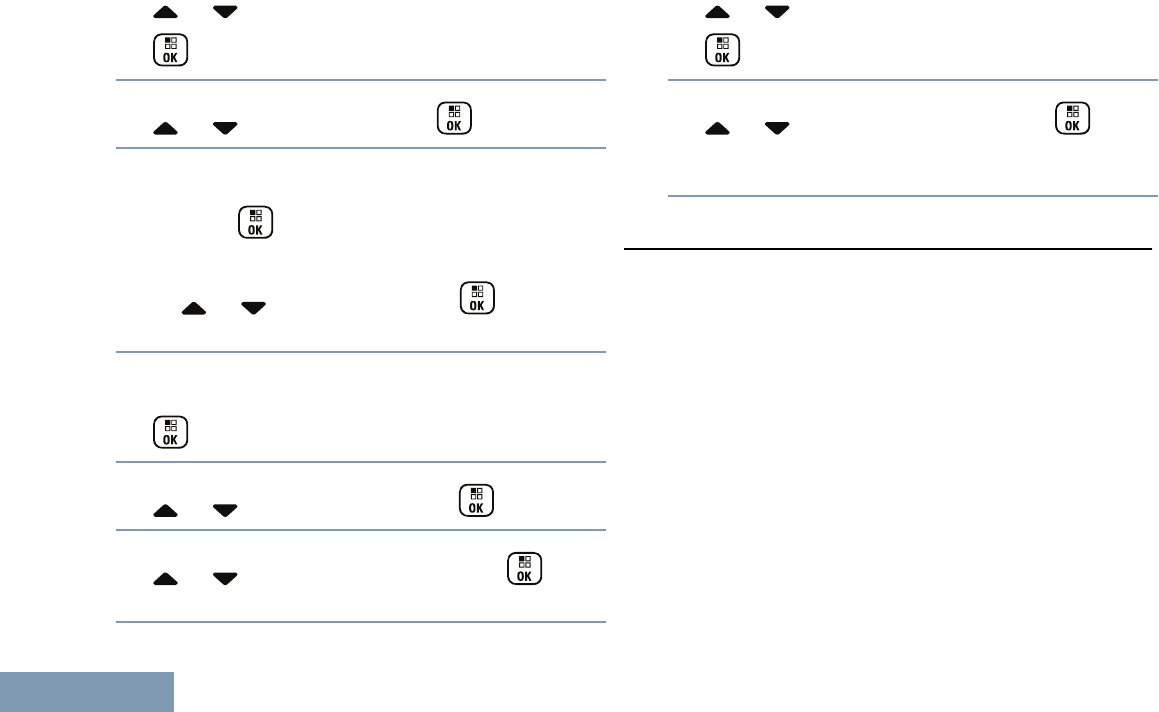
4 or to the required alias or ID and press
to select.
5
or to Delete and press to select.
6Do one of the following:
•
Press to select Yes to delete the entry.
The display shows Entry Deleted.
•
or to No, and press the button to
return to the previous screen.
Viewing Details from a Call List
1
to access the menu.
2
or to Call Log and press to select.
3
or to the required list and press to
select.
4 or to the required alias or ID and press
to select.
5
or to View Details and press to
select.
Display shows details.
Call Alert Operation
Call Alert paging enables you to alert a specific radio
user to call you back when they are able to do so.
This feature is accessible through the menu via
Contacts, manual dial or a programmed One Touch
Access button.
Receiving and Responding to a Call Alert
When you receive a Call Alert page, you see the
notification list listing a Call Alert with the alias or ID of
the calling radio on the display.
When you hear a repetitive tone and the LED
blinks yellow, do one of the following:
Advanced Features in Connect Plus Mode
230
English
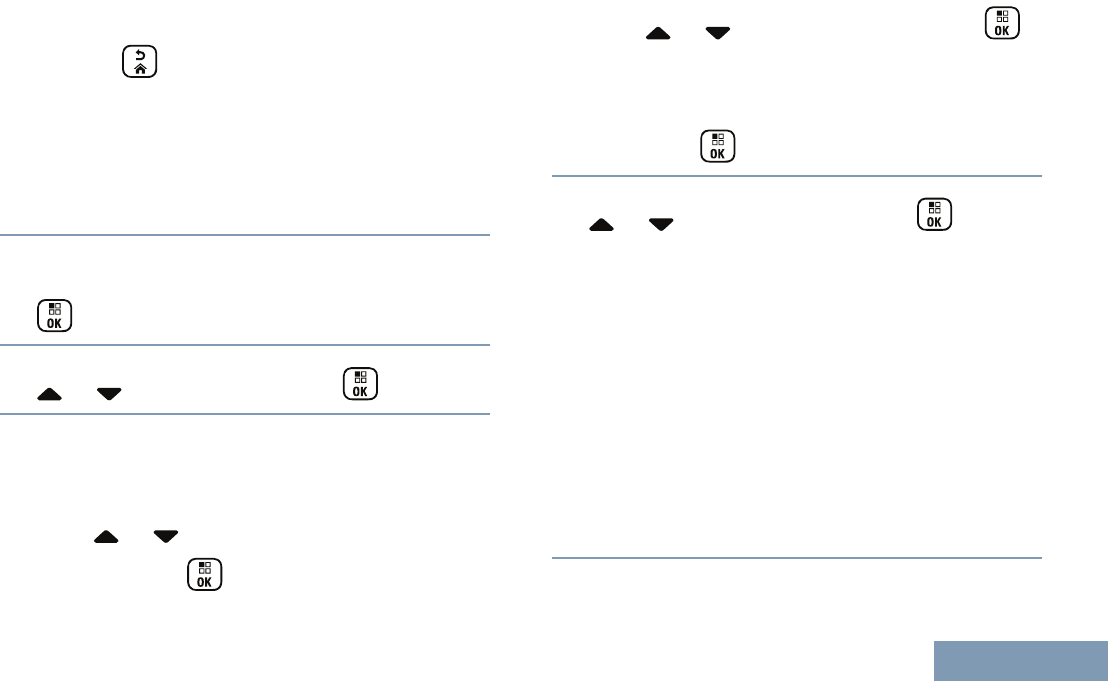
• Press the PTT button while the display still
shows the Call Alert in the Notification List to
respond with a Private Call.
•
Press to exit the Notification List. The alert
is moved to the Missed Call Log.
See Notification List on page 270 for details about
the Notification List.
See Call Log Features on page 229 for details
about the Missed Call List.
Making a Call Alert from the Contact List
1
to access the menu.
2
or to Contacts and press to select.
3Use one of the steps described next to select the
required subscriber alias or ID:
• select the subscriber alias directly
• or to the required subscriber alias
and press to select.
•use the Manual Dial menu
•
or to Manual Dial and press
to select.
• The Manual Dial text entry screen shall be
displayed. Enter the Subscriber ID and
press .
4
or to Call Alert and press to
select.
The display shows Call Alert: <Subscriber
Alias or ID>Call Alert and the subscriber
alias or ID, indicating that the Call Alert has been
sent.
The LED lights up solid green when your radio is
sending the Call Alert.
If the Call Alert acknowledgement is received, the
display shows Call Alert Successful.
If the Call Alert acknowledgement is not received,
the display shows Call Alert Failed.
Advanced Features in Connect Plus Mode
231
English

Making a Call Alert with the One Touch Access Button
Press the programmed One Touch Access
button to make a Call Alert to the predefined alias.
The display shows Call Alert and the
subscriber alias or ID, indicating that the Call Alert
has been sent.
The LED lights up solid green when your radio is
sending the Call Alert.
If the Call Alert acknowledgement is received, the
display shows Call Alert Successful.
If the Call Alert acknowledgement is not received,
the display shows Call Alert Failed.
Emergency Operation
Note:
If your radio is programmed for Silent or Silent
with Voice emergency initiation, in most cases
it automatically exits silent operation after the
Emergency Call or Emergency Alert is
finished. The exception to this rule is when
Emergency Alert is the configured Emergency
Mode and Silent is the configured Emergency
Type. If your radio is programmed in this
manner, the silent operation continues until
you cancel silent operation by pressing PTT or
the button configured for Emergency Off.
Emergency voice calls and Emergency Alerts
are not supported when operating in Connect
Plus Auto Fallback mode. For more
information see the Auto Fallback on page
212.
An Emergency Alert is used to indicate a critical
situation. You can initiate an Emergency at any time
on any screen display, even when there is activity on
the current channel. Pressing the Emergency button
initiates the programmed Emergency mode. The
programmed Emergency mode may also be initiated
by triggering the optional Man Down feature. The
Emergency feature may be disabled in your radio.
Your dealer can set the duration of a button press for
the programmed Emergency button, except for long
press, which is similar with all other buttons:
Short press Between 0.05 seconds and 0.75
seconds.
Long press Between 1.00 second and 3.75
seconds.
Advanced Features in Connect Plus Mode
232
English

The Emergency button is assigned with the
Emergency On/Off feature. Check with your dealer for
the assigned operation of the Emergency button.
• If the short press for the Emergency button is
assigned to turn on the Emergency mode, then the
long press for the Emergency button is assigned
to exit the Emergency mode.
• If the long press for the Emergency button is
assigned to turn on the Emergency mode, then the
short press for the Emergency button is assigned
to exit the Emergency mode.
When your radio is selected to a Connect Plus zone,
it supports three Emergency modes:
Emergency
Call
You must press the PTT button to
talk on the assigned emergency time
slot.
Emergency
Call with
Voice to
Follow
For the first transmission on the
assigned emergency time slot, the
microphone is automatically
unmuted and you may talk without
pressing the PTT button. The
microphone stays “hot” in this
fashion for a time period
programmed into the radio. For
subsequent transmissions in the
same Emergency call, you must
press the PTT button.
Emergency
Alert
An Emergency Alert is not a voice
call. It is an emergency notification
that is sent to radios that are
configured to receive these alerts.
The radio sends an emergency alert
via the control channel of the
currently registered site. The
Emergency Alert is received by
radios in the Connect Plus network
that are programmed to receive
them (no matter which network site
they are registered to).
Only one of the Emergency Modes can be assigned
to the Emergency button per zone. In addition, each
Emergency mode has the following types:
Regular Radio initiates an Emergency and
shows audio and/or visual indicators.
Silent Radio initiates an Emergency without
any audio or visual indicators. The radio
suppresses all audio or visual
indications of the Emergency until you
Advanced Features in Connect Plus Mode
233
English

press the PTT button to start a voice
transmission.
Silent
with
Voice
The same as Silent operation, except
that the radio also unmutes for some
voice transmissions.
Receiving an Incoming Emergency
Your radio may be programmed to sound an alert
tone and also display information about the incoming
Emergency. If so programmed, upon receiving the
incoming Emergency, the display shows the
Emergency Details screen with the emergency icon,
the Alias or ID of the radio that requested the
Emergency, the Group Contact being used for the
Emergency, and one additional line of information.
The additional information is the name of the zone
that contains the Group Contact.
At the present time, the radio displays only the most
recently decoded Emergency. If a new Emergency is
received before the prior Emergency is cleared, the
details for the new Emergency replace the details of
the previous Emergency.
Depending on how your radio has been programmed,
the Emergency Details screen (or Alarm List screen)
will stay on your radio’s display even after the
Emergency ends. You can save the emergency
details to the Alarm List, or you can delete the
emergency details as described in the following
sections.
Saving the Emergency Details to the Alarm List
Saving the emergency details to the Alarm List allows
you to view the details again at a later time by
selecting Alarm List from the Main Menu.
1While the Emergency Details (or Alarm List)
screen is displayed, press .
The Exit Alarm List screen displays.
2Perform one of the following actions:
•
Select Yes and press to save the
emergency details to the Alarm List, and to exit
the Emergency Details (or Alarm List) screen.
•
Select No and press to return to the
Emergency Details (or Alarm List) screen.
Advanced Features in Connect Plus Mode
234
English
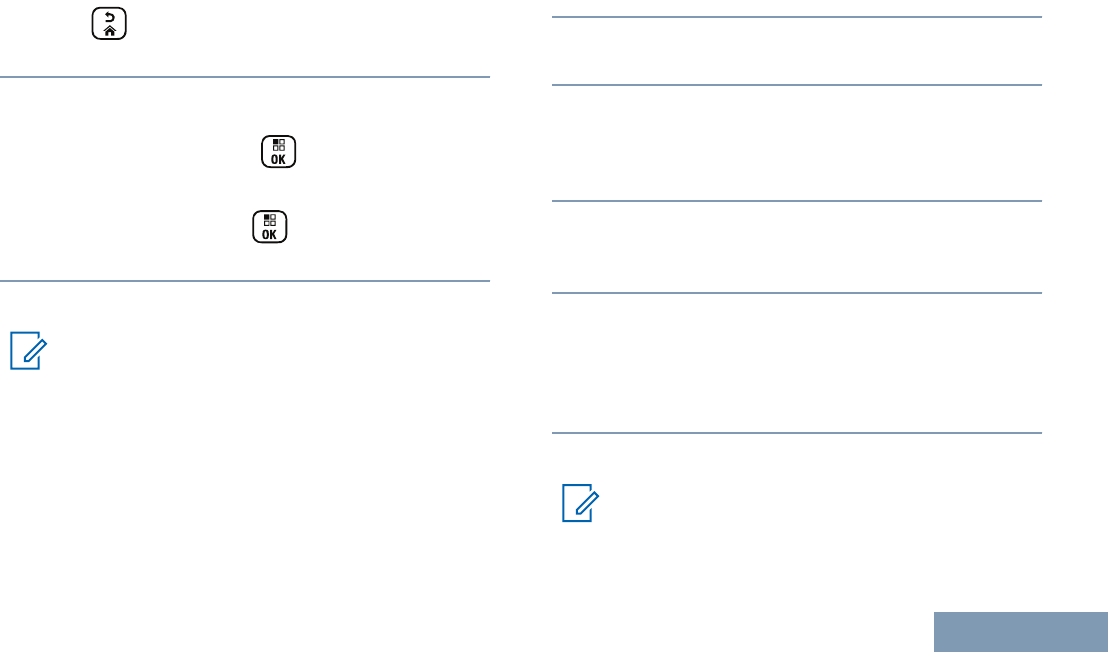
Deleting the Emergency Details
1While the Emergency Details screen is displayed,
press .
The Delete screen displays.
2Perform one of the following actions:
•
Select Yes and press to delete the
emergency details.
•
Select No and press to return to the
Emergency Details screen.
Responding to an Emergency Call
Note:
If you do not respond to the Emergency Call
within the time allotted for the Emergency Call
Hang Time, the Emergency call will end. If you
want to speak to the group after the
Emergency Call Hang Time expires, you must
first select the channel position assigned to
the group (if not already selected). Then,
press PTT to start a non-Emergency Call to
the group.
1When receiving an Emergency Call, press any
button to stop all Emergency Call received
indications.
2Hold the radio vertically 1 to 2 inches (2.5 to 5.0
cm) from your mouth.
3Press the PTT button to initiate a voice
transmission on the Emergency group.
All radios that are monitoring this group hear your
transmission.
4Wait for the Talk Permit Tone to finish (if enabled)
and speak clearly into the microphone.
The LED lights up green.
5Release the PTT button to listen.
When the emergency initiating radio responds, the
LED blinks green. You see the Group Call icon,
the group ID, and transmitting radio ID on your
display.
Responding to an Emergency Alert
Note:
The Group contact used for the Emergency
Alert should not be used for voice
communication. This could prevent other
Advanced Features in Connect Plus Mode
235
English

radios from sending and receiving Emergency
Alerts on the same group.
An Emergency Alert from a radio indicates that the
user is in an urgent situation. You may respond to the
alert by initiating a private call to the radio who
declared the emergency, initiating a group call to a
designated talk group, sending the radio a Call Alert,
initiating a Remote Monitor of that radio, etc. The
proper response is determined by your organization
and the individual situation.
Initiating an Emergency Call
Note:
If your radio is set to Silent, it does not display
any audio or visual indicators during
Emergency mode until you press the PTT
button to initiate a voice transmission.
If your radio is set to Silent with Voice, it does
not initially display any audio or visual
indicators that the radio is in Emergency
mode. However, your radio unmutes for the
transmissions of radios responding to your
emergency. The emergency indicators only
appear once you press the PTT button to
initiate a voice transmission from your radio.
For both “Silent” and “Silent with Voice”
operation, the radio automatically exits silent
operation after the Emergency Call is finished.
1Press the programmed Emergency button.
2Hold the radio vertically 1 to 2 inches (2.5 to 5.0
cm) from your mouth.
3Press the PTT button to initiate a voice
transmission on the Emergency group.
When you release the PTT button, the Emergency
call continues for the time allotted for the
Emergency Call Hang Time.
If you press the PTT button during this time, the
Emergency call continues.
Initiating an Emergency Call with Voice to Follow
Your radio must be programmed for this type of
operation.
When enabled for this operation, when you press the
programmed Emergency button, and when your
radio receives the time slot assignment, the
microphone is automatically activated without
pressing the PTT button. This activated microphone
Advanced Features in Connect Plus Mode
236
English

state is also known as “hot mic”. The “hot mic” applies
to the first voice transmission from your radio during
the Emergency call. For subsequent transmissions in
the same Emergency call, you must press the PTT
button.
1Press the programmed Emergency button.
2Hold the radio vertically 1 to 2 inches (2.5 to 5.0
cm) from your mouth.
3The microphone remains active for the “hot mic”
time specified in your radio's codeplug
programming.
During this time, the LED lights up green.
4Press and hold the PTT button to talk longer than
the programmed duration.
Initiating an Emergency Alert
Note:
If your radio is programmed for “Silent” or
“Silent with Voice”, it will not provide any audio
or visual indications that it is sending an
Emergency Alert. If programmed for “Silent”,
the silent operation continues indefinitely until
you press PTT or the button configured for
“Emergency Off”. If programmed for “Silent
with Voice”, the radio automatically cancels
silent operation when the site controller
broadcasts the Emergency Alert.
Press the orange Emergency button.
Upon transmitting the Emergency Alert to the site
controller, the radio’s display shows the
Emergency icon, the Group contact used for the
Emergency Alert, and TX Alarm.
Once the Emergency Alert is successfully sent and is
being broadcast for other radios to hear, a positive
indicator tone sounds and the radio’s display shows
Alarm Sent. If the Emergency Alert is unsuccessful,
a negative indicator tone sounds and the radio
displays Alarm Failed.
Exiting Emergency Mode
Note:
If the Emergency call ends due to the
expiration of the Emergency Hang Time, but
the emergency condition is not over, press the
Emergency button again to restart the
process.
Advanced Features in Connect Plus Mode
237
English

If you initiate an Emergency Alert by pressing the
programmed Emergency button, your radio
automatically exits Emergency mode after receiving a
response from the Connect Plus system.
If you initiate an Emergency call by pressing the
programmed Emergency button, your radio will be
assigned a channel automatically when one becomes
available. Once your radio has transmitted a
message indicating the emergency, you cannot
cancel your Emergency call. However, if you pressed
the button by accident or the emergency no longer
exists, you may wish to say this over the assigned
channel. When you release the PTT button, the
Emergency call is discontinued after the Emergency
Call Hang Time expires.
If your radio was configured for Emergency with Voice
to Follow, use the “hot mic” period to explain your
error, then press and release the PTT button to
discontinue the transmission. The Emergency call is
discontinued after the Emergency Call Hang Time
expires.
Man Down Alarms
Note:
This feature is applicable to XPR 7550e/XPR
7580e only.
Man Down Alarms are not supported when
operating in Fallback mode. For more
information see the Auto Fallback on page
212.
This section describes the Connect Plus Man Down
Feature. This is a purchasable feature that may or
may not apply to your radio.
Your Connect Plus portable radio can be enabled and
programmed for one or more of the Man Down
Alarms. Your dealer or radio system administrator can
tell you whether or not this applies to your radio and
which specific Man Down Alarms have been enabled
and programmed.
If your radio has been programmed for one or more of
the following Man Down Alarms, it is important for you
to understand how the Alarm works, what indication
(tones) your radio provides, and the action you should
take.
Advanced Features in Connect Plus Mode
238
English

The purpose of the Man Down Alarms is to alert
others when you might be in danger. This is
accomplished by programming your radio to detect a
certain angle of tilt, lack of movement, or movement,
depending on which Man Down Alarm(s) is/are
enabled. If your radio detects a disallowed movement
type, and if the condition is not corrected in a certain
period of time, the radio starts to play an Alert Tone (if
so programmed). At this point you should immediately
take one or more of the corrective actions discussed
below, depending on which Man Down Alarm(s) has/
have been enabled for your radio. If you do not take
corrective action within a certain period of time, your
radio automatically starts an Emergency (either an
Emergency Call or Emergency Alert).
•Tilt Alarm – When your radio is tilted at or beyond
a specified angle for a period of time, it plays an
Alert Tone (if so programmed). To prevent the
radio from automatically starting an Emergency
Call or Emergency Alert, restore the radio to the
vertical position immediately.
•Anti-Movement Alarm – When your radio is
motionless for a period of time, it plays an Alert
Tone (if so programmed). To prevent the radio
from automatically starting an Emergency Call or
Emergency Alert, move the radio immediately.
•Movement Alarm – When your radio is in motion
for a period of time, it plays an Alert Tone (if so
programmed). To prevent the radio from
automatically starting an Emergency Call or
Emergency Alert, stop the radio’s motion
immediately.
Your dealer or radio system administrator can tell you
which of the above alarms (if any) has been enabled
through radio programming. It is possible to enable
both the Tilt and Anti- Movement Alarms. In that case,
the Alert Tone plays when the radio detects the first
movement violation.
Instead of taking the corrective actions discussed
above, you can also prevent the radio from starting
the Emergency call or Emergency Alert by using a
programmable button, if your radio has been
configured in this manner. This is discussed in the
next two sections.
Turning Man Down Alarms On and Off
Note:
This feature is applicable to XPR 7550e/XPR
7580e only. The programmed Man Down
button and Man Down settings are assigned
via CPS. Check with your dealer or system
Advanced Features in Connect Plus Mode
239
English
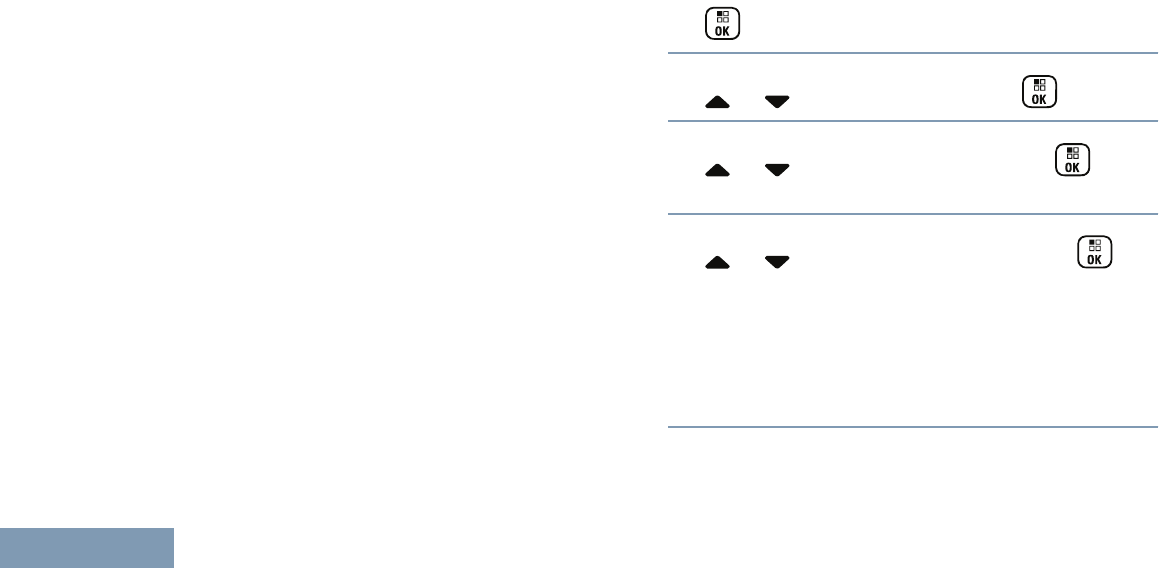
administrator to determine how your radio has
been programmed.
If you enable Man Down to maximum
sensitivity and set Vibrate Style to high, the
radio automatically restricts Vibrate Style to
medium. This function prevents high Vibrate
Style from initiating the Man Down emergency
feature.
The procedure for turning the Man Down Alarms On
and Off depends on how your radio is programmed. If
programmed with a Man Down Alarms On/Off button,
use the button to toggle the Man Down Alarms On
and Off. This applies to all of the Man Down Alarms
enabled for your radio.
When using the programmable button to toggle the
Man Down Alarms On, your radio plays a tone that
rises in pitch and displays a brief confirmation
message.
When using the programmable button to toggle the
Man Down Alarms Off, your radio plays a tone that
falls in pitch and shows a brief confirmation message.
In order to hear the tones described above when
turning the Man Down Alarms On and Off, the
MOTOTRBO radio and Connect Plus Option Board
must both be enabled for keypad tones.
If your radio has been programmed so that Man
Down Alarms can be turned On and Off via the menu,
perform the following procedure.
1
to access the menu.
2
or to Utilities and press to select.
3
or to Connect Plus and press to
select.
4
or to Man Down Alarm and press to
select.
If Man Down Alarm is currently disabled, the
Enable option is shown.
If Man Down Alarm is currently enabled, the
Disable option is shown.
Advanced Features in Connect Plus Mode
240
English
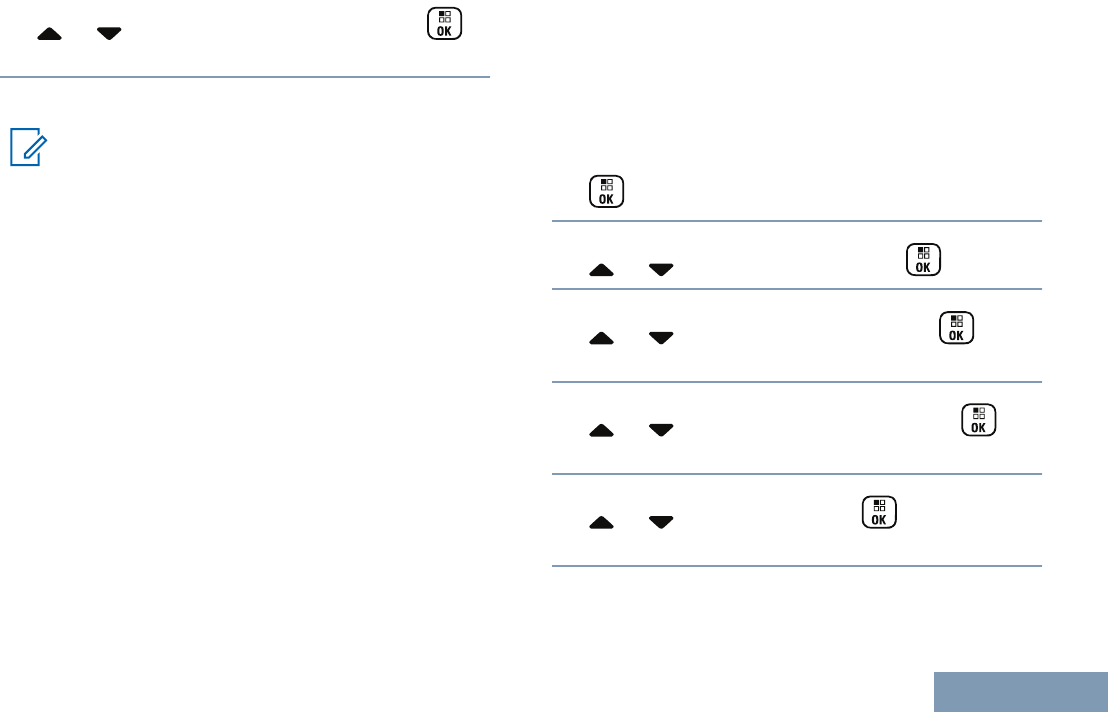
5
or to Enable or Disable and press
to select.
Resetting the Man Down Alarms
Note:
This feature is applicable to XPR 7550e/XPR
7580e only.
If your radio has been programmed with either a Man
Down Alarms Reset button, or the Man Down Alarms
menu option, it is possible to reset the Man Down
Alarms without turning them On or Off. This stops any
Man Down Alert Tone that is currently playing, and it
also resets the Alarm timers. However, it is still
necessary to correct the movement violation by taking
the appropriate corrective action described in the Man
Down Alarms section. If the movement violation is not
corrected within a period of time, the Alert Tone starts
playing again.
The procedure for resetting the Man Down Alarms
depends on how your radio is programmed. If
programmed with a Man Down Alarms Reset button,
use the button to Reset the Man Down Alarms. This
applies to all of the Man Down Alarms enabled for
your radio.
When using the programmable button to reset the
Man Down Alarms, the radio shows a brief
confirmation message.
If your radio has been programmed so that Man
Down Alarms can be Reset via the menu, follow the
procedure below.
1
to access the menu.
2
or to Utilities and press to select.
3
or to Connect Plus and press to
select.
4
or to Man Down Alarm and press to
select.
5
or to Reset and press to select.
The radio displays a brief confirmation message.
Advanced Features in Connect Plus Mode
241
English

Beacon Feature
This section describes the Beacon feature. The
Beacon feature is part of Connect Plus Man Down, a
purchasable feature. Your dealer or Radio System
Administrator can tell you if the Beacon feature
applies to your radio.
If your radio has been enabled and programmed for
one or more of the Man Down Alarms, it can also be
enabled for the Beacon feature.
If your radio automatically starts an Emergency Call
or Emergency Alert due to one of the Man Down
Alarms, and if your radio is also enabled for the
Beacon feature, the radio starts to periodically emit a
high pitched tone approximately once every ten
seconds. The interval can vary depending on whether
you are talking on your radio. The purpose of the
Beacon tone is to help searchers locate you. If your
radio has also been enabled for the “Visual Beacon”,
the radio’s backlight comes on for a few seconds
every time the Beacon tone plays.
You can stop your radio from playing the Beacon tone
by using a programmable button, if your radio has
been configured in this manner. This is discussed in
the next two sections. If your radio does not have the
programmable button or menu option, you can stop
the Beacon tone by turning the radio off and then on
again, or by changing to a different zone (if your radio
has been programmed for more than one zone).
Turning Beacon On and Off
The procedure for turning the Beacon On and Off
depends on how your radio is programmed. If
programmed with a Beacon On/Off button, use the
button to toggle the Beacon On and Off.
• When using the programmable button to toggle
the Beacon On, your radio plays a tone that rises
in pitch and shows a brief confirmation message.
• When using the programmable button to toggle
the Beacon Off, your radio plays a tone that falls in
pitch and shows a brief confirmation message.
In order to hear the tones described above when
turning the Beacon On and Off, the MOTOTRBO
radio and Connect Plus Option Board must both be
enabled for keypad tones. If your radio has been
programmed so that the Beacon can be turned On
and Off via the menu, follow the procedure below.
1
to access the menu.
Advanced Features in Connect Plus Mode
242
English
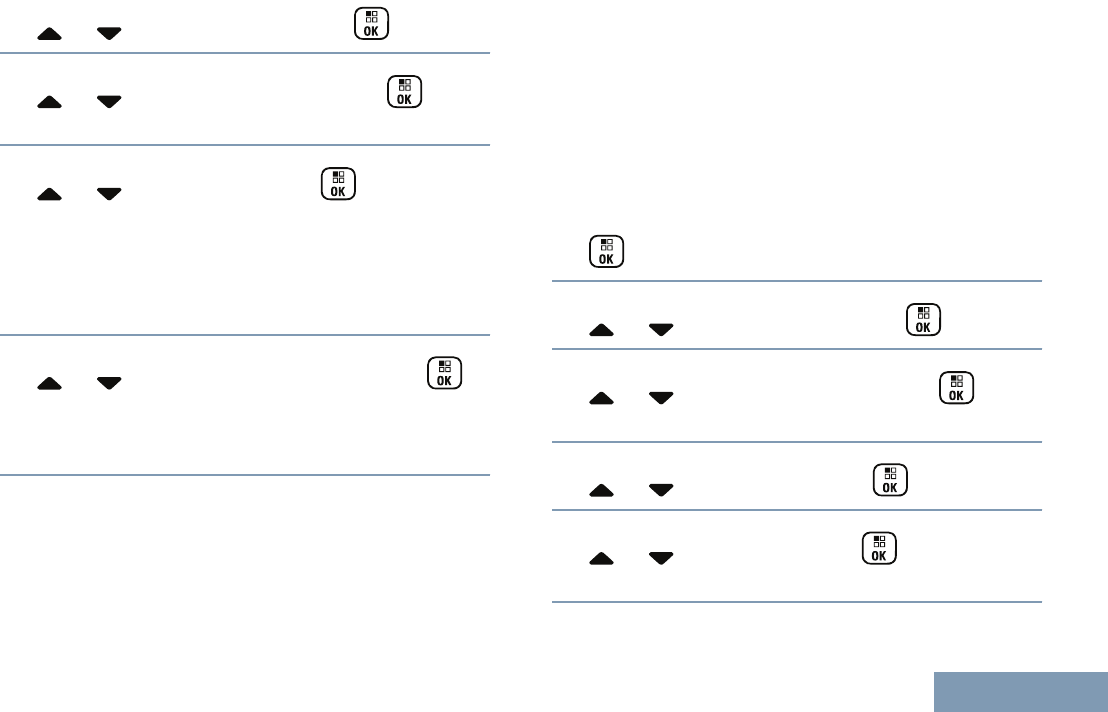
2
or to Utilities and press to select.
3
or to Connect Plus and press to
select.
4
or to Beacon and press to select.
If Beacon is currently disabled, the Enable option
is shown.
If Beacon is currently enabled, the Disable option
is shown.
5
or to Enable or Disable and press
to select.
The radio shows a brief message to confirm that
Man Down Beacon was enabled (or disabled).
Resetting the Beacon
If your radio has been programmed with either the
Beacon Reset button, or the Beacon menu option, it
is possible to reset the Beacon. This stops the
Beacon Tone (and also the Visual Beacon) without
turning the Beacon feature Off. The procedure for
resetting the Beacon depends on how your radio is
programmed. If programmed with a Beacon Reset
button, use the button to Reset the Beacon. When
using the programmable button to reset the Man
Down Alarms, your radio shows a brief confirmation
message. If your radio has been programmed so that
the Beacon can be Reset via the menu, follow the
procedure below.
1
to access the menu.
2
or to Utilities and press to select.
3
or to Connect Plus and press to
select.
4
or to Beacon and press to select.
5
or to Reset and press to select.
The radio displays a brief confirmation message.
Advanced Features in Connect Plus Mode
243
English
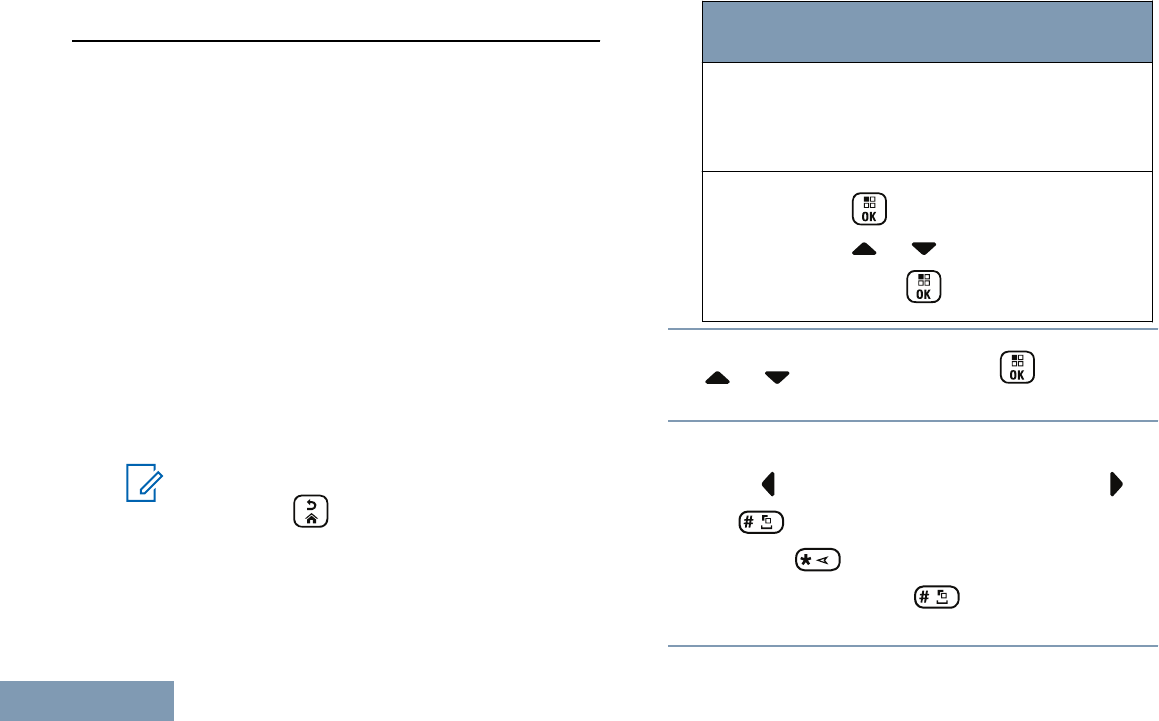
Text Message Features
Your radio is able to receive data, for example a text
message, from another radio or a text message
application.
The maximum length of characters for sending a text
message, including the subject line (seen when
receiving message from an e-mail application),
depends on CPS configuration which can be
configured up to maximum 280 characters. Your radio
can receive a text message with maximum length of
280 characters.
If user forwards a text message with characters more
than the maximum length, the text message will be
truncated to the maximum length.
The radio exits the current screen once the inactivity
timer expires.
Note:
Long press at any time to return to the
Home screen.
Writing and Sending a Text Message
1Access the Text Message feature.
Radio
Controls
Steps
Program-
med Text
Message
button
Press the programmed Text Mes-
sage button.
Menu 1
to access the menu.
2 or to Messages and
press to select.
2
or to Compose and press to select.
A blinking cursor appears.
3Use the keypad to type your message.
Press to move one space to the left. Press or
the key to move one space to the right.
Press the key to delete any unwanted
characters. Long press to change text entry
method.
Advanced Features in Connect Plus Mode
244
English
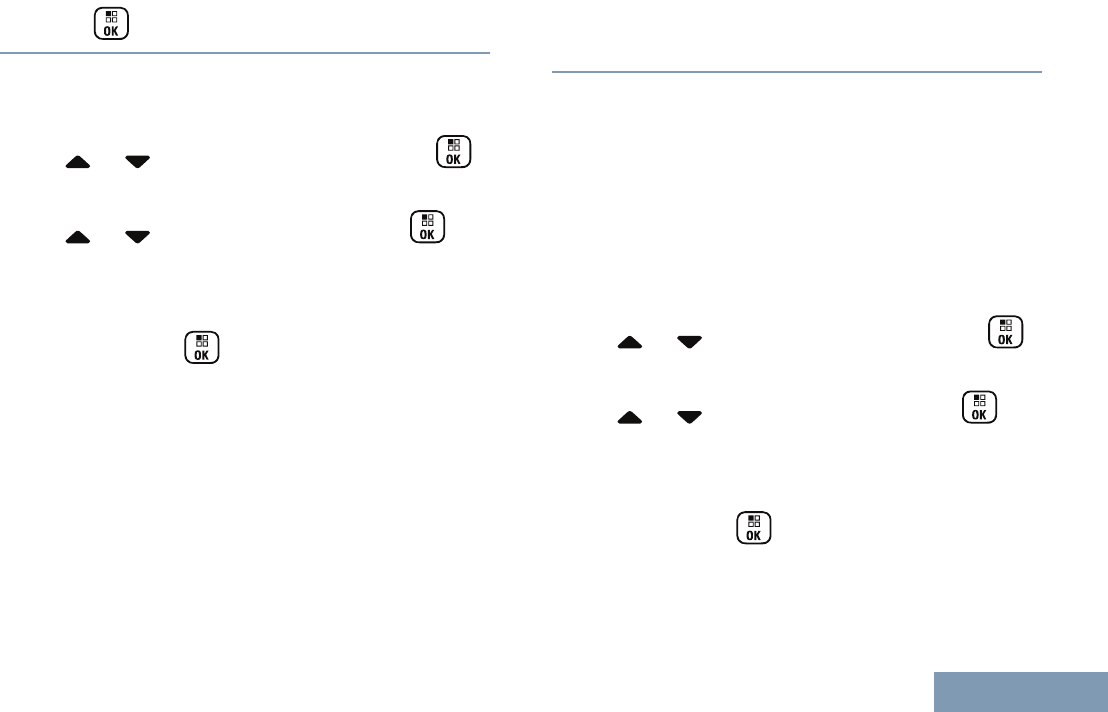
4
Press once message is composed.
5If you are sending the message, select the
recipient by
•
or to the required alias and press
to select.
•
or to Manual Dial, and press to
select. The first line of the display shows
Number:. The second line of the display shows
a blinking cursor. Key in the subscriber alias or
ID and press .
The display shows Sending Message, confirming
your message is being sent.
If the message is sent successfully, a tone sounds
and the display shows Message Sent.
If the message cannot be sent, a low tone sounds
and the display shows Message Send Failed.
If the text message fails to send, the radio returns
you to the Resend option screen (see Managing
Fail-to-Send Text Messages on page 248).
Sending a Quick Text Message
Your radio supports a maximum of 10 Quick Text
messages as programmed by your dealer.
While Quick Text messages are predefined, you can
edit each message before sending it.
If you are sending the message, select the
recipient by
•
or to the required alias and press
to select.
•
or to Manual Dial, and press to
select. The first line of the display shows
Number:. The second line of the display shows
a blinking cursor. Key in the subscriber alias or
ID and press .
The display shows Sending Message, confirming
your message is being sent.
Advanced Features in Connect Plus Mode
245
English

If the message is sent successfully, a tone sounds
and the display shows Message Sent.
If the message cannot be sent, a low tone sounds
and the display shows Message Send Failed.
If the text message fails to send, the radio returns
you to the Resend option screen (see Managing
Fail-to-Send Text Messages on page 248).
Sending a Quick Text Message with the One Touch
Access Button
Press the programmed One Touch Access
button to send a predefined Quick Text message
to a predefined alias.
The display shows Sending Message, confirming
your message is being sent.
If the message is sent, a tone sounds and the display
shows Message Sent.
If the message cannot be sent, a low tone sounds
and the display shows Message Send Failed.
If the text message fails to send, the radio returns you
to the Resend option screen (see Managing Fail-to-
Send Text Messages on page 248).
Accessing the Drafts Folder
You can save a text message to send it at a later
time.
If a PTT button press or a mode change causes the
radio to exit the text message writing/editing screen
while you are in the process of writing or editing a text
message, your current text message is automatically
saved to the Drafts folder.
The most recent saved text message is always added
to the top of the Drafts list.
The Drafts folder stores a maximum of ten (10) last
saved messages. When the folder is full, the next
saved text message automatically replaces the oldest
text message in the folder.
Note:
Long press at any time to return to the
Home screen.
Viewing a Saved Text Message
1Access the Text Message feature.
Advanced Features in Connect Plus Mode
246
English

Radio Con-
trols
Steps
Programmed
Text Message
button
Press the programmed Text
Message button.
Menu 1
to access the menu.
2 or to Messages and
press to select.
2
or to Drafts and press to select.
3 or to the required message and press
to select.
Editing and Sending a Saved Text Message
1
Press again while viewing the message.
2
or to Edit and press to select.
A blinking cursor appears.
3Use the keypad to type your message.
Press to move one space to the left. Press or
the key to move one space to the right.
Press the key to delete any unwanted
characters. Long press to change text entry
method.
4
Press once message is composed.
5Select the message recipient by
•
or to the required alias and press
to select.
•
or to Manual Dial, and press to
select. The first line of the display shows
Number:. The second line of the display shows
a blinking cursor. Key in the subscriber alias or
ID and press .
Advanced Features in Connect Plus Mode
247
English
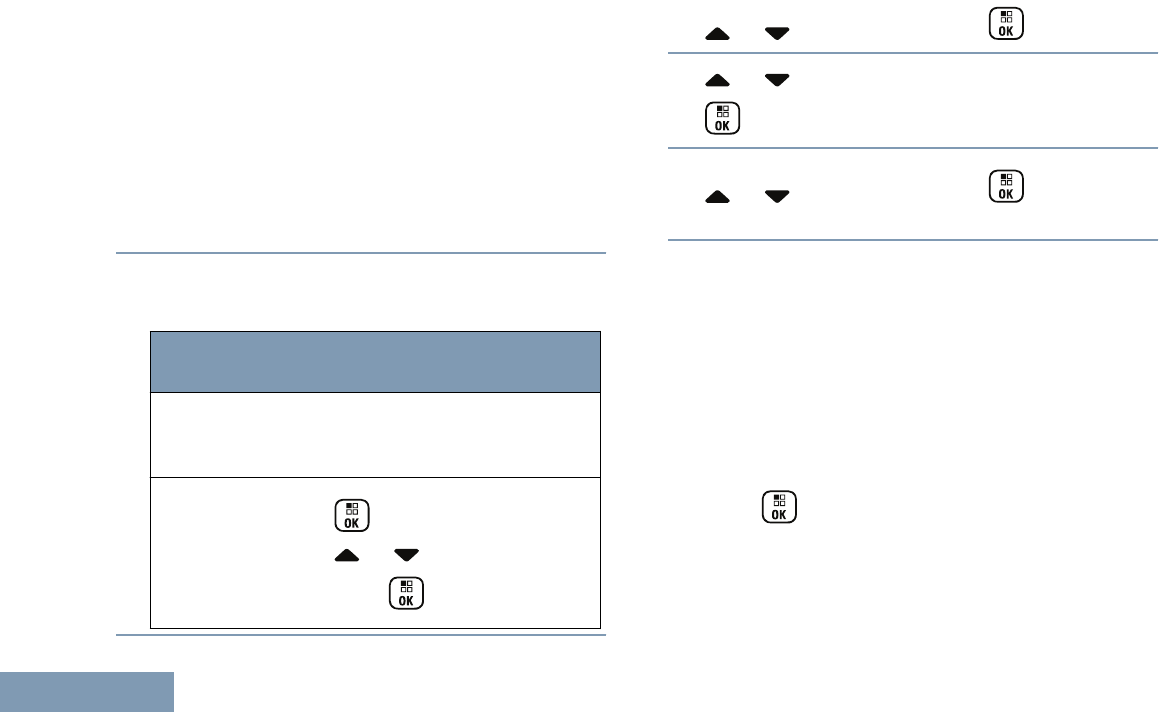
The display shows Sending Message, confirming
your message is being sent.
If the message is sent successfully, a tone sounds
and the display shows Message Sent.
If the message cannot be sent, a low tone sounds
and the display shows Message Send Failed.
If the text message cannot be sent, it is moved to
the Sent Items folder and marked with a Send
Failed icon.
Deleting a Saved Text Message from Drafts
1Access the Text Message feature.
Radio Con-
trols
Steps
Programmed
Text Message
button
Press the programmed Text
Message button.
Menu 1
to access the menu.
2 or to Messages and
press to select.
2
or to Drafts and press to select.
3 or to the required message and press
to select.
4
or to Delete and press to delete the
text message.
Managing Fail-to-Send Text Messages
You can select one of the following options while at
the Resend option screen:
• Resend
• Forward
•Edit
Resending a Text Message
Press to resend the same message to the
same subscriber/group alias or ID.
If the message is sent successfully, a tone sounds
and the display shows the positive mini notice.
Advanced Features in Connect Plus Mode
248
English
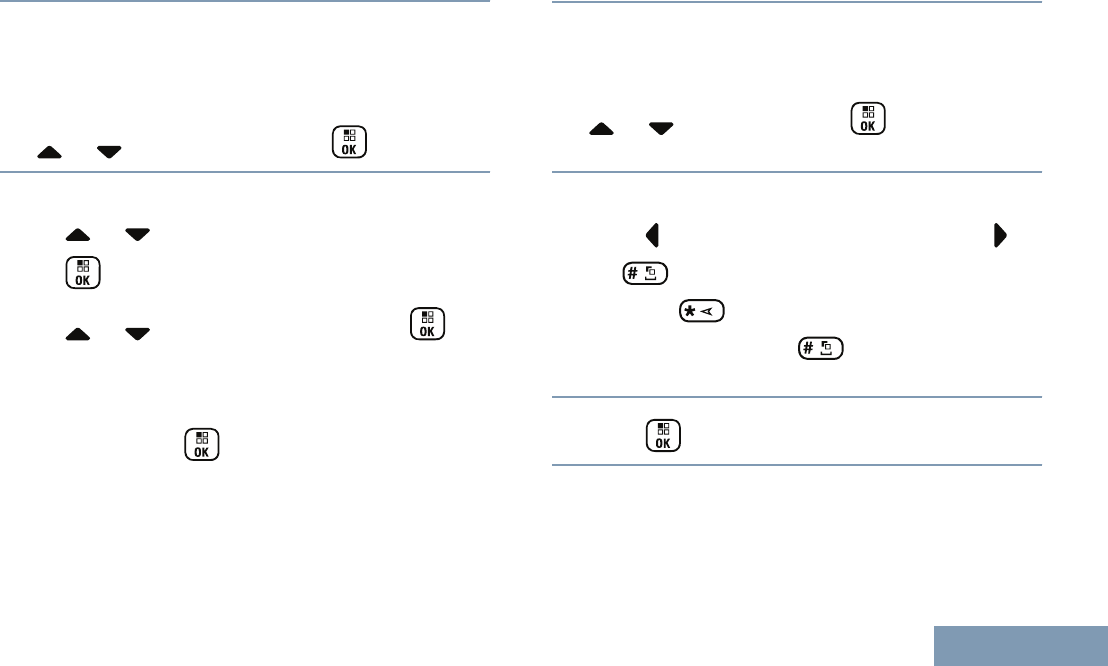
If the message cannot be sent, the display shows
the negative mini notice.
Forwarding a Text Message
Select Forward to send the message to another
subscriber/group alias or ID.
1
or to Forward and press to select.
2Select the message recipient by
• or to the required alias or ID and press
to select.
•
or to Manual Dial, and press to
select. The first line of the display shows
Number:. The second line of the display shows
a blinking cursor. Key in the subscriber alias or
ID and press .
The display shows Sending Message, confirming
your message is being sent.
If the message is sent successfully, a tone sounds
and the display shows Message Sent.
If the message cannot be sent, a low tone sounds
and the display shows Message Send Failed.
Editing a Text Message
Select Edit to edit the message before sending it.
1
or to Edit and press to select.
A blinking cursor appears.
2Use the keypad to edit your message.
Press to move one space to the left. Press or
the key to move one space to the right.
Press the key to delete any unwanted
characters. Long press to change text entry
method.
3
Press once message is composed.
4Depending on whether you want to send, save, re-
edit, or delete the newly composed message, do
one of the following.
Advanced Features in Connect Plus Mode
249
English
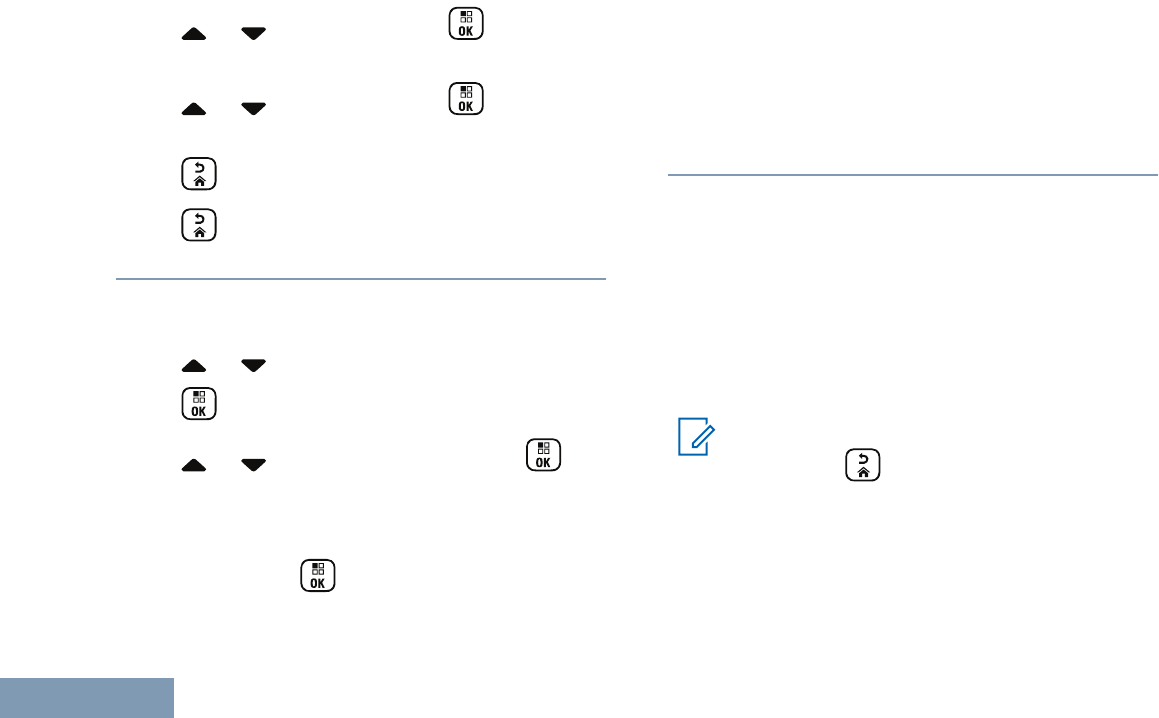
•
or to Send, and press to send the
message.
•
or to Save, and press to save the
message to the Drafts folder.
•
to edit the message.
•
again to choose between deleting the
message or saving it to the Drafts folder.
5If you are sending the message, select the
recipient by
• or to the required alias or ID and press
to select.
•
or to Manual Dial, and press to
select. The first line of the display shows
Number:. The second line of the display shows
a blinking cursor. Key in the subscriber alias or
ID and press .
The display shows Sending Message, confirming
your message is being sent.
If the message is sent successfully, a tone sounds
and the display shows Message Sent.
If the message cannot be sent, a low tone sounds
and the display shows Message Send Failed.
Managing Sent Text Messages
Once a message is sent to another radio, it is saved
in Sent Items. The most recent sent text message is
always added to the top of the Sent Items list.
The Sent Items folder is capable of storing a
maximum of thirty (30) last sent messages. When the
folder is full, the next sent text message automatically
replaces the oldest text message in the folder.
Note:
Long press at any time to return to the
Home screen.
Viewing a Sent Text Message
1Access the Text Message feature.
Advanced Features in Connect Plus Mode
250
English
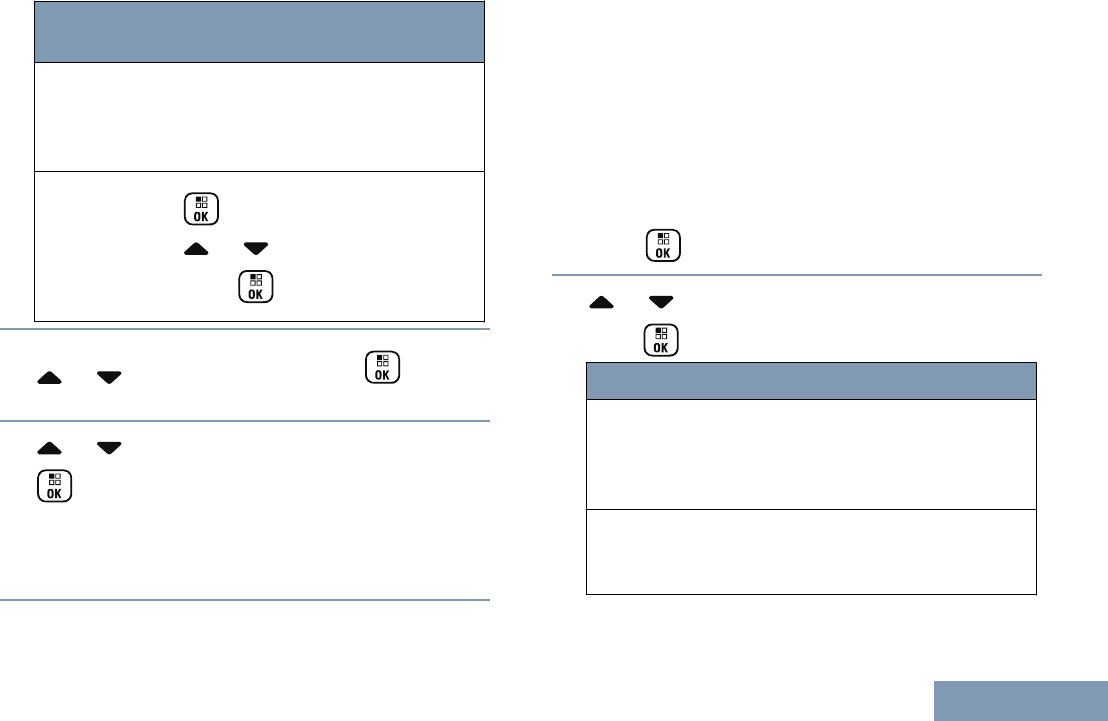
Radio
Controls
Steps
Program-
med Text
Message
button
Press the programmed Text Mes-
sage button.
Menu 1
to access the menu.
2 or to Messages and
press to select.
2
or to Sent Items and press to
select.
3 or to the required message and press
to select.
The icon at the top right corner of the screen
indicates the status of the message (see Sent Item
Icons on page 194).
Sending a Sent Text Message
You can select one of the following options while
viewing a sent text message:
• Resend
• Forward
•Edit
• Delete
1
Press again while viewing the message.
2 or to one of the following options and
press to select.
Option Steps
Forward Select Forward to send the selected
text message to another subscriber/
group alias or ID (see Forwarding a
Text Message on page 249).
Edit Select Edit to edit the selected text
message before sending it (see Ed-
iting a Text Message on page 249).
Advanced Features in Connect Plus Mode
251
English
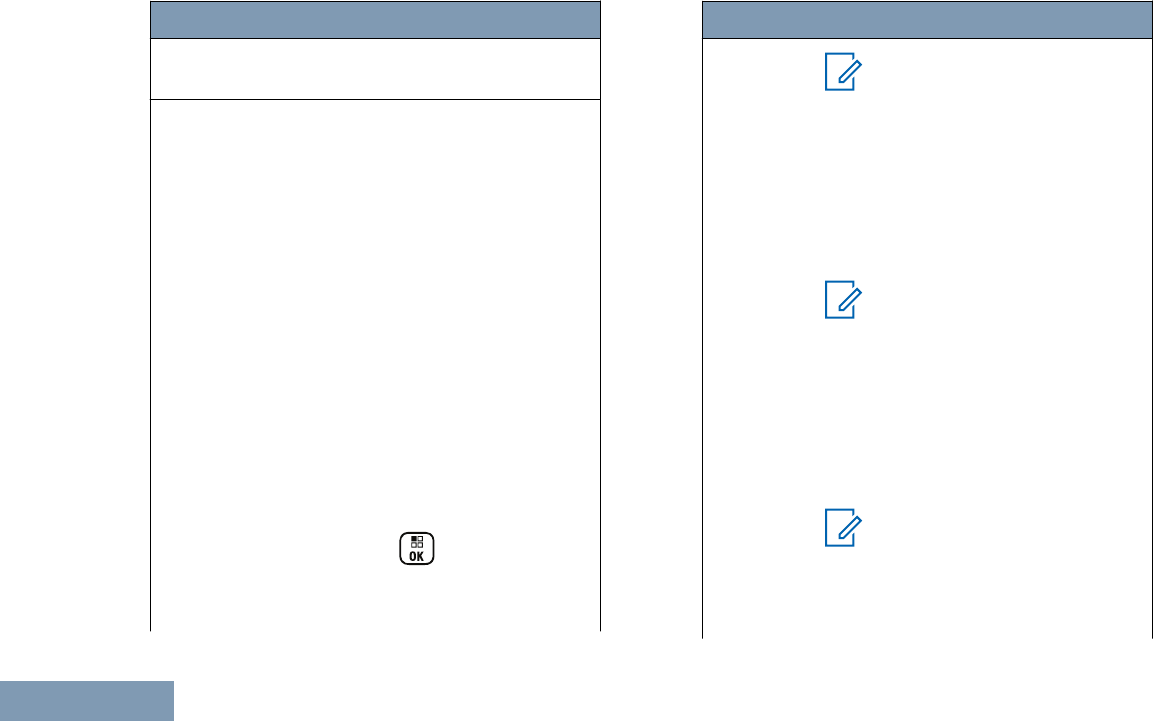
Option Steps
Delete Select Delete to delete the text
message.
Resend Select Resend to resend the select-
ed text message to the same sub-
scriber/group alias or ID.
The display shows Sending Mes‐
sage, confirming that the same mes-
sage is being sent to the same tar-
get radio.
If the message is sent successfully,
a tone sounds and the display
shows Message Sent.
If the message cannot be sent, a
low tone sounds and the display
shows Message Send Failed.
If the message fails to send, the ra-
dio returns you to the Resend option
screen. Press to resend the
message to the same subscriber/
group alias or ID.
Option Steps
Note:
If you exit the message
sending screen while the
message is being sent, the
radio updates the status of
the message in the Sent
Items folder without provid-
ing any indication in the dis-
play or via sound.
Note:
If the radio changes mode or
powers down before the sta-
tus of the message in Sent
Items is updated, the radio
cannot complete any In-
Progress messages and au-
tomatically marks it with a
Send Failed icon.
Note:
The radio supports a maxi-
mum of five (5) In-Progress
messages at one time. Dur-
ing this period, the radio
Advanced Features in Connect Plus Mode
252
English
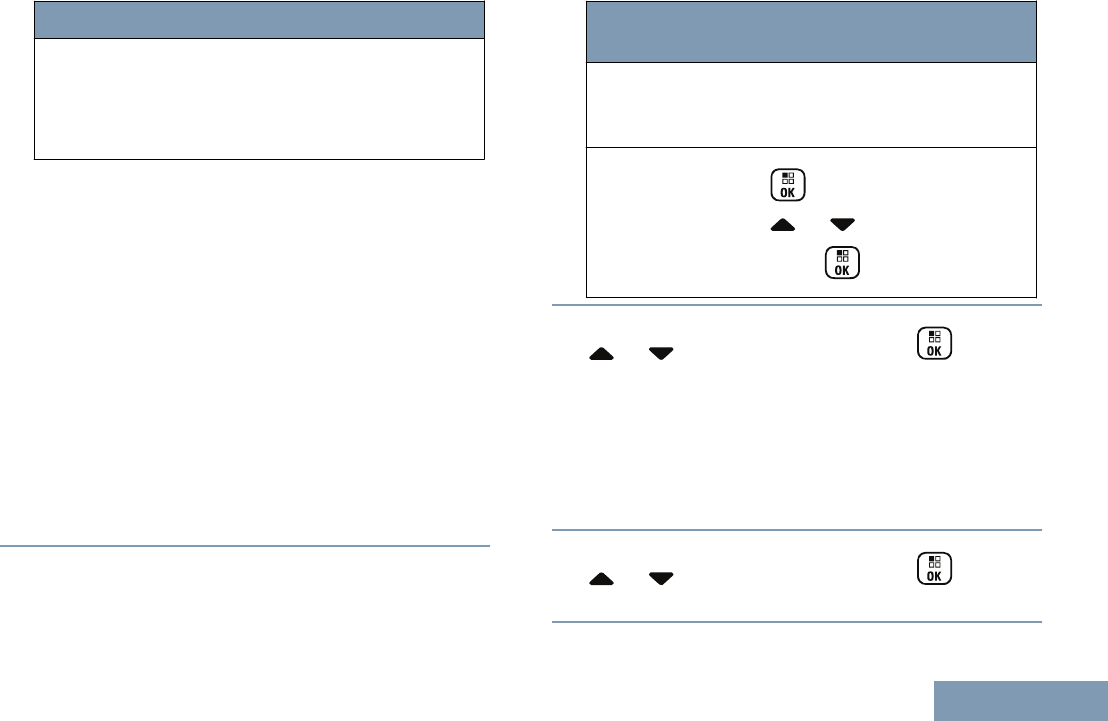
Option Steps
cannot send any new mes-
sage and automatically
marks it with a Send Failed
icon.
If you exit the message sending screen while the
message is being sent, the radio updates the
status of the message in the Sent Items folder
without providing any indication in the display or
via sound.
If the radio changes mode or powers down before
the status of the message in Sent Items is
updated, the radio cannot complete any In-
Progress messages and automatically marks it
with a Send Failed icon.
The radio supports a maximum of five (5) In-
Progress messages at one time. During this
period, the radio cannot send any new message
and automatically marks it with a Send Failed icon.
Deleting All Sent Text Messages from Sent Items
1Access the Text Message feature by performing
one of the following actions:
Radio Con-
trols
Steps
Programmed
Text Message
button
Press the programmed Text
Message button.
Menu 1
to access the menu.
2 or to Messages and
press to select.
2
or to Sent Items and press to
select.
When you select Sent Items and it contains no
text messages, the display shows List Empty,
and sounds a low tone if Keypad Tones are turned
on (see Turning Keypad Tones On or Off on page
152).
3
or to Delete All and press to
select.
Advanced Features in Connect Plus Mode
253
English
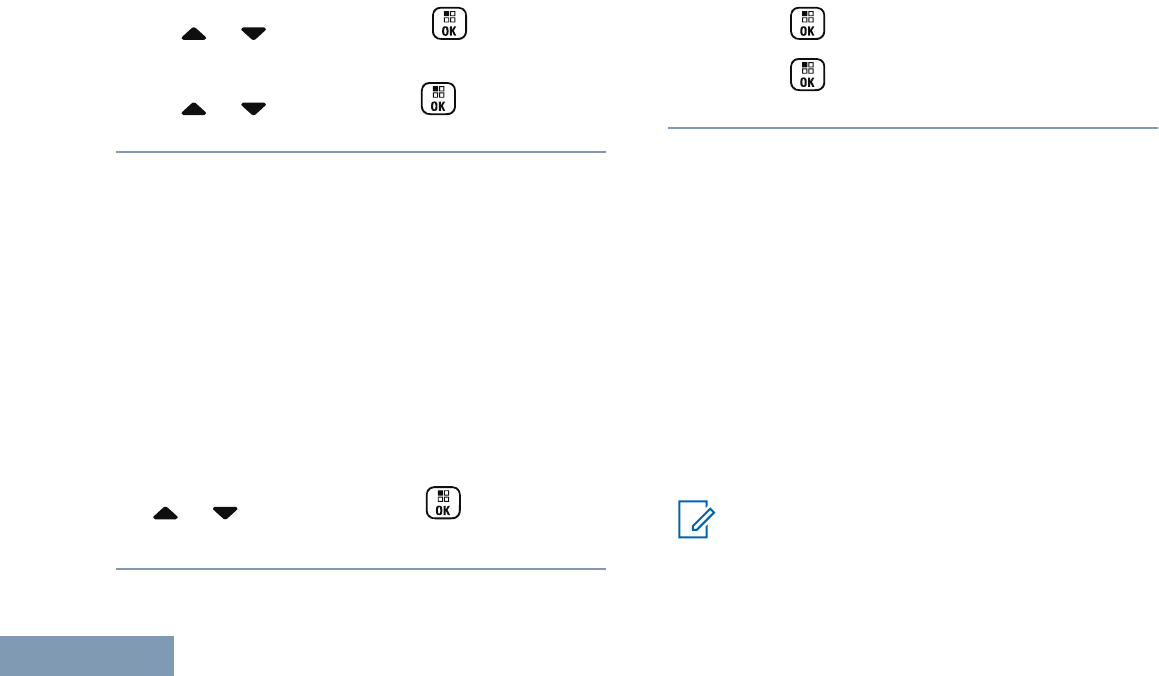
4Choose one of the following.
•
or to Yes and press to select. The
display shows positive mini notice.
•
or to No and press to return to the
previous screen.
Receiving a Text Message
When your radio receives a message, the display
shows the Notification List with the alias or ID of the
sender and the Message icon.
You can select one of the following options when
receiving a text message:
• Read
• Read Later
•Delete
Reading a Text Message
1
or to Read? and press to select.
Selected message in the Inbox opens.
2Do one of the following:
•
Press to return to the Inbox.
•
Press a second time to reply, forward, or
delete the text message.
Managing Received Text Messages
Use the Inbox to manage your text messages. The
Inbox is capable of storing a maximum of 30
messages.
Text messages in the Inbox are sorted according to
the most recently received.
Your radio supports the following options for text
messages:
• Reply
• Forward
•Delete
• Delete All
Note:
If the channel type is not a match, you can
only forward, delete, or delete all Received
messages.
Advanced Features in Connect Plus Mode
254
English
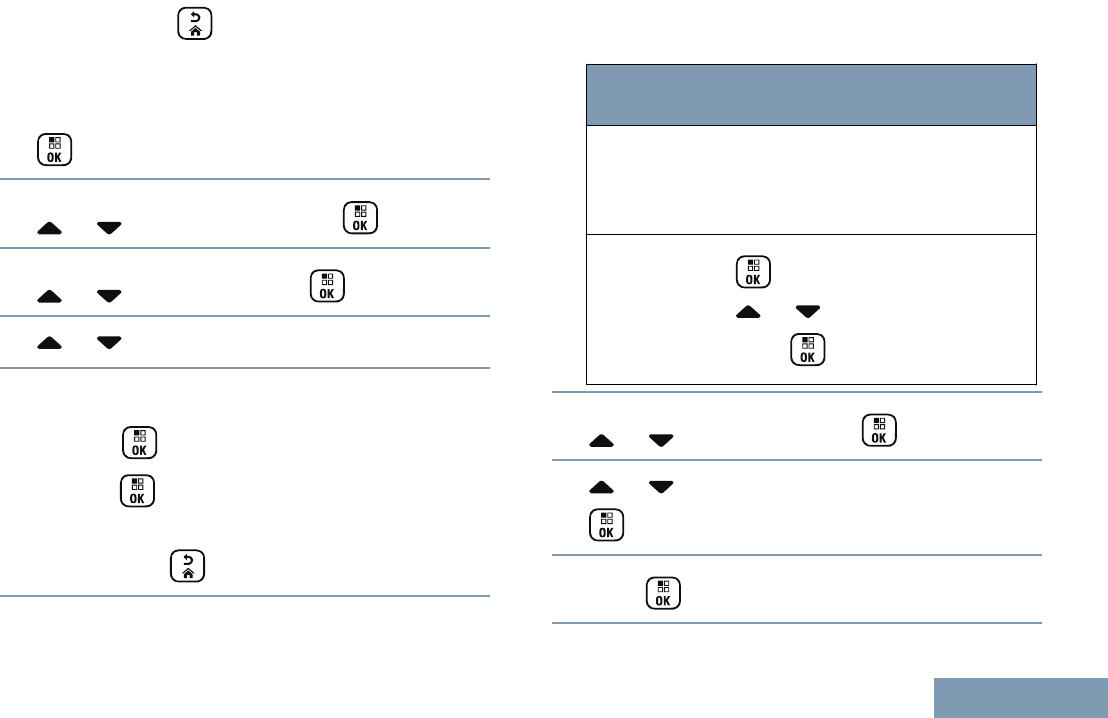
Long press at any time to return to the
Home screen.
Viewing a Text Message from the Inbox
1
to access the menu.
2
or to Messages and press to select.
3
or to Inbox and press to select.
4 or toview the messages.
5Do one of the following:
•
Press to select the current message, and
press again to reply, forward, or delete
that message.
•
Long press to return to the Home screen.
Replying to a Text Message from the Inbox
1Access the Text Message feature.
Radio
Controls
Steps
Program-
med Text
Message
button
Press the programmed Text Mes-
sage button.
Menu 1
to access the menu.
2 or to Messages and
press to select.
2
or to Inbox and press to select.
3 or to the required message and press
to select.
4
Press once more to access the sub-menu.
Advanced Features in Connect Plus Mode
255
English
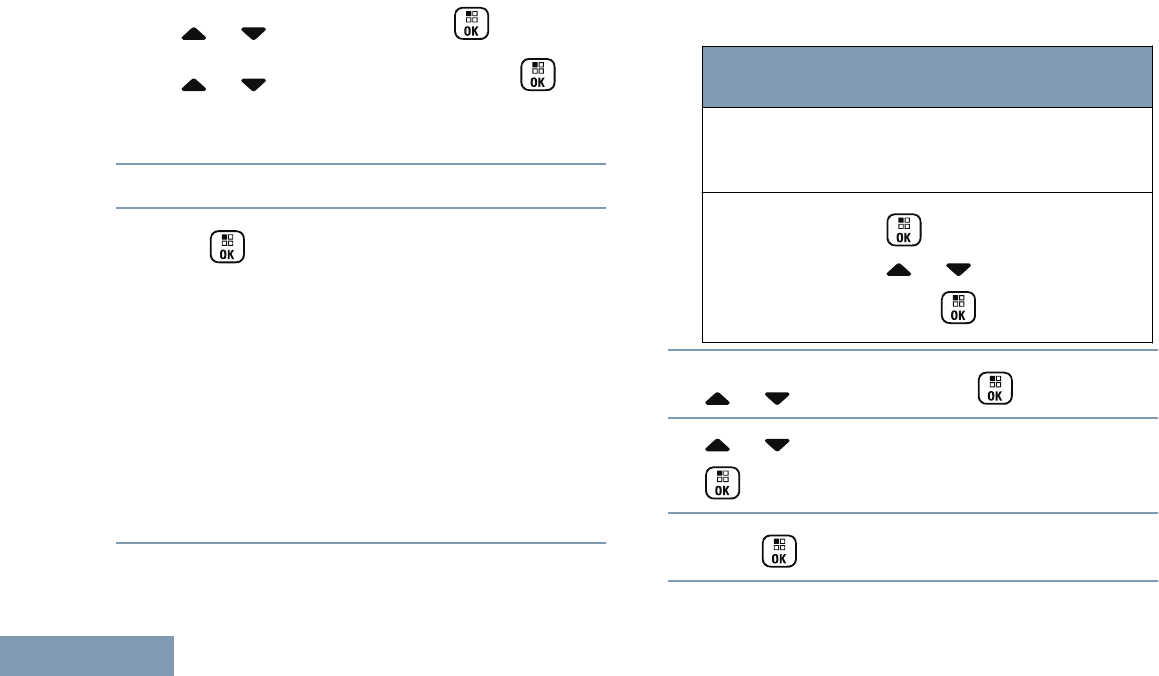
5Do one of the following:
•
or to Reply and press to select.
•
or to Quick Reply and press to
select.
A blinking cursor appears.
6Use your keypad to write/edit your message.
7
Press once message is composed.
The display shows Sending Message, confirming
your message is being sent.
If the message is sent successfully, a tone sounds
and the display shows Message Sent.
If the message cannot be sent, a low tone sounds
and the display shows Message Send Failed.
If the message cannot be sent, the radio returns
you to the Resend option screen (see Managing
Fail-to-Send Text Messages on page 248).
Deleting a Text Message from the Inbox
1Access the Text Message feature by performing
one of the following actions:
Radio Con-
trols
Steps
Programmed
Text Message
button
Press the programmed Text
Message button.
Menu 1
to access the menu.
2 or to Messages and
press to select.
2
or to Inbox and press to select.
3 or to the required message and press
to select.
4
Press once more to access the sub-menu.
Advanced Features in Connect Plus Mode
256
English
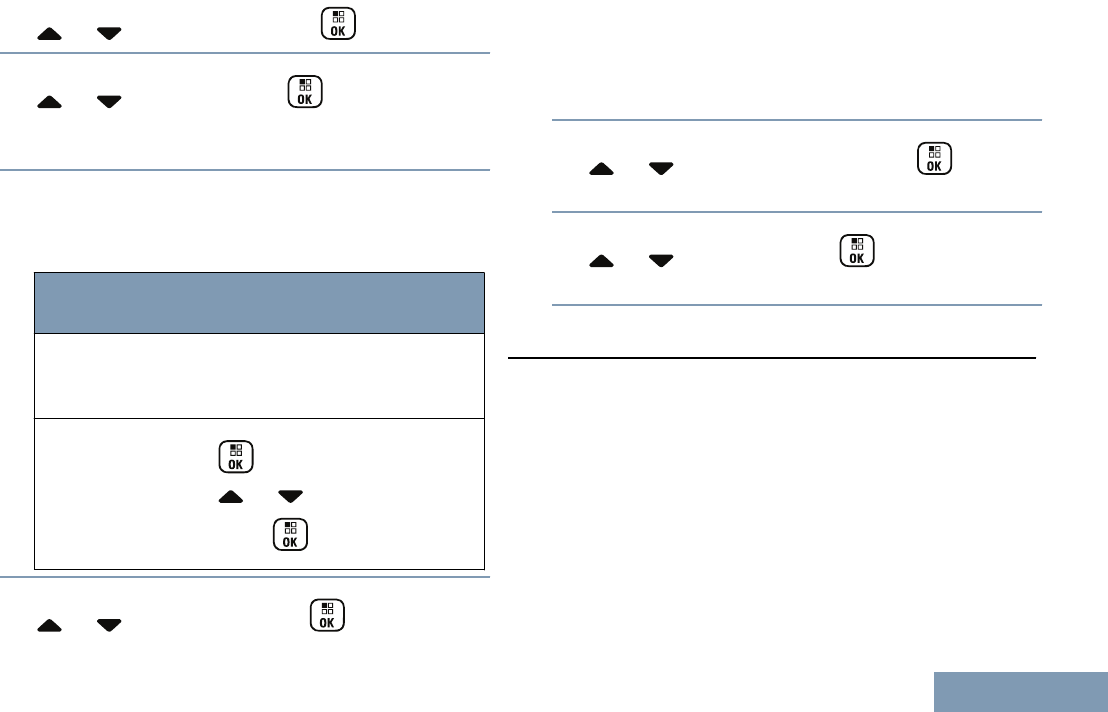
5
or to Delete and press to select.
6
or to Yes and press to select.
The display shows Message Deleted, and the
screen returns to the Inbox.
Deleting All Text Messages from the Inbox
1Access the Text Message feature by performing
one of the following actions:
Radio Con-
trols
Steps
Programmed
Text Message
button
Press the programmed Text
Message button.
Menu 1
to access the menu.
2 or to Messages and
press to select.
2
or to Inbox and press to select.
When you select Inbox and it contains no text
messages, the display shows List Empty, and
sounds a low tone if Keypad Tones are turned on
(see Turning Keypad Tones On or Off on page
152).
3
or to Delete All and press to
select.
4
or to Yes and press to select.
The display shows Inbox Cleared.
Privacy
If enabled, this feature helps to prevent
eavesdropping by unauthorized users on a channel
by the use of a software-based scrambling solution.
The signaling and user identification portions of a
transmission are not scrambled.
Your radio must have privacy enabled on the current
channel selector position to send a privacy-enabled
transmission, although this is not a necessary
requirement for receiving a transmission. While on a
privacy-enabled channel selector position, the radio is
Advanced Features in Connect Plus Mode
257
English
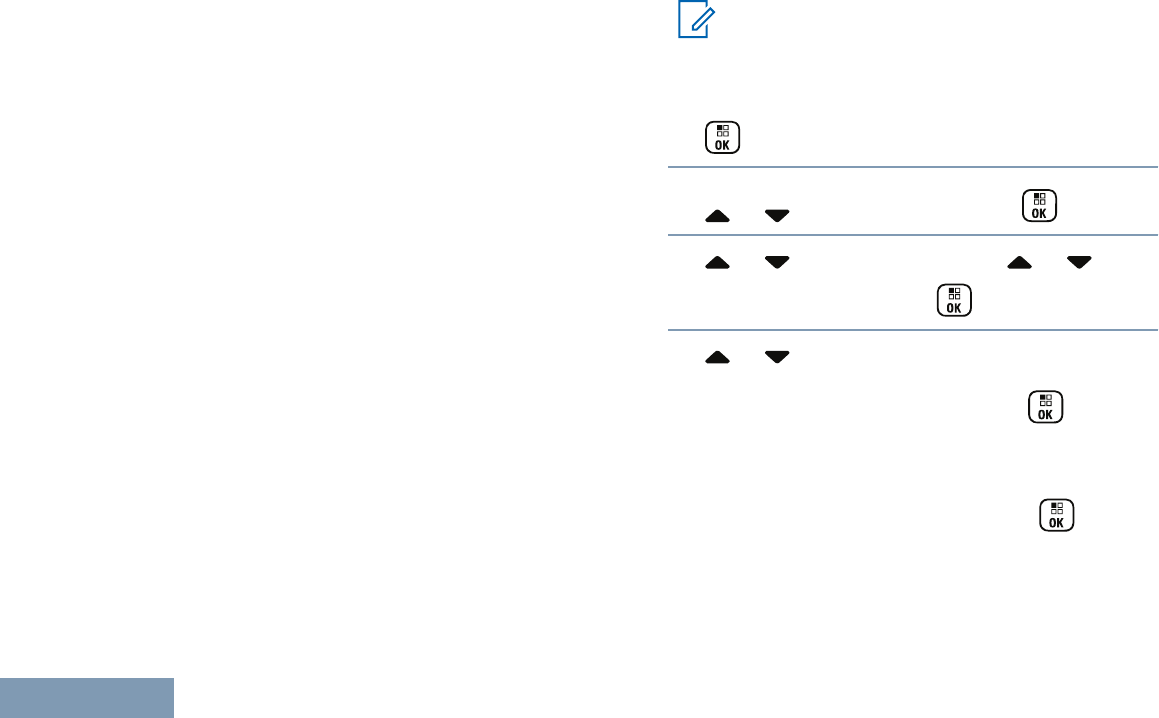
still able to receive clear (unscrambled)
transmissions.
Your radio supports Enhanced Privacy.
To unscramble a privacy-enabled call transmission,
your radio must be programmed to have the same
Key Value and Key ID (for Enhanced Privacy) as the
transmitting radio.
If your radio receives a scrambled call that is of a
different Key Value and Key ID, you hear nothing at
all (Enhanced Privacy).
If the radio has a privacy type assigned, the Home
screen shows the Secure or Unsecure icon, except
when the radio is sending or receiving an Emergency
call or alarm.
The LED lights up solid green while the radio is
transmitting and blinks green rapidly when the radio is
receiving an ongoing privacy-enabled transmission.
You can access this feature by performing one of the
following actions:
• Pressing the programmed Privacy button to
toggle privacy on or off.
•Using the Radio Menu as described by the steps
described next.
Note:
Some radio models may not offer this Privacy
feature. Check with your dealer or system
administrator for more information.
1
to access the menu.
2
or to Utilities and press to select.
3 or to Radio Settings or or to
Connect Plus and press to select.
4 or to Enhanced Privacy.
If the display shows Turn On, press to
enable Privacy. The radio displays a message
confirming your selection.
If the display shows Turn Off, press to
disable Privacy. The radio displays a message
confirming your selection.
If the radio has a privacy type assigned, the
secure or unsecure icon appears on the status
Advanced Features in Connect Plus Mode
258
English
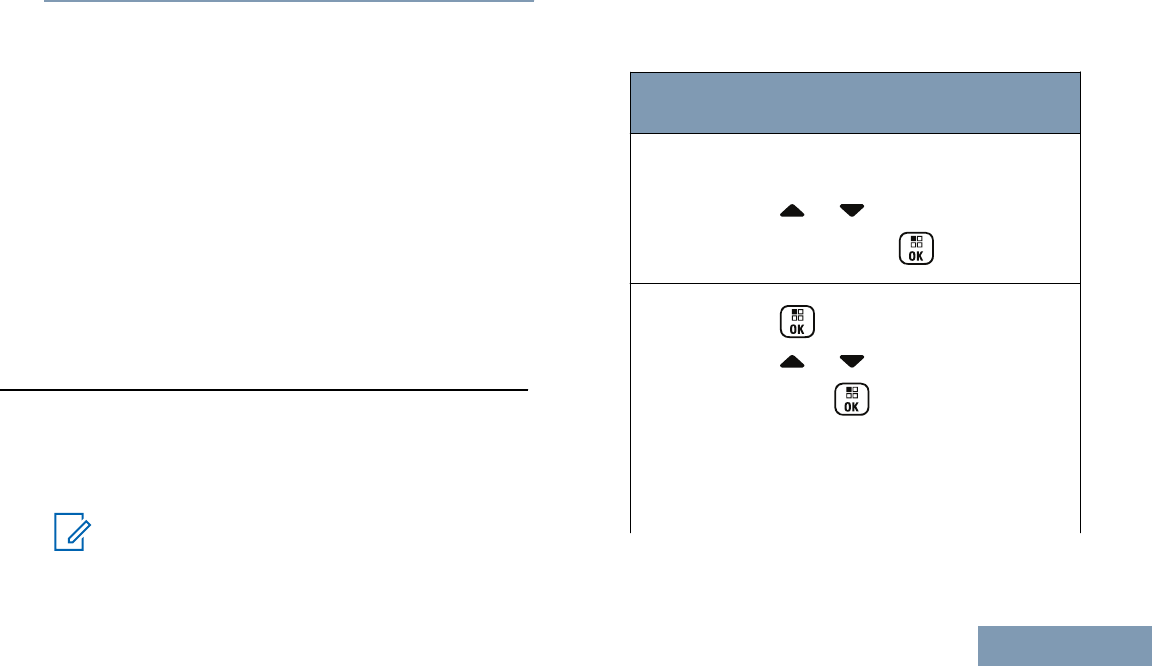
bar, except when the radio is sending or receiving
an Emergency Alert.
Making a Privacy-Enabled (Scrambled) Call
Toggle privacy on using the programmed privacy
button or by using the menu. Your radio must have
the Privacy feature enabled for the currently selected
channel position to send a privacy-enabled
transmission. When privacy is enabled for the
currently selected channel position, all voice
transmissions made by your radio will be scrambled.
This includes Group Call, Multigroup Call, talk-back
during scanned calls, Site All Call, Emergency Call,
and Private Call. Only receiving radios with the same
Key Value and Key ID as your radio will be able to
unscramble the transmission.
Security
You can enable or disable any radio in the system.
For example, you might want to disable a stolen
radio, to prevent the thief from using it, and enable
that radio, when it is recovered.
Note:
Performing Radio Disable and Enable is
limited to radios with these functions enabled.
Check with your dealer or system
administrator for more information.
Radio Disable
1Access this feature by
Radio
Controls
Steps
Radio Dis-
able but-
ton
1Press the programmed Radio
Disable button.
2 or to the required alias or
ID and press to select.
Radio
menu 1
to access the menu.
2 or to Contacts and
press to select. The entries
are alphabetically sorted.
3Use one of the steps described
next to select the required sub-
scriber alias or ID:
Advanced Features in Connect Plus Mode
259
English
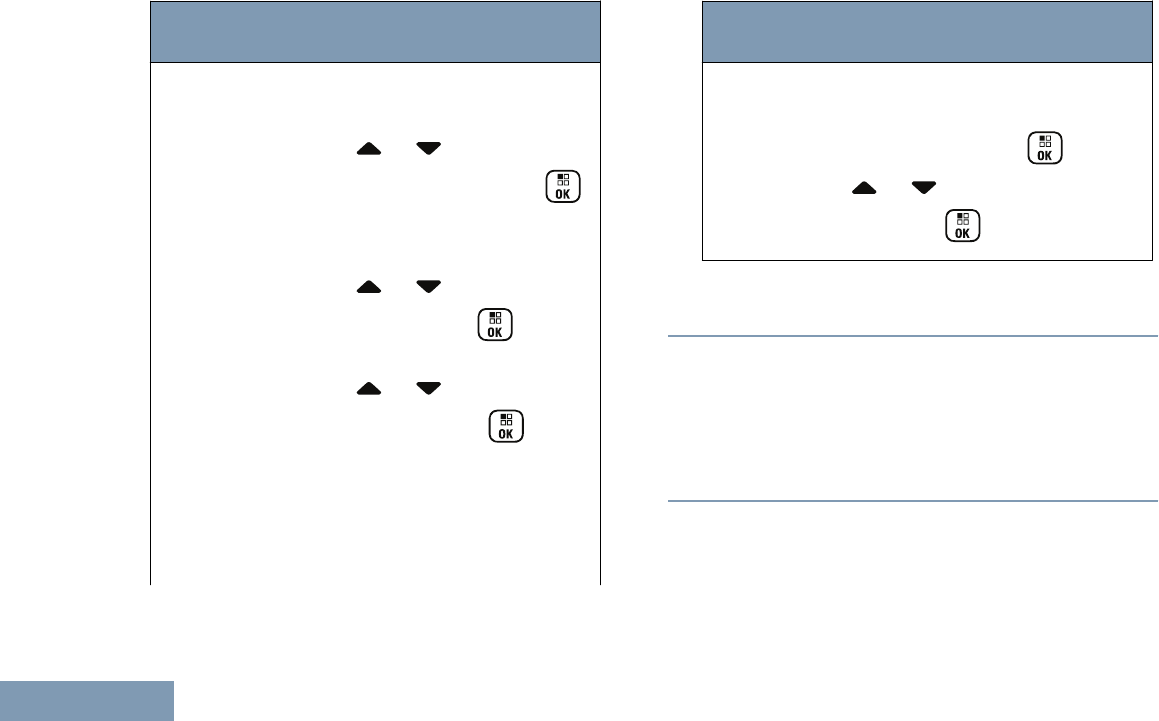
Radio
Controls
Steps
• Select the required alias or ID
directly.
• or to the required
alias or ID and press
to select.
•Use the Manual Dial menu
• or to Manual Di‐
al and press to se-
lect.
• or to Radio Num‐
ber and press to se-
lect.
• The first line of the display
shows Radio Number:.
The second line of the dis-
play shows a blinking cur-
Radio
Controls
Steps
sor. Use the keypad to en-
ter the subscriber alias or
ID and press .
4 or to Radio Disable
and press to select.
The display shows Radio Disable: <Target
Alias or ID> and the LED blinks green.
2Wait for acknowledgement.
If successful, a positive indicator tone sounds and
the display shows Radio Disable Successful.
If not successful, a negative indicator tone sounds
and the display shows Radio Disable Failed.
Radio Enable
1Access this feature by
Advanced Features in Connect Plus Mode
260
English
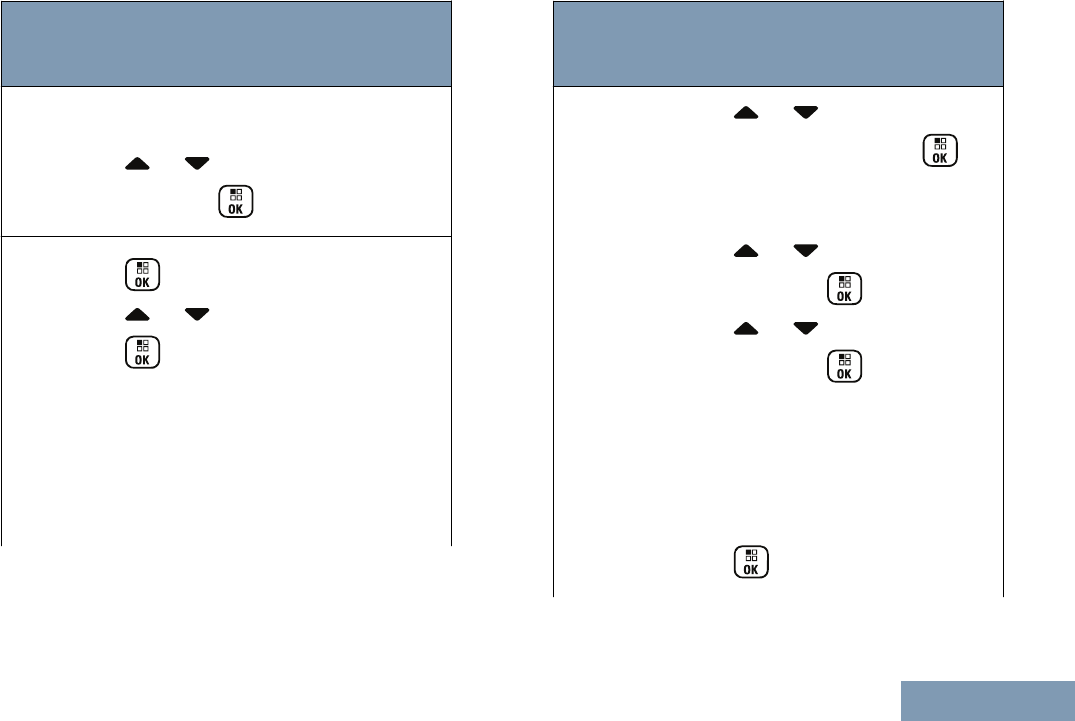
Radio
Con-
trols
Steps
Radio
Enable
button
1Press the programmed Radio Ena-
ble button.
2 or to the required alias or ID
and press to select.
Radio
menu 1
to access the menu.
2 or to Contacts and press
to select. The entries are al-
phabetically sorted.
3Use one of the steps described next
to select the required subscriber
alias or ID
• Select the required alias or ID di-
rectly.
Radio
Con-
trols
Steps
• or to the required
alias or ID and press to
select.
•Use the Manual Dial menu
• or to Manual Dial
and press to select.
• or to Radio Number
and press to select.
• The first line of the display
shows Radio Number:. The
second line of the display
shows a blinking cursor. Use
the keypad to enter the sub-
scriber alias or ID and press
.
Advanced Features in Connect Plus Mode
261
English
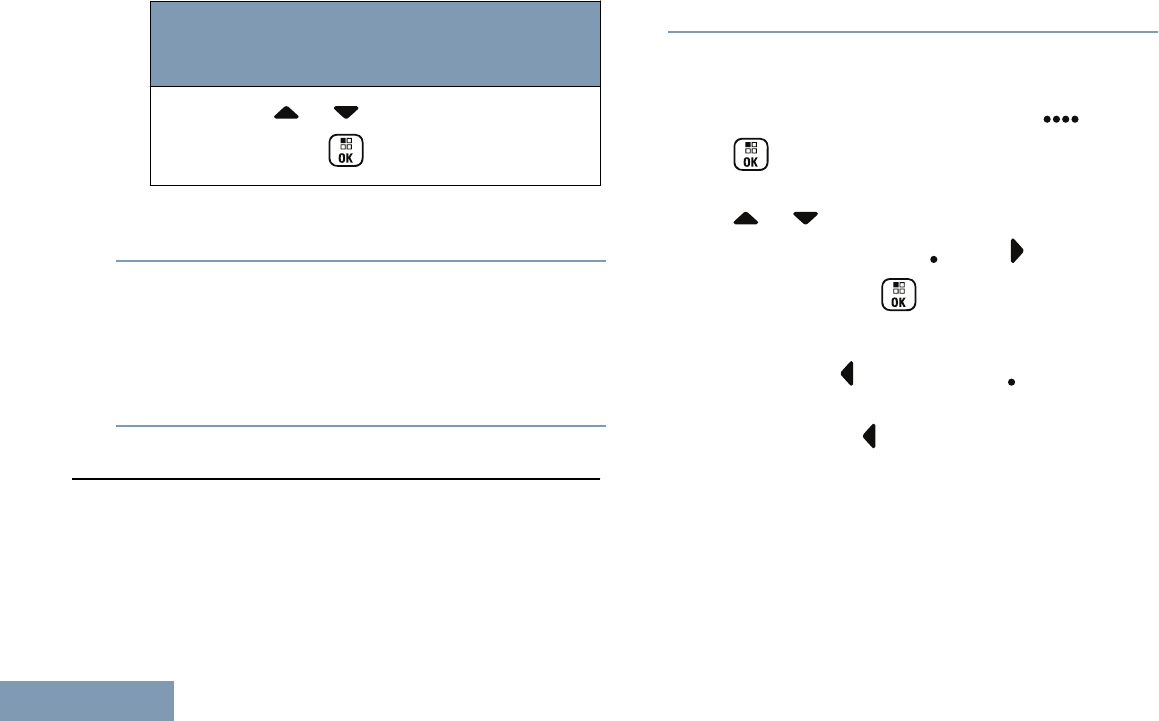
Radio
Con-
trols
Steps
4 or to Radio Enable and
press to select.
The display shows Radio Enable: <Subscriber
Alias or ID> and the LED lights up solid green.
2Wait for acknowledgement.
If successful, a positive indicator tone sounds and
the display shows Radio Enable Successful.
If not successful, a negative indicator tone sounds
and the display shows Radio Enable Failed.
Password Lock Features
If enabled, this feature only allows you access your
radio if the correct password is entered upon
powering up.
Accessing the Radio from Password
1Power up the radio.
The radio sounds a continuous tone.
2Do one of the following:
• Enter your current four-digit password with the
radio’s keypad. The display shows . Press
to proceed.
• Enter your current four-digit password. Press
or to edit each digit’s numeric value.
Each digit changes to . Press to move to
next digit. Press to confirm your selection.
You hear a positive indicator tone for every digit
entered. Press to remove each on the
display. The radio sounds a negative indicator
tone, if you press when the line is empty, or if
you press more than four digits.
If the password is correct, the radio proceeds to
power up. See Powering Up the Radio on page
27.
If the password is incorrect, the display shows
Wrong Password. Repeat Step 2.
Advanced Features in Connect Plus Mode
262
English
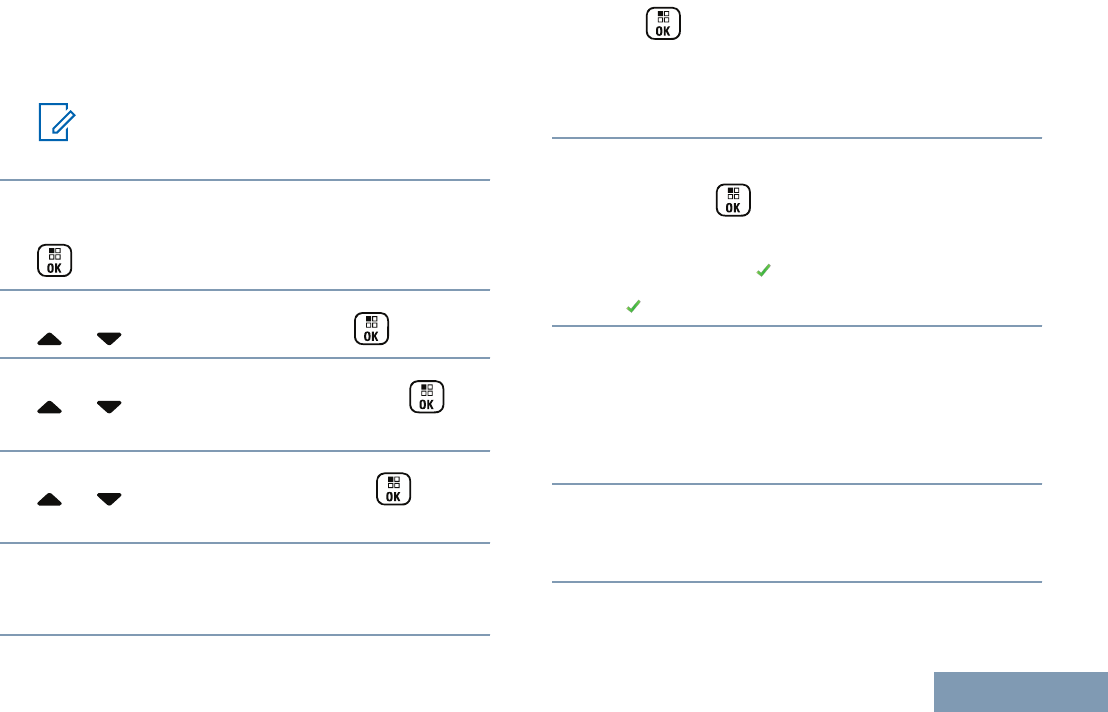
After the third incorrect password, the display
shows Wrong Password and then, shows Radio
Locked. A tone sounds and the LED double blinks
yellow.
Note:
The radio is unable to receive any call,
including emergency calls, in locked state.
Turning the Password Lock On or Off
1
to access the menu.
2
or to Utilities and press to select.
3
or to Radio Settings and press to
select.
4
or to Passwd Lock and press to
select.
5Enter the four-digit password.
See Step 2 in Accessing the Radio from Password
on page 262.
6
Press to proceed.
If the password is incorrect, the display shows
Wrong Password, and automatically returns to the
previous menu.
7If the password entered in the previous step is
correct, press to enable/disable password
lock.
The display shows beside Enabled.
The disappears from beside Enabled.
Unlocking the Radio from Locked State
1If your radio was powered down after being in the
locked state, power up the radio.
A tone sounds and the LED double blinks yellow.
The display shows Radio Locked.
2Wait for 15 minutes.
Your radio restarts the 15 minutes timer for locked
state when you power up.
Advanced Features in Connect Plus Mode
263
English
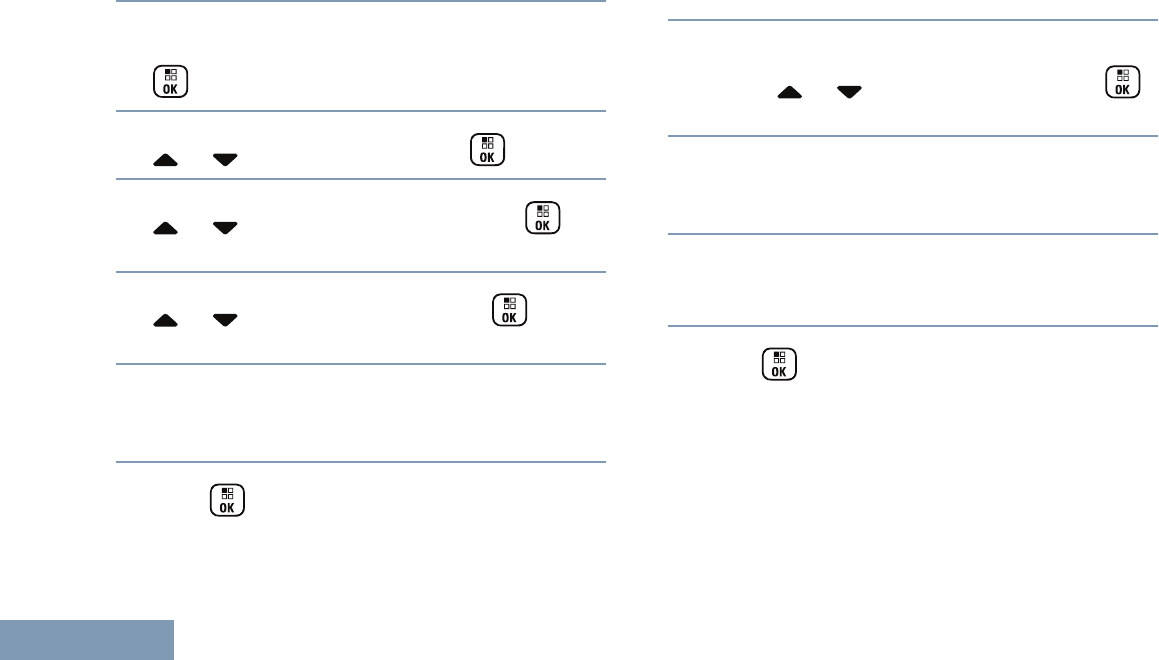
3Repeat Steps 1 and 2 in Accessing the Radio from
Password on page 262.
Changing the Password
1
to access the menu.
2
or to Utilities and press to select.
3
or to Radio Settings and press to
select.
4
or to Passwd Lock and press to
select.
5Enter the four-digit password.
See Step 2 in Accessing the Radio from Password
on page 262.
6
Press to proceed.
If the password is incorrect, the display shows
Wrong Password, and automatically returns to the
previous menu.
7If the password entered in the previous step is
correct, or to Change Pwd and press
to select.
8Enter a new four-digit password.
See Step 2 in Accessing the Radio from Password
on page 262.
9Reenter the previously entered four-digit
password. See Step 2 in Accessing the Radio
from Password on page 262.
10
Press to proceed.
If the reentered password matches the new
password entered earlier, the display shows
Password Changed.
If the reentered password does NOT match the
new password entered earlier, the display shows
Passwords Do Not Match.
Advanced Features in Connect Plus Mode
264
English
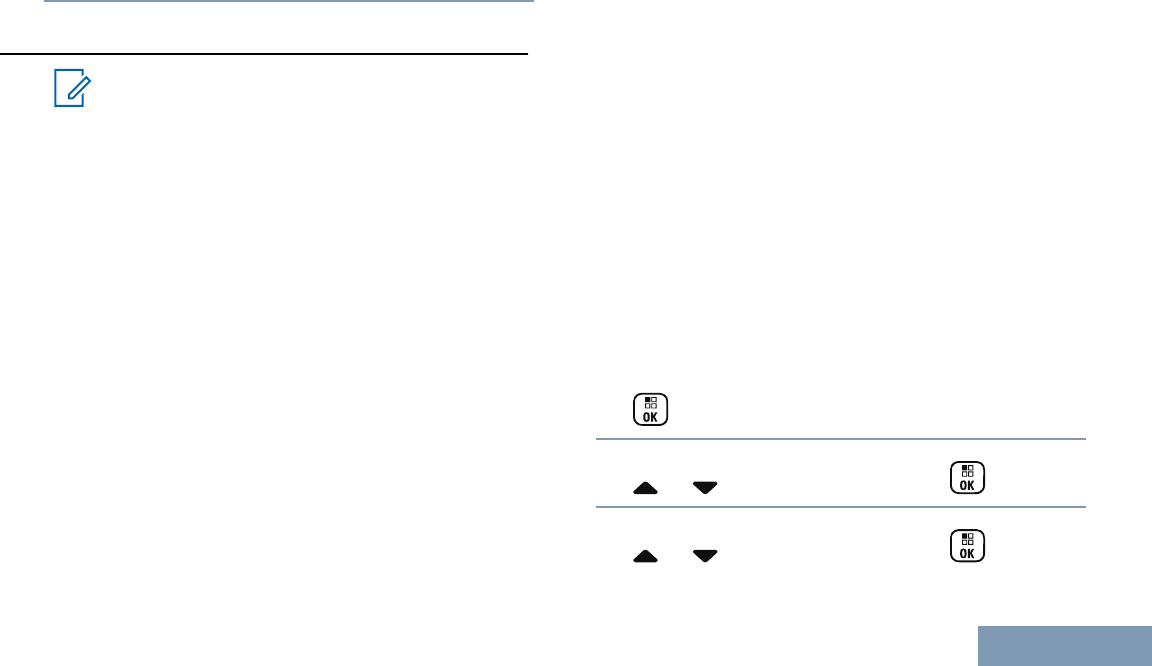
The screen automatically returns to the previous
menu.
Bluetooth Operation
Note:
If disabled via the CPS, all Bluetooth-related
features are disabled and the Bluetooth device
database is erased.
This feature allows you to use your radio with a
Bluetooth-enabled device (accessory) via a wireless
Bluetooth connection. Your radio supports both
Motorola and COTS (Commercially available Off-The-
Shelf) Bluetooth-enabled devices.
Bluetooth operates within a range of 10 meters (32
feet) line of sight. This is an unobstructed path
between your radio and your Bluetooth-enabled
device.
It is not recommended that you leave your radio
behind and expect your Bluetooth-enabled device to
work with a high degree of reliability when they are
separated.
At the fringe areas of reception, both voice and tone
quality will start to sound “garbled” or “broken”. To
correct this problem, simply position your radio and
Bluetooth-enabled device closer to each other (within
the 10-meter/32 feet defined range) to re-establish
clear audio reception. Your radio’s Bluetooth function
has a maximum power of 2.5 mW (4 dBm) at the 10-
meter/32 feet range.
Your radio can support up to 4 simultaneous
Bluetooth connections with Bluetooth-enabled
devices of unique types. For example, a headset, and
a PTT-Only Device (POD). Multiple connections with
Bluetooth-enabled devices of the same type are not
supported.
Refer to your respective Bluetooth-enabled device’s
user manual for more details on your Bluetooth-
enabled device’s full capabilities.
Turning Bluetooth On and Off
1
to access the menu.
2
or to Bluetooth and press to select.
3
or to My Status and press to select.
Advanced Features in Connect Plus Mode
265
English
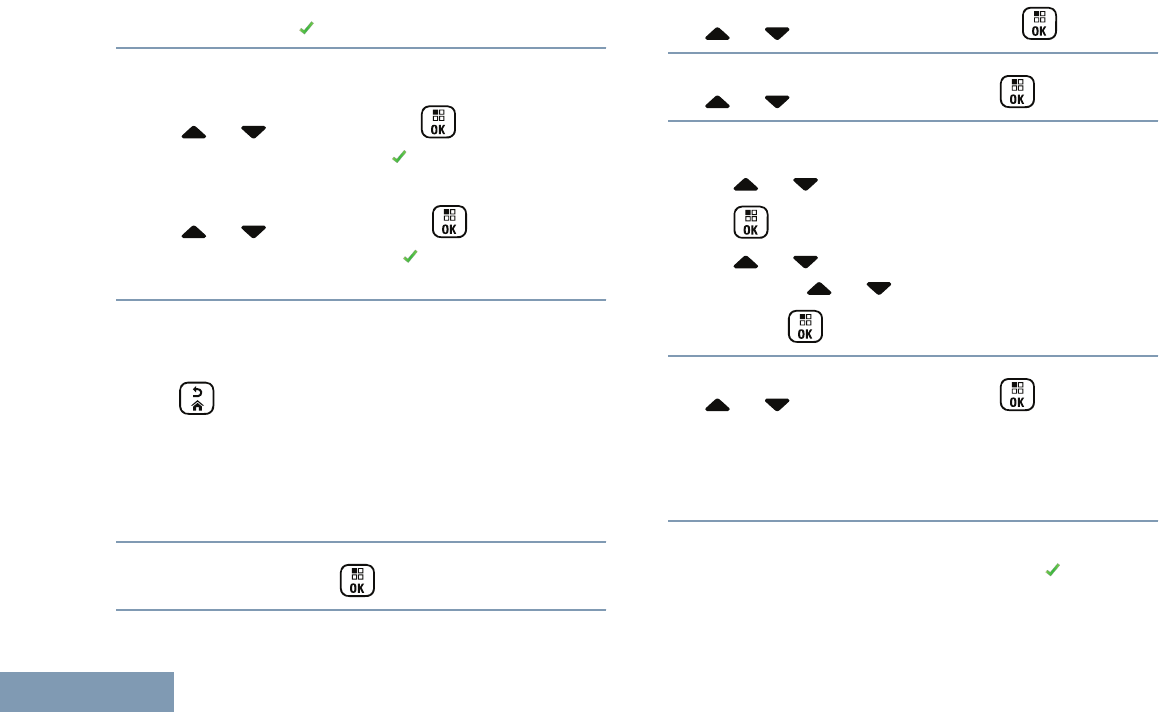
The display shows On and Off. The current status
is indicated by a .
4Do one of the following:
•
or to On and press to select. The
display shows On and a appears left of the
selected status.
•
or to Off and press to select. The
display shows Off and a appears left of the
selected status.
Finding and Connecting to a Bluetooth Device
Do not turn off your Bluetooth-enabled device or
press during the finding and connecting
operation as this cancels the operation.
1Turn on your Bluetooth-enabled device and place
it in pairing mode. Refer to respective Bluetooth-
enabled device’s user manual.
2
On your radio, press to access the menu.
3
or to Bluetooth and press to select.
4
or to Devices and press to select.
5Do one of the following:
• or to the required device and press
to select.
• or to Find Devices to locate available
devices. or to the required device and
press to select.
6
or to Connect and press to select.
Display shows Connecting to <Device>. Your
Bluetooth-enabled device may require additional
steps to complete the pairing. Refer to respective
Bluetooth-enabled device’s user manual.
If successful, the radio display shows
<Device>Connected. A tone sounds and appears
besides the connected device. The Bluetooth
Connected icon appears on the status bar.
Advanced Features in Connect Plus Mode
266
English
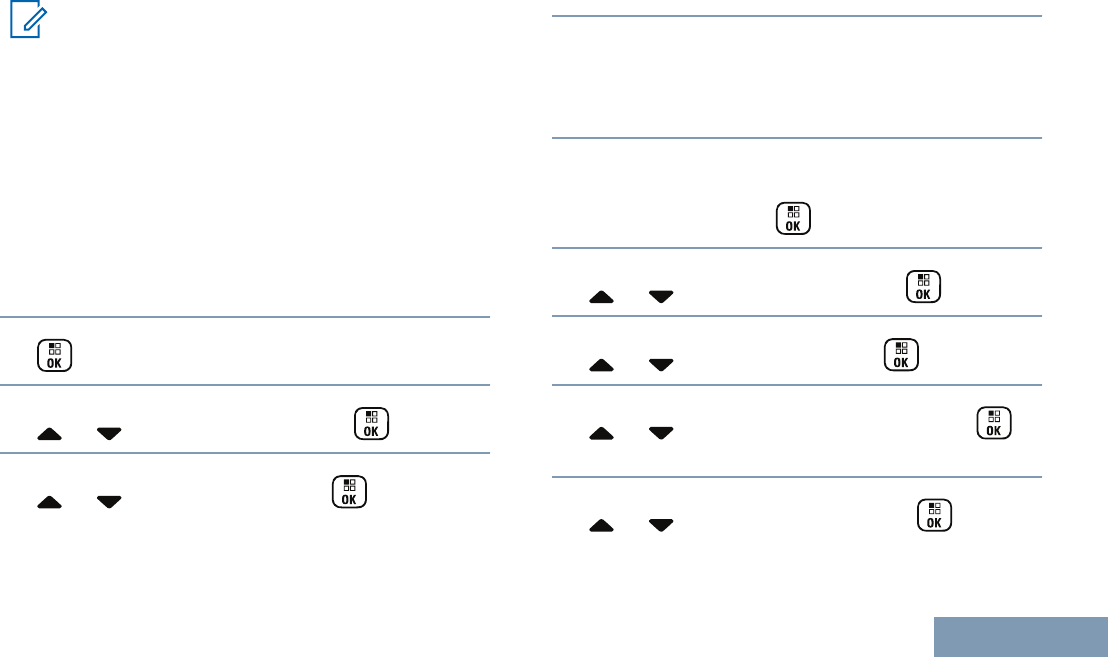
If unsuccessful, the radio display shows Connecting
Failed.
Note:
If pin code is required, use the same entry
method as Step 2 in Accessing the Radio from
Password on page 262.
Finding and Connecting from a Bluetooth Device
(Discoverable Mode)
Do not turn off your Bluetooth or your radio during the
finding and connecting operation as this may cancel
the operation.
1Turn Bluetooth On.
See Turning Bluetooth On and Off on page 141.
2
to access the menu.
3
or to Bluetooth and press to select.
4
or to Find Me and press to select.
Your radio can now be found by other Bluetooth-
enabled devices for a programmed duration. This
is called Discoverable Mode.
5Turn on your Bluetooth-enabled device and pair it
with your radio.
Refer to respective Bluetooth-enabled device’s
user manual.
Disconnecting from a Bluetooth Device
1
On your radio, press to access the menu.
2
or to Bluetooth and press to select.
3
or to Devices and press to select.
4
or to the required device and press
to select.
5
or to Disconnect and press to
select.
Advanced Features in Connect Plus Mode
267
English
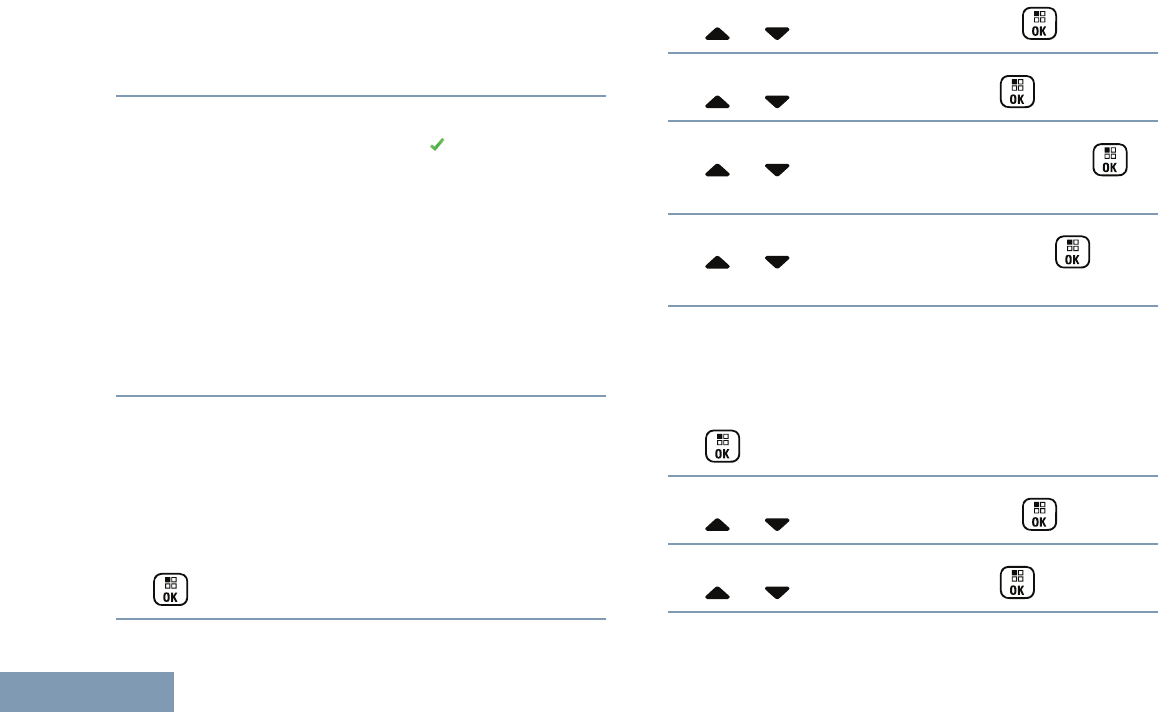
Display shows Disconnecting from <Device>.
Your Bluetooth-enabled device may require
additional steps to disconnect. Refer to respective
Bluetooth-enabled device’s user manual.
The radio display shows <Device> Disconnected. A
positive indicator tone sounds and disappears
beside the connected device. The Bluetooth
Connected icon disappears on the status bar.
Switching Audio Route between Internal Radio Speaker
and Bluetooth Device
You can toggle audio routing between internal radio
speaker and external Bluetooth-enabled accessory.
Press the programmed Bluetooth Audio Switch
button.
•A tone sounds and display shows Route Audio
to Radio.
•A tone sounds and display shows Route Audio
to Bluetooth.
Viewing Device Details
1
to access the menu.
2
or to Bluetooth and press to select.
3
or to Devices and press to select.
4
or to the required device and press
to select.
5
or to View Details and press to
select.
Editing Device Name
You can edit the name of available Bluetooth-enabled
devices.
1
to access the menu.
2
or to Bluetooth and press to select.
3
or to Devices and press to select.
Advanced Features in Connect Plus Mode
268
English
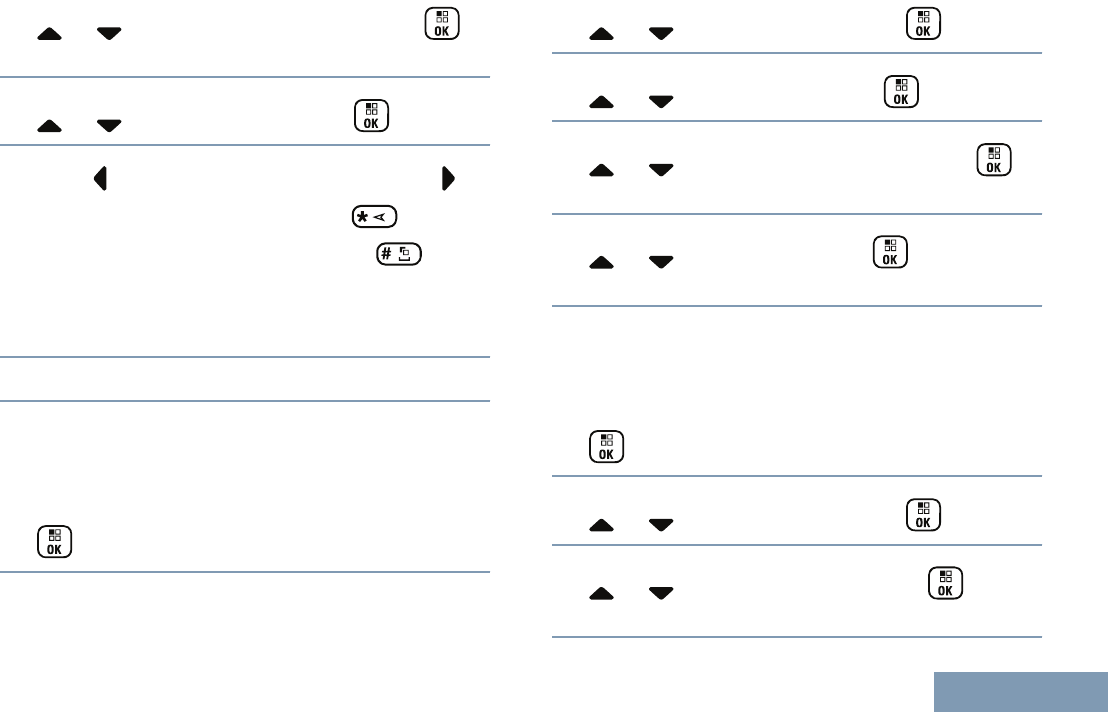
4
or to the required device and press
to select.
5
or to Edit Name and press to select.
6Press to move one space to the left. Press to
move one space to the right. Press to delete
any unwanted characters. Long press to
change text entry method.
A blinking cursor appears. Use the keypad to type
the required zone.
7The display shows Device Name Saved.
Deleting Device Name
You can remove a disconnected device from the list
of Bluetooth-enabled devices.
1
to access the menu.
2
or to Bluetooth and press to select.
3
or to Devices and press to select.
4
or to the required device and press
to select.
5
or to Delete and press to select.
The display shows Device Deleted.
Bluetooth Mic Gain
Allows control of the connected Bluetooth-enabled
device’s microphone gain value.
1
to access the menu.
2
or to Bluetooth and press to select.
3
or to BT Mic Gain and press to
select.
Advanced Features in Connect Plus Mode
269
English
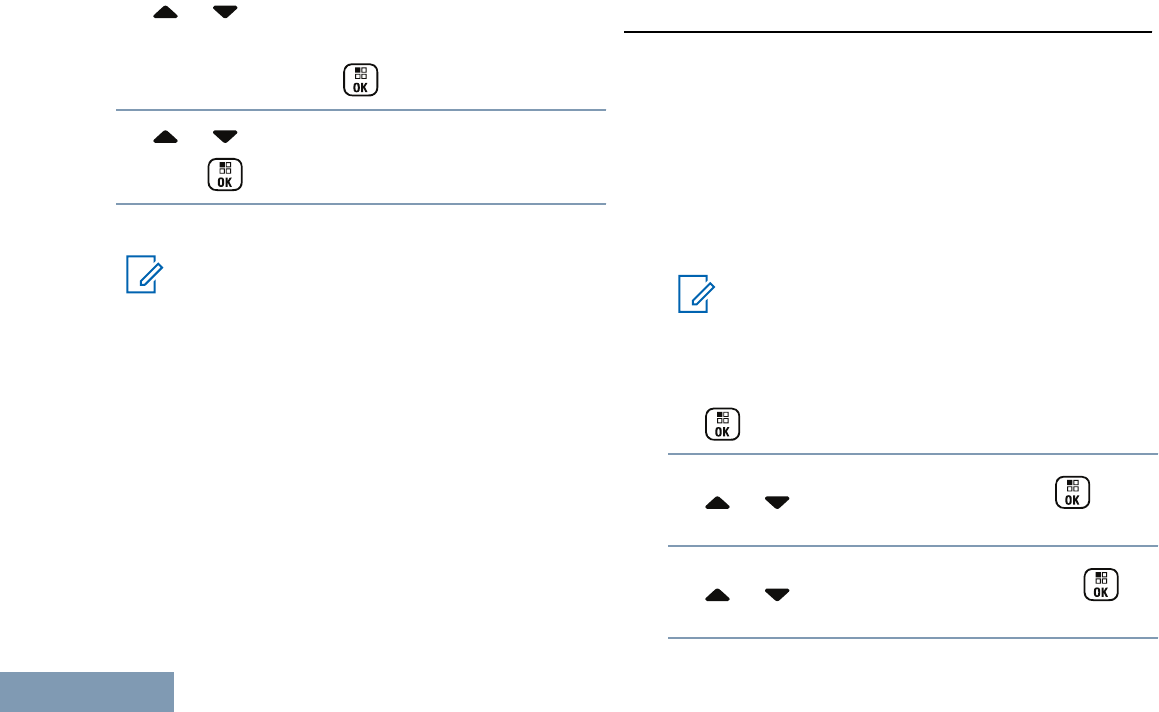
4 or to the BT Mic Gain type and the current
values.
To edit values, press to select.
5 or to increase or to decrease values and
press to select.
Permanent Bluetooth Discoverable Mode
Note:
The Permanent Bluetooth Discoverable Mode
can only be enabled via the MOTOTRBO
CPS. If enabled, the Bluetooth item will not
be displayed in the Menu and you will not be
able to use any Bluetooth programmable
button features.
Other Bluetooth-enabled devices can locate your
radio, but the devices cannot connect to the radio. It
enables dedicated devices to use your radio position
in the process of Bluetooth-based location.
Notification List
Your radio has a Notification List that collects all your
“unread” events on the channel, such as unread text
messages, missed calls, and call alerts.
The Notification icon appears on the status bar when
the Notification List has one or more events.
The list supports a maximum of forty (40) unread
events. When it is full, the next event automatically
replaces the oldest event.
Note:
After the events are read, they are removed
from the Notification List.
Accessing the Notification List
1
to access the menu.
2
or to Notification and press to
select.
3
or to the required event and press to
select.
Advanced Features in Connect Plus Mode
270
English
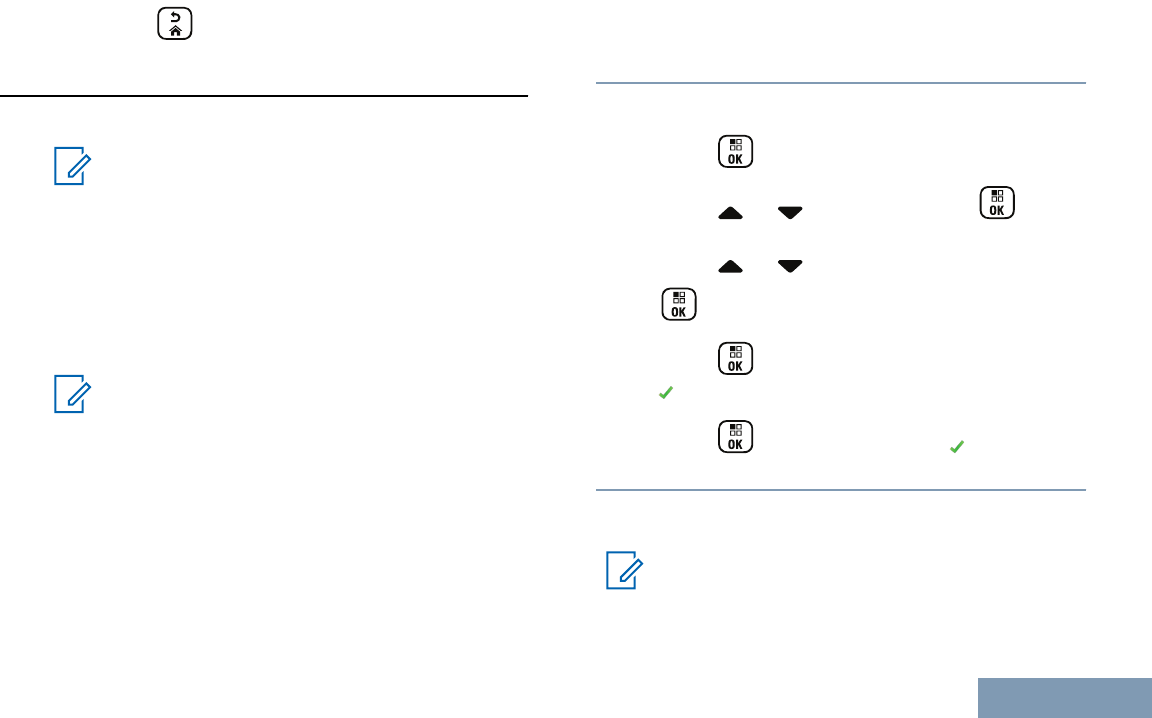
Long press to return to the Home Screen.
Wi-Fi Operation
Wi-Fi® is a registered trademark of Wi-Fi Alliance®.
Note:
This feature is applicable to XPR 7550e/XPR
7580e only.
This feature allows you to setup and connect to a Wi-
Fi® network. Wi-Fi supports updates for radio
firmware, codeplug, and resources such as language
packs and voice announcement.
Turning Wi-Fi On or Off
Note:
This feature is applicable to XPR 7550e/XPR
7580e only.
The programmed Wi-Fi On or Off button is
assigned via CPS. Check with your dealer or
system administrator to determine how your
radio has been programmed.
You can turn on or turn off Wi-Fi® by performing one
of the following actions.
•Press the programmed Wi-Fi On or Off button.
Voice Announcement sounds Turning On Wi-Fi or
Turning Off Wi-Fi.
•Access this feature via the menu.
a)
Press to access the menu.
b)
Press or to WiFi and press to
select.
c) Press or to WiFi Status and press
to select.
Press to turn on Wi-Fi. The display shows
beside Enabled.
Press to turn off Wi-Fi. The disappears
from beside Enabled.
Connecting to a Network Access Point
Note:
This feature is applicable to XPR 7550e/XPR
7580e only.
Advanced Features in Connect Plus Mode
271
English
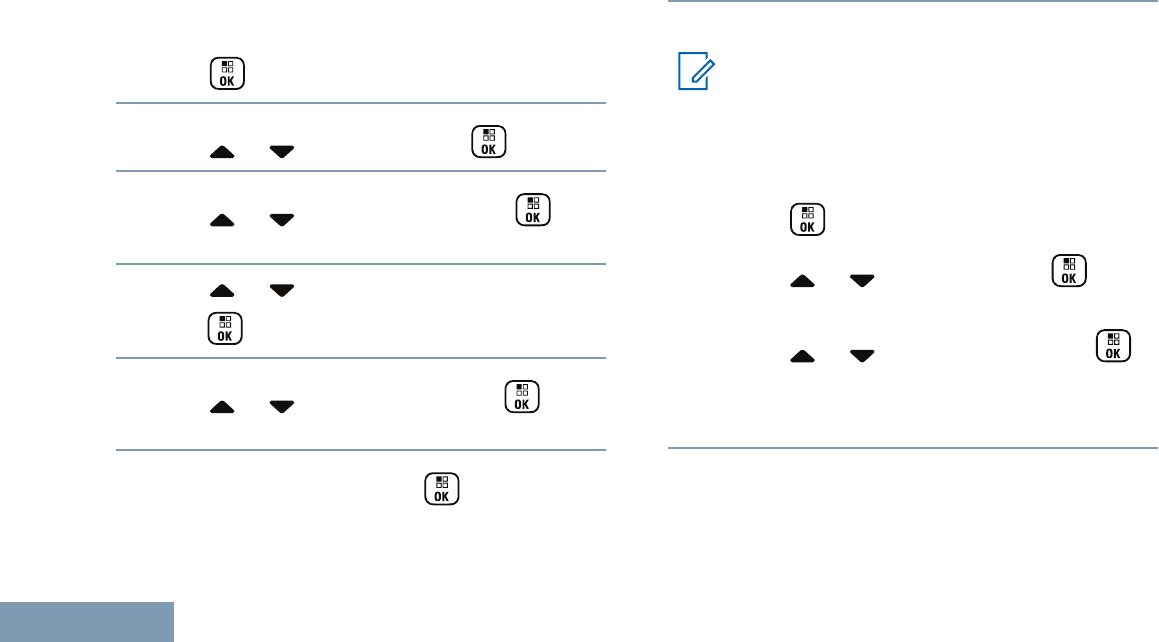
When you turn on Wi-Fi®, the radio scans and
connects to a network access point.
You can also connect to a network access point via
the menu.
1
Press to access the menu.
2
Press or to WiFi and press to select.
3
Press or to Networks and press to
select.
4Press or to a network access point and
press to select.
5
Press or to Connect and press to
select.
6
Enter the password and press .
When the connection is successful, the radio
displays a notice and the network access point is
saved into the profile list.
Refreshing the Network List
Note:
This feature is applicable to XPR 7550e/XPR
7580e only.
•Perform the following actions to refresh the
network list.
a)
Press to access the menu.
b)
Press or to WiFi and press to
select.
c)
Press or to Networks and press
to select.
When you enter the Networks menu, the radio
automatically refreshes the network list.
•If you are already in the Networks menu, perform
the following action to refresh the network list.
Advanced Features in Connect Plus Mode
272
English
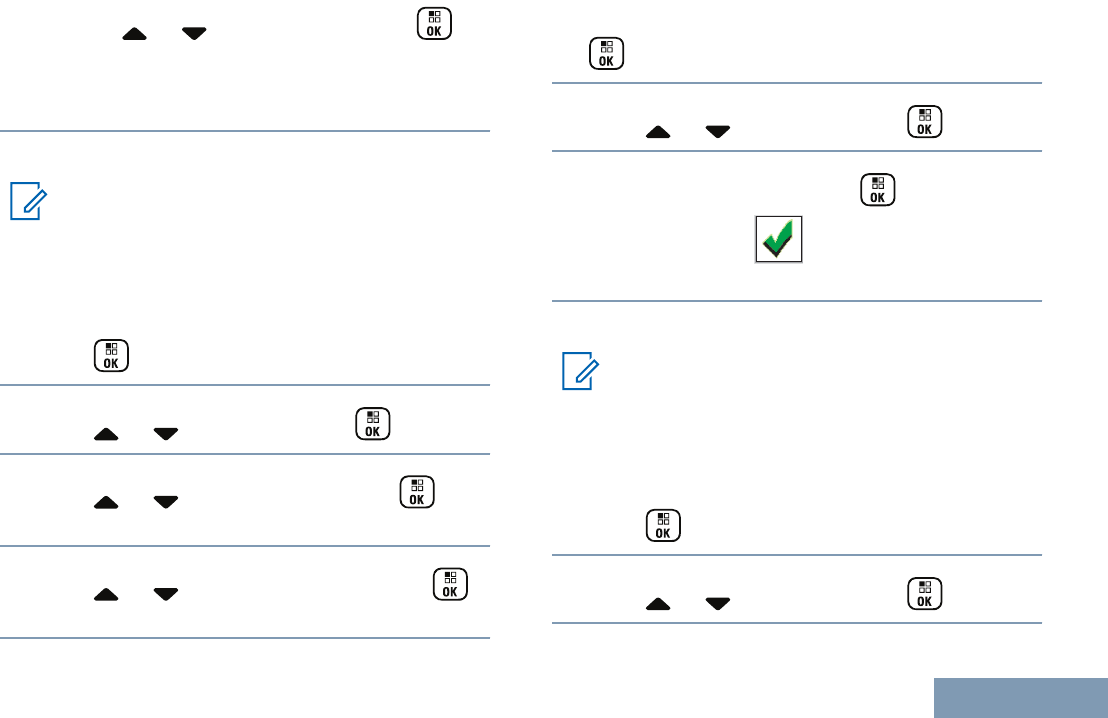
a)
Press or to Refresh and press to
select.
The radio refreshes and displays the latest
network list.
Adding a Network
Note:
This feature is applicable to XPR 7550e/XPR
7580e only.
If a preferred network is not in the available network
list, perform the following actions to add a network.
1
Press to access the menu.
2
Press or to WiFi and press to select.
3
Press or to Networks and press to
select.
4
Press or to Add Network and press
to select.
5Enter the Service Set Identifier (SSID) and press
.
6
Press or to Open and press to select.
7
Enter the password and press .
The radio displays to indicate that the
network is successfully saved.
Viewing Details of Network Access Points
Note:
This feature is applicable to XPR 7550e/XPR
7580e only.
Perform the following actions to view details of
network access points.
1
Press to access the menu.
2
Press or to WiFi and press to select.
Advanced Features in Connect Plus Mode
273
English
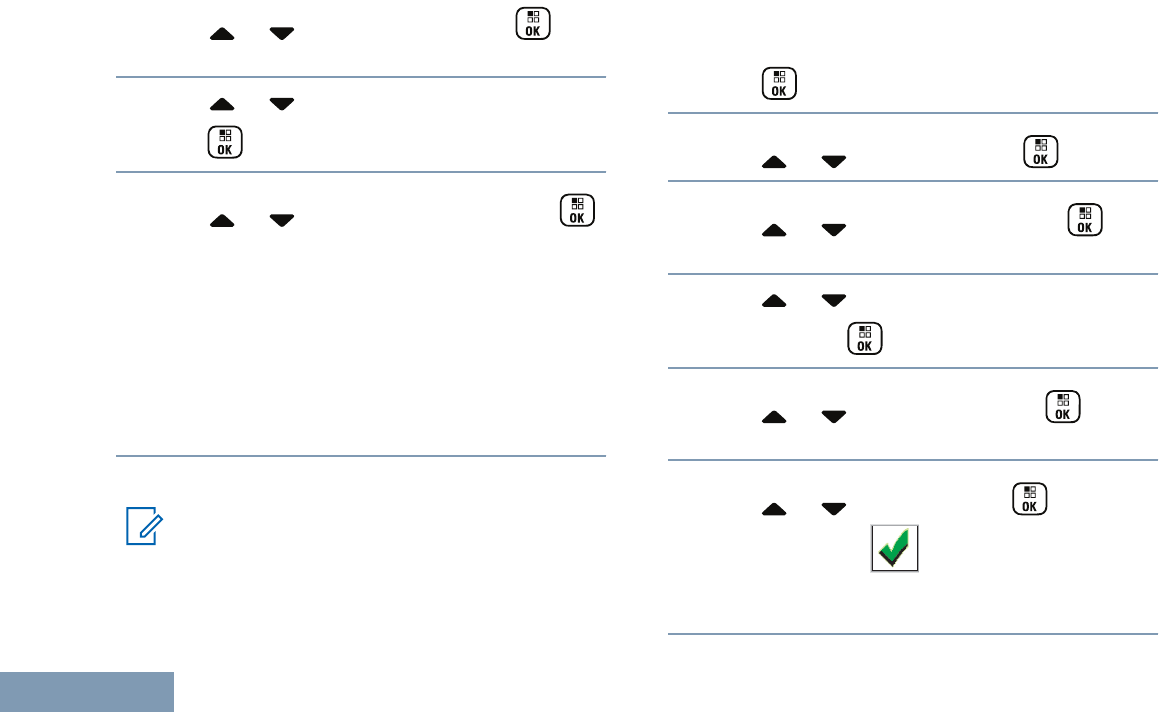
3
Press or to Networks and press to
select.
4Press or to a network access point and
press to select.
5
Press or to View Details and press
to select.
For a connected network access point, the Service
Set Identifier (SSID), Security Mode, Media
Access Control (MAC) address, and Internet
Protocol (IP) address are displayed.
For a non-connected network access point, the
Service Set Identifier (SSID) and Security Mode
are displayed.
Removing Network Access Points
Note:
This feature is applicable to XPR 7550e/XPR
7580e only. Enterprise network access points
that are added via CPS can only be removed
via CPS.
Perform the following actions to remove network
access points from the profile list.
1
Press to access the menu.
2
Press or to WiFi and press to select.
3
Press or to Networks and press to
select.
4Press or to the selected network access
point and press to select.
5
Press or to Remove and press to
select.
6
Press or to Yes and press to select.
The radio displays to indicate that the
selected network access point is successfully
removed.
Advanced Features in Connect Plus Mode
274
English
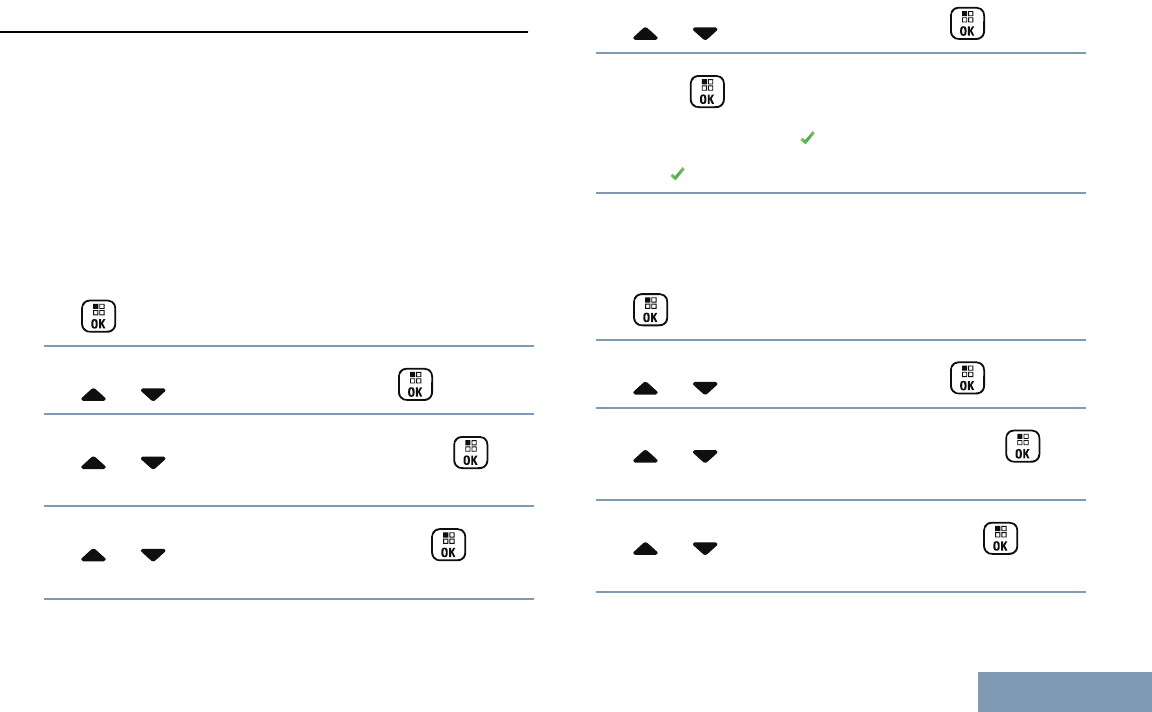
Utilities
Turning the Radio Tones/Alerts On or Off
You can enable and disable all radio tones and alerts
(except for the incoming Emergency alert tone) if
needed.
Press the programmed All Tones/Alerts button to
toggle all tones on or off, or follow the procedure
described next to access this feature via the radio
menu.
1
to access the menu.
2
or to Utilities and press to select.
3
or to Radio Settings and press to
select.
4
or to Tones/Alerts and press to
select.
5
or to All Tones and press to select.
6
Press to enable/disable all tones and alerts.
The display shows beside Enabled.
The disappears from beside Enabled.
Turning Keypad Tones On or Off
You can enable and disable keypad tones if needed.
1
to access the menu.
2
or to Utilities and press to select.
3
or to Radio Settings and press to
select.
4
or to Tones/Alerts and press to
select.
Advanced Features in Connect Plus Mode
275
English
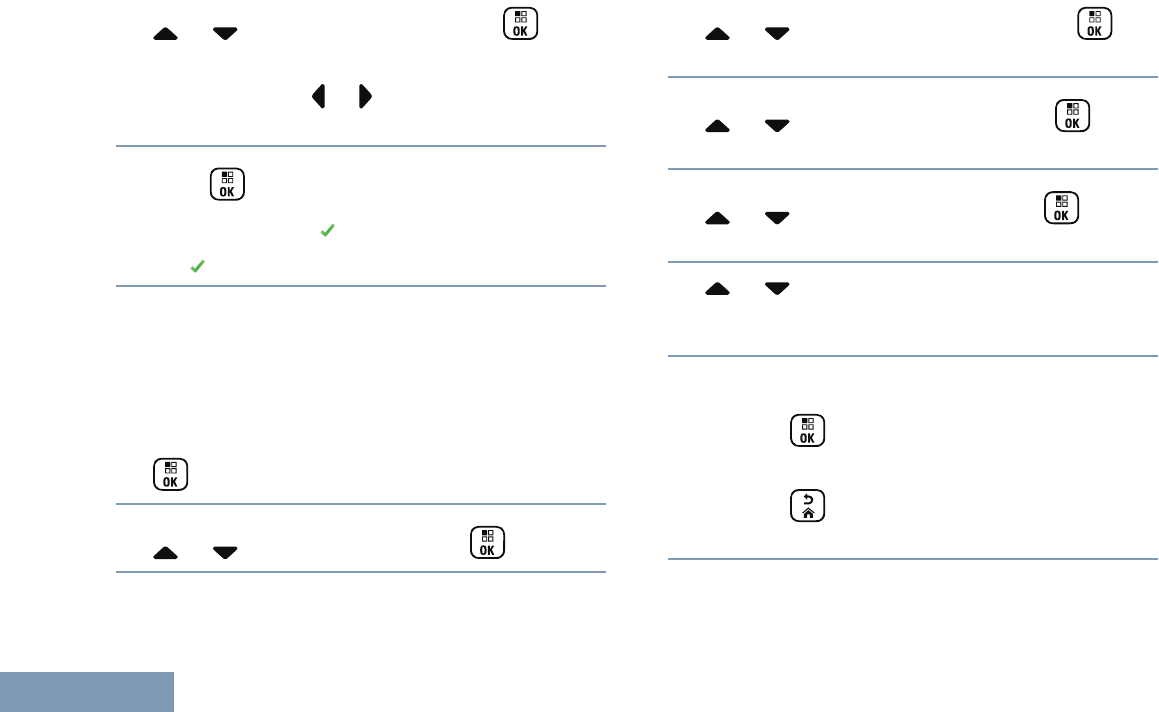
5
or to Keypad Tones and press to
select.
You can also use or to change the selected
option.
6
Press to enable/disable keypad tones.
The display shows beside Enabled.
The disappears from beside Enabled.
Setting the Tone Alert Volume Offset Level
You can adjust the Tone Alert Volume Offset level if
needed. This feature adjusts the volume of the tones/
alerts, allowing it to be higher or lower than the voice
volume.
1
to access the menu.
2
or to Utilities and press to select.
3
or to Radio Settings and press to
select.
4
or to Tones/Alerts and press to
select.
5
or to Vol. Offset and press to
select.
6 or to the required volume value.
The radio sounds a feedback tone with each
corresponding volume value.
7Do one of the following:
•
Press to keep the required displayed
volume value.
•
Press to exit without changing the current
volume offset settings.
Advanced Features in Connect Plus Mode
276
English
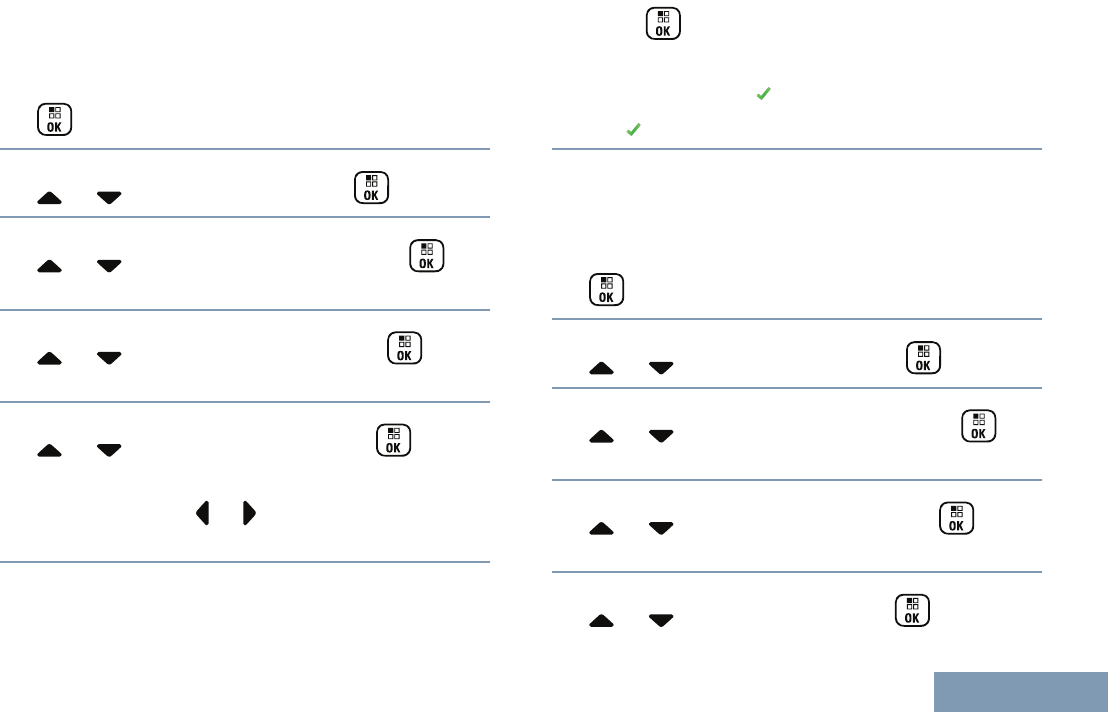
Turning the Talk Permit Tone On or Off
You can enable and disable the Talk Permit Tone if
needed.
1
to access the menu.
2
or to Utilities and press to select.
3
or to Radio Settings and press to
select.
4
or to Tones/Alerts and press to
select.
5
or to Talk Permit and press to
select.
You can also use or to change the selected
option.
6
Press to enable/disable the Talk Permit
Tone.
The display shows beside Enabled.
The disappears from beside Enabled.
Turning the Power Up Alert Tone On or Off
You can enable and disable the Power Up Alert Tone
if needed.
1
to access the menu.
2
or to Utilities and press to select.
3
or to Radio Settings and press to
select.
4
or to Tones/Alerts and press to
select.
5
or to Power Up and press to select.
Advanced Features in Connect Plus Mode
277
English
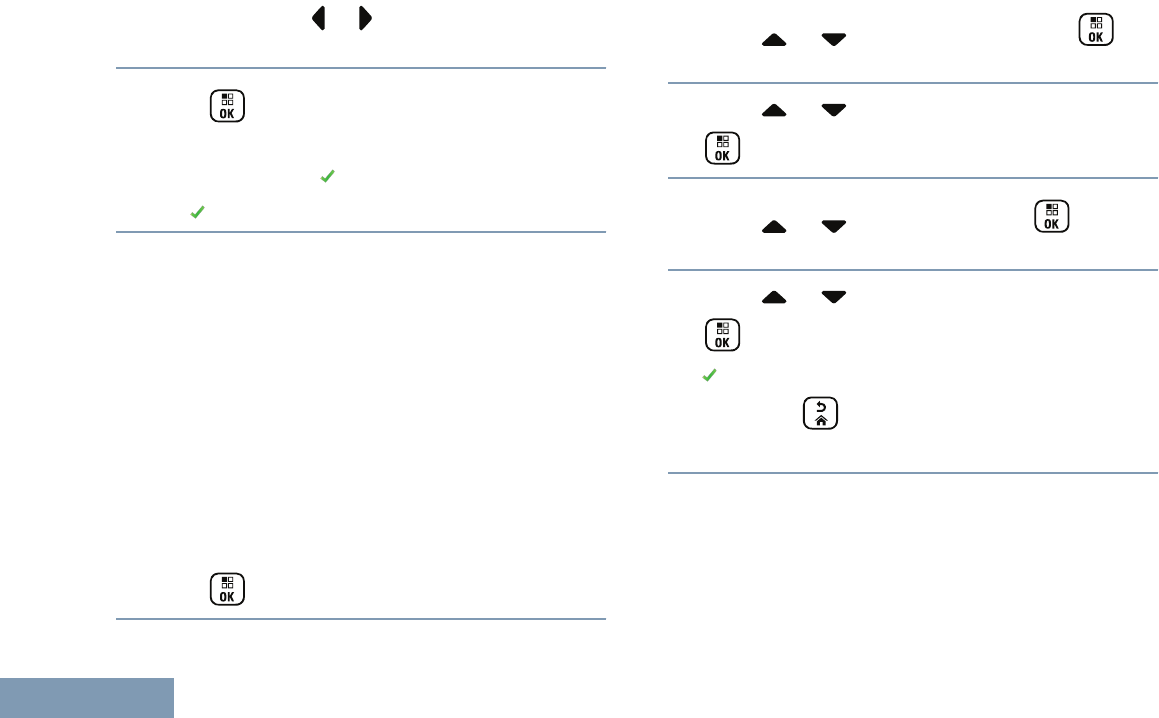
You can also use or to change the selected
option.
6
Press to enable/disable the Power Up Alert
Tone.
The display shows beside Enabled.
The disappears from beside Enabled.
Setting the Power Level
You can customize your radio’s power setting to high
or low for each Connect Plus zone.
High enables communication with tower sites in
Connect Plus mode located at a considerable
distance from you. Low enables communication with
tower sites in Connect Plus mode in closer proximity.
Press the programmed Power Level button to toggle
transmit power level between high and low. Follow
the procedure described next to access this feature
via the radio menu.
1
Press to access the menu.
2
Press or to Utilities and press to
select.
3Press or to Radio Settings and press
to select.
4
Press or to Power and press to
select.
5Press or to the required setting and press
to select.
appears beside selected setting. At any time,
long press to return to the Home screen.
Screen returns to the previous menu.
Changing the Display Mode
You can change radio’s display mode between Day
or Night, as needed. This affects the color palette of
the display.
Advanced Features in Connect Plus Mode
278
English
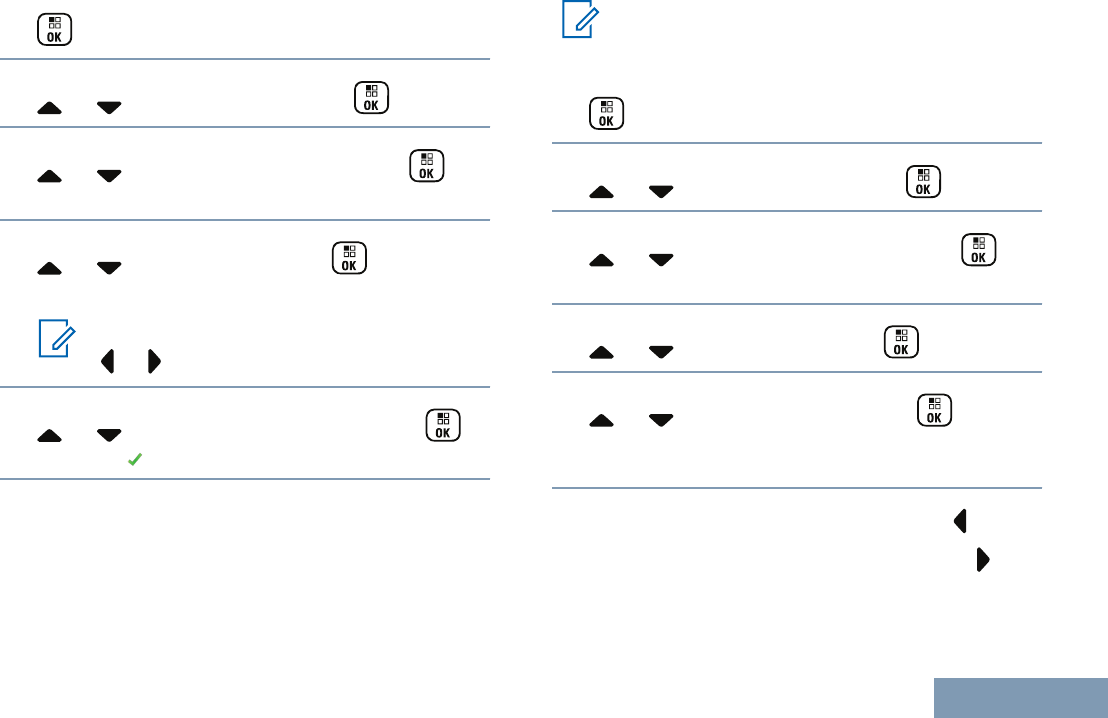
1
to access the menu.
2
or to Utilities and press to select.
3
or to Radio Settings and press to
select.
4
or to Display and press to select.
The display shows Day Mode and Night Mode.
Note:
or to change the selected option.
5
or to the required setting and press
to enable. appears besides selected setting.
Adjusting the Display Brightness
You can adjust the display brightness of the radio as
needed.
Note:
Display brightness cannot be adjusted when
Auto Brightness is enabled.
1
to access the menu.
2
or to Utilities and press to select.
3
or to Radio Settings and press to
select.
4
or to Display and press to select.
5
or to Brightness and press to
select.
The display shows a progress bar.
6Decrease display brightness by pressing or
increase the display brightness by pressing .
Advanced Features in Connect Plus Mode
279
English
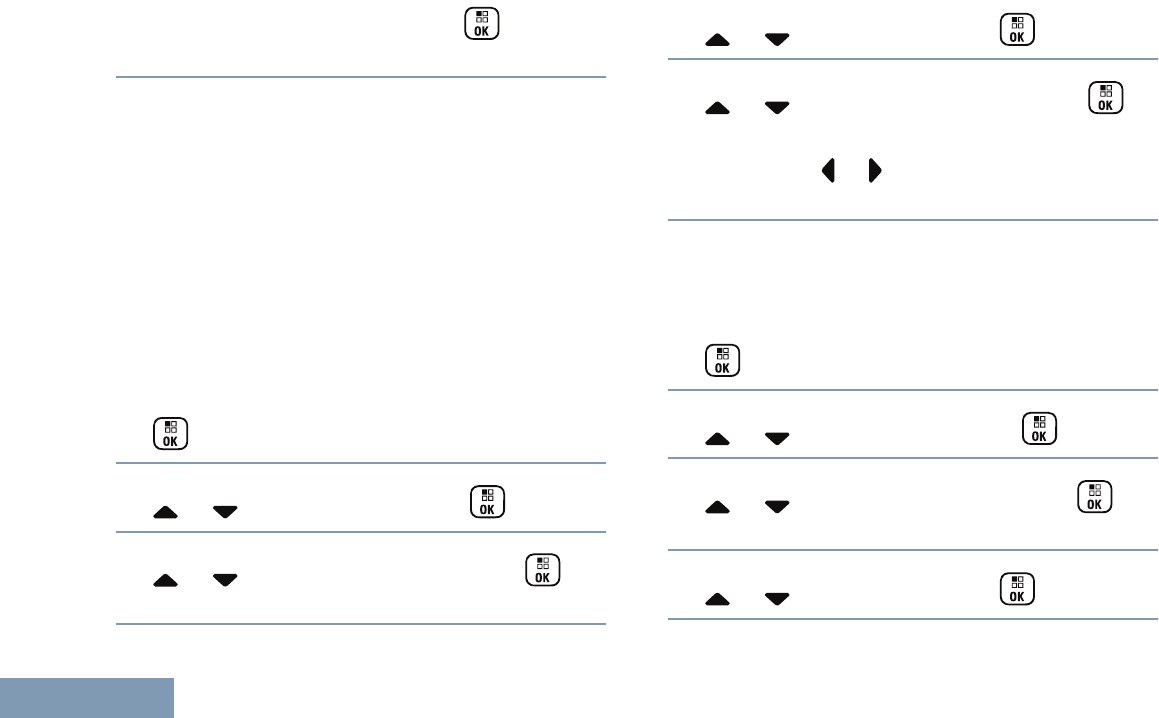
Select from setting of 1 to 8. Press to confirm
your entry.
Setting the Display Backlight Timer
You can set the the radio’s display backlight timer as
needed. The setting also affects the Menu Navigation
Buttons and keypad backlighting accordingly.
Press the programmed Backlight button to toggle the
backlight settings, or follow the procedure described
next to access this feature via the radio menu.
The display backlight and keypad backlighting are
automatically turned off if the LED indicator is
disabled (see Turning the LED Indicator On or Off on
page 162).
1
to access the menu.
2
or to Utilities and press to select.
3
or to Radio Settings and press to
select.
4
or to Display and press to select.
5
or to Backlight Timer and press to
select.
You can use or to change the selected
option.
Turning the Introduction Screen On or Off
You can enable and disable the Introduction Screen if
needed.
1
to access the menu.
2
or to Utilities and press to select.
3
or to Radio Settings and press to
select.
4
or to Display and press to select.
Advanced Features in Connect Plus Mode
280
English
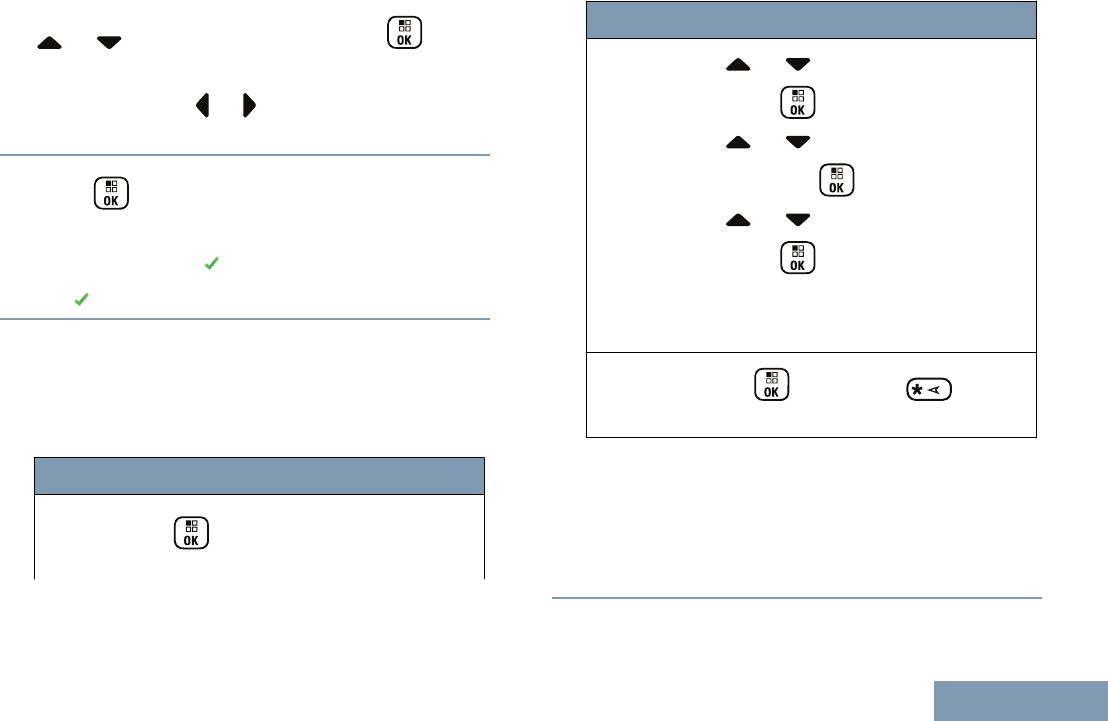
5
or to Intro Screen and press to
select.
You can also use or to change the selected
option.
6
Press to enable/disable the Introduction
Screen.
The display shows beside Enabled.
The disappears from beside Enabled.
Locking and Unlocking the Keypad
You can lock your radio’s keypad to avoid inadvertent
key entry.
To lock/unlock your radio’s keypad.
Option Steps
Locking
the Key-
pad
1
to access the menu.
Option Steps
2 or to Utilities and
press to select.
3 or to Radio Settings
and press to select.
4 or to Keypad Lock and
press to select.
You can also use or to change the
selected option.
Unlocking
the Key-
pad
Press followed by .
After the keypad is locked, the display shows
Keypad Locked and returns to the Home screen.
After the keypad is unlocked, the display shows
Keypad Unlocked and returns to the Home
screen.
Advanced Features in Connect Plus Mode
281
English
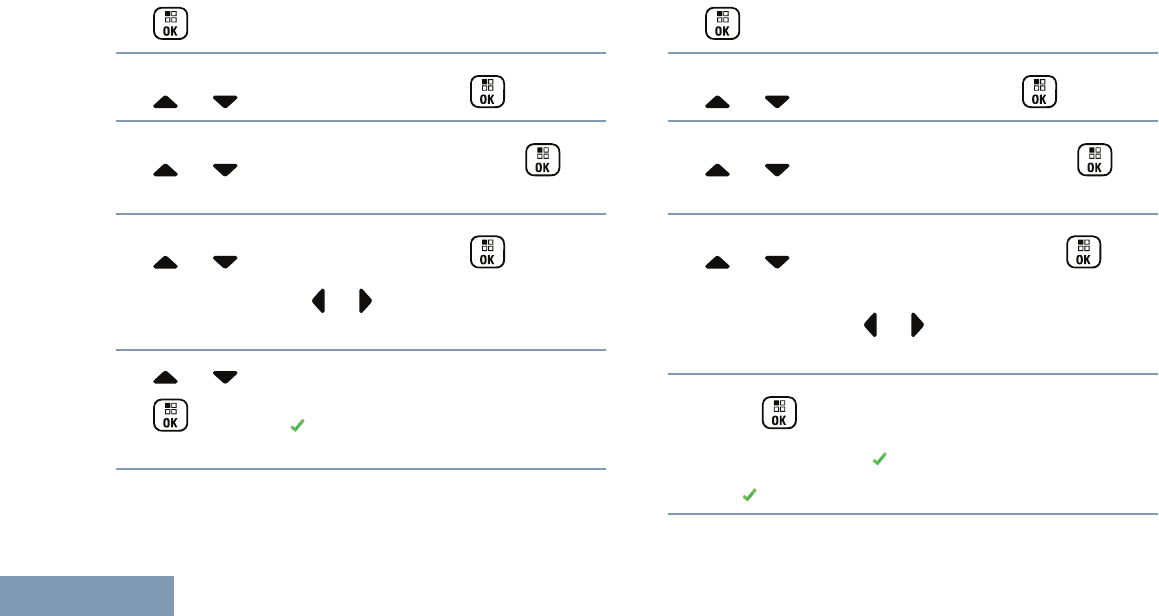
Language
You can set your radio display to be in your required
language.
1
to access the menu.
2
or to Utilities and press to select.
3
or to Radio Settings and press to
select.
4
or to Languages and press to select.
You can also use or to change selected
option.
5 or to the required language and press
to enable. appears beside selected
language.
Turning the LED Indicator On or Off
You can enable and disable the LED Indicator if
needed.
1
to access the menu.
2
or to Utilities and press to select.
3
or to Radio Settings and press to
select.
4
or to LED Indicator and press to
select.
You can also use or to change the selected
option.
5
Press to enable/disable the LED Indicator.
The display shows beside Enabled.
The disappears from beside Enabled.
Advanced Features in Connect Plus Mode
282
English
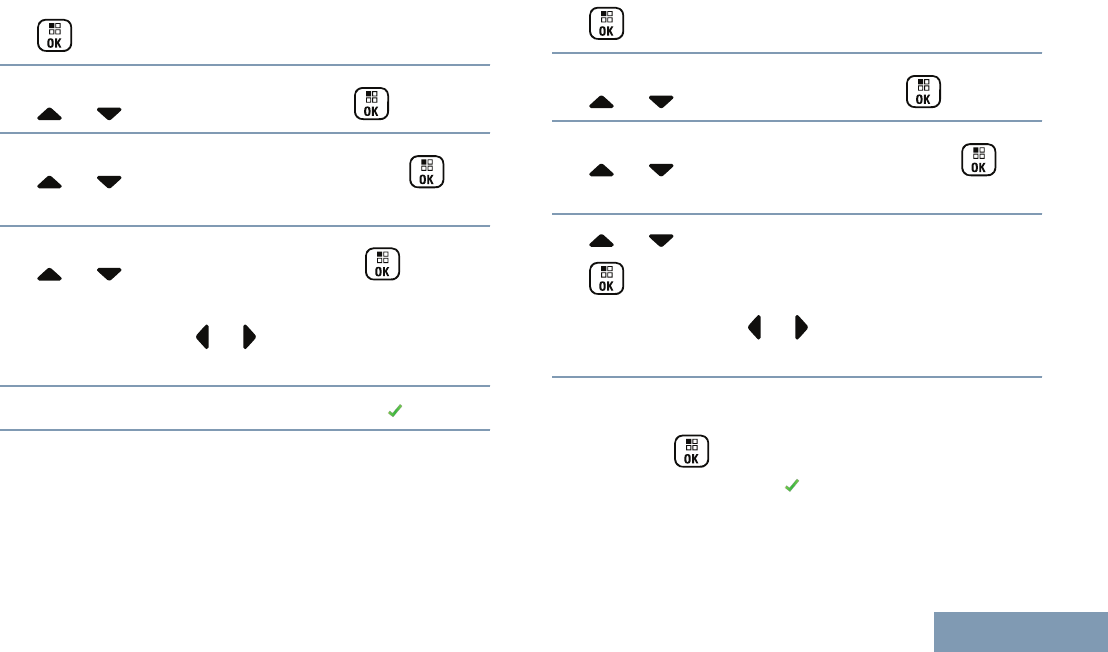
Identifying Cable Type
You can select the type of cable your radio uses.
1
to access the menu.
2
or to Utilities and press to select.
3
or to Radio Settings and press to
select.
4
or to Cable Type and press to
select.
You can also use or to change the selected
option.
5The current cable type is indicated by a .
Voice Announcement
This feature enables the radio to audibly indicate the
current Zone or Channel the user has just assigned,
or programmable button press. This audio indicator
can be customized per customer requirements. This
is typically useful when the user is in a difficult
condition to read the content shown on the display.
1
to access the menu.
2
or to Utilities and press to select.
3
or to Radio Settings and press to
select.
4 or to Voice Announcement and press
to select.
You can also use or to change the selected
option.
5Do one of the following:
•
Press to enable Voice Announcement.
The display shows beside Enabled.
Advanced Features in Connect Plus Mode
283
English
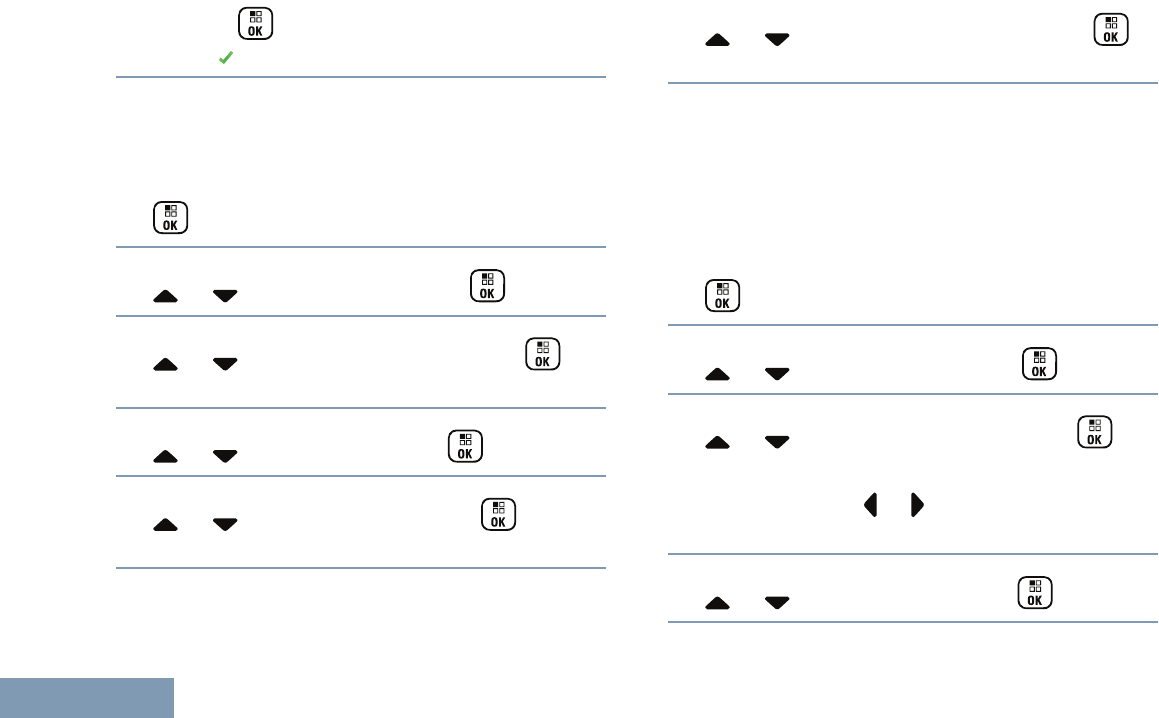
•
Press to disable Voice Announcement.
The disappears from beside Enabled.
Menu Timer
Set the period of time your radio stays in the menu
before it automatically switches to the Home screen.
1
to access the menu.
2
or to Utilities and press to select.
3
or to Radio Settings and press to
select.
4
or to Display and press to select.
5
or to Menu Timer and press to
select.
6
or to the required setting and press
to select.
Digital Mic AGC (Mic AGC-D)
This feature controls the your radio's microphone gain
automatically while transmitting on a digital system. It
suppresses loud audio or boosts soft audio to a
preset value in order to provide a consistent level of
audio.
1
to access the menu.
2
or to Utilities and press to select.
3
or to Radio Settings and press to
select.
You can also use or to change the selected
option.
4
or to Mic AGC-D and press to select.
Advanced Features in Connect Plus Mode
284
English
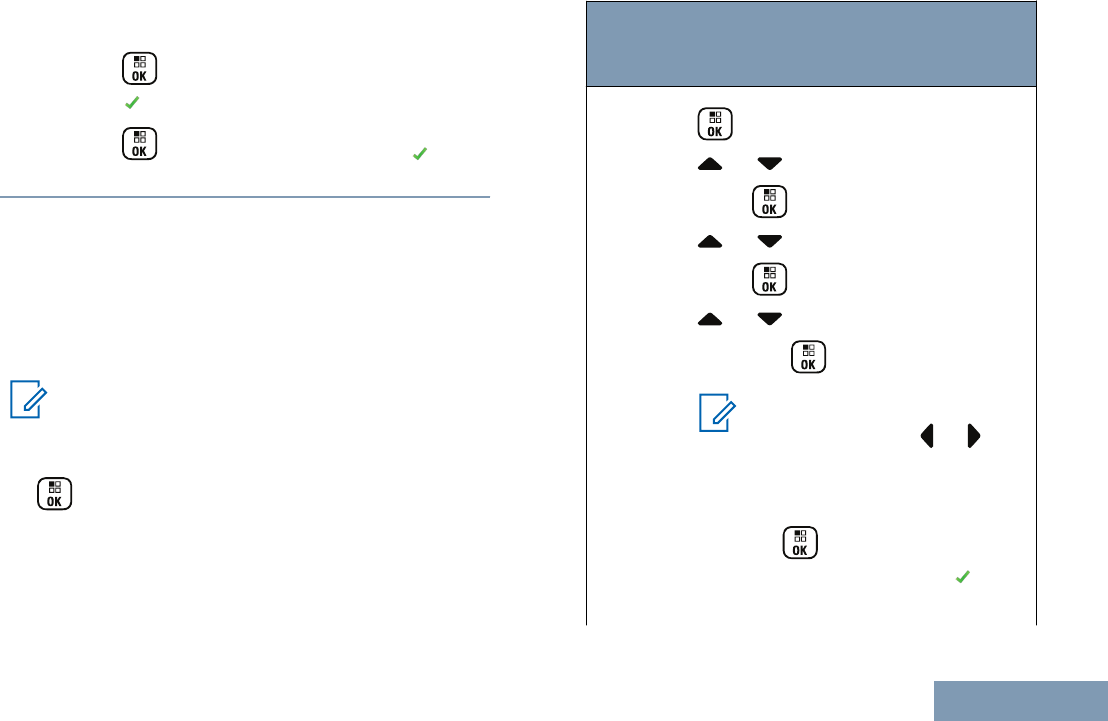
5Do one of the following:
•
Press to enable Mic AGC-D. The display
shows beside Enabled.
•
Press to disable Mic AGC-D. The
disappears from beside Enabled.
Intelligent Audio
Your radio can automatically adjust its audio volume
to overcome background noise in the environment,
inclusive of all stationary and non-stationary noise
sources. This feature is a Receive-only feature and
does not affect Transmit audio.
Note:
This feature is not applicable during a
Bluetooth session.
1
to access the menu.
Radio
Con-
trol
Steps
Menu 1
to access the menu.
2 or to Radio Settings and
press to select.
3 or to Radio Settings and
press to select.
4 or to Intelligent Audio
and press to select.
Note:
You can also use or to
change the selected option.
5Do one of the following:
•
Press to enable Intelligent
Audio. The display shows be-
side Enabled.
Advanced Features in Connect Plus Mode
285
English
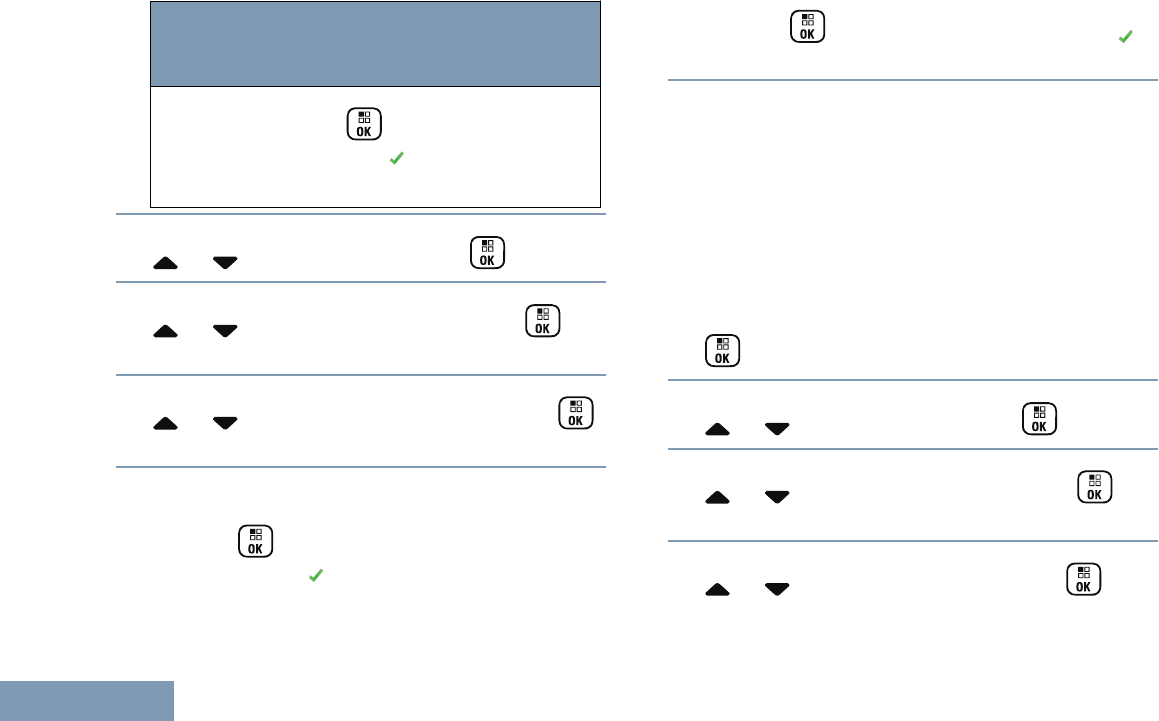
Radio
Con-
trol
Steps
•
Press to disable Intelligent
Audio. The disappears from be-
side Enabled.
2
or to Utilities and press to select.
3
or to Radio Settings and press to
select.
4
or to Intelligent Audio and press
to select.
5Do one of the following:
•
Press to enable Intelligent Audio. The
display shows beside Enabled.
•
Press to disable Intelligent Audio. The
disappears from beside Enabled.
See Authorized Accessories List on page 307 for
recommended Bluetooth-enabled audio accessories
with in-built Automatic Volume Control for similar
performance.
Turning the Acoustic Feedback Suppressor Feature On
or Off
This feature allows you to minimize acoustic feedback
in received calls.
1
to access the menu.
2
or to Utilities and press to select.
3
or to Radio Settings and press to
select.
4
or to AF Suppressor and press to
select.
Advanced Features in Connect Plus Mode
286
English
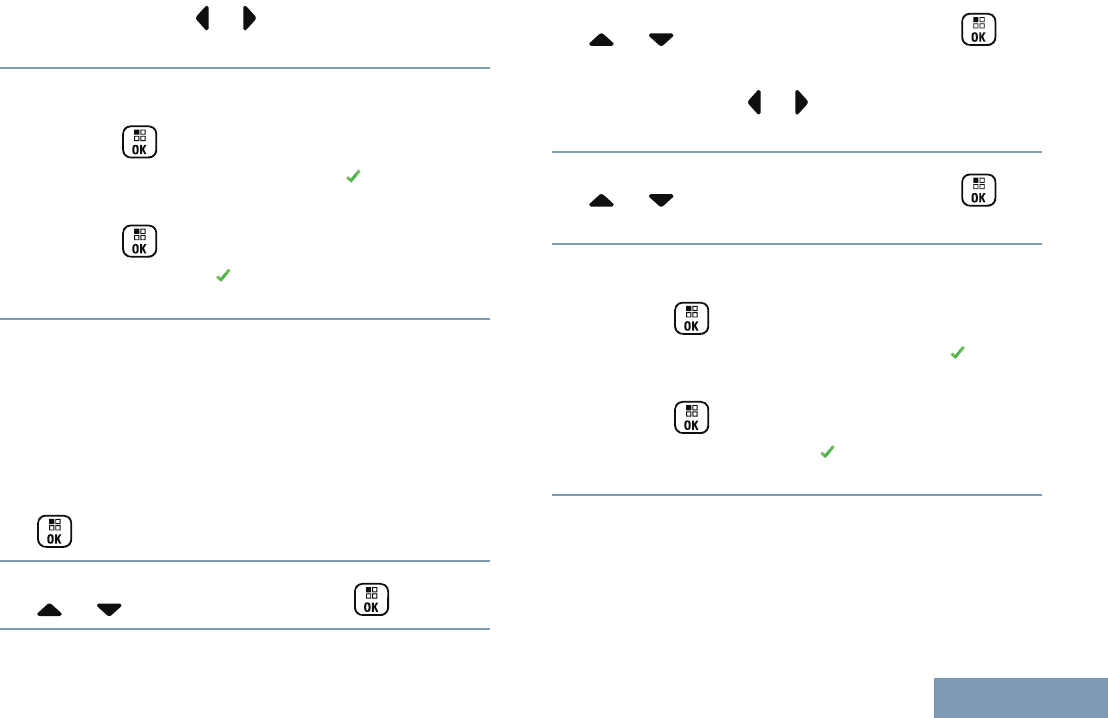
You can also use or to change the selected
option.
5Do one of the following.
•
Press to enable Acoustic Feedback
Suppressor. The display shows beside
Enabled.
•
Press to disable Acoustic Feedback
Suppressor. The disappears from beside
Enabled.
Turning the Microphone Dynamic Distortion Control
Feature On or Off
This feature allows you to enable the radio to
automatically monitor the microphone input and
adjust the microphone gain value to avoid audio
clipping.
1
to access the menu.
2
or to Utilities and press to select.
3
or to Radio Settings and press to
select.
You can also use or to change the selected
option.
4
or to Mic Distortion and press to
select.
5Do one of the following:
•
Press to enable Microphone Dynamic
Distortion Control. The display shows beside
Enabled.
•
Press to disable Microphone Dynamic
Distortion Control. The disappears from
beside Enabled.
Turning GPS/GNSS On or Off
Global Navigation Satellite System (GNSS) is a
satellite navigation system that determines the radio’s
precise location. GNSS includes Global Positioning
System (GPS), Global Navigation Satellite System
Advanced Features in Connect Plus Mode
287
English
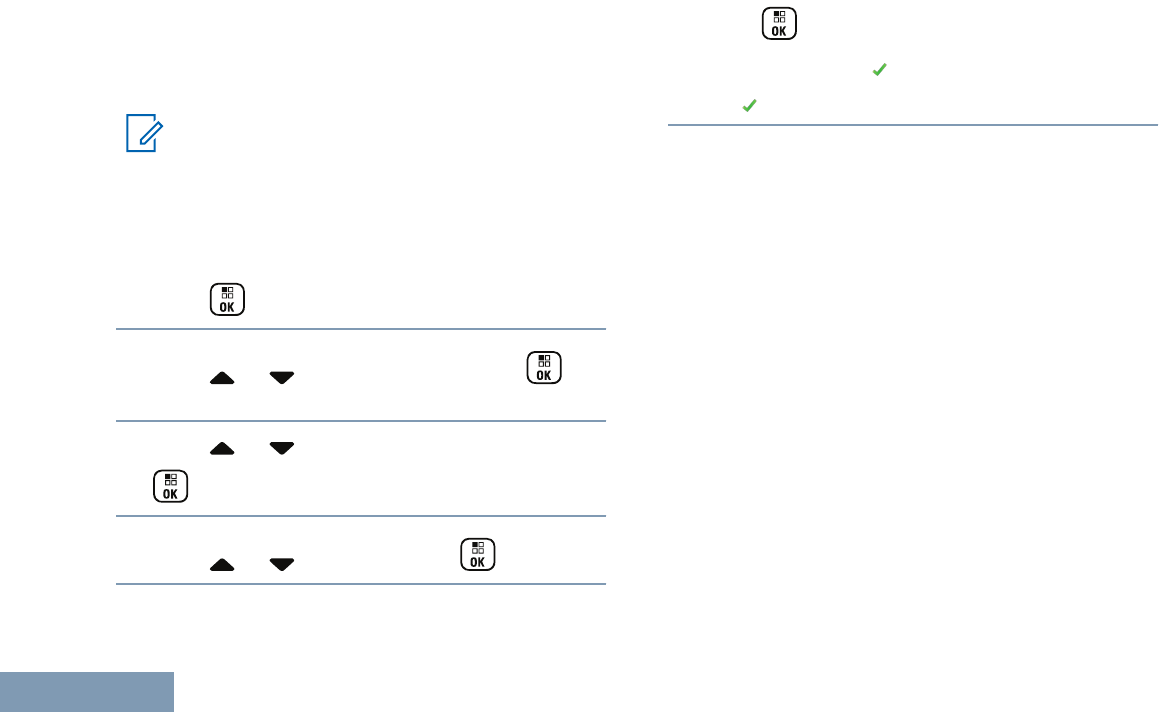
(GLONASS), and BeiDou Navigation Satellite System
(BDS).
Press the programmed GPS/GNSS button to toggle
the feature on or off.
Note:
Selected radio models may offer GPS,
GLONASS, and BDS. GNSS constellation is
configured via CPS. Check with your dealer or
system administrator to determine how your
radio has been programmed.
1
Press to access the menu.
2
Press or to Utilities and press to
select.
3Press or to Radio Settings and press
to select.
4
Press or to GPS and press to select.
5
Press to enable/disable GPS/GNSS.
The display shows beside Enabled.
The disappears from beside Enabled.
See Checking the GPS/GNSS Information on page
184 for details on retrieving GPS/GNSS information.
Text Entry Configuration
You can configure the following settings for entering
text on your radio:
• Word Predict
• Word Correct
• Sentence Cap
• My Words
Your radio supports the following text entry methods:
• Numbers
• Symbols
• Predictive or Multi-Tap
• Language (If programmed)
Advanced Features in Connect Plus Mode
288
English
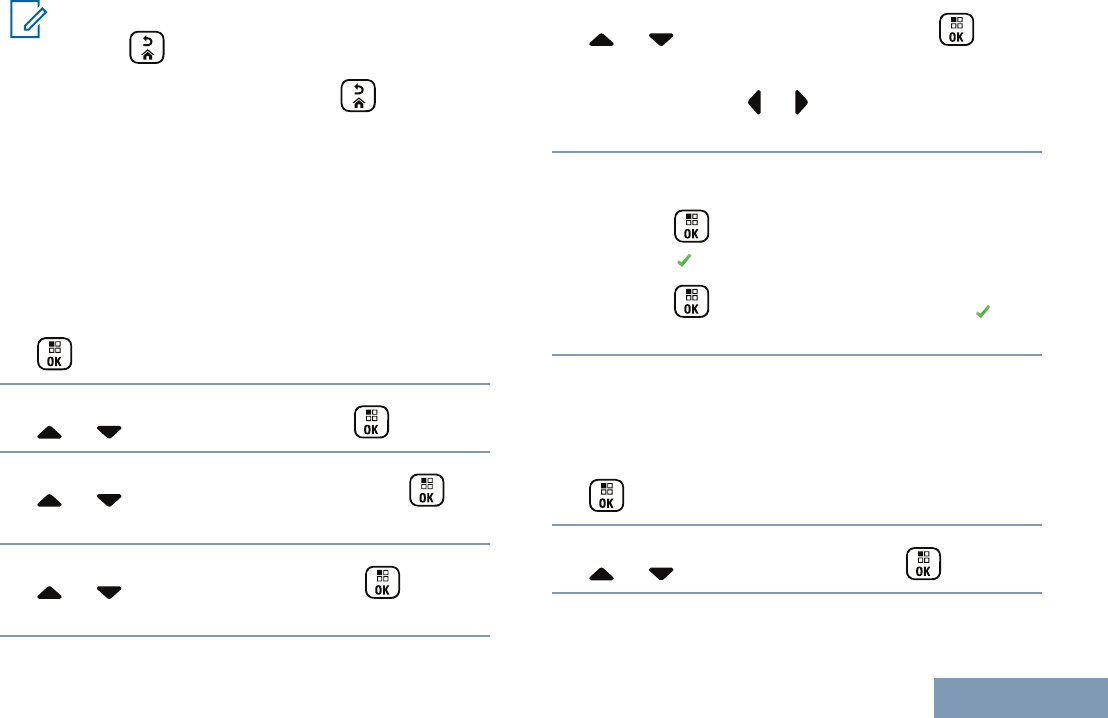
Note:
Press at any time to return to the
previous screen or long press to return to
the Home Screen. The radio exits the current
screen once the inactivity timer expires.
Word Predict
Your radio can learn common word sequences that
you often enter. It then predicts the next word you
may want to use after you enter the first word of a
common word sequence into the text editor.
1
to access the menu.
2
or to Utilities and press to select.
3
or to Radio Settings and press to
select.
4
or to Text Entry and press to
select.
5
or to Word Predict and press to
select.
You can also use or to change the selected
option.
6Do one of the following:
•
Press to enable Word Predict. The display
shows beside Enabled.
•
Press to disable Word Predict. The
disappears from beside Enabled.
Sentence Cap
Automatically enables capitalization for the first letter
in the first word for every new sentence.
1
to access the menu.
2
or to Utilities and press to select.
Advanced Features in Connect Plus Mode
289
English
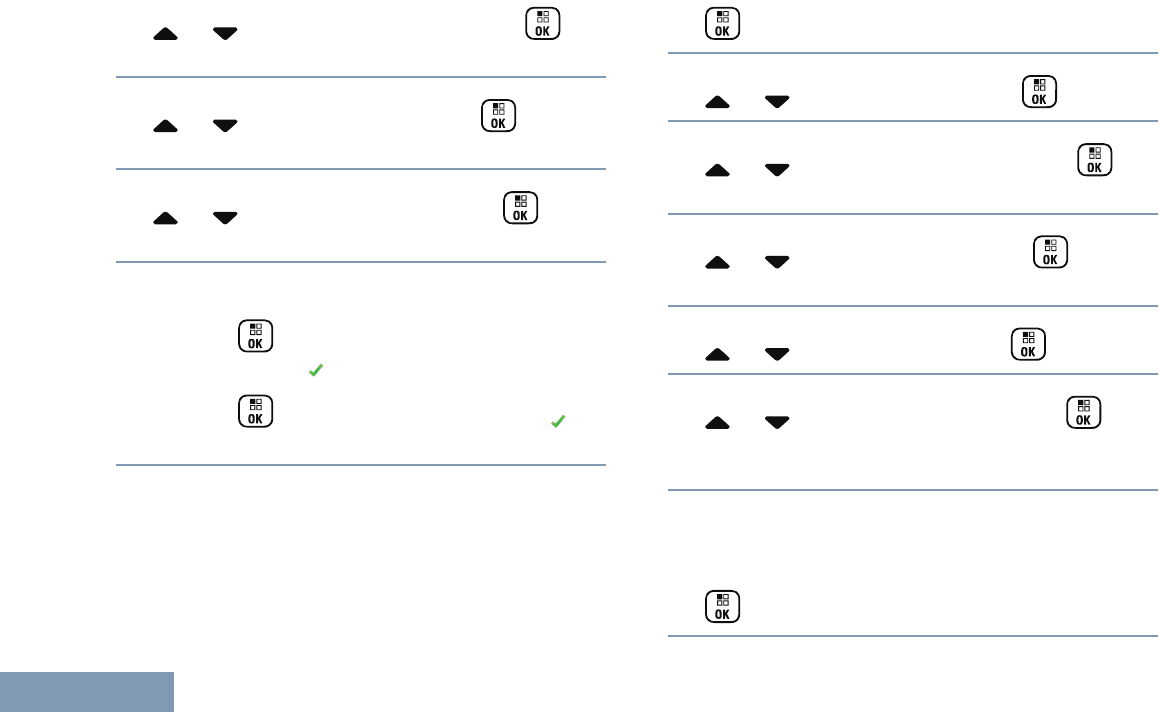
3
or to Radio Settings and press to
select.
4
or to Text Entry and press to
select.
5
or to Sentence Cap and press to
select.
6Do one of the following:
•
Press to enable Sentence Cap. The
display shows beside Enabled.
•
Press to disable Sentence Cap. The
disappears from beside Enabled.
Viewing Custom Words
You can add your own custom words into your radio’s
in-built dictionary. Your radio maintains a list to
contain these words.
1
to access the menu.
2
or to Utilities and press to select.
3
or to Radio Settings and press to
select.
4
or to Text Entry and press to
select.
5
or to My Words and press to select.
6
or to List of Words and press to
select.
Display shows the list of custom words.
Editing Custom Word
You can edit the custom words saved in your radio.
1
to access the menu.
Advanced Features in Connect Plus Mode
290
English
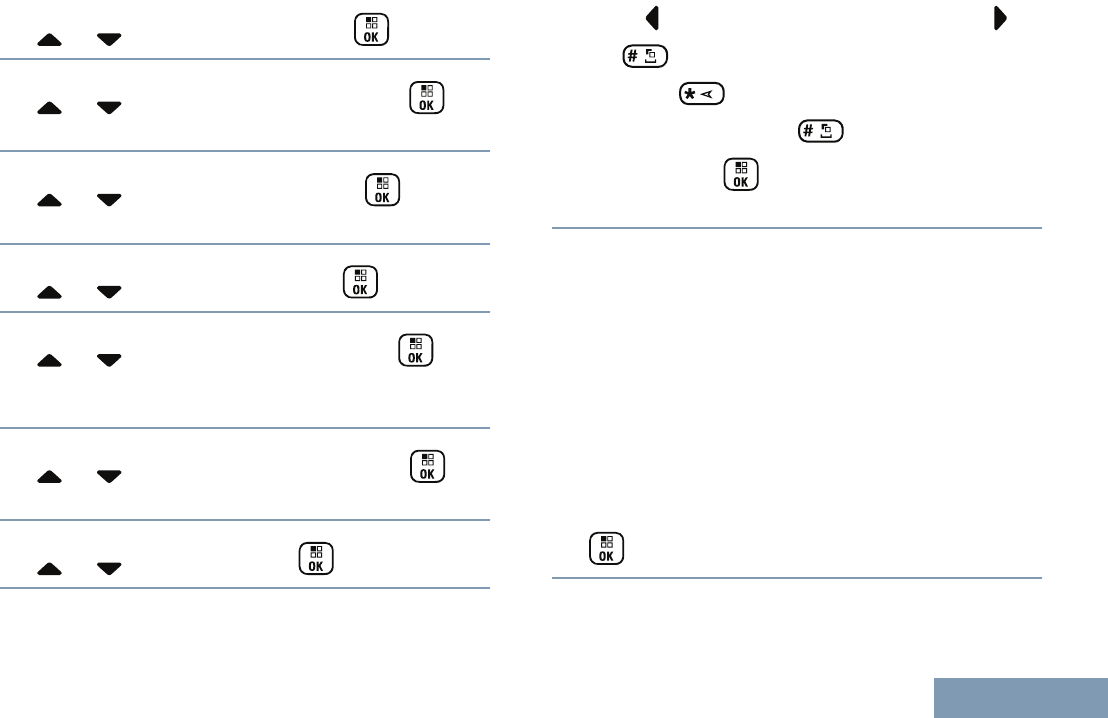
2
or to Utilities and press to select.
3
or to Radio Settings and press to
select.
4
or to Text Entry and press to
select.
5
or to My Words and press to select.
6
or to List of Words and press to
select.
Display shows the list of custom words.
7
or to the required word and press to
select.
8
or to Edit and press to select.
9Use the keypad to edit your custom word.
Press to move one space to the left. Press or
the key to move one space to the right.
Press the key to delete any unwanted
characters. Long press to change text entry
method. Press once your custom word is
completed.
The display shows transitional mini notice, confirming
your custom word is being saved.
If the custom word is saved, a tone sounds and the
display shows positive mini notice.
If the custom word is not saved, a low tone sounds
and the display shows negative mini notice.
Adding Custom Word
You can add your own custom words into your radio’s
in-built dictionary.
1
to access the menu.
Advanced Features in Connect Plus Mode
291
English
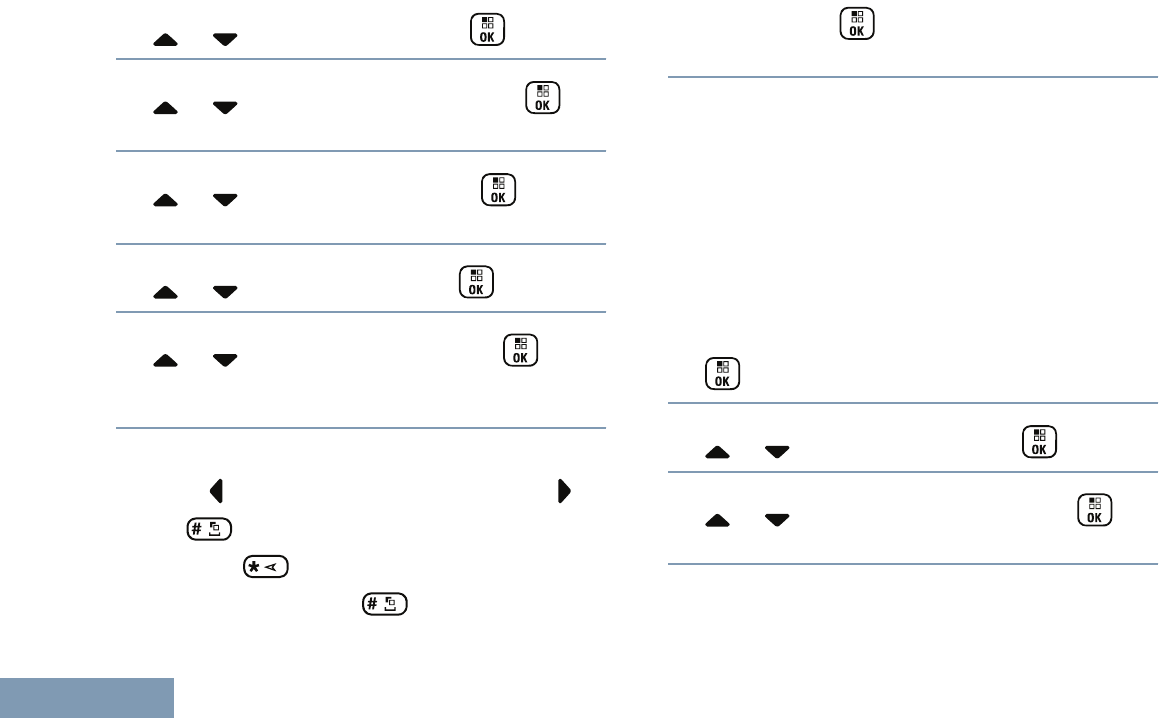
2
or to Utilities and press to select.
3
or to Radio Settings and press to
select.
4
or to Text Entry and press to
select.
5
or to My Words and press to select.
6
or to Add New Word and press to
select.
Display shows the list of custom words.
7Use the keypad to edit your custom word.
Press to move one space to the left. Press or
the key to move one space to the right.
Press the key to delete any unwanted
characters. Long press to change text entry
method. Press once your custom word is
completed.
The display shows transitional mini notice, confirming
your custom word is being saved.
If the custom word is saved, a tone sounds and the
display shows positive mini notice.
If the custom word is not saved, a low tone sounds
and the display shows negative mini notice.
Deleting a Custom Word
You can delete the custom words saved in your radio.
1
to access the menu.
2
or to Utilities and press to select.
3
or to Radio Settings and press to
select.
Advanced Features in Connect Plus Mode
292
English
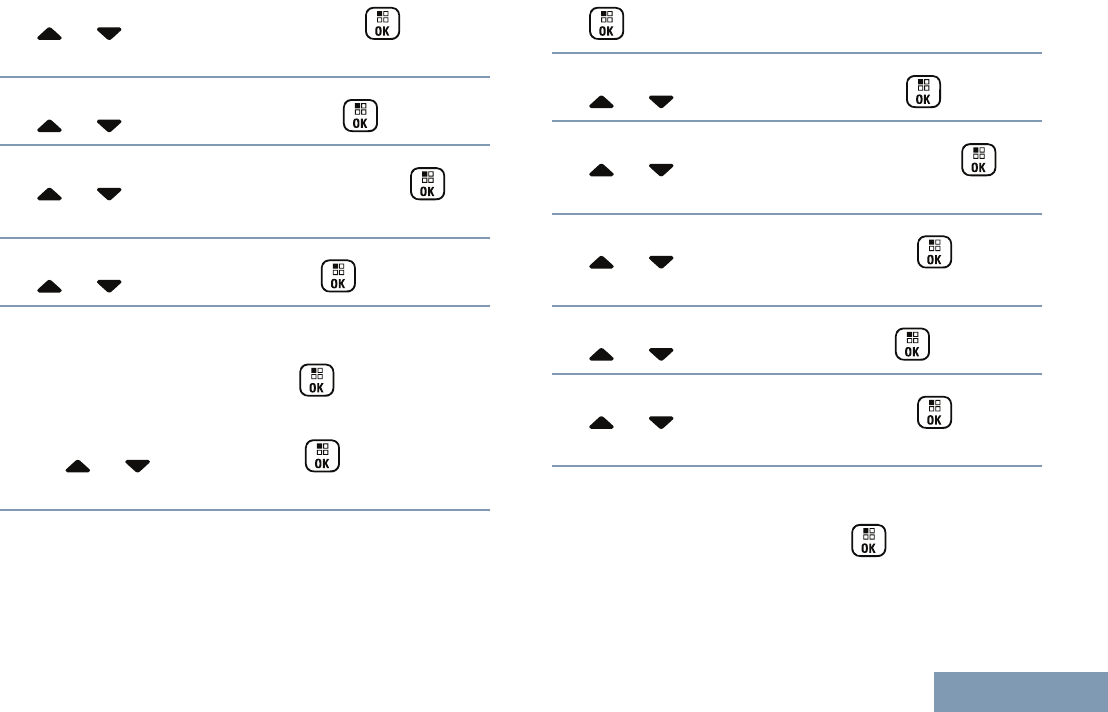
4
or to Text Entry and press to
select.
5
or to My Words and press to select.
6
or to the required word and press to
select.
7
or to Delete and press to select.
8Choose one of the following.
•
At Delete Entry?, press to select Yes.
The display shows Entry Deleted.
•
or to No and press to return to the
previous screen.
Deleting All Custom Words
You can delete all custom words from your radio’s in-
built.
1
to access the menu.
2
or to Utilities and press to select.
3
or to Radio Settings and press to
select.
4
or to Text Entry and press to
select.
5
or to My Words and press to select.
6
or to Delete All and press to
select.
7Choose one of the following.
•
At Delete Entry?, press to select Yes.
The display shows Entry Deleted.
Advanced Features in Connect Plus Mode
293
English
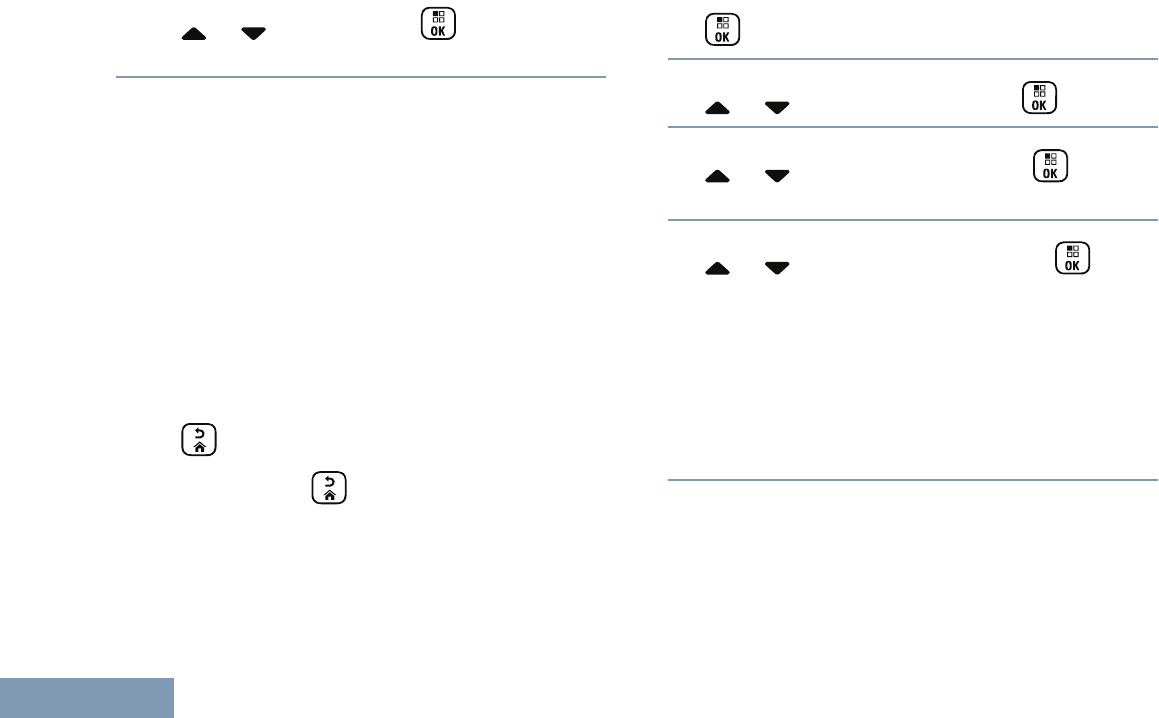
•
or to No and press to return to the
previous screen.
Accessing General Radio Information
Your radio contains information on the following:
• Battery
• Degree of Tilt (Accelerometer)
• Radio Model Number Index
• Option Board Over-the-Air (OTA) Codeplug CRC
• Site Number
• Site Info
• Radio Alias and ID
• Firmware and Codeplug Versions
• GPS Information
Press at any time to return to the previous
screen or long press to return to the Home
screen. The radio exits the current screen once the
inactivity timer expires.
Accessing the Battery Information
Displays information on your radio battery.
1
to access the menu.
2
or to Utilities and press to select.
3
or to Radio Info and press to
select.
4
or to Battery Info and press to
select.
The display shows the battery information.
For IMPRES batteries ONLY: The display reads
Recondition Battery if the battery requires
reconditioning in an IMPRES charger. After the
reconditioning process, the display then shows the
battery information.
Advanced Features in Connect Plus Mode
294
English
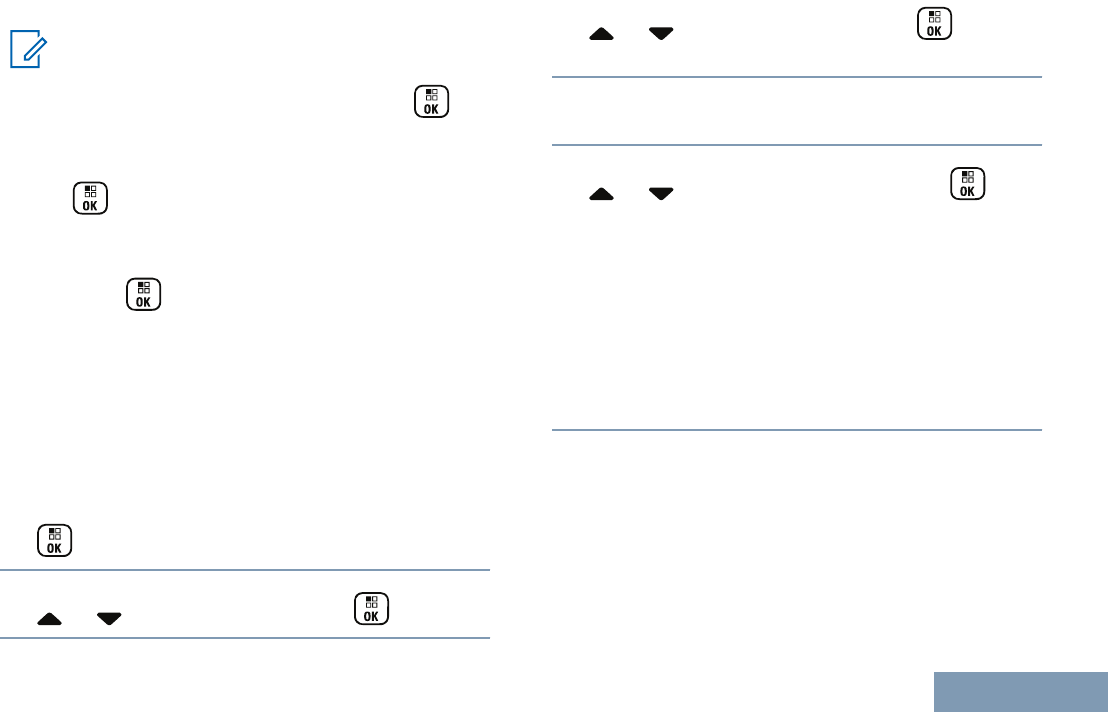
Checking the Degree of Tilt (Accelerometer)
Note:
The measurement on the display shows the
degree of tilt at the moment you press to
accept the Accelerometer option. If you
change the angle of the radio after pressing
, the radio does not change the
measurement shown on its display. It
continues to display the measurement taken
when was pressed.
If the portable radio has been enabled for the Man
Down Alarms, there is a menu option to check how
the radio measures the degree of tilt. This is a helpful
feature when the dealer or Radio System
Administrator uses the MOTOTRBO Connect Plus
Option Board CPS to configure the activation angle
that will trigger the tilt alarm.
1
to access the menu.
2
or to Utilities and press to select.
3
or to Radio Info and press to
select.
4Tilt the radio at the angle that triggers the Tilt
Alarm.
5
or to Accelerometer and press to
select.
The display shows the radio’s angle of tilt
(deviation from perpendicular vertical position) in
degrees (example: 62 Deg.) Based on this, use
MOTOTRBO Connect Plus Option Board CPS to
configure the Activation Angle for 60 degrees
(which is the closest programmable value). The
Tilt Alarm timers are triggered when the Activation
Angle is 60 degrees, or greater.
Checking the Radio Model Number Index
This index number identifies your radio’s model-
specific hardware. Your radio system administrator
may ask for this number when preparing a new
Option Board codeplug for your radio.
Advanced Features in Connect Plus Mode
295
English
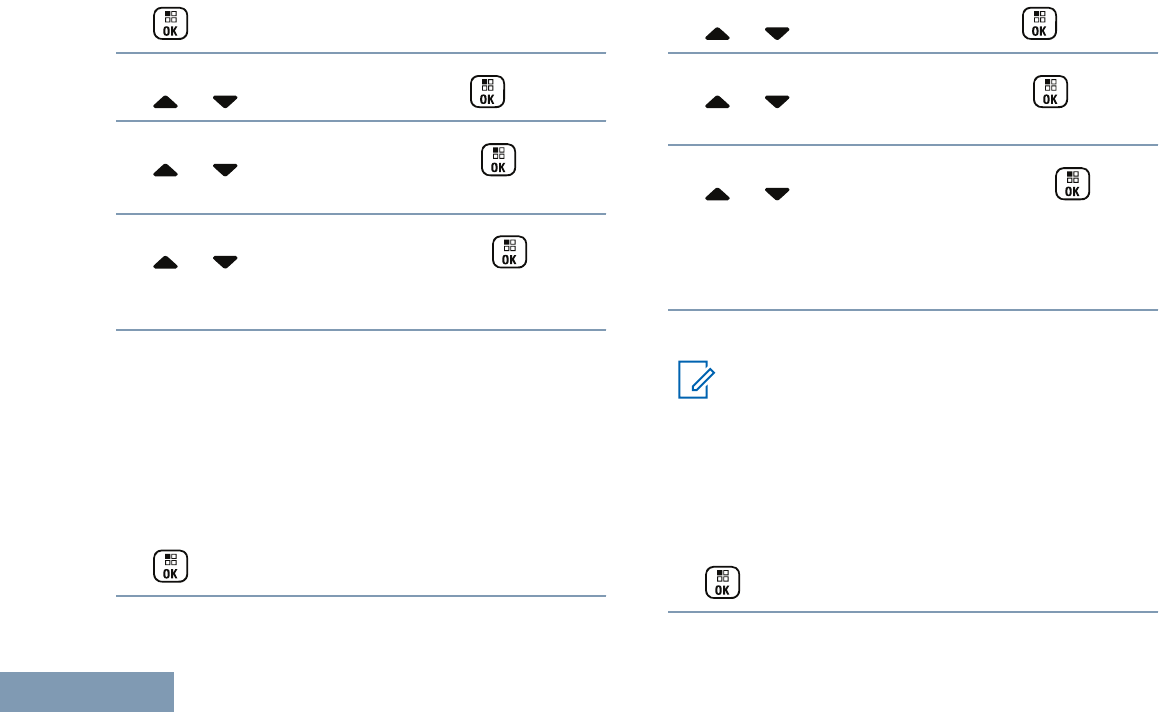
1
to access the menu.
2
or to Utilities and press to select.
3
or to Radio Info and press to
select.
4
or to Model Index and press to
select.
The display shows the Model Number Index.
Checking the CRC of the Option Board OTA
Codeplug File
Follow the instructions below if your radio system
administrator asks you to view the Option Board OTA
Codeplug File CRC (Cyclic Redundancy Check). This
menu option only appears if the Option Board
received its last codeplug update OTA.
1
to access the menu.
2
or to Utilities and press to select.
3
or to Radio Info and press to
select.
4
or to OB OTA CPcrc and press to
select.
The display shows some letters and numbers.
Communicate this information to your radio
system administrator exactly as shown.
Displaying the Site ID (Site Number)
Note:
If you are not currently registered at a site, the
display shows Not Registered.
The radio briefly shows the Site ID as it registers with
a Connect Plus site. Following registration, the radio
does not generally indicate the Site number. To
display the registered Site number, do the following:
1
to access the menu.
Advanced Features in Connect Plus Mode
296
English

2
or to Utilities and press to select.
3
or to Radio Info and press to
select.
4
or to Site Number and press to
select.
The display shows the Network ID and the Site
Number.
Checking the Site Info
Note:
If you are not currently registered at a site, the
display shows Not Registered.
The Site Info feature provides information that can be
useful to a service technician. It consists of the
following information:
• Repeater number of current Control Channel
repeater.
• RSSI: Last signal strength value measured from
Control Channel repeater.
•Neighbor List sent by Control Channel repeater
(five numbers separated by commas).
If you are requested to use this feature, please report
the displayed information exactly as it appears on the
screen.
1
to access the menu.
2
or to Utilities and press to select.
3
or to Radio Info and press to
select.
4
or to Site Info and press to select.
The display shows the Site Info.
Checking the Radio ID
This feature displays the ID of your radio.
Follow the procedure described next to access this
feature via the radio screen.
Advanced Features in Connect Plus Mode
297
English
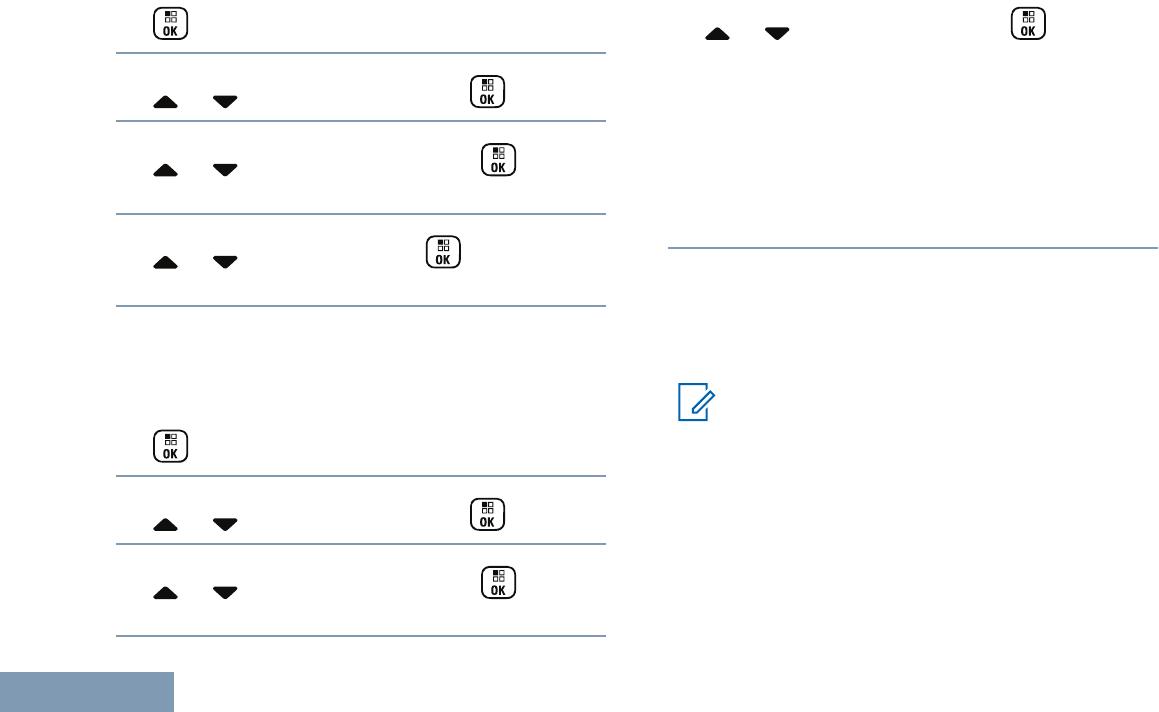
1
to access the menu.
2
or to Utilities and press to select.
3
or to Radio Info and press to
select.
4
or to My ID and press to select.
The display shows the radio ID.
Checking the Firmware Version and Codeplug
Version
Displays the firmware version on your radio.
1
to access the menu.
2
or to Utilities and press to select.
3
or to Radio Info and press to
select.
4
or to Versions and press to select.
The display a list with the following information:
• (Radio) Firmware Version
• (Radio) Codeplug Version
• Option Board Firmware Version
• Option Board Frequency Version
• Option Board Hardware Version
• Option Board Codeplug Version
Checking for Updates
Connect Plus provides the ability to update certain
files (Option Board Codeplug, Network Frequency
File and Option Board Firmware File) over-the-air.
Note:
Check with the dealer or network administrator
to determine whether this feature has been
enabled for your radio.
Any display Connect Plus radio has the ability to
show its current Option Board OTA Codeplug CRC,
Frequency File version or Option Board firmware file
version via a menu option. In addition, display radios
that have been enabled for over-the-air file transfer
can display the version of a "pending file". A "pending
Advanced Features in Connect Plus Mode
298
English

file" is a Frequency File or Option Board firmware file
that the Connect Plus radio knows about via system
messaging, but the radio has not yet collected all of
the file’s packets. If a display Connect Plus radio has
a pending file, the menu provides options to:
• See the version number of the pending file.
• See what percentage of packets has been
collected so far.
•Request the Connect Plus radio to resume
collecting file packets.
If the radio is enabled for Connect Plus over-the-air
file transfer, there may be times when the radio
automatically joins a file transfer without first notifying
the radio user. While the radio is collecting file
packets, the LED rapidly blinks red and the radio
displays the High Volume Data icon on the Home
Screen status bar.
Note:
The Connect Plus radio cannot collect file
packets and receive calls at the same time. If
you wish to cancel the file transfer, press and
release the PTT button. This causes the radio
to request a call on the selected Contact
Name, and it will also cancel the file transfer
for that radio until the process resumes at a
later time.
There are several things that can make the file
transfer process start again. The first example applies
to all over-the-air file types. The other examples apply
only to the Network Frequency File and Option Board
Firmware File:
• The radio system administrator re-initiates the
over-the-air file transfer.
• The Option Board's pre-defined timer expires,
which causes the Option Board to automatically
resume the process of collecting packets.
•The timer has not yet expired, but the radio user
requests the file transfer to resume via the menu
option.
After the Connect Plus radio finishes downloading all
file packets, it must upgrade to the newly acquired
file. For the Network Frequency File, this is an
automatic process and does not require a radio reset.
For the Option Board Codeplug File, this is an
automatic process that will cause a brief interruption
to service as the Option Board loads the new
codeplug information and re-acquires a network site.
How quickly the radio upgrades to a new Option
Board firmware file depends on how the radio has
Advanced Features in Connect Plus Mode
299
English
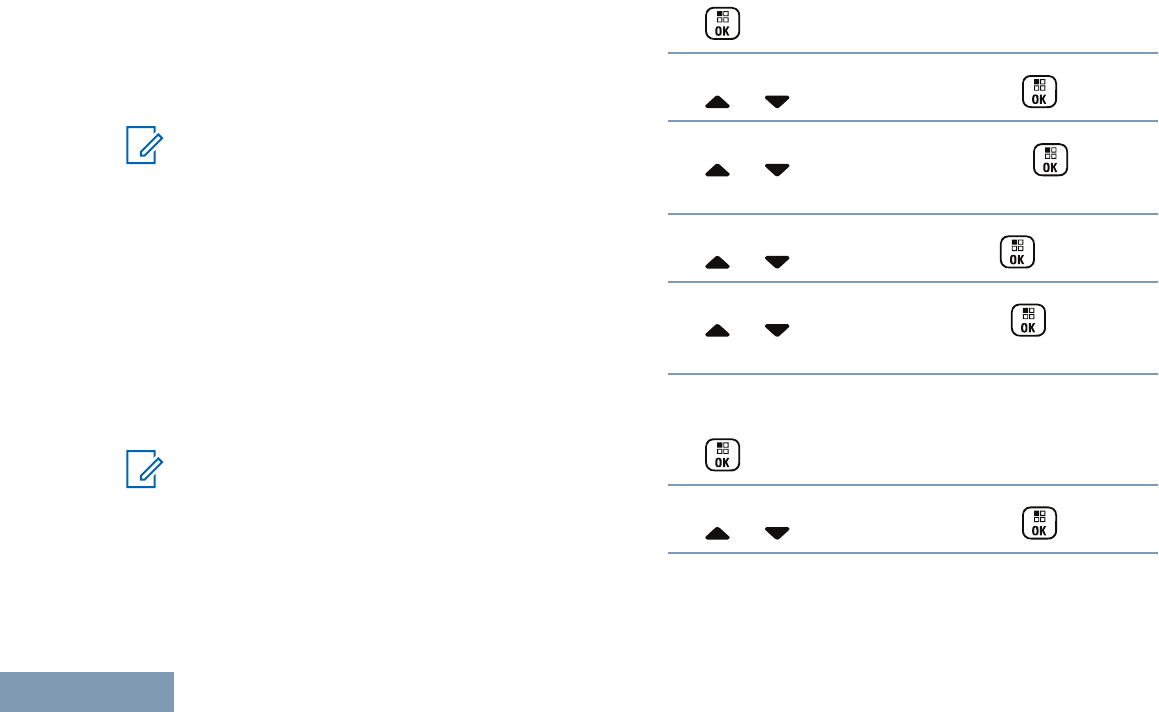
been configured by the dealer or system
administrator. The radio will either upgrade
immediately after collecting all file packets, or it will
wait until the next time that the user turns the radio
on.
Note:
Check with your dealer or system
administrator to determine how your radio has
been programmed.
The process of upgrading to a new Option Board
firmware file takes several seconds, and it requires
the Connect Plus Option Board to reset the radio.
Once the upgrade starts, the radio use will not be
able to make or receive calls until the process is
completed.
Firmware File
Firmware Up to Date
Note:
If the Option Board firmware file is not Up to
Date (and if the radio has partially collected a
more recent Option Board firmware file
version) the radio displays a list with additional
options; Version, %Received, and Download.
1
to access the menu.
2
or to Utilities and press to select.
3
or to Radio Info and press to
select.
4
or to Updates and press to select.
5
or to Firmware and press to select.
The display shows Firmware is Up to Date.
Pending Firmware – Version
1
to access the menu.
2
or to Utilities and press to select.
Advanced Features in Connect Plus Mode
300
English
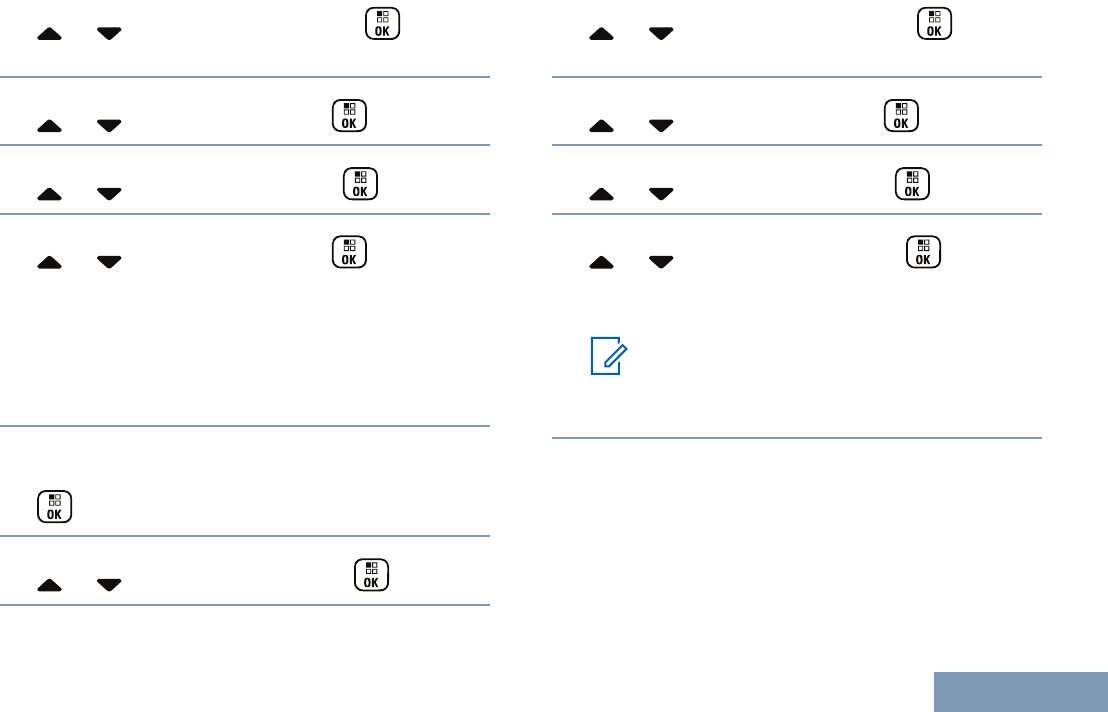
3
or to Radio Info and press to
select.
4
or to Updates and press to select.
5
or to Firmware and press to select.
6
or to Version and press to select.
If there is a pending Option Board firmware file,
the display shows the pending firmware version
number.
If there is a pending Option Board firmware file,
the display shows Firmware is Up to Date.
Pending Firmware – % Received
1
to access the menu.
2
or to Utilities and press to select.
3
or to Radio Info and press to
select.
4
or to Updates and press to select.
5
or to Firmware and press to select.
6
or to %Received and press to select.
The screen displays the percentage of firmware
file packets collected so far.
Note:
When at 100%, the radio needs to be
power cycled Off and then On to initiate the
firmware upgrade.
Pending Firmware – Download
If the Connect Plus radio has previously left an OTA
Option Board Firmware File Transfer with a partial
file, the unit automatically rejoins the file transfer (if
still ongoing) when an internal timer expires. If you
want the unit to rejoin an ongoing Option Board
Firmware File transfer prior to expiration of this
Advanced Features in Connect Plus Mode
301
English
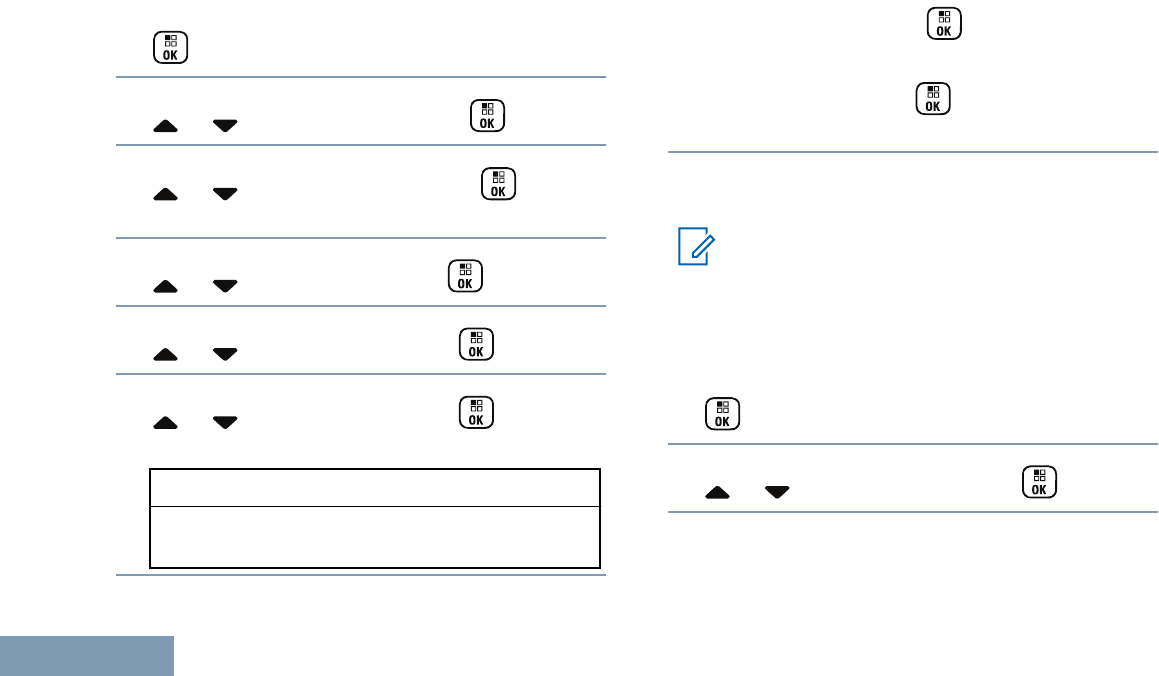
internal timer, use the Download option as described
below.
1
to access the menu.
2
or to Utilities and press to select.
3
or to Radio Info and press to
select.
4
or to Updates and press to select.
5
or to Firmware and press to select.
6
or to Download and press to select.
The display shows the following:
Download Available Start Download
No Download Availa-
ble
Download not availa‐
ble
7Do one of the following:
•
Select Yes and press to start the
download.
•
Select No and press to return to the
previous menu.
Frequency File
Frequency File Up to Date
Note:
If the Frequency File is not Up to Date (and if
the radio has partially collected a more recent
frequency file version) the radio displays a list
with additional options; Version, %Received,
and Download.
1
to access the menu.
2
or to Utilities and press to select.
Advanced Features in Connect Plus Mode
302
English
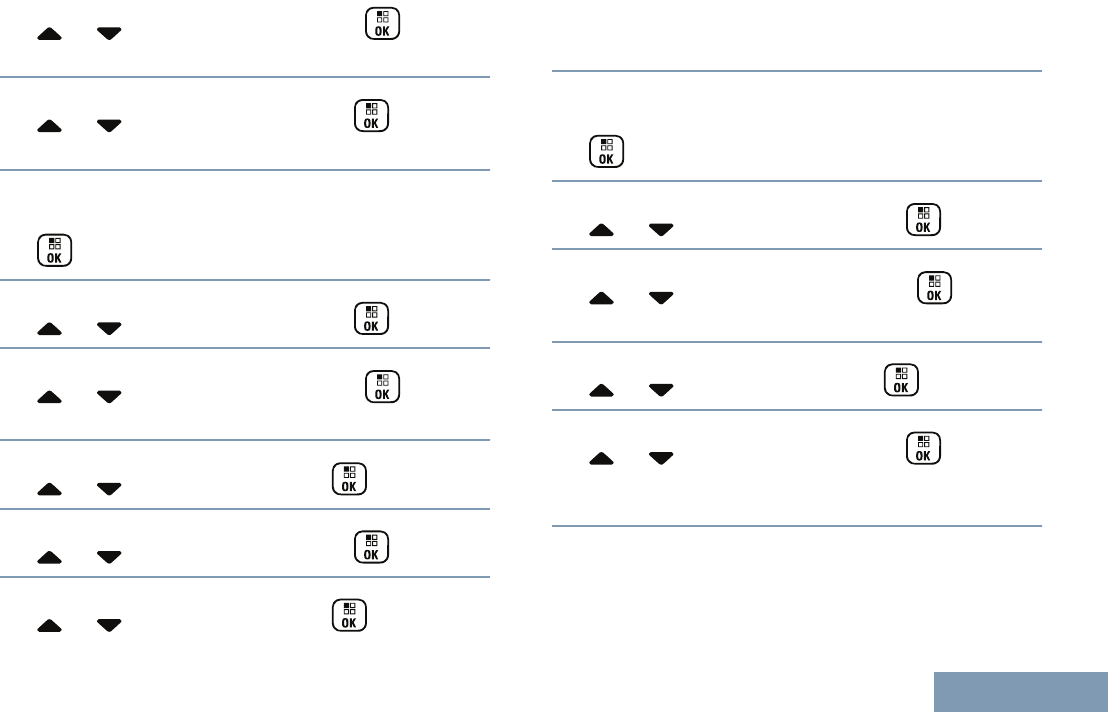
3
or to Radio Info and press to
select.
4
or to Frequency and press to select.
The display shows Freq. File is Up to Date.
Frequency File Pending – Version
1
to access the menu.
2
or to Utilities and press to select.
3
or to Radio Info and press to
select.
4
or to Updates and press to select.
5
or to Frequency and press to select.
6
or to Version and press to select.
If there is a pending Frequency File, the display
shows the pending Frequency File version
number.
Frequency File Pending – % Received
1
to access the menu.
2
or to Utilities and press to select.
3
or to Radio Info and press to
select.
4
or to Updates and press to select.
5
or to %Received and press to select.
The screen displays the percentage of frequency
file packets collected so far.
Frequency File Pending – Download
If the Connect Plus radio has previously left an OTA
Network Frequency File Transfer with a partial file,
Advanced Features in Connect Plus Mode
303
English
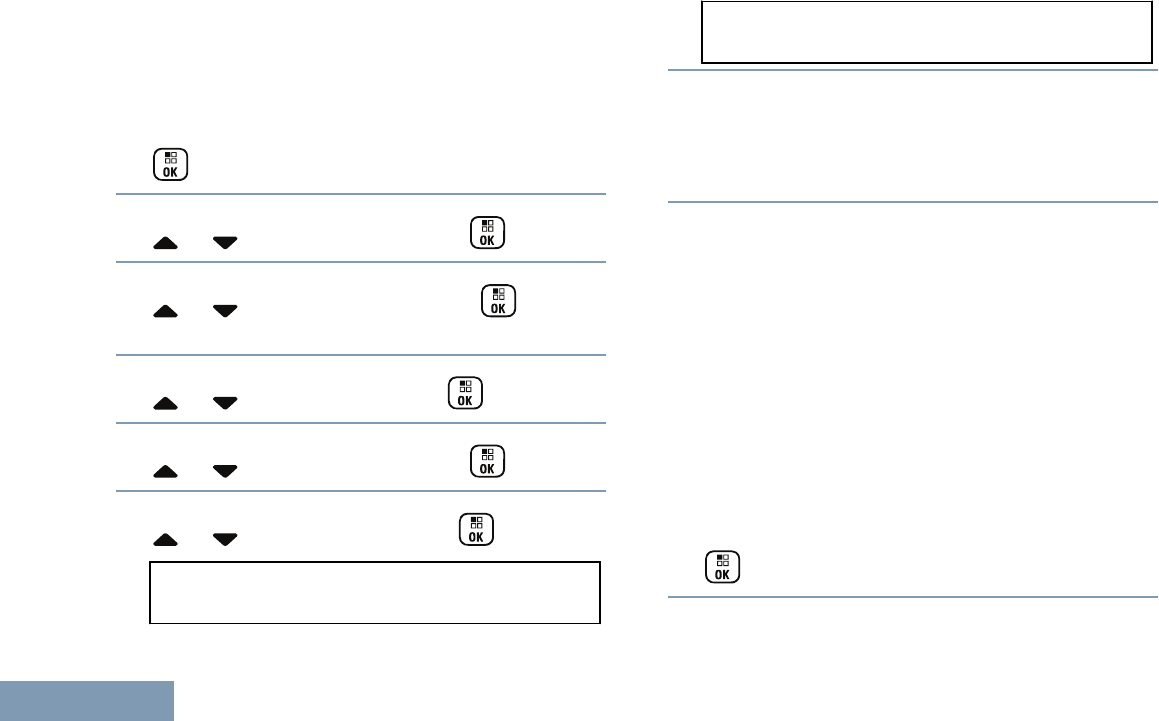
the unit automatically rejoins the file transfer (if still
ongoing) when an internal timer expires. If you want
the unit to rejoin an ongoing Network Frequency File
transfer prior to expiration of this internal timer, use
the Download option as described below.
1
to access the menu.
2
or to Utilities and press to select.
3
or to Radio Info and press to
select.
4
or to Updates and press to select.
5
or to Frequency and press to select.
6
or to Download and press to select.
Download Currently
Unavailable
Download not avail‐
able
Download Currently
Available
Start Download
7Do one of the following:
•Select Yes and press to start the download.
•Select No and press to return to the previous
menu.
Checking the GPS/GNSS Information
Displays the GPS/GNSS information on your radio,
such as values of:
• Latitude
• Longitude
•Altitude
• Direction
• Velocity
• Horizontal Dilution of Precision (HDOP)
• Satellites
• Version
1
to access the menu.
Advanced Features in Connect Plus Mode
304
English
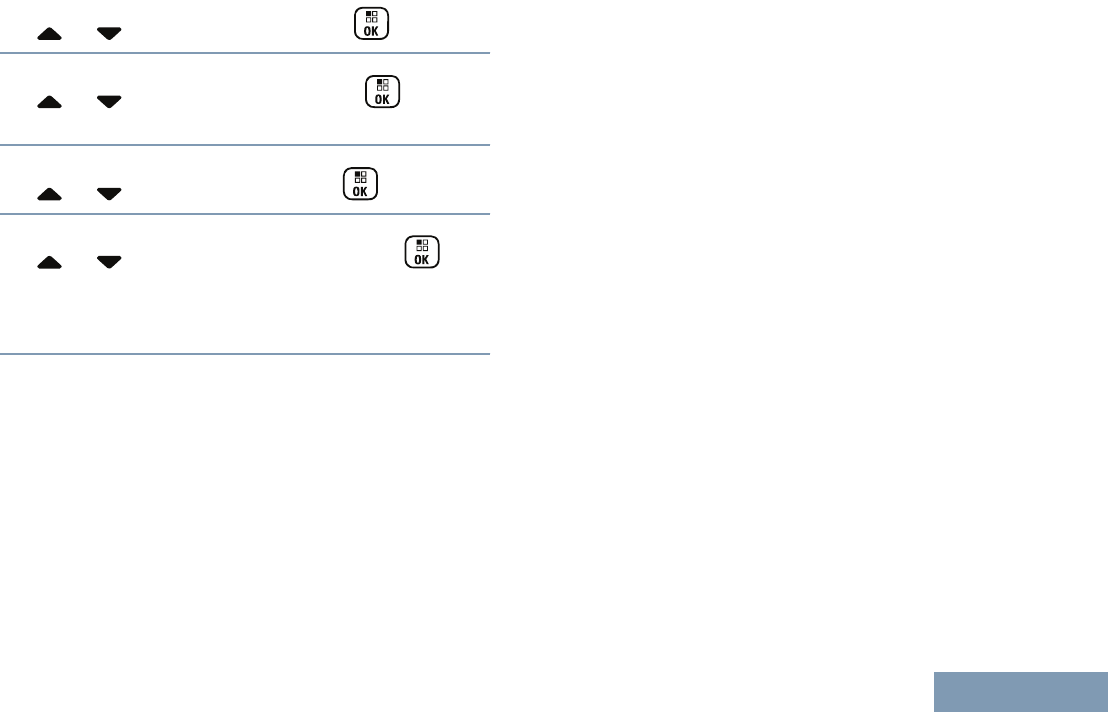
2
or to Utilities and press to select.
3
or to Radio Info and press to
select.
4
or to GPS Info and press to select.
5
or to the required item and press to
select.
The display shows the requested GPS/GNSS
information.
See Turning GPS/GNSS On or Off on page 172 for
details on GPS/GNSS.
Advanced Features in Connect Plus Mode
305
English

Accessories
Accessories
306
English

Authorized Accessories List
Antennas
• UHF, 403 – 527MHz, Whip Antenna
(PMAE4068_)[7]
• UHF, 403 – 527MHz, Slim Whip Antenna
(PMAE4079_)[7]
• UHF, 403 – 450MHz, Stubby Antenna
(PMAE4069_)[7]
•UHF, 440 – 490MHz, Stubby Antenna
(PMAE4070_[7]
• UHF, 470 – 527MHz, Stubby Antenna
(PMAE4071_)[7]
• UHF, 470 – 527MHz, Stubby Antenna
(PMAE4071_)[7]
• VHF, 144 – 165MHz, Helical Antenna
(PMAD4116_)[7]
• VHF, 136 – 155MHz, Helical Antenna
(PMAD4117_)[7]
• VHF, 152 – 174MHz, Helical Antenna
(PMAD4118_)[7]
• VHF, 136 – 148MHz, Stubby Antenna
(PMAD4119_)[7]
• VHF, 146 – 160MHz, Stubby Antenna
(PMAD4120_)[7]
• VHF, 160 – 174MHz, Stubby Antenna
(PMAD4121)[7]
• 800/900, 806 – 870MHz, Whip Antenna
(PMAF4011_)[8]
• 800/900, 896 – 941MHz, Whip Antenna
(PMAF4012_)[8]
• 800/900, 806 – 870MHz, Short Whip Antenna
(PMAF4009_)
• 800/900, 896 – 941MHz, Short Whip Antenna
(PMAF4010_)
Batteries
• Core NiMH, 1300 mAh Battery (PMNN4412_)
• Core Slim Li-Ion, 1500 mAh Battery
(PMNN4406_R)
7Applicable to XPR7550 only.
8Applicable to XPR7580 only.
Authorized Accessories List
307
English

• IMPRES Li-Ion, 1500 mAh Slim Battery
(PMNN4407_R)
• IMPRES Hi-Capacity Li-Ion, 2150 mAh Battery
(PMNN4409_R)
• IMPRES Hi-Capacity Li-Ion, 2300 mAh Battery
(FM) (NNTN8129_)
•IMPRES Li-Ion, 2700 mAh Battery
(PMNN4448_R)
• IMPRES Li-Ion, 2900 mAh TIA4950 HAZLOC IP68
Battery(PMNN4489_)[9]
• IMPRES Hi-Capacity Li-Ion, 2500 mAh TIA4950
Submersible IP57 Battery, Intrinsically Safe
(NNTN8560_)
• IMPRES Slim Li-Ion, 2100 mAh IP68 Battery
(PMNN4491_)
• IMPRES Li-Ion, 3000 mAh IP68 Battery, low
voltage (PMNN4493_)
• IMPRES Li-Ion, 3000 mAh IP68 Battery
(PMNN4488_)
Carry Devices
• 2.5-Inch Replacement Leather Swivel Belt Loop
(PMLN5610_)
• 3-Inch Replacement Leather Swivel Belt Loop
(PMLN5611_)
• Hard Leather Carry Case with 3-Inch Fixed Belt
Loop for Full-Keypad Radio (PMLN5838_)
•Hard Leather Carry Case with 3-Inch Swivel Belt
Loop for Full-Keypad Radio (PMLN5840_)
• Hard Leather Carry Case with 2.5-Inch Swivel Belt
Loop for Full-Keypad and Limited-Keypad Radio
(PMLN5842_)
• Nylon Carry Case with 3-Inch Fixed Belt Loop for
Full-Keypad and Limited-Keypad Radio
(PMLN5844_)
• Belt Clip for 2-Inch Belt Width (PMLN4651_)
• Belt Clip for 2.5-Inch Belt Width (PMLN7008_)
• Vibrating Belt Clip for 2.5-Inch Belt Width
(PMLN7296_)
Chargers
• IMPRES Multi-Unit Charger (WPLN4212_)
9Applicable to XPR 7550e/XPR 7580e only.
Authorized Accessories List
308
English

• IMPRES Multi-Unit Charger with Display
(WPLN4219_)
• IMPRES Single-Unit Charger (WPLN4232_)
• Core Single Unit Charger (NNTN8117_)
•IMPRES Vehicular Charger (NNTN7616_)
• IMPRES Battery Reader (NNTN7392_)
Earbuds and Earpieces
• Receive-Only Earbud (AARLN4885_)
• Receive-Only Earbud (MDRLN4885)
• D-Shell Receive-Only Earpiece (PMLN4620_)
•Receive-Only Earpiece (RLN4941_)
• Standard Earpiece, Black (RLN6279_)
• Standard Earpiece, Beige (RLN6280_)
• Earpiece with Acoustic Tube Assembly, Beige
(RLN6284_)
• Earpiece with Acoustic Tube Assembly, Black
(RLN6285_)
• Earpiece with High Noise Kit, Beige (RLN6288_)
• Earpiece with High Noise Kit, Black (RLN6289_)
• 1-Wire Earbud, 29cm Cord, Black (NNTN8294_)
• 1-Wire Earbud,116cm Cord, Black (NNTN8295_)
• Over-the-Ear Receiver for Remote Speaker
Microphone (WADN4190_)
• D-Shell Earset (PMLN5096_)
• IMPRES Temple Transducer with In-line Push-to-
Talk (PMLN5101_)
• Replacement Foam Ear Pad and Windscreen
(RLN6283_)
•Replacement Ear Seal Cloth Cover (1580376E32)
• Replacement Boom Mic Windscreen
(5080548E02)
• Replacement Windscreen O-Ring (3280376E35)
• Wireless Earpiece Maintenance Kit (NTN8821_)
• Replacement Ear Tips Kit for Wireless Ear Buds
(NNTN8316_)
• Replacement Ear Tubes for CommPort Earpiece,
Pack of 10 (RLN5037_)
• Ear Straps for CommPort Earpiece (for Secure
Attachment to Ear), Pack of 10 (NTN8988_)
Headsets and Headset Accessories
• Ultra-Lite Headset (PMLN5102_)
• Heavy Duty Noise-Canceling Headset
(PMLN5275_)
• Lightweight Headset (RMN5058_)
Authorized Accessories List
309
English

• Non-Secure Wireless Headset & Push-to-Talk
Device with Push-to-Talk Audio, 12-Inch Cable
(NNTN8125_)
• Non-Secure Wireless Headset & Push-to-Talk
Device with Push-to-Talk Audio, 9.5-Inch Cable
(NNTN8126_)
• Non-Secure Wireless Push-to-Talk Device
(NNTN8127_)
•Push-to-Talk Module, without Charger
(NNTN8191_)
• Replacement Earpiece 12–Inch Cable (for
NNTN8125_)(NTN2572_)
• Business Wireless Accessory Kit (PMLN6463_)
Remote Speaker Microphones
• Remote Speaker Microphone (PMMN4024_)
• IMPRES Remote Speaker Microphone
(PMMN4025_)
• Remote Speaker Microphone, Submersible (IP57)
(PMMN4040_)
•IMPRES Remote Speaker Microphone, with
Volume, IP57 (PMMN4046_)
• IMPRES Remote Speaker Microphone, with
Earjack, Noise-Canceling (PMMN4050_)
• Remote Speaker Microphone Replacement Coil
Cord Kit (For Use with PMMN4024_ and
PMMN4040_) (RLN6074_)
• Remote Speaker Microphone Replacement Coil
Cord Kit (For Use with PMMN4025_,
PMMN4046_, PMMN4050_) (RLN6075_)
• IMPRES Remote Speaker Microphone, IP57
(NNTN8382_)
•IMPRES Remote Speaker Microphone, with
Earjack (NNTN8383_)
Surveillance Accessories
• Receive Only Surveillance Kit, Black (Single Wire)
(PMLN6125_)
• Receive Only Surveillance Kit, Beige (Single Wire)
(PMLN6126_)
• Surveillance Low Noise Kit (RLN5886_)
•Surveillance High Noise Kit (RLN5887_)
• IMPRES 2-Wire Surveillance Kit, Black
(PMLN6127_)
• IMPRES 2-Wire Surveillance Kit, Beige
(PMLN6128_)
• IMPRES 2-Wire Surveillance Kit with Clear,
Comfortable Acoustic Tube, Black (RLN5882_)
Authorized Accessories List
310
English

• IMPRES 2-Wire Surveillance Kit with Clear,
Comfortable Acoustic Tube, Black (PMLN6129_)
• IMPRES 2-Wire Surveillance Kit with Clear,
Comfortable Acoustic Tube, Beige (PMLN6130_)
• IMPRES 3-Wire Surveillance, Black (PMLN5097_)
•IMPRES 3-Wire Surveillance, Beige (PMLN5106_)
• IMPRES 3–Wire Surveillance with Clear,
Comfortable Acoustic Tube, Black (PMLN6123_)
• IMPRES 3–Wire Surveillance with Clear,
Comfortable Acoustic Tube, Beige (PMLN6124_)
• Transparent Acoustic Tube (RLN6242_)
• Replacement Foam Plugs, Pack of 50 (For Use
with RLN5886_) (RLN6281_)
• Replacement Ear Tips, Clear, Pack of 50 (For Use
with RLN5887_) (RLN6282_)
• Small Custom Earpiece for Surveillance Kits, Right
Ear (RLN4760_)
• Medium Custom Earpiece for Surveillance Kits,
Right Ear (RLN4761_)
• Large Custom Earpiece for Surveillance Kits,
Right Ear (RLN4762_)
• Small Custom Earpiece for Surveillance Kits, Left
Ear (RLN4763_)
• Medium Custom Earpiece for Surveillance Kits,
Left Ear (RLN4764_)
• Large Custom Earpiece for Surveillance Kits, Left
Ear (RLN4765_)
Miscellaneous Accessories
• Universal Chest Pack (HLN6602_)
• Waterproof Bag, Includes Large Carry Strap
(HLN9985_)
• Shoulder Strap (Attaches to D-Ring on Carry
Case) (NTN5243_)
•Small Clip, Epaulet Strap (RLN4295_)
• Break-A-Way Chest Pack (RLN4570_)
• Universal RadioPAK and Utility Case (Fanny
Pack) (RLN4815_)
• Replacement Strap for RLN4570_ and HLN6602_
Chest Packs (1505596Z02)
• Universal RadioPAK Extension Belt (4280384F89)
• Belt (4200865599)
• Tactical Remote Body Push-to-Talk (PMLN6767_)
• Push-to-Talk Interface Module (PMLN6827_)
• Tactical Remote Ring Push-to-Talk (PMLN6830_)
• Tactical Heavy Duty Temple Transducer with
Noise Cancelling Boom Microphone (PMLN6833_)
Authorized Accessories List
311
English

Maritime Radio Use in the VHF
Frequency Range
Special Channel Assignments
Emergency Channel
If you are in imminent and grave danger at sea and
require emergency assistance, use VHF Channel 16
to send a distress call to nearby vessels and the
United States Coast Guard. Transmit the following
information, in this order:
1“MAYDAY, MAYDAY, MAYDAY.”
2“THIS IS _____________________, CALL SIGN
__________.” State the name of the vessel in
distress 3 times, followed by the call sign or other
identification of the vessel, stated 3 times.
3Repeat “MAYDAY” and the name of the vessel.
4“WE ARE LOCATED AT
_______________________.” State the position
of the vessel in distress, using any information that
will help responders to locate you, e.g.:
• latitude and longitude
• bearing (state whether you are using true or
magnetic north)
•distance to a well-known landmark
• vessel course, speed or destination
5State the nature of the distress.
6Specify what kind of assistance you need.
7State the number of persons on board and the
number needing medical attention, if any.
8Mention any other information that would be
helpful to responders, such as type of vessel,
vessel length and/or tonnage, hull color, etc.
9“OVER.”
10 Wait for a response.
11 If you do not receive an immediate response,
remain by the radio and repeat the transmission at
intervals until you receive a response. Be
prepared to follow any instructions given to you.
Non-Commercial Call Channel
For non-commercial transmissions, such as fishing
reports, rendezvous arrangements, repair scheduling,
or berthing information, use VHF Channel 9.
Operating Frequency Requirements
A radio designated for shipboard use must comply
with Federal Communications Commission Rule Part
80 as follows:
Maritime Radio Use in the VHF Frequency Range
312
English
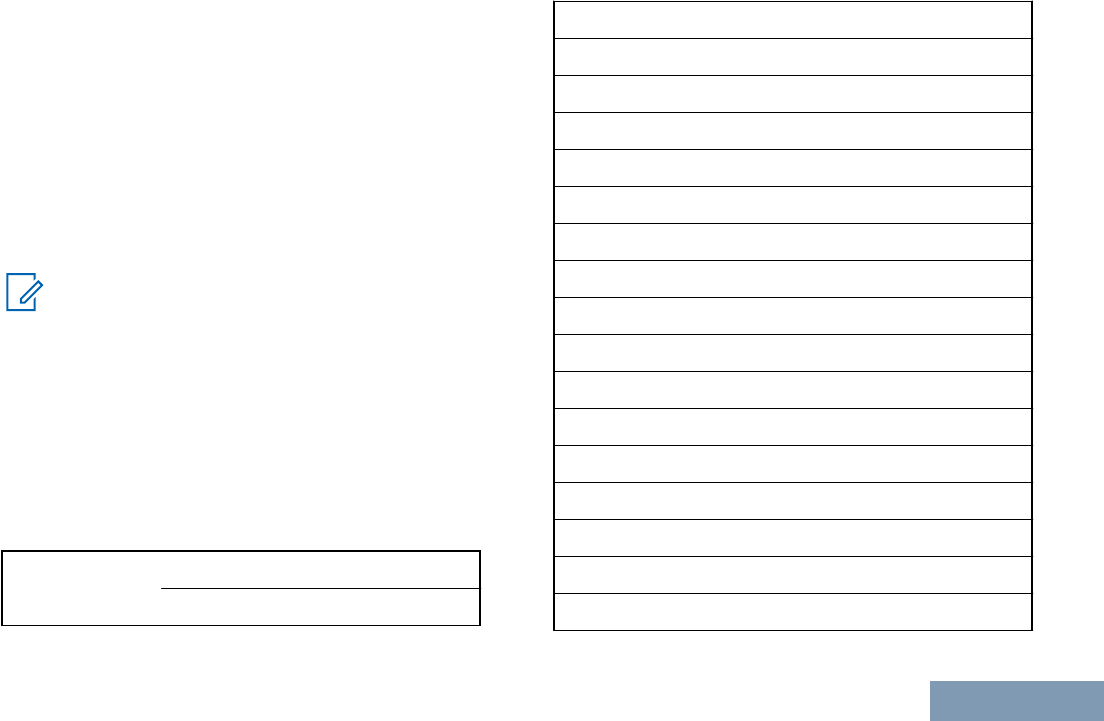
• on ships subject to Part II of Title III of the
Communications Act, the radio must be capable of
operating on the 156.800 MHz frequency.
• on ships subject to the Safety Convention, the
radio must be capable of operating:
• in the simplex mode on the ship station
transmitting frequencies specified in the
156.025 – 157.425 MHz frequency band, and
•in the semiduplex mode on the two frequency
channels specified in the table below.
Note:
Simplex channels 3, 21, 23, 61, 64, 81, 82,
and 83 cannot be lawfully used by the general
public in US waters.
Additional information about operating
requirements in the Maritime Services can be
obtained from the full text of FCC Rule Part 80
and from the US Coast Guard.
Table 1: VHF Marine Channel List
Channel Num-
ber
Frequency (MHz)
Transmit Receive
1 156.050 160.650
2 156.100 160.700
* 156.150 160.750
4 156.200 160.800
5 156.250 160.850
6 156.300 –
7 156.350 160.950
8 156.400 –
9 156.450 156.450
10 156.500 156.500
11 156.550 156.550
12 156.600 156.600
13** 156.650 156.650
14 156.700 156.700
15** 156.750 156.750
16 156.800 156.800
17** 156.850 156.850
Maritime Radio Use in the VHF Frequency Range
313
English

18 156.900 161.500
19 156.950 161.550
20 157.000 161.600
* 157.050 161.650
22 157.100 161.700
* 157.150 161.750
24 157.200 161.800
25 157.250 161.850
26 157.300 161.900
27 157.350 161.950
28 157.400 162.000
60 156.025 160.625
* 156.075 160.675
62 156.125 160.725
63 156.175 160.775
* 156.225 160.825
65 156.275 160.875
66 156.325 160.925
67** 156.375 156.375
68 156.425 156.425
69 156.475 156.475
71 156.575 156.575
72 156.625 –
73 156.675 156.675
74 156.725 156.725
75 *** ***
76 *** ***
77** 156.875 –
78 156.925 161.525
79 156.975 161.575
80 157.025 161.625
* 157.075 161.675
* 157.125 161.725
* 157.175 161.775
Maritime Radio Use in the VHF Frequency Range
314
English
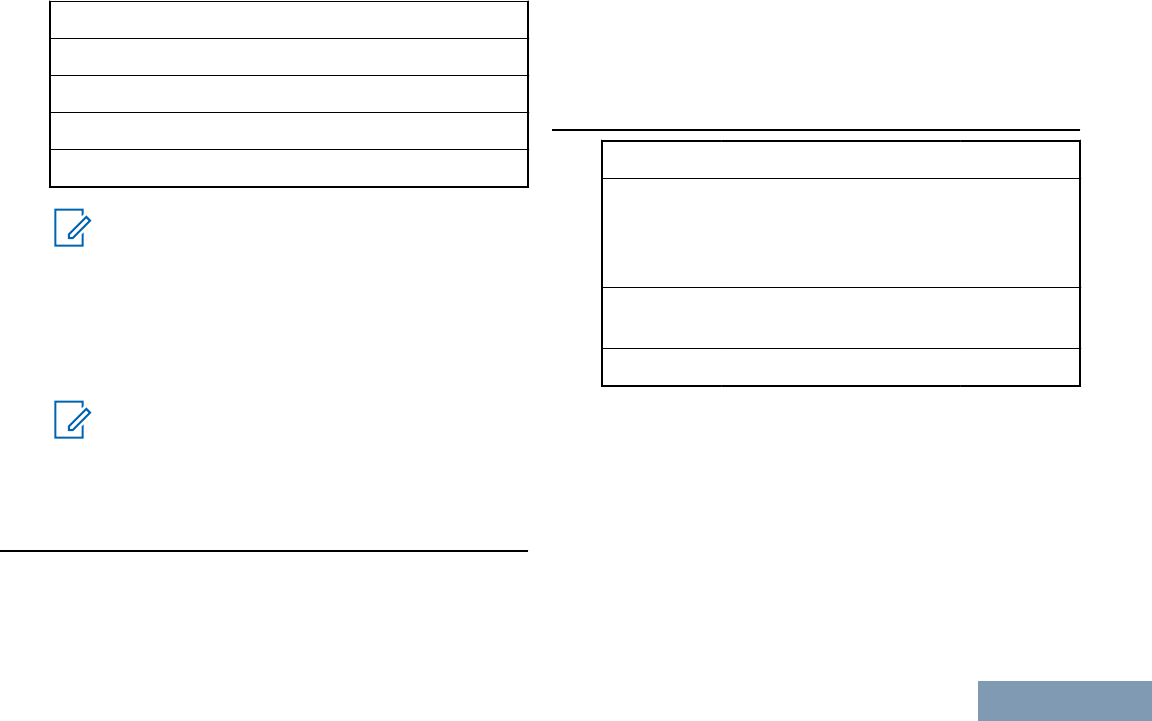
84 157.225 161.825
85 157.275 161.875
86 157.325 161.925
87 157.375 161.975
88 157.425 162.025
Note:
* Simplex channels 3, 21, 23, 61, 64, 81, 82,
and 83 cannot be lawfully used by the
general public in US waters.
** Low power (1 W) only.
*** Guard band.
Note:
A – in the Receive column indicates that the
channel is transmit only.
Declaration of Compliance for the Use of
Distress and Safety Frequencies
The radio equipment does not employ a modulation
other than the internationally adopted modulation for
maritime use when it operates on the distress and
safety frequencies specified in RSS-182 Section 7.3.
Technical Parameters for Interfacing External
Data Sources
RS232 USB SB9600
Input Volt-
age (Volts
Peak-to-
peak)
18V 3.6V 5V
Max Data
Rate
28 kb/s 12 Mb/s 9.6 kb/s
Impedance 5000 ohm 90 ohm 120 ohm
Maritime Radio Use in the VHF Frequency Range
315
English
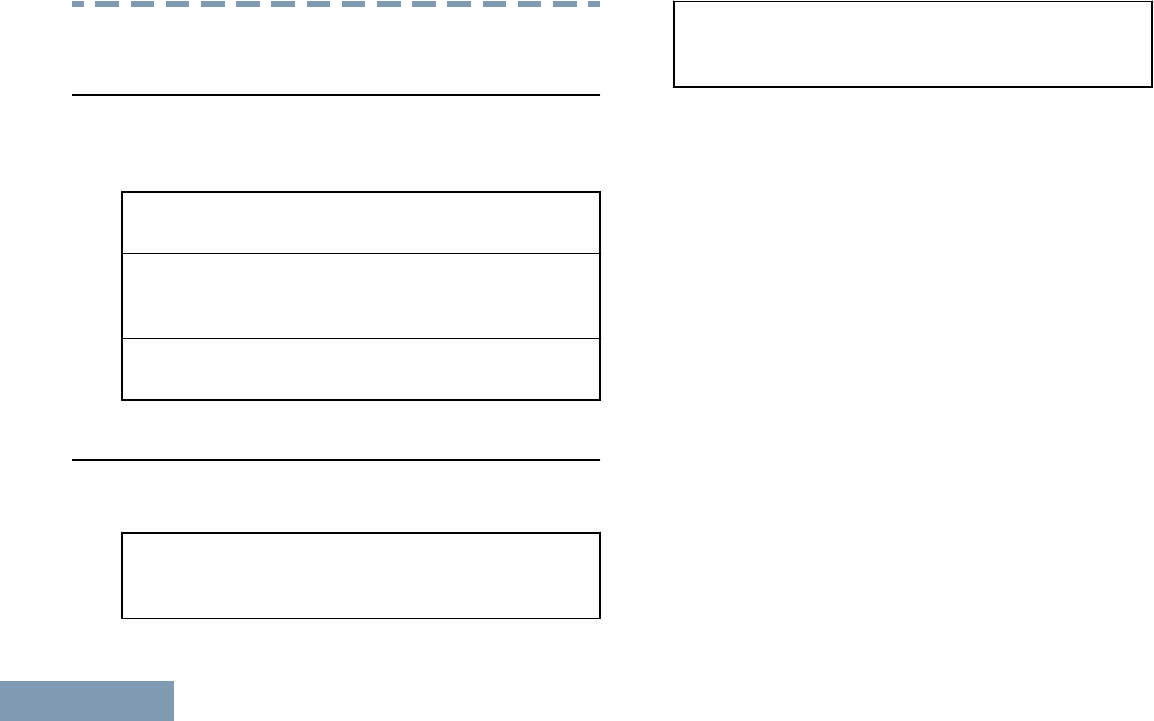
Batteries and Chargers Warranty
The Workmanship Warranty
The workmanship warranty guarantees against
defects in workmanship under normal use and
service.
All MOTOTRBO Batter-
ies
24 Months
IMPRES Chargers (Sin-
gle-Unit and Multi-Unit,
Non-Display)
24 Months
IMPRES Chargers (Multi-
Unit with Display)
12 Months
The Capacity Warranty
The capacity warranty guarantees 80% of the rated
capacity for the warranty duration.
Nickel Metal-Hydride
(NiMH) or Lithium-Ion (Li-
lon) Batteries
12 Months
IMPRES Batteries, When
Used Exclusively with
IMPRES Chargers
18 Months
Batteries and Chargers Warranty
316
English
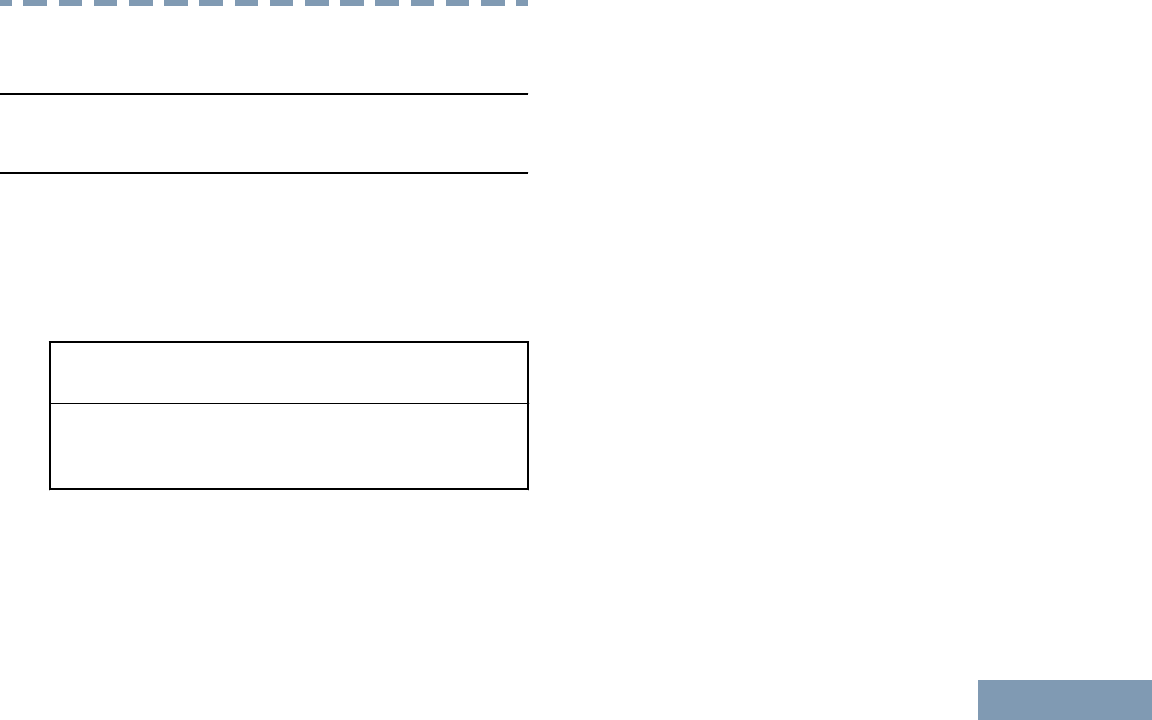
Limited Warranty
MOTOROLA COMMUNICATION PRODUCTS
I. WHAT THIS WARRANTY COVERS AND FOR
HOW LONG:
MOTOROLA SOLUTIONS, INC. (“MOTOROLA”)
warrants the MOTOROLA manufactured
Communication Products listed below (“Product”)
against defects in material and workmanship under
normal use and service for a period of time from the
date of purchase as scheduled below:
XPR Series Digital Porta-
ble Radios
36 Months
Product Accessories (Ex-
cluding Batteries and
Chargers)
12 Months
MOTOROLA, at its option, will at no charge either
repair the Product (with new or reconditioned parts),
replace it (with a new or reconditioned Product), or
refund the purchase price of the Product during the
warranty period provided it is returned in accordance
with the terms of this warranty. Replaced parts or
boards are warranted for the balance of the original
applicable warranty period. All replaced parts of
Product shall become the property of MOTOROLA.
This express limited warranty is extended by
MOTOROLA to the original end user purchaser only
and is not assignable or transferable to any other
party. This is the complete warranty for the Product
manufactured by MOTOROLA. MOTOROLA
assumes no obligations or liability for additions or
modifications to this warranty unless made in writing
and signed by an officer of MOTOROLA.
Unless made in a separate agreement between
MOTOROLA and the original end user purchaser,
MOTOROLA does not warrant the installation,
maintenance or service of the Product.
MOTOROLA cannot be responsible in any way for
any ancillary equipment not furnished by MOTOROLA
which is attached to or used in connection with the
Product, or for operation of the Product with any
ancillary equipment, and all such equipment is
expressly excluded from this warranty. Because each
system which may use the Product is unique,
MOTOROLA disclaims liability for range, coverage, or
Limited Warranty
317
English

operation of the system as a whole under this
warranty.
II. GENERAL PROVISIONS:
This warranty sets forth the full extent of
MOTOROLA'S responsibilities regarding the Product.
Repair, replacement or refund of the purchase price,
at MOTOROLA’s option, is the exclusive remedy.
THIS WARRANTY IS GIVEN IN LIEU OF ALL
OTHER EXPRESS WARRANTIES. IMPLIED
WARRANTIES, INCLUDING WITHOUT LIMITATION,
IMPLIED WARRANTIES OF MERCHANTABILITY
AND FITNESS FOR A PARTICULAR PURPOSE,
ARE LIMITED TO THE DURATION OF THIS
LIMITED WARRANTY. IN NO EVENT SHALL
MOTOROLA BE LIABLE FOR DAMAGES IN
EXCESS OF THE PURCHASE PRICE OF THE
PRODUCT, FOR ANY LOSS OF USE, LOSS OF
TIME, INCONVENIENCE, COMMERCIAL LOSS,
LOST PROFITS OR SAVINGS OR OTHER
INCIDENTAL, SPECIAL OR CONSEQUENTIAL
DAMAGES ARISING OUT OF THE USE OR
INABILITY TO USE SUCH PRODUCT, TO THE
FULL EXTENT SUCH MAY BE DISCLAIMED BY
LAW.
III. STATE LAW RIGHTS:
SOME STATES DO NOT ALLOW THE EXCLUSION
OR LIMITATION OF INCIDENTAL OR
CONSEQUENTIAL DAMAGES OR LIMITATION ON
HOW LONG AN IMPLIED WARRANTY LASTS, SO
THE ABOVE LIMITATION OR EXCLUSIONS MAY
NOT APPLY.
This warranty gives specific legal rights, and there
may be other rights which may vary from state to
state.
IV. HOW TO GET WARRANTY SERVICE:
You must provide proof of purchase (bearing the date
of purchase and Product item serial number) in order
to receive warranty service and, also, deliver or send
the Product item, transportation and insurance
prepaid, to an authorized warranty service location.
Warranty service will be provided by MOTOROLA
through one of its authorized warranty service
locations. If you first contact the company which sold
you the Product (e.g., dealer or communication
service provider), it can facilitate your obtaining
warranty service. You can also call MOTOROLA at
1-800-927-2744 US/Canada.
Limited Warranty
318
English

V. WHAT THIS WARRANTY DOES NOT
COVER:
1Defects or damage resulting from use of the
Product in other than its normal and customary
manner.
2Defects or damage from misuse, accident, water,
or neglect.
3Defects or damage from improper testing,
operation, maintenance, installation, alteration,
modification, or adjustment.
4Breakage or damage to antennas unless caused
directly by defects in material workmanship.
5A Product subjected to unauthorized Product
modifications, disassembles or repairs (including,
without limitation, the addition to the Product of
non-MOTOROLA supplied equipment) which
adversely affect performance of the Product or
interfere with MOTOROLA's normal warranty
inspection and testing of the Product to verify any
warranty claim.
6Product which has had the serial number removed
or made illegible.
7Rechargeable batteries if:
• any of the seals on the battery enclosure of
cells are broken or show evidence of
tampering.
• the damage or defect is caused by charging or
using the battery in equipment or service other
than the Product for which it is specified.
8Freight costs to the repair depot.
9A Product which, due to illegal or unauthorized
alteration of the software/firmware in the Product,
does not function in accordance with
MOTOROLA’s published specifications or the FCC
certification labeling in effect for the Product at the
time the Product was initially distributed from
MOTOROLA.
10 Scratches or other cosmetic damage to Product
surfaces that does not affect the operation of the
Product.
11 Normal and customary wear and tear.
VI. PATENT AND SOFTWARE PROVISIONS:
MOTOROLA will defend, at its own expense, any suit
brought against the end user purchaser to the extent
that it is based on a claim that the Product or parts
infringe a United States patent, and MOTOROLA will
pay those costs and damages finally awarded against
Limited Warranty
319
English

the end user purchaser in any such suit which are
attributable to any such claim, but such defense and
payments are conditioned on the following:
1that MOTOROLA will be notified promptly in
writing by such purchaser of any notice of such
claim,
2that MOTOROLA will have sole control of the
defense of such suit and all negotiations for its
settlement or compromise, and
3should the Product or parts become, or in
MOTOROLA’s opinion be likely to become, the
subject of a claim of infringement of a United
States patent, that such purchaser will permit
MOTOROLA, at its option and expense, either to
procure for such purchaser the right to continue
using the Product or parts or to replace or modify
the same so that it becomes non-infringing or to
grant such purchaser a credit for the Product or
parts as depreciated and accept its return. The
depreciation will be an equal amount per year over
the lifetime of the Product or parts as established
by MOTOROLA.
MOTOROLA will have no liability with respect to any
claim of patent infringement which is based upon the
combination of the Product or parts furnished
hereunder with software, apparatus or devices not
furnished by MOTOROLA, nor will MOTOROLA have
any liability for the use of ancillary equipment or
software not furnished by MOTOROLA which is
attached to or used in connection with the Product.
The foregoing states the entire liability of
MOTOROLA with respect to infringement of patents
by the Product or any parts thereof.
Laws in the United States and other countries
preserve for MOTOROLA certain exclusive rights for
copyrighted MOTOROLA software such as the
exclusive rights to reproduce in copies and distribute
copies of such MOTOROLA software. MOTOROLA
software may be used in only the Product in which
the software was originally embodied and such
software in such Product may not be replaced,
copied, distributed, modified in any way, or used to
produce any derivative thereof. No other use
including, without limitation, alteration, modification,
reproduction, distribution, or reverse engineering of
such MOTOROLA software or exercise of rights in
such MOTOROLA software is permitted. No license is
granted by implication, estoppel or otherwise under
MOTOROLA patent rights or copyrights.
Limited Warranty
320
English

VII. GOVERNING LAW:
This Warranty is governed by the laws of the State of
Illinois, U.S.A.
Limited Warranty
321
English

Motorola Solutions, Inc.
1303 East Algonquin Road
Schaumburg, Illinois 60196 U.S.A.
MOTOROLA, MOTO, MOTOROLA SOLUTIONS and
the Stylized M logo are trademarks or registered trademarks
of Motorola Trademark Holdings, LLC and are used under license.
All other trademarks are the property of their respective owners.
© 2012–2015 Motorola Solutions, Inc. All rights reserved.
Wi-Fi® is a registered trademark of Wi-Fi Alliance®.
November 2015
www.motorolasolutions.com/mototrbo
*68009502001*
68009502001-HC